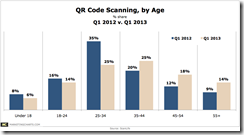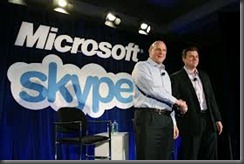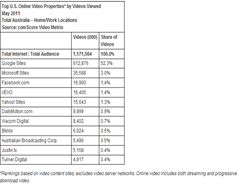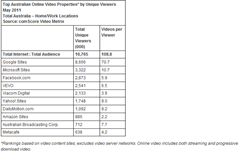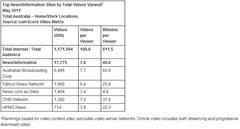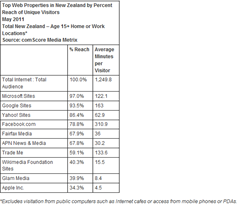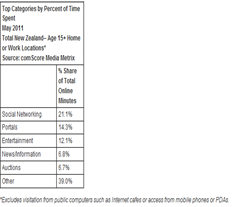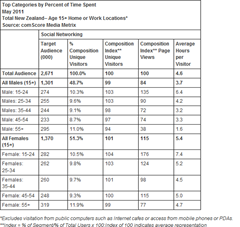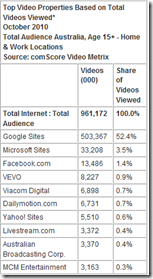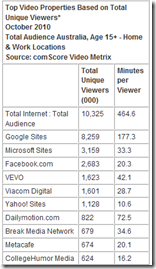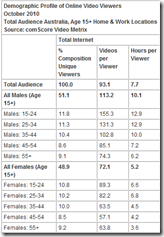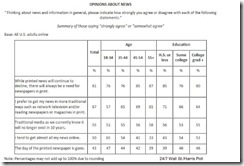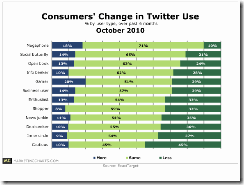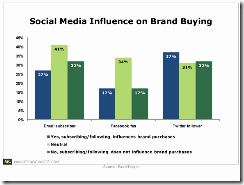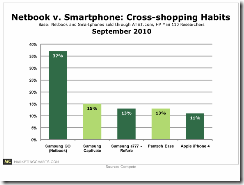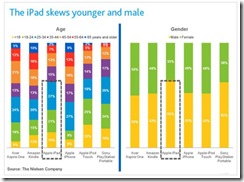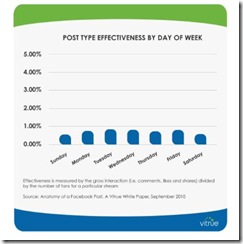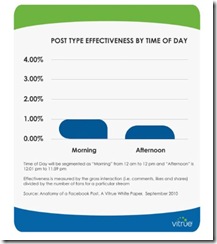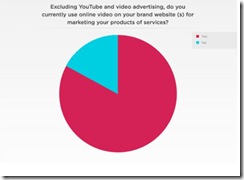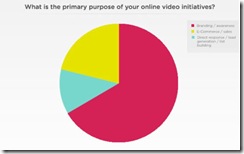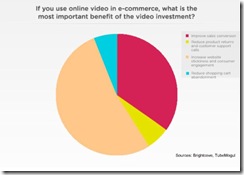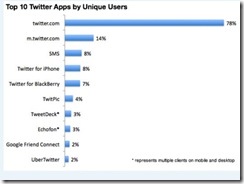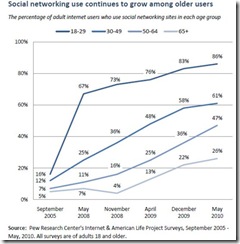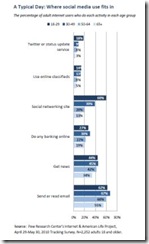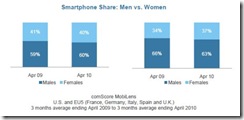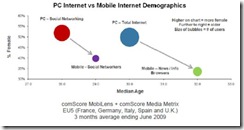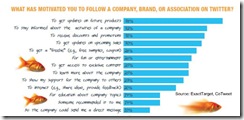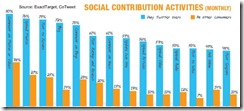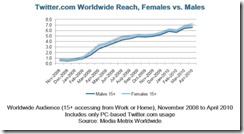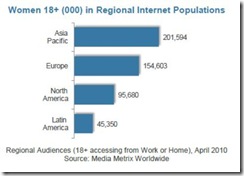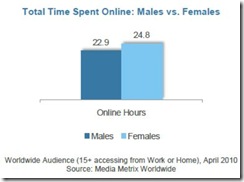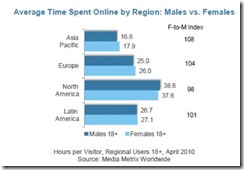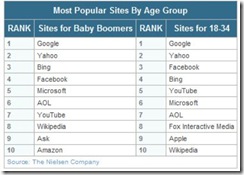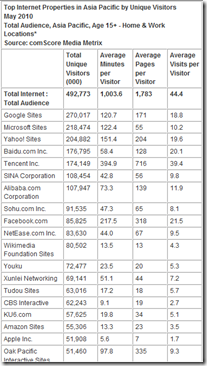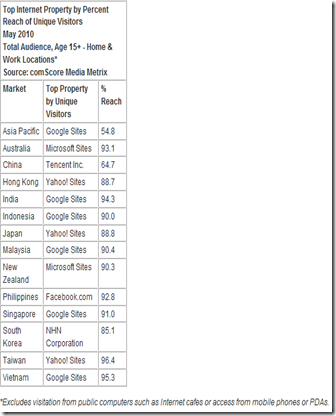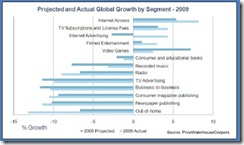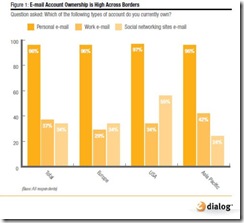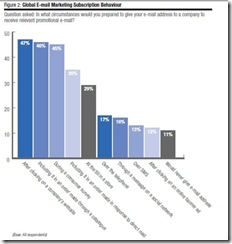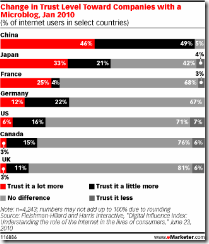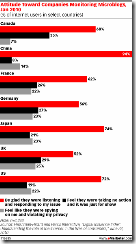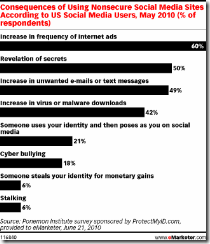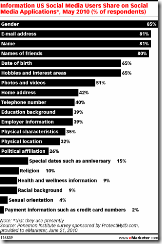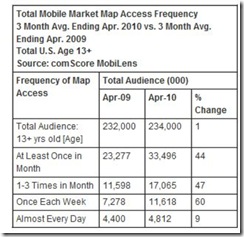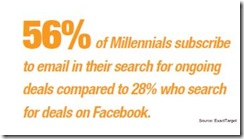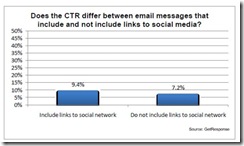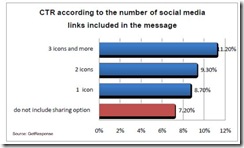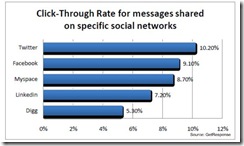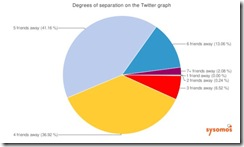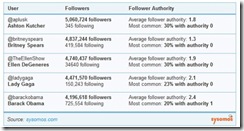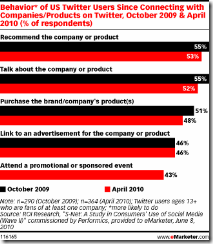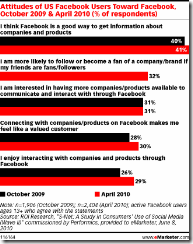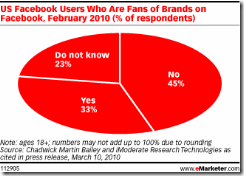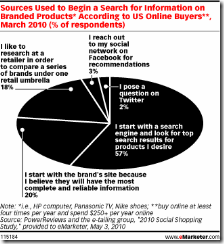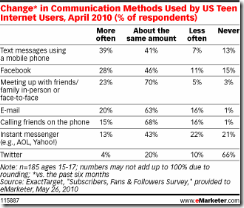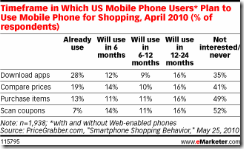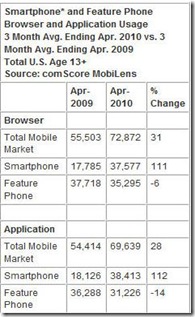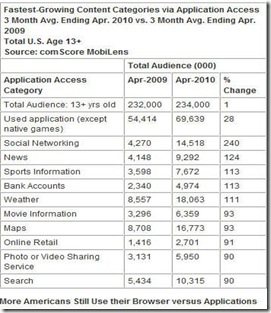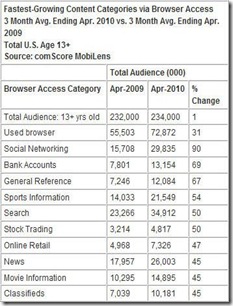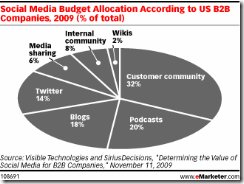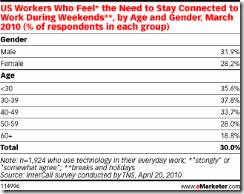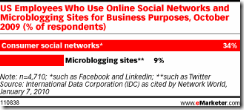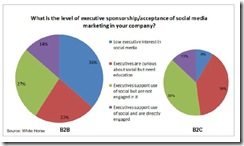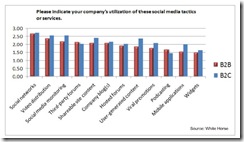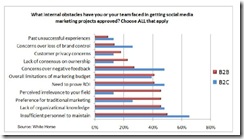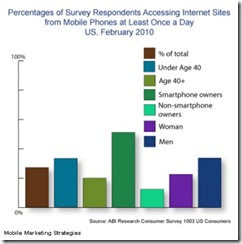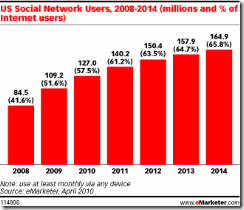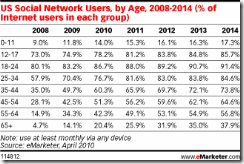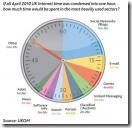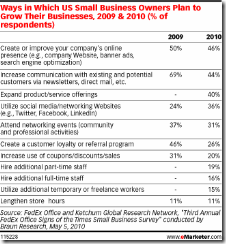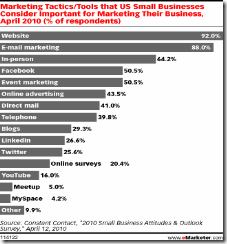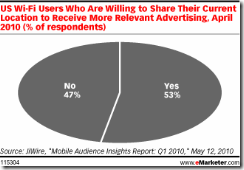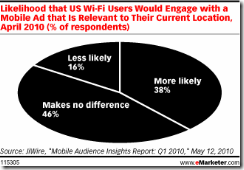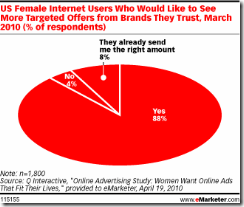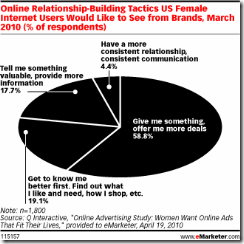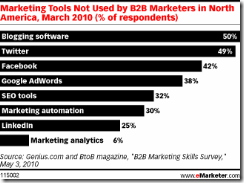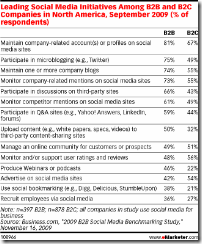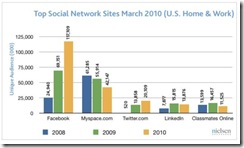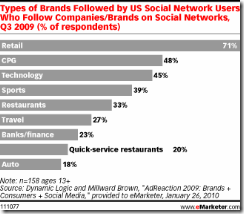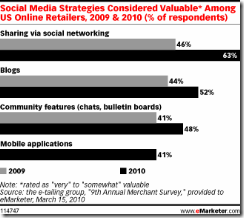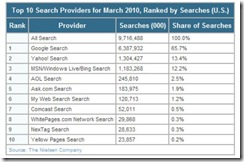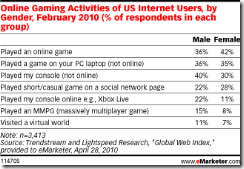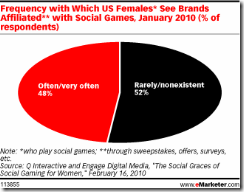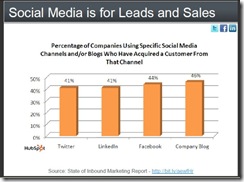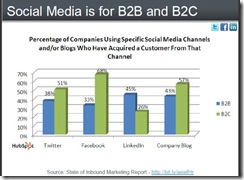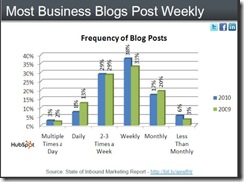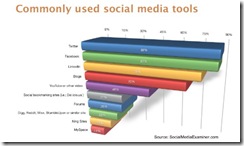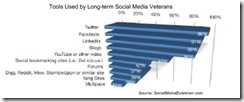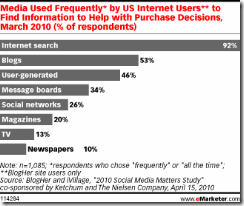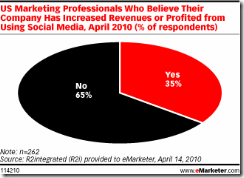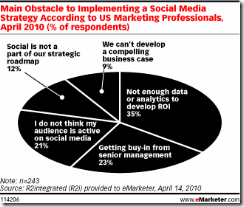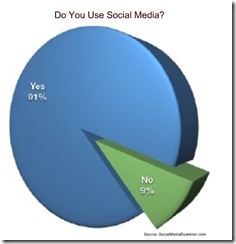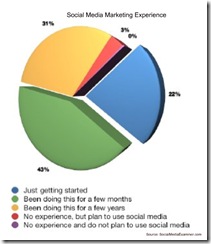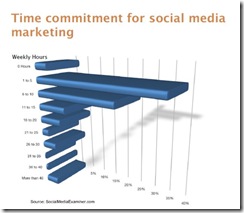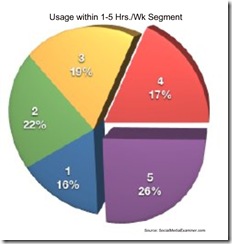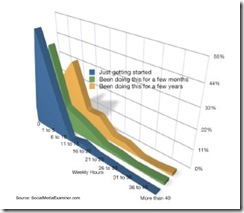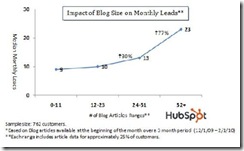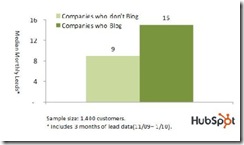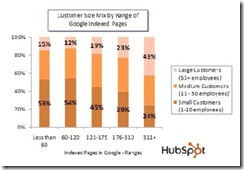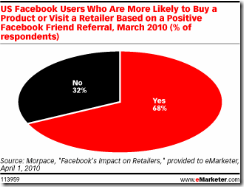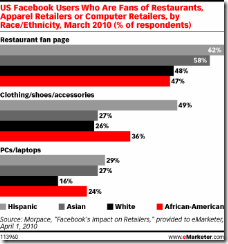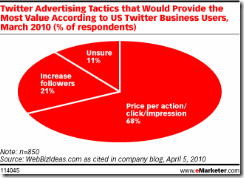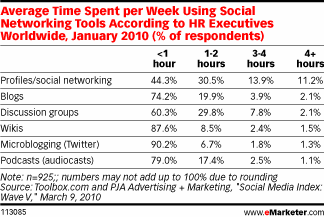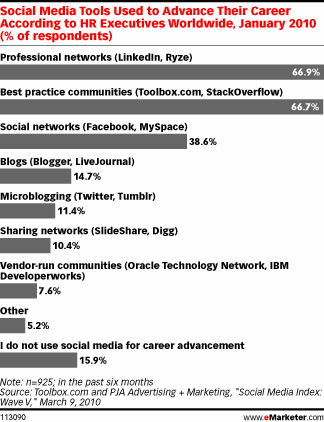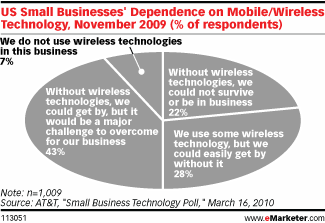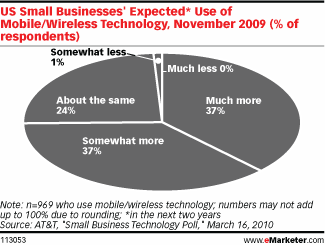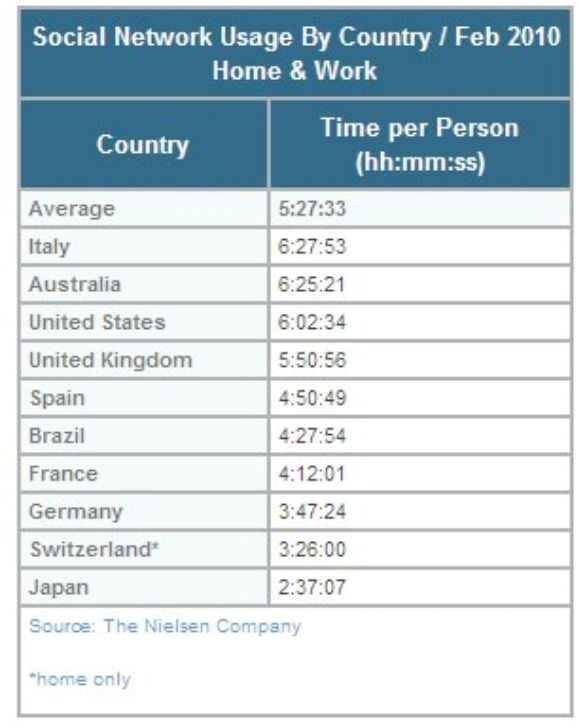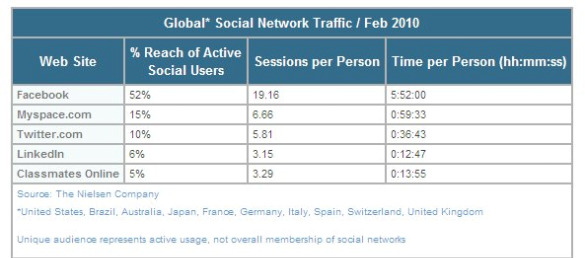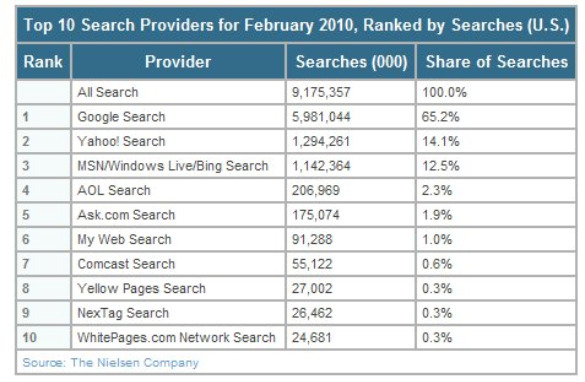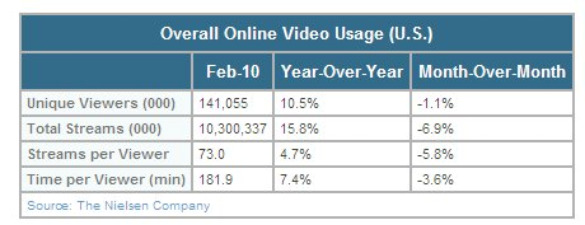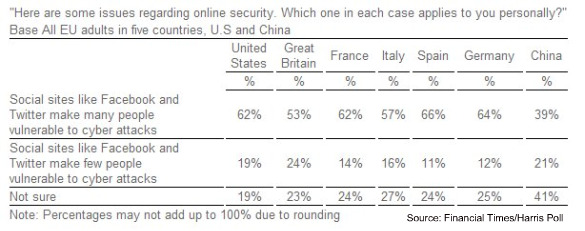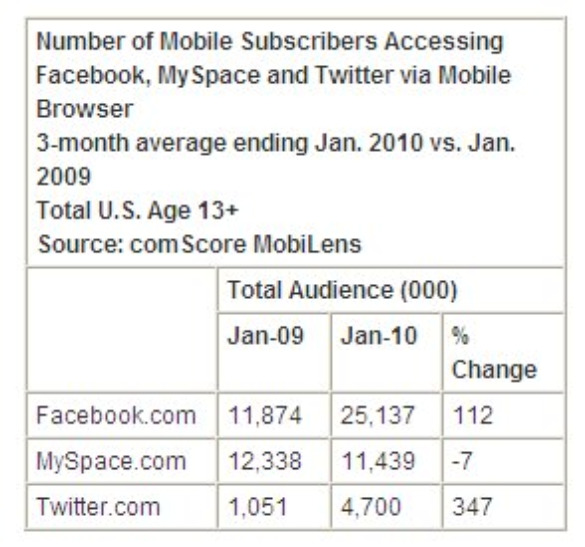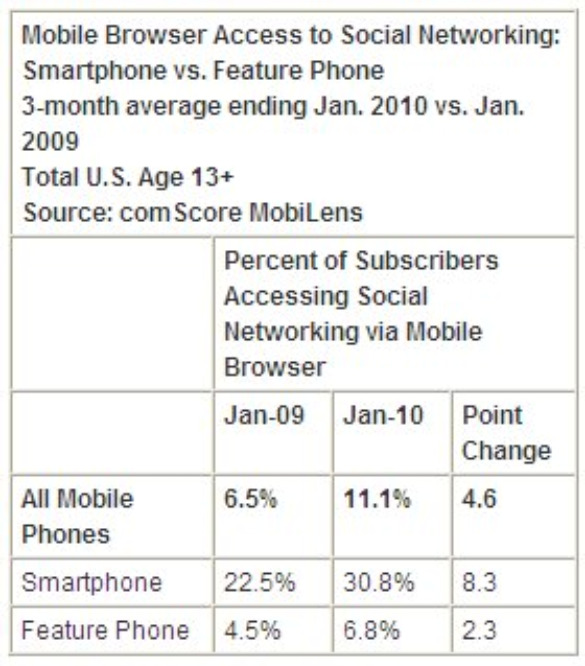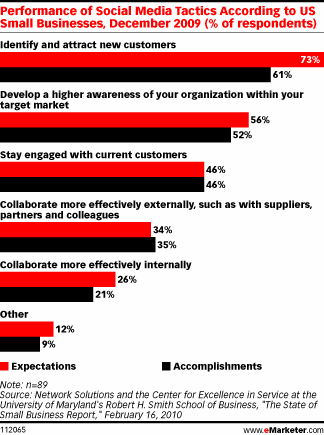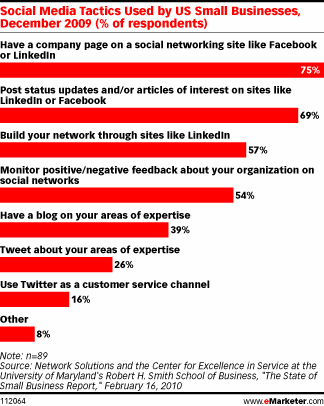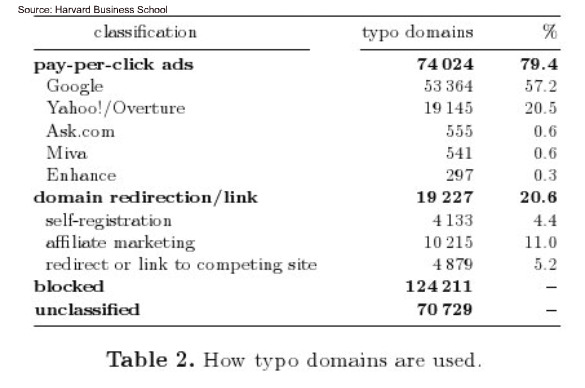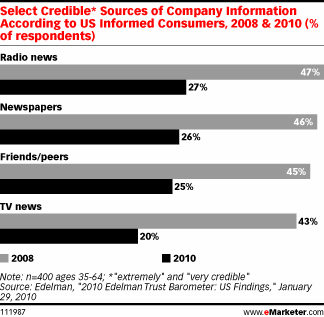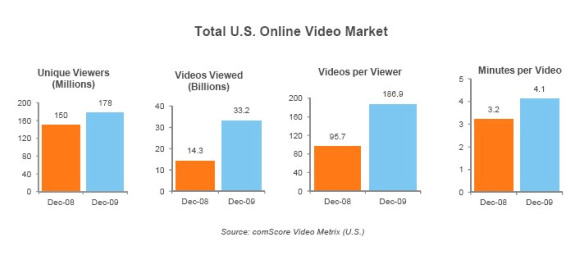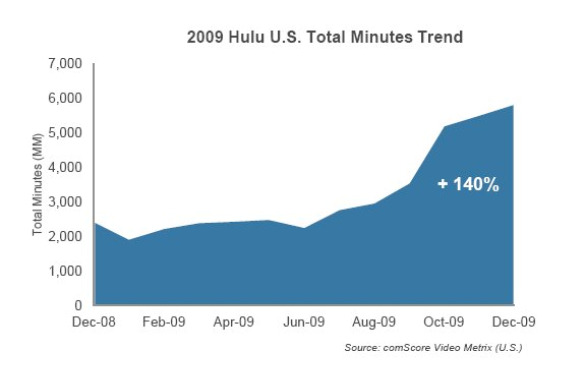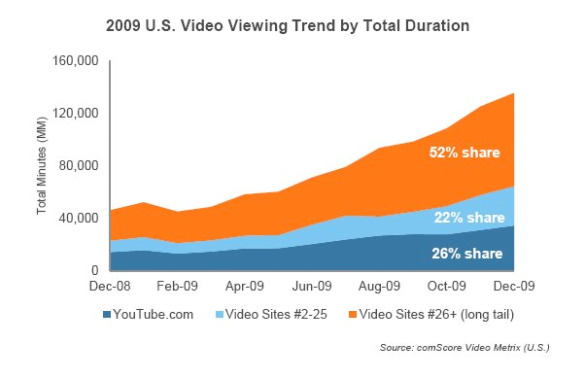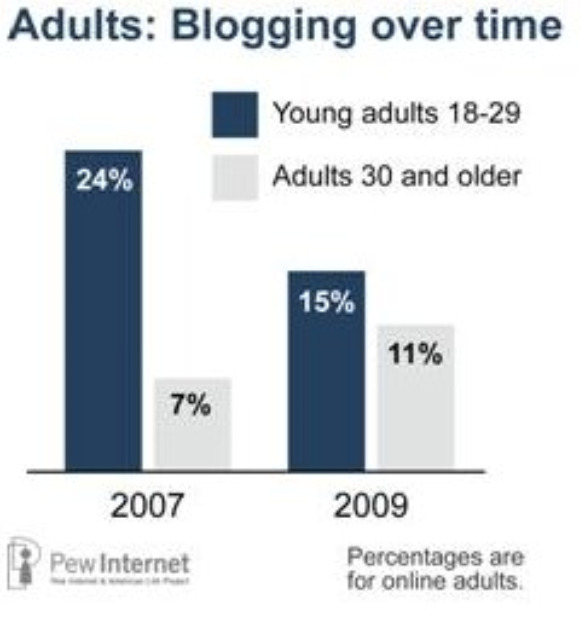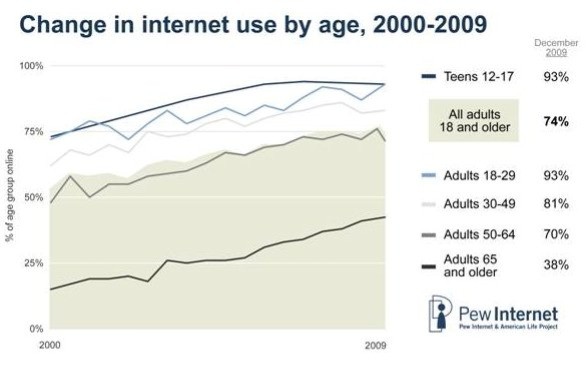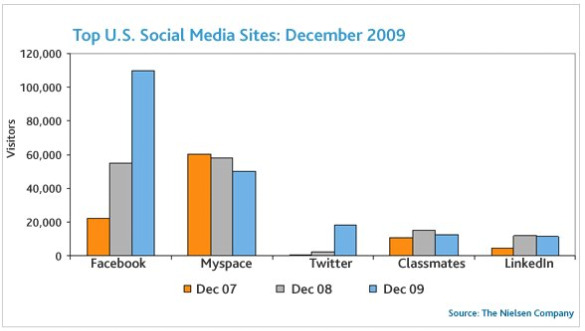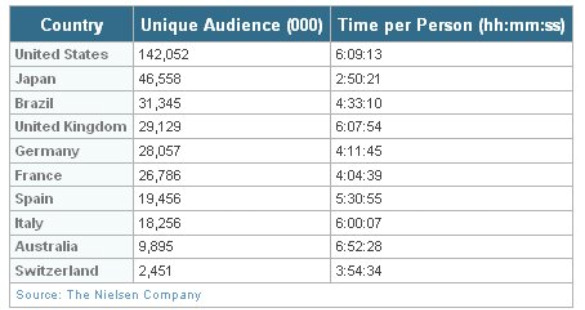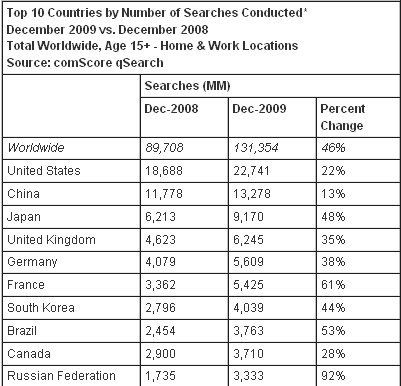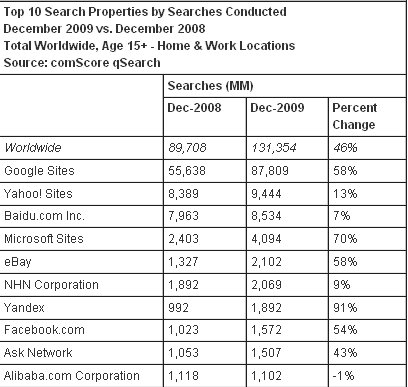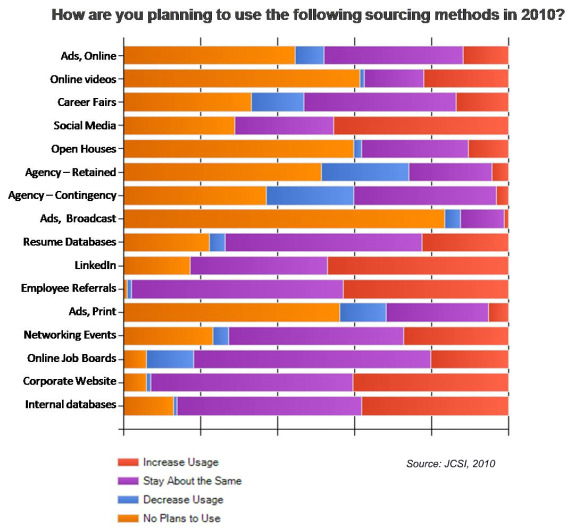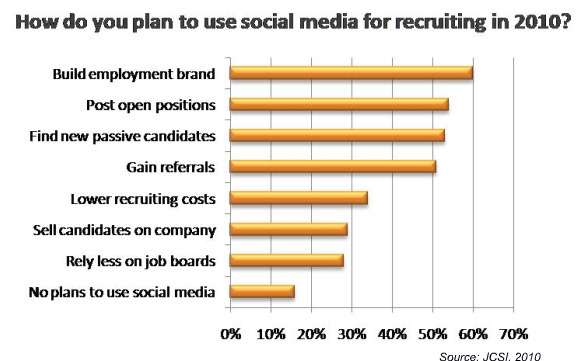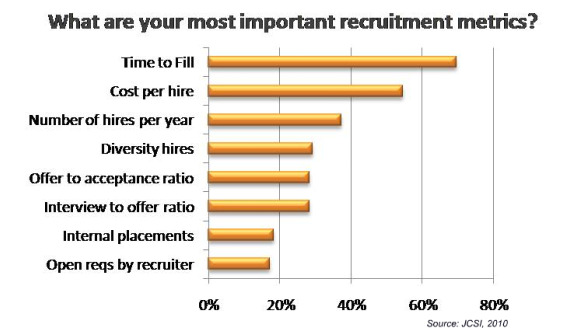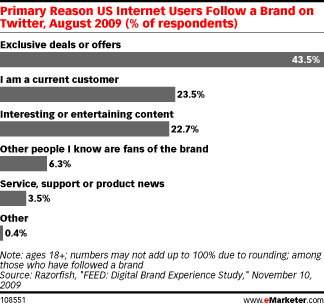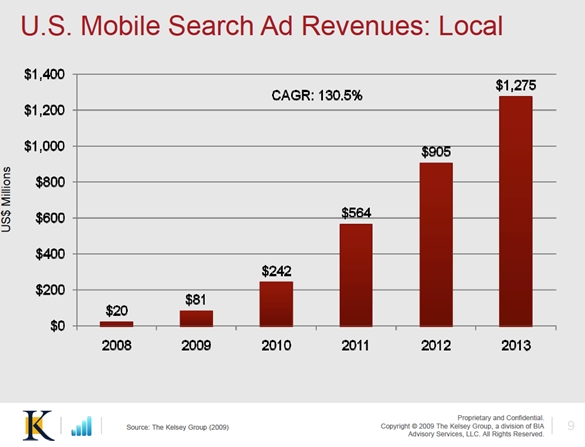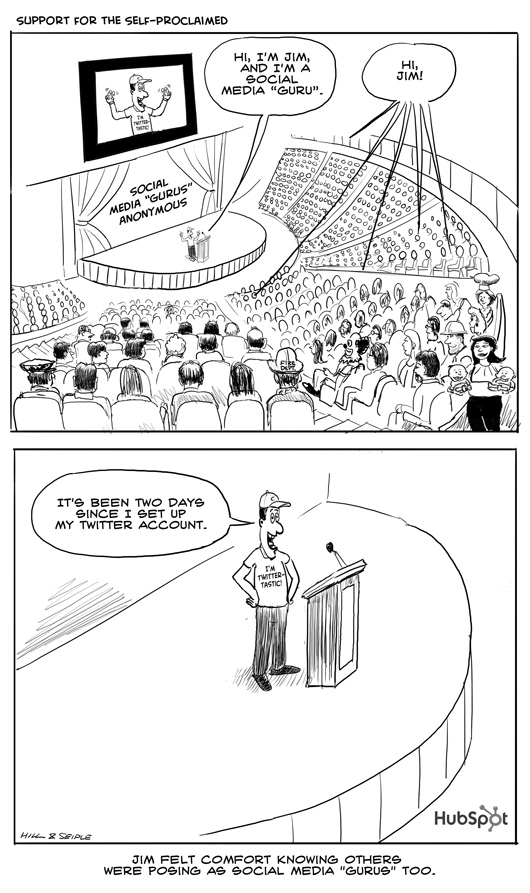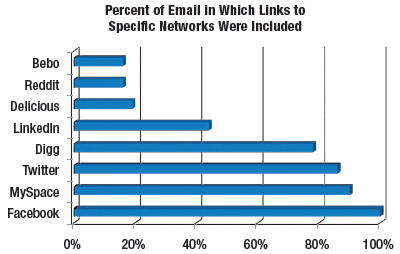-
Tips to Help You Cope at Christmas time (prevent depression and anxiety)
Christmas time for many is a season to be jolly, but for many others Christmas time can lead to episodes of depression and anxiety.
One of the leading causes of depression at Christmas time is loneliness.
People at risk of loneliness include the elderly, those who have had recent relationship breakdowns, parents estranged from their children, those who have recently relocated to a new city, those who have lost loved one recently or whose anniversary falls around Christmas, and those who do not have family and friends around them.
Tips to manage loneliness:
- Make it known before Christmas Day that you do not have any plans for Christmas and make sure you accept any offers that are given to share Christmas with someone
- Attend your local community centre and see if there are any events scheduled for Christmas Day
- If you are spending some of the holiday period alone, ensure to keep yourself busy and treat yourself to something special
- Contact your loved ones via phone, social media, or skype regularly
- Volunteer your time and services at a local charity in the days leading up to Christmas, as this is traditionally a very busy time for charities
- Keep your activities levels up through exercise and get out of the home as regularly as you can
- Do something different and take up a new hobby
- Find positive ways to remember your loved ones – remember the good times that you had with your loved ones and do something that you used to enjoy (such as attending a restaurant that you used to go to together, and give them a toast)
- Get in touch with people you care about who you have lost touch with. Step out if your comfort and pick up the phone or write a letter
Christmas is a time for families, but many families have internal conflicts and this can lead to problems at Christmas time.
-
Qld Government recommends changes to workers compensation – How this impacts Workers in Queensland.
Even with new research showing that *83% of Queenslanders support the right of workers to bring legal claims for injuries in unsafe workplaces, and 73% believing workers should be able to claim for minor injuries as well, the Qld government today have moved to change the WorkCover scheme, which could include capping common law payouts and scrapping insurance protections for workers during commutes and lunch breaks.
It’s not good news for workers because it means that some people injured at work through no fault of their own, in some cases quite seriously, will have no entitlement to fair compensation. If they can’t work they’ll been thrown on to Centrelink benfits and will suffer all the socio economic consequences that often flow from being on a low income.
Some people won’t be able to pay their mortgages, car loans may go unpaid and some people could lose everything, because there is no longer the safety net of a fair workers compensation system.
-
Google’s Hummingbird hatches new search
Google has quietly retooled the closely guarded formula running its internet search engine to give better answers to the increasingly complex questions posed by web surfers.
The overhaul came as part of an update called Hummingbird, which Google has gradually rolled out in the past month without disclosing the modifications.
The changes could have a major impact on traffic to websites.
Hummingbird represents the most dramatic alteration to Google’s search engine since it revised the way it indexes websites three years ago as part of a redesign called Caffeine, according to Amit Singhal, a senior vice president for the company.
He estimates the redesign will affect the analysis of about 90 per cent of the search requests that Google gets.
Any reshuffling of Google’s search rankings can have sweeping ramifications because they steer so much of the internet’s traffic.
Google fields about two of out every three search requests in the US and handles an even larger volume in some parts of Europe.
The changes could also drive up the price of Google ads tied to search requests if websites whose rankings are demoted under the new system feel they have to buy the marketing messages to attract traffic.
The search ads and other commercial pitches related to web content account for most of Google’s revenue, which is expected to approach $US60 billion ($A64.42 billion) this year.
Google disclosed the existence of the new search formula on Thursday at an event in the Menlo Park, California, garage where CEO Larry Page and fellow co-founder Sergey Brin started the company 15 years ago.
Hummingbird is aimed at giving Google’s search engine a better grasp at understanding concepts instead of mere words, Singhal said.
The change was needed, Singhal said, because people have become so reliant on Google that they now routinely enter lengthy questions into the search box instead of just a few words.
Story source: www.bigpond.com
-
Facebook feeds chatter to news outlets
Facebook has begun feeding select news outlets real-time social network chatter about hot topics to weave into story coverage, wading deeper into Twitter territory.
A pair of software tools, Public Feed and Keyword Insights, lets Facebook’s media partners tap into comments posted on the service.
‘Selected news organisations can begin to integrate Facebook conversations into their broadcasts or coverage by displaying public posts of real-time activity about any given topic,’ Facebook’s online operations vice president, Justin Osofsky, said in a blog post.
‘From favourite television shows to sporting events to the latest news; the conversations are happening on Facebook.’
Facebook listed its media partners as Buzzfeed, CNN, NBC’s Today Show, BSkyB, Slate and Mass Relevance.
For a while now, news outlets have turned to globally popular one-to-many messaging service Twitter for real-time insights, opinions, and perspectives for stories.
Osofsky said that Facebook is ‘committed to building features that improve the experience of discovering and participating in conversations about things happening in the world right now, including entertainment, sports, politics and news.’
Only public posts by Facebook members will be streamed to news outlets, according to the California-based social network.
The software tools also allow news outlets to report demographic breakdowns of those discussing topics online, as well as how often specific words have been mentioned.
Osofsky gave the example of NBC’s Today Show being able to ‘include how many people on Facebook talked about a popular subject, where it’s getting the most buzz, whether it’s most popular among males or females, and with which age groups.’
Story source: www.bigpond.com
-
Facebook linked with unhappiness
Facebook could be spreading unhappiness through society as well as keeping people connected, research has shown.
The number one social networking site is strongly associated with declines in well-being, psychologists claim.
Scientists found the more time people spent on Facebook over a two-week period, the worse they subsequently felt.
In contrast, talking to friends on the phone or meeting them in person led to greater levels of happiness.
‘On the surface, Facebook provides an invaluable resource for fulfilling the basic human need for social connection,’ said study leader Dr Ethan Kross, from the University of Michigan in the US.
‘But rather than enhance well-being, we found that Facebook use predicts the opposite result – it undermines it’.
The researchers recruited 82 young adults, all of whom had smartphones and Facebook accounts.
To assess their personal levels of well-being, participants were sent questions by text message at five random times each day for two weeks.
The ‘experience sampling’ technique is a recognised reliable way of measuring how people think, feel and behave in their day-to-day lives.
Participants were asked how they felt ‘right now’, how worried or lonely they were, and to what extent they had been using Facebook or interacting with other people directly.
Writing in the online journal Public Library of Science ONE, the researchers said higher levels of Facebook use correlated with greater loss of well-being.
Volunteers were also asked to rate their level of life satisfaction at the start and end of the study.
Over the two-week period, satisfaction ratings were found to decline the more people used Facebook.
‘This is a result of critical importance because it goes to the very heart of the influence that social networks may have on people’s lives,’ said University of Michigan neuroscientist and co-author Dr John Jonides.
There was no evidence that people were more likely to log into Facebook when they felt bad, said the researchers.
In addition, loneliness and Facebook both had an independent impact on happiness.
‘It was not the case that Facebook use served as a proxy for feeling bad or lonely,’ said Kross.
Further research is planned to look at the psychological reasons for the negative effect of Facebook on well-being.
Story source: www.bigpond.com
-
Five tips on what to do after you’ve been injured in a car accident
Car accidents are common, and knowing what to do when it happens to you is very important.
We hope the following article will help and assist you in the event you or a member of your family is involved in an accident.
Please read on:
Being involved in a car accident is a very traumatic experience, and it will be very difficult for you to think and act clearly, and quickly. There are a number of things going on around you, and that is why it is very important to have a check list of things to go through to help you cope.
-
Rudd admits spam Twitter followers
Prime Minister Kevin Rudd has never paid to boost his social media profiles.
But his office acknowledges some of his 1.4 million Twitter followers aren’t genuine.
‘Neither he (Mr Rudd), nor his office, has ever paid to boost the Prime Minister’s Twitter followers, Facebook friends or Facebook likes,’ a spokesman for Mr Rudd told AAP.
‘What spambots choose to do in their own time is a matter for them.’
Spambots are automated programs that create fake social and email accounts to flood users with spam and a number appear to follow Mr Rudd, who is easily one of the most popular Australians on the social media site.
Telltale signs of spambot Twitter accounts include those with little or no personal profile information combined with zero or few tweets and very few followers.
An analysis of Mr Rudd’s followers list shows a number of accounts fitting that description – though it remains unclear what proportion are genuine.
Most famous people on Twitter have spambot followers – and there’s little they can do about it apart from the report the accounts and hope they’re removed.
It comes after Opposition Leader Tony Abbott was bombarded by about 80,000 fake, paid-for followers over the weekend.
‘We are working with Twitter now to remove the fake accounts and investigate who was behind this,’ the Liberal Party wrote on Facebook.
‘The Liberal Party has not purchased or artificially sought to inflate any social media numbers.’
By Monday morning Mr Abbott reached 208,357 followers – up from just over 120,000 two months ago, with most of that increase occurring on Saturday and Sunday.
Shortly after 8.20am (AEST) on Monday, the opposition leader’s numbers plunged to just over 165,000 as the paid-for accounts were removed.
His numbers reached 168,725 by early afternoon.
It’s unclear who paid to boost Mr Abbott’s account.
One hundred thousand Twitter followers can easily be bought anonymously online, with marketing companies offering to supply 100,000 new followers for as little as $274.
Followers can be added at a pre-prescribed rate, such as five per day or one per hour.
Facebook likes’ can also be bought online for similar prices.
Queensland University of Technology’s Associate Professor Axel Bruns said Mr Rudd’s numbers were also boosted by about half a million in 2009 and 2010 when Twitter suggested new users follow him.
‘We actually looked at the follower growth over time and there are periods from mid-2009 to the start of 2010 when Twitter recommended Rudd to people who were signing up in Australia,’ Prof Bruns told AAP.
‘To the point where you almost had to follow him to complete the account set-up process.’
Prof Bruns said it’s unclear if a big, genuine Twitter following translates into increased popularity at the ballot box.
Story source: www.bigpond.com
-
Twitter unimpressed with leaders’ debate
The television networks’ worms were split on who won the leaders’ debate, but the verdict from the blue birds of Twitter was unanimous: they were not impressed.
The commentary on social media was that the debate was boring, the leaders were evasive and the rhetoric was more of the same.
John Collins tweeted that the handshake was the most interesting bit.
Jeff Neale tweeted he didn’t think the leaders moved anybody from entrenched positions.
‘Only item to excite ppl was Rudd’s SSM commitment,’ he said of Prime Minister Kevin Rudd’s announcement Labor would move to legalise same-sex marriage with a conscience vote.
Twitter traffic peaked at 1,952 tweets per minute during the same-sex marriage discussion.
The announcement was largely greeted positively on social media.
Rauri Jayne wrote ‘KRudd, You just got my vote with that statement.’
But others questioned why Labor was waiting until after the election to move on the issue.
‘I just don’t think I can trust Labor on delivering marriage equality; you just played politics with it for too long,’ Stephen B Sander wrote.
Opposition Leader Tony Abbott came under criticism for ducking the issue.
Many were unimpressed by his reference to his sister Christine Forster, including actress Magda Szubanski, who came out as gay last year.
She wrote she wished he would ‘stop trotting out his gay sister every time he is asked a direct question’ on marriage equality.
When it was over, Mr Abbott took to Twitter to say he was pleased with the debate.
‘If you want a new way, you’ve got to choose a new government,’ he wrote.
Mr Rudd also tweeted post-debate, but he did not comment on the outcome, preferring to reiterate there would be legislation for marriage equality with a full conscience vote.
‘I believe this is the right thing to do,’ he wrote.
Story source: www.bigpond.com
-
Segways, the Law and You
Yes folks the news is official, it is now legal for Segways to be used on footpaths across Queensland and reports are that tour operators and members of the general public are already planning to ride them on public footpaths.
Reaction from pedestrians is understandably mixed, most did not care when they were displayed at Currumbin last week, some enjoyed the spectacle but others seem distressed and annoyed that they had to move out of the way.
The Segways take up a large chunk of the path, but with legislation restricting them to 12km/h and mechanisms in place for them to slow down, they may not be as terrorising as some people think.
Surfers Paradise councillor Lex Bell was still adamant about their danger, having received feedback from the community they were dangerous and riders could "sneak up" on pedestrians.
"I see it as a sad day for pedestrians because they have yet another quietly moving object to contend with on their walks," Cr Bell said.
"I’ve received a lot of feedback from elderly people who are personally concerned about Segways for themselves, but also for children."
In the US, a toddler in Honolulu was left with bruising and red welts after being run over on the sidewalk by a careless Segway rider and a Connecticut jury awarded a man $10 million after he tumbled from a Segway and suffered brain damage in 2009.
Queensland is the first Australian state to approve the vehicles which are used in many European countries and the majority of American states.
Transport Minister Scott Emerson defended his approval amid claims he ignored a string of safety warnings.
-
Facebook allows posts on other websites
Facebook has begun letting people share social network posts at blogs or other spots on the internet.
An Embedded Posts feature being tested out at CNN, Huffington Post, Bleacher Report, PEOPLE and Mashable websites lets Facebook members broadcast posts in real-time to broader online audiences.
‘We are beginning to roll out Embedded Posts to make it possible for people to bring the most compelling, timely public posts from Facebook to the rest of the web,’ Facebook software engineers Dave Capra and Ray He said in a blog post on Wednesday.
‘When embedded, posts can include pictures, videos, hashtags and other content,’ they continued.
‘People can also like and share the post directly from the embed.’
Facebook posts that people allow to be shared publicly can be fired off to blogs or selected outside websites, with the list of venues to grow quickly, according to the engineers.
Examples given by Facebook included an official British Monarchy Page publishing a picture of the Duke and Duchess of Cambridge with their newborn son.
‘Every day, public figures, journalists and millions of regular people share their thoughts on what’s happening around the world on Facebook publicly,’ Capra and He said.
‘Many journalists post detailed commentary about world events from their Facebook timeline.’
The Twitter-style feature is being added as California-based Facebook works to expand its presence on the internet and its appeal to members increasingly accessing the internet on the go with smartphones or tablets.
Story source: www.bigpond.com
-
Car Accidents and Black Boxes
Today many modern cars have onboard computers that record data about speed, air bag deployment or failures, braking and other mechanical functions. This information can sometimes help to determine the cause of a car accident.
Police can establish for example how fast a car was travelling at the time of impact from recording devices onboard the vehicle. These recording devices are much like the black boxes everybody has heard about in aeroplanes.
Data recording devices, or black boxes, in both your car and in the car at fault, are one of the many tools experts can use as evidence to help determine fault for a car accident.
Nearly every car being manufactured right now comes with a little added bonus by way of a tiny recording device nestled under the centre console. And if you’re looking to keep your driving habits under wraps, you might want to start worrying.
As many as 96 percent of the cars mass-produced in 2013 include event data recorders, or EDRs, yet the existence of these small “black box” surveillance devices are rarely known among the automobile drivers whose data is being collected with every quick turn of the steering wheel.
This following story from the USA indicates how these will affect court cases in the future, and this includes Australia:
-
Facebook rolling out new search tool
Users who may have grown frustrated with Facebook’s rudimentary search feature are getting an updated version designed to make it easier to find people, places and photos on the site.
Facebook unveiled its social search tool in January, but only made it available to a small fraction of its 1.1 billion users, as its engineers continued to tweak and test it.
Over the next few weeks, starting on Monday, the company is rolling out the social search tool, called ‘Graph Search,’ to everyone whose language is set to US English.
Unlike searches on Google, which are good for finding specific things like roasted kale recipes or Mizuno running shoes, Facebook’s tool is most useful in unearthing information about your social circles.
Graph Search lets you find friends who live in San Francisco who are vegan, friends of friends who live near you and like hiking, photos of your boyfriend taken before you met him in 2010. nearby restaurants that your friends like – and so on.
But soon after Facebook launched the tool, the internet had a field day with less innocuous and more embarrassing queries, showing just how much information people reveal about themselves on the site, intentionally or not. Care to find out which brand of condoms your friends prefer? Graph Search might tell you.
A blog called actualfacebookgraphsearches.tumblr.com posted a collection of searches ranging from ‘married people who like prostitutes’ to ‘current employers of people who like racism.’ Both yielded more than 100 people.
While it is possible that some of those Facebook users are fully aware that what they’ve shared is easily searchable, it is likely that some are not. It’s easy to click ‘like’ on a page and forget about it, and it’s even easier to assume that no one will search through your photos from party days years ago.
To avoid any unpleasantness, Facebook plans to notify users to check ‘who can see my stuff’ under their privacy settings.
‘The goal is to avoid bad surprises,’ said Nicky Jackson Colaco, privacy and safety manager at Facebook.
But there are advantages.
It’s easier, for example, to find a long-lost classmate with a common name, or to find common interests with friends of friends.
As Google has shown, it’s a lucrative business. Research firm eMarketer estimates that Google will take nearly 42 per cent of all US digital ad spending this year, well above Facebook’s share of less than 7 per cent.
Story source: www.bigpond.com
-
Fairfax ‘ignored internet at own peril’
Ignoring the internet was the biggest mistake media company Fairfax made, Liberal MP Malcolm Turnbull says.
Mr Turnbull was commenting at the launch of Fairfax: The Rise and Fall, on the same day that Fairfax news websites introduced a paywall.
He said the company once had total domination in the classifieds market.
But it allowed start-up websites like Seek.com.au and Realestate.com.au to take over market share.
‘That really was the shocking mistake,’ said Mr Turnbull, who was once a financial adviser and large shareholder in Fairfax.
But the opposition communications spokesman said that despite the company’s failures, he was optimistic about journalism at Fairfax.
‘One thing that we know is that the great writers of Fairfax have more readers than they have ever had in their careers,’ he said.
‘There are more eyeballs than ever reading that content.
‘The fundamental change is how to monetise it.
‘Perhaps have less focus on international and national issues and more focus in the cities in which they operate.
‘That is an area in which they will not be competing with the ABC or, let alone, The New York Time or The Guardian.’
The book’s author, Coleen Ryan, a former Fairfax editor, said the company’s financial downfall could also be attributed to decades of infighting in the Fairfax family, the revenge of politicians and the conniving of rival media moguls Kerry Packer and Rupert Murdoch.
The book also blames divided board factions and personal ambitions and incompetence.
Fairfax on Tuesday launched a metered paywall model offering 30 free articles a month across its web and mobile sites before readers are asked to pay.
-
Mobile Phone Texting and Social Media Increase The Risk Of A Car Accident
The number of car accidents caused by either mobile phone usage, either texting or talking on a mobile phone whilst driving, or social networking long into the night have been a major factor in a majority of car accidents increasing the number of personal injury compensation Claims.
Some of these facts include young drivers with an addiction to electronic socialising, who are increasingly at risk of being injured in a car accident caused by driver fatigue.
There is an increasing number of teenagers who have been involved in car accidents because they’re so tired from staying up all night using their electronic devices.
According to authorities, people under the age of 30 account for nearly two thirds of accidents involving sleepy drivers.
-
Facebook to introduce clickable hashtags
Social networking site Facebook has announced plans to introduce clickable hashtags for users.
The tool is already widely used on other media, such as micro-blogging site Twitter, so users can find out what others are discussing.
Facebook users have long adopted the hashtag, often using it as an addition to comments and status updates.
But they will now be able to click on the hashtagged words as a search term and view a feed of discussions relating to that topic.
In a post for the company, Facebook’s Greg Lindley said: ‘To date, there has not been a simple way to see the larger view of what’s happening or what people are talking about.
‘To bring these conversations more to the forefront, we will be rolling out a series of features that surface some of the interesting discussions people are having about public events, people, and topics.
‘As a first step, we are beginning to roll out hashtags on Facebook.’
-
Apple unveils iTunes Radio service
Apple has unveiled its hotly anticipated iTunes Radio Service, as the iconic maker of the iPhone moved to challenge streaming music operators such as Pandora and Spotify.
The free internet radio service features over 200 stations ‘and an incredible catalogue of music from the iTunes Store’, Apple said in a statement as it opened its annual developers conference in San Francisco on Monday.
The ad-supported free music service is set to launch later this year and ‘offers music fans access to thousands of new songs every week, as well as serving up exclusive music from new and popular artists before you hear them anywhere else’, an Apple statement said.
The service will be integrated with Apple’s personal voice-assistant software program Siri, so users will be able to find out ‘Who plays that song?’ or ask the program to ‘Play more like this.’
‘iTunes Radio is an incredible way to listen to personalised radio stations which have been created just for you,’ said Eddy Cue, Apple’s senior vice president of internet software and services.
‘It’s the music you love most and the music you’re going to love, and you can easily buy it from the iTunes Store with just one click.’
-
Google tells businesses to ‘chill-out’
Google has urged Australian and New Zealand companies to copy its famously chilled-out working practices, saying it makes for happy, creative employees and better business.
Google’s Australian headquarters in harbourside Sydney is a den of zen: an Aladdin’s cave of cool where you’ll sooner see a flying pig than a business suit, and the furnishings are soft enough to make a wolverine purr.
Want a nap halfway through the day? Sure, sit in the nearest sleep pod and have 40 winks.
Sick of hearing your colleague wittering on about his baby’s first burp?
No worries, tuck yourself away in one of the cocoon-like work pods.
Or head to the games room – where you can play pool, table tennis or the guitar.
-
Social Media and Personal Injury Compensation Claims
Social media is great for sharing information with family and friends, but a growing trend that a lot of us don’t realise is that whatever you post on the internet via your social media network is accessible by anyone who wants to research you.
As an example, how many times have you posted a holiday photo on Facebook or tweeted about what you did on the weekend on Twitter? Chances are these photos, videos and written posts found on Facebook, YouTube and Twitter are seen by more than just your friends.
More and more insurance companies and investigators are using social media to keep tabs on people making compensation claims. Even if your profile is marked “private” or you only sent that email to a few people, online records can cause major headaches for your personal injury claim.
-
Facebook revamps policy guidelines
Facebook has announced it is updating its policies on ‘harmful and hateful’ content after a campaign complaining it was allowing jokes and other offensive comments about rape and domestic abuse.
Facebook vice president of global public policy Marne Levine said the social network would ‘complete our review and update the guidelines’ around hate speech and seek comments from legal experts, women’s organisations and other groups ‘that have historically faced discrimination.’
‘In recent days, it has become clear that our systems to identify and remove hate speech have failed to work as effectively as we would like, particularly around issues of gender-based hate,’ Levine’s statement said Tuesday.
‘In some cases, content is not being removed as quickly as we want. In other cases, content that should be removed has not been or has been evaluated using outdated criteria… We need to do better — and we will.’
Facebook announced the change a week after a campaign organised by the activist group Women, Action The Media, which claimed the social network ‘has long allowed content endorsing violence against women.’
‘They claim that these pages fall under the ‘humour’ part of their guidelines, or are expressions of ‘free speech,” the group said in launching the campaign.
After the Facebook announcement, the organisation hailed the action.
‘We are reaching an international tipping point in attitudes towards rape and violence against women,’ said Jaclyn Friedman, executive director of the group.
‘We hope that this effort stands as a testament to the power of collaborative action.’
Story source: www.bigpond.com
-
Twitter tightens security after breaches
Twitter says it is stepping up security measures for the popular messaging service, following a series of high-profile breaches by hackers hitting media organisations and others.
Twitter said it would implement a new login verification system, ‘a form of two-factor authentication’ which is ‘a second check to make sure it’s really you’ when a user signs in.
‘Of course, even with this new security option turned on, it’s still important for you to use a strong password and follow the rest of our advice for keeping your account secure,’ said Jim O’Leary of Twitter Product Security.
Some recent attacks took over Twitter feeds and delivered fake tweets using the accounts of Agence France-Presse, the Associated Press, Financial Times and other news organisations.
Last month, hackers spooked markets after breaking into AP Twitter account and falsely reporting President Barack Obama had been injured after two blasts at the White House.
Twitter said the new system would be an option for users, allowing them to require a verification code for each sign-in.
‘You’ll need a confirmed email address and a verified phone number. After a quick test to confirm that your phone can receive messages from Twitter, you’re ready to go,’ O’Leary said.
The security system will send a text message to the user’s mobile phone with a verification code that would be entered for the login.
The Syrian Electronic Army, which appears to be aligned with the government of President Bashar al-Assad, has claimed credit for hacking AFP, AP and other news organisations.
Earlier this month, the Twitter feed of satirical US news website The Onion was also taken over by the Syrian group aiming to inject its own sardonic spin on the deadly conflict.
The Onion posted details of how its feed was hijacked, describing how emails were sent to some employees in a phishing spoof to gain access to passwords.
Twitter said in February it was hit by a ‘sophisticated’ cyber attack and that the passwords of about 250,000 users were stolen.
-
Social media to boost $4b tourism market
Queensland’s Hamilton Island has announced a valuable tie-up with Asian social media giant QQ.com as part of a plan to dramatically increase the number of Chinese visiting Australia.
Chinese visitors pumped $4.2 billion into the Australian economy in 2012, with tourist numbers from the rising superpower increasing 16 per cent to a record 625,000.
China is now Australia’s second largest inbound tourism market by volume, behind New Zealand and ranked number one by dollar value.
But experts say those numbers can grow much further, with Tourism Australia (TA) forecasting up to one million Chinese visitors every year by 2020.
It is now our most valuable inbound tourism market – and fastest growing, a TA spokesman said.
In a bid to boost its own market share, Hamilton Island has launched a new partnership with Asian internet giant Tencent, whose microblog site QQ.com is viewed as the Chinese version of Twitter and has an estimated 800 million active users.
China probably has more social media users than Facebook has worldwide – with China’s social media market nearly at one billion users, Hamilton Island’s Sophie Baker said.
Social media has become a modern-day postcard; a way to share your travel experiences instantly with friends, family and followers around the globe.
As well as setting up its own presence on QQ.com, Hamilton Island is staging its second Instameet event on May 17-19, with Chinese supermodel Li Ya Hong among those invited to take and share pictures of the Whitsundays attraction.
The island’s first Instameet event, in November, saw users of the photography app Instagram from America and Australia sharing pictures of Hamilton Island with an estimated eight million people around the world.
Next week’s Instameet can be followed on hamilton island or viewed on the hashtags #hamiltonisland and #return2paradise.
The island currently attracts about 2000 Chinese visitors annually but hopes to boost that number by at least 50 per cent every year.
Meanwhile, Chinese actor and pop star Ekin Cheng will visit NSW and QLD later this month.
Ekin and other Asian celebrities are filming a travel documentary made by commercial network TVB Hong Kong.
Story source: www.bigpond.com
-
QR Code Scanning Isn’t Just A Young Person’s Activity
QR code scanning – once the domain of the younger crowd – is becoming more evenly distributed across various age groups, according to [download page] data released by ScanBuy. The company, which says it processed a new high of 6.7 million scans via ScanLife in March, reveals that 57% of mobile barcode scanners were aged 35 and older in Q1, up from just 41% a year earlier. In particular, the 45-54 (18% share, from 12%) and 55 and older (14%, from 9%) groups represent rapidly growing proportions of scanners.
Advertisement
During that yearlong period, the biggest drop came from the 25-34 crowd. In Q1 2013, that age bracket constituted 35% of mobile barcode scanners, but that’s now down to 25%.
While QR code scanners seem to be getting older on average (a trend first noted here), their gender split hasn’t changed that significantly. In Q1, 65% of scanners were male, which is slightly (but not drastically) down from 68% in Q1 2012. In terms of operating systems, Android remains the leader at 57% share, up from 53% a year earlier, while iOS’ share has dipped 2% points to 41%.
The study also shows that QR code scanning tends to be popular throughout the week, with 14% share of scans occurring each day from Tuesday through Friday during Q1. Scanning volume did go up slightly on the weekend (16% on Saturday; 15% on Sunday) before dipping on Monday (13% share). Scanning volume also tended to rise after lunchtime and see sustained levels of activity until the primetime hours.
Other Findings:
- The most scanned QR code campaigns in Q1 connected users to product information, social media, and mobile commerce.
- The top industries, in terms of scanning activity, were retail, food and beverage, and wireless.
Source: www.marketingcharts.com
-
Social Media Statistics Australia – April 2013
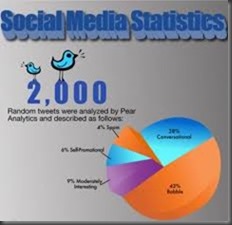 Another month has flown by and it is now time to report our Australian Social Media statistics for April 2013.
Another month has flown by and it is now time to report our Australian Social Media statistics for April 2013. As I have mentioned in the past, social media growth in Australia has slowed right up. The larger networks are now reaching saturation point and not growing like we saw in 2010 and 2011.
In Australia both Facebook and LinkedIn are happy to speak with members of the press about Australian user numbers. For some reason Twitter has never been so willing.
Last month I got a response from the official Twitter Australia, Twitter account – in regards to a question I have long been asking them: How many Australian’s are on Twitter?
This is a strange reply as Twitter have commented many times to the media about the US user numbers.
April 2013 stats:
(Please note the numbers below are the number of Unique Australian Visitors to the site over April).
1. Facebook – 11,489,380 Australian users/accounts (down approx 220).
2. YouTube – 11,000,000 UAVs (steady)
3. Blogspot – 3,000,000 (down 200,000)
4. WordPress.com – 2,900,000 (steady)
5. Tumblr – 2,800,000 (up 200,000)
6. LinkedIn – 2,700,000 ( down 57,000)
7. Twitter – 2,167,849 Active Australian Users (see calculation below)
8. Instagram – 1,083,924 Active Australian Users (see calculation below)
9. Flickr – 860,000 (up 10,000)
10. TripAdvisor – 830,000
11. Pinterest – 630,000 (down 10,000)
12. MySpace – 300,000 (steady)
13. Yelp – 220,000 (steady)
14. Reddit – 180,000 (up 10,000)
15. Google Plus – approx 100,000 (my estimation *revised*)
16. StumbleUpon – 95,000 (steady)
17. Foursquare – 51,000 (steady)
18. Digg – 33,000 (steady)
19. Delicious – 31,000 (steady) -
Australians suffer from Facebook fatigue
It appears Aussies are starting to suffer from ‘Facebook fatigue’, according to new data from a social media monitor.
The data, collected by social media monitoring firm Social Bakers, shows around 115,000 less people have logged on each month since the beginning of 2013 – with almost 400,000 users walking away from Facebook since December.
‘When Facebook was starting up they got a lot of people on and it was very novel, but the novelty has worn off a little bit, so now people are scaling back use,’ Social media marketing expert at the Queensland University of Technology Business School, Professor Larry Neale, told News Limited.
And it’s not just Down Under – in recent years, millions of users in the US and Europe also started deactivating their accounts.
A spokesperson for Facebook Australia disputed the figures, News Limited reports.
Story source: www.bigpond.com
-
Aussies social media use ‘in decline’
The amount of time Australians spend on social media sites is declining, according to new research involving three million internet users.
Interest in sites like Facebook and Twitter grew rapidly in Australia from 2010.
But new data shows time spent on these sites via fixed-line internet connections fell in 2012, with average users now spending 14 minutes out of every hour online using social networks, compared to 16 minutes per hour in 2011.
Similar falls were recorded in the US and UK, according to broader research by information services firm Experian, involving another 22 million internet subscribers.
‘The online landscape is constantly changing and it could be that we’re starting to see social networking sites reaching their peak,’ said Experian manager Matt Glasner.
-
Twitter to mine people’s tweets
Twitter has began to allow ads to be targeted at users based on the words written in ‘tweets’ and messages forwarded to followers at the popular social network.
Previously, contents of Twitter messages relied on algorithms that pool the interests of users to send them potentially relevant ads in the form of tweets ‘promoted’ at the top of feeds.
Twitter produce manager Nipoon Malhotra said the new feature would allow ‘advertisers to reach users based on the keywords in their recent tweets and the tweets with which users recently engaged.’
Malhotra gave the example of a concert venue being able to target local music lovers with tweets promoting upcoming shows by bands they have raved about in messages at Twitter.
‘Users won’t see any difference in their use of Twitter; we’re not showing ads more frequently in timelines, and users can still dismiss promoted tweets they don’t find relevant,’ Malhotra said in a blog post.
Twitter is expected to earn $US582.8 million ($A563.55 million) globally in ad revenue this year and nearly $US1 billion next year, according to industry tracker eMarketer.
Story source: www.bigpond.com
-
Twitter music app expected to launch
Buzz has continued to build about the social media giant Twitter’s launching of a new music app.
Key ‘influencers’ have already been given a sneak preview of the software ahead of a public roll-out, expected within days.
Tech site AllThingsD said the music service, originally mooted for a Friday launch, was expected to be launched on the weekend at the Coachella music festival at Indio, California.
Early on Saturday, Wiz Khalifa, who has nearly 10 million follows, tweeted: ‘Man this new Twitter music app is insane!’
On Thursday Ryan Seacrest wrote: ‘Playing with twitter’s new music app (yes it’s real!)..’
He added: ‘Lovin the app … shows what artists are trending, also has up and coming artists …’
The speculation surrounding the launch comes after Twitter confirmed it had acquired the emerging music software firm We Are Hunted.
The San Francisco-based music firm was launched in 2007 in Australia, and allows its users to follow emerging music trends and artists.
Its software continuously updates lists of top music around the world.
Neither company indicated their plans, but the We Are Hunted site strongly hinted the deal means Twitter will be launching a long-rumoured music application.
‘There’s no question that Twitter and music go well together,’ a statement posted on the wearehunted.com site said.
The new music app is believed to rank music based on personalised trends and trigger points, including what Twitter accounts are followed.
The AllThingsD report said users will be able to listen to clips of music from inside the app, using third-party services and watch music videos from Vevo, which is operated by Universal Music and Sony.
Story source: www.bigpond.com
-
Top reasons for small business failure: Study
Small and medium-size businesses are most likely to fail because of an inability to manage costs or anticipate rising costs, according to a survey of more than 1000 Australian owners of SMEs.
The survey, published yesterday by accounting software provider CCH and global information services group Wolters Kluwer, revealed SMEs see inexperienced management, a bad business model and lack of access to capital as other key reasons for small business failure.
Of those surveyed, 61% of SME operators said small businesses failed because of an inability to manage costs, 50% said inexperienced management, 50% said poorly designed business models or no business plan, 49% said insufficient capital, 37% said poor or insufficient marketing, and 35% said insufficient time managing the books.
Respondents were able to pick multiple reasons for failure and only 26% identified failure to seek professional advice as a key reason for failure, while 70% trusted their "gut instinct" over any professional advice.
-
Coalition says NBN will be cheaper and better
The federal coalition will deliver a faster, better, cheaper national broadband network (NBN) to all Australians if it wins government, Opposition Leader Tony Abbott says.
Whether for good or ill, these job seekers made a strong first impression
Mr Abbott launched the coalition’s broadband policy in Sydney on Tuesday with communications spokesman Malcolm Turnbull.
"We believe in a national broadband network," Mr Abbott told reporters.
"We will deliver a better NBN."Mr Abbott said if the coalition won government this year, users would be able to access a minimum download speed of 25 megabits per second (mps) by the end of its first term.
If it won a second term, the minimum speed would increase to 50mps for the vast majority of households.
While 25mps is about five times better than Australians get now, it’s still well down on the average 100mps being promised by Labor.
But Mr Abbott said rolling out fibre optic cable to the node – or street corner – rather than all the way to the home or business as Labor would do, would be cheaper.
"We will build fibre to the node and that eliminates two thirds of the cost," Mr Abbott said.
"So we will be able to do this for under $30 billion, compared to the over $90 billion it will cost the National Broadband Network (under Labor)."
Mr Abbott also announced plans for three inquiries, including a commercial review to be completed within 60 days of the coalition winning office into how quickly the NBN builder can meet coalition objectives.
There would also an audit into Labor’s NBN "mess" and an independent study into Australia’s broadband future needs, which would include a cost benefit analysis.
Under the coalition’s plan, the NBN rollout would be completed by the end of 2019, instead of the current deadline of 2021.
Priority would be given to areas with the poorest broadband services today.
The coalition also says basic broadband plans will "always" be more affordable.
It projects prices would be $24 cheaper per month by 2021 than Labor’s projected NBN prices.
But in areas where there was very strong need for high broadband speeds – such as business centres, educational centres, hospitals and new housing estates – there would be fibre-to-the-premise services.
Mr Abbott also said the coalition planned to sell the network to the private sector once it was ready.
Mr Turnbull said the government shouldn’t be building the NBN, when everywhere else such projects were being created by the private sector.
But he acknowledged that if the coalition won government it would inherit network builder NBN Co and would have to work with it.
He said the government had wasted billion of dollars that could not be recovered, but the coalition would save money.
The coalition says its plan will cost $29.5 billion.
Story source: www.ninemsn.com.au
-
Facebook Moves Into The Mobile World
Facebook unveiled a software suite overnight which stakes out a "home" on Android smartphones as it steps up its challenge to Apple and Google in the booming mobile market.
Chief executive Mark Zuckerberg said the new software weaves the social network into the home screen of HTC and Samsung phones powered by the latest versions of Android to focus experiences on "people and not apps."
"We’re not building a phone and we’re not building an operating system, but we are building something that’s a lot deeper than an app," Zuckerberg told a gathering at the company’s headquarters in Silicon Valley.
Facebook called the new software "a new way to turn your Android phone into a great, living, social phone."
The software, which allows users to see Facebook’s "Cover Feed" when they turn on their phones, will be available for download from Google’s online Play shop in the United States starting April 12, Zuckerberg said.
A version should be available in Europe in coming months, according to Facebook, which said it is in the process of tailoring "Home" for tablet computers.
-
EU countries take action against Google
Google’s new privacy policy is under legal attack from regulators in its largest European markets, who want the company to overhaul practices they say let it create a data goldmine at the expense of unwitting users.
Led by the French, organisations in Britain, the Netherlands, Germany, Spain and Italy agreed Tuesday on the joint action, with the ultimate possibility of imposing fines or restrictions on operations across the entire 27-country European Union.
Last year the company merged 60 separate privacy policies from around the world into one universal procedure. The European organisations complain that the new policy doesn’t allow users to figure out which information is kept, how it is combined by Google services, or how long the company retains it.
-
Google street views Japan nuclear zone
Google Street View is giving the world a rare glimpse into one of Japan’s eerie ghost towns, created when the March 2011 earthquake and tsunami sparked a nuclear disaster that has left the area uninhabitable.
The technology pieces together digital images captured by Google’s fleet of camera-equipped vehicles and allows viewers to take virtual tours of locations around the world.
Now it’s taking people inside Japan’s nuclear no-go zone, to the city of Namie, whose 21 thousand residents haven’t been able to return to live since they fled the radiation spewing from the Fukushima nuclear power plant two years ago.
Street View was started in 2007, and now provides images from more than three thousand cities across 48 countries, as well as parts of the Arctic and Antarctica.
-
Social networking spend slows in marketing budgets: Survey
A new survey shows marketing budgets will grow by 1% in 2013, following growth of 3.4% last year, while the growth of social networking and Web 2.0 is less pronounced than in 2011.
The 2013 Senior Marketer Monitor, conducted by the Australian Marketing Institute and Colmar Brunton, is based on a survey of 259 senior marketing professionals in Australia.
The aim of the study is to understand senior marketer sentiment, priorities, perspectives and challenges in the current marketing environment.
Marketing budgets will grow by only 1% in 2013, the report reveals, following growth of 3.4% last year.
A third (34%) of the marketers surveyed expect their marketing budget to increase in 2013, with these organisations anticipating an average increase of 16%, while 38% expect their budget to stay the same.
Meanwhile, 28% of marketers expect a decrease in 2013, and for these they anticipate an average decrease of 16%.
Nearly half of organisations with zero to 100 employees expect to increase marketing budgets this year, according to the report, with these smaller organisations more positive than mid-sized and larger organisations.
“Most organisation types and most industry sectors are reducing marketing budgets in 2013, with only smaller organisations, professional services and not-for-profit[s] growing budgets,” it said.
Organisations with zero to 100 employees will grow their budgets by 6% in 2013, while those with 101 to 1,000 employees will reduce their budgets by 1.7%.
There is also a great deal of variation at an industry level when it comes to the outlook for marketing budgets, the report said.
The media and communications (13%) and manufacturing (19%) industries have the lowest proportion of organisations increasing budgets in 2013, while professional services has one of the highest (45%).
The top marketing priorities include measures to increase sales, maximising efficiency of marketing expenditure, and focusing on more profitable market segments.
“Overall, there was slightly more emphasis on increasing sales and less focus on efficiency and brand-building compared with previous years,” the report said.
According to the report, there have also been shifts in the communication channels used by marketers.
“The use of social networking and Web 2.0 as a communication channel continues to grow, but the growth in this channel is less pronounced than in 2011,” it said.
“The popularity of viral marketing has decreased somewhat with less intending to use this channel more, compared with previous years.”
In 2011, 77% of the marketers surveyed used social networking and Web 2.0 applications. Last year, that figure fell to 66%.
Similarly, 32% of marketers used viral marketing in 2011, compared to 23% in 2012.
It’s worth noting marketers’ use of all communication channels has decreased, suggesting they have become less important to businesses in the current economic climate.
The use of online advertising fell from 64% in 2011 to 56% in 2012, while only 34% of marketers engaged in public relations last year, compared to 47% in 2011.
The use of direct marketing fell from 48% in 2011 to 38% in 2012, while mobile and SMS fell to 30% last year, down from 46% in 2011.
This article first appeared on StartupSmart.
Story by Michelle Hammond Story source: www.smartcompany.com.au
-
Many reasons Aust pays more for digital
Big music labels, steep freight costs and import taxes are being blamed for the higher prices Australians pay for everything from software to songs.
Global technology giants Apple, Microsoft and Adobe copped a caning on Friday at a federal parliamentary inquiry for slugging Australians up to 80 per cent more than people in other countries for their products.
The tech giants offered a range of explanations but failed to impress, with more than one MP branding their responses ‘evasive’.
Microsoft Australia managing director Pip Marlow said it was the global software giant’s right to charge what it thought the market would bear for its products.
‘We don’t operate on a single global price because we don’t believe every market is the same,’ she told the committee in Canberra.
‘We believe we are competing lawfully to win our customers’ business every day.’
But committee deputy chairman, Nationals MP Paul Neville, accused Microsoft of charging what it could ‘get away with in any particular market’.
‘You haven’t offered us any cogent reason other than your company policy why you are charging more in Australia,’ he said.
A recent study by consumer group Choice of 200 hardware and software products found Australians paid on average 50 per cent more than overseas customers.
Apple vice president for Australia, New Zealand and South Asia Tony King said what Australians paid to download digital songs, films and TV shows was determined by arrangements with the music labels, TV networks and movie studios.
Those content owners had different charges for content distributed in different countries.
‘The cards, so to speak, are in the hands of the folks who own the content,’ Mr King said.
Mr King said Apple was more than aware Australians were angry about it.
‘We are hearing comments in Australia that, frankly, make us uncomfortable,’ he said.
Mr King said exchange rates, local freight costs, import duties and local sales taxes also influenced the prices for computers, laptops, tablets and mobile devices.
Adobe’s managing director for Australia and New Zealand, Paul Robson, said Australians were blocked from accessing the software company’s US website – where prices are lower – to offer a more ‘personalised experience’.
Allowing Australians to buy the cheaper, although identical, product from Adobe’s US website would have an impact on global corporations’ willingness to invest in this country, run local operations and employ staff, he said.
Both Adobe and Microsoft talked up the use of cloud computing products, saying they offered more similar pricing between Australian and US customers.
The three technology giants were all called to appear before the committee after refusing to give evidence voluntarily.
Story source: www.bigpond.com
-
Twitter celebrates its seventh birthday
Some people can’t stand it, others can’t live without it.
Twitter turned seven on Thursday and with more than 200 million active users, the social media platform has no shortage of friends to celebrate with.
It’s come a long way since March 21, 2006, when web developer and Twitter creator Jack Dorsey sent the first tweet: ‘just setting up my twttr’ (twttr was the platform’s early name).
Now roughly 4600 tweets are sent every second.
-
Google Maps adds view from Mt Everest
Google has added views from some of the world’s tallest mountains to its popular online map service.
Armchair explorers were invited to take virtual adventures with members of Google’s Street View team to Aconcagua in South America, Kilimanjaro in Africa, Mount Elbrus in Europe and Mt Everest base camp in Nepal.
‘Whether you’re scoping out the mountain for your next big adventure or exploring it from the comfort and warmth of your home, we hope you enjoy these views from the top of the world,’ Google adventurer Dan Fredinburg said in a blog poston Monday.
‘With Google Maps, you can instantly transport yourself to the top of these peaks and enjoy the sights without all the avalanches, rock slides, crevasses and dangers from altitude and weather that mountaineers face.’
The mountains climbed by the Street View team were among peaks referred to as the Seven Summits, the highest peaks on the Earth’s continents.
‘Googlers’ who made the ascents took the pictures with tripod-mounted digital camera equipped with a fisheye lens to capture 360-degree views.
Street View teams have cycled, driven and walked through cities and towns around the globe capturing images to add to online maps, letting people see what it might be like to stand at a spot they are curious about.
Google has added images from a Nunavut community in the Canadian Arctic and a portion of the Amazon in Brazil.
-
Facebook to use Twitter hashtag
Facebook is preparing to take on Twitter by adopting the messaging service’s iconic hashtag symbol, The Wall Street Journal reports.
Users of the globally popular one-to-many messaging service Twitter use # or pound symbols as a hashtag to indicate subjects in tweets.
The style is such an entrenched part of the Twitter language that the San Francisco-based company added a hashtag search feature to make it easy for users to find messages focused on themes or happenings of interest.
For example, people firing off messages at Twitter about a hurricane might use the hashtag #storm.
The Journal cited unnamed sources as saying Facebook is incorporating hashtags into the social network in a move that would let members organise comments and posts by topic.
The report said Facebook is testing use of the symbol but that the feature was not likely to be introduced imminently.
-
Facebook feed becomes personal newspaper
Facebook has started transforming the stream of updates from friends at home pages into a ‘personalised newspaper’ with news ranging from the personal to the global.
The News Feed on home pages at the leading social network has been revamped to get rid of clutter and present ‘bright, beautiful’ stories whether they are insights from friends or trending news of the day.
‘I think there is a special place in the world for this sort of personalised newspaper,’ Facebook co-founder Mark Zuckerberg said in introducing the overhauled News Feed.
‘It should have a front page and top news section or let you drill down into any topic you want.’
Facebook began rolling out the new News Feed ‘very slowly’ at its website reached by desktop or laptop and planned to begin adding it to its smartphone and tablet applications in the coming weeks.
Each News Feed will automatically be tuned to the interests of individual Facebook users, according to technical lead Chris Struhar.
Pictures in the feed will be gleaned from posts by friends or online pages people have indicated they ‘like’.
If a Facebook user follows pages from CNN or other professional media organisations, top shared or trending stories are displayed.
Music or film lovers should see News Feeds touting fresh developments regarding bands, stars, movies, songs or other related subjects.
Struhar told AFP ‘we hope you get all you need’ without having to leave Facebook.
While the amount of content shared at Facebook has soared, the amount of time people have to spend at the social network remains limited, inspiring the drive to more efficiently connect people with news they most care about.
‘Of course we all want to share with our friends, but we want updates from our favourite publications, artist, world leaders and more,’ Zuckerberg said. ‘This is the evolving face of News Feed.’
News Feed will give more prominence to major stories being shared by friends in the social network; trends at third-party applications such as Pinterest or Instagram, and weave in important personal bits such as a cousin with a new job.
‘When I wake up in the morning and see all my friends are sharing the exact same news story or video, I know it must be something big,’ said Facebook director of design Julie Zhuo.
‘You get a richer, simpler, more beautiful News Feed focused on the things you care about, what your friends are saying, and what is trending.’
Story source: www.bigpond.com
-
Cyber attacks more targeted: Aust survey
One in five major Australian businesses suffered a cyber attack in the past year, with attacks becoming more coordinated and targeted, a government survey shows.
With the most serious attacks involving malicious software and theft or breach of confidential information, essential service industries are starting to invest more heavily in tighter cyber security.
The 2012 Cyber Crime and Security Survey, set to be launched in Melbourne on Monday by Attorney-General Mark Dreyfus, also found that one third of attacks involved the theft of notebook and tablet computers or mobile devices.
‘Cyber attacks have shifted from being indiscriminate and random to being more coordinated and targeted for financial gain,’ Mr Dreyfus said in a statement before the launch.
‘Most attacks occur from outside the business, although it appears internal risks are also significant.’
One business reported the theft of 15 years’ worth of critical data.
The survey found that energy, defence, communications, banking, finance and water organisations are now investing more heavily in cyber security.
The survey was commissioned by the federal government’s Computer Emergency Response Team (CERT).
-
Facebook is following you
Facebook will soon be the new Big Brother, after the completion of a smartphone app to track user’s locations.
While Facebook already has the right to know who you are, what you’re doing, or what you’re searching, it has been announced that a smartphone app to track your whereabouts at any given moment is scheduled to be released in March, according to Fairfax.
Although the app is intended to help users find nearby friends, it will continue to run on your phone even if the program isn’t in use, which is said to help Facebook in their marketing and advertising tactics for individual users.
The development of the track app will in turn change Facebook users’ choice to post location updates or keep them secret – a feature option already available.
-
eBay CEO says web privacy clashes coming
Internet companies will soon have to find a way to protect user privacy to avert a ‘clash’ which could lead to increased government regulation, eBay chief executive John Donahoe says.
‘There’s going to be, at some point in the next few years, a trigger point,’ Donahoe told a New York breakfast meeting organised by The Wall Street Journal, noting the need for ‘a national dialogue about what is acceptable or not’.
Donahoe said it would be best for the industry to take ‘proactive’ steps to avoid a backlash.
‘It’s going to be necessary for us to have some national dialogue on privacy, so we don’t have a clash point and they over regulate and slow down innovation,’ he said.
He said eBay’s business model does not revolve around monetising data but that this has become a greater concern for web companies.
‘We won’t share your information with anyone else, but I think there are huge opportunities to use data, to customise the experience, to personalise the experience, and if you choose to share with others, it can make the experience even better,’ he added.
Donahoe said users of eBay should know that ‘there’s no absolute guarantee of privacy’ for illegal activity and that ‘we can’t stop a court order’.
‘We comply with the laws of the lands we operate in and we don’t operate in lands where we wouldn’t feel good about the laws,’ he added.
Story source: www.bigpond.com
-
Us Regulator Drops Charges Against Google Monopoly
After a 20-month probe, US regulators have announced they will not charge Google over its internet search practices.
Rivals accused the internet giant of producing biased search results and abusing its market dominance to thwart competitors.
The Federal Trade Commission said it lacked a legal basis to bring a monopoly abuse case against the company, but found that Google had misused its broad patents on mobile phone technology.
In an attempt to protect competition for US consumers, the Commission ordered Google to make that mobile phone technology available to its rivals.
In a voluntary settlement, Google also agreed to change its "most troubling" search and advertising practices.
These changes included agreeing to no longer "scrape" competitors’ content to make it look like it came from Google and using contractual restrictions to stop small businesses from advertising with rival search engines.
Source: ABC News, AFP
-
13 Social Stats to Take to Heart in 2013
The New Year is almost upon us and with it brings time for word of mouth practitioners to reflect on what new opportunities lie ahead. The world of digital and social has arguably opened more doors for marketers and communicators than any other media in recent history. This Thursday we’ll be joining WOMMA for a Twitter#WOMMAchat talking about 2012 trends, favorite moments and “must-know” statsto keep top of mind going into the new year.
We hope you’ll join us at 11am CST for a lively discussion, but in the meantime, there are some key stats and trends worth reading that speak to or highlight strategic opportunities for social brands. They range from consumer preferences to brand activity, but each illuminate different proof points on the power of social. And their implications can help anyone looking to wrap up 2013 strategic planning.
The rise of social as an interactive avenue between brands and consumers.
Social customers are active and increasingly willing and ready to socially interact with brands. From Likes and Retweets to Shares and Clicks to websites, brands are finding social customers can be highly engaged when brand activity resonates with them. Because of this, brands are expanding internal resources to better interact.1. By EOY more than 60 percent of Fortune 500 companies will “actively engage” customers with Facebook marketing – up 20 percent from 4th Q 2011 (Source: Gartner).
2. Brands are receiving 1,985,000 interactions across all social channels each quarter (Source: Spredfast Social Engagement Index Report)
3. On average, brands are engaging at least 29 employees internally to activate their social presence(s) (Source: Spredfast Social Engagement Index Report).
4. 17 percent of customers have used social in past year to get customer service response (American Express 2012 customer barometer).
5. Page views in social are 94 percent higher when they contain an image or visual element (Source: Brafton).
Social has the ability to convert.
Brands are increasingly viewing social as not only an avenue for marketing and word of mouth, but more data is showing that social can and does increase Sales.6. 34 percent of marketers have generated leads using Twitter (source: Digital Buzz Blog)
7. Pinterest referrals spend 70 percent more money than visitors referred from non-social channels (source: Search Engine Journal).
8. LinkedIn was found to be 277 percent more effective at lead generation than any other social network (Source: Hubspot).
Social = Word of Mouth.
Organic sharing, recommendations, and user activity is spurring natural word of mouth for brands across social networks.9. 69 percent of follows on Twitter are suggested by friends (source: Web Analytics World).
10. During SXSW this year, the brands sponsoring the event potentially reached 33,154,224 people via Twitter. (Source:MediaPost & Adrants)
Embracing preferences of social consumers.
Data around social users is helping brands to learn and validate the hyper-active nature of their target audiences across social channels.11. 23 percent of Facebook’s users check their account 5 or more times daily (source: Socialnomics).
12. 80 percent of social media users prefer to connect with brands through Facebook (source:Business2Community).
13. 38 percent of consumers report that discounts and money saving vouchers are most important to them when following a brand in social, with information about new Products and Sales being a close second at 36% (Pitney Bowes study).
Story by Jordan Viator, Story source: www.socialmediatoday.com
-
Microsoft Windows Issue with My Computer Scam
I’ve just got off the phone with an Indian speaking call centre claiming to be the Technical Department of Windows, who were informing me that we had an issue with our version of windows and it needed to be fixed. I thought this very interesting, particularly that our computers here in the office were sending error log reports back to Microsoft and they were being kind enough to ring me to fix it for me.
For the record the name of the person calling was initially Jessica from South Sydney and left the following phone number, 1973 200 6677, after this call we hung up and they then rang back, this time with a male caller .
Well first up, this is a total scam, please do not fall for this type of call, Microsoft do not call you to advise of a problem, nor is there any problem with our operating system. The caller could not tell me when I asked what version of windows we running, he did however, get quite annoyed with me for being so up front and actually asking him what version of Windows our computers were using.
Do not under any circumstances give them any information about your computer or operating system, do not provide any details of your computer, and do not go to any web site link they give you nor type in any so called “job Code” or any other code.
Please do not even entertain these scammers, they are not genuine and are out to cause you trouble.
Just hang up straight away. Be Warned.
-
Fake product reviews and sites next in line for ACCC crackdown
One area of Internet marketing we constantly get asked about by our clients is negative reviews of their products on review forum sites. As these sites tend to have a high organic search result in Google they often rank higher or just below the company themselves, and if the review is negative and there are a few of them from disgruntled customers, it can affect not only the On Line reputation of the company but also sales.
We are often asked to remove these from the search results, and of course that is easier said than done. The best form of defence is not to have the bad reviews there in the first place, but lets ask a question, how many of them are actually genuine reviews?
Are you asked for a proof of purchase before your review is accepted? do you check the email addresses or user names of the people writing the review?
I know of one client where the negative reviews, which resulted in a poor star rank, was actually caused by a competitor leaving bad reviews under assumed names, this is really a form of commercial sabotage.
So where is the policing of these reviews? in the more traditional media, an editor will first audit the review and then decide on wether to publish. That process is given lip service with the forum sites, and as long as you don’t defame the company your review seems to be freely published.
I’ve never been contacted by any review site either before or after a review has been published, to ascertain the genuineness of my review, even to find out if I’d ever actually used the service or product, the assumption is I have.
As a frequent traveller, I will often look at customer reviews of hotels or resorts to make decisions on wether I’ll use them for accommodation or travel, and often have changed my selection based on other peoples reviews. But how do you really know they’ve actually been there?
Of recent times, I’ve become very suspicious of reviews and now research more thoroughly before making my choice.
It’s about time that the ACCC is now looking into this, it has the ability to impact on small business in a big way, it’s hard enough for small business to compete for clients in the current economy, and the last thing they need is this impacting on their business.
If you are interested in the actual story, I’ve included it below for you to read:
“Businesses have been put on notice after the competition watchdog warned it will be cracking down on fake product reviews and online voucher rip-offs in the new year.
Following a spate of complaints about businesses taking advantage of customers or other companies, the Australian Competition and Consumer Commission has changed its focus.
While it will continue to scrutinise door-to-door selling – which led to fines of $1 million this year – a number of other issues have come to the fore.
According to ACCC chairman Rod Sims, fake online reviews have emerged as an issue as reviews become increasingly popular among consumers.
"Companies [are] either making [them] up themselves or getting other people to make up positive reviews," Sims told News.com.au.
"Sometimes Blind Freddy can see what’s going on, but sometimes they are more subtle."
The ACCC will also investigate group buying – which attracts around 140 complaints every month – and will continue to scrutinise companies that dodge consumer guarantees.
It will also maintain its special carbon tax taskforce, although Sims admitted carbon tax complaints "have slowed to four or five a day".
The announcement comes one week after the ACCC released a free app to provide consumers with instant advice while they are out shopping.
According to ACCC deputy chair Delia Rickard, the app will "help to take the worry out of Christmas shopping".
"Simple disputes over returns, refunds or replacements often leave shoppers confused about their rights," Rickard said in a statement.
"The app answers commonly asked questions about refunds, returns, warranties, and lay-bys, such as ‘What do I do if a product is faulty?’ and ‘What happens if I don’t have a receipt?’.
"The app will allow consumers to store photographs of receipts as proof of purchase on their smartphone or tablet at the point of sale.
"Keeping your proof of purchase and checking the store’s returns policy if you have simply changed your mind can be important."
Rickard pointed out the Australian Consumer Law provides stronger protections against faulty products, often allowing for repairs, replacements or refunds outside of a manufacturer’s or retailer’s warranty period.
"If products don’t work as promised or don’t work at all, you have rights as a consumer regardless of whether you bought it online, in a shop, full price or on sale," she said.
"The app explains the steps to take when enforcing these consumer rights."
The app also has a "My items" feature, which allows consumers to set reminders for when lay-bys are due, and the expiry date for warranties and gift vouchers.
It also explains common labelling terms like "Made in Australia".”
This article first appeared on StartupSmart.
-
Ransomware – How to Avoid Your Computer Being Infected
 Ransomware or in other words having your computer hacked and held to ransom by cybercriminals is on the rise, especially if you are in a small business and your computer security protocols are not up to date or non existent. We’ve seen a number of businesses targeted over the last few months as it is an easy and effective way of getting your hard earned cash, and it can be done from thousands of miles away, even in another continent.
Ransomware or in other words having your computer hacked and held to ransom by cybercriminals is on the rise, especially if you are in a small business and your computer security protocols are not up to date or non existent. We’ve seen a number of businesses targeted over the last few months as it is an easy and effective way of getting your hard earned cash, and it can be done from thousands of miles away, even in another continent.What is Ransomware? According to Symantec, it’s a type of malware best described as an online extortion racket. Malware locks or disables your PC in some way and then demands payment in the form of a “fine” to render your PC usable again. Like most scams, the ransomware message claims to come from a legitimate organization, such as the government or a public corporation, to try to convince victims that they did something wrong to incur the fine.
But paying the fine does nothing since the initial malware remains on the PC and must still be manually removed.
This scam has risen in popularity over the past several years, but 2012 witnessed an increase in both the number and variety of ransomware campaigns, Symantec said in its report. That growth is due largely to a upsurge in the number of worldwide criminal gangs using this scheme to make a buck.
I’ve personally had a number of emails sent to me that are obvious fishing emails, including emails from brands such as Qantas, Jetstar and Facebook and even one from Microsoft. They are not genuine of course, but attempts to get me to click on a link in the body of the email or download an attachment. They look very real and convincing, and it is only when you stop and think about the content, that you realise it is an attempt to hack into your computer network.
The virus can be loaded onto your computer or network from several areas, emails are one, surfing the web and visiting sites that contain malware is another, quite often you will get to these sites from social media or shopping networks that you are browsing, also web sites that indicate your computer or software programs such as Adobe flash player or PDF Viewer are out of date, and offering links to download the current version are all scams to get you to download the malware. The other way this virus gets into your system is via file sharing sites, the Trojan is hidden in the files and when downloaded and installed your system is compromised.
One of the weaknesses in ransomware though, is once you know what to look for it’s fairly easy to spot and avoid. Briefing all staff that operate your computers or networks on what to look for is a good start, and I’ve compiled a list below that will help protect your computer and network from being infected, after all, prevention is better than cure, and there are some simple rules to follow that will stop these cyber crims in there tracks.
1. Make sure you install and keep updated the latest in anti virus and an anti malware software. Brands such a Norton, Kaspersky and McAfee are all excellent anti virus tools. I use Norton on my work computers and it constantly updates itself every 30 minutes, it always is up to date and has protected our network many times from intrusions and malware.
2. Make sure your computer is set to automatically download software updates from Microsoft. These contain security updates and malware removal tools. If your computer is not set to download and install these make sure you set it after reading this article.
3. Back up your computer every night and create restore points so that your computer can be reset to a time prior to being infected. Also where possible store the back up in a different location so that it remains unaffected.
4. Avoid downloading or using file sharing sites, they are breeding grounds for all sorts of computer virus’s.
5. Never download or click on an attachment in an email. Even if you know and trust the sender, make sure the attachment is clean by scanning it first with your virus software. Some cyber criminals will hijack contact address books and send phishing emails to all addresses in that data base. So beware.
6. Be very careful about emails you receive from Facebook and other social network sites requesting friend requests and offering special deals. These notifications can look genuine, so check them out thoroughly. Do not have a policy of clicking every link you get from these sites. Always check and recheck. If it looks suspicious, delete it immediately.
7. Use safe browsing techniques when searching on the web. Never click on a download link from a site that tells you your software is out of date or computer is at risk. Only download new versions from the developers sites.
8. Avoid clicking on banners or links on web sites that you are not familiar with.
If you feel your computer may have been compromised, there are several anti MalWare programs you can use to check your system, programs such as Norton Power Eraser or Microsoft Security Essentials. They will tell you wether your computer has been infected and instructions on how to remove the infection.
Of course if your computer is locked and you cannot access it, you need to contact a computer specialist who will advise you on wether the ransomware can be removed and what steps you’ll need to take. That’s for another article.
Don’t make paying the ransom your first step!!!
Remember prevention is better than a cure.
-
Facebook Pages: Usage Patterns
Facebook Pages (popularly known as ‘Fan Pages’) are a starting point for businesses wanting to connect to millions of potential and existing customers on Facebook. A Page allows brands to disseminate marketing and service information fast and lets customers interact directly with stake holders.
Pages are also an important component of Facebook’s own revenue model[i] as 89% of Facebook’s total revenues come from brands advertising on the platform and Facebook attracts brands through Pages.
The past six months have been significant for Facebook Page owners. In the run up to its IPO and subsequently too, Facebook released a host of features such as the Timeline view, Offers, post scheduling and targeting, post-level promotions, group promotions, redesigned ad network, FB exchange etc to make Pages more attractive to businesses. The six month period has also seen a conscious effort by Facebook, and the social media industry in general, to raise awareness about Pages as potent social marketing properties.
Pages attract business users to Facebook and lead the social network’s efforts to earn advertising revenues. However, this study of 5.7 million Facebook Pages shows that business users are still struggling to adapt to Facebook as an engagement opportunity.
The study updates the findings of a similar research conducted by Recommend.ly in March 2012.
The current study discovered low levels of active Pages, fall in average number of posts and a huge drop in engagement rates since March. Page owners clearly need to do more to make Facebook work for them.
The study also found that the share of visual content on Pages has increased after the introduction of Timeline view for Pages. Also, it is found that Pages selecting specific category names such as ‘Spa’ or ‘Restaurant’ tend to be more focused and get better engagement from fans, compared to Pages choosing generic sounding category names such as ‘Local Business’.Key Findings
- About 2 out 3 Facebook Pages are inactive in some way:
- 63.9 per cent Pages have no cover photo
- 70.1 per cent Pages make 0 posts a month
- 83.4 per cent Pages never participated in conversations
- 50 per cent Pages have less than 300 fans
- Pages are found to be making lesser posts in October 2012 compared to March 2012. Average number of Page posts fell by 19 per cent since March.
- Engagement Rates of Page posts across categories have fallen since March by an average of 40 per cent
- 50-60 per cent of content on Pages is now visual content (photos or videos) compared to just 15-20 per cent in March
To read the full report please click here http://blog.recommend.ly/facebook-pages-usage-patterns/
- About 2 out 3 Facebook Pages are inactive in some way:
-
Copy and Paste Drives Sharing

Copied content indicates what really engages—and what drives users off-site
Social sharing buttons may be sexier, but according to research from user engagement platform Tynt, copy and paste is the sharing method of choice 82% of the time.
The service, which offers a way for content publishers to track sharing behavior through embedded code that indicates referrals and includes site URLs when content is pasted elsewhere, reported that in October 2012, 2% of all page views across its network involved a copy and paste.
Just over half of the content copied was then shared. This could be in an email, an instant message or another social channel. In addition, about one-quarter of copy-and-pastes resulted in a search—that is, a word or phrase from the content being viewed was copied into a search bar to look for more information on the topic.

For users, copying and pasting to share content holds obvious appeal: It’s almost frictionless, and it allows the sharer to choose exactly what to pass on to a friend or social network.
“You probably have a lot of friends sharing the same article,” Tynt general manager Greg Levitt said. “But when you can specifically call out a personalized, relevant aspect, it makes the story your own.”
On the search side of the equation, copy-and-paste analytics give publishers information about what content is actually driving users away from their sites.
Tynt also reported that while the vast majority of copied-and-pasted content is text, 12% of copied content was images.

Publishers know based on other types of sharing which pages are driving social engagement—but not necessarily why. When they can dig into the specific phrases and passages of text that readers want to pass on, it gives them a deeper window into what content users are really engaging with.
Story Source: www.emarketer.com
-
The Top 10 tech trends for 2012
(CNN) — From the continuing rise of tablet devices to the daily-deals craze and the return of the Internet IPO, 2011 has been a transformative year for technology.
The pace of change has become blisteringly fast, with traditional industries — bookstores, video-rental chains, newspapers — crumbling more quickly than we could have imagined.
Predicting what will happen in 2012, therefore, is a shot in the dark: A year is virtually a lifetime in the digital era. And yet we can at least make a guess at what will happen in the early part of next year simply by looking at the trends that are shaping the latter half of this year.
Here’s my best estimate of some of the innovation we’ll see in 2012:

Pete Cashmore is the founder and CEO of Mashable.com.
1. Touch computing
New input methods will be the dominant trend of 2012. Tablet computers such as the iPad might seem like a nice alternative to desktop and laptop computers, but I believe they’re more than that: They’re replacements. Just as the command line (remember that?) gave way to graphical user interfaces, so the mouse will be superseded by touchscreens.
The signs are obvious: Windows 8 and Mac OS X Lion, the latest desktop operating systems, borrow heavy from their mobile counterparts. These new interfaces essentially impose a touchscreen-inspired interface over the traditional desktop environment.
Over time, this half-step will become a whole one, and mobile operating systems will dominate. The transition won’t be complete by the end of 2012, but we’ll be much further down the path, and using computer mice much less often.
2. Social gestures
In the social media realm, social gestures appear to be the leading trend of 2012. Launched by Facebook in September, this so-called "frictionless sharing" functionality removes the need to click a button to share media with your friends. Instead, everything you listen to, read or watch is automatically posted to your profile once you approve the relevant app.
If you’ve seen apps such as Spotify or Social Reader in your Facebook news feed, you’re already aware of these features.
The trend makes sense for social networks: With 800 million people already on Facebook, its growth is bound to slow. But if sharing becomes automatic, the volume of content on Facebook will grow at an accelerated pace. There’s a big problem, however: Users may be "creeped out" by all this automated sharing of their Web activity and grow suspicious of the apps using it.
3. NFC and mobile payments

Google Wallet, Google’s mobile-payment system, may become more widespread in 2012.
Next year is likely to be the year when mobile payments blossom. While we’ve seen a great deal of innovation in mobile payments technology this year — including the success of Square’s iPhone dongle, allowing anyone to accept credit card payments — 2012 is the year of NFC.
What’s that, you ask? Near Field Communication essentially lets you replace your credit cards with your phone: Wave an NFC-enabled phone near the credit card reader in a store (or taxi cab), and the money is deducted from your account.
By 2013, 1 in 5 cellphones are expected to be NFC-equipped. Early contenders include Google Wallet, Visa Wallet, Serve (by American Express) and ISIS.
4. Beyond the iPad
If touch computing is the future, then the iPad is surely king. And yet the iPad came up against serious competition in the latter part of 2011: As I wrote previously, I expect the new Amazon Kindle Fire to outsell the iPad in 2012. Why? Simply put, the iPad costs $499 while the Fire costs $199.
Amazon’s advantages don’t stop at the price point, however: The company owns an entire content store of movies, e-books, TV shows and other media. With tablet devices, the hardware is somewhat important but the content available for the device is absolutely critical: With plenty of media available for the Fire right away, it’s an appealing proposition.
Why does one device constitute an entire trend? Well, as a true competitor to the iPad emerges, content producers, distributors and even app developers may have an entirely new platform on which to push their wares. (And yes, the Kindle Fire does indeed run Google’s Android operating system, but Amazon’s version is so unlike other Android tablets that neither users nor app developers will perceive it as "yet another Android device" — it’s a whole new platform.)
5. TV Everywhere
So you thought you’d be able to watch all your favorite shows online and get rid of your cable subscription for good? Not so fast!
The cable companies have a cunning plan: They’ll let you watch live TV, plus on-demand movies and TV shows, on your connected devices if you keep your cable subscription. Dish Network, Time Warner and Comcast are among those offering the service.
TV Everywhere has been buzzed about since 2010, of course, and could be a dud — but the rise of tablet devices would seem to create increased demand for a "TV in your hands."
6. Voice control
Here’s another trend that’s got a moderate chance of taking off in 2012: Voice control.

Siri, the voice-control feature in the iPhone 4S, may spread to other devices.
The novelty of Siri on the iPhone 4S — which allows you to send texts, create reminders, search the Web and much more using just your voice — may be the start of a new trend in voice controlled devices.
Surely voice control has been around for years? Yes, but it wasn’t very accurate.
Siri and its ilk define a new era in which we talk, and our devices understand — often on the first attempt. Other device makers will likely follow suit. What’s more, Apple may use voice control to replace the TV remote.
7. Spatial gestures
Other input methods are gaining traction too: Microsoft’s Kinect, for instance, has given rise to interfaces that use spatial gestures. Just like in "Minority Report," your devices can be controlled simply by waving your hands in the air.
Thanks to the many innovators who have hacked Kinect to work with other platforms, we may see more devices using this input method next year.
8. Second-screen experiences
"Second-screen experiences" is a buzz-phase among TV and movie execs these days. It refers to apps (mainly on the iPad) that listen to the audio output of your TV and display content related to the show or movie you’re watching. The chances are that you already use your tablet computer or phone while watching TV, so there’s ample opportunity to make the viewing experience a more interactive one.
Disney already has second-screen apps for movies such as "The Lion King" and "Bambi," while multiple TV networks have similar offerings: We can expect many, many more to be released in 2012.
9. Flexible screens
Personally, I just can’t wait for flexible screens: These awesome new bendable interfaces will let you zoom in, zoom out and scroll around a page simply by twisting your phone or tablet.
Nokia and Samsung have both hinted they may release phones with bendable displays in 2012. The really exciting stuff, however — like paper-thin devices that roll up to fit in your pocket — is still years away.
10. HTML5
Can I squeeze in one more trend? It’s HTML5 — the fifth iteration of the HTML standard — and it lets developers create richer, more interactive applications than ever.
Why does this matter? As developers tire of building applications for every operating system out there — from Android to iOS to Windows Phone and beyond — HTML5 offers the opportunity to build an app once and have it work everywhere.
The rise of HTML5 is bound to be accelerated by a recent revelation: Adobe is killing off Flash for mobile devices, meaning one of the primary methods of serving videos and rich applications on mobile phones is about to disappear. HTML5 will fill that gap. For us as consumers, that means richer applications and experiences on all our devices.
In short, 2012 is all about new ways to interact with our devices through touch and voice control, new lightweight ways to share content, a revolution in mobile payments and a plethora of rich Web applications — not to mention the hundreds of new innovations that we’ve yet to dream up. I can’t wait.
Story by By Pete Cashmore, Special to CNN, story source: www.cnn.com
-
Consumers, Marketers Disagree on Effective Ads

Internet users think TV ads are more effective than online placements
Even while marketers have taken strongly to digital advertising, they haven’t abandoned traditional media by any means—TV still takes the largest share of ad dollars in the US, and its percentage of the total isn’t slipping. But with the measurability inherent in online ads, confidence in their efficacy is generally high.
In an October Adobe survey of marketers and consumers, US marketers even rated online ads better than TV ads—though just barely, with 51% saying that they were more effective. But consumers appeared stuck in the past, with about two-thirds claiming TV commercials were more effective.
Consumers also appear to like seeing ads in traditional media better than on newer digital devices. Asked about their preferred venue for ads, 45% said they liked seeing them in their favorite print magazine and 23% on their favorite TV show, compared to just 11% who chose favorite websites, 3% who chose social media and 2% who liked to see ads in digital magazines.

Marketers and the consumers they are trying to reach disagreed on the effectiveness of a wide variety of ad types, according to the survey. Though both groups thought the best ads were those created by professional marketers, nearly half of marketers said this, compared with just 36% of internet users. There was large disagreement about the effectiveness of paid search ads (touted by marketers, played down by web users) and outdoor advertising (the reverse). Internet users were also much more likely to say there were no good or effective ads—positions which marketers were extremely unlikely to hold, for obvious reasons.

So what did consumers like? Nearly three-quarters thought ads should “tell a unique story, not just try to sell,” while about two-thirds said videos and user product reviews were good and that in-store experiences were more important than online ones.
The message for marketers may appear mixed, but it’s not exactly news that consumers don’t love to see advertising—or that they consider information from people they trust better than a hard sell.
Read more at http://www.emarketer.com/Article.aspx?R=1009480&ecid=a6506033675d47f881651943c21c5ed4#OcuGwUXYp07WpPqo.99
-
Microsoft ditching MSN chat for Skype
Microsoft has announced that its instant message chat tool is to be ‘retired’ in favour of Skype’s messaging service.
The software giant, which bought Skype for $8.5bn (5.3bn) in May 2011, said Windows Live Messenger (WLM) would be turned off by March 2013, although it would remain available in China.
The move comes as Microsoft re-focuses its efforts on the software communications developer.
WLM, originally called MSN Messenger, was launched in 1999. Since then, photo messaging, video calls and games have been added to the basic text messaging package.
In a post on his Skype blog, Tony Bates, president of the Skype Division at Microsoft, wrote: ‘Skype and Messenger are coming together. We will retire Messenger in all countries worldwide in the first quarter of 2013 (with the exception of mainland China where Messenger will continue to be available).’
According to Tech Crunch, user numbers have been dwindling over the years.
In 2010, it had 300 million users, falling to 100 million currently, the website reported Microsoft as confirming. Meanwhile, Skype has reached 280 million users, according to Microsoft’s latest earnings report.
News of the changes was confirmed by Skype on Twitter, saying: ‘Messenger and Skype are coming together as one. Update to Skype and your Messenger contacts will be there.’
Mr Bates wrote in his blog: ‘Millions of Messenger users will be able to reach their Messenger friends on Skype. By updating to Skype, Messenger users can instant message and video call their Messenger friends.
‘This effort started with the release of Skype 6.0 for Mac and Windows a few weeks ago, which allows you to sign into Skype using a Microsoft account. Now Messenger users just need to update to the latest version of Skype, sign in using a Microsoft account, and their Messenger contacts will be there.’
The statement promised Messenger users who update to Skype the following features:
:: Broader device support for all platforms, including iPad and Android tablets.
:: Instant messaging, video calling, and calling landlines and mobiles all in one place.
:: Sharing screens.
:: Video calling on mobile phones.
:: Video calling with Facebook friends.
:: Group video calling.
Mr Bates added the changeover would be carried out over the next few months, and offered ‘information and help along the way’.
Story source: www.bigpond.com
-
Friend your boss at your peril
Thousands of young Australians might have to update their Facebook status from hired to fired, sooner than they’d like.
A survey’s found almost one-third of workers aged between 18 and 25 are friends with their boss on social media, but almost 60 per cent admit they’ve never cleared potentially career-damaging content from their profiles.
Anti-virus company, AVG, says 13 per cent of working Gen Y-ers in Australia admit to posting abusive content about their boss or company after a bad day at work.
Story source: www.bigpond.com
-
US Internet Ad Revenues Rise to Historic $17 Billion in First Half 2012, Up 14% Over Half-Year 2011

Mobile Increases Almost Two-Fold Year-Over-Year
In the first half of 2012, internet advertising revenues climbed to an all-time high of $17 billion, representing a 14 percent increase year-over-year, according to IAB Internet Advertising Revenue Report released today by the Interactive Advertising Bureau (IAB) and prepared by PwC US. This performance is compared to the landmark $14.9 billion reported for the first six months of 2011.
Also marking a 14 percent year-over-year increase, second quarter internet ad revenues for this year hit $8.7 billion, up from $7.7 billion during the same time period in 2011.
Highlights of the report include:
- Mobile generated significant growth – almost doubling year-over-year – up 95 percent to $1.2 billion in half-year 2012 from $636 million in the comparable 2011 period
- Digital video, a component of display-related advertising, saw an increase of 18 percent year-over-year, bringing in a little over $1 billion in revenue in the first two quarters of 2012 compared to nearly $900 million in the first six months of 2011
- Search revenues in the first half of the year totaled $8.1 billion, up 19 percent from nearly $6.8 billion during the same timeframe in 2011
- Display-related advertising revenues in the first half of the year totaled almost $5.6 billion, accounting for 33 percent of 2012 half-year revenues, up 4 percent from $5.3 billion in the first half of 2011
- Retail advertisers constitute the largest category of internet ad spending for the first half of this year, claiming 20 percent of the total revenues at $3.4 billion, while Automotive brought in $2.2 billion for first-half 2012, marking an uptick to 13 percent versus 11 percent of category spend reported for half-year 2011 at $1.7 billion
“This report establishes that marketers increasingly embrace mobile and digital video, as well as the entire panoply of interactive platforms, to reach consumers in innovative and creative ways," said Randall Rothenberg, President and CEO, IAB. “These half-year figures come on the heels of a study from Harvard Business School researchers that points to the ad-supported internet ecosystem as a critical driver of the U.S. economy. Clearly, the digital marketing industry is on a positive trajectory that will propel the entire American business landscape forward.”
“The tremendous growth of mobile advertising revenue over the past year is an indication of the importance of location to advertisers and mobility to consumers,” said David Silverman, a partner at PwC US. “Bringing the power of the internet to mobile devices has opened up a world of possibilities to both consumers and marketers.”
“Solid double-digit growth in a stagnating economy is a significant accomplishment,” said Sherrill Mane, Senior Vice President, Research, Analytics and Measurement, IAB. “There is evidence that CPMs are maintaining, and even increasing, further substantiating the vitality of the internet ad market.”
Story source: www.iab.net
-
Most Active Tweeters Also Boast Most Followers
It seems logical, yes. But a new study from Beevolve released in October finds a strong correlation between a Twitter user’s tweet volume and follower count. According to the global study of 36 million Twitter user profiles, users with between 100,001 and 1 million followers boasted the highest average number of tweets, at almost 15,300. The group with the next-largest follower base (10,001 – 100,000) averaged almost 13,000 tweets, while those with the smallest follower count (0-50) averaged 66 tweets.
Of course, correlation does not equal causation, and this is not to suggest that increased tweeting volume necessarily leads to more followers (the Beevolve analysis doesn’t factor in frequency, for example). Still, similar correlations have been found before: in February, a HubSpot analysis showed that increased frequency of blogging correlates with increased customer acquisition.
1 in 4 Twitter Account Holders Do Not Tweet
Some Twitter users might be bringing down the tweet volume average. According to the Beevolve study, 1 in 4 Twitter users are only interested in consuming content, having never actually tweeted anything themselves. [Tweet this]
Overall, women appear to be more active than men, with an average of 610 tweets by female account holders, compared to the 567 average for men.
In terms of follower count, the study finds that more than 4 in 5 account holders have up to 50 followers. In fact, more Twitter users have no followers than have more than 500 followers (6% vs. 3.4%). Those with a large follower count appear to skew the average, though, with the average user having 208 followers.
There is a similar distribution for the number of Twitter users followed, too. Almost three-quarters follow a maximum of 50 users. Twitter users are more likely to follow upwards of 500 users than to follow none at all, though (3.7% vs. 1%).
Other Findings:
- The study finds that on a global basis, 53% of Twitter users are female. Recent analysis from Pingdom revealed more of a female skew within the US, with women accounting for 60% of the US Twitter user base.
- In terms of self-disclosed age distribution, the Beevolve study shows that almost three-quarters of Twitter users around the world say they’re 15-25 years old. This appears to be a huge number – in the US, Pingdom found the average age of a Twitter user to be about 37. The Beevolve results might be skewed by the finding that only 0.45% of Twitter users disclose their age.
- 1 in 2 Twitter users are from the US. The UK sports the next-highest share of users, at 17%.
-
The business of buying social
It shouldn’t be a surprise to anyone that the social juggernaut of our time decided to move into eCommerce.
Facebook said earlier this week it would partner up with some retailers, including Victoria’s Secret and Fab.com, to start its online commerce program. Basically, people can press the “want” button on Facebook, share that information with their friends, and then actually buy the products after being directed to the retailer’s website.
It’s no big revelation. Earlier this year a developer unveiled a piece of code suggesting Facebook would be doing exactly this, and analysts have seen it coming from a mile away.
(Also, as an aside, it takes more than a few hints from Pinterest, which should be a nice validation for the “other” social network.)
Of course, the move doesn’t just represent an attempt on Facebook’s part to boost its revenue and arrest a falling share price. It also signals a change in how businesses should think about social commerce.
Last week, Forrester released some research showing only 1% of online sales could be attributed to social media.
That’s a very low number. Now, it excludes small business, which would probably see a higher amount of sales, and it also excluded some important variables. But 1% is still a very low number.
Local expert Sam Yip, from research house Telsyte, made a point that contradicted the survey – social networking leads to sales, but not necessarily in a direct way. It builds brand awareness that eventually feeds its way through to your bottom line.
It’s an excellent point, but the main thought here is that social networking doesn’t necessarily convert sales in a direct way.
Facebook’s decision may change that. If you can create a system where people buy products through social networking, then it will lead to more sales, depending on your strategy.
Right now, Facebook’s program is restricted to a few retailers, and it won’t be opening up to small business any time soon, but it makes a key point – managing your ROI on social media is something that will only become more important, not less.
How you do that is up to you, but if you’ve built a prominent social media presence, then you need to start experimenting with sales. Using social media to refer certain products, or offer discounts, isn’t a bad idea if you can determine just how much traffic you’re getting through your Facebook or Twitter presence.
Even asking a question like, “How did you find this product?” at the end of a transaction can give you some key insight.
Facebook’s announcement doesn’t mean much for SMEs – at least, not right now. But it does show that social commerce is going to transform business and there’s no reason why you shouldn’t get a head-start.
You can follow Patrick Stafford on Twitter @pdstafford. Story by Patrick Stafford, story source: www.smartcompany.com.au
-
Vest lets Facebook users hug from afar
A vest developed in Massachusetts Institute of Technology lets Facebook users hug one another no matter how far apart they are.
A Like-A-Hug vest on display on Friday at the website of designer Melissa Kit Chow was touted as "wearable social media" that inflates to embrace wearers whenever Facebook friends "Like" items they post at the social network.
Chow worked with Andy Payne and Phil Seaton in the MIT Media Lab to create the puffy black vests, according to her website.
Like-A-Hug lets hugs "be given via Facebook, bringing us closer together despite physical distance", Chow said in a post describing the vest.
And, provided the sender is also wearing Like-A-Hug, a recipient can return a hug by squeezing their own vest to deflate it.
Chow described herself as a graduate of the Harvard Graduate School of Design who subtly skews everyday interactions with the environment for "a reawakening of a sensorial spacial experience".
Story Source: www.ninemsn.com.au
-
PM’s Facebook discussion turns nasty
A Facebook QA with Prime Minister Julia Gillard has attracted sexist and hateful comments, with her office having to censor the comments.
Ms Gillard took to the social networking site on Monday to talk about her education policies.
But the discourse turned ugly, with one man calling the prime minister a slut.
Another man asked how her father was. John Gillard died last month.
‘Get my dinner ready’ posted another man, while one asked if her ‘pubes’ were as ‘radiant, shiny and glorious’ as his own.
A number of other Facebook users labelled her the worst prime minister and criticised her voice, with one saying her voice and demeanour were like nails on a blackboard.
Others jumped to Ms Gillard’s defence, one posting that ‘nothing any of these sexest (sic), Hateful, disrespectful, unaustralian idiots can get to you!’
‘You are an inspiration to Australians and the world,’ said another.
And another: ‘Keep up the great work running the nation Julia! You have quite rightly earned the respect you deserve.’
Ms Gillard has an official Facebook fan page, which is maintained by her office.
A spokeswoman for Ms Gillard said the site was moderated to remove offensive comments and, like all Facebook sites, comments could only be removed after they had been posted.
‘A handful of comments after the session were offensive and have been removed,’ the spokeswoman said in a statement.
The question and answer session was the first of its kind by a senior politician in Australia.
While in Tasmania last week, Ms Gillard took part in a live question and answer session for a news website, with no levelling of offensive remarks.
Story source: www.bigpond.com
-
iPad mini launch rumoured for October
The iPad mini may be on sale in November – well in time for Christmas – if the rumours turn out to be true.
The latest gossip surrounding Apple’s hotly anticipated device suggests the launch event will take place on October 17 with the tablet expected to hit the shops two weeks later.
Apple has not confirmed or denied the rumour, but it never reveals information about its products before time.
Nevertheless, the rumours surrounding the iPhone 5 turned out to be largely correct, and it may prove to be the same for the new tablet as well.
According to Forbes, the date of the launch – and the existence of the device – was confirmed by a "major Apple investor" who said he had heard the news from multiple sources.
The expected smaller, cheaper version of the iPad is often referred to as the iPad mini or iPad air, and is usually described as having a 7.85" screen.
The Forbes source said invitations to the launch would be going out on October 10.
Japanese fan site Macatakara suggested the new device would be given a housing made of carbon fibre reinforced plastic.
It said the project was being supervised by Kevin Kenney, Apple’s senior composites engineer, who used to build carbon fibre bicycles for US firm Kestrel.
The iPad mini looks set to go head-to-head with the Amazon Kindle Fire HD and the Nexus 7, the first tablet in the Google Nexus series.
British tech site Trusted Reviews said some sources were quoting a price of around 200 – half the price of the entry-level iPad.
Amazon’s Kindle Fire HD, which has a 7" screen, retails for 159 and has dual Wi-Fi.
The iPad mini, in contrast, is predicted to offer 3G as well.
Story Source: www.bigpond.com
-
Mobile Ads: Here’s What Works and What Doesn’t
In 2010, Apple Inc. AAPL +0.29% co-founder Steve Jobs proclaimed, "Mobile advertising really sucks." Now, however, the rule book for what works in mobile advertising is slowly being written.
Some of the ingredients to success include ads that play on the unique properties of mobile gadgets, including location, or ads disguised as a game, coupon or information that consumers want, say ad executives and industry observers.
What doesn’t work? The same old Web ads plopped into a smartphone.
Mobile advertising has been touted as the next big thing since Apple’s iPhone debuted in 2007. Yet the promise remained unfulfilled because marketing companies have to navigate consumers’ desires for privacy with the enticements mobile devices offer, such as fresh information about users’ location and spending habits.
Accidental clicks on mobile ads, difficulties buying ads in big quantities, and fuzzy metrics also have kept a lid on mobile ad spending, marketers said.
This year, research firm eMarketer Inc. projects less than 2% of all U.S. marketing spending, or just $2.6 billion, to go toward mobile advertising. Meanwhile, consumers using smartphones and tablets now generate more than 10% of Internet traffic, according to data provider StatCounter Inc.
Story source: www.http://online.wsj.com
-
Internet gaming labelled ‘addiction’
The Australian Psychological Society’s submission to a worldwide international manual has called for the inclusion of an addiction to internet gaming.
The inclusion of the new addiction, submitted as "internet-use disorder", has been characterised as any kind of withdrawal symptom – such as expression of distress, frustration, irritability – when sufferers are not allowed to access to technology.
The disorder is being observed in children and teenagers.
Demand from concerned parents has already led to a specialised clinic opening in Sydney’s CBD.
Story source: www.bigpond.com
-
Facebook private message rumour is ‘false’, site says
A rumour that Facebook users’ private messages were appearing on public timelines is false, the firm has said.
Some users, mostly in France, reported that "private messages" sent between 2007-2009 were suddenly public.
However, Facebook told the BBC: "[The] messages were older wall posts that had always been visible on the users’ profile pages.
Separately, Facebook shares fell up to 11% after an influential journal said the stock is worth just $15.
On the messaging rumour, the social network said: "Facebook is satisfied that there has been no breach of user privacy."
Another source at the company told the BBC that engineers said there was "no way" the two areas of data could get mixed up.
Private material
The source said that "no mechanism" had ever been created that would allow a private message to be published onto a user’s wall or timeline.
Similar rumours surfaced and were investigated in 2011, the source said, but after "extensive investigation" they were proven to be untrue.
Despite Facebook’s statement, many users reported finding what they believed to be old private material.
"There are messages I’ve got on my wall that are most definitely private messages! From 2006 all the way up to 2012," wrote Poppy Dinsey, owner of fashion social network What I Wore Today.
"I’m 100% sure by content and from memory. And also some posts on my wall were clearly beginnings of (private) group [messages]."
Meanwhile, Facebook shares were under pressure after the US financial publication Barron’s said the stock is worth perhaps only $15 a share, well below the $38-a-share flotation price.
On Wall Street, the shares ended down 9.1% to $20.79, having fallen more than 11% earlier in the day.
Barron’s said: "Facebook’s 40% plunge from its initial public offering price of $38 in May has millions of investors asking a single question: Is the stock a buy?
"The short answer is ‘No.’ What are the shares worth? Perhaps only $15," Barron’s said.
Story source: www.bbc.com
-
Online Fraud and Identity Theft
Online fraud is a type of cybercrime that uses email, web sites, chat rooms or message boards. There are many different types of online fraud, including phishing and pharming scams, which use forged e-mails and Web sites to trick recipients into giving out personal information such as credit card data, social security numbers, and passwords.
When armed with a little technical advice and common sense, you can prevent online fraud. Symantec recommends following these basic steps to avoid becoming a victim of online fraud:
Do’s
- Consider disabling file sharing on your computer.
- Be careful about opening attachments, especially from unknown senders.
- Familiarize yourself with a Web site’s privacy policy, especially if you are asked to provide confidential and/or personal data.
- Review bank and credit card statements regularly.
- Install and regularly update software firewall, antivirus, and anti-spyware solutions. We recommend Norton Internet Security for comprehensive protection.
- Keep your Windows operating system and all your applications updated with the latest security patches.
- Create strong passwords and protect them carefully or consider using password protection software. Norton Internet Security encrypts passwords for secure storage, monitors them for unapproved usage, and notifies you when a Web site offers secure login capabilities.
- Lock your home mailbox.
- Shred bank and credit card statements and other financial data before disposal.
- Check your bank and credit card statements monthly.
- Strong passwords have eight characters or more, and use a combination of letters, numbers, and symbols.
- Take advantage of your right to a free annual credit report.
- If you think you’ve become a victim of ID theft or cybercrime, report it to the proper authorities immediately. Visit the following websites for more information:
www.ic3.gov
www.fraud.org
www.cybercrime.gov
Don’ts
- Don’t provide personal data to anyone over the phone or in person (for a job or loan application, for example) unless you are certain of the other party’s trustworthiness.
- Don’t ever give out your personal information in response to an email, a web site you’ve come to through an external link, or a pop-up screen that appears on a real Web site. Open a new browser window and type the URL directly into the address bar to ensure the site is legitimate.
- Don’t keep financial data on laptops unless absolutely necessary; laptops are far more likely to be stolen than desktops.
Source: http://uk.norton.com/16-tips-for-avoiding-online-fraud-and-identity-theft/article
-
QR Codes Most-Used Mobile Channel For Engaging Customers
1 in 2 company marketers say they are using QR codes to encourage their customers to interact with their brand, per results [download page] from an Econsultancy survey released in June 2012, in partnership with Responsys. QR code usage by these respondents surpasses other mobile channels, including creation of applications (35%), mobile commerce (29%) and mobile optimized emails (29%). Roughly one-quarter are using SMS marketing, while less than 1 in 5 are employing location-based marketing. Just 7% have turned to MMS and 2% to NFC.
Agencies show some different patterns with regards to their clients. 54% say their clients use apps to encourage their customers to interact with their brands, while 49% indicate their clients use QR codes. Agencies are more likely than companies to report client use of mobile optimized emails, SMS, and location-based marketing.
According to a Multichannel Merchant survey also released in June, merchants are integrating QR codes into their marketing strategies at a far greater rate this year than last. 47% of respondents this year said they are using QR codes, a dramatic increase from just 8% a year ago.
Search Most Popular Ad Type
Data from Econsultancy’s “Cross-Channel Marketing Report 2012? indicates that mobile search marketing is the most popular type of mobile advertising used by company marketers, at 35% of respondents, followed by push notifications (29%).
A plurality of agencies also say their clients are engaged in mobile search marketing (42%). Mobile display advertising (banner) is cited by 41% of agencies, compared to one-quarter of companies, with agencies also more likely to indicate their clients’ use of advertising on apps (37% vs. 22%), location-based targeting (30% vs. 22%), and mobile display advertising using video (19% vs. 12%).
Various studies have highlighted the growth of mobile’s share of search marketing budgets of late, with IgnitionOne most recently reporting mobile paid search spend growing 333% year-over-year in Q2, to reach 14% of total US paid search budgets.
Display Ad Engagement Sentiment Mixed
Respondents to the Econsultancy survey do not paint a clear picture when it comes to engagement rates with display advertising via smartphones as opposed to via PCs. Among company respondents, 33% feel that customers are more engaged with display advertising on smartphones than on PCs, while 40% say they are less engaged. Among agencies, 35% feel that engagement is higher on smartphones, compared to 33% who feel that it is lower.
Other Findings:
- 1 in 5 company marketers say they personalize mobile display advertising based on location, while 28% of agencies report their clients’ use of this targeting method.
- Roughly one-quarter of companies are using offline advertising to promote engagement on mobile devices, and a further 17% are planning to do so. Agencies indicate slightly higher levels of offline ad use by their clients: 35% say their clients are using offline advertising to promote engagement on mobiles, and an additional 20% say their clients are planning to do so. According to Google survey results released in February, two-thirds of US smartphone users who say they at least rarely notice advertising have used their device to run a search in response to an ad they have seen offline.
-
Aussies face off on social networking
Facebook and other social networking sites are all about putting names to faces, but half of Australians do not want them to use facial recognition technology to get the job done.
A national Newspoll of more than 1200 people found 95 per cent of those surveyed believed it was acceptable for airport officials to use facial recognition software to identify passengers on police watchlists.
Some 92 per cent said police should be able to use the same technology to identify people from CCTV footage or videos shot by the public.
But only 38 per cent trusted Facebook with the technology, and 50 per cent said it would be unacceptable for that site to use facial recognition technology to make it easier to tag users in photos posted online.
Story source: www.bigpond.com
-
Facebook smartphone to be ‘released next year’
 Social networking giant Facebook is to launch its own smartphone by next year, reports have suggested.
Social networking giant Facebook is to launch its own smartphone by next year, reports have suggested.The New York Times cited unnamed sources, including Facebook employees, suggesting that the network had been hiring several smartphone engineers.
Facebook recently admitted it was struggling to make money out of its growing mobile audience.
The company, which recently floated on the stock market, has also just launched its own mobile app store.
The App Center currently offers links to Facebook-enabled apps within Apple’s iOS and Google Android stores but developers will soon be able to write apps to be placed exclusively in Facebook’s store.
According to the New York Times, Facebook has hired experts who worked on the iPhone and other smartphones.
It quoted a Facebook employee as saying the site’s founder Mark Zuckerberg was "worried that if he doesn’t create a mobile phone in the near future… Facebook will simply become an app on other mobile platforms".
Mobile money
A Facebook smartphone has reportedly been in the works for some time.
In 2010, Techcrunch reported that Facebook was "secretly" building a smartphone – although this particular project is said to have broken down.
The company’s desire to enter the smartphone market could be a result of increasing pressure to improve the potential of mobile to make money.
In a statement for potential investors ahead of its initial public offering earlier this month, the company admitted it had concerns about more users accessing Facebook through their mobile – a trend which could make it more difficult to sell advertising.
When asked, a spokeswoman for Facebook said the company did not comment on speculation, and referred instead to a written statement.
"Our mobile strategy is simple: we think every mobile device is better if it is deeply social," the statement read.
"We’re working across the entire mobile industry; with operators, hardware manufacturers, OS providers, and application developers to bring powerful social experiences to more people around the world."
Story source: www.bbc.co.uk
-
ACCC wins appeal against Google
 This week the Full Federal Court unanimously upheld the Australian Competition and Consumer Commission’s appeal filed in October 2011 against Google.
This week the Full Federal Court unanimously upheld the Australian Competition and Consumer Commission’s appeal filed in October 2011 against Google.The Full Court declared that Google, by publishing the four advertisements that were the subject of the ACCC’s appeal on result pages of the Google Australia website, engaged in conduct that was misleading or deceptive, or likely to mislead or deceive, in breach of section 52 of the Trade Practices Act 1974*.
The Full Court also ordered it to put in place a consumer law compliance programme and pay the ACCC’s costs of the appeal.
"Google’s conduct involved the use by an advertiser of a competitors name as a keyword triggering an advertisement for the advertiser with a matching headline. As the Full Court said this was likely to mislead or deceive a consumer searching for information on the competitor," ACCC chairman Rod Sims said.
The central issue for determination on appeal was whether the primary judge erred in finding that Google did not “make” the representations contained in the four advertisements that were the subject of the appeal.
"The ACCC brought this appeal because it raises very important issues as to the role of search engine providers as publishers of paid content in the online age," Mr Sims said.
"This is an important outcome because it makes it clear that Google and other search engine providers which use similar technology to Google will be directly accountable for misleading or deceptive paid search results," Mr Sims said.
In upholding the ACCC’s appeal, the Full Court concluded that "here Google created the message which it presents. Google’s search engine calls up and displays the response to the user’s query. It is Google’s technology which creates that which is displayed. Google did not merely repeat or pass on a statement by the advertiser: what is displayed in response to the user’s search query is not the equivalent of Google saying here is a statement by an advertiser which is passed on for what it is worth."
The Full Court also stated that “the enquiry is made of Google and it is Google’s response which is misleading… Although the key words are selected by the advertiser, perhaps with input by Google, what is critical to the process is the triggering of the link by Google using its algorithms.”
Background
Today’s judgment follows an appeal filed by the ACCC in October 2011 against the decision by Justice Nicholas of the Federal Court in relation to certain advertisements appearing on Google’s website.
At first instance, the ACCC alleged that Google had engaged in misleading or deceptive conduct by publishing eleven advertisements on Google’s search results page. The headline of each of the advertisements in question comprised a business name, product name or web address of a competitor’s business not sponsored, affiliated or associated with the particular advertiser. When a user clicked the headline of the advertisement, he or she was taken to the advertiser’s website.
The ACCC alleged that the advertisements contained representations that, in summary, by clicking on the headline users would find information as to the competitor’s business.
The primary judge found that although a number of the advertisements were misleading or deceptive, Google had not made those representations. Google merely communicated representations made by the advertiser. As such, Justice Nicholas ruled that Google had not breached the Act.
The ACCC appealed the primary judge’s decision in relation to four of the eleven advertisements pleaded at first instance.
The central issue for determination on appeal was whether the primary judge erred in finding that Google did not “make” the representations contained in the four advertisements the subject of the appeal.
With respect to the four advertisements the subject of the appeal, the primary judge found that if Google had in fact made the representations, it would not have been able to rely on the publisher’s defence (as per section 85(3) of the Act) as Google would have been unable to show that it had no reason to suspect that publication of these advertisements was a breach of the Act.
The appeal was heard on 27 and 28 February 2012 before Keane CJ, Jacobson and Lander JJ.
Civil pecuniary penalties may be imposed for certain contraventions of the Trade Practices Act and Australian Consumer Law for conduct after 15 April 2010. There are no penalties for a contravention of section 52 of the Trade Practices Act or its equivalent – section 18 of the Australian Consumer Law.
* On 1 January 2011 the Trade Practices Act 1974 was renamed the Competition and Consumer Act 2010.
Release # NR 065/12
Issued: 3rd April 2012 -
Small acts add up to big change
This week, thousands of cities across the globe will dim their lights at 8.30pm for an hour, joining in the world’s largest voluntary environmental action: Earth Hour.
Scheduled for the last Saturday of every March – closely coinciding with the equinox to ensure that most cities are in darkness as it rolls out around the Earth.
The growing importance of this global environmental action is reinforced by the unprecedented challenges our planet faces.
Our growing population is consuming at a rate that requires much more than one planet can provide. We are not living sustainably. While our carbon footprint grows, biodiversity is shrinking while our hunger for natural resources expands. Living beyond our planet’s means is putting increased pressure on food security, water security and climate security.
Earth Hour’s growth from 2 million people in Sydney, the city in which it all started, in 2007, to hundreds of millions in more than 5000 cities across more than 130 countries and territories shows that individuals across the globe recognise the challenges our planet is facing.
This year Earth Hour organisers hope to see this initiative grow further, with new countries taking part and landmarks from Las Vegas, Times Square, the Brandenburg Gate and the Eiffel Tower to the Burj Khalifa and even the International Space Station committing to switch off for the planet.
But the real value of Earth Hour does not lie in its sheer scale. The real value is in individual, grassroots actions. When you consider the potential of hundreds of millions of people all making small changes, it gives us hope for the future of our planet.
Earth Hour is about much more than an hour of darkness, it is about people showing their commitment to sustainability and environmental action. It is about individuals moving beyond NGOs, governments and businesses to express their personal commitment to living more sustainably.
So just remember – do your bit this week for the planet and switch off. For further information have a look at www.earthhour.org
Source: www.smh.com.au
Source: www.yonderr.com.au
-
Marketers Say Social Media, Search Are Industry’s Hottest Ad Tools
 Social media and search advertising are projected to be the most popular advertising tools this year, each cited by 24% of respondents to a PointRoll survey [pdf] of US marketing professionals, conducted by Kelton Research and released in March 2012. Display advertising followed closely, chosen by 22% of respondents. There was then a significant drop-off to online video (11%), mobile or tablet ads (7%), and mobile or tablet apps (6%). Just 1% chose email, text/SMS, or social gaming. Search advertising is more popular among respondents at director level or above, compared to those in supervisory or managerial positions (30% vs. 19%).
Social media and search advertising are projected to be the most popular advertising tools this year, each cited by 24% of respondents to a PointRoll survey [pdf] of US marketing professionals, conducted by Kelton Research and released in March 2012. Display advertising followed closely, chosen by 22% of respondents. There was then a significant drop-off to online video (11%), mobile or tablet ads (7%), and mobile or tablet apps (6%). Just 1% chose email, text/SMS, or social gaming. Search advertising is more popular among respondents at director level or above, compared to those in supervisory or managerial positions (30% vs. 19%).Most Will Increase Spend on Digital Channels
In fact, a majority of respondents are planning to up their spend on a variety of digital channels, a position that traditional channels are not slated to share. Among digital channels, the largest proportion say they will increase their spending on social media marketing or ads (79%), closely followed by those who will increase their budgets for mobile marketing or ads (75%). A comparatively fewer 55% say they will increase spending on search advertising, though this compares favorably to just 7% who will either decrease spending (3%) or not use this tool (4%).
Conversely, out-of-home marketing or ads will get an increase from just 16% of marketing professionals, on par with the proportion who will decrease spending in this area. And while 15% will budget more for traditional marketing or ads, 21% will scale back their budgets. Even so, traditional marketing channels still get a big chunk of budgets: 57% of marketing and advertising executives in organizations with revenues of $10 million or more said that most of their spending in 2011 went to traditional efforts.
Audience Targeting Proves Exciting
Meanwhile, audience targeting (49%) tops the list of industry trends that respondents are excited about, ahead of other movements including cross-screen media (40%), web TV (30%), Facebook marketing (37%), social gaming (22%) and digital out-of-home marketing or ads (19%). Excitement about audience targeting is higher at the directorial level and above than at the supervisory or managerial level (56% vs. 44%).
Some of that excitement may be related to necessity: 17% of respondents said that identifying the right audience has been holding them back from doing their job more successfully. According to March 2012 survey results from Acxiom and Loyalty 360, just 49% of company executives agree that they know who their most loyal customers are, and the best way to reach out to them and get them to engage with their brand. In fact, just 10% of respondents strongly agreed with the statement, while about one-third were neutral and roughly 1 in 5 disagreed.
Marketers Using Numerous Tools and Partners
 Data from PointRoll’s “Marketing Tools Study 2012? indicates that 28% of marketing and advertising professionals use at least 7 tools during a single campaign to reach their target market, while 62% use between 3 and 6 tools. To help with their efforts, roughly 3 in 10 respondents call on at least 10 partners to help them during a campaign. Even so, this sometimes has the opposite effect than intended: about one-third say that managing multiple vendors typically prevents them from doing their job better, and 1 in 10 say that working more efficiently with vendors is their biggest goal this year.
Data from PointRoll’s “Marketing Tools Study 2012? indicates that 28% of marketing and advertising professionals use at least 7 tools during a single campaign to reach their target market, while 62% use between 3 and 6 tools. To help with their efforts, roughly 3 in 10 respondents call on at least 10 partners to help them during a campaign. Even so, this sometimes has the opposite effect than intended: about one-third say that managing multiple vendors typically prevents them from doing their job better, and 1 in 10 say that working more efficiently with vendors is their biggest goal this year.Other Findings:
- Marketing professionals would pay a company an average of $107,500 to manage an integrated digital campaign.
- Increasing sales (31%) and ROI (28%) are the goals most commonly cited as marketers’ most important for this year.
- Slightly more than half of respondents say that inefficient ROI tracking and measurement has hindered their success at work.
- Almost all respondents predict they will use online video this year. The most popular formats are in-banner (60%), in-stream (49%) and dynamic or customized video ads (42%).
- Roughly 2 in 5 respondents believe that they are behind the curve when it comes to digital marketing.
About the Data: The PointRoll data is based on a survey of more than 250 marketing professionals from across the US at supervisor level and above, conducted in January 2012.
-
Social Shares Drive 1 in 4 Online Shoppers to Purchase
 1 in 4 online shoppers, who shop at least quarterly online and login to their Facebook account at least monthly, have made a purchase based on a social recommendation, details Sociable Labs in a March 2012 report. 62% of survey respondents said they had ever read a comment on their Facebook page from a friend talking about a product they purchased, while of those, three-quarters clicked on the product link in their friend’s comment. Once at the retailer’s site, 53% purchased the product they learned about through their friend’s comment. Additionally, these eventual customers are happy to pass along the favour, as 81% identify as sharers themselves.
1 in 4 online shoppers, who shop at least quarterly online and login to their Facebook account at least monthly, have made a purchase based on a social recommendation, details Sociable Labs in a March 2012 report. 62% of survey respondents said they had ever read a comment on their Facebook page from a friend talking about a product they purchased, while of those, three-quarters clicked on the product link in their friend’s comment. Once at the retailer’s site, 53% purchased the product they learned about through their friend’s comment. Additionally, these eventual customers are happy to pass along the favour, as 81% identify as sharers themselves.Other research has also shown the influence of social networks on shoppers: according to a study released in October 2011 by Performics and conducted by ROI Research, among participants who use social networks at least occasionally during the shopping process, recommendations from social networks (58%) are trusted by more than recommendations from shopping sites (57%) and deal sites (53%).
Deal Sharing Top Reason for Product Comments
Meanwhile, among social sharers, who make up 38% of the Sociable Labs respondent sample, the primary motivation for commenting on products is to pass along deals they found with friends so that they can get the same deal, cited by 41%. Roughly one-quarter said they want to share the reasons why they chose the product. However, the comments that make readers most interested in learning more are the ones detailing the reasons why the product was chosen (43%), ahead of ones containing discount offers (41%).
Social Proofing Drives Engagement
Significant opportunities exist for retailers to drive higher engagement through social proofing, suggests the report. In fact, more than 3 in 5 respondents said that they are likely to stay and shop on a website if they are shown their friends’ activities on the site. Additionally, 57% are more likely to make a purchase there if they see a list showing their friends who have made a purchase on the website.
Other Findings:
- The primary concerns respondents give about sharing a product purchase on Facebook are that it is too trivial to share, and that they would not want their friends to think they are pushing a product. In fact, almost three-quarters of respondents said they are more likely to share if it remained on the retail website and was not posted back to their Facebook feed.
- The most common benefit cited for seeing that friends made a purchase on a site is that respondents would know who to ask for an opinion. Roughly one-quarter said they would trust the site more.
- 48% of respondents said that friend comments shared on Facebook are extremely or very helpful when looking for a product to buy, rivaling the proportion who said that about Google search (49%).
-
Technology pays off for HarperCollins
New technology has helped the British arm of Rupert Murdoch’s publishing company, HarperCollins, post its highest revenue figures in three years, says a report released in London.
Turnover for the business rose 4.7 per cent to STG254 million ($A389 million) in the year ending June 2011, with the sales of e-books up sevenfold, reported the Evening Standard newspaper.
HarperCollins, which also has accounts in Australia, have attributed the results partly to experimentation with e-books and other media applications which have started ‘to bear fruit’.
While pre-tax profits for the latest cycle halved to STG14 million, the 2010 results were buoyed by a one-off gain following the resolution of a legal dispute with Lord of the Rings author JRR Tolkien’s estate.
Source: www.bigpond.com
-
Facebook to debut on stock market in May
 Facebook will make its stock market debut in May with a record-setting initial public offering of shares, according to a report in the Wall Street Journal.
Facebook will make its stock market debut in May with a record-setting initial public offering of shares, according to a report in the Wall Street Journal.The world’s leading online social network has stopped selling shares on the secondary market in order to get a precise count of investors, the Journal said on Wednesday, citing unnamed sources.
Facebook on Tuesday modified its filing with the US Securities and Exchange Commission to warn potential investors that a patent lawsuit against the company by internet pioneer Yahoo! could deliver a significant blow to its business.
‘If an unfavourable outcome were to occur in this litigation, the impact could be material to our business, financial condition, or results of operations,’ Facebook said in amended paperwork submitted to the SEC.
Yahoo! filed suit against Facebook in a US district court in California on March 12, accusing the company of infringing on 10 of its patents in several areas including advertising, privacy and messaging.
In the suit, Yahoo! said that Facebook’s growth ‘has been based in large part on Facebook’s use of Yahoo!’s patented technology.’
Facebook in February filed to go public and could raise as much as $10 billion in the largest flotation ever by an internet company on Wall Street.
The paperwork filed for the initial public offering provided the first glimpse of the financial details of the web giant launched eight years ago by Mark Zuckerberg from his Harvard University dorm room.
Facebook, which is shifting operations to a former Sun Microsystems campus in the California city of Menlo Park, reported net income of $US668 million ($A645 million) last year.
Revenue nearly doubled to $3.7 billion in 2011, with most of it coming from targeted advertising gleaned from personal information shared by the hundreds of millions of users of the platform.
Facebook – the leading social network in all but six countries, notably China and Russia – said it has more than 845 million users including 483 million who log in daily.
Facebook’s value has been estimated at between $75 billion and $100 billion.
Source: www.bigpond.com
-
Purchase Recommendations From Blogs Highly Influential to Women
 61% of women who are active blog users say they have made a purchase based on a recommendation from a blog, a proportion that rises to 87% among BlogHer network members, according to a March 2012 survey from the company, which polled a sample of women from the general population and a sample from its community. Recommendations from blogs compare favorably to popular social networks: among Facebook users just one-third of the general population sample (and 54% of BlogHer community respondents) report having made a purchase based on a recommendation from the network.
61% of women who are active blog users say they have made a purchase based on a recommendation from a blog, a proportion that rises to 87% among BlogHer network members, according to a March 2012 survey from the company, which polled a sample of women from the general population and a sample from its community. Recommendations from blogs compare favorably to popular social networks: among Facebook users just one-third of the general population sample (and 54% of BlogHer community respondents) report having made a purchase based on a recommendation from the network.Meanwhile, Pinterest scores higher (47%) than Facebook among general population respondents who use the fast-growing network, but slightly lower among BlogHer community members (53%) who use it. Just 3 in 10 respondents from both groups who are active users of Twitter say they have made a purchase based on a recommendation from the site.
The study also notes that the influence of blogs is consistent across verticals: indeed, results from a BlogHer survey released in January 2012 indicated that general population respondents were 30% more likely to use advice from blogs than information or updates from a social network (69% vs. 53%) to help with a consumer electronics purchase, while BlogHer community respondents were 50% more likely to do so (84% vs. 56%).
Most Trust Info and Advice From Blogs
Meanwhile, according to BlogHer’s “Women and Social Media in 2012? report, blogs’ influence on women’s purchase decisions is likely related to the amount of trust they place in the information and advice they gather from this source. Among BlogHer network respondents that are active users of each of the following media sources, 98% trust the information they receive from blogs, ahead of Facebook (86%), Twitter (85%), and Pinterest (85%). Among general population respondents, blogs and Pinterest (both at 85%) are the most trusted, with Twitter (73%) and Facebook (67%) trailing.
Facebook More a Social Space
Facebook is possibly less trusted as an information source due to women seeing it more as a communal space rather than as an information source. Presented with various categories, general population respondents chose Facebook over blogs for staying up to date with friends and family (87% vs. 20%), having fun (77% vs. 41%), entertainment (69% vs. 50%), and contributing to a community (41% vs. 28%).
By contrast, women said blogs were better suited than Facebook to find out about new products (41% vs. 24%), seek advice and recommendations (39% vs. 35%), get product information (37% vs. 17%), and help make purchase decisions (36% vs. 17%).
Other Findings:
- General population respondents indicated they were more likely to use Pinterest than Twitter to find out about new products (39% vs. 24%), to have fun (58% vs. 47%), and to get product information (26% vs. 18%).
- Daily blog readers from the general population sample were 52.2% more likely than the overall general population sample to say that turning to an online or social media site is the first thing they do when they want to buy something (35% vs. 23%). They were also far less likely to say they do not go online or to social media for a shopping decision (19% vs. 41%). According to a white paper released in January 2012 by Fleishman-Hillard in partnership with Hearst Magazine, more women reported that information found online (40%) was a highly important decision factor to them than their parents (30%), friends (27%), and children (24%). Additionally, information found online was also more significant than information in magazines (17%), newspapers (17%), or on the TV (16%).
- BlogHer network respondents were more likely than the general population sample to use Facebook (94% vs. 84%) and YouTube (75% vs. 62%), and less likely to watch TV (85% vs. 93%).
About the Data: The BlogHer survey fielded two samples online in February 2012. The results are based on the BlogHer network sample of 1,060 women, and the general population sample of 1,011 women. The general population survey was fielded by Vision Critical.
-
Social Networks Positively Impact Entertainment Decisions
 Social network users are 27.3% more likely to say that the sites are important for making entertainment-related decisions than not (56% vs. 44%), according to The Hollywood Reporter (THR) and Penn Schoen Berland, in March 2012 survey results. And the influence of social networks appears to be overwhelmingly positive: 82% of users say they are more influenced by positive posts than by negative posts when it comes to music, while roughly three-quarters feel that way about TV shows, movies, and video games.
Social network users are 27.3% more likely to say that the sites are important for making entertainment-related decisions than not (56% vs. 44%), according to The Hollywood Reporter (THR) and Penn Schoen Berland, in March 2012 survey results. And the influence of social networks appears to be overwhelmingly positive: 82% of users say they are more influenced by positive posts than by negative posts when it comes to music, while roughly three-quarters feel that way about TV shows, movies, and video games.Twitter Members More Focused on Individuals
When examining the habits of social network members, the study finds an interesting divergence between those following individuals, and those following companies and programs. For example, Twitter users are more likely than Facebook users to follow actors and actresses (41% vs. 32%), sports figures (25% vs. 17%), reality TV stars (23% vs. 16%), and journalists and reporters (15% vs. 9%). By contrast, Facebook members are more likely to follow companies and brands (49% vs. 37%), sports teams (30% vs. 22%), TV shows (49% vs. 30%), and movies (43% vs. 25%).
TV Viewers Multitask
Roughly 4 in 5 respondents said they always or sometimes visit Facebook while watching TV, while 41% reported tweeting about the show they are watching. In fact, of those posting about TV shows, roughly three-quarters did so while watching programs live, and 51% said they post while watching to feel connected to others who might be watching. Indeed, according to [download page] survey results released in March 2012 by iModerate Research Technologies, 29% of respondents who engage in social TV do so primarily to advise their network of friends and let them know what is good and what is bad, while 23% do so to be connected with others who have similar TV likes and dislikes. The iModerate survey also found that the most common ways of engaging in social TV are through a Facebook status update (91%), a comment on a friend’s Facebook update (62%), a comment on a show’s Facebook page (41%), and a Twitter status update (38%).
Despite a higher proportion of social networkers saying they visit Facebook than Twitter while watching TV, March data from Trendrr.TV indicates that Twitter dominates social commentary about TV. Examining the share of social activity in February across four key sources (Twitter, Facebook, GetGlue, and Miso), Trendrr found that Twitter held 85% share of the social activity occurring around broadcast TV, at 85%, compared to 7% for Facebook, and 8% for GetGlue. Twitter was less influential on cable, although it remained the leader with 64% of activity, followed by Facebook (23%) and GetGlue (13%).
SocNets Also Influential for Movies
TV is not the only beneficiary of social network activity: 1 in 3 THR survey respondents said they have decided to see a movie in a theater because of something they read on a social networking site. 24% of the Facebook users surveyed said they had posted about a movie they were watching, while 21% of Twitter users had also done so. Social networking activity increases after watching the film, with 72% of respondents saying they had posted about a movie on a social networking site after watching it.
Other Findings:
- 3 in 10 THR survey respondents said they have decided to watch a TV program because of something they read or saw on a social networking site. According to a TV Guide survey released in February 2012, 71% of adults have seen a social media impression about a TV show, while 17% have begun to watch a show because of a social impression.
- THR survey respondents said that cable news (31%) is their primary source of breaking news, ahead of news websites (28%) and social networking sites (19%). Among social network users under 35, 21% said social networking sites are their primary source, a figure that drops to 9% among those over 35. Data from the Pew Research Center’s Project for Excellence in Journalism indicates that the proportion of digital device users (laptop/desktop, smartphone, or tablet) who turn to Facebook recommendations very often for news ranges from just 6-8%, and that is still far ahead of those who use Twitter recommendations (2-3%).
- 70% of THR survey respondents said they have listened to an artist’s music primarily because of what a friend had posted on a social networking site.
- According to the iModerate Research Technologies survey, 58% of respondents who post 10 times or more per week regarding TV say they watch more live TV since they started engaging in social TV. Those posting only once a week said their viewing is about the same. Similarly, the more time respondents spend using social media each day, the more often they tend to post on social TV.
-
Coles Social Media Crime
 Coles has become the latest major brand to experience a social media backlash after posing
Coles has become the latest major brand to experience a social media backlash after posing
the statement: ‘In my house it’s a crime not to buy….’ elicited a string of hostile comments
towards the supermarket.The retail giant published the tweet from its @Coles account at 8.25pm, but by 9.18pm quickly
back tracked claiming the post was a mistake. It said: “It’s a social media crime not to….. finish a sentence
yourself. Sorry guys that post was not meant for twitter!”However Twitter users quickly vented their grievances towards Coles which has been gaining
ground on arch rival Woolworths of late through a series of aggressive marketing campaigns including
slashing the price of milk and bread as well as offering heavy discounts on meat.Comments to hit the Coles Twitter in response to the question included from @TaraMacca: "In my house, its a crime not to
buy LOCALLY- and I don’t mean from a @coles supermarket."@Pollytics said: "Food from markets while Coles exploits mental illness via pokies." While @downsey stormed: "In my house
it’s a crime not to buy…BREAD AND MILK AT PRICES THAT ALLOW PRIMARY PRODUCERS TO SURVIVE.”Coles joins an increasingly long list of big brands that have found themselves facing a social media storm. Towards the end of
last year Qantas felt the wrath of consumers after launching a promotion using the #QantasLuxury.What resulted was a string of negative comments about the national carrier’s grounding and safety. Earlier in 2011 Qantas
also landed in hot water for featuring a picture of two Wallabies fans dressed as Radike Samo complete with black face paint
and afro wigs after a launching a competition for fans to dress up as their favourite Wallabies player.Then just last week a Coca-Cola twitter stunt which asked followers to post one word additions to the previous posters’ comments
went wrong when dozens of offensive and obscene comments were made.In a similar vein to the #Qantas-Luxury debacle, McDonald’s in the US was bombarded with negative comments after launching the
hashtag #McDStories in order to promote the fast food giants workers and suppliers.Responses included: “One time I walked into McDonalds and I could smell Type 2 diabetes fl oating in the air and I threw up.”
While another said: “FloppersYF said “I remember when I went to McDonalds. I was in the hospital for a week.”
-
Microsoft unveils Windows 8 for testing
 Microsoft this week let consumers start trying out its upcoming touch-based Windows 8 operating system, which aims to power a new wave of computer tablets and traditional PCs designed to counter Apple’s big gains in the market through its Macs and iPads.
Microsoft this week let consumers start trying out its upcoming touch-based Windows 8 operating system, which aims to power a new wave of computer tablets and traditional PCs designed to counter Apple’s big gains in the market through its Macs and iPads.The test "beta" version of the revamped system was introduced at the Mobile World Congress in Barcelona, the planet’s largest cell phone trade show, and borrows some of the look of Microsoft’s Windows Phone 7 software for Windows 8.
Windows 8 doesn’t have the traditional "Start" menu, and applications are spread across a mosaic of tiles in a design Microsoft calls "Metro" – seen as an attempt by the company as a scramble to preserve its market share. And executives said it powers up on PCs in eight seconds, much faster than the previous version.
The tiles, which resemble road signs, can be navigated with a finger swipe on the screen or with a keyboard and mouse. But those testing out the new operating system won’t be able to try out the finger swiping unless they already have systems enabled for touch use, and the system isn’t expected to make its official debut until September or October.
Microsoft executives in Barcelona showed off how users can use their fingertips to swipe in and out of applications, and tilt upright computer screens to a flat position so they can be used as two-person gaming boards or big drawing tablets. A slim laptop had a hinge allowing it to be turned inside out so it could be used as a tablet instead.
"It’s beautiful, it’s modern, it’s fast, it’s fluid," said Steven Sinofsky, president of Microsoft’s Windows division. "Windows 8 is a generational change in the windows operating system."
Microsoft is also opening an Internet "Windows Store" where users can download applications for the operating system, but only if they have Windows 8. Applications are free for those testing out the beta version, but would include both free and paid versions after the operating system is released.
The test version was downloaded by people from more than 70 countries as Microsoft gave its presentation about Windows 8, but the company didn’t immediately disclose the number of downloads. The software can be downloaded at http://windows.microsoft.com/en-US/windows-8/consumer-preview.
Apple is also moving features from its iPhone and iPad software over to its Mac software. That trend will be particularly visible in Mountain Lion, the new Mac operating system that’s expected to be released this summer.
Windows 8 will also be the first Microsoft software in a long time besides its cell phone software that will run on non-Intel style processors. The company is developing a version that will run on phone-style chips, such as those used in the iPad.
If Windows 8 is a hit, it could help struggling PC makers, including Hewlett-Packard Co. and Dell Inc. Besides giving businesses and consumers a reason to consider new PC purchases, Windows 8 is expected to spawn a new breed of hybrid machines that will be part tablet computer and part laptop like the device that Sinofsky demonstrated.
If Windows 8 is a flop, however, it will increase the pressure on Microsoft CEO Steve Ballmer. His 12-year reign has been marred by the company’s troubles adapting to an Internet-driven upheaval. As Microsoft has stumbled, faster-innovating companies such as Apple and Google have elbowed their way into a position to steer the direction of computing for the next decade or two.
Microsoft’s financial performance traditionally improves when it releases a new version of Windows. The last upgrade came in October 2009 when Windows 7 hit the market. The company has sold more than 525 million copies of Windows 7 since then. Part of Window 7’s success stemmed from pent-up demand; the previous version, Vista, was so clunky and buggy that many PC users stuck with the system they already had on their machines or switched to Apple’s technology on Mac computers.
Microsoft shares dipped 13 cents to close at $31.74 Wednesday after the new operating system was introduced. The stock has been hovering around its highest levels since April 2008.
Windows 8 is radically different from its predecessors, with its tiles that provide a glimpse at the activity occurring in applications connected to the Web, such as email.
The system also is expected to enable users to easily back up their pictures, movies, music and other files on a Microsoft storage service called SkyDrive, which will compete against Apple’s iCloud.
Julie Larson-Green, head of "Windows Experience" and responsible for delivering a new operating system that wows the world’s PC users, showed how documents and data can be stored in one device only to appear instantaneously in another.
"It will populate with everything you are used to using right away," she said.
The operating system’s versatility means it can be used to power computer tablets, as well as traditional PCs.
Microsoft badly wants a piece of the tablet market that has been cutting into PC sales since Apple introduced the iPad two years ago.
In the quarter that included the holiday shopping season, Apple shipped 15.4 million iPads, more than doubling the volume from the same time a year earlier. Meanwhile, worldwide personal computer sales dipped slightly, and Microsoft’s revenue in its Windows division declined 6 percent. It marked the fourth time in the past five quarters that Microsoft’s Windows revenue has fallen from the previous year.
Reversing or slowing that trend is critical for Microsoft. It still relies on the PC industry for about 55 percent of its revenue, according to Nomura Equity Research analyst Rick Sherlund.
"The launch of Windows 8 should provide a few years of robust growth and opportunity for Microsoft to reposition itself to better defend its position against challengers," Sherlund wrote in a note after Microsoft reported the latest erosion in its Windows division.
Besides spurring more sales of the new operating system, Windows 8 is likely to drive demand for the next generation of the Office suite, another major moneymaker for Microsoft. In the demonstration in Barcelona, Office looked just like it normally does – but can be opened with a finger swipe.
Windows 8 could inspire more PC makers to design machines that combine the convenience of tablets with the utility of a notebook computer. These devices would be similar to the so-called "ultrabook" computers that offer a Windows-based version of Apple’s lightweight MacBook Air machines.
Once Windows 8 is available, the ultrabook line could be expanded to include machines equipped with a screen that swivels off the keyboard to take advantage of the system’s touch controls and provide a tablet-like experience.
Story source: www.ninemsn.com.au
-
The Safe Way to Save Data Online
 Maybe you’ve seen this error message on your computer: “Oops … the system encountered a problem (#700).” Or this one: “Arrggh! Our tubes are clogged!”. Or, sometimes most distressing of all, a notice that a site will be shut down.
Maybe you’ve seen this error message on your computer: “Oops … the system encountered a problem (#700).” Or this one: “Arrggh! Our tubes are clogged!”. Or, sometimes most distressing of all, a notice that a site will be shut down.These are no ordinary messages. They’re attached to online services that store your mail and contacts (Gmail); photo collection (Flickr); music (Lala) and more. When the computer servers on these sites — and others like them — go down, you lose access to your data, and you can’t do anything but wait.
More people are storing information on the Web than ever before — 143 million in 2009 alone, according to ABI Research. That number is expected to grow to 160.6 million by 2015. Naturally, companies are coming out with new services that store files away from your computer and external drives, or “in the cloud.”
The rewards — and risks — of cloud computing
With this rush to offer cloud services comes unregulated risks that have caught the attention of the U.S. Federal Trade Commission (FTC). The FTC has set its sights on the question of who owns the data on the servers and what happens to that data if you decide to discontinue using that service. Earlier this year, the FTC asked another government agency, the Federal Communications Commission (FCC), to look into what cloud computing means for individuals — and whether the government needs to step in to protect you from cloud computing service providers.“The storage of data on remote computers may … raise privacy and security concerns for consumers,”wrote David Vladeck, head of the FTC’s Consumer Protection Bureau, in a letter to the FCC. The FTC is concerned that the collection of data stored on a server could mean that your personal information is aggregated with other consumers’ to draw conclusions and sell to advertisers.
Although these issues still have months — if not years — to be resolved, cloud services are still a viable option for data storage. You just need to know how to keep your data safe.
How to protect yourself
“There are most definitely ways to protect yourself as a consumer,” says Jeffrey Payne, CEO of Coveros, a security consulting firm that analyzes software for risks. “While some risks are difficult to address, others are easily dealt with by anyone savvy enough to use Gmail.”The World Privacy Forum suggests taking these steps to understand a service provider’s plans for your data:
- Read the Terms of Service before placing any information in the cloud. If you don’t understand the Terms of Service, consider using a different cloud provider.
- Don’t put anything in the cloud you would not want the government or a private litigant to see.
- Pay close attention if the cloud provider reserves rights to use, disclose or make your information public while you’re using the service.
- Read the privacy policy before placing your information in the cloud. If you don’t understand the policy, consider using a different provider.
- Find out if, when you remove your data from the service, the cloud provider still retains rights to your information. Consider whether that makes a difference to you.
- Ask if the cloud provider gives advance notice of any change of terms in the terms of service or privacy policy.
According to a study by Harris Interactive, 80 percent of respondents had security concerns with cloud computing. Knowing what the risks are — and how to avoid them — will make cloud computing a breeze.
Copyright (c) 2010 Studio One Networks. All rights reserved. Story by Laura Rich
-
Chinese court hears Apple appeal on iPad
 A Chinese high court has begun hearing an appeal brought by Apple against a Chinese firm, Proview Electronics, over the use of the iPad trademark.
A Chinese high court has begun hearing an appeal brought by Apple against a Chinese firm, Proview Electronics, over the use of the iPad trademark.Apple Inc is in several legal battles with Proview Electronics Co, which the US company says sold it the rights to the iPad trademark in 10 different countries, including China, in 2009. Apple contends that Proview has refused to honour the agreement and has not indicated any willingness to settle with Proview, a maker of computer monitors and LED lights.
Walking into the Guangdong High Court in the southern Chinese city of Guangzhou on Wednesday, lawyers for Proview expressed confidence, but also indicated the company remained open to settling with Apple.
‘I don’t rule out the possibility,’ Xie Xianghui, a lawyer representing Shenzhen Proview Technology, the company’s main Chinese subsidiary, told reporters.
On Tuesday, Proview announced it was seeking to regain worldwide rights to the iPad name and is suing Apple Inc in the US for alleged fraud and unfair competition, hoping to have a 2009 sale of the trademark ruled void. Proview was previously only claiming rights to the iPad name in China.
Apart from having the trademark sale voided, it also is seeking unspecified compensation, a share of Apple’s profits from alleged ‘unfair competition’ and an order for Apple to stop using the trademarks.
So far, two lower courts in Guangdong have sided with Proview on the issue, while a Hong Kong court ruled in Apple’s favour. Last week, Shanghai’s High Court rejected Proview’s effort to get Apple to stop selling the popular tablet computer under the iPad name.
Proview, once a major computer monitor manufacturer, launched its own version of iPAD, or internet Personal Access Device, in 2000 but it was not a market hit. Apple launched its popular iPad in 2010.
Proview contends Apple intentionally misled it when it bought iPad trademarks through a special purpose company called IP Application Development Ltd that concealed it was acting on Apple’s behalf.
Story source: www.bigpond.com
-
Coke’s social media ‘story’ fizzles out
 Coca-Cola is the latest company to have a social media marketing attempt go wrong.
Coca-Cola is the latest company to have a social media marketing attempt go wrong.The company invited fans to post one-word comments in addition to previous posts on the company’s Facebook page, but it ended in customers attacking each other.
‘Here is a little social experiment Add a word to the person above you to create a happy story!’
However the story written wasn’t so ‘happy’ with some of the responses including insults and obscenities, sometimes aimed at other company ‘fans’.
The campaign attracted over 700 responses and the company confirmed that it was forced to delete many of them.
‘Earlier this week, we posted a status update that attracted 781 responses,’ Coca-Cola said. ‘Around 70 responses were removed as they were not in keeping with our ‘house rules’.’
It follows a recent string of botched social experiments in the Australian media.
In October, Qantas launched a Twitter marketing campaign that ended badly, with customers using the hashtag #qantasluxury to insult the company’s customer service.
Story source: www.bigpond.com
-
GPs set to prescribe health apps
GPs in the UK are set to ‘prescribe’ smartphone apps to patients to help them manage their own health.
The Department of Health says the technology can put patients in charge of their medical records, and help them manage chronic conditions such as diabetes and hypertension.
More than 500 apps were nominated as part of a competition run by the NHS.
The most useful and popular have now been included on a shortlist that doctors will be encouraged to recommend to patients.
One app, called Patients Know Best, allows individuals to take control of their medical records and make video calls to doctors.
It was created by Mohammad al Ubaydli, who has a rare genetic disorder that leaves him vulnerable to infections.
Using apps that locate local health services or apps that help you to get fit can dramatically improve your daily life.
Martha Lane Fox, UK digital champion and dot.com entrepreneur
He told Sky News: ‘It is a one-in-a-million condition and there are lots of doctors involved in my care.
‘I had to keep updating them on my treatment, so I thought I should take control of my records and then share them as needed.’
A third of medical records contain errors. Most are trivial, but some, such as drug allergies, are serious.
‘The best person to spot mistakes is the patient,’ he said.
The most popular app was Moodscope, which helps people monitor their state of mind and alerts friends, family or health workers if they are feeling low.
The Diabetes App reminds people when to check blood sugar levels and take medication.
It also records and tracks readings, which can be sent electronically to their clinic for monitoring.
And FoodWiz.co allows people with food allergies and intolerances to avoid certain ingredients by zapping barcodes on supermarket shelves.
Apps can put patients in charge of their medical records
Martha Lane Fox, UK digital champion and dotcom entrepreneur, helped to judge the apps.
She said: ‘We live in a world where digital technology is an essential part of people’s lives – whether it’s at work or simply getting around town.
‘I want to encourage more people to develop their digital skills, and that’s why it’s been great to be a part of this initiative.
‘Using apps that locate local health services or apps that help you to get fit can dramatically improve your daily life.’
Health Secretary Andrew Lansley said: ‘Innovation and technology can revolutionise the health service.
‘We are looking at how the NHS can use these apps for the benefit of patients, including how GPs could offer them for free.’
-
Gen Y Speeds Up Luxury Goods Spending
Flash sale sites and the fashion industry’s maturing web presence boost sales to young consumers
As Generation Y grows up and gains more buying power, the 18- to 34-year-old age group is increasingly purchasing luxury goods. According to a survey by American Express Business Insights, Gen Y consumers upped spending on premium, full-priced luxury goods by 31% in 2011 over the prior year. Generation X followed Gen Y in terms of spending growth—climbing 23% from 2010.

Joining the workforce and earning higher wages has surely contributed to Gen Y’s purchasing appetite. Yet it can also be assumed, based on the American Express data, that online discount luxury websites—or flash sales—stimulated young consumers’ desire for luxury fashion products. In other words, Gen Y’s early adoption of flash sale ecommerce shopping has paved the way for full-price luxury purchasing. In addition, according to the American Express study, seniors now exhibit a growing appetite for flash sale merchandise.

When shopping for luxury goods, young, digital-savvy consumers are frequently turning to ecommerce sites and other webpages for product research and purchases. A November 2011 study by customer experience management company Empathica indicates luxury goods shoppers visited company websites slightly more often than they did companies’ brick-and-mortar locations. Moreover, almost half of luxury buyers told Emphathica that they read online reviews and 14% visited social media websites prior to purchase.

The Empathica findings demonstrate that the web and ecommerce make up a significant portion of the luxury shopping experience. Partly because Gen Y consumers are demanding a digital presence among sellers, luxury retailers are steadily rising to provide one.
-
How Google’s +1 Button Affects SEO
Since the days of Google Buzz, the +1 button has been a mystery to users and content producers alike. It’s different from Facebook’s “Like” button, in that it doesn’t directly share content to a user’s social stream. But the cultivation of a social graph has long been the goal of Google, and its connection to search was likely inevitable.
Google defines the +1 as a feature to help people discover and share relevant content from the people they already know and trust. Users can +1 different types of content, including Google search results, websites, and advertisements. Once users +1 a piece of content, it can be seen on the +1 tab in their Google+ profile, in Google search results, and on websites with a +1 button.
The plot thickened last month when Google launched Search plus Your World. Jack Menzel, director of product management for Google Search, explained that now Google+ users would be able to “search across information that is private and only shared to you, not just the public web.” According to Ian Lurie from the blog Conversation Marketing, in Search plus Your World, search results that received a lot of +1s tend to show up higher in results.
Google has come out and described the purpose of a +1, but hasn’t necessarily explained the direct effect a +1 has on search ranking. Here’s a breakdown of what we currently know.
Does a +1 Affect my Site’s Performance in Social Search?
The +1 has an indirect effect on your site’s search rank. This does not mean the more +1’s a link has, the higher rank it achieves in traditional search results. Take this scenario:
When a Google+ user +1’s a piece of content, he gives it his “stamp of approval.” Then, say one of his connections from Google+ searches for the same or related topic. Because of Search plus Your World, his friend is more likely to click on the same link the original user +1’d (when a signed-in user searches, his Google results may include snippets annotated with the names of connections who have +1?d the content). This is because content recommended by friends and acquaintances is often more relevant than content from strangers, according to Google.

This is also true for users who are not signed in to their Google account when they search. When a user searches for the same phrase, the results might display the total number of +1’s a link has received, which is another validation that it’s a relevant link.

How Does This Relate to SEO?
Since the +1?d link has a chance at a higher Click-Through-Rate (CTR), there is a greater potential the link will be shared, whether it be on Facebook, Twitter, Google+, or any social network. An experiment by Rand Fishkin, CEO and co-founder of SEOmoz, tested the relationship between Twitter and Facebook shares and search results in Google. He found a positive correlation between the number of retweets and shares a link received and its search ranking. This means, the more the link was passed around on Twitter and Facebook, the higher the search rank of the page. This in turn led to better SEO.
What’s the Take-Away?
A Google +1 can indirectly lead to a better page rank. A greater number of +1’s increases a link’s potential for a high CTR, which could lead to increased social sharing, and in turn can increase its Google search rank. What’s important to note here is the correlation, not causation, between +1?s, other social shares, and search rank.
The bottom line is, the SEO effects of a +1 are very indirect, which means traditional SEO practices should not be ignored. SEO methods such as link building, relevant keywords, and URL structure have a more significant impact on page ranking.
The Google +1 feature is still in its infancy of course, and more data needs to be gathered to draw a statistical correlation to search. As Google said, “For +1?s, as with any new ranking signal, we are starting carefully and learning how those signals affect search quality.”
SEO experts, such as Erin Everhart from 352 Media Group, have a positive outlook on the future of social search. She says, “I don’t think we live in a world, nor will we ever live in a world, where any social cue doesn’t have influence over SEO.”
Story by Keith Kaplan www.mashable.com
-
UK legal claims served via Facebook
 Legal authorities say a judge at England’s High Court has allowed lawyers to log on to Facebook to serve legal claims.
Legal authorities say a judge at England’s High Court has allowed lawyers to log on to Facebook to serve legal claims.The Judicial Office for England and Wales said Justice Nigel Teare had agreed to the use of the popular social networking site to serve a claim in a commercial dispute.
Lawyers had been seeking a former employee embroiled in the dispute and successfully applied for permission to notify him via Facebook in a hearing last Friday.
The office had few other details of the case, but said it is thought to be the first time lawyers had sought to use Facebook in this manner.
Ordinarily British legal claims are served in hard copy, although unconventional means are occasionally employed if the people involved are hard to pin down.
-
Web privacy tools to warn of internet tracking cookies
 Internet users will receive a warning if sites do not respect their privacy thanks to new tools being developed by the web’s standards setting body.
Internet users will receive a warning if sites do not respect their privacy thanks to new tools being developed by the web’s standards setting body.The World Wide Web Consortium (W3C) wants to help users control how their personal data is managed.
It is designing controls to shield personal data and reveal when sites do not honour privacy requests.
The W3C now wants users, browser makers and businesses to help finish and implement the specifications.
"Users have the feeling they are being being tracked and some users have privacy concerns and would like to solve them," said Dr Matthias Schunter from IBM who chairs the W3C group drawing up the Do Not Track technologies.
Co-ordination
The working group is defining software specifications that will:
- let browser settings tell websites to do less tracking
- let websites acknowledge privacy requests
- define best practices for sites so they can comply with different privacy needs
Dr Schunter said the specifications aim to end the current situation in which different browser makers adopt incompatible Do Not Track systems.
"Currently websites need to implement all these different protocols," he said. "There’s no standard way to respect privacy preferences."
"We want to standardise all these protocols so they talk the same language and then tell websites what to do with them," said Dr Schunter.
The tools resulting from the W3C work would aim to be "privacy friendly" and surrender as little information as possible, he added.
For instance, he said, a site could log a user’s language preference by noting their name and native tongue and store that in a cookie – little text files sites use to record information about regular visitors.
A more privacy-friendly way, said Dr Schunter, would have browser software note that its owner prefers a particular language without surrendering any identifying information.
Users could be warned about sites that do not do a good job of respecting requests to keep information private.
While the W3C cannot insist that sites and software vendors follow its lead, said Dr Schunter, it was more than likely that they would adopt the technologies.
The finished technologies are expected to be implemented by browser makers first in mid-2012 with websites following soon after as they get to grips with the best practices.
More than 15 firms and organisations are involved in the Do Not Track work including Adobe, Apple, Facebook, Google, Microsoft, the Electronic Frontier Foundation and Stanford University.
Story source: www.bbc.co.uk
-
Google cookies ‘bypassed Safari privacy protection’
 Google has been accused of bypassing the privacy settings of users of the Safari web-browser.
Google has been accused of bypassing the privacy settings of users of the Safari web-browser.The Wall Street Journal said Google and other companies had worked around privacy settings designed to restrict cookies.
Cookies are small text files stored by browsers which can record information about online activity, and help some online services work.
However Google says the story "mischaracterises" what happened.
Advertisers can use cookies to track online behaviour, helping them to target the commercials they show to internet users.
Some think this use of cookies erodes online privacy. In May, European Union laws are due to come into force which will restrict the use of advertising cookies.
But cookies are also essential to some web services like those Google offers.
Cookie control
The Safari browser is produced by Apple, and is the browser used by the iPhone.
By default Safari only allows cookies to be stored by the web page a user is visiting, not from third parties such as advertisers.
However, Stanford University researcher Jonathan Mayer found that advertisers were still able to store cookies on the computers of internet users browsing with Safari.
It was his discovery that formed the basis of the Wall Street Journal’s story.
Many Google services use cookies, for example to remember when someone is signed in to a service, but they are also used by the firm to help personalise advertising.
It was when Google attempted to find a way to enable some of its services and personalised advertising to work on Safari that, Google says, it inadvertently stored cookies.
Side-stepping Safari
In a statement, senior vice president Rachel Whetstone said that last year the company had decided to "enable features for signed-in Google users on Safari who had opted to see personalised ads and other content".
She added: "To enable these features, we created a temporary communication link between Safari browsers and Google’s servers, so that we could ascertain whether Safari users were also signed into Google, and had opted for this type of personalisation."
Ms Whetsone said the company had created new systems to make sure the information it collected was anonymous, but this had led to unintended consequences:
"The Safari browser contained functionality that then enabled other Google advertising cookies to be set on the browser.
"We didn’t anticipate that this would happen, and we have now started removing these advertising cookies from Safari browsers. It’s important to stress that, just as on other browsers, these advertising cookies do not collect personal information."
The Wall Street Journal reported that Google "disabled the code after being contacted by the paper".
Google declined to provide further comment to the BBC.
Privacy warning
Online privacy advocates were highly critical of Google’s actions.
The Electronic Frontier Foundation wrote: "It’s time for Google to acknowledge that it can do a better job of respecting the privacy of web users."
Although much of the criticism has been directed at the search giant, the Wall Street Journal said that in addition to Google, a number of advertising companies had been using the work-around which had been known about for some time.
An Apple spokesman said in a statement: "We are aware that some third parties are circumventing Safari’s privacy features and we are working to put a stop to it."
Story source: www.bbc.co.uk
-
SMBs Missing Opportunity to Integrate Email With Social
 Although roughly 3 in 4 SMBs use email marketing tactics such as organic list growth and web-based sign-up forms to generate leads, just 41% include a sign-up form on their Facebook fan pages, according to a survey released in February 2012 by GetResponse. And while a majority optimize their newsletters with clear, recognizable, branded from field names and addresses, less than half include social sharing icons in their newsletters.
Although roughly 3 in 4 SMBs use email marketing tactics such as organic list growth and web-based sign-up forms to generate leads, just 41% include a sign-up form on their Facebook fan pages, according to a survey released in February 2012 by GetResponse. And while a majority optimize their newsletters with clear, recognizable, branded from field names and addresses, less than half include social sharing icons in their newsletters.
SMBs appear to be behind the curve in this regard: according to a survey released in February 2012 by Econsultancy, in partnership with the Email Experience Council of the DMA, 69% of US organizations are including social sharing icons in their emails, while a further 13% have a plan in place to do so.Segmentation Also Not Widespread
 Data from GetResponse’s “The State of Email Marketing in SMBs” indicates that only 42% of the SMBs surveyed segment their lists based on either subscriber personal data or subscriber actions, such as opens and clicks. List hygiene is poor, too: just 38% report removing inactive contacts, and only 36% try to re-engage them through re-activation campaigns. SMBs also seem to be ignoring the risks posed by bad addresses: only 53% use mailing systems that automatically process soft and hard bounces and take appropriate actions to the addresses.
Data from GetResponse’s “The State of Email Marketing in SMBs” indicates that only 42% of the SMBs surveyed segment their lists based on either subscriber personal data or subscriber actions, such as opens and clicks. List hygiene is poor, too: just 38% report removing inactive contacts, and only 36% try to re-engage them through re-activation campaigns. SMBs also seem to be ignoring the risks posed by bad addresses: only 53% use mailing systems that automatically process soft and hard bounces and take appropriate actions to the addresses.Legal Compliance Better, Though
72% of respondents indicate that they use a confirmed opt-in email model, and 71% provide unsubscribe links in their emails. Overall, the marketers surveyed cited an average deliverability rate of about 97%, with the vast majority reporting no problems with delivery to most major client inboxes.
Largest SMBs Not as Socially Integrated
SMBs with more than 500 employees tended to report higher adoption of various list building and sign-up form optimization strategies, such as using sign-up forms to grow lists, collecting contacts offline using paper sign-up forms, and telling subscribers specifically what they will receive. However, these larger companies were far less likely than companies with 11-250 employees to run a Facebook page with a newsletter sign-up form (57% vs. 82%), indicating that they may be underestimating the power of social media integration. Similarly, they were less likely than companies with 11-250 employees or 251-500 employees to use social sharing icons.
Other Findings:
- Most SMBs have adopted measures such as regular mailings (70%), personalization (58%), compelling subject line (68%), and stats analysis (61%).
- 69% of respondents indicated that they have a complaint ratio below 0.2%.
For more on email and social integration, visit MarketingVox.
About the Data: The GetResponse data was collected from November 14-28, 2011 from approximately 600 respondents classified in 4 groups based on the business unit size.
-
Google+ Making Strides Online
 The popularity of Google+ has showed dramatic growth recently, according to February 2012 analysis from Compete, which tracked the the landing page for the main feature of the social network, the +1 button (google.com/+1/button, or plusone.google.com), beginning in November 2011. The page drew over 40 million unique visitors in December alone, with more than 10 times that amount in visits, while also passing 3 billion page views.
The popularity of Google+ has showed dramatic growth recently, according to February 2012 analysis from Compete, which tracked the the landing page for the main feature of the social network, the +1 button (google.com/+1/button, or plusone.google.com), beginning in November 2011. The page drew over 40 million unique visitors in December alone, with more than 10 times that amount in visits, while also passing 3 billion page views.Computer Users Demonstrate Strong Growth
Compete also looked at its panel of 2 million non-mobile US-based users, representing a 1% sample size for the US, to determine the website’s popularity among non-mobile users. The company found that Google+ has grown by about 40% for US non-mobile traffic in each of the primary metrics that shows website performance. In fact, in December, Google+ reached a new peak of 20 million unique visitors, 50 million visits, and 200 million page views.
Share of SocNet Visits Up M-O-M
Google+ ranked 9th in the top 10 social networking websites and forums in December 2011, with 0.41% share of US market visits, according to Hitwise data released in January 2012. This represents 24% growth in just one month, after earning 0.33% share of visits in November. In fact, in December, Google+ grew its share of US social networking site visits to rival myYearbook, in the process also halving its gap with LinkedIn from 0.3% points to just 0.15% points.
Tailored Search Results Not Popular, Though
Google+ may not find its mark as a vehicle for tailored search results, though. According to an AYTM survey conducted in January 2012, just 7.5% of respondents said they would more inclined to use the social network if they knew they would get more tailored search results from doing so. By contrast, the vast majority (92.5%) said they were either ambivalent (48.1%) or not more likely (44.4%) to use the network to get more tailored search results.
Overall, 19.3% of the 400 US adults surveyed said they use Google+, although that was matched by the proportion (19.5%) who said they did not know what the social network was.
-
Microsoft slams new Google policy
 Microsoft has taken out full-page newspaper adverts to criticise changes to Google’s policies.
Microsoft has taken out full-page newspaper adverts to criticise changes to Google’s policies.Google has touted the changes it announced last week as a simplification of detailed but obtuse policies and a way to provide a better user experience.
However, Microsoft’s adverts say the changes allow Google to internally merge the data it collects on user activity across services such as YouTube and Gmail and are meant to allow advertisers to better target customers.
Microsoft offered up its own internet products, saying users of its free email service, Hotmail, do not have to worry about the content of their emails being used to help target adverts.
The attack adverts have appeared in newspapers including USA Today, The Wall Street Journal and The New York Times.
‘Every data point Google collects and connects to you increases how valuable you are to an advertiser,’ Microsoft says in the advert.
In response, Google published a blog post in which it refuted what it called ‘myths’ about its new privacy policy, saying: ‘Our privacy controls have not changed. Period.’
The company does not dispute that it serves up adverts based on words in private emails written by users of Gmail, but says such scanning is automated and is similar to how many email providers filter out spam. It has operated that way since Gmail’s introduction in 2004.
Both companies offer several controls to prevent advertisers from tracking users’ online activity.
Danny Sullivan, editor-in-chief of the website Search Engine Land, said Google’s privacy policy simplification had turned into a public relations ‘nightmare’, but only because it focused attention on the kind of data that Google had collected for years.
He said Microsoft also collected a lot of user data from its search engine, Bing, and adjusted search results based on information it found in users’ Facebook accounts if they were logged in.
‘I think they’re largely about the same,’ Sullivan said. ‘It would not be hard to go through and pick any major internet company, talk about the kind of data they collect and start getting people paranoid.’
-
Google reveals action over Mosley
 Google has removed hundreds of web pages relating to former Formula 1 boss Max Mosley’s sex life from its search results index, Britain’s Leveson Inquiry on press standards has heard.
Google has removed hundreds of web pages relating to former Formula 1 boss Max Mosley’s sex life from its search results index, Britain’s Leveson Inquiry on press standards has heard.But the internet giant said it dealt with requests for material to be excluded on a country-by-country basis, meaning articles and videos might remain accessible on other national versions of its site.
Mr Mosley told the inquiry in November he had spent over STG500,000 ($A750,000) trying to restore his reputation after a March 2008 News of the World article alleging he had a ‘sick Nazi orgy’, something he strongly denied.
He described his strenuous efforts to get articles removed from websites, adding: ‘The fundamental thing is that Google could stop this appearing but they don’t or won’t as a matter of principle.’
Google legal director Daphne Keller on Thursday confirmed that someone in Mr Mosley’s position would have to apply individually to have web pages, known as URLs, removed from the company’s sites in different countries.
She told the inquiry: ‘I would hope that wouldn’t be a terribly difficult thing to do, and I can tell you that in his case we have removed hundreds of URLs.’
Ms Keller said a defamatory video could be removed from one of Google’s national sites but remain up on another.
‘If there is a country whose law says that that should stay up, then in that country we would comply with that law,’ she said.
But the lawyer rejected a suggestion that Google should block certain search terms.
She said: ‘In the Max Mosley case, obviously there has been all kinds of news coverage about this very inquiry, and other coverage that’s legitimate, and that you wouldn’t want to disappear from search results.’
In the first six months of last year, Google’s UK site received 65 government requests for a total of 333 different pieces of content to be removed, 82 per cent of which were complied with.
Some 135 of these pages were singled out on the basis of national security, 157 for privacy and security reasons, and 16 because they were defamatory.
Ms Keller warned that Google would end up with a ‘lowest common denominator of lawful speech’ if it removed offending material from all of its national sites after upholding a complaint about its UK service.
The lawyer said it normally took Google ‘days’ to deal with a request to remove a page from its search results.
But she stressed that ‘Google is not the internet’ and that it does not have the power to bring websites down completely.
-
Twitter to censor itself in some nations
 Twitter has refined its technology so it can censor messages on a country-by-country basis.
Twitter has refined its technology so it can censor messages on a country-by-country basis.The additional flexibility is likely to raise fears that the short-messaging company’s commitment to free speech may be weakening.
It comes as it expands into new countries in an attempt to broaden its audience and make more money.
But Twitter sees the censorship tool as a way to ensure individual messages, or ‘tweets,’ remain available to as many people as possible while it navigates a maze of different laws around the world.
Before, when Twitter erased a tweet it disappeared throughout the world. Now, a tweets containing content breaking a law in one country can be taken down there and still be seen elsewhere.
‘As we continue to grow internationally, we will enter countries that have different ideas about the contours of freedom of expression,’ Twitter said in a blog post.
‘Some differ so much from our ideas that we will not be able to exist there. Others are similar but, for historical or cultural reasons, restrict certain types of content, such as France or Germany, which ban pro-Nazi content,’ Twitter said.
China, notably, blocks Twitter, a situation which Twitter co-founder Jack Dorsey described recently as ‘unfortunate and disappointing.’
Story source: www.bigpond.com
-
Facebook forces users to change profiles
 Facebook will start requiring people to switch to a new profile format known as Timeline, making photos, links and personal musings from the past much easier to find.
Facebook will start requiring people to switch to a new profile format known as Timeline, making photos, links and personal musings from the past much easier to find.Timeline is essentially a scrapbook of the user’s whole life, compared with a snapshot of today found on Facebook’s traditional profile page. Once activated, Timeline replaces the current profile.
Although some people have already voluntarily switched to Timeline, Facebook has started making the change mandatory. It is telling some users they have seven days to clean up their profiles before Timeline gets automatically activated. Facebook is rolling out the requirement to others over the next few weeks.
At some point, even those who have not logged on in a while will be automatically switched.
Timeline does not expose anything that was not available for sharing in the past, but it allows people to jump to older material more quickly.
A party photo a user posted in 2008 to a small group of friends would be more visible to relatives, bosses and others they may have added as friends since then.
Facebook users can change privacy settings on individual items to control who has access. Private information can be made visible only to the profile owner, a select group or deleted completely.
Timeline allows users to click on a star to feature major life events more prominently.
Besides the user’s traditional profile photo – the headshot – they can add what Facebook calls a cover photo.
Users who want to edit their profile should click on the ‘activity log’ to see all their posts at a glance and make changes to them one by one.
-
McDonald’s Twitter promotion backfires
 A McDonald’s Twitter promotion backfired after customers hijacked the hash-tag #McDStories, using it to share horror stories instead.
A McDonald’s Twitter promotion backfired after customers hijacked the hash-tag #McDStories, using it to share horror stories instead. The fast food giant launched the 24-hour promotional campaign last week to promote its use of fresh produce, inserting paid-for tweets into the streams of Twitter users.
But things went wrong after the corporation changed its promotional hash-tag from #MeetTheFarmers to #McDStories.
Twitter users started using the hash-tag to accuse McDonald’s of making customers projectile vomit and serving a burger containing a fingernail.
"Fingernail in my BigMac once #McDStories, McDonald’s Twitter Hashtag Promtion, Goes Horrible Wrong," said user @capnmarrrk.
"Ordered a McDouble, something in the damn thing chipped my molar. #McDStories," @PuppyPuncher said.
"Hospitalized for food poisoning after eating McDonalds in 1989. Never ate there again and became a Vegetarian. Should have sued #MCDStories," @Alice_2112 said.
"Watching a classmate projectile vomit his food all over the restaurant during a 6th grade trip #McDStories," @jfsmith23 said.
McDonald’s social media director Rick Wion told paidcontent.org that within an hour they saw the promotion wasn’t going as planned and "set about a change of course".
He said the #meetthefarmers hashtag received mostly positive tweets.
Story source: www.ninemsn.com.au
-
‘Downturn Shoppers’ Look to Digital for Savings
 Price-conscious consumers do more online research, download coupons and compare prices in-store via smartphones
Price-conscious consumers do more online research, download coupons and compare prices in-store via smartphonesDespite some bright spots on the economic horizon, shopping remains more of a battle than a pleasure for financially skittish consumers. Some of them cope by using digital tactics to help save money.
A SymphonyIRI Group MarketPulse survey on how the economy affects behavior and attitudes when buying consumer products found that US consumers were more optimistic in Q4 over Q3 2011, but still relied on frugal habits developed during the recession.
For example, 39% of survey respondents downloaded coupons from manufacturer websites in Q4, while 37% downloaded coupons from retailer websites, up slightly from 35% for both activities in Q3. Twenty-seven percent researched products on websites, an increase of 3 percentage points from Q1.

Dubbed “downturn shoppers” by IRI to describe the way they approach grocery shopping in a prolonged downturn, these consumers increasingly view digital as an important tool, but rely on traditional offline methods more. Some 55% used coupons in Q4, and 49% checked newspaper circulars. Those numbers, already high, have been steady since Q3.
“What we are finding is that consumers are holding on to the old way of doing things—clipping coupons and circulars—but they are using the internet as an incremental way to save money,” said Susan Viamari, head of consumer insight market polls at SymphonyIRI.
Armed with coupons and sales promos, consumers continue to do research via their smartphones while in-store. A WSL Strategic Retail study cited by Internet Retailer showed that 56% look to their devices to compare prices in-store, while 46% continue to seek coupons or discounts and 53% use their photo feature to snap images of products.

The lesson for retailers and manufacturers facing this diversity of consumer tactics is “use media that complement each other,” SymphonyIRI’s Viamari advised. “Communicate with both traditional and digital media.”
-
Marketers Follow Users to More Social Sites
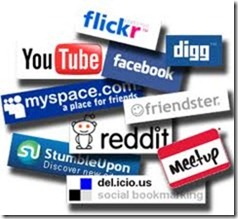 Marketing efforts spreading beyond Facebook, Twitter and LinkedIn
Marketing efforts spreading beyond Facebook, Twitter and LinkedInSocial media sites beyond Facebook, Twitter and LinkedIn are seeing significant boosts in usage, both in the US and elsewhere in the world. And where users go, marketers will follow.
Research from social marketing software firm Awareness Inc. indicates US marketers plan to do just that this year. The December 2011 survey found that the leading area for new social media marketing investments in 2012 would be increasing marketer presence across platforms, cited by 70% of respondents.

For some marketers, that will mean a new presence on Facebook, Twitter or LinkedIn. While the vast majority of US marketers already use these sites for marketing, some laggards plan to join them there this year.
But smaller social sites with less current marketer usage will benefit even more. Nearly one in five respondents said they would begin marketing on YouTube in 2012. And though just 10% of marketers said they would have a new presence on Tumblr, that is on top of only 15% already using it, for an increase of more than 66%. Proportionally, usage of SlideShare and online forums would increase even more than that.

By number of marketers, blogs will be the greatest beneficiary of new efforts, with 28% of respondents saying they were not currently using them but would this year. Among the most experienced social media marketers surveyed, 91% said they planned to increase their use of blogs.
-
US lawmakers abandoning online piracy bill
 Five days before a critical vote, US senators are abandoning an anti-piracy bill after an outpouring of online opposition to tinkering with internet freedoms.
Five days before a critical vote, US senators are abandoning an anti-piracy bill after an outpouring of online opposition to tinkering with internet freedoms.Senate Democratic leaders still plan to vote on Tuesday on taking up the Protect International Property Act and supporters are scrambling to make changes before then to answer some of the critics, but it is questionable whether they have the 60 votes needed.
Half-a-dozen of the 40 original co-sponsors of what is known as the PIPA bill withdrew their support on Wednesday amid a one-day protest blackout by Wikipedia and other web giants and a flood of emails to Capitol Hill offices that at times doubled normal volumes.
More than 7 million signed a petition on Google saying the Senate bill and its counterpart in the House would censor the web and impose burdensome regulations on US businesses.
"The overwhelming input I’ve received from New Hampshire citizens makes it clear there are many legitimate concerns that deserve further consideration before Congress moves forward with this legislation," said Republican Senator Kelly Ayotte, one of the politicians who pulled back her support of the bill.
Others included Republicans Orrin Hatch of Utah, Marco Rubio of Florida, Chuck Grassley of Iowa, Roy Blunt of Missouri and John Boozman of Arkansas.
Nearly all cited the earful they were getting from constituents.
"I can say, with all honesty, that the feedback I received from Arkansans has been overwhelmingly in opposition to the Senate bill in its current form," Boozman said.
Several Democratic co-sponsors also now say they oppose the bill as it is written.
Democrat Senate Majority Leader Harry Reid has resisted suggestions he put off the Tuesday vote.
Reid and the bill’s main sponsor, Senate Judiciary Committee Chairman Patrick Leahy said it was too important to delay action on legislation aimed at combating the billions of dollars US content creators and companies lose to foreign copyright violators and counterfeiters every year.
Senate Republican leader Mitch McConnell of Kentucky on Thursday urged Democrats to shelve the bill for now, saying serious issues with the measure should be resolved before "prematurely" bringing it to the floor.
The Senate bill, and the parallel Stop Online Piracy Act (SOPA) in the House, would allow the Justice Department and copyright holders to seek court orders against foreign websites that steal from American content creators.
It would bar advertising networks and payment facilitators such as credit card companies from doing business with the offending websites.
The bills have the strong support of the entertainment industry which loses billions every year to foreign copyright violators and from industries such as pharmaceuticals battling fake and sometimes harmful alternatives sold on the internet.
The opposition, as demonstrated by Wednesday’s protest, is led by internet-related industries that say the bills will lead to censorship of the internet and a surge in lawsuits that will discourage budding internet entrepreneurs.
Story source: www.ninemsn.com.au
-
SOPA blackout: Bills lose three co-sponsors amid protests
In case you missed all the news on the proposed bill to Stop On Line Piracy, or SOPA as it has become known, is a bill that was introduced into the US house of representatives in October last year.
The bill, if made law, would expand the ability of U.S. law enforcement and copyright holders to fight online trafficking in copyrighted intellectual property and counterfeit goods.[2] Presented to the House Judiciary Committee, it builds on the similar PRO-IP Act of 2008 and the corresponding Senate bill, the PROTECT IP Act.
The originally proposed bill would allow the U.S. Department of Justice, as well as copyright holders, to seek court orders against websites accused of enabling or facilitating copyright infringement. Depending on who makes the request, the court order could include barring online advertising networks and payment facilitators from doing business with the allegedly infringing website, barring search engines from linking to such sites, and requiring Internet service providers to block access to such sites. The bill would make unauthorized streaming of copyrighted content a crime, with a maximum penalty of five years in prison for ten such infringements within six months. The bill also gives immunity to Internet services that voluntarily take action against websites dedicated to infringement, while making liable for damages any copyright holder who knowingly misrepresents that a website is dedicated to infringement.
In an update of this story, below is a article from the Los Angeles Times:
“Three co-sponsors of the SOPA and PIPA antipiracy bills have publicly withdrawn their support as Wikipedia and thousands of other websites blacked out their pages Wednesday to protest the legislation.
Sen. Marco Rubio (R-Fla.) withdrew as a co-sponsor of the Protect IP Act in the Senate, while Reps. Lee Terry (R-Neb.) and Ben Quayle (R-Ariz.) said they were pulling their names from the companion House bill, the Stop Online Piracy Act. Opponents of the legislation, led by large Internet companies, say its broad definitions could lead to censorship of online content and force some websites to shut down.
In a posting on his Facebook page, Rubio noted that after the Senate Judiciary Committee unanimously passed its bill last year, he has "heard legitimate concerns about the impact the bill could have on access to the Internet and about a potentially unreasonable expansion of the federal government’s power to impact the Internet."
"Congress should listen and avoid rushing through a bill that could have many unintended consequences," Rubio said in announcing he was withdrawing his support. While he’s committed to stopping online piracy, Rubio called for Senate Majority Leader Harry Reid (D-Nev.) to back off plans to hold a key procedural vote on the bill on Tuesday.
Rubio’s withdrawal will reduce the number of co-sponsors to 39. Last week, two other co-sponsors, Charles Grassley (R-Iowa) and Orrin Hatch (R-Utah), joined four other Senate Republicans in a letter to Reid also urging him delay the vote. But Grassley and Hatch have not withdrawn their support.
Terry and Quayle were among the 31 sponsors of the House legislation before they withdrew their support Tuesday.
Quayle still strongly supports the goal of the House bill to crack down on foreign websites that traffic in pirated movies, music, medicine and other goods.
"The bill could have some unintended consequences that need to be addressed," said Quayle spokesman Zach Howell. "Basically it needs more work before he can support it."
Terry said that he also had problems with the House bill in its current form and would no longer support it.
Wikipedia, Reddit and about 10,000 other websites blacked out their pages Wednesday with messages warning of the dangers of the legislation and urging people to contact their congressional representatives. Howell said Quayle’s office had not seen a major increase in calls or emails Wednesday, but that the piracy bills have been the main issue in recent weeks for people contacting the office.
There has been a "manageable increase" in visits to House member websites Wednesday, said Dan Weiser, a spokesman for the House office of the chief administrative officer.
"It’s possible some users will see a short delay or slow loading of a member’s web page," he said.”
Original story from The Los Angeles Times, http://www.latimes.com/
If you would like to read more on how this bill, if passed, would affect how you use and research on the Internet, please read this link to Wikipedia, http://en.wikipedia.org/wiki/Stop_Online_Piracy_Act.
Anything we can do to stop this bill becoming law, lets do it now, and protest what is essentially an act of total censorship.
-
China web users hits 513 million
 The number of internet users in China has surged past 500 million as millions of new web surfers go online using mobile phones and tablet computers, an industry group reports.
The number of internet users in China has surged past 500 million as millions of new web surfers go online using mobile phones and tablet computers, an industry group reports.The popularity of the internet in China has driven the explosive growth of profitable web companies and made fortunes for some Chinese entrepreneurs despite government controls on what the public can see online.
The number of mainland internet users rose to 513 million in December, up 12 per cent from a year earlier, the government-sanctioned China internet Network Information Centre said on Monday.
Among them, the number who go online using handheld devices rose 17.5 per cent over a year earlier to 356 million.
The popularity of wireless internet was reflected on Friday in a scramble by Chinese gadget fans and scalpers to buy Apple Inc’s latest iPhone 4S, which sold out within hours of its China launch.
Angry customers shouted and threw eggs at Apple’s flagship Beijing outlet after the company failed to open the store, citing the size of the crowd. Apple postponed further iPhone 4S sales at its mainland stores for safety reasons, but said they will be sold online and through its local carrier, China Unicom Ltd.
The communist government encourages internet use for business and education, but tries to block access to material it deems pornographic or subversive.
The government is strengthening its control over popular microblogs after a bullet train crash last July that killed 40 people prompted an online outpouring of criticism of the official response.
Microblog services have been ordered to monitor postings content more closely and remove objectionable material, while news media were barred from reporting online material without firsthand verification.
Despite such controls, popular online services such as portals Sina.com and Sohu.com, video websites Youku.com and Tudou.com and search engine Baidu report growing traffic and revenues.
Outlets owned by the ruling Communist Party or by the government also have jumped into the market, launching their own search engines and other services.
On Friday, regulators approved an initial public stock offering by the online arm of the ruling party newspaper People’s Daily, people.com, on the Shanghai Stock Exchange to raise 527 million yuan ($A82.84 million).
Story source: www.bigpond.com
-
Most Consumers Still Don’t Talk About Brands on Social Sites
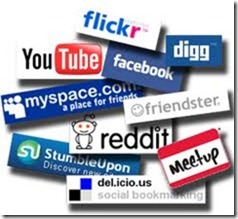 Consumers occasionally post about brands on Facebook and Twitter, but offline and non-social online methods keep them informed
Consumers occasionally post about brands on Facebook and Twitter, but offline and non-social online methods keep them informedWhile most marketers leverage Facebook and Twitter to communicate with customers, not nearly as many consumers comment about these companies and brands on the social sites.
AYTM Market Research found that 57.8% of US Facebook users had not mentioned a brand in their status updates as of October 2011. More heartening for marketers is that just 0.5% of Facebook users posted only negative mentions about brands on Facebook. More often, they reported commenting on brands in a positive way (25.3%) or with a mix of both positive and negative mentions (16.4%).

US Twitter users nearly mirrored these results, with 61.3% of Twitter users saying they have not tweeted about a brand. Meanwhile, 25.4% of Twitter users said they only mentioned brands in positive tweets, 0.4% said they only mentioned them in negative tweets and 12.9% said in both positive and negative tweets.
Meanwhile, consumers are typically not learning about new brands, products and services from social media. Only 6.5% of US internet users said they most frequently hear about new brands, products and services from social media, while 17.6% said they often do and 26.5% said they sometimes do. A quarter of respondents (26%) said they never hear about these new offerings via social media.
Offline channels, such as TV, radio and print media were the ways consumers most frequently discovered new brands, products and services, while word-of-mouth and physical stores also played a role. US internet users also learned about new offerings more often from online elements that are not social media, such as online advertising or online shopping sites, than they do on social media.

Consumers are using social media more and more, and brands are on these social networks and willing to interact there.
Getting consumers to discuss brands and products in their status updates and tweets is a challenge, but if they start to do so, it could continue to increase the influence that social media has in learning about new products and services.
-
B2B Marketers Struggle With Compelling Content
B2B Marketers Struggle With Compelling Content
41% of B2B marketers say that producing the kind of content that engages prospects and customers is their biggest content marketing challenge, representing a 14% increase from 36% of respondents in 2010, according to [download page] a December 2011 study by MarketingProfs and the Content Marketing Institute. Data from “B2B Content Marketing: 2012 Benchmarks, Budgets & Trends” indicates that respondents are also grappling with two challenges that go hand in hand: producing enough content (20%), and having the budget to produce enough content (18%). A lack of buy-in from higher-ups in the company (12%), producing a variety of content (7%), and having the budget to license content (1%) are primary challenges to relatively fewer B2B marketers.
Budgets Are a Challenge, But Spending to Increase
Although 1 in 5 B2B marketers cite having sufficient content marketing budgets as their primary challenge, data from the study indicates that content marketing spending is on the rise. Although roughly 26% of marketers’ total budgets are allocated to content marketing efforts this year, the same as in 2010, this year 60% of respondents indicate they will increase spending on content marketing in 2012, compared to just 3% that say they will decrease their spending levels.
The average amount of budget spent on content marketing appears to vary significantly by company size, with a negative correlation between size and budget share. For example, companies with fewer than 10 employees spend 34% of their budgets on content marketing, whereas companies with more than 1000 employees allocate 20% of their budgets.
Meanwhile, outsourcing also appears to be on the rise: whereas in 2010 only 55% of marketers used outsourcing in some capacity, this year that proportion has risen to 62%. When seeking out the right vendors to support content marketing, marketers use a variety of resources, with the biggest increase from last year seen in the use of consultants (32% vs. 27%) and the biggest decrease found in the use of trade shows as a venue to find support (20% vs. 26%).
Brand Awareness, Customer Acquisition Lead All Goals
Brand awareness and customer acquisition are content marketers’ top goals, cited by 68% of survey respondents. Lead generation (66%) and customer retention/loyalty (61%) follow closely, with website traffic (56%), engagement (55%), and thought leadership (55%) also goals for a majority of marketers. Almost half cite sales as a goal, while just 39% report using content marketing for lead management/nurturing.
Content marketing goals appear to be fairly unrelated to overall digital marketing goals: according to a November report from Webmarketing 123, lead generation (46.4%) is by far the most important objective of digital programs for B2B marketers, outstripping sales generation (22.2%), brand awareness development (15.3%), and site traffic generation (11.1%).
Web Traffic Top Success Indicator
Although web traffic is not a top goal among content marketers, it is the leading indicator of success, cited by 58% of respondents. Sales lead quality (49%) follows, while direct sales, sales lead quantity, qualitative feedback from customers, and SEO ranking are measurement criteria to roughly 4 in 10. The least popular indicator of success is inbound links, cited by 30% of marketers.
According to the November Webmarketing123 study, the vast majority (73.9%) of B2B digital marketers use web traffic as a measurement of campaign success, ahead of lead generation (69.2%) website click-through rate (64.7%), and sales (62.5%).
-
Mobile Marketers Most Interested in Apps, Barcodes
Mobile Marketers Most Interested in Apps, Barcodes
 Mobile apps (43%) and mobile barcodes (41%) rank highest as mobile marketing strategies companies would be interested in deploying in the next 12 months, according to [pdf] a December 2011 survey from AT&T. Data from the survey indicates that banner ads (40%) follow closely as a potential strategy, with mobile web (35%) and SMS messages (34%) not far behind and digital signage (17%) appearing the least desired.
Mobile apps (43%) and mobile barcodes (41%) rank highest as mobile marketing strategies companies would be interested in deploying in the next 12 months, according to [pdf] a December 2011 survey from AT&T. Data from the survey indicates that banner ads (40%) follow closely as a potential strategy, with mobile web (35%) and SMS messages (34%) not far behind and digital signage (17%) appearing the least desired.According to a November 2011 study from the e-tailing group, sponsored by Bronto, SMS marketing tactics are far less likely to be used by marketers than other mobile capabilities such as mobile commerce sites and mobile applications. Just 14% of marketers currently collect SMS opt-in from customers in all channels, while only 7% text to send out marketing messages, and 6% text to send out transactional support messages such as confirmations and order status. Between one-quarter and one-third of respondents plan to employ these capabilities in the next 12 months.
By contrast, 29% of respondents said they currently use a mobile commerce site, with a further 42% planning to employ one in the next year. 19% reported currently employing a mobile application, with 27% more planning use in the next year.
Mobile Programs To Increase
88% of respondents to the AT&T survey expect their mobile marketing program to increase in the next 12 months, while 52% reporting use of mobile marketing as part of their overall marketing strategy. Of those who do not currently have a mobile marketing strategy, more than half plan to implement one in 2012. Meanwhile, of those who do use a strategy, 51% say they are still trialing mobile marketing, while 46% say it is an integral aspect of select marketing initiatives.
Consumer Demand Will Determine Barcode Adoption
87% of marketers say that consumer demand is an important or very important criterion for them to increase their use of mobile barcodes, followed closely by the proportion who cite cost structure (84%) and security (83%). Perhaps marketers should look to mothers first for demand: according to a November 2011 joint study between BabyCenter and comScore, just 4% of mothers say they would not use a QR code, compared to 19% of the general population.
Overall, two-thirds of marketers responding to the AT&T survey agree that mobile barcodes will drive innovation in mobile marketing in the next year. 44% of respondents believe barcodes can help brands engage with customers, while one-third believe they can increase awareness of products and services.
-
Facebook rolls out Timeline feature
 Facebook has officially started rolling out its new Timeline feature that will enable users to show off the most important moments of their lives on their profile page.
Facebook has officially started rolling out its new Timeline feature that will enable users to show off the most important moments of their lives on their profile page. The new feature, which was unveiled in early September, will first be introduced in New Zealand before it is rolled out to other countries, the company revealed on its Facebook blog today.
Facebook said Timeline would keep important life events on profile pages while less-important posts would drop off .
"Now you can share photos of what you did last weekend, and updates about how you feel today," the company said in a previous blog post.
"But since the focus is on the most recent things you posted, more important stuff slips off the page. The photos of your graduation get replaced by updates about what you had for breakfast."
The new feature will allow users to choose which life events, such as birthdays or weddings, are permanently illustrated on their profile.
Timeline raised privacy concerns in its development stage, after it was revealed it would be visible on the Timeline when you "unfriended" certain people, social media website Mashable reports.
Facebook said this was a glitch that had since been corrected.
Story: www.ninemsn.com.au
-
RBA Cuts Interest Rates by .25%
 The Reserve Bank of Australia board has cut the official interest rate by 25 basis points to 4.25 per cent, giving mortgage holders and borrowers a pre-Christmas reprieve.
The Reserve Bank of Australia board has cut the official interest rate by 25 basis points to 4.25 per cent, giving mortgage holders and borrowers a pre-Christmas reprieve. The RBA announced the rate cut at 2.30pm AEDT today following the board’s final meeting for the year.
It’s the second interest rate cut in as many months after the RBA lowered the cash rate on Melbourne Cup day in November.
In a statement issued with the announcement, RBA Governor Glenn Stevens said there had been "considerable turbulence" in financial markets and said financing conditions had become more difficult.
"This, together with precautionary behaviour by firms and households, means that the likelihood of a further material slowing in global growth has increased," Mr Stevens said in a statement accompanying the decision on Tuesday.
Economics analyst Ross Greenwood said Europe’s debt crisis would have been a significant factor in the RBA’s decision.
"The Reserve Bank indicated that it is still concerned about the European economic situation and the prospects of a global slowdown hurting Australia and its export markets," Greenwood told ninemsn.
While it’s good news for mortgage holders and borrowers, Greenwood cautioned consumers not to expect the banks to pass on the full interest rate.
Analysts were divided about whether the RBA would cut the rate today, with a survey of 14 economists conducted by AAP revealing seven tipping a cut, and seven predicting rates would stay on hold for another month.
Story source: www.ninemsn.com.au
-
December Rate Cut 50/50 Probability
 Economists are divided on whether borrowers will get a second interest rate cut in as many months on Tuesday.
Economists are divided on whether borrowers will get a second interest rate cut in as many months on Tuesday.Seven of the 14 economists surveyed by AAP say the RBA will cut the cash rate to 4.25 per cent from 4.5 per cent on December 6.
On Melbourne Cup day, the Reserve Bank of Australia (RBA) cut the cash rate from 4.75 per cent, saying that recent information suggested inflation had been contained.
With inflation no longer a problem, the bias for the RBA is now firmly leaning towards rate cuts, with 10 of the 14 economists forecasting rate cuts by the middle of 2012.
Citigroup head of economics Paul Brennan is expecting the RBA to cut rates on Tuesday, despite expectations of strong economic growth in the September quarter.
"We see this as a policy of least regret given that the outlook for global growth has continued to weaken in the past month to well below trend," Mr Brennan said.
"We see scope to lower the cash rate to the bottom of the neutral range over the next few months, which would imply a cash rate of four per cent over the next three months."
The biggest risk to economic growth comes from Europe, which may well go into recession, or start another financial crisis, as several members of the euro struggle to meet debt repayments.
There are also local risks to economic growth.
In the past month the RBA, Treasury and the Organisation for Economic Co-operation and Development (OECD) have cut economic growth forecasts for 2012.
In addition to that, official figures for October showed a 10.7 per cent fall in building approvals and retail spending only rising 0.2 per cent.
On the other hand Australia’s mining boom is still going strong, with the sector making its biggest ever contribution to economic growth.
Nomura Australia chief economist Stephen Roberts said he doesn’t expect the cash rate to move for the foreseeable future unless something bad happens overseas.
"My forecast is that they are going to leave it at 4.5 per cent," he said.
"I’m assuming they will hold it neutral all the way through to the end of 2012 but my proviso is if Europe generally does go to hell in a handbasket, then they can drop interest rates a long way."
NAB senior economist Spiros Papadopoulos said the RBA won’t cut on Tuesday but by early next year the pressure will build for another rate cut.
"Obviously there’s a risk that they might cut interest rates next week, given everything that’s been happening offshore in the last couple of weeks," he said.
"On balance, given the fact that the domestic economy has been holding up okay we don’t think they need to rush in to cutting rates."
Story source: www.ninemsn.com.au
-
Bosses stalk Facebook before hiring
 More than a quarter of Australian employers use social networking sites such as Twitter and Facebook before hiring staff, according to new research.
More than a quarter of Australian employers use social networking sites such as Twitter and Facebook before hiring staff, according to new research.Telstra’s Cyber-Safety survey found that almost half of those employers who admit to checking candidates’ social profiles have turned down applicants based on something unfavourable they’ve seen online.
The research also revealed over a third have hired staff based on a positive experience stalking someone online.
The findings serve as a reminder to Australians to consider their ‘Cyber CV’, said Telstra’s Officer of Internet Trust Safety Darren Kane.
‘According to the findings some of the biggest Cyber CV faux pas candidates make include posting inappropriate pictures (with 31 per cent of employers saying this counts against applicants) and posting discriminatory comments (37 per cent),’ Mr Kane said.
‘Given the impressions comments and images can create, Telstra recommends job seekers think twice before posting, tagging and uploading pictures and status updates this Christmas.’
He has advised job applicants to ensure any content on Facebook or Twitter that is able to be publically viewed is ‘positive and professional’.
-
Internet a ‘surveillance machine’
 WikiLeaks founder Julian Assange has blasted the mainstream media, Washington, banks and the internet itself as he addressed journalists in Hong Kong via videolink from house arrest in England.
WikiLeaks founder Julian Assange has blasted the mainstream media, Washington, banks and the internet itself as he addressed journalists in Hong Kong via videolink from house arrest in England.Fresh from accepting a Walkley award for journalism on Sunday, Assange spoke to the News World Summit in Hong Kong on Monday before keeping a regular appointment with the police.
He defended his right to call himself a journalist and said WikiLeaks’ next ‘battle’ would be to ensure that the internet does not turn into a vast surveillance tool for governments and corporations.
‘Of course I’m a goddamn journalist,’ he responded with affected frustration when a moderator of the conference asked if he was a member of the profession.
He said his written record spoke for itself and argued that the only reason people kept asking him if he was a journalist was because the United States government wanted to silence him.
‘The United States government does not want legal protection for us,’ he said, referring to a US Justice Department investigation into his whistleblower website for releasing secret diplomatic and military documents.
The former hacker criticised journalists and the mainstream media for becoming too cosy with the powerful and secretive organisations they were supposed to be holding to account.
In a 40-minute address, he also accused credit card companies such as Visa and MasterCard of illegally cutting WikiLeaks off from funding under a secret deal with the White House.
‘Issues that should be decided in open court are being decided in back rooms in Washington,’ he said.
The internet itself had become ‘the most significant surveillance machine that we have ever seen’, Assange said in reference to the amount of information people give about themselves online.
‘It’s not an age of transparency at all … the amount of secret information is more than ever before,’ he said, adding that information flows in but is not flowing out of governments and other powerful organisations.
‘I see that really is our big battle. The technology gives and the technology takes away,’ he added.
The anti-secrecy activist then held up a handwritten sign from an aide telling him to ‘stop’ talking or he would be late for a mandatory appointment with police.
Assange, 40, is under house arrest in England pending the outcome of a Swedish extradition request over claims of rape and sexual assault made by two women. He says he is the victim of a smear campaign.
-
How Blogs Influence Purchases and Recommendations
 Bloggers comment on brands and post to social media, expanding reach
Bloggers comment on brands and post to social media, expanding reachBloggers, from hobbyists to professionals, often write about brands, and their growing influence should make brand representatives continually evaluate the relationships they have with these bloggers.
Most bloggers write about brands in some way or another. According to the “State of the Blogosphere 2011” report from blog directory website Technorati, 38% of all bloggers post about brands that they love or hate and 34% write product or service reviews. Professional full-time bloggers or part-time professional bloggers who write as a way to supplement their income are more likely to blog about brands than their hobbyist, corporate or entrepreneur counterparts.

Bloggers are increasing in their influence over readers and other bloggers. Last year’s Technorati “State of the Blogosphere” reported that 29% of bloggers are influenced by other blogs they read. This year, that number jumped to 68%.
As bloggers gain influence and write about brands, the relationships between blog writers and brand representatives are important for companies to focus on. Most bloggers have a good relationship with brand representatives. Nearly half of all bloggers (49%) characterized their interactions with such representatives as somewhat or very favorable. Only 3% said their interactions were not at all favorable. However, 40% of all bloggers said they didn’t know how to characterize their interactions with brand representatives.

This large group of unsure respondents could have mixed feelings about the communications they receive from these brand representatives, affecting their relationships with the reps and their brands. Of all bloggers, 17% said brand representatives had asked for things that would compromise the credibility or content standards of the blog. This is roughly the same percentage of those that said the representatives were knowledgeable about their blogs and content (14%), are genuinely interested in building a relationship (16%) and provide information that has value for readers (23%).
As bloggers continue to grow in influence, their coverage of brands and their interactions with brands’ products, services and employees will be of greater interest to companies. Brand representatives who connect with bloggers must be sure to work with these writers to keep the relationships thriving.
-
China beats US as top smartphone market
 China has overtaken the United States to become the world’s largest smartphone market by volume although the US still leads in terms of revenue, a market research firm says.
China has overtaken the United States to become the world’s largest smartphone market by volume although the US still leads in terms of revenue, a market research firm says.Strategy Analytics said that smartphone shipments hit 24 million units in China during the third quarter of the year compared to 23 million units in the United States.
‘The United States remains the world’s largest smartphone market by revenue, but China has overtaken the United States in terms of volume,’ said Strategy Analytics executive director Neil Mawston.
‘China is now at the forefront of the worldwide mobile computing boom,’ Mawston said. ‘China has become a large and growing smartphone market that no hardware vendor, component maker or content developer can afford to ignore.’
Strategy Analytics said smartphone shipments in China grew 58 per cent in the third quarter over the previous quarter to 23.9 million units and fell seven per cent to 23.3 million units in the United States in the same period.
‘China’s rapid growth has been driven by an increasing availability of smartphones in retail channels, aggressive subsidising by operators of high-end models like the Apple iPhone, and an emerging wave of low-cost Android models from local Chinese brands,’ Strategy Analytics director Tom Kang said.
Finland’s Nokia leads China’s smartphone market with 28 per cent share, while Taiwan’s HTC heads the US smartphone market with 24 per cent share, according to Strategy Analytics.
-
Laptops, phones intrude on home time
 Australians work some of the longest hours in the developed world, with many feeling obliged to do extra work because their employer has supplied them with mobile phones and laptops, new research says.
Australians work some of the longest hours in the developed world, with many feeling obliged to do extra work because their employer has supplied them with mobile phones and laptops, new research says.The study by the left-leaning Australia Institute terms this extra work ‘polluted time’, as work increasingly intrudes on leisure.
Institute deputy director Josh Fear said seven out of eight survey respondents with a work device provided by their employer said they had worked outside of normal hours in the past week, compared to around half of those without a device.
‘Many workers consider their laptops and smartphones as a perk of their job, but those same devices can also invade free time,’ he said in a statement.
‘Australians already work some of the longest hours in the developed world and technology often exacerbates the problem rather than relieving it by making people perpetually on-call.’
The Australia Institute conducted this research for its third Go Home On Time Day, to be held on Wednesday November 30.
The day aims to raise awareness of the extent of overwork in Australia and the important workplace, health and social consequences.
The survey, conducted in July, asked 1384 Australians (845 of whom were in paid work) about their work practices.
Twenty-three per cent said working at home outside normal hours was expected, while 15 per cent said they often needed to. The higher the pay, the more likely work would intrude on home time.
Only eight per cent said working outside normal hours was discouraged.
More than half of those surveyed said they weren’t paid extra for this additional work.
Twenty-four per cent said their employer had provided some form of technology, such as a phone or laptop, allowing them to work outside the workplace.
The survey said these people were twice as likely to say they often needed to work outside normal hours, with email the most common intrusion – more than phone calls, meetings or travel.
Most workers aren’t happy about this, with 64 per cent reporting it made it more difficult to enjoy free time. Just 10 per cent said it was never a problem.
The Australia Institute said the findings suggested that some 6.8 million out of a total workforce of 11.4 million experienced some degree of time pollution in any given week.
‘What is certain is that some workers who were happy with their work/life balance a decade ago are now less satisfied with the expectations of their job because certain technologies that contribute to polluted time simply did not exist until relatively recently.’
New research says mobile phones and laptops have ‘polluted time’, as work increasingly intrudes on leisure.
Story source: www.bigpond.com
-
Study: Half of all social media campaigns fall flat
 Before you launch your next big social media campaign, you may want to ask: Is anybody really listening?
Before you launch your next big social media campaign, you may want to ask: Is anybody really listening?A new TNS report reveals that as many as half of all social media marketing campaigns are going unnoticed.
Matthew Froggatt, the company’s chief development officer, says in a press release that 57 percent of consumers in developed markets do not want to engage with brands in the social sphere. The number is as high as 60 percent in the U.S., while 61 percent in the U.K.
TNS’s Digital Life study drew on findings from 72,000 consumers in 60 countries. It also revealed that 54 percent of people admit that social networks are a good place to learn about products.
Fear not—there’s hope for us yet.
Froggatt has advice for social media marketers:
“The key is to understand your target audience and what they want from your brand — social networks aren’t always the right approach. If consumers in one market don’t want to be talked to, can you use an alternative online method — creating owned digital media platforms, targeted sponsorship or search campaigns — to engage in an appropriate way that will achieve business results without adding to the digital waste pile?”
Story source: www.prdaily.com
-
How Well Do Companies Respond to Customer Complaints?
 Many marketers still ignoring dissatisfied customers on social media
Many marketers still ignoring dissatisfied customers on social mediaMarketers are well aware that social media is a double-edged sword when it comes to word-of-mouth. Not only does it give rave reviews and glowing recommendations a chance to be seen by millions, but it also does the same for negative feedback. How to best deal with negative buzz online is a perennial question.
Some companies are confident that their customers use sites like Facebook and Twitter to complain about them, according to a September 2011 survey by feedback management software provider MarketTools. But nearly half of companies surveyed think their customers don’t comment or complain about their products and services online, and almost a quarter did not know whether their customers did so or not.

While it’s possible that some business-to-business companies really don’t have to worry much about customers turning to Twitter to vent their frustration, for consumer-facing firms, the probability seems high, raising the question as to whether executives are aware enough of online complaints.
MarketTools also found that while a sizeable number of marketers respond to customer complaints on Facebook or Twitter at least some of the time, many leave questions and negative feedback completely unanswered. On Twitter, 29% said they responded to such feedback seldom or never, while 17% said the same of Facebook.

Consumers may not be happy with this frequency of response. Research tends to show that social media users want businesses to answer them, and that an interaction with a company representative online can defuse negative feedback sometimes simply by offering attention.
-
Top 5 Social Media Scams
 We’re wired to be social creatures, and sites like Twitter and Facebook have capitalized on this to great success. According to its COO Sheryl Sandberg, Facebook draws 175 million logins every day.
We’re wired to be social creatures, and sites like Twitter and Facebook have capitalized on this to great success. According to its COO Sheryl Sandberg, Facebook draws 175 million logins every day.But with this tremendous popularity comes a dark side as well. Virus writers and other cybercriminals go where the numbers are — and that includes popular social media sites. To help you avoid a con or viral infection, we’ve put together this list of the top five social media scams.
5. Chain Letters
You’ve likely seen this one before — the dreaded chain letter has returned. It may appear in the form of, "Retweet this and Bill Gates will donate $5 million to charity!" But hold on, let’s think about this. Bill Gates already does a lot for charity. Why would he wait for something like this to take action? Answer: He wouldn’t. Both the cause and claim are fake.So why would someone post this? Good question. It could be some prankster looking for a laugh, or a spammer needing "friends" to hit up later. Many well-meaning people pass these fake claims onto others. Break the chain and inform them of the likely ruse.
4. Cash Grabs
By their very nature, social media sites make it easy for us to stay in touch with friends, while reaching out to meet new ones. But how well do you really know these new acquaintances? That person with the attractive profile picture who just friended you — and suddenly needs money — is probably some cybercriminal looking for easy cash. Think twice before acting. In fact, the same advice applies even if you know the person.Picture this: You just received an urgent request from one of your real friends who "lost his wallet on vacation and needs some cash to get home." So, being the helpful person you are, you send some money right away, per his instructions. But there’s a problem: Your friend never sent this request. In fact, he isn’t even aware of it. His malware-infected computer grabbed all of his contacts and forwarded the bogus email to everyone, waiting to see who would bite.
Again, think before acting. Call your friend. Inform him of the request and see if it’s true. Next, make sure your computer isn’t infected as well.
3. Hidden Charges
"What type of STAR WARS character are you? Find out with our quiz! All of your friends have taken it!" Hmm, this sounds interesting, so you enter your info and cell number, as instructed. After a few minutes, a text turns up. It turns out you’re more Yoda than Darth Vader. Well, that’s interesting … but not as much as your next month’s cell bill will be. You’ve also just unwittingly subscribed to some dubious service that charges $9.95 every month.As it turns out, that "free, fun service" is neither. Be wary of these bait-and-switch games. They tend to thrive on social sites.
2. Phishing Requests
"Somebody just put up these pictures of you drunk at this wild party! Check ’em out here!" Huh? Let me see that! Immediately, you click on the enclosed link, which takes you to your Twitter or Facebook login page. There, you enter your account info — and a cybercriminal now has your password, along with total control of your account.How did this happen? Both the email and landing page were fake. That link you clicked took you to a page that only looked like your intended social site. It’s called phishing, and you’ve just been had. To prevent this, make sure your Internet security includes antiphishing defenses. Many freeware programs don’t include this essential protection.
1. Hidden URLs
Beware of blindly clicking on shortened URLs. You’ll see them everywhere on Twitter, but you never know where you’re going to go since the URL ("Uniform Resource Locator," the Web address) hides the full location. Clicking on such a link could direct you to your intended site, or one that installs all sorts of malware on your computer.URL shorteners can be quite useful. Just be aware of their potential pitfalls and make sure you have real-time protection against spyware and viruses.
Bottom line: Sites that attract a significant number of visitors are going to lure in a criminal element, too. If you take security precautions ahead of time, such as using antivirus and anti-spyware protection, you can defend yourself against these dangers and surf with confidence.
Copyright (c) 2010 Studio One Networks. All rights reserved.
Source: Norton Anti Virus
-
What Encourages Facebook Engagement?
 Brands that include photos and calls to action see higher engagement rates with those posts
Brands that include photos and calls to action see higher engagement rates with those postsCompanies on Facebook and other social sites are always trying to determine what to post to get fans engaged. While each brand is different, and its fans will respond to different things, there are some common threads that companies can keep in mind when planning social media posts and status updates.
Digital marketing agency Web Liquid analyzed 16 brands and more than 1,500 brand posts from March to May 2011 to see which Facebook posts saw the most engagement, such as comments and “likes.” Web Liquid found that Facebook posts with photos saw a 0.37% engagement rate, higher than posts with videos (0.31%), text only (0.27%) or links (0.15%).

Momentus Media, which provides marketing software for use within Facebook, came up with similar findings, even when analyzing the top 20,000 Facebook pages and between 10,000 and 250,000 posts overall. Facebook posts with photos saw a 0.21% engagement rate, while videos saw 0.11% engagement rate and links saw 0.07% engagement.
Within the text of a post, companies can encourage action by asking fans to “like” or comment on the post. Momentus Media found that Facebook status updates that contained the word “like” saw a 0.38% engagement rate and those that said “comment” saw a 0.14% engagement rate. Text updates without “like” or “comment” saw 0.11% engagement.

While these statistics are interesting, brands should determine which tactics work best for their Facebook page and their fans. Additionally, the upcoming changes to Facebook’s Timeline feature and brand pages will change the way consumers interact on the social network.
Facebook’s new Timeline relies heavily on photos, so it seems that posts with photos and videos will continue to perform well for brands. And as Facebook introduces more verbs beyond “like,” companies could develop interesting ways to increase engagement on their pages. By testing different types of posts and continuing to learn what spurs a reaction, marketers can keep up with what content fans prefer on their brand Facebook pages and keep engagement up.
-
Blogger told to take Speedos off porn site
 There is a lesson to be learned for all companies in the following story, as Internet marketing consultants, we are constantly advising our clients to ensure they have secured all variations of their domain names, and given the very cheap cost of these valuable pieces of on line real estate, you would think it would be one of the first marketing tools they would secure.
There is a lesson to be learned for all companies in the following story, as Internet marketing consultants, we are constantly advising our clients to ensure they have secured all variations of their domain names, and given the very cheap cost of these valuable pieces of on line real estate, you would think it would be one of the first marketing tools they would secure. However a lot of companies do not understand the value of a domain name and do not secure them.
They only have themselves to blame for this, so now you have been told, get online and make sure you own every variation of your trademark or domain name, it’s a very small price to pay to ensure that this type of problem does not impact your company or brand.
You can check wether your domain names have been secured by checking our Really Cheap Domains registration web site!
“A NSW man has been ordered to shut down several pornographic websites featuring Speedo swimwear and using the company’s trademark.
Speedo Holdings took Central Coast blogger Dave Evans to court claiming he had used the trademark under aliases and without the company’s consent.
The company claimed the websites and the use of the company’s trademark as part of his domain names could damage the "valuable reputation and goodwill associated with the name and trade mark Speedo".
In the Federal Court of Australia on Thursday, Justice Geoffrey Flick ordered Evans to stop operating and registering any domain name containing the name Speedo.
He was also restrained from operating websites featuring any sign of the Speedo trademark.
Evans, who didn’t appear in court, was ordered to transfer the domain names to Speedo within 21 days.
If Evans doesn’t comply, a registrar of the court will be appointed to transfer the domain names and Evans will liable for substantial damages to the company.
He was also ordered to pay the swimwear company’s legal costs.”
Story source: www.ninemsn.com.au
-
Most Social Shoppers Trust SocNet Reviews

 A majority of social shoppers trust user reviews and recommendations on social network sites more than other sites, according to a study released in October 2011 by Performics and conducted by ROI Research. Data from the “2011 Social Shopping Study” indicates that among participants who use social networks at least occasionally during the shopping process, 58% trust the recommendations they find on social networks more than other sites. Shopping sites (57%) and deal sites (53%) follow closely as trusted sources of product recommendations. According to the study, about one in 2 social shoppers are positively influenced by favorable reviews and recommendations. This compares to roughly 45% of social shoppers adversely influenced by negative reviews.
A majority of social shoppers trust user reviews and recommendations on social network sites more than other sites, according to a study released in October 2011 by Performics and conducted by ROI Research. Data from the “2011 Social Shopping Study” indicates that among participants who use social networks at least occasionally during the shopping process, 58% trust the recommendations they find on social networks more than other sites. Shopping sites (57%) and deal sites (53%) follow closely as trusted sources of product recommendations. According to the study, about one in 2 social shoppers are positively influenced by favorable reviews and recommendations. This compares to roughly 45% of social shoppers adversely influenced by negative reviews.Shopping Sites Most Important During Process
Almost three in 4 (72%) social shoppers consider shopping sites to be an important part of the purchase process, about 25% more than those who report deal sites (58%) to be an important factor. Just four in 10 (41%) find social networks to be a significant part of the shopping process.
1 in 5 Use Sites Daily to Find Deals
 Among active social networkers, nearly one in 5 (19%) turn to deal sites to find specials, coupons, or deals on a daily basis. Social networks (18%) and shopping sites (17%) follow closely as deal sources. While 15% of social shoppers use social networks daily to learn about new products, only one in 10 use social shopping sites on a daily basis for other key stages of the shopping process, including to research product information, read product reviews, compare products, and find product availability.
Among active social networkers, nearly one in 5 (19%) turn to deal sites to find specials, coupons, or deals on a daily basis. Social networks (18%) and shopping sites (17%) follow closely as deal sources. While 15% of social shoppers use social networks daily to learn about new products, only one in 10 use social shopping sites on a daily basis for other key stages of the shopping process, including to research product information, read product reviews, compare products, and find product availability.Shopping Sites Most Popular Before Purchase
Although social networks are most frequently used to learn about new products, the vast majority of social shoppers (87%) turn to shopping sites while searching for a product, while 83% use these sites right before committing to a purchase. This compares to roughly two-thirds of social shoppers who frequently use social networks or deal sites prior to purchasing a product. After the purchase, however, the focus shifts to social networks: almost six in 10 (59%) frequently share their experiences on social networks after the purchase, compared to 57% for shopping sites and 51% for deal sites.
Other Findings
- Almost seven in 10 (69%) social shoppers visit Amazon at least once a month, making it the most popular shopping site, ahead of eBay (53%) and retailer websites (52%). Search sites fare less well: just 27% visit Google shopping on a monthly basis, followed by Yahoo shopping (23%) and Bing shopping (13%).
- Close to half of social shoppers (47%) have a Groupon account, far more than those with a Living Social (27%) or Eversave (15%) account.
Nielsen: SocNet Users Most Trust Info from Consumers
Social network users are most likely to trust product and service information provided by other consumers, according to data released in October 2011 by NMIncite and The Nielsen Company. Sixty-three percent say consumer ratings are a preferred source for product information, while 62% say consumer reviews are a preferred source. Company websites come in a distant third, preferred by 50% of social network users for product and service information. Call center (47%) and email (45%) closely follow. Interestingly, company Facebook page (15%) and company Twitter (7%) are among the least preferred product information sources.
About the Data: The Performics survey was conducted among 1000 participants who were required to have an active social network account and use social networks at least occasionally in the shopping process. The online survey was in field from 9/27/11 to 10/4/11.
-
‘We should never block social networks’
 Suppressing social networks or mobile phones at times of unrest is ‘unacceptable’, the UK Foreign Secretary has told a global summit on cyber-crime.
Suppressing social networks or mobile phones at times of unrest is ‘unacceptable’, the UK Foreign Secretary has told a global summit on cyber-crime.Human rights such as privacy and freedom of expression should apply as much online as they do offline, William Hague said.
His remarks appear to rule out any clampdown of Twitter or Facebook during riots, an idea briefly considered following the disorder in English cities earlier this year.
They are in stark contrast to Prime Minister David Cameron’s comments to Parliament in August, when he said: ‘When people are using social media for violence we need to stop them.
‘So we are working with the police, the intelligence services and industry to look at whether it would be right to stop people communicating via these websites and services when we know they are plotting violence, disorder and criminality.’
But Mr Hague told delegates: ‘Human rights are universal. Cultural differences are not an excuse to water down human rights, nor can the exploitation of digital networks by a minority of criminals or terrorists be a justification for states to censor their citizens.
‘We reject the view that government suppression of the internet, phone networks and social media at times of unrest is acceptable.
‘In fact we would go further, and boil this concept down to a single proposition: that behaviour that is unacceptable offline is also unacceptable online, whether it is carried out by individuals or by governments.’
The Foreign Secretary also warned countries who fail to understand the risks of web-based attacks could be exploited by other states.
‘It is increasingly clear that countries with weak cyber-defences and capabilities will find themselves exposed over the long term; at a serious strategic disadvantage given the apparent rise in state-sponsored attacks,’ he said.
His speech follows a No 10 adviser’s admission that China and Russia – both countries with representatives attending the London conference – are suspected of carrying out attacks to steal secrets from other countries.
Baroness Neville-Jones, who is Mr Cameron’s special representative on cyber-security, said Beijing and Moscow were ‘interested in this kind of activity’.
The head of GCHQ, the Government’s ‘listening’ agency, Iain Lobban, said the Foreign and Commonwealth Office computer system was targeted in a ‘significant’ attempt to extract information earlier this year.
Representatives from 60 nations have gathered for the conference which will also hear from Wikipedia founder Jimmy Wales and Facebook’s policy director for the UK, Europe and Middle East, Richard Allan.
US Secretary of State Hillary Rodham Clinton has been forced to cancel her speech as her elderly mother is unwell.
Story source: www.bigpond.com
-
Twitter stalks the wrong Alan Joyce
 Qantas is the talk of the town on social networking sites after CEO Alan Joyce took the unprecedented step of grounding the airline’s domestic and international aircraft.
Qantas is the talk of the town on social networking sites after CEO Alan Joyce took the unprecedented step of grounding the airline’s domestic and international aircraft.Twitter account holders have been looking for the businessman’s personal account, taking the search for Alan Joyce to the fourth most popular trend topic in Australia on Sunday.
Unfortunately, many homed in on an Alan Joyce of Stanford, California.
The American Mr Joyce acquired more than 300 extra Twitter followers over the past 24 hours after tweeters confused him with the Qantas boss.
‘Oh dear,’ he tweeted around 11am AEDT on Sunday.
‘I think Australia is waking up again … time to prepare for another deluge of tweets.’
Mr Joyce later tweeted that Qantas had contacted him ‘with a graceful apology’, which could indicate not all his new followers were friendly.
Also making an appearance on Twitter was a fake Alan Joyce, whose account described the tweeter as ‘leading Qantas Airway to its biggest disaster yet and then on to the next’.
The fake Joyce was quickly acquiring followers, up from about 300 on Saturday evening to almost 2000 on Sunday afternoon, as he racked up more than 470 tweets.
Qantas itself was also a major topic on Twitter, with many tweeters expressing their disappointment with the airline’s action.
Among them was NSW federal Labor MP Mike Kelly, who tweeted his followers: ‘Finding it increasingly difficult 2 accept credibility of Alan Joyce. Worried we will see the flying roo give way 2 the flying pig emblem.’
-
Facebook Usage Beats TV During Work Hours
 Boomers still prefer TV during workday
Boomers still prefer TV during workdayFacebook is gradually attaining parity with TV as a mass medium. During working hours, the social network has already beaten the boob tube in consumer media time spent.
The Frank N. Magid Associates Generational Strategies study surveyed consumers of various ages about how they spend their media time throughout the day. Between 9am and 5pm, more consumers surveyed reported using Facebook than watching TV. This was true for each age group broken out from ages 15 to 46. Among the youngest consumer group, 8- to 14-year-olds dubbed “iGens,” 16% logged on to Facebook during those hours, the same percentage who said they tuned in to TV.
Baby boomers were the only exception. Those surveyed preferred TV over Facebook at all hours. But these older folks still aren’t ignoring Facebook—26% of those surveyed used the social network between 9am and 5pm.

Millennials were the most stalwart Facebook users during the work day. Thirty percent of teen millennials (ages 15 to 17) spent time on the social network, vs. 24% who spent time with TV. Among adult millennials, 44% said they went on Facebook (presumably while at work or school) during the 9am to 5pm period, while 28% watched TV.

For marketers interested in testing social media ads, daytime is prime for engaging a large swath of Facebook users, particularly millennial users. As Matt Britton, CEO of Mr. Youth, a boutique agency which specializes in marketing to millennials, told eMarketer: “Facebook is not necessarily a strategy anymore. It’s sort of like ground zero in terms of reaching [the millennial] audience.”
But the evening hours, including primetime, remain the best time for TV ads as audiences of all ages begin to lose interest in Facebook and pay more attention to television. Each age group, though, has its own quirks about TV vs. social media usage during those hours.
The iGens are perhaps sneaking a little Facebook check-in while mom makes dinner since 41% said they use the social network between 5pm and 8pm. But significantly more (59%) are viewing TV during that daypart.
Around 40% of millennials surveyed say they continue to use Facebook into the evening hours, but a much higher percentage (between 43% and 51%) say they watch TV.
Gen Xers use Facebook at night too, but twice as many say they prefer TV at that time.
Fifty-four percent of boomers are watching TV between 5pm and 8pm, and that percentage balloons to 70% between 8pm and 11pm. Only 21% and 23% of boomer TV watchers during those periods, respectively, say they use Facebook during those time blocks.
-
Tablet users don’t want to pay – study
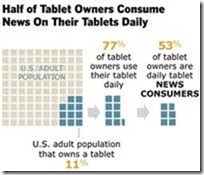 Although tablet owners spend more time consuming news than poking around on Facebook, they’re reluctant to pay for news content.
Although tablet owners spend more time consuming news than poking around on Facebook, they’re reluctant to pay for news content.That’s according to a study released on Tuesday by the Pew Research Center’s Project for the Excellence in Journalism.
It found that 11 per cent of American adults own a tablet of some kind, and they spend on average 90 minutes a day using the device.
Consuming news is one of the most popular activities, up there with email and more popular than social networking. Only general web-browsing proved more popular on tablets than news and email.
Even so, just 14 per cent of those who consume news on tablets said they have paid for news content on their devices. Another 23 per cent, though, pay for a print subscription that includes tablet content. So in all, about a third of tablet news consumers have paid to access news on their gadgets.
‘That is a much higher number than previous research has found more broadly of people paying for digital content,’ the report says.
Nonetheless, a ‘large majority’ of people who have not paid for news are ‘reluctant to do so, even if that was the only way to get news from their favourite sources’, the report adds.
This is bad news for media companies hoping to boost revenue by charging for content on Apple’s iPad and other tablets. Of the people who have not paid directly to access news on their tablet, just 21 per cent said they would spend $US5 ($A4.79) a month if that was the only way to access their favourite news outlet.
Apps, it turns out, are not the most popular way to access news content. Only 21 per cent of tablet news users said they get their news mainly through apps they have downloaded. By contrast, 40 per cent said they get their news mainly by way of a web browser, while 31 per cent said they use apps and the browser equally.
The study was conducted on landlines and mobile phones from June 30 to July 31 among 5014 adults in the US.
Story source: www.bigpond.com
-
6 in 10 Twitter Followers are Existing Customers
 6 in 10 Twitter Followers are Existing Customers
6 in 10 Twitter Followers are Existing Customers More than six in 10 (64%) people who follow a brand on Twitter are existing customers of the company, according to [pdf] a study released in October 2011 by Chadwick Martin Bailey. Results from “10 Quick Facts You Should Know About Consumer Behavior on Twitter” indicate about six in 10 (61%) also want to be the first to know information about the brand.
More than six in 10 (64%) people who follow a brand on Twitter are existing customers of the company, according to [pdf] a study released in October 2011 by Chadwick Martin Bailey. Results from “10 Quick Facts You Should Know About Consumer Behavior on Twitter” indicate about six in 10 (61%) also want to be the first to know information about the brand.No other reason for following a brand on Twitter is shared by more than half of followers. However, almost half (48%) follow to receive discounts and promotions. Another 36% want to gain access to exclusive content and 28% want to receive content and information to share and retweet with others.
6 in 10 Followers More Likely to Recommend
Six in 10 Twitter brand followers are either more likely to recommend many (18%) or a few (42%) brands as a result of following them. Another three in 10 (31%) are not more likely to recommend a brand they follow on Twitter and about one in 10 (9%) don’t know.
Twitter brand followers 35-49 are much more likely to recommend many brands they follow than those younger than 35. In the 35-49 segment, 33% are likely to recommend many brands and 14% are likely to recommend a few. Although a much higher percentage of followers younger than 35 are likely to recommend a brand overall (61% compared to 47%), only 14% are likely to recommend many brands and 47% are likely to recommend a few brands.
Interestingly, 33% of brand followers in both age groups are not more likely to make brand recommendations. The differentiator comes in the percentage who don’t know: 20% for those 35-49 compared to only 7% of younger followers.
Half of Twitter Users Go Online More than Once an Hour
Fifty percent of Twitter users go online more than once an hour, compared to 34% of Facebook users and 29% of overall online users. Facebook users are slightly more likely to go online once every couple of hours (46%) than Twitter users (40%) or overall online users (45%).
Meanwhile, 20% of overall online users go online once per day, compared to 17% of Facebook users and 7% of Twitter users. Only 5% of overall online users, and 3% of both social network users, go online two to six times per week.
Nearly Half of Twitter Users Been Tweeting Less than 1 Yr
Thirty-eight percent of Twitter users have been tweeting for six months or fewer and another 9% have been tweeting for seven to 11 months, meaning 47% have been tweeting for less than one year. Thirty-eight percent have also been tweeting for one to two years, and 15% have been tweeting for more than two years.
In addition, one-quarter of Twitter users older than 50 have been tweeting less than one month.
1/3 of Followers Interact w/More Brands This Year
Thirty-three percent of brand followers on Twitter are interacting with more brands this year, while 57% are interacting with the same number and only 11% are interacting with less. Men increased their rate of brand interaction more from the previous year (38% compared to 27% of women).
Other Findings
- 79% of Twitter users follow fewer than 10 brands, with 36% following one or two.
- 75% of Twitter followers have never unfollowed a brand.
- 26% of Twitter users 18-35 follow a brand, compared to 17% of followers 35-49 and 13% of those 50 and older.
- Half of followers say they are more likely to buy a brand after following, including 55% of men and 45% of women.
Performics: Entertainment Top Twitter Category
Entertainment is the brand category most followed/liked on both Twitter and Facebook, according to an August 2011 study from Performics and ROI Research. Data from “S-Net, The Impact of Social Media” indicates 46% of brand fans on both social networks are fans of at least one brand in the entertainment category.
While the top five brand categories are the same on both social networks, there is some variation in how the next four categories are ranked. After entertainment, Twitter users are most likely to follow brands in the restaurants, food, electronics, and apparel categories. In contrast, Facebook users are most likely to like brands in the food, restaurants, apparel, and electronics categories.
About the Data: Data was collected through a 15-minute online questionnaire of 1,491 US consumers age 18 and up fielded in January 2011.
-
Social Media Presence More Important Than Social Media Ads
 Yet marketers have concerns with the communities they’ve built on social sites
Yet marketers have concerns with the communities they’ve built on social sitesSocial media marketers feel that having a presence on social sites is more important than advertising there, but there are still challenges related to keeping a community running online.
In July 2011, Microsoft Advertising and Advertiser Perceptions surveyed social media marketers in six countries around the world and found that 74% of them thought it was very important to have a presence on Facebook, but only 57% felt the same way about advertising there. On Twitter, presence also carried more weight, with 47% of respondents saying they thought it was very important. But in Twitter’s case, there was not as much of a difference between presence and advertising, at 42%.

Of the marketers surveyed, 72% agreed that measuring return on investment from social media was too hard, an oft-cited challenge of social media overall. More specific to having a brand page or account, 56% of marketers said turnover was too high and 52% said their fan or follower base was not target-appropriate.
Looking at social media budgets gives more insight into how marketers are keeping their communities engaged online.
Social media marketers reported that 48% of their budgets are used to attract new members to their pages, with 28% focused on social sites such as Facebook or Twitter, and 20% from off of these sites. On the other hand, 19% of budgets are used to keep current Facebook or Twitter communities engaged, and an additional 20% of budgets are spent on paid media to maintain existing fan bases.

Continually working to keep social communities engaged will help marketers reduce turnover. And as social media marketers become more mature in their outreach and social networks improve their platforms, marketers can work to better target advertising to reach the right audience and track and measure success using better metrics. Time and experience with social media will help marketers overcome the challenge of maintaining communities at social sites.
-
NBN cheaper than current internet plans
 The boss of the company building the national broadband network says reports of cheaper entry-level internet plans under the NBN than current internet connections are in line with his company’s analysis.
The boss of the company building the national broadband network says reports of cheaper entry-level internet plans under the NBN than current internet connections are in line with his company’s analysis.Chief executive Mike Quigley told a Senate estimates hearing on Tuesday that NBN Co’s aim had been always to set the wholesale prices to match the market for the benefit of consumers.
Price comparison website WhistleOut said it had analysed the early trends in the pricing of the NBN against the ADSL 2+.
It said many of the NBN plans would be cheaper than equivalent ADSL 2+ bundle plans offered currently by internet service providers (ISP).
The site’s analysis of a monthly plan for 50 gigabytes download at a data speed of 12 megabytes per second found the average price was $59.14 for an ADSL 2+ bundle and naked DSL (including line rental and set-up costs average across the contract length) on four ISPs – Exetel, Internode, iiNet and iPrimus.
On the NBN’s equivalent plans, the average cost was $48.46.
‘It is certainly in the ballpark,’ Mr Quigley told the Senate environment and communications legislation committee hearing in Canberra.
‘…When people are transitioning off ADSL 2+ plans to the NBN, they will be paying roughly the same for a superior service.’
Mr Quigley said the vote at Telstra’s annual general meeting in favour of its deal with NBN Co was a ‘very important milestone’ for the project.
On Tuesday, 99.45 per cent of Telstra shareholders voted for the deal.
Under the plan with the federal government and NBN Co, Telstra will progressively decommission its copper-based network and allow NBN Co to access its pits, manholes and exchanges, and sell some infrastructure.
In return, Telstra will receive $11 billion from the federal government over the next 30 years.
The government created NBN Co to build the fibre-optic cable network to 93 per cent of Australian homes, schools and business, with the rest provided by fixed-wireless and satellite technology.
The $36 billion NBN project is scheduled for completion in 2021.
The chairman of the NBN joint committee, independent MP Rob Oakeshott, said the committee would assess whether the federal government’s deal with Telstra for the NBN represented value for money for taxpayers.
Opposition communications spokesman Malcolm Turnbull said the decision by Telstra shareholders was ‘hardly surprising’.
‘Telstra shareholders have voted in their own self interest, as they should,’ he said.
NBN Co is about to begin construction work on the next stage of the rollout of the high-speed broadband network.
The company released a 12-month plan on Tuesday, listing 28 new locations in each state and territory where construction of the fibre optic network will start between now and September 2012.
The network has so far been rolled out and activated in areas passing 18,200 premises, including three sites in Tasmania and five mainland sites.
By September next year, construction work will have commenced on sites passing 485,100 premises.
-
Beware Backfiring Social Media Ads
Marketers considering negative, mocking or even charitable social media promotional campaigns should first carefully consider how consumers may react, according to [pdf] a new report from WaveMetrix. Results from “Q3 2011 Benefits and Limits of a Social Media Fanbase” indicate a poorly designed social media campaign can create the wrong type of online buzz.
The report focuses on failed social media promotional efforts of three brands: EasyJet, Microsoft and American Express. A brief summary of each effort follows.
EasyJet Parody Ad Fails to Take Off
UK airline EasyJet released a poster on its Facebook page in September 2011 in response to a British Airways marketing campaign. The poster featured a “To Fly. To Save” slogan, mimicking British Airways’ “To Fly. To Serve” motto featured in its campaign. The page’s community manager asked users to let them know what you think and reaction has been very mixed.
As with other social media parody/satire campaigns analyzed by WaveMetrix, EasyJet’s post seems to have backfired, as consumers jumped to the defense of British Airways. More than half of comments about EasyJet were negative, as consumers criticized the “bitchy” poster. In contrast, more than three-quarters of comments about British Airways were positive, as consumers defended its “great ad.” WaveMetrix says this suggests that brands should refrain from using social media campaigns which attempt to tarnish a competitor’s reputation, in order to avoid the risk of a negative backlash.
Reaction to Microsoft Ad Not Petty
A viral online attack ad released in summer 2011 that was intended to promote Microsoft’s Office 365 email service and reveal the weaknesses of Gmail instead resulted in consumers branding Microsoft as “petty” and largely ignoring the merits of Office 365, which WaveMetrix says demonstrates the drawbacks of negative campaigns to marketers.
Negative comments on the Microsoft brand made up 40% of consumer discussion about the ad. In contrast, only 6% of discussion focused on Office365.
Amex Seen as Self-serving Instead of Charitable
In September 2011, American Express invited UK Twitter users to share the things that inspire them and has promised to donate to the Prince’s Trust charity for every tweet or retweet containing the hashtag #AmexBeInspired. WaveMetrix analysis reveals that almost half of all posts generated by the “Be Inspired” charity campaign are about the American Express brand itself, and the majority of these posts are negative.
While many tweeters used the #AmexBeInspired hashtag for its intended purpose, a large number of others posted sarcastic, angry comments about the American Express brand and their scepticism surrounding the charity campaign. WaveMetrix analysis indicates this suggests that brands that pledge to make a donation for every retweet, tag or Facebook like they receive risk angering consumers, who sometimes feel the donation should be made regardless.
Fan Involvement Aids SocNet Rebranding
Brands should consider their existing fan base when rebranding or launching new goods via social media, according to other results from “Q3 2011 Benefits and Limits of a Social Media Fanbase” which indicate successful brands involve fans in social media rebranding efforts rather than trying to force a positive response.
-
Google Engineer Calls Google Plus a ‘Complete Failure’
 Steve Yegge, a senior engineer at Google, has accidentally and publicly posted a critical analysis about his company’s understanding of platforms, calling Google Plus a "complete failure."
Steve Yegge, a senior engineer at Google, has accidentally and publicly posted a critical analysis about his company’s understanding of platforms, calling Google Plus a "complete failure."In a 4,000-plus-word deconstruction of Google+, intended for his co-workers’ eyes only, Yegge critiqued his former employer Amazon before mentioning Google’s failure to create a platform that works as well as Facebook.
The Google+ team tried to mimic Facebook’s usage of games but simply ended up being run-of-the-mill, thanks to a lack of understanding of platforms, Yegge said.
"That one last thing that Google doesn’t do well is platforms. We don’t understand platforms. We don’t ‘get’ platforms. Some of you do, but you are the minority. … I was kind of hoping that competitive pressure from Microsoft and Amazon and more recently Facebook would make us wake up collectively and start doing universal services … as our top priority from now on. But no. No, it’s like our 10th or 11th priority. Or 15th, I don’t know. It’s pretty low."
Yegge intended only fellow Google employees to see his self-proclaimed "long, opinionated rant," which he deleted immediately after posting in his Google+ Circles Wednesday, though a copy remains on Rip Rowan‘s blog. Yegge said Google’s public relations team was very respectful and did not try to censor his assessment, as it was his personal opinion.
He may well be right. Although Google enjoyed a 1,269 percent spike in traffic after opening to the public in late September, traffic has since dropped more than 60 percent, according to Chitika.
Could Google+ indeed be a complete failure? Here’s five reasons why I have to agree with Yegge.
1. No one is there
Simply put, Facebook has more than 750 million active users, which is a monopoly compared with Google+ and its estimated 43 million. I can post the cure to cancer, but it would still go under the radar and unnoticed. If the purpose of social media is to be social, and there’s no one to be social with, what’s the point?
2. Too much buildup
Since Google+ didn’t even open to the public until Sept. 20, it built up a hype that the newest social networking site was this amazing, exclusive new way to connect with friends. Everyone was begging to score an invite, to be a part of the elite. Until they found out that Google+ wasn’t really that extraordinary.
3. There’s nothing to do
Google undoubtedly has made attempts to keep users engaged with new updates and features, like Hangouts. But it looks like Google+ is having difficulty, judging by the numbers. However, if I wanted to video chat with my friends, I’d most likely use Skype. While I must admit I really enjoy the simple interface on Google+ sans a flood of invites to FarmVille and Mafia Wars, I know that many really enjoy the social aspect of online gaming. Google+ still has its fair share of games, but not nearly as many as Facebook.
4. No one has a clue how to use it … still
Humans typically don’t like change. I remember feeling the same way when I switched over from MySpace to Facebook. But Facebook made it easy to understand: There was nothing complicated about clicking "like" or add photo. I’ll be honest, I still have no idea what happens after I click "+1."
5. Circles are about as private as the lunch arrangement in "Mean Girls"
Yes, you can actually see what circles people put others in. On each post from Google+ users, there is a denotation of what stream they post, either "limited" or "public." Chances are if you only see "public" posts from a friend, you have been placed in their acquaintances category, leaving you wondering why you weren’t good enough to be a friend.
Story by Nadine DeNinno source: http://au.ibtimes.com
-
Microsoft clear to takeover Skype
 European anti-trust officials have approved US technology giant Microsoft’s $US8.5 billion ($A8.76 billion) takeover of Internet voice and video leader Skype.
European anti-trust officials have approved US technology giant Microsoft’s $US8.5 billion ($A8.76 billion) takeover of Internet voice and video leader Skype.‘The deal would not significantly impede effective competition across the single European market’ of half a billion consumers, the European Commission said in a statement on Friday.
Microsoft’s purchase is aimed at boosting its presence in an online arena dominated by Google and Facebook, both of whom were also believed to have been interested in Skype alongside computing giant Cisco.
Skype users can make low-cost or free phone calls over the Internet using their computers or smartphones. Skype bypasses the standard telephone network by channelling voice and video calls over the Web.
One of the top applications on Apple’s iPhone and on smartphones powered by Google’s Android software, Skype has about 170 million users who will now be able to ‘Skype’ using Windows-powered phones or even Xbox game consoles.
‘In the area of consumer communications, the investigation found that the parties’ activities mainly overlap for video communications, where Microsoft is active through its Windows Live Messenger,’ the European Union executive said.
‘However, the Commission considers that there are no competition concerns in this growing market where numerous players, including Google, are present.
‘For enterprise communications, the investigation confirmed that Skype has a limited market presence for these products and does not compete directly with Microsoft’s enterprise communication product Lync, which is used mostly by large enterprises,’ it added.
Skype was founded in 2003 and acquired by online auction giant eBay in September 2005. It was sold to an investment group led by Silver Lake in November 2009 in a deal that valued the company at $US2.75 billion ($A2.83 billion).
Microsoft’s biggest acquisition until now had been its 2007 buy of digital marketing firm aQuantive for $US6.3 billion ($A6.49 billion). Microsoft unsuccessfully tried to buy Yahoo! in 2008 for $US47.5 billion ($A48.96 billion).
Story source: www.bigpond.com
-
Why texting can be a pain in the neck
 Chiropractors are warning of a rise in a new condition called ‘text neck’, as people spend more time hunched over their mobile phones.
Chiropractors are warning of a rise in a new condition called ‘text neck’, as people spend more time hunched over their mobile phones.The affliction is caused by flexing the neck for extended periods of time and can cause permanent arthritic damage if not treated.
In some cases, patients can adapt to the flexed position and it becomes painful to straighten the neck out properly.
Cases of the condition, and other types of repetitive strain injury, have been on the rise as smartphones and tablet computers become increasingly popular.
Rachel Lancaster, of Freedom Back Clinic in Leeds, told news organisations she had treated thousands of patients for ‘text neck’.
‘Text neck is caused by the neck being flexed for a prolonged period of time,’ she said.
‘Sufferers are increasing as the use of smartphones and tablet computers become more popular.’
She added: ‘If people continue to put their necks in these positions the body will gradually adapt to the stresses.’
Tips for warding off text neck include rotating the shoulders with your arms by your sides, taking regular screen breaks and sitting up straight while texting.
Children are most at risk from the condition because their heads are larger in relation to their body size then adults.
Story source: www.bigpond.com
-
Demand for new iPhone ‘extraordinary’
 The initial demand for the iPhone 4S has made it the most successful iPhone launch ATT has ever had.
The initial demand for the iPhone 4S has made it the most successful iPhone launch ATT has ever had.The telecommunications giant said on Friday that it received more than 200,000 pre-orders for the iPhone 4S within the first 12 hours that the Dallas company began taking orders for the popular Apple smartphone.
ATT and rivals Sprint Nextel Corp and Verizon Wireless started taking pre-orders for the iPhone 4S on Friday.
Apple Inc is making the latest version of the iPhone available on October 14.
ATT shares added 10 US cents to $US28.60 in aftermarket trading. The stock rose 3 US cents to $US28.44 during the regular session.
-
Facebook Reigns as Top Global SocNet
 A look at the top social networking brands worldwide released by comScore in September 2011 revealed that, perhaps unsurprisingly, Facebook.com ranked as the top social network by a wide margin. In June 2011, 734.2 million people visited Facebook.com globally, an increase of 33% from the previous year.
A look at the top social networking brands worldwide released by comScore in September 2011 revealed that, perhaps unsurprisingly, Facebook.com ranked as the top social network by a wide margin. In June 2011, 734.2 million people visited Facebook.com globally, an increase of 33% from the previous year.Meanwhile Twitter.com climbed its way to the #2 position reaching 144.4 million visitors (up 56%), followed by Windows Live Profile at 119.5 million visitors. Professional social network LinkedIn.com reached more than 84 million visitors globally to secure the #4 spot, followed by Chinese site QQ.com Microblogging with 74.8 million visitors.
Worldwide SocNet Audience Passes 1B
Across the globe, social networking continues to grow as new users adopt the activity as a routine part of their online experience. In June 2011, comScore analysis shows 1.1 billion people (age 15 and older accessing from a home or work location) visited a social networking site worldwide, an increase of 22% from June 2010.
Globally, 81.4% of all internet users visit social networking destinations, representing one of the top online activities worldwide. In comparison, close to 1.4 billion people used the internet in June 2011, a 10% jump from June 2010.
Asia-Pacific Leads in SocNet Visitors, Europe in Minutes
 Examining regional social network usage trends, comScore finds differences in share of visitors and share of minutes. Asia-Pacific leads in share of visitors (32.5%), followed by Europe (30.1%) and North America (18.1%).
Examining regional social network usage trends, comScore finds differences in share of visitors and share of minutes. Asia-Pacific leads in share of visitors (32.5%), followed by Europe (30.1%) and North America (18.1%).However, Europe takes a 38.1% share of minutes, followed by North America (21.5%). Interestingly, Asia-Pacific’s share of minutes (16.5%) is only roughly half as large as its share of visitors.
Latin American Countries Make Strong Time Showing
Globally, Internet users averaged 5.4 hours on social networking sites during the month of June. A look at the top markets based on the average number of hours spent social networking revealed that half of the top 10 markets were Latin American countries, demonstrating what comScore calls the vast engagement visitors in these markets have with social networks.
Argentina’s online users averaged 10 hours on social networking sites in June to rank third overall, while Chileans averaged 8.7 hours. Colombians ranked seventh with 8.4 hours per visitor in the social networking category, while Venezuelans ranked eighth at eight hours. Visitors in Mexico (7.1 hours) also ranked among the top tier.
Israel ranked first with 11.8 hours, followed by the Russian Federation (10.6 hours). Turkey ranked fourth (9.6 hours), while Philippines ranked sixth (8.4 hours) and Canada ranked ninth (7.2 hours). Europe, North America and Asia-Pacific each had one country in the top 10 time list, while Middle East-Africa had two.
Nielsen: Facebook Dominates US Web Brands in Time
Facebook clearly dominates other top US web brands in average monthly time spent per user, according to data from The Nielsen Company. In July 2011, the average Facebook user spent five hours, 18 minutes and 40 seconds on the site.
In comparison, the brand with the second-highest average time per user in July, AOL Media Network, only averaged two hours, 17 minutes and 46 seconds, less than half Facebook’s total. Yahoo trailed closely behind AOL with a monthly average of two hours, 14 minutes and 25 seconds. There was then another gap of almost 40 minutes between Yahoo and YouTube, which average one hour, 39 minutes and two seconds per user.
-
Revolutionary game system launched
 An online gaming system has been launched in the UK that could revolutionise the industry.
An online gaming system has been launched in the UK that could revolutionise the industry.The ‘cloud’-based OnLive service gives users access to on-demand games via the internet with no need for a console.
Gamers can play around 150 games on various devices including PCs, Mac tablets and net-connected televisions.
It was launched at the Eurogamer Expo at Earls Court, west London, where around 40,000 enthusiasts will gather over the next few days to try out the latest games.
Hundreds queued to test the new system.
‘This is gaming over the internet,’ explained Bruce Grove, OnLive’s senior director of business development.
‘We’ve had on-demand radio, on-demand videos, now we have on-demand video games.
‘We have all the latest titles streamed direct to your TV, PC, Mac tablet, any device. All you need is a broadband connection.’
The gaming industry is now bigger than the film and music industries, with the UK market – the biggest in Europe – worth almost worth almost 2.4bn.
It is predicted that by 2015, the gaming industry in the UK will be worth well over 3bn.
Playstation and Xbox have recently experienced problems with hackers accessing customers’ personal information.
But chief executive and founder of OnLive Steve Perlman said this does not pose a problem for them, as personal information is stored with a third party billing agency which is not on one of their servers.
He said: ‘The worst they could do if they hacked into our data centre is perhaps get your high score.’
OnLive, which launched in the US last year, has been developed to eliminate piracy.
Matt Hill, deputy editor of T3 Magazine, said it would be almost impossible to pirate the games – but warned there were some future pitfalls.
‘Because you don’t have the physical game, you are accessing it remotely from a server, you can’t pirate it, you’re literally streaming it from someone else’s server,’ he said.
‘There will be an argument made that eventually someone might be able to figure out how to get in and play the games for free, I imagine that is a long way off, but there’s always someone working on it.’
-
Upload your thoughts to Youtube
 Picture in your mind a happy scene from your past and then imagine being able to record it – maybe even upload it to YouTube.
Picture in your mind a happy scene from your past and then imagine being able to record it – maybe even upload it to YouTube. It is still a distant possibility, but researchers at the University of California, Berkeley, have developed a system which can scan your mind and create a visual reconstruction of your thoughts.
They hope that eventually the breakthrough could lead to helping stroke victims, coma patients and people with neurodegenerative diseases.
‘This is a major leap toward reconstructing internal imagery,’ said Professor Jack Gallant, a UC Berkeley neuroscientist and co-author of the study.
‘We are opening a window into the movies in our minds.’
The technology uses functional Magnetic Resonance Imaging (fMRI) to measure blood flow to certain areas of the brain used to visualise certain shapes in our minds.
The software creates a reconstruction of a person’s thoughts.
Researchers fed 18 million seconds of random YouTube videos into a computer programme which predicted the type of brain activity it was likely to provoke.
The software would then measure the real brain waves of participants, matching those to the predictions.
The programme goes on to gather a selection of clips, which it believes match the brainwaves most closely, producing a composite video to complete the reconstruction.
The resulting images are far from high-definition – visualisations of a scene involving actor Steve Martin show a blurry, unrecognisable outline – but researchers believe it is an important first step.
‘We need to know how the brain works in naturalistic conditions,’ said Shinji Nishimoto, lead author of the study.
The software monitors blood flow to certain key areas of the brain
‘For that, we need to first understand how the brain works while we are watching movies.’
The developments have been welcomed by Dr Sharlin Ahmed, research liaison officer at The Stroke Association.
‘Around a third of people who have a stroke are left with communication difficulties, which can leave many stroke survivors feeling incredibly isolated and frustrated,’ she said.
‘It can also be extremely tough for their families who often find it hard to understand how their loved one is feeling.
‘We are always looking for new ways to better understand the needs of stroke survivors, especially those who find it hard to communicate.
‘Using brain imaging technology to interpret what a stroke survivor might be thinking is a very interesting concept, however it’s likely to be a long time before anything like this is used in practise.’
The researchers have reassured those worried about an Orwellian intrusion into their inner thoughts that there is no need to panic – the technique requires participants to spend hours upon hours in an MRI scanner.
Source: www.bigpond.com
-
Females, 18-34-Yr-Olds Most Active Social Networkers
 Females make up the majority of visitors to social networks and blogs, and people aged 18-34 have the highest concentration of visitors among all age groups, according to a September 2011 report from The Nielsen Company. Data from “The Social Media Report Q3 2011? indicates that during Q3 2011, women were 3% more likely than average to use social networkers, and 18-to-34-year-olds were 8% more likely than average.
Females make up the majority of visitors to social networks and blogs, and people aged 18-34 have the highest concentration of visitors among all age groups, according to a September 2011 report from The Nielsen Company. Data from “The Social Media Report Q3 2011? indicates that during Q3 2011, women were 3% more likely than average to use social networkers, and 18-to-34-year-olds were 8% more likely than average.In addition, Asian/Pacific Islanders were the ethnic group most likely to visit social networks and blogs, indexing 3% than the overall average. Other leading indicators of social network usage include living in New England (2% higher than average), holding a bachelor’s or postgraduate degree (6% higher than average), and earning less than $50,000 per year (2% higher than average).
Facebook Almost Triples Audience of Nearest Competitor
Looking at the top 10 US social networking/blogging sites during Q3, Nielsen finds that Facebook, with an average monthly audience of more than 140 million, almost triples the average monthly audience (50 million) of its nearest competitor, Blogger. Facebook reaches 70% of active internet users. Nielsen also determined the following facts about the top 10 social networking/blogging sites:
- LinkedIn and Wikia are the only sites in the category where the percentage of men visiting the respective site exceeds the percentage of total active male Internet users (47%).
- 62% of page views on Facebook are from female users.
- 75% of Blogger’s users have a household income of $75,000 or more.
- African-Americans are represented on Twitter more than any other social network.
- 25% of WordPress visitors have a bachelor’s degree.
- Teens view twice as many MySpace pages as the average user.
- LinkedIn users with a postgraduate degree visit the site three times more than the average user.
- Female teens are represented more on Tumblr than any of the other nine leading social networking/blogging sites.
- The Pacific region has a higher concentration of Six Apart users than any of the other nine leading social networking/blogging sites.
- New England has a higher concentration of Pulse visitors than any other region.
- 18-to-34-year-olds are more represented on Wikia than any of the other top sites.
Web Users Spend More Time on Facebook than Any Other Web Brand
Facebook users average 53.4 million minutes per month. This dwarfs the monthly minutes spent by users of any other web brand. Yahoo users come in a distant second with an average of 17.2 million minutes per month, less than one-third Facebook’s total.
Other social networking/blogging sites trail Facebook much more dramatically. None even come close to 1 million minutes per month. Blogger ranks second with about 724,000 monthly minutes, which is more than double the roughly 325,000 monthly minutes spent by users of number five social networking/blogging site LinkedIn.
Social Networking 3rd-Most-Used Smartphone App
Social networking is the third most-used type of mobile application among US smartphone owners who download apps. Sixty percent use social networking apps, only beaten by apps for weather (65%) and games (67%). Facebook ranks as the most popular app across all operating systems and Twitter is the fifth-most used app on BlackBerry and Windows Mobile operating systems.
Other Findings
- Mobile internet audience to social networking sites is up 62% compared to Q3 2010.
- Thirty percent of smartphone users say social networking apps are the phone feature they value most.
- Social networks and blog sites accounting for 23% of time Americans spent online in Q3, more than twice the amount of time spent on the #2 category, online games.
- Social networks and blogs reach nearly 80% of active US internet users.
- Close to 40% of social media users access social media content from their mobile phone.
Pew: 2 in 3 Online Adults Use SocNets
Two-thirds of adult internet users (65%) now say they use a social networking site like MySpace, Facebook or LinkedIn, up almost 7% from 61% one year ago, according to an August 2011 report from the Pew Internet & American Life Project. That’s more than double the percentage that reported social networking site usage in 2008 (29%), and about eight times the 8% who said they used social networking sites in 2005.
Looking at usage on a typical day, 43% of online adults use social networking, up 13% from 38% a year ago and more than triple the rate of 13% in 2008. Out of all the “daily” online activities that Pew polls about, only email (which 61% of internet users access on a typical day) and search engines (which 59% use on a typical day) are used more frequently than social networking tools.
-
Porn Sites Holding Australian Domains Hostage
 Websites all over the world are being told to pay a US company for the rights to their own .xxx domain name or risk having their trademarked names associated with pornography sites.
Websites all over the world are being told to pay a US company for the rights to their own .xxx domain name or risk having their trademarked names associated with pornography sites. Australian web companies have until October 28 to pay US business ICM Registry for the rights to their own .xxx domain name.
If they do not pay for the domain themselves within that time, porn sites and other buyers will be able to snap up addresses like facebook.xxx or google.xxx.
ICM Registry stands to make up to $400 million from Australian websites alone, with two million businesses operating online, according to the ABS.
Web addresses with the .xxx domain are now available for US$199 ($191).
More than 4000 celebrity names have already been blocked from use in what has been dubbed the "online red light district".
Celebrity names blocked by ICM Registry include Barack Obama, Beyonce, Angelina Jolie and Margaret Thatcher.
Source: www.ninemsn.com.au
-
Cybercrime to get even bigger – expert
 An expert says cybercrime is soaring, it already costs Australians more than burglary and will only increase as more people use smartphones.
An expert says cybercrime is soaring, it already costs Australians more than burglary and will only increase as more people use smartphones.Marian Merritt, internet safety advocate with computer security company Norton, said a new global study showed 69 per cent of adults around the world experienced cybercrime in their lifetime, much more than previously thought because this type of crime mostly isn’t reported.
‘Ten per cent of us have already experienced mobile device related cybercrime. That’s cybercrime on our cellphones, tablets and other devices we carry with us as we go about our business,’ she said.
‘It’s only going to get bigger because we are all doing more and more with our mobile devices,’ she said.
Cybercrime on mobile devices has produced a new word: smishing, or SMS-based phishing which aims to gain private information.
In some countries, many people go straight to mobile devices for all their computing needs, bypassing the home PC route. More and more, mobile devices are being used for routine financial transactions.
‘We are going to walk up to buy coffee and use our mobile device to make that financial transaction, we are going to check our bank balance and we are going to make purchases,’ she said.
‘This is what’s coming in the future and we need it to be safe. This is truly a phenomenon we need to take note of.’
Ms Merritt said part of the problem was that users didn’t treat smartphones in the same way they treated their home PC.
‘We are all playing little bird-related games on them. We put funny stickers on the back of them. They don’t seem like serious devices that need security but boy they really are,’ she said.
In its fourth global review of cybercrime, Norton surveyed the experiences of 20,000 people in 24 countries including 802 in Australia.
Taking into account actual financial losses and other factors such as time lost, the study puts the global cost at $US388 billion over the last year. That makes cybercrime bigger than the combined global market for marijuana, cocaine and heroin combined.
For Australia, that’s a direct cost of $1.8 billion and another $2.8 billion in time spent resolving cybercrime issues. On that basis, cybercrime costs Australia more than the traditional crimes of burglary ($2.2 billion) and assault ($1.4 billion).
The most common form of cybercrime relates to computer virus and malware infection (57 per cent of respondents), followed by online credit card fraud (13 per cent) and hacking of social network data (12 per cent). Worryingly, the survey said, most of this occurred in the last year.
Ms Merritt suggests some simple precautions:
– use security software and keep it up to date (Norton is of course a major vendor).
– use a password for a mobile device (something more sophisticated than 1234) so it can’t be readily used if lost or stolen.
-
Facebook doubles 2011 revenues
 Facebook doubled its revenues in the first half of this year, to 1.6 billion dollars ($A1.5 billion).
Facebook doubled its revenues in the first half of this year, to 1.6 billion dollars ($A1.5 billion).The Wall Street Journal reports that, with 750 million Facebook members worldwide, the online site has attracted major interest from advertisers.
-
Facebook pays $40,000 to bug spotters
 Facebook wants you to try to hack into its site — and if you succeed, it will pay you for the details.
Facebook wants you to try to hack into its site — and if you succeed, it will pay you for the details.Facebook said this week that that it has paid out more than $40,000 under its new "bug bounty" security initiative. Launched three weeks ago, Facebook’s program invites security researchers — both the professional kind and hacker hobbyists — to send it the details of any Facebook vulnerabilities that they uncover. If the report checks out, Facebook will pay a finder’s fee of at least $500.
It’s willing to go higher for extra-impressive bug spotting.
"We’ve already paid a $5,000 bounty for one really good report," Facebook Chief Security Officer Joe Sullivan wrote in a blog post. "One person has already received more than $7,000 for six different issues flagged."
Although the social networking has its own security team, Facebook launched its bug bounty program to tap into the collective wisdom of the site’s 750 million users.
"We hire the best and brightest, and have implemented numerous protocols," Sullivan wrote. "We realize, though, that there are many talented and well-intentioned security experts around the world who don’t work for Facebook."
Researchers from more than 16 countries have successfully submitted bounty bugs, Facebook said. Its public "thank you" list names dozens of contributors.
Facebook also took pains to assure bug-hunters that it won’t take any legal action against those who submit bugs, even if they were uncovered through less-than-legal routes into Facebook’s systems.
That’s often how hackers find vulnerabilities, but even those without any ill intent — so-called "white-hat hackers" — can land in hot water with companies if they tell them about their intrusion.
"We worked with several third-party groups to ensure that the language in our policy protects researchers and makes clear our intent to work with, not punish, those who report information," Sullivan wrote.
The Electronic Frontier Foundation, an advocacy group that often weighs in on Internet-related legal issues, is a fan of that approach.
"We hope to see others follow Facebook’s lead and go even further," the EFF wrote last year about Facebook’s security policy. "The more transparent companies are about their approaches to vulnerability disclosure — and the more they encourage users to come forward — the more often they will learn about problems that need to be fixed."
Story source: www.cnn.com
-
Older Facebook Users Click More, Like Less

While propensity to click-through on Facebook is positively correlated with age, propensity to like is not, according to data released in August 2011 by Facebook marketing consulting firm SocialCode. Age has a strong positive effect on whether a user will click, but has a less pronounced opposite effect on the likelihood of them becoming a fan of a page.
Fifty-plus-year-old users, the oldest segment in the study, are 28.2% more likely to click through and 9% less likely to like than 18-29-year-old users, the youngest group observed. Compared to the rest of the younger population, 50-plus users see a 22.6% higher CTR and 8.4% lower like rate.
CTR Rises More Directly than Like Rate Falls
Interestingly, CTR by age rises much more directly than like rate by age falls. CTR rises almost continuously as user age progresses, rise in an almost direct line as users age, with a minimal plateau inside the 30-39-year-old age bracket.
However, the like rate shows some strong fluctuation before plummeting once the user enters the 50-plus bracket. Among 18-to-29-year-olds, the like rate is about 39.5%, and then dips to about 38.5% in the 30-t0-39-year-old demographic.
However, the like rate jumps back to its highest point of slightly more than 39.5% among 40-to-49-year-olds. It then dramatically drops to slightly more than 36% in the 50-plus group of Facebook users.
Women Click More, Men Like More
Overall, women are 11% more likely to click on an ad than men. Like rates, however, are almost even for men and women, with men actually 2.2% more likely to like an ad than women.
In addition, when broken down by age, age has a much more pronounced effect on CTR for women than it does for men, whereas for men there is a stronger effect on like rate than for women.
For women, CTR is 31.2% higher for the 50 plus age group compared to 18-29-year-olds, whereas men only see a 16.2% difference. Compared to all age groups, 50-plus women’s CTR is 22% higher, compared to a 16.4% difference for males.
However, the oldest male segment has an 11.7% higher like rate than the youngest segment, and 9.5% higher like rate than all age groups. Women only see 7.2% and 7.9% differences, respectively.
trendwatching.com: ‘F’ is for F-Factor
Consumers are tapping into their networks of friends, fans, and followers to discover, discuss and purchase goods and services in ever-more sophisticated ways, according to an August 2011 advisory from consumer trends firm trendwatching.com. As a result, trendwatching.com advises it’s never been more important for brands to make sure they too have what it calls the “F-Factor,” with “F” standing for friends, fans and followers.
trendwatching.com identifies five key ways the F-Factor influences consumer behavior:
1. F-Discovery: How consumers discover new products and services by relying on their social networks.
2. F-Rated: How consumers will increasingly (and automatically) receive targeted ratings, recommendations and reviews from their social networks.
3. F-Feedback: New ways in which consumers can ask their friends and followers to improve and validate their buying decisions.
4. F-Together: How shopping is becoming increasingly social, even when consumers and their peers are not physically together.
5. F-Me: How consumers’ social networks are literally being turned into products and services. -
UK not pursuing limits on social media
 A meeting on Thursday between the British government and Internet communications firms was friendly, not confrontational, according to people from the organizations that took part in the meeting.
A meeting on Thursday between the British government and Internet communications firms was friendly, not confrontational, according to people from the organizations that took part in the meeting.At the meeting, the government "did not seek any additional powers to close down social media networks," the British Home Office, the government’s home security department, said in a statement. "The discussions looked at how law enforcement and the networks can build on the existing relationships and cooperation to crack down on the networks being used for criminal behaviour."
Spokespeople for the British Home Office declined to provide additional details about whether it broached the issue of imposing limits social media.
The gathering took place about two weeks after British Prime Minister David Cameron suggested that the government should impose limits on the "free flow of information" when it’s "used for ill." "When people are using social media for violence, we need to stop them," he said then.
Twitter took the brunt of the blame immediately following the violent rioting and looting in England. However, people mostly used private lines like BlackBerry Messenger to organize, rather than Twitter or Facebook, later reports found.
"RIM continues to maintain an open and positive dialogue with the UK authorities and continues to operate within the context of U.K. regulations," a RIM spokeswoman said in a statement late Thursday. "It was a positive and productive meeting, and we were pleased to consult on the use of social media to engage and communicate during times of emergency."
The U.K. was still entertaining the idea of limiting social media usage shortly before Thursday’s meeting. In a statement released beforehand, the Home Office said: "We are working with the police to see what action can be taken to prevent access to those services by customers identified as perpetrators of disorder or other criminal action."
Instead of detailing plans to block criminals’ access to networks, police and government officials solicited advice from those in attendance about how to monitor the sites, the organizations said. Spokeswomen for the Home Office and for Facebook described the meeting as "constructive."
"We welcome the fact that this was a dialog about working together to keep people safe rather than about imposing new restrictions on Internet services," the Facebook spokeswoman said in a statement. She noted that Facebook already has rules in place to punish illegal activity on the site.
A Twitter spokeswoman said that governments and police rely on its service to distribute alerts. "We are always interested in exploring how we can make Twitter even more helpful and relevant during times of critical need," she said in a statement after Thursday’s meeting.
Story by Mark Milian, CNN
-
Google deal set to ‘supercharge’ Android
 Google has struck its biggest ever deal – to buy Motorola’s smartphone and tablet business for $12.5 billion in cash.
Google has struck its biggest ever deal – to buy Motorola’s smartphone and tablet business for $12.5 billion in cash. Both companies say the move will give a ‘supercharge’ to Google’s Android platform.
Android-based devices, which include Motorola’s smartphones and tablets – are the major rivals to Apple’s iPhone and iPad.
As such, the acquisition appears to be a decisive effort by Google to tackle to dominance of Apple head on.
Under the deal, Google will buy Motorola Mobility for $40.00 per share, a price that is 63% over the closing value of Motorola Mobility shares on Friday.
‘Motorola Mobility’s total commitment to Android has created a natural fit for our two companies,’ said Google chief executive Larry Page.
‘Together, we will create amazing user experiences that supercharge the entire Android ecosystem for the benefit of consumers, partners and developers.
‘I look forward to welcoming Motorolans to our family of Googlers.’
Analysts said access to Motorola’s intellectual property had clearly been a major motivating factor behind Google’s purchase.
‘What Google are actually buying here is not a mobile phone business at all,’ said Ben Rooney, technology editor at the Wall Street Journal.
‘What they are buying is this enormous suite of patents that Motorola – which is one of the oldest mobile phone companies out there – has built up over the years.’
The 17,000-strong patent portfolio which will pass into Google’s hands would shield it well in the ongoing patent war between smartphone and tablet makers, he added.
Following a split eight months ago, Motorola is a company of two parts.
As well as the ‘Mobility’ arm, which makes phones and tablets, it also has a ‘Solutions’ division, which develops technology systems for industry.
Mr Page admitted Google did not have experience with manufacturing devices, and as such planned to run Motorola Mobility as a separate business.
However he stressed that Google had a strong track record with acqusitions, having made 120 purchases in the past few years.
In order for the deal to go through, Google needs the approval of Motorola Mobility shareholders and competition regulators.
It said it was confident the acquisition would be cleared because it protected the future of Android, which is an open-source platform used by several other mobile device makers.
Yet this situation may prove to be an obstacle.
Other smartphone handset makers who use Android will want reassurance that the platform will not simply be tailored to Motorola’s requirements in future, analysts warned.
-
Facebook submits ownership law evidence
 Facebook lawyers have revealed evidence they say proves a New York man fabricated a contract that he says entitles him to part ownership of the $US50 billion ($A47.68 billion) social network.
Facebook lawyers have revealed evidence they say proves a New York man fabricated a contract that he says entitles him to part ownership of the $US50 billion ($A47.68 billion) social network.Included in an after-hours court filing is an image of a two-page contract signed by Paul Ceglia of Wellsville, New York, and Facebook founder Mark Zuckerberg, recovered by forensics experts from Ceglia’s computer.
The image is blurry and difficult to read but appears only to refer to a street-mapping database Ceglia hired Zuckerberg to work on in 2003 – and not Facebook.
Ceglia’s lawsuit against Zuckerberg is based on a contract that he says shows that when he hired Zuckerberg for the streets project, he also invested $1,000 in the then-Harvard University student’s fledgling Facebook idea on the condition he’d own half if it expanded.
From the beginning, Facebook has said the contract submitted by Ceglia was doctored. Now, lawyers said, they’ve got the original, retrieved from embedded electronic data.
Facebook alluded to the find as ‘smoking gun’ evidence in earlier court filings but was barred from publicly identifying it by a confidentiality order which has since been modified.
‘This smoking gun evidence confirms what defendants have said all along: the purported contract attached to the complaint is an outright fabrication,’ lawyer Orin Snyder of Gibson, Dunn Crutcher LLP, wrote on Monday.
Ceglia’s lawyer, Jeffrey Lake of San Diego, did not respond to an emailed request for comment from The Associated Press on Monday night. Ceglia is in Ireland, according to emails he’s written to his hometown newspaper, the Wellsville Daily Reporter.
In court papers filed last week, Ceglia’s lawyers took issue with Facebook’s claims that Ceglia had concealed certain documents.
‘No good-faith basis has been shown for such an accusation,’ Lake wrote.
He said Cegla had complied with the court’s instructions to turn over all of his computers and electronic media as part of the discovery process in the case.
Zuckerberg’s lawyers say six removable storage devices containing files entitled ‘Zuckerberg Contract’ and ‘Facebook Files’ are missing.
The lawyers are scheduled to appear before US Magistrate Judge Leslie Foschio in Buffalo on Wednesday to argue a series of motions. Ceglia wants the judge to compel Facebook to turn over emails between Ceglia and Zuckerberg captured from Zuckerberg’s Harvard account from 2003 and 2004.
He’s also asked that the case be sent to mediation for possible settlement to avoid protracted proceedings.
Facebook wants the judge to require Ceglia to produce the original electronic version of the contract and other electronic files and to allow further ink sampling from a hard-copy version of the contract.
Zuckerberg’s lawyers oppose mediation as ‘pointless,’ saying the only resolution to the case they’re willing to accept is to see it thrown out.
-
Facebook launches free SMS alternative
 Facebook is attempting to play a strong card against telcos with the release of a new instant messaging app that will also send free SMS.
Facebook is attempting to play a strong card against telcos with the release of a new instant messaging app that will also send free SMS.The world’s largest social media company released Facebook Messenger for iPhone and Android phones earlier this week in the US, with Australia to soon follow.
The application allows for instant free messages between friends and groups with several options for when you are notified.
But Telstra said it doesn’t expect a move away from SMS despite the availability of free alternatives.
"Telstra has seen continued SMS growth in the face of mobile social networking" said a spokeswoman speaking to News.
The app will also be in competition with Blackberry’s instant messaging service, which sends encrypted messages, preventing them from being read by any one other than the sending and receiver.
Blackberry’s maker, Research in Motion went under the microscope recently when it was found that rioters in the UK were using the service to coordinate acts of violence and destruction.
A similar card will also be played by Apple next month when it releases its iMessenger app with the iOS 5 software update.
It will provide iPhone and iPad users the ability to exchange SMS style messages without using a mobile carrier.
-
Google+ social network adds games
 Google+ added games, including the hugely popular Angry Birds, to the fast-growing social network vying with Facebook to be the hub for people’s online lives.
Google+ added games, including the hugely popular Angry Birds, to the fast-growing social network vying with Facebook to be the hub for people’s online lives.‘We want to make playing games online just as fun, and just as meaningful, as playing in real life,’ Google senior vice president of engineering Vic Gundotra said in a blog post.
‘When you’re ready to play, the Games page is waiting.’
Along with global game sensation Angry Birds, the initial array of offerings available at Google+ included Bejeweled Blitz, Zynga Poker, and Dragon Age Legends.
Google is a latecomer to social networking but its new site, Google+, has grown rapidly to more than 10 million members since its launch on June 28.
While Google+ may be the fastest-growing social network ever, it remains to be seen whether it can pose a serious threat to the social networking titan Facebook, which has more than 750 million members.
Google has a billion users worldwide that could be drawn into the California-based internet giant’s social network.
Games are among the most popular activities at Facebook, where social game startup Zynga rose to stardom.
Most Google+ users — 6.4 million — are in the United States, followed by India, with 3.6 million, Canada, with 1.1 million, Britain, with 1.1 million, and Germany with over 920,000, according to online tracker comScore.
In unveiling Google+, Google stressed the ability it gives users to separate online friends and family into different ‘Circles,’ or networks, and to share information only with members of a particular circle.
One of the criticisms of Facebook is that updates are shared with all of one’s friends unless a user has gone through a relatively complicated process to create separate Facebook Groups.
-
‘Super Greenies’ are Heavy Online Users

 “Super Greenies” (adults who engage in 10 or more environmentally friendly activities on a regular basis) tend to use the internet more heavily than average adults, according to [pdf] an August 2011 study from Scarborough Research. For example, data from “All About the Super Greenies” indicates 51% of Super Greenies have visited Facebook in the past 30 days, making them 36% more likely than average adults to use Facebook.
“Super Greenies” (adults who engage in 10 or more environmentally friendly activities on a regular basis) tend to use the internet more heavily than average adults, according to [pdf] an August 2011 study from Scarborough Research. For example, data from “All About the Super Greenies” indicates 51% of Super Greenies have visited Facebook in the past 30 days, making them 36% more likely than average adults to use Facebook.The social networks where Super Greenies overindex the most, however, are LinkedIn and Twitter. Thirteen percent of Super Greenies have visited LinkedIn in the past 30 days, making them 179% more likely than average to have done so. And while only 9% have visited Twitter in the past 30 days, this is still almost double (96%) the average rate.
Super Greenies Consume Online Media
Super Greenies are avid consumers of online media beyond social networks. Forty-two percent have visited a newspaper website in the past 30 days, 61% more than average. And 38% have visited a broadcast TV website in the past 30 days, 38% more than average.
As with social networks, Super Greenies’ highest levels of overindexing on media sites is actually highest where their overall usage is lowest. Only 12% have visited Hulu in the past 30 days, roughly double (99% more) the average rate. And the 19% who have visited a radio station site in the past 30 days is 48% higher than average, second only to newspaper site usage for overindexing.
Super Greenies Stay Local Online
Super Greenies also consume local online content at rates higher than the overall population. Sixty-nine percent have checked local weather in the past 30 days, 51% more than the average adult. The most notable local content Super Greenies check online more than the total population is traffic, which 15% of Super Greenies have checked in the past 30 days, 231% higher than the average rate.
Other Findings
- Super Greenies are top spenders in all retail categories measured by Scarborough.
- Super Greenies are 71% more likely than the overall population to own a foreign luxury vehicle.
- Half of Super Greenies have volunteered in the past year, and are 90% more likely than the average adult to have done so.
- 42% of Super Greenies have visited an art museum in the past year, making them 220% more likely than the total population to have done so.
-
Merchants Split on Groupon Satisfaction
 Even when local merchants make money, many remain unhappy with deals
Even when local merchants make money, many remain unhappy with dealsThe long-term profitability of participating in daily deal promotions remains an open question for local businesses, even as services like Groupon remain popular and more businesses jump on board with deal offers.
July research from UK-based Cooper Murphy Copywriters found that nearly two-thirds of US businesses that had run a Groupon promotion said the particular promotion had been profitable for them. While a few were unsure, only 35% said they did not make money off the deal itself—an early worry among many businesses due to the deep discounting offered for such programs.
Yet businesses remained unsatisfied. Fully 82% were unhappy with the level of repeat business their Groupon promotion brought in, and nearly as many said Groupon users were more price-sensitive than the average customer.

In the end, a slight plurality of respondents said they would not advertise with Groupon again.

Other research into merchant satisfaction with daily deals has indicated a similar ambivalence. According to a Rice University study, businesses reported that as of May 2011 just 20.4% of customers who came in because of a Groupon offer became repeat visitors, and that less than half of the businesses were interested in another such promotion. But consumer-based research from ConsumerSearch.com and The About Group found that more than two-thirds of daily deal users said they returned to businesses at which they had previously redeemed a deal.
These stats do not necessarily disagree. Consumers polled about their behavior indicate they returned to at least one business after using a daily deal, but may have redeemed many other deals at businesses they never returned to.
Furthermore, many merchants are satisfied with the level of business daily deals bring in; a MerchantCircle survey of small businesses found that, contrary to the Cooper Murphy study, 77% of them would run another daily deal promotion after their first experience.
-
Facebook Monthly Visitors More than Double MySpace, Twitter Combined

As of May 2011, the number of unique US visitors to Facebook.com was roughly 2.5 times the combined number of unique visitors to MySpace and Twitter.com, according to a July 2011 white paper from comScore. Data from “The Power of Like” indicates in May 2011, Facebook had almost 160 million unique US visitors, while MySpace has a little less than 40 million and Twitter had a little more than 20 million.
Facebook, Twitter Show Dramatic 4-Year Growth
In June 2007, Facebook recorded a little more than 20 million unique US visitors, meaning that total has increased roughly eight times in the past four years. With virtually no unique visitors in June 2007 (it initially launched in March 2006), Twitter’s growth is hard to even put a number on.
In contrast, MySpace received roughly 70 million unique visitors in June 2007, meaning it has lost more than 40% of that total in the past four years.
Facebook Homepage Draws Most Interest
Within Facebook, the largest portion of users’ time is spent on the individual’s homepage which features the newsfeed. In May 2011, 27% of engagement on Facebook.com occurred on the homepage and nwsfeed, followed by profile viewing (21%), photo viewing (17%) and usage of apps and tools (10%) The remaining 25% of user time is spent on all other areas of the site.
Friends of Fans Offer Branding Opportunity
Reaching fans with marketing messages is certainly of interest to brands, but comScore research has found that the Facebook friends of fans represent a substantial potential audience, often well beyond the scale of fans alone.
A Facebook analysis of the top 100 brand pages suggests that for every fan, there are an additional 34 friends of fans that can be reached (with significant variance among brands). This multiplier grows even larger as we look beyond the top 100 brand pages (81x on average among the top 1,000 fan pages).
Branded Content Reach Grows Exponentially
Facebook analysis suggests that each incremental day of publishing branded content from the Facebook Page increases the reach among Fans by approximately 2.5%. Thus, a piece of branded Facebook content which averages about 7-8% reach on the first day of publication exceeds 20% reach by the seventh day it is published.
IgnitionOne: Facebook Ad Spend Grows
Spending on and impressions of Facebook ads both grew dramatically between Q2 2010 and Q2 2011, according to data from IgnitionOne. Results of the Q2 2011 US Online Advertising Report show that Facebook ad spend on all clients increased 281% year-over-year in Q2, while Facebook ad impressions of all clients grew 200%. IgnitionOne analysis indicates Facebook advertising has experienced high rates of growth due to new marketer adoption in the past year.
About the Data: Data in this paper was collected and analyzed using the comScore Social EssentialsTM product, which is a measurement service based on comScore’s proprietary 2 million person global panel of Internet users from a home or work computer (note: mobile-based Internet browsing is not included in this analysis). Opt-in panelists provide comScore with explicit permission to passively observe their online behavior, including site visitation, search activity, advertising exposure, and online purchases
-
Apple takes Samsung to court over tablet
 Computer giant Apple has launched legal proceedings in Australia against Samsung Electronics, accusing the South Korean firm of infringing its patents with its Galaxy Tab 10.1, court papers show.
Computer giant Apple has launched legal proceedings in Australia against Samsung Electronics, accusing the South Korean firm of infringing its patents with its Galaxy Tab 10.1, court papers show. Samsung is already embroiled in a patent dispute over smartphones and tablet computers with Apple in the United States, in which both sides have filed infringement claims against the other.
Documents presented to the Federal Court of Australia show Apple is seeking to permanently ban the sale or promotion of the latest Galaxy Tab 10.1, which would compete with Apple’s iPad, in Australia.
Apple says Samsung’s tablet infringes 10 of its Australian patents, according to a document filed to the court.
The Galaxy Tab 10.1, launched in its home market last month, is not yet available in Australia and Samsung said Apple’s complaint relates to a variant of the slim tablet which it had never intended to sell in Australia.
‘Apple Inc filed a complaint with the Federal Court of Australia involving a Samsung Galaxy Tab 10.1 variant that Samsung Electronics had no plans of selling in Australia,’ Samsung said in a statement, seen on Wednesday.
A Galaxy Tab 10.1 for the Australian market would be released ‘in the near future’, it added.
Samsung has released its touchscreen Galaxy Tab 10.1, which it says is the world’s thinnest tablet at just 8.6 millimetres, in five overseas countries, including the United States.
The patent tussle began in April when Apple filed a suit accusing Samsung of copying its smartphones and tablet computers.
Samsung responded with a claim in Seoul alleging five patent infringements by Apple.
US-based Apple later lodged a second lawsuit against Samsung with a district court in Seoul, asking for a sales ban on the South Korean firm’s latest products.
-
New UK law makes copying CDs legal
 An outdated law meaning millions of people are unknowingly copying music illegally is due to be swept away by the Government.
An outdated law meaning millions of people are unknowingly copying music illegally is due to be swept away by the Government.Business Secretary Vince Cable has backed proposals to update what some have called the country’s ‘archaic copyright laws’.
At the moment it is technically illegal to transfer content from CDs and DVDs onto a different format such as a computer or MP3 player.
The Government is putting the wheels in motion to change this, allowing people to transfer content and make copies for their own and immediate family’s personal use.
However, at present millions of people are breaking the law, with many unaware they are doing it.
Intellectual property lawyer for Mishcon De Reya Adam Morallee believes legislation is merely catching up with what is already being done.
‘It really does have to catch up and look at what’s happening. The people who operate the fast sharing sites are miles ahead of the where the legislators are.’
These proposals are in response to a review of Intellectual Property legislation carried out in May. The government is expected to agree with much of the report.
Sharing of copyrighted material over the internet will still be illegal.
However some critics in the entertainment industry believe these proposals are merely altering an outdated law.
What they are not doing is tackling the real and pressing problem posed by illegal downloading.
Jonathan Shalit, chairman of Roar Global which represents artists, told Sky News he is worried about the repercussions for his clients.
‘The minute you say it is legal to copy something you’re then legitimising it and where does the barrier or boundaries of immediate family end.
‘I think it has not been well thought through and a lack of respect remains for artists who create the original product.’
Online spoofs are also expected to receive legal protection.
The makers of Newport State of Mind, a song which satirised singer Alicia Key’s Empire version by moving it from New York to South Wales, was removed from YouTube recently after a legal battle.
MJ Delaney, the director of the track, did not realise she had been breaking the law when she made the video and agrees with the changes.
‘EMI who took it down, they weren’t a victim in any sense of what we’ve done.
‘By the time we’d done that video the song Empire State of Mind was pretty old. It was long gone out of the charts so if anything all we did was raise the profile of the song and remind everyone what a great song it was.’
It is hoped the moves will benefit the UK economy, in part because individuals will be able to legally back up their music, films and e-books, encouraging the development of new technology.
It will clear the way for companies such as Google and Amazon to market online content storage systems for UK consumers, allowing them to create back-up files of their music and film libraries in a ‘cloud’ on the internet, so they can be retrieved even if their own computer or MP3 player is stolen or lost.
-
Samsung, Apple smartphones outdo Nokia
 Apple Inc and Samsung Electronics Co zoomed to the top of the list of global smartphone makers in the second quarter, blowing past Nokia Corp and BlackBerry maker Research In Motion Ltd, according to research firm IDC.
Apple Inc and Samsung Electronics Co zoomed to the top of the list of global smartphone makers in the second quarter, blowing past Nokia Corp and BlackBerry maker Research In Motion Ltd, according to research firm IDC.Korea’s Samsung made the biggest jump, from No 4 in the first quarter to No 2 in the second, on the strength of its Galaxy phones, which run Google Inc’s Android software. It sold 17.3 million smartphones in the second quarter, up from 10.8 million in the first, IDC said.
Apple rose to No 1, taking the spot from Nokia, by selling 20.3 million iPhones, up from 18.7 million in the first quarter. That relegated Finland’s Nokia, the long-time leader, to third place. Apple has yet to top Nokia’s high-water mark of 28.1 million phones in a quarter.
‘But given Apple’s momentum in the smartphone market, it may not be a question of whether Apple will beat that milestone, but when,’ IDC said.
Remarkably, Apple’s sales record comes nearly a year after it released its latest model, the iPhone 4, and it’s still selling millions of the even older iPhone 3GS. Competitors such as Samsung put out new models every few months.
Nokia sold 16.7 million smartphones, a sharp drop from 24.2 million in the previous quarter. The company has struggled to come up with an answer to the iPhone. Nokia is now transitioning to smartphone software from Microsoft Corp, but it’s first Windows Phones won’t be on sale until late this year, at the earliest.
Canada’s RIM fell from third to fourth place, as it saw a decline in BlackBerry sales from the first quarter to the second. Like Nokia, it has been struggling to update the high end of its line to compete with touch-screen phones such as the iPhone. It unveiled five new models with updated software this week.
HTC Corp of Taiwan remained in fifth place, but it’s seeing rapidly growing sales. Like Samsung, it has bet on Google’s Android software for its phones.
-
4 in 10 Use Facebook for Social Sign-in

Facebook Social Sign In
About four in 10 (39%) users of the Janrain Engage social connection service used Facebook for social sign-in (SSI) during Q2 2011, according to data from Janrain. This was 30% more than the 30% of users who used number two SSI site Google.
Yahoo (12%) and Twitter (8%) remain well behind in third and fourth place, respectively. SSI allows users to sign into a restricted access site using existing sign-in data, rather than having to create a new account.
Facebook Ascends Since Mid-2010
Tracking quarterly SSI preferences since Q4 2009, Janrain finds Facebook, after losing popularity between Q4 2009 and Q1 2010, began a dramatic ascent in SSI usage during Q2 2010, hitting 30% in Q4 2010. In Q1 2011, previous number one Google sharply lost close to 10 percentage points of SSI usage as Facebook surged past it to claim the number one spot.
The other most interesting SSI trends in the past seven quarters have been slight but steady growth in Twitter use and a dramatic drop in use of combined “Other” social networks for SSI.
Facebook Jumps in Mobile SSI
There has been significant jump in the popularity of Facebook for social login on mobile apps in the last quarter, moving 60% from 35% in Q1 to 56% in Q2. Facebook’s growth in this segment came mostly at the expense of Google, which dropped 7%, and Twitter, which dropped 6%. Yahoo’s share dropped slightly, but it remained ahead of Twitter.
Google Passes Yahoo for Media Site SSI
On media and digital publisher sites, Facebook is the most popular choice. Yahoo’s share has declined 6% during the past year and half, but its popularity as a sign-in provider is still more pronounced in this space than in any other vertical. However, for the first time, Google has eclipsed Yahoo as the second-most- popular choice.
Other Findings
- After a consistent quarterly growth rate of 5% since Q1 2010, Facebook’s share of social sign-ins on retail sites has stabilized at a shade under 50%.
- On entertainment and gaming sites, Facebook’s leading share has declined a bit, with Google showing substantial growth and Windows Live having its best performance in any vertical with SSI share of almost 15%.
- In Europe, Facebook remains atop the list at 43%, with Google maintaining its position as the second most popular option.
- Facebook and Twitter are the leading destinations for socially shared content. 59% of users choose to share to their friends on Facebook, and 33% choose to share with their followers on Twitter.
ROI Research: Facebook Users Like Entertainment
Looking at the different kinds of companies/products Facebook users are fans of, an April 2011 study from ROI Research and Performics finds the highest percentage (46%) are fans of entertainment-related products. This category is followed by food (41%), restaurants (40%) and apparel (35%).
Service providers tend to be among the least popular categories, including categories such as educational institutions (22%), telecommunications (19%), and financial service companies (15%).
-
Astroturfing on the web–Creating your own grass roots movement
 Funny sounding title I know, but the very essence of what you and I read on the net is under threat from companies and lobbyists taking over social media sites to lobby or to create artificial grass roots movements. Online forums and blogs including Twitter are being taken over and hi jacked by people who aren’t what they seem.
Funny sounding title I know, but the very essence of what you and I read on the net is under threat from companies and lobbyists taking over social media sites to lobby or to create artificial grass roots movements. Online forums and blogs including Twitter are being taken over and hi jacked by people who aren’t what they seem.In February this year, George Monbiot from the Guardian Newspaper in the UK wrote on his blog of the impact of astroturfing, here’s an excerpt from that story:
“The anonymity of the web is giving companies and governments golden opportunities to run astroturf operations: fake grassroots campaigns that create the impression that large numbers of people are demanding or opposing particular policies. This deception is most likely to occur where the interests of companies or governments come into conflict with the interests of the public. For example, there’s a long history of tobacco companies creating astroturf groups to fight attempts to regulate them.
It now seems that these operations are more widespread, more sophisticated and more automated than most of us had guessed. Emails obtained by political hackers from a US cyber-security firm called HBGary Federal suggest that a remarkable technological armoury is being deployed to drown out the voices of real people.”
So can it happen here in this country, absolutely and it’s happening now, do you think that political issues like a carbon tax for instance, are not going to be fair game to give you and I information from sources that we believe to be genuine. By using the power of social media, governments and companies can create artificial movements designed to complement there mainstream media lobby tactics, but it can all be hidden under the guise of the everyday person.
Here’s some examples of how they do this:
• Companies now use “persona management software”, which multiplies the efforts of each astroturfer, creating the impression that there’s major support for what a corporation or government is trying to do.
• This software creates all the online furniture a real person would possess: a name, email accounts, web pages and social media. In other words, it automatically generates what look like authentic profiles, making it hard to tell the difference between a virtual robot and a real commentator.
• Fake accounts can be kept updated by automatically reposting or linking to content generated elsewhere, reinforcing the impression that the account holders are real and active.
• Human astroturfers can then be assigned these “pre-aged” accounts to create a back story, suggesting that they’ve been busy linking and retweeting for months. No one would suspect that they came onto the scene for the first time a moment ago, for the sole purpose of attacking an article on climate science or arguing against new controls on salt in junk food.
• With some clever use of social media, astroturfers can, in the security firm’s words, “make it appear as if a persona was actually at a conference and introduce himself/herself to key individuals as part of the exercise … There are a variety of social media tricks we can use to add a level of realness to fictitious personas.”
Perhaps the most disturbing revelation is this. The US Air Force has been tendering for companies to supply it with persona management software, which will perform the following tasks:
a. Create “10 personas per user, replete with background, history, supporting details, and cyber presences that are technically, culturally and geographically consistent … Personas must be able to appear to originate in nearly any part of the world and can interact through conventional online services and social media platforms.”
b. Automatically provide its astroturfers with “randomly selected IP addresses through which they can access the internet” (an IP address is the number which identifies someone’s computer), and these are to be changed every day, “hiding the existence of the operation”. The software should also mix up the astroturfers’ web traffic with “traffic from multitudes of users from outside the organisation. This traffic blending provides excellent cover and powerful deniability.”
c. Create “static IP addresses” for each persona, enabling different astroturfers “to look like the same person over time”. It should also allow “organisations that frequent same site/service often to easily switch IP addresses to look like ordinary users as opposed to one organisation.”
Software like this has the potential to destroy the internet as a forum for constructive debate. It jeopardises the notion of online democracy. Comment threads on issues with major commercial implications are already being wrecked by what look like armies of organised trolls – as you can sometimes see on guardian.co.uk.
The internet is a wonderful gift, but it’s also a bonanza for corporate lobbyists, viral marketers and government spin doctors, who can operate in cyberspace without regulation, accountability or fear of detection. So let me repeat the question I’ve put in previous articles, and which has yet to be satisfactorily answered: what should we do to fight these tactics?
So there you have it, be very careful before you begin to follow and support users on social media sites.
I have taken the liberty of using excerpts from George Monbiots article which appeared in December 2010, you can read the full article here
-
Hacker groups call for PayPal boycott
 Hacker groups Anonymous and Lulz Security have called for a boycott of PayPal to punish the electronic payments firm for its refusal to accept donations for WikiLeaks.
Hacker groups Anonymous and Lulz Security have called for a boycott of PayPal to punish the electronic payments firm for its refusal to accept donations for WikiLeaks.PayPal, Visa and MasterCard have stopped accepting donations for WikiLeaks in December after the website began releasing sensitive US State Department cables.
PayPal says the decision to restrict the WikiLeaks account wasn’t the result of any pressure from the US government.
-
Twitter to serve up ads
 Twitter will begin placing advertisements known as ‘Promoted Tweets’ in the timelines of users who follow a particular brand or company.
Twitter will begin placing advertisements known as ‘Promoted Tweets’ in the timelines of users who follow a particular brand or company.Twitter said it will begin testing the new advertising offering with a number of companies including Dell, Gatorade, Groupon, JetBlue, LivingSocial, Microsoft, Red Bull, Starbucks and Virgin America.
Promoted Tweets from non-profits such as the Make-A-Wish Foundation and the American Red Cross will also be shown, the San Francisco-based Twitter said in a blog post.
‘When we decide to follow a favourite brand, business or charitable organisation, we expect to be among the first to get a special announcement, access to exclusive content or a great offer,’ Twitter said.
‘That’s why starting today, we’re introducing a way to ensure that the most important tweets from the organisations you follow reach you directly,’ it said.
Twitter has enjoyed explosive growth since it was founded in 2006 but it is unclear how successful it has been in translating its popularity into profit.
Twitter chief executive Dick Costolo, speaking at the Fortune Brainstorm Tech conference in Aspen, Colorado, last week declined to reveal whether the privately held company is profitable.
But he said the number of advertisers on the platform is up 600 per cent this year over last year, when it numbered in the hundreds.
Twitter said the new advertising scheme will involve placing ‘Promoted Tweets’ from accounts that a user follows ‘at or near the top’ of their timeline, or stream of messages, when a user logs in.
‘These Promoted Tweets will scroll through the timeline like any other tweet, and like regular tweets, they will appear in your timeline just once,’ Twitter said.
‘Promoted Tweets can also be easily dismissed from your timeline with a single click,’ Twitter added.
The advertiser-sponsored tweets will only be shown on the accounts of users of the Twitter.com website, not the scores of third-party applications used to access the service.
-
NBN to plug first site in
 The National Broadband Network will on Friday plug the first East Coast site into the super-fast grid.
The National Broadband Network will on Friday plug the first East Coast site into the super-fast grid.It is coming a day after NBN Co released the third edition of its Wholesale Broadband Agreement and a discussion paper providing an overview of its planned Special Access Undertaking.
It sets out the arrangements for the delivery of commercial services over the NBN and encompasses matters such as products and price, service levels, technical information, credit policies and future product development.
Next month NBN Co intends to release the Operations Manual that will describe the operational processes that support the supply of its services.
-
Hackers act to wipe out Norway manifesto
 A German hacker group has called for online users to circulate altered versions of the 1500-page manifesto by Norwegian terrorist suspect Anders Behring Breivik, until the original document is drowned out by copies.
A German hacker group has called for online users to circulate altered versions of the 1500-page manifesto by Norwegian terrorist suspect Anders Behring Breivik, until the original document is drowned out by copies.‘Ensure that Anders becomes a joke, so nobody takes him seriously any more,’ declared the hacker group Anonymous on Tuesday.
In the 1500-page manifesto, Breivik laid out the racist and anti-Islamist rhetoric that he used to justify last week’s deadly twin attacks on Oslo and a youth camp, in which 76 people died.
Earlier, a senior German police officer said they were investigating claims that Breivik sent copies of the manifesto to extremists in Germany.
An anti-rightwing organisation reported that Breivik sent the document to German neo-Nazis in cities including Dortmund.
‘We are of course investigating this,’ said the chief criminal police officer in the state of North Rhine-Westphalia, Wolfgang Gatzke. They had maintained a close eye on right-wing extremists since the attacks, he added.
‘No great cheer has erupted in that scene,’ Gatzke said, adding that the overriding response was that it was ‘not in order’ to target young people in terrorist attacks.
Berlin officials previously said Breivik had no links to Germany.
Breivik has confessed to having carried out Friday’s bombing in Oslo and the shootings at Labour Party youth camp on Utoya Island.
-
More businesses move onto the internet
 More businesses are taking advantage of the internet, with many finding the move online creates more revenue, a new survey has found.
More businesses are taking advantage of the internet, with many finding the move online creates more revenue, a new survey has found.Research by accounting software provider MYOB has found that the number of Australian businesses now online has increased to 39 per cent, up from 35 per cent last November, with a further 22 per cent planning to create a website in the next 12 months.
Almost a third of the 1000 respondents surveyed reported an increase revenue compared with just 22 per cent without a website.
‘Today consumers look online first when making buying decisions,’ MYOB CEO Tim Reed said, releasing the survey findings on Wednesday.
‘If your business can’t be found via a search engine, it’s as if you don’t exist.’
Western Australian businesses are leading the way online at 43 per cent, closely followed by NSW and Victoria at 41 and 40 per cent respectively.
Still, not all business are making full use of the internet and some are convinced that the internet is not the way forward.
The survey found that 57 per cent of business still do not promote or sell products and services online.
Almost half without a website said they have no intention of creating one in the future, and 26 per cent don’t believe a website would benefit their business at all.
‘While only 26 per cent of business owners believe their competitors are ahead of them when it comes to the online economy, I’m concerned for Australia’s future international competitiveness if business owners don’t do more to embrace the online economy,’ Mr Reed said.
‘It’s important Aussie business owners take action now to make sure they don’t lose market share to global competitors.’
He said one of the biggest challenges for businesses getting online appears to be having the right skills and knowledge to take the necessary steps to move.
One in three businesses believe they are behind the times in using the internet for business, 35 per cent believe they don’t use the internet well enough for marketing purposes, and 31 per cent believe they don’t use online search engines well enough to market their business.
-
Books, Clothing Top Planned Online Purchases
Global online consumers say that books and clothes are the items they most plan to purchase in the next six months, according to analysis of Nielsen Company global data by My Coupon Codes. Forty-four percent of global online consumers say they will buy books online in the next six months, while 36% plan to buy clothing.
Other top planned near-term online purchases include airline tickets (32%), electronic equipment (27%) and airline reservations (26%).
East Beats West in Online Spending
Comparing global online spending in the Western hemisphere compared to the Eastern hemisphere, it becomes clear that consumers in the East perform more of their monthly shopping online than their Western counterparts. For example, 51% of Western consumers spend less than 5% of their total monthly expenditures online, 27.5% more than the 40% of Eastern consumers who spend this small amount online per month.
While 28% of both Eastern and Western consumers perform 5-10% of their monthly spending online, the real differences occur in the rates with which they perform 11-25% and 26-50% of their monthly spending online. Nineteen percent of Eastern consumers perform 11-25% of their monthly spending online, 36% more than the 14% of Western consumers who do so.
The discrepancy is even larger among consumers who perform 26-50% of their monthly spending online. Nine percent of Eastern consumers spend this amount, 80% more than the 5% of Western consumers who do so. Spending beyond this level online is rare for consumers in both hemispheres.
9 in 10 Asia-Pacific Consumers Have Shopped Online
Almost nine in 10 (87%) consumers in the Asia-Pacific region have shopped online. Rates online shopping among consumers in Europe (85%), North America (83%) and South America (81%) are relatively similar. However, only 53% of consumers in the Middle East, Africa and Pakistan region have shopped online.
Asia-Pacific Consumers Most Critical
In addition to being the most active online shoppers, Asia-Pacific consumers are also the most critical, with 49% of reviews from consumers in this region being negative. Consumers in Europe (32%) are least critical. Fifty-seven percent of online consumers consider customer reviews prior to making a consumer electronics purchase; other items with a large percentage of online consumers checking reviews include cars (45%) and software (37%).
BzzAgent: Brand Advocates Share Info
Consumers who are brand advocates, meaning they habitually share information about products they use, are far more likely to share product data online than non-advocates, according to research released by marketing network BzzAgent in May 2011. This includes using social media, email, e-commerce websites, and online feedback mechanisms.
Brand advocates (28%) are four times as likely as non-advocates (7%) to share information about products, brands, sales or stores via online feedback mechanisms than non-advocates. They are also roughly twice as likely to share information via social media (58% compared to 27%) and e-commerce websites (43% compared to 22%). A smaller, but still significant discrepancy exists in the use of email (53% compared to 39%) for sharing product information.
-
Microsoft apologises for Winehouse tweet
 Microsoft has apologised for a ‘tweet’ that has been blasted for seeming like a blatant effort to cash in on the death of 27-year-old British singer Amy Winehouse.
Microsoft has apologised for a ‘tweet’ that has been blasted for seeming like a blatant effort to cash in on the death of 27-year-old British singer Amy Winehouse.‘Apologies to everyone if our earlier Amy Winehouse ‘download’ tweet seemed purely commercially motivated,’ Microsoft UK PR said at a ‘tweetbox360’ account at microblogging service Twitter.
‘Far from the case, we assure you,’ the message continued.
Microsoft became a target of online ire over the weekend after the same Twitter account posted an update inviting people to remember Winehouse by buying digital versions of her Back to Black album at social.zune.net.
The Zune website is Microsoft’s shop on the internet for downloading music, films and other entertainment content to computers, smartphones, and Xbox 360 videogame consoles.
Replies on Twitter criticised the Microsoft message as ‘crass’ and ‘vile.’
Winehouse’s latest album topped the sales chart at Apple’s online iTunes music store on Monday while her defiant Rehab song was the tenth best selling single track download.
Winehouse’s parents on Monday visited the growing shrine of tributes left outside her London home as a post-mortem on her body failed to establish a formal cause of death.
Winehouse was found dead at her house on Saturday and the police are not treating it as suspicious. The cause of death remains unknown.
With her sultry vocals and trademark beehive hairstyle, Winehouse was considered one of the finest British female singers in years, but she had struggled with drink and drug addictions.
‘With Amy W’s passing, the world has lost a huge talent,’ Microsoft UK PR said in its most recent tweeted message.
‘Our thoughts are with Amy’s family and friends at this very sad time.’
-
‘FaceGlat’, Jewish answer to Facebook
 A new social networking site for ultra-Orthodox Jews takes customary segregation of the sexes online and also bars pictures or ads deemed immodest in ultra-Orthodox society.
A new social networking site for ultra-Orthodox Jews takes customary segregation of the sexes online and also bars pictures or ads deemed immodest in ultra-Orthodox society.Go to www.faceglat.com and the home page has signs in Hebrew and English directing men to click on to the right of the page and women to the left.
Sign up and you will see a page identical to those on Facebook, but here photos posted on a man’s wall may only be of other men; likewise for the women’s side.
The virtual divide mirrors the practice at Orthodox Jewish synagogues, weddings and other events where the sexes are physically separated. On certain public bus lines running through ultra-Orthodox neighbourhoods, women must stand at the back, to the outrage of feminists.
Israeli news website Ynet says FaceGlat — Glatt is a term used in kosher food certification — was founded by Yaakov Suissa from the Habad hassidic movement.
‘It’s not an alternative for Facebook, but something intended for a particular public,’ Ynet quoted him as saying.
‘I believe that it would be much more convenient for a haredi (ultra-Orthodox) man or woman to publish pictures and all kinds of other things to people of the same sex only.
‘People who are God-fearing and care about their children’s education cannot tolerate the ads and pictures one sees on the regular Facebook,’ he said.
Men who sign in to FaceGlat as men cannot visit or post on the women’s wall and vice versa, although at the moment there seems to be nothing preventing a member of either sex signing up under a false name and details.
Ynet says that plans for the site’s future include modifications to prevent gender impersonation.
-
Executives Fail to Focus on Social Media Marketing Strategy
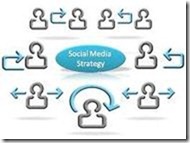
Recognizing its importance is not enough to make social strategy a reality
Social media marketing has gained its place at the table. eMarketer estimates 80% of companies with at least 100 employees will use social networks for marketing this year, up from nearly three in four last year. By 2012, usage will be even greater, and, in turn, efforts are becoming more sophisticated.
Most companies now recognize a well crafted social media strategy is a vital part of the marketing mix. In fact, a study from Jive Software and Penn, Schoen & Berland found 78% of executives thought a social business strategy was somewhat or very important to the future success of their business.

Despite this realization, most executives are still only in the tentative stages of making social strategy a priority.
The survey of executives who have final say or significant input on social business strategy found that only 27% listed social business as a top strategic priority. Nearly half (47%) admitted a social plan was necessary but not a strategic priority and 19% said social business strategy was simply not necessary.

Meanwhile, executives were also not overly optimistic about their current social strategy efforts. Only 17% felt their social strategy was ahead of the curve. About four in 10 (42%) felt their social strategy was just keeping up and 33% felt they were behind.
A different study from Forbes Insights and Coremetrics showed a similar amount of enthusiasm for social strategy. Only 11% of US and UK executives surveyed at large businesses listed social media strategy as a leading priority in 2011—tied for last place with mobile marketing. Social media strategy will receive a small boost in 2012, though, with 19% of execs listing it as a leading marketing priority for the coming year.

Many companies may be using social media marketing, but those that choose not to focus on a social strategy risk falling behind the curve in integrating social media with their overall marketing goals. Recognizing the importance of strategy alone isn’t enough; companies should start implementing a plan.
-
NBN to cost at least $60 a month
 Households will pay at least $60 – and up to $190 – a month for internet services on the National Broadband Network, data from an internet provider shows.
Households will pay at least $60 – and up to $190 – a month for internet services on the National Broadband Network, data from an internet provider shows.The first retail pricing for services over the $36 billion NBN were released by internet provider Internode on Thursday.
Packages start at $59.95 a month for a basic 12-megabit-per-second (Mbps) service with a 30-gigabyte quota for downloads and uploads, The Australian newspaper reported on Friday.
At the top end, Internode said it would charge $189.95 a month for a 100Mbps service with a 1000GB download quota.
Internode blamed the high prices on ‘existing flaws in the NBN Co wholesale charging model’ and warned that regional customers could have to pay more to connect to the network.
Telstra, the commonwealth and the builder NBN Co signed definitive agreements for the rollout of the $35.9 billion scheme in June.
NBN Co plans to provide a fibre-optic cable network to 93 per cent of the population while the remaining seven per cent will have either fixed wireless or satellite broadband over the next decade.
-
Govt to consider new Facebook law
 The federal government says education, rather than legislation, is the best way to protect children using Facebook and other social media.
The federal government says education, rather than legislation, is the best way to protect children using Facebook and other social media.But the government has agreed to look at proposals being prepared by South Australia, including tighter age limits on use of the social media and giving parents more rights to access their children’s Facebook accounts.
The SA government will prepare a discussion paper on the issue after raising its concerns at a meeting of state and federal attorneys-general in Adelaide on Friday.
Federal Justice Minister Brendan O’Connor said the government was loath to legislate where legislation was not going to work.
‘I think education is the key,’ he said.
‘We need to make sure young people are informed about the potential risks.
‘The cyber world is a magnificent place, it’s a fantastic educational tool, it’s a fantastic place for people to engage socially.
‘But the internet is not a benign playground. There are potential threats to young people in particular.’
South Australian Attorney-General John Rau said Australia was going through a revolution in the way people consumed and generated information.
‘That is a technologically driven change that is way ahead of the legal system and probably the thinking of most governments around the world and certainly in this country,’ he said.
‘We are grappling with changes that are moving more quickly than most people would have thought possible only a few years ago.’
SA’s proposals are likely to include a provision to raise the age for Facebook users and to also require the site to seek proof of age.
They will also consider allowing greater parental access.
Facebook currently requires users to be aged at least 13, but there is no requirement to provide proof of age.
A SA mother found recently that her teenage daughter had uploaded inappropriate pictures of herself to her Facebook page but the mother was prevented by Facebook from removing them.
Mr Rau said that case highlighted the concerns of many parents, while Mr O’Connor said more needed to be done to educate and inform young people of the dangers associated with posting material online.
‘People need to think carefully about what they upload, what they put onto their Facebook and social websites,’ he said.
-
Harry Potter website adds Google magic
 Author JK Rowling’s website devoted to fictional wizard Harry Potter will feature a bit of Google magic when it debuts later this year in the United States, according to the internet titan.
Author JK Rowling’s website devoted to fictional wizard Harry Potter will feature a bit of Google magic when it debuts later this year in the United States, according to the internet titan.Rowling’s beloved Potter titles will be available on Google eBooks platform at Pottermore.com and Google Checkout will be the preferred payment system, according to Larissa Fontaine of Google Books new business development.
‘When you buy a Harry Potter e-book from Pottermore, you will be able to choose to keep it in your Google Books library in-the-cloud, as well as on other e-reading platforms,’ Fontaine said on Wednesday in a blog post.
The Pottermore team reportedly plans to use Google-owned video sharing service YouTube for online broadcasts.
‘Pottermore and Google are teaming up to integrate Pottermore with a number of Google products,’ Fontaine said. ‘Stay tuned for more Pottermore and Google wizardry on the web.’
In June, Rowling unveiled an interactive website featuring new material about the boy wizard’s world, while his adventures will also now be sold as e-books for the first time.
The free website, www.pottermore.com, will go live from July 31 for one million Potter fans who pass a special online challenge, and to the general public from October.
The seven e-books will be available through the website from October in partnership with Sony.
Rowling said Potter fans will be able to register on the free website using one of the young sorcerers from the books as their online identity, then play games and interact with elements of the fictional world.
The site will also have previously unpublished material that she has written on the backgrounds to the characters and their lives at Hogwarts Academy, a fictional school for young wizards.
The author laid down her pen – and Harry’s magic wand – when she finished the seventh book in 2007, with a stunning record of 400 million copies of the series sold around the world.
-
Software to end ‘naked’ US airport scans
 In the face of an outcry over so-called ‘naked’ body scans at airports, US authorities have announced plans for a new scanning system that eliminates ‘passenger-specific images’.
In the face of an outcry over so-called ‘naked’ body scans at airports, US authorities have announced plans for a new scanning system that eliminates ‘passenger-specific images’.Transportation Security Administration administrator John Pistole said the agency would begin installing new software on its scanners ‘designed to enhance privacy’.
The new software ‘will auto-detect items that could pose a potential threat using a generic outline of a person for all passengers,’ the agency said on Wednesday.
‘By eliminating the image of an actual passenger and replacing it with a generic outline of a person, passengers are able to view the same outline that the TSA officer sees,’ a TSA statement said.
‘Further, a separate TSA officer will no longer be required to view the image in a remotely located viewing room.’
The news comes after protests and lawsuits over the use of so-called ‘naked’ scanners that take full-body X-ray images that show passengers’ genitals. In cases where people refuse such scans, TSA agents manually pat down passengers.
The TSA says the scanners protect fliers following the foiled 2009 Christmas Day plot to down a US jet by a Nigerian traveller who concealed explosives in his underwear.
Critics say the devices and the pat downs are invasive and demeaning.
US President Barack Obama last year said he understood ‘frustrations’ over the measures and had asked the TSA to ‘constantly refine and measure whether what we’re doing is the only way to assure the American people’s safety’.
Story source: www.bigpond.com
-
In-stream Online Video Boosts Brand Recall
 Pre-, mid- and post-roll best video ads for brand marketers
Pre-, mid- and post-roll best video ads for brand marketersInteractive marketers can’t help but look to online video to take advantage of branding potential richer than that for previous online display ad formats. But like its static display counterpart, banner ads, online video advertising can appear in numerous ad sizes, placements and creative types, making it difficult for marketers to decide where to start.
Research from Yahoo! indicates certain video ad units are better at boosting advertiser and brand recall than others, providing marketers a tentative roadmap for increased online video advertising success.
In Yahoo!’s study, video viewers recalled seeing pre-, mid- and post-roll ads more often than any other display ad type. More than half (53%) of respondents who recalled seeing some advertising remembered viewing these in-stream ads.

However, the pervasiveness of an ad unit type can still have a large influence on recall. For example, 35% of viewers were able to recall seeing static banner ads, one of the most common display ad types. In contrast, only 13% of viewers remembered seeing seemingly more eye-catching video banner ads.
This seems counterintuitive when comparing the dynamic nature of video to static creative. But users are much more commonly exposed to standard banner ads than online video banner ads; users can hardly recall ads they rarely or never see.
The concept of exposure influencing recall is also echoed in the fact that in-stream units like pre-roll ads—the most recalled ad unit types—are also the most used video units by US marketers, according to Break Media.
Viewers not only remember seeing these in-stream units, they also recall the ads’ subjects. Almost half (47%) of respondents said they remembered the brand or product advertised after viewing a pre-, mid- or post-roll video ad. This is not surprising given the often mandatory—and interruptive—viewing nature of these units.

Worth noting is the ability of expandable video banners and pop-up video ads to prompt user action: 39% of respondents reportedly acted after viewing an expandable video ad, compared to only 20% of pre-, mid- and post-roll video ad viewers.
Expandable and pop-up video ads were also more likely to aid users in purchase decisions than any other display ad type. Such findings hint at the potential use of these video ad units for direct response-related campaign objectives.
As the industry continues to mature and new formats undoubtedly emerge, video advertisers will be presented with new ways to engage viewers and enhance their brands. For now, brand marketers are best served leveraging the use of in-stream video ads and investing in the creation of professional, branded content to boost brand recall.
-
Hackers target Sun newspaper
 Computer hackers have targeted The Sun website with visitors being redirected to a hoax story about Rupert Murdoch’s suicide.
Computer hackers have targeted The Sun website with visitors being redirected to a hoax story about Rupert Murdoch’s suicide.The group LulzSec, which has previously targeted companies including Sony, says it carried out the hijack, via messages on Twitter.
Internet users trying to access thesun.co.uk were redirected to new-times.co.uk and a story entitled ‘Media mogul’s body discovered’.
It suggested that Murdoch had been found after he had ‘ingested a large quantity of palladium’.
After that site stopped working, The Sun address was re-directing to LulzSec’s Twitter account, which claimed to be displaying ‘hacked internal Sun staff data’ in one entry.
A News International spokeswoman confirmed the company was ‘aware’ of what was happening, but made no further comment.
LulzSec is a group of hackers that has claimed responsibility for various high-profile computer attacks on bodies including FBI partner organisations, the CIA, the US Senate and a pornography website.
In the UK it also carried out a distributed denial of service attack – where large numbers of computers overload a target with web requests – on the Serious and Organised Crime Agency website.
The group’s name comes from the word lulz, which is online slang for laughter at someone else’s expense. Their logo is a cartoon man in a top hat and monocle, holding a glass of wine.
-
Mobile ownership expected to rise
 It is predicted that in five years everyone will own a mobile phone and half of these will be smartphones.
It is predicted that in five years everyone will own a mobile phone and half of these will be smartphones.The head of Ericsson’s mobile infrastructure group says global mobile penetration will reach 100 per cent by 2016.
Australia is leading the way, with active SIM cards ownership making 115 per cent of the population.
The Australian Bureau of Statistics recorded that 31 per cent of children owned a mobile phone in 2009 and AIMIA found 40 per cent of smartphone users were over the age of 40.
-
Shoppers Willing to Connect With Retailers on Facebook
 Internet users follow retailers for more than just deals and discounts
Internet users follow retailers for more than just deals and discountsSocial commerce may be on the minds of retailers everywhere, but buying through Facebook is still far from mainstream. But it is hard to say whether shoppers are being restricted by the lack of “f-commerce” opportunities on Facebook, or whether retailers are hesitant to experiment before seeing a strong level of interest.
Software provider Ability Commerce found that 79% of the Internet Retail Top 500 retailers have Facebook pages, yet only 12% offer apps or widgets that enable ecommerce transactions on the social network. Meanwhile, according to a joint study by Shop.org, comScore and Social Shopping Labs, more than half (53%) of Facebook users have reached a retailer’s website from its Facebook page, and 35% of online shoppers said they would be likely to make a purchase through Facebook.
Facebook has become the social media venue of choice among online buyers. Compete discovered that the number of online buyers using retailers’ Facebook pages increased 3 percentage points over the previous year, bumping blogs, forums and review sites to second place. Additionally, a third of respondents “like” six or more retailers or consumer products companies on Facebook.

The prospect of finding out about sales and promotions is a big lure. Over 56% of those surveyed by Compete visited retailers’ Facebook pages for this purpose, while 58% in the Shop.org study, which included Twitter and a company’s blog in the figure, cited deals as a primary motivation. Learning more about a retailer and keeping up to date on products were also important.
According to Compete, more than 20% of online buyers found Facebook pages “influential” or “extremely influential,” regardless of the channel where the transaction is completed. The numbers show promise for a less established retail offering.

A PowerReviews and e-tailing group survey discovered that more familiar online tools, such as customer reviews, Q&As and forums, beat Facebook for their effect on buying behavior, yet the popular site still fared better than mobile or Twitter.

Taken with Compete’s findings, this implies that Facebook is being used by online shoppers more than ever and is continuing to grow in popularity, but has yet to surpass more ubiquitous online community tools in direct influence on purchasing.
Retailers and consumer products companies could give the small but eager group currently connecting with them on Facebook what they are looking for: access to sales. Even if these online shoppers are not yet able to make purchases directly through Facebook, exclusive offers can engender goodwill, loyalty, sharing and increase the likelihood of taking the “f-commerce” leap when it is offered.
-
May 2011 Australian Online Video Rankings
comScore today released a report on the online video market in Australia from its comScore Video Metrix service. The report showed that more than 10.7 million Australian Internet users watched online video in May, with viewers averaging more than 10 hours of total viewing time during the month. YouTube delivered video to more than 8.6 million viewers in Australia during the month, reaching 3 out of every 5 online users at an average of 70 videos per viewer.
Top 10 Video Properties by Videos Viewed
Australian Internet users watched nearly 1.2 billion total videos in May, with Google Sites ranking as the top video property with 613 million videos, representing 52.3 percent of all videos viewed online. YouTube accounted for the vast majority of videos viewed at the Google Sites property. Microsoft Sites ranked second with 35.6 million videos, or 3.0 percent of all online videos viewed. Facebook.com ranked third with 16.9 million videos (1.4 percent), followed by VEVO with 16.4 million videos (also 1.4 percent) and Yahoo! Sites with 15.6 million videos (1.3 percent).
Top 10 Video Properties by Viewers
Nearly 10.8 million viewers watched an average of 108.8 videos per viewer during May. Google Sites attracted nearly 8.7 million unique viewers during the month (70.7 videos per viewer), followed by Microsoft Sites with 3.3 million viewers (10.7 videos per viewer) and Facebook.com with 2.9 million viewers (5.9 videos per viewer).
Top News Sites by Total Videos Viewed
An analysis at video viewing occurring on News/Information sites found that viewers watched an average of 46.6 minutes of video in the category during May, with 17 percent of the entire online audience viewing video on News/Information sites during the month. Based on total videos viewed, Australian Broadcasting Corporation led as the top destination with nearly 5.5 million videos viewed on the site in May. Australian Broadcasting Corporation also saw the highest average minutes per viewer of the top 5 destinations at 66.6 minutes per viewer during the month.
Yahoo! News Network ranked as the second largest News/Information video destination based on total videos viewed with nearly 1.5 million videos watched on the site in May, followed by News.com.au Sites with 1.46 million videos. CNN Network and HPMG News rounded out the top five with viewers watching a total of 1.38 million videos and 714,000 videos, respectively.
-
Consumers Embrace Social Media for Brand Feedback

But still more likely to address complaints to brands more directly
Many social network users are using channels such as Twitter and Facebook to discuss shopping decisions and experiences with their peers. Although often this means they are using social networks as another channel to hunt down the best deals, consumers are also turning to those sites to provide feedback about their experiences with brands.
ROI Research conducted a study that asked social network users why they discuss products and services on social network sites. The majority of respondents said that when discussing products and services, they are comparing prices and talking about sales and specials with their social network friends and followers. Fifty-three percent of the surveyed social network users said they provide feedback to the brand or retailer via social network sites—and 47% said they express disappointment with the brand when they see fit.

The ROI Research study points out that consumers voice complaints about certain verticals more so than others. Survey respondents listed household products, telecommunications and healthcare and pharma as top categories for expressing dissatisfaction on a social network. Sports-related brands, magazines and newspapers, and alcoholic beverages, on the other hand, received low levels of complaints. The travel industry ranked fairly low on the list—which may come as a surprise given the resources that many travel companies have devoted to responding to consumer feedback on Twitter.
A MarketTools survey focusing on customer satisfaction with US airline carriers indicates that although US travelers may be embracing social networks to express feedback more frequently than in the past, social media as a feedback or customer service channel is still nascent.
Many travelers are using social networks to let their friends and followers in on their travel woes. In fact, the MarketTools survey indicates one out of 10 US travelers has used social media to complain about an airline. Because the complaints are undirected though, they often go unanswered. The survey shows that only one out of four consumers who complained via social media got a response back from an airline.
Although travelers are voicing dissatisfaction to their friends via social media, few travelers actually use sites such as Twitter and Facebook to give direct negative feedback to airlines. Only 2% of travelers who had given feedback or complaints about airline service in the past year said they had done so via social media. Most travelers reached out to the airline customer service department through the website, email or phone.

Both studies demonstrate that while collecting and responding to feedback over social networks may be a new phenomenon for brands, there is room for growth. Listening and responding to complaints on social media also offers brands a chance to connect with customers in an additional channel, and to potentially increase customer satisfaction.
-
New Zealand Females Spend Significantly More Time Social Networking than Males
 Comscore today released a study on Internet usage in New Zealand from its comScore Media Metrix service. The study found that Social Networking ranks as the leading online activity in New Zealand, accounting for 1 of every 5 minutes spent online in May. The study also found that females spent more time on social networking sites (5.4 hours per month) than males (3.7 hours per month).
Comscore today released a study on Internet usage in New Zealand from its comScore Media Metrix service. The study found that Social Networking ranks as the leading online activity in New Zealand, accounting for 1 of every 5 minutes spent online in May. The study also found that females spent more time on social networking sites (5.4 hours per month) than males (3.7 hours per month). “As one of the more mature markets in the Asia Pacific region, New Zealand is home to a digitally savvy audience base,” said Amy Weinberger, comScore vice president for Australia and New Zealand. “New Zealanders have a strong propensity to connect online, whether it is to other people through social networking or to content and information through access points such as entertainment and news destinations. Finding ways to reach and engage these audiences presents significant marketing opportunities to both local and global brands.”
Top Web Properties in New Zealand
In May 2011, Microsoft Sites topped the list as the most-visited web property in New Zealand, reaching 97 percent of web users age 15 and older in the country. Google Sites ranked second reaching 93.5 percent of visitors, followed by Yahoo! Sites at #3 reaching 86.4 percent of users. Facebook.com saw the strongest engagement of the top 10 properties with visitors averaging more than 5 hours on the site during the month. Web properties based in New Zealand or Australia captured the next three positions in the ranking with Fairfax Media, APN News & Media and Trade Me all reaching more than half of the online population in New Zealand.
Social Networking Accounts for Most Online Minutes in New Zealand
When looking at how New Zealanders spent their time online in May, Social Networking led as the most engaging online activity accounting for 21.1 percent of all online minutes in the country. Portals followed in second at 14.3 percent of total minutes, with Entertainment sites ranking third at 12.1 percent of minutes. Rounding out the top 5 were the News/Information (6.8 percent of time spent) and Auctions (6.7 percent) categories.
Females More Prolific Social Networkers than Males in New Zealand
Further analysis of the Social Networking category showed that although males and females account for nearly the same percentage of visitors to the category, females exhibit far stronger engagement with the category. Overall, females averaged nearly 50 percent more time on Social Networking sites than males (5.4 hours vs. 3.7 hours). Females age 15-24 averaged the most time social networking at 7.4 hours per visitor, while males age 15-24 averaged 6.4 hours during the month. When compared to an average Internet user, females were 15 percent more likely to view pages on social networking destinations (Index of 115), while males were 16 percent less likely to consume pages (Index of 84).
-
Blogs influencing sales
 A poll of Australians by blogging network, Nuffnang, has found that almost 90 per cent of respondants are swayed by blogger reviews.
A poll of Australians by blogging network, Nuffnang, has found that almost 90 per cent of respondants are swayed by blogger reviews.While blogging is still relatively new in Australia, Nuffnang says it has seen an explosion of new bloggers in the last three years.
“It was no surprise to find out that 89 per cent of respondents are swayed by a blogger’s review of a product or service and want to go on to try it for themselves,” said David Krupp, Nuffnang’s country manager.
“This demonstrates the power of blogs for Australian brands’ marketing campaigns,” he said.
The survey found:
- 89 per cent are swayed by a blogger’s review of a product or service and would like to try it for themselves;
- 89 per cent make the purchasing decisions in their household and of these, 87 per cent have learnt about a new product or service via a blog;
- 81 per cent are noticing banner advertisements displayed next to the blogs they read;
- 90 per cent pass on blog information to family and friends;
- 92 per cent have used a search engine to find out more about a brand after reading about it on a blog post;
- 90 per cent are loyal to a brand once they find one they like;
- 65 per cent have entered a competition through a blog in the past 12 months;
- 78 per cent of respondents agree blogs are a better source of information than traditional and mainstream media; and
- 64 per cent of bloggers are between 18 to 34 years old.
“As the industry matures, we’ll see blogging become a mainstream medium as we’ve seen in other markets.
“Many bloggers start a blog for self satisfaction but quickly evolve this vision, hoping to become an expert or publicly recognised,” Krupp said.
SOURCE: Inside Retail Online – www.insideretail.com.au/IR/IRNews/Blogs-influencing-sales-1575.aspx
-
Smartphone usage on the rise
 Whether in bed, on the loo, in a business meeting or during a first date, a new survey suggests no place or moment is sacred when it comes to using a smartphone.
Whether in bed, on the loo, in a business meeting or during a first date, a new survey suggests no place or moment is sacred when it comes to using a smartphone.Forty-six per cent of Australian mobile phone users are now using smartphones, up from 31 per cent in 2010, according to a survey released by Telstra on Monday.
The number is set to climb to 60 per cent in the next 12 months, and nowhere it seems is off bounds when it comes to hopping online.
‘It’s clear smartphones are becoming an inseparable part of our lives, with Telstra’s research indicating they now help us to shop smarter, connect with our social networks and kill boredom during business meetings,’ Telstra consumer executive director Rebekah O’Flaherty said in a statement on Monday.
Four in 10 of the users surveyed say they have used their smartphone when trying to avoid a social encounter, with one in four using the gadgets during business meetings.
Home was the most popular place to access the net on phones, with 86 per cent surveyed saying they had done so.
Trains, buses and ferries came in next at 59 per cent, with 56 per cent saying they had accessed the net in bed, 33 per cent while on the toilet and 11 per cent on a date.
Smartphones are also catching up to PC usage in some areas, with one in four people surveyed saying they visited social networking sites such as Facebook more on their mobiles.
‘While men love to visit app stores and browse news and sports sites, women prefer to spend their time connecting with friends with half saying they check social network sites daily – compared with just a third of men,’ Ms O’Flaherty said.
More people are also going online when shopping, with 47 per cent using their phones to find information about a product.
‘It’s also clear we love our apps,’ she said.
‘Almost one in four smartphone web-surfers have downloaded more than 20 free apps.
‘Social network apps and games are rated most useful, followed by weather, transport, maps, banking and health-related apps.’
The survey, conducted by Nielsen, surveyed 2827 people aged 16 and over from across Australia.
-
Maintaining Engagement on Large Facebook Pages
 Boosting ‘likes’ and comments a balancing act as fan base grows
Boosting ‘likes’ and comments a balancing act as fan base growsMarch 2011 research from link-sharing solutions provider Visibli found that among Facebook pages with at least 100,000 “likes,” engagement dropped as the number of fans increased. Each individual post by brands and media organizations received fewer “likes” as a proportion of the page’s fan base.
Similar data from social media engagement firm LoudDoor shows a more complex picture of how page size affects “likes” and comments per post. “Likes” increased with page size, except among pages with 2.5 million to 5 million users. On a per-user basis, “likes” began to decrease for pages with more than 100,000 fans, then rose again for pages with 1 million to 2.5 million followers. Larger pages had fewer “likes” per post per user, but the decrease did not correspond directly with page size.

Similarly, the number of comments per post increased with page fan base, with a few drops among pages with several million followers. The proportion of comments per user does go down with closer correlation to page size, but for both metrics there is a large drop-off when pages hit the 2.5 million fan mark.

Some of this effect could be difficult to avoid. Posts may still receive hundreds of comments, but the number of comments per user will inevitably be much lower when pages have millions of fans.
LoudDoor also noted that brands must be aware of the algorithms Facebook uses in determining which posts to present to which users in the newsfeed. The EdgeRank algorithm takes into account affinity with the content creator along with other factors. If page growth means that fans are becoming less similar to each other as more are added, and have less affinity for the brand, new posts may not even show up in their newsfeed—meaning they will never have the chance to engage with the brand there.
-
Security holes found in iPhones, iPad
 A new security hole has opened up in Apple’s iPhone, iPad and iPod Touch devices, raising alarms about the susceptibility of some of the world’s hottest tech gadgets to hacker attacks.
A new security hole has opened up in Apple’s iPhone, iPad and iPod Touch devices, raising alarms about the susceptibility of some of the world’s hottest tech gadgets to hacker attacks.Flaws in the software running those devices came to light after a German security agency warned that criminals could use them to steal confidential data off the devices.
Apple, the world’s largest technology company by market value, said on Thursday that it is working on a fix that will be distributed in an upcoming software upgrade.
With the security hole, an attacker can get malicious software onto a device by tricking its owner into clicking an infected PDF file.
Germany’s Federal Office for Information Security called the flaws ‘critical weaknesses’ in Apple’s iOS operating system.
Internet-connected mobile devices are still subject to fewer attacks than personal computer, but they could eventually prove a juicy target for hackers because they are warehouses of confidential banking, email, calendar, contact and other data.
Software vulnerabilities are discovered all the time. What makes the latest discovery alarming is that the weaknesses are already being actively exploited – albeit in a consensual way.
The latest concerns were prompted by the emergence of a new version of a program to allow Apple devices to run any software and circumvent the restrictions that Apple notoriously retains over software distributed through its online store.
There are security risks of doing so, but many people find it liberating to install their own software.
Although this program is something people would seek out, the weaknesses that its authors discovered could easily be used for malice, security experts say.
There is an irony in the controversy: The site distributing the program offers a fix for the problem, but to get the fix, a user has to first install the program in question. So a user must defy Apple’s restrictions to get the protection until Apple comes up with a fix of its own.
Charlie Miller, a prominent hacker of Apple products, said it likely took months to develop the program to break Apple’s restrictions, but a criminal might need only a day or two to modify it for nefarious purposes.
Apple spokeswoman Bethan Lloyd said Thursday the company is ‘aware of this reported issue and developing a fix.’ She would not say when the update will be available.
One reason for gadget owners to take heart: Attacks on smartphones and other internet gadgets are still relatively rare. One reason is PC-based attacks are still highly lucrative.
Still, vulnerabilities such as the ones Apple is confronting show that consumers should take care of securing their mobile devices as they would their home computer.
‘These things are computers – they’re just small, portable computers that happen to have a phone tacked onto them,’ said Marc Fossi, manager of research and development for Symantec Security Response.
‘You’ve got to treat them more like a computer than a phone. You have to be aware of what’s going on with these devices.’
-
Social Network Comments Fuel Offline Behaviour
 Comments on social sites about brands and products are encouraging users to take action
Comments on social sites about brands and products are encouraging users to take actionSocial networks are becoming a part of everyday life for many users, and their offline habits are affected by their participation.
In November 2010, the Pew Internet & American Life Project surveyed US social network users for the “Social Network Sites and Our Lives” report, released in June 2011, and found that 31% of social network users are on Facebook several times a day. Additionally, 21% of respondents use the site about once a day. This is followed by Twitter, which 20% of social network users check several times a day and 13% use about once a day.
As consumers use these social sites several times a day or week, they are also commenting on posts from friends just as often. The Pew study found that 26% of female Facebook users and 17% of male Facebook users comment on Facebook posts at least once a day. Further, the study found that 57% of female Facebook users and 48% of male Facebook users comment on posts at least once a week.

But social network users are not just responding on social media. The April 2011 “S-Net: The Impact of Social Media” study by ROI Research found that 60% of US social network users were at least somewhat likely to take action when a friend posted something about a product, service, company or brand on a social media site. Only 18% were not at all likely to take action.
The study doesn’t elaborate on what exactly respondents would do, but another question asked specifically what actions US social network users would be more likely to take after following a company or product on Facebook or Twitter. On Facebook, 53% of respondents said the top activities would be purchasing the brand or company’s product and recommending the company or product. For Twitter, the top activities were talking about the company or product (61%), recommending the company or product (59%) and purchasing the brand or company’s product (58%).

Fans or followers of a brand are influenced by what they see from these company accounts, but they are also influenced by what their friends say about brands or companies that they don’t necessarily follow. It’s another area for marketers to focus on—the reach they have and how their brand fans may influence their own friends and followers.
-
Twitter users send 200mn tweets a day
 Twitter users are sending 200 million tweets a day, up from 65 million a year ago, the micro-blogging service says.
Twitter users are sending 200 million tweets a day, up from 65 million a year ago, the micro-blogging service says.‘For context on the speed of Twitter’s growth, in January of 2009, users sent two million tweets a day,’ Twitter said in a blog post on Thursday.
The San Francisco-based Twitter was founded in 2006. It has more than 200 million users.
According to a recent study by the Pew Research Center, 13 per cent of the online US adults aged 18 and older use Twitter, up from eight per cent in November 2010.
-
News Corp. sells ailing Myspace for $35 million
 News Corp. has sold Myspace for a fraction of its purchase price, bringing the curtain down on Rupert Murdoch’s tie-up with a one-time social networking star that ended up being eclipsed by Facebook.
News Corp. has sold Myspace for a fraction of its purchase price, bringing the curtain down on Rupert Murdoch’s tie-up with a one-time social networking star that ended up being eclipsed by Facebook.Myspace, which was bought by News Corp. in 2005 for $580 million, was bought by Specific Media, a digital ad-targeting platform, which said financial terms were confidential.
The News Corp.-owned technology blog All Things Digital put the purchase price at $35 million, however, and said the deal includes slashing about half of Myspace’s staff of between 400 and 500 people.
"Myspace is a recognized leader that has pioneered the social media space," Tim Vanderhook, chief executive of Irvine, California-based Specific Media said in a statement.
"The company has transformed the ways in which audiences discover, consume and engage with content online," Vanderhook said. "We look forward to combining our platforms to drive the next generation of digital innovation."
Vanderhook said News. Corp. would take a minority equity stake in Specific Media as part of the deal. According to All Things Digital, News Corp. will retain a five to 10 percent stake in Myspace.
Myspace, which was launched in 2003, was the leading social networking site on the Internet when it was bought by News Corp. six years ago but it has been losing members to Facebook for years.
According to tracking firm comScore, Myspace had 21.8 million unique monthly US visitors in August 2005 to Facebook’s 8.3 million.
Facebook surpassed Myspace in the number of US visitors in May 2009 and has just kept adding users since then while Myspace’s membership eroded, according to comScore.
In May, Facebook had 157.2 million unique monthly US visitors compared to Myspace’s 34.9 million, comScore said. Facebook, which was launched in 2004, has nearly 700 million members worldwide.
Myspace chief executive Mike Jones, in a memo to company employees obtained by Silicon Valley technology blogs, said he would leave Myspace in two months after helping Specific Media with the transition.
"While I regret we won’t be working together at Myspace any longer, I am very proud of the work we have done here and believe we have performed with excellence — even under extremely difficult circumstances," Jones said.
Myspace has gone through a series of layoffs, chief executives and makeovers in recent years as News Corp. sought to cut losses at the site and reverse the decline in membership.
As its popularity waned, Myspace has been seeking to reinvent itself recently as a destination for music fans.
Lee Brenner, a former Myspace employee, said Wednesday in a blog post that Myspace’s slide was probably the result of a number of factors.
"I’m sure most employees (former or current) will argue that it was poor management, or a need to hit revenue targets once News Corp. took over, or a bottleneck in the technology department, or lack of resources given to their division, or a poor public relations effort, etc., that set the course of MySpace’s downfall," Brenner said.
"It is most likely a combination of these factors, along with a ‘low attention span’ public," said Brenner, writing at a site he co-founded called Hypervocal.
"It probably didn’t help to be doing business, and trying to grow, along with all of these issues, in the midst of a global economic crisis," said Brenner, who was Myspace’s executive producer of political programming from 2007 to 2009.
News Corp. chief operating officer Chase Carey put Myspace on notice in November saying the losses at the social network were "unsustainable" and the news and entertainment giant formally put Myspace up for sale in January.
News Corp. was reportedly seeking $100 million for the site.
According to the News Corp.-owned Wall Street Journal there were two leading bidders for Myspace — Specific Media, the eventual buyer, and private equity firm Golden Gate Capital.
News Corp. does not break out results for Myspace in its earnings but the "other" segment, which includes the social network, reported a second quarter operating loss of $156 million, $31 million wider than a year earlier.
News Corp. shares gained 1.25 percent on Wall Street on Wednesday to close at $17.39.
Source: AFP
-
Google goes social with Facebook rival
 Google, the king of internet search but not on the social front, has launched its rival to Facebook, a social networking service called Google+.
Google, the king of internet search but not on the social front, has launched its rival to Facebook, a social networking service called Google+."Online sharing is awkward. Even broken. And we aim to fix it," Google’s senior vice president for engineering Vic Gundotra on Tuesday said in a blog post about the long-awaited social networking initiative from the internet giant.
Unveiling Google+, Gundotra stressed the ability it gives users to separate online friends and family into different "Circles," or networks, and to share information only with members of a particular circle.
"We’d like to bring the nuance and richness of real-life sharing to software," he said.
"We want to make Google better by including you, your relationships and your interests."
One of the criticisms of Facebook is that updates are shared with all of one’s friends unless a user has gone through a relatively complicated process to create separate Facebook Groups.
"Not all relationships are created equal," Gundotra said.
"So in life we share one thing with college buddies, another with parents, and almost nothing with our boss.
"The problem is that today’s online services turn friendship into fast food – wrapping everyone in ‘friend’ paper – and sharing really suffers," he said.
Google+, located at plus.google.com, is currently being tested by a small number of people or is available by invitation only.
But Google said in a message on the site that it "won’t be long before the Google+ project is ready for everyone".
Google unveiled several new tools integrated into Google+, including "Hangouts", which allows for video chatting among friends, "Mobile" for location-sharing and "Huddle" for group text messaging.
Photos and video can be uploaded and shared among Circles using a feature known as "Instant Upload", while an online sharing engine called "Sparks" delivers content from the web into a user’s feed.
Google dominates internet search but the Mountain View, California, company has failed to make inroads on the social networking front, where Facebook has accumulated nearly 700 million users and Twitter about 200 million.
Former Google chief executive Eric Schmidt, speaking at the AllThingsD technology conference last month, took responsibility for the company missing the wave when it came to making services social, saying "I screwed up".
Google’s last major foray into social networking – Google Buzz, launched in February 2010 – spawned a slew of privacy complaints and led to a slap on the wrist from the US Federal Trade Commission.
Under a settlement between the US regulator and Google announced in March, Google is required to implement a comprehensive privacy program and will be subject to independent privacy audits every two years for the next 20 years.
Google+ makes its debut as Google and Facebook wage a fierce battle over online advertising dollars and how people navigate the internet.
Google does not send people to Facebook and vice versa, and both companies are seeking to become the chief gateway to the internet.
In May, Facebook was left red-faced after acknowledging it had hired a prominent public relations firm to draw attention to privacy practices at Google.
Danny Sullivan, editor-in-chief of technology blog SearchEngineLand.com, said in a blog post it was "anyone’s guess" as to whether Google+ would be successful.
"If you’re happy using Facebook, there seems relatively little to make you want to switch over to Google Plus, at the moment," said Sullivan, who received an early glimpse of the new service from Google.
"Perhaps if there are people who want a Facebook alternative, Google’s now got a core to build on for them."
Story by Chris Lefkow www.ninemsn.com.au
-
Social Media Marketing Brings New Revenues, Customers
 Social networks continue to prove their worth as a marketing channel
Social networks continue to prove their worth as a marketing channelSocial media marketing has been top of mind among marketers and is becoming a worldwide phenomenon. Earlier this year, eMarketer estimated that worldwide social network ad revenues alone, not including money that companies spend developing presences on social networks or hiring staff to manage them, would reach $5.97 billion in 2011, a 71.6% increase over 2010.
Already, firms worldwide are seeing returns on their increased investment. According to a survey by office services firm Regus, 47% of businesses successfully used social networks for customer acquisition in 2011, a 7 percentage point increase over 2010. The US followed closely behind the average, at 43%.

China saw the greatest gains in customer acquisition from social networks among all countries studied, increasing from 44% in 2010 to 65% in 2011.
The survey had one other interesting finding: Social networks made the biggest impact for companies that are operating in developed markets. A significantly higher percentage of companies that used social networks for customer acquisition in developed markets, including the US, the UK, Japan and Canada, saw a revenue increase over the previous year vs. those companies that did not use social networks to acquire new business in developed markets.

Companies in developing markets like China, Mexico and South Africa experienced revenue growth whether or not they were using social networks to acquire new business, probably as a result of rapid overall economic expansion.
As companies continue to chase revenue in both developed and developing markets, competition will force marketers to increase investment in new platforms to reach customers. Social networks are proving to be a reliable source of customer acquisition and increased revenues in both, but can provide a necessary edge over competitors in developed markets.
-
1 in 3 Parents of Teens Snoop on Facebook
One in three (34%) of parents of children age 13-19 have used Facebook to learn more about the parents of their children’s friends, according to data from Retrevo. This makes parents of teens the most likely of all parents of children younger than 20 to snoop on Facebook in this way, followed by parents of children age 6-12 (29%) and children age 0-5 (25%).
Almost Half of Parents Have Snooped by Time Kids Hit Teens
By the time children are teenagers, Retrevo data shows 47% of parents say they have used Facebook to learn about their kid’s friends. However, once kids reach age 20 and typically become more independent, parents seem to lose interest in learning more about their kids’ friends through Facebook (18%).
iPhone Parents Most Likely to Facebook Snoop on Kids’ Dates
Overall, 12% of parents have used Facebook to check out who their kids date. Retrevo found that iPhone owning parents (20%) are almost twice as likely to use Facebook to learn more about who their kids date than the average parent, while Droid parents are one-third less likely (8%). Retrevo also found that dads are 30% more likely to use Facebook to learn more about their kid’s dates(13%) as opposed to moms (10%).
iPhone Parents Have Most Facebook Friends
Generally speaking, iPhone parents have more friends than overall parents or Droid parents. Retrevo found that 13% of iPhone-owning parents had more than 500 Facebook friends as opposed to only 8% of all parents and 10% of Droid parents. Similarly, iPhone parents had a much higher percentage of reporting 50-250 friends (55%) than overall (40%) or Droid (38%) parents.
Only 5% of iPhone parents reported fewer than 50 Facebook friends, about one-quarter the rate of overall (18%) or Droid (20%) parents.
iPhone Parents Most Addicted to SocNets
Retrevo found that 14% of all parents feel nervous or anxious if they don’t check Facebook and/or Twitter, and this number more than doubles when looking at iPhone-owning parents (28%), but is basically the same for Droid-owning parents (15%).
iPhone parents are also almost twice as likely (28%) as overall parents (16%) to sometimes neglect responsibilities because they are on Facebook/Twitter, and about one-and-a-half times as likely (18% compared to 11%) to say they have given up activities they used to enjoy because of time spent on Facebook and Twitter.
Interestingly, while Droid parents had similar responses to overall parents for the previous two questions, both iPhone (19%) and Droid (18%) parents are about 50% more likely than overall parents (12%) to admit they feel like they couldn’t stop using Facebook/Twitter, even if they wanted to.
Pew: SocNet Users Age
Recent Pew data shows a gradual aging of social network users, which may reflect increased usage by consumers of parenting age. Between 2008 and 2010, the percentage of social network users age 23-35 dropped 20%, from 40% to 32%. Meanwhile, the percentage of users age 36-49 rose 18%, from 22% to 26%. Most significantly, the percentage of users age 50-65 more than doubled, from 9% to 20%.
In total, 52% of social network users in 2010 were 36 and up, a 58% increase from 33% in 2008. -
SocNet Users Get Older
 The average age of social network users rose between 2008 and 2010, according to data from the Pew Research Center Internet & American Life Project. For example, the percentage of social network users age 18-22 fell 43%, from 28% to 16%.
The average age of social network users rose between 2008 and 2010, according to data from the Pew Research Center Internet & American Life Project. For example, the percentage of social network users age 18-22 fell 43%, from 28% to 16%.Percentage of SocNet Users 36 and Up Rises
In addition, the percentage of social network users age 23-35 dropped 20%, from 40% to 32%. Meanwhile, the percentage of users age 36-49 rose 18%, from 22% to 26%. Most significantly, the percentage of users age 50-65 more than doubled, from 9% to 20%.
In total, 52% of social network users in 2010 were 36 and up, a 58% increase from 33% in 2008.
Frequency of Use Varies with Site
There is considerable variance in the way people use various social networking sites. For example, 52% of Facebook users and 33% of Twitter users engage with the platform daily, while only 7% of MySpace and 6% of LinkedIn users do the same.
On Facebook on an average day, 15% of Facebook users update their own status, 22% comment on another’s post or status, 20% comment on another user’s photos, 26% “Like” another user’s content, and 10% send another user a private message.
Facebook Users Have More Close Relationships
The average American has just more than two discussion confidants (2.16); that is, people with whom they discuss important matters. Controlling for other factors, Pew found that someone who uses Facebook several times per day averages 9% more close, core ties in their overall social network compared with other internet users.
Facebook Users Get More Social Support
Pew looked at how much total support, emotional support, companionship and instrumental aid adults receive. On a scale of 100, the average American scored 75 on a scale of total support, 75 on emotional support (such as receiving advice), 76 in companionship (such as having people to spend time with), and 75 in instrumental aid (such as having someone to help if they are sick in bed).
Internet users in general score three points higher in total support, six points higher in companionship, and four points higher in instrumental support. A Facebook user who uses the site multiple times per day tends to score an additional five points higher in total support, five points higher in emotional support, and five points higher in companionship, than internet users of similar demographic characteristics. For Facebook users, the additional boost is equivalent to about half the total support that the average American receives as a result of being married or cohabitating with a partner.
ROIResearch: LinkedIn Seen as Most Important SocNet
While Facebook has the highest engagement rate of the “big five” social networks (Facebook, LinkedIn, MySpace, Twitter, YouTube), the highest percentage of online consumers think having a LinkedIn account is important, according to an April 2011 study from ROI Research and Performics. Data from “S-Net: A Study in Social Media Usage and Behaviour” indicates 59% of online consumers rate having a LinkedIn account 4 or 5 on a five-point importance scale, compared to 53% giving this level of importance to having a Facebook account.
About the Data: Pew conducted a survey of 2,225 social network users on landline and cell phone from October 20 – November 28, 2010.
-
Obama launches technology initiative
 US President Barack Obama has launched an initiative to develop new manufacturing jobs, in a move that will see more than 500 million dollars invested in advanced technologies.
US President Barack Obama has launched an initiative to develop new manufacturing jobs, in a move that will see more than 500 million dollars invested in advanced technologies.The initiative will team up government, companies and universities and aims to speed the development of a new generation of American-made high-technology products.
The program will leverage existing federal funds and future deferral departmental budgets to invest in domestic manufacturing capabilities deemed critical to US national security.
-
Microsoft Kinect has record sales
 Microsoft is racking up the records with its motion sensing gaming device – the ‘Kinect’
Microsoft is racking up the records with its motion sensing gaming device – the ‘Kinect’Released late last year, it has already entered the Guinness Book of World Records as the fastest-selling consumer device of all time.
Kinect is a controller-free gaming system that competes with the Nintendo Wii and Playstation 3 Move.
It has been selling at an impressive rate since it launched in November.
-
Internet providers unsure on NBN
 There was plenty of smiling and hand-shaking as Telstra and the government put pen to paper on an $11 billion deal – seen as one of the last major hurdles on the road to a National Broadband Network.
There was plenty of smiling and hand-shaking as Telstra and the government put pen to paper on an $11 billion deal – seen as one of the last major hurdles on the road to a National Broadband Network.But as the government celebrates – Internet service providers around the country are sifting through the documents to work out what the deal means for them.
-
Google ‘faces major US antitrust probe’
 The US Federal Trade Commission (FTC) is poised to open a formal antitrust probe into whether internet search giant Google has abused its dominance on the web, The Wall Street Journal reports.
The US Federal Trade Commission (FTC) is poised to open a formal antitrust probe into whether internet search giant Google has abused its dominance on the web, The Wall Street Journal reports.The newspaper, citing ‘people familiar with the matter,’ said the FTC is preparing to serve Google with civil subpoenas ‘signalling the start of a wide-ranging, formal antitrust investigation’.
The Journal said the five-member commission will send Google the formal demands for information ‘within days’ and other companies were likely to receive requests for information about their dealings with Google.
The FTC declined to comment on the report and there was no immediate response to a request for comment from the Mountain View, California-based Google.
Google, which controls around 65 per cent of the lucrative US internet search market, has been the target of numerous antitrust investigations by the FTC and the US Department of Justice in recent years.
But the Journal said the FTC’s probe ‘is the most serious to date’ in the United States because it will examine ‘fundamental issues relating to Google’s core search advertising business’.
Google makes most of its money from search-related advertising.
The Journal said the probe will look at whether Google ‘unfairly channels users to its own growing network of services at the expense of rivals’.
European Union competition watchdogs opened an investigation into similar allegations in November.
Google has faced increasing scrutiny from US and European regulators as it has grown over the years from a scrappy startup into an internet powerhouse.
In April, the US Justice Department approved Google’s entry into the online travel sector with its $US700 million ($A665 million) purchase of flight data firm ITA Software but it insisted on a number of concessions from Google.
Several online travel sites, including Expedia, Kayak and Travelocity, had sought to block the Google-ITA deal, claiming it would give Google too much control over the lucrative online travel market and lead to higher prices.
In late March, the FTC reached a settlement with Google over Google Buzz, the social networking tool rolled out last year which spawned a slew of privacy complaints.
Under the settlement announced by the US regulator, Google is required to implement a comprehensive privacy program and will be subject to independent privacy audits every two years for the next 20 years.
Also in March, a US judge dealt a setback to Google’s plans for a vast digital library and online bookstore, rejecting a copyright settlement hammered out by the internet giant with authors and publishers.
In 2008, Google abandoned a plan to forge a joint search advertising partnership with Yahoo!, citing a desire to avert a ‘protracted legal battle’ with US regulators.
-
Men savvier online networkers
 Men are leading the way when it comes to forging professional connections online, a new study has found.
Men are leading the way when it comes to forging professional connections online, a new study has found.LinkedIn, a professional web-based networking site, studied the details of men and women across a range of industries and looked at the ratio of their online connections.
Of their two million Australian users, they found that men tend to have more online connections than women.
However, there were particular professions and organisations where females dominated the online environment.
These industries included writing and editing, philanthropy and marketing and advertising.
At RailCorp, Origin Energy and Leighton Contractors women also ruled the web.
The top industries where blokes dominated were in the military, capital markets, human resources and newspapers.
Males were also found to be savvier at Queensland Health, Flight Centre and the University of NSW.
Career coach Sally-Anne Blanshard encouraged females to hop online.
‘We are in a world where we are time-short, have technology at our fingertips and have ever-increasing demands outside of work,’ Ms Blanshard said in a statement.
‘I think face-to-face networking definitely still has its place, but I stress to my clients, especially female clients, to build up their networks online.’
-
Telstra signs $11b NBN agreement
 Telstra Corporation Ltd has confirmed it has reached agreement with the federal government to progressively disconnect its copper network and participate in the rollout of the national broadband network (NBN).
Telstra Corporation Ltd has confirmed it has reached agreement with the federal government to progressively disconnect its copper network and participate in the rollout of the national broadband network (NBN).Telstra says the agreement will deliver approximately $11 billion in replacement revenue through disconnection payments, and new revenues through payments for access to its infrastructure.
There will be no upfront payment, but rather payments over many years, it said.
AAP.
-
ICANN to allow new domain names
 The online community has been rattled by a decision by Internet Corporation for Assigned Numbers and Names (ICANN) to allow new domain names to be launched next year.
The online community has been rattled by a decision by Internet Corporation for Assigned Numbers and Names (ICANN) to allow new domain names to be launched next year.The changes will allow up to 1000 new web variations at a price of $185,000.
This new move will significantly expand the existing regime, although the changes have been limited to .com, .net and .org websites.
These changes are anticipated to allow companies to register unique website names or better protect their existing brands.
-
World’s fastest 3G hotspot launched
 The world’s fastest 3G hotspot has been launched in Australia by Telstra.
The world’s fastest 3G hotspot has been launched in Australia by Telstra.The battery-powered device is capable of sharing mobile broadband connectivity with up to five devices simultaneously.
Warwick Bray, Executive Director of Telstra Mobile Products said a surge in laptop, tablet and smartphone ownership meant Australians need fast mobile broadband connectivity on the go.
‘However, managing separate mobile broadband accounts for each gadget can be a hassle,’ he said.
The device is the world’s first commercial battery-powered hotspot to use advanced dual channel HSPA+ technology, promising to make fast, reliable network connection easier for technophiles on the go.
-
Twitter Users Want Businesses to Answer Them
 Companies that answer questions more attractive to users
Companies that answer questions more attractive to usersSocial sites like Quora are designed specifically as question-and-answer venues where users can get expert help, but Twitter often serves as an informal tool for the same purpose. Users might ask their followers for advice, ask the world what a particular trending topic means, or hope for customer service help from a brand.
According to May 2011 research from InboxQ, a service to feed businesses questions from Twitter, Twitter users—especially ones with more followers and thus, presumably, more experience—tend to ask questions with tweets directed at all followers rather than using @ replies or direct messages. This means questions are often not directed at a relevant brand, but many users want brands to answer them anyway.
Eight in 10 Twitter users surveyed worldwide said they thought the answers businesses posted on Twitter were at least as trustworthy as those from regular people, and about six in 10 said they wanted businesses to respond to them on the microblogging service.

Yet just 21% of Twitter users with under 100 followers and 41% of users with over 100 followers said they had actually received a response from a business via Twitter.
Users indicated that more responsive brands would benefit from greater loyalty and purchasing. Almost 60% of respondents said they would be more likely to follow a brand that answered them, and 64% said they would be more likely to make a purchase from that brand.

InboxQ may have an interest in getting businesses to pay attention to questions posted to Twitter, but this research meshes with an already robust body of data about the kinds of interactions many social media users hope to have with brands. Consumers often indicate that they understand and accept the value exchange of connecting with companies in return for information that can help them. And they also often want brands to pay attention to them and not take their business for granted now that they have access to the powerful voice social media provides.
-
More Brand Fans Say They’re Loyal Followers
 Social media friends and followers still say they’re more likely to buy
Social media friends and followers still say they’re more likely to buyEarly research on becoming a fan of brands on Facebook or a follower on Twitter indicated that social media users with brand connections were more loyal and more likely to say they would buy the brand’s products than average. Over the past year, those kinds of connections have become more common, and many brands have grown their fan pages and Twitter followings significantly.
Longitudinal data from ROI Research suggests that growth has not diluted the power of social media connections, which still have a link with customer loyalty.
In 2010, 32% of US social network users told the research firm they were at least somewhat more loyal to brands they were fans of on Facebook. This year, that percentage ticked up slightly, to 34%.

Similarly, 40% of respondents in 2010 said they were more loyal to brands they followed on Twitter, rising to 46% this year. There was also a significant drop in the number of users who disagreed with that claim, from 21% to 13%.

At least half of Twitter and Facebook users said they had become more likely to talk about, recommend or purchase a company’s products after they began following the company on social media. And Twitter users showed a greater level of engagement than Facebook users across all these metrics, as well as in willingness to link to an ad for the product or attend a sponsored event.
Still, many users might want less communication from brands. More than 40% of social network users told ROI Research that brands should communicate with fans only once or twice a month, and another 26% thought weekly communication was sufficient. Only 10% of respondents wanted to hear from brands at least daily.
-
Consumers More Likely to Express Satisfaction via SocNet
Despite common industry wisdom that consumers are much more likely to publicize negative experiences, consumers express satisfaction on social networks more frequently than disappointment, according to an April 2011 study from ROI Research and Performics. Data from “S-Net: A Study in Social Media Usage and Behavior” indicates in the case of restaurants, 60% of online consumers use social networking sites to express satisfaction about a purchase, brand or retailer.
This makes restaurants the vertical most likely to receive good publicity via social network. Other verticals with 50% or more of online consumers saying they use social networks to express satisfaction are food brands and household products (53% each) and telecommunications (50%).
Household Products Most Likely to Get Disappointing SocNet Comments
In addition to being the vertical fourth-most-likely to receive positive social network comments from consumers, household products are also most likely to receive negative social network comments. However, only 29% of online consumers say they use social networks to express disappointment in household products.
Interestingly, both the telecommunications (28%) and restaurant (25%) verticals are also among the most likely to receive disappointing social network comments from consumers.
Consumers Most Interested in Education, Sports Points
In terms of offers to win online points that can be redeemed for products or prizes via social networks, consumer interest currently appears tepid. No vertical has more than 50% of online consumers expressing interest in winning points via social network. Education (47%), sports-related (44%) and electronics (43%) are the leading verticals in this area.
Coupons Draw More Interest than Points
When it comes to printable coupons obtained from social networks, online consumers show a bit more interest. Fifty-six percent are interested in receiving printable coupons from educational brands, while 52% are interested in receiving printable coupons from sports-related brands. Interest in printable coupons from brands in the restaurant (49%), auto, electronics and food (48% for each vertical) verticals was also higher than interest in points from any vertical.
Almost Half of Online Consumers Likely to Post Product Content
Other study results show that a combined 49% of online consumers are extremely (5%), very (10%) or somewhat (34%) likely to post interesting or relevant content about a product/service, company or brand such as sale announcements, coupons, new product announcements, interesting videos, etc. on social networking sites.
Interestingly, a combined 60% of online consumers are extremely (5%), very (13%) or somewhat (42%) likely to take action when a friend posts this type of social network content.
About the Data: In April 2011, ROI Research and Performics conducted an online survey of 2,997 consumers age 13 and older who access at least one social network regularly.
-
Older Facebook Users Catching On to ‘Liking’ Brands
Users ages 55 and up increasingly likely to connect with companies
It took older web users a few years to begin social networking after it had been popularized by the younger set, but they soon became the fastest-growing segment of users on sites like Facebook. Now it appears they are also growing into a specific social media habit that had been more popular among younger adults: connecting with brands.
As recently as September 2010, based on research from Wedbush Securities, it seemed as if Facebook engagement with brands just might not interest users over age 55. At that point, only about one in four of Facebook’s oldest users had “liked” a brand on the site, compared with 60% of those ages 18 to 34.
By November 2010, over-55s had begun to close the gap, however, and by April 2011, nearly half were connecting with brands. Engagement had also risen among 18- to 34-year-olds as well as the 35-to-54 age group over the period. Overall, 59% of adult Facebook users had “liked” a brand as of April, up from 47% the previous September. Uptake among the oldest users appears to have been a major factor in this rise.

Increased engagement among older boomers and seniors suggests that Facebook users of all ages have some interest in connecting with brand pages, rather than appealing only to young adults. Since most older Facebook users still have not “liked” a brand, there could still be room to grow in this demographic. The climbing level of activity among the middle age group indicates that younger boomers could have just as much potential social engagement with brands as millennials and Gen Xers.
Typically, social media users report connecting with brands to get deals and discounts, as well as information about products and special offers. But what brand fans expect can vary. For example, affluent social media users tended to follow brands because of a preexisting affinity for them, and a desire to be kept informed. Many older users will fall into this group, due to the point they have reached in their careers and their longer opportunity to build up net worth.
-
McDonald’s denounces racist twitter hoax
 McDonald’s has found itself in serious damage control after the circulation of a discriminative image on the internet.
McDonald’s has found itself in serious damage control after the circulation of a discriminative image on the internet.The photograph appeared on Twitter on the weekend and shows a hoax sign that was allegedly posted on a McDonald’s staff notice board.
The sign says an insurance measure due in part to a recent string of robberies African American customers are now required to pay an additional fee of $1.50 per transaction.
McDonald’s have posted a tweet on their Twitter account denouncing the hoax.
-
Telstra broadband plan ‘illusion’ – ACCC
 Telstra’s original broadband proposal was an ‘illusion’ that could never have worked, the boss of the national competition watchdog says.
Telstra’s original broadband proposal was an ‘illusion’ that could never have worked, the boss of the national competition watchdog says.Australian Competition and Consumer Commission (ACCC) chairman Graeme Samuel said Telstra’s proposal for a fibre-to-the-node (FTTN) broadband network, or fibre to the street corner, was never going to work.
‘I can now summarise that 2006 proposal which Telstra unilaterally abandoned midway through talks with us as an illusion,’ he said in his last appearance as ACCC chairman at the National Press Club in Canberra on Wednesday.
‘It was an illusion on cost and on the capacity to truly deliver high-speed broadband to end users.’
In 2005, Telstra planned to upgrade its ageing copper network with a FTTN network but dropped the proposal following ‘an impasse’ with the ACCC a year later.
Debate during the past two years gave the nation an opportunity to create a more competitive communications sector, Mr Samuel said.
The federal government is in the early stages of building a $35.9 billion fibre-to-the-premises (FTTP) national broadband network, through NBN Co, to serve 93 per cent of Australians.
The NBN would replace Telstra’s ADSL and ADSL2 copper network with optical fibres.
‘That foundation is based on getting the industry structural settings right and ensuring the regulatory settings in the transition to the NBN deliver to improve competition in the short term as well,’ he said.
‘Over coming months, the ACCC will be responsible for assessing key proposed undertakings for both Telstra and NBN Co on the way forward.
‘The challenge for the ACCC is to ensure that we play our role in setting in concrete lasting foundations for vigorous telecommunications competition in concrete, not in quicksand.’
-
Telstra and NBN Co deal
 A $9 billion deal between Telstra and NBN Co on delivery of the national broadband network is being delayed by speculation over Australia’s political future.
A $9 billion deal between Telstra and NBN Co on delivery of the national broadband network is being delayed by speculation over Australia’s political future.The Australian Financial Review reports that NBN Co. and Telstra have drawn up a series of ‘wipeout clauses’ in the event the $36 billion project is cancelled or scaled back if there is a change of government.
The scenarios include Telstra bidding to buy back the fibre-optic network from the government.
The deal under negotiation would give NBN access to Telstra infrastructure and Telstra’s customers moved to NBN Co.
-
Facebook ‘sorry’ for face tagging launch
 Facebook has apologised for the way it rolled out new software that automatically recognises users’ faces without informing them.
Facebook has apologised for the way it rolled out new software that automatically recognises users’ faces without informing them. The social networking website admitted it should have done more to notify members about the global launch of the system.
The new feature scans uploaded photographs and attempts to match faces to images already stored on the site.
It then suggests the name of a friend to assign, or ‘tag’, to the photo.
Although users have the option to switch it off, many complained that they were not explicitly asked if they wanted it activated.
Facebook said that the system was intended to speed up the process of tagging.
It was introduced in the US in December 2010 but has only now been launched globally.
In a statement, the company headed by Mark Zuckerberg said it ‘should have been more clear with people during the roll-out process when this became available to them.’
Facebook said it has been contacted by regulators and was responding to their inquiries to ‘satisfy any concerns they will have’.
It added that the facial recognition technology would only be applied to newly-uploaded photos.
Users can disable the feature by turning off the ‘suggest photos of me to friends’ option on their privacy settings.
Graham Cluley, senior consultant at security firm Sophos, said that users’ annoyance was less about the product’s purpose than the manner in which it was made live.
In his blog, he writes: ‘We simply had to wait until Facebook decided to roll it out to our account. Now might be a good time to check your Facebook privacy settings.’
He added that the actual tagging is still done only by friends, but Facebook appeared to be pushing friends to tag each other.
Face-recognition technology is just the latest Facebook product that has sparked privacy concerns.
Facebook Places, a location-based service, was launched last year, broadcasting information about users’ whereabouts unless they specifically changed their privacy settings.
At the end of last year, Facebook admitted an ‘inadvertent privacy breach’, confirming that some of its most popular applications had transmitted identifying information, such as user names, to advertising and internet-tracking companies.
The admission followed a Wall Street Journal investigation which uncovered evidence that some popular Facebook apps had shared user data with internet tracking organisations.
The breach affected tens of millions of users, including those who had set their profiles to the most secure and robust privacy settings.
Facebook insisted the breach did not expose any private user information and is still working with developers to improve the system.
-
LinkedIn Seen as Most Important SocNet
 While Facebook has the highest engagement rate of the “big five” social networks (Facebook, LinkedIn, MySpace, Twitter, YouTube), the highest percentage of online consumers think having a LinkedIn account is important, according to an April 2011 study from ROI Research and Performics. Data from “S-Net: A Study in Social Media Usage and Behavior” indicates 59% of online consumers rate having a LinkedIn account 4 or 5 on a five-point importance scale, compared to 53% giving this level of importance to having a Facebook account.
While Facebook has the highest engagement rate of the “big five” social networks (Facebook, LinkedIn, MySpace, Twitter, YouTube), the highest percentage of online consumers think having a LinkedIn account is important, according to an April 2011 study from ROI Research and Performics. Data from “S-Net: A Study in Social Media Usage and Behavior” indicates 59% of online consumers rate having a LinkedIn account 4 or 5 on a five-point importance scale, compared to 53% giving this level of importance to having a Facebook account.Twitter, YouTube Also Beat Facebook
Twitter (58%) and YouTube (55%) also had a higher percentage of online consumers ranking them as important. Interestingly, although MySpace is widely regarded as having lost significant importance to consumers in the last several years, its importance percentage tied Facebook’s (53%).
LinkedIn Jumps in Importance Since 2010
In 2010, only 41% of online consumers gave LinkedIn a four- or five-point importance rating, meaning this figure has grown 44% in one year. Twitter has grown 45% in this rating, from 40% to 58%. MySpace appears to be rebounding in perceived importance, as 39% of online consumers in 2010 but 53% in 2011 giving it a four- or five-point rating, a 36% increase.
Meanwhile, the percentage of consumers rating Facebook as important dropped 5% year-over-year, from 56% to 53%.
Facebook Dominates Engagement
 When it comes to engagement, Facebook is the unquestioned leader. Ninety-seven percent of online consumers visit Facebook at least weekly and 70% visit at least daily. These figures are close to double those of LinkedIn in terms of weekly visitation (50%) 3.5 times higher in terms of daily visitation (20%).
When it comes to engagement, Facebook is the unquestioned leader. Ninety-seven percent of online consumers visit Facebook at least weekly and 70% visit at least daily. These figures are close to double those of LinkedIn in terms of weekly visitation (50%) 3.5 times higher in terms of daily visitation (20%).The only other social network with a visitation rate even close to one of Facebook’s is YouTube, with 86% of online consumers visiting at least once a week (11% lower rate).
LinkedIn, MySpace Visit Frequency Declines
Although both LinkedIn and MySpace saw significant improvement in the percentage of online consumers considering them important, both saw their visit frequency decline from 2010. In 2010, 67% of online consumers visited LinkedIn at least weekly, a figure that dropped 25%. Daily visits dropped 10%, from 22% to 20%.
Meanwhile, the percentage of online consumers visiting MySpace at least weekly dropped 41%, from 76% to 45%, and the percentage visiting at least daily dropped 44%, from 41% to 23%. Twitter’s daily visitation rate stayed flat at 44% but its weekly visitation rate declined 14%, from 81% to 70%.
Visitation figures for Facebook and YouTube underwent minimal changes.
Facebook Surges in 2010
Social networking category leader Facebook continued its momentum as it amassed millions of new users and people spent more and more of their time on the site during 2010, according to a February 2011 white paper from comScore. “The 2010 US Digital Year in Review” indicates that Facebook accounted for 10% of US page views in 2010, while three out of every 10 US internet sessions included a visit to the site.
Although MySpace maintained its hold on the number two ranking in the social networking category with 50 million visitors in December 2010, its audience declined 27% and total time spent on the site declined 50%.
LinkedIn emerged as the third-largest site in the category with 26.6 million visitors in December 2010 Meanwhile, number four Twitter climbed to 18% to 23.6 million visitors in December 2010 (not counting third-party app or mobile usage).
About the Data: In April 2011, ROI Research and Performics conducted an online survey of 2,997 consumers age 13 and older who access at least one social network regularly.
-
Facebook stirs privacy ire with facial recognition
 Facebook’s move to enable facial recognition across its entire social networking site is raising some eyebrows – and possibly some legal woes — over its privacy implications.
Facebook’s move to enable facial recognition across its entire social networking site is raising some eyebrows – and possibly some legal woes — over its privacy implications.On Tuesday, Facebook announced in a blog post that it was working to make it easier for uses to tag photos of their friends and family members. To do this, it has been quietly rolling out facial recognition technology to a test group across the world’s biggest social network since late last year.
That means Facebook‘s system will be able to recognize the faces of its 500 million to 600 million users worldwide. The company will be able to identify you simply by your face.
Facebook noted that starting in just a few weeks, its system will scan all photos posted to Facebook and will offer up the names of the people who appear in the frame. All of Facebook’s users are automatically being added to the database.
The facial recognition feature is automatically turned on. Users who don’t want the service must go in and manually opt out of it.
A day after the announcement was made, data protection regulators at the European Union said they will launch an investigation into it, according to the Bloomberg news service, which also reported that authorities in the U.K. and Ireland are looking into the matter.
"Tags of people on pictures should only happen based on people’s prior consent and it can’t be activated by default," said Gerard Lommel, a member of the EU’s Data Protection Working Party, according to Bloomberg. Such automatic tagging suggestions "can bear a lot of risks for users" and the European data-protection officials will "clarify to Facebook that this can’t happen like this."
Facebook did not respond to a request for comment.
However, Brad Shimmin, an analyst with Current Analysis, said it’s clear that Facebook hasn’t learned any big lessons from its previous privacy brouhahas.
"Facebook’s repeated methodology of opting all users into new services, particularly services with potentially damaging ramifications, demonstrates a certain disregard for the security and privacy of its users," Shimmin said. "When applied broadly, it can undermine our overall privacy — perhaps putting an end to anonymity altogether. With the proliferation of cameras and the major role they play in Facebook, wherever you go, you may be identified and catalogued for future reference."
Over the past year or so, Facebook has found itself in the center of several firestorms related to privacy issues.
Just last fall, it was revealed that some of Facebook’s most popular applications, such as FarmVille, Texas HoldEm Poker and FrontierVille, had been sending users’ personal information to dozens of advertising and Internet monitoring companies. According to a Wall Street Journal investigation, the issue affected tens of millions of users, even those who had set their privacy settings to the strictest levels.
Earlier last year, Facebook was criticized after the company unveiled tools that would allow the sharing of user information with other Web sites. That move caused an uproar among users and prompted a handful of U.S. senators to send an open letter calling on Facebook to amend its privacy policies.
"You’d think that they would have learned something from the past pounding they’ve taken on privacy issues, but it doesn’t look like they have," said Dan Olds, an analyst with The Gabriel Consulting Group. "This is pretty creepy … Let’s say some guy sees an attractive woman, he can snap a quick picture of her with his cellphone camera and then search Facebook to see who she is."
Olds added that people should quickly move to opt out of the feature but he’s concerned that most users won’t take the issue seriously enough.
But for those who want to turn the feature off, security company Sophos offers some how-tos:
- First, go to your Facebook "Account" in the upper right-hand corner of the page. Then click on "Privacy Settings."
- Next, click on "Customize settings."
- Then go to "Things others share."
- Beside the option titled "Suggest photos of me to friends. When photos look like me, suggest my name," click "Edit Settings."
- Click on "Edit settings."
- Then change it to "Disabled."
- Don’t forget to press "Okay."
Not everyone is concerned about Facebook’s facial recognition feature, though.
Rob Enderle, an analyst with the Enderle Group, said the technology is out there whether Facebook uses it or not. "If Facebook doesn’t do this someone else likely will," he said. "Remember [Facebook isn’t] making private things public with this. They are making public things easier to find."
Sharon Gaudin covers the Internet and Web 2.0, emerging technologies, and desktop and laptop chips for Computerworld. Follow Sharon on Twitter at
 @sgaudin or subscribe to Sharon’s RSS feed
@sgaudin or subscribe to Sharon’s RSS feed  . Her e-mail address is sgaudin@computerworld.com.
. Her e-mail address is sgaudin@computerworld.com. -
Apple fans, developers welcome iCloud
 Apple Inc took a big step toward getting people to store and access their data on the Internet as CEO Steve Jobs emerged from medical leave to present the iCloud music-streaming service.
Apple Inc took a big step toward getting people to store and access their data on the Internet as CEO Steve Jobs emerged from medical leave to present the iCloud music-streaming service.A thin Jobs walked out on Monday (June 6) to a standing ovation from the more than 5,000 Apple faithful at its Worldwide Developers’ Conference, outlining a service that could further untether users who rely on storing their data on home computers even as
they walk around with more and more mobile devices.
‘The vision that I heard presented this morning was so compelling and so unifying in terms of understanding how people use a combination of desktop and mobile devices that I really think that Apple has nailed it on the head,’ said developer Joe Wein.
Systems manager Dave Kaminsky was excited about the new developments but had some reservations about the cloud.
‘How do we keep our secure IP from going out to the cloud?’ he asked.
Developer Joe Pezzillo said the iCloud confirmed Apple’s commitment to the end users of its devices.
‘Right out of the gate, (it) is looking like it’s going to be extremely competitive with what other people are offering and should be a real boon for users. I mean, ultimately the thing that we saw to day is that Apple has recommitted itself, or continues to have its commitment toward end users and it’s trying to do the best possible things for them on all the different devices and now in the cloud,’ he said.
Jobs, a pancreatic cancer survivor whose decision to headline the event assuaged some concerns on Wall Street about his health, said nothing about his health, but strode onstage after James Brown’s seminal soul classic ‘I Got You (I Feel Good)’ blasted over the sound system.
‘We think this solution is our next big insight. Which is, we’re going to demote the PC and the Mac to just be a device, just like an iPhone, an iPad or an iPod Touch. And we’re going to move the digital hub, the center of your digital life, into the cloud. Because all these new devices have communications built into them, they can all talk to the cloud whenever they want,’ he said of the iCloud, which lets users play their music and get access to their data from any Apple device — a crucial capability for users increasingly accustomed to performing tasks on the move.
Jobs looked frail, but it didn’t worry the conference attendees.
‘Honestly, to me he looks the same as he looked last year and the year before. I hope his health is improving. But he’s a great speaker. I don’t know how much he’s involved in the day-to-day, but I love listening to him speak,’ said Kaminsky
‘I don’t think that he is letting his personal medical struggles get in the way of executing his vision, so I was very impressed by that as well,’ said Wein.
Monday was only the second appearance by Jobs in public on his company’s behalf since he went on medical leave in January. He shared the spotlight, letting his executive team showcase new features in Apple’s mobile and computer operating software, before returning to the stage to launch the iCloud.
Story source: www.bigpond.com
-
iPhone app helps women conceive
Forget Gen Y and Z – the new wave of kids are being called I-babies.
Women are now using phone applications to help them know when the best time is to conceive.
They are the new generation of iBabies, children born with the help of an application telling a couple the best time to conceive.
For just a few dollars, women can receive an alarm on their iPhone alerting them to their most fertile days of the month.
‘When we see couples who are trying to become pregnant we advise them to use the same tracking procedure and now it’s available on iPhone it’s great as it is convenient and not costly,’ said Dr Joel Bernstein, medical director of Fertility East.
‘All these trackers do is just work out the perfect time to have intercourse.’
Dr Bernstein it’s becoming common practice, because technology is so ingrained in our lifestyles.
-
How Social Shoppers Share Local Deals
 Social deal site users ages 25 to 44 share offers most
Social deal site users ages 25 to 44 share offers mostGrowth in daily deal site usage is still rapid, according to April 2011 site rankings from Compete. The analytics firm reported that visits to Groupon rose 5.4% over March and a dramatic 655.8% over the previous April to 24 million uniques. At the same time, competitor LivingSocial increased unique visitors by 32.7% month over month and 418.4% year over year.
These sites depend not only on consumers purchasing their highly discounted local deals, but also on consumers sharing them. And research from mobile Wi-Fi hotspot provider JiWire suggests many web users are doing both.
In a Q1 2011 survey of its Wi-Fi Media Channel users, JiWire found that 44% made a purchase from a social shopping deal site, such as Groupon or LivingSocial, at least once a month. That includes 14% who do so at least once a week. Fewer than one-third of mobile Wi-Fi users said they never used social deals sites.

Purchasing local deals was more frequent among users under age 45. Those ages 25 to 44 were most likely to purchase a deal overall.
Daily deal sites typically encourage users to pass along offers to friends and family via email or social media, to spread usage virally. The JiWire research indicates the pass-along value of such coupons is high, with more than six in 10 mobile-Wi-Fi-using respondents sharing local deals with their friends.

Those over 45 were least likely to share, but a majority still did so. Respondents ages 25 to 44 were most active in this aspect of local deals as well. In addition, women were slightly more likely to share than men.
Other research also shows that, while usage of social shopping sites is fairly robust among older internet users, millennials and Gen Xers are more likely to be users. Research firm Morpace found in February 2011 that 40.2% of 18- to 34-year-old online consumers used Groupon, compared with 34.1% of 35- to 54-year-olds and 23.2% of those 55 and over.
-
Online Coupons Reach Nearly Half of Web Users

88.2 million US adults will redeem an online coupon this year
A digital revolution in couponing coupled with the belt-tightening of the recession have combined to make coupons cool among more than just those clipping the Sunday circular. Digital coupon usage is now firmly a part of the online shopping experience of millions of US consumers.
eMarketer estimates that by the end of 2011, nearly half of US adult internet users, or 88.2 million people, will have redeemed an online coupon or code for use either online or offline in the past year. By 2013, 96.8 million adults will redeem an online coupon.
“Consumer brands are accustomed to promoting their products in stores and in newspaper inserts,” said Jeffrey Grau, eMarketer principal analyst and author of a forthcoming report on online couponing. “But as more shoppers make purchase decisions online before taking a shopping trip, brands are following them onto the internet.”

The growth rate for online coupon users is expected to gradually decline through 2013, as most online consumers predisposed to using digital coupons already do so.
Already, household usage of digital coupons has nearly doubled since 2005. Experian Simmons reported that 12% of households redeemed coupons from email or the web that year; it expects that figure to reach 22% in 2011.

“Today’s online coupon users tend to be affluent, highly educated and over the age of 55,” said Grau. “This is valuable input for marketers shaping the different elements of a promotional campaign, such as what products to promote with coupons, where to place the offers and what marketing messages to use.”
-
Incentives Motivate Moms to Refer Brands to Friends

Coupons and discounts among most popular
Whether it’s exchanging stories about shopping bargains, offering product reviews or sharing parenting advice, moms love to trade information and engage in online conversations about themselves and their families. But moms say they would be significantly more inclined to refer a brand or product to friends when offered an incentive. Marketers can boost engagement and motivate moms to spread word-of-mouth about products by providing coupons, discounts, deals and other tangible financial rewards.
lucid marketing reported in April that only 34% of moms surveyed in January 2011 said they regularly use tell-a-friend requests when asked by a business or website, while 63% do so occasionally. However, if offered an incentive, nearly 66% of moms said they would be more likely to refer a brand or website to others.

The mom segment is made up of vocal, tech-savvy, price-conscious consumers who are an important purchase influencer for families and more apt to use incentives than the average consumer. According to BabyCenter, smartphone-owning moms found coupons (55%) and ads that featured nearby deals (34%) to be among the most appealing. While general population smartphone owners also found coupons and local deals attractive, the percentages were smaller, at 37% and 29%, respectively.

Moms are highly engaged in brand conversations and are keen on finding bargains and additional ways to save. Incentives, including coupons, local deals, discounts and product samples, serve as a powerful marketing tool to drive moms to discuss and pass information about products on to their network of friends. With wide social circles and a high tendency to communicate and share ideas via word-of-mouth marketing, moms are extremely receptive to brand referrals and product recommendations from their peers.
-
New technology aids cancer detection
 A new cutting-edge technology that detects and diagnoses breast cancer has become available in the US.
A new cutting-edge technology that detects and diagnoses breast cancer has become available in the US.Breast-Specific Gamma Imaging (BSGI) can detect lesions that are so small, they don’t show up on a traditional mammogram, providing early detection and treatment.
BSGI requires the patient to be injected with a low-dose radioactive tracer. That tracer is absorbed into cancerous cells, which then light up on the image.
A mammogram detects about 85 percent of breast cancers in women, and doctors say BSGI could be more reliable in uncovering cancers that we wouldn’t see any other way.
The technology is also useful both for newly diagnosed patients and high-risk women who carry the breast-cancer gene BRCA.
-
Computer intelligence to equal humans
 Steve Wozniak, who co-founded Apple Computers, is convinced that within his lifetime he will see computer intelligence the equal of mankind.
Steve Wozniak, who co-founded Apple Computers, is convinced that within his lifetime he will see computer intelligence the equal of mankind.That’s the future according to one of the smartest geeks on the planet, Steve Wozniak, who co-founded Apple Computers and is convinced that in his lifetime he will see computer intelligence equal that of humans.
The Woz is to the technological world what The Fonz was to leather jackets and denim, and when he talks, the global industry listens.
As technology explodes, humans are not going to be needed so much in the future and will settle back into a life of ease, Mr Wozniak told a business congress on the Gold Coast on Friday.
‘We’re already creating the superior beings, I think we lost the battle to the machines long ago,’ he said.
‘We’re going to become the pets, the dogs of the house.’
He said all of a sudden, true artificial intelligence will creep up on mankind like an accident.
‘Every time we create new technology we’re creating stuff to do the work we used to do and we’re making ourselves less meaningful, less relevant.
‘Why are we going to need ourselves so much in the future? We’re just going to have the easy life,’ he said.
Mr Wozniak said Singularity, where a machine seems like a human being and has feelings, can think and be motivated, seemed an impossible dream to him years ago.
When he started Apple, he said, he never thought a computer would be powerful enough to hold an entire song and today we can fit 50 movies on a little disc in an iPhone.
‘You don’t realise it’s happened until it’s there and I think that awareness of machines is getting very, very close and we’re getting close to where a machine will really understand you,’ Mr Wozniak said.
‘My comment about the machines winning the war is partly a joke, but we’ve accidentally already put so much in place that we can’t get rid of from our lives.
‘Once we have machines doing our high-level thinking, there’s so little need for ourselves and you can’t ever undo it – you can never turn them off.’
Now if they could just get my new Apple IPhone 4 to work properly, I would be more than happy, at the moment my feelings for this new phone are at their lowest. A very over rated device and I’m so sorry I switched my IPhone 3.
-
Google search tracks down assault victim
 A Google search has helped tracked down an Australian girl US police believe was one of many young victims of alleged child predator Stephen Vosilla.
A Google search has helped tracked down an Australian girl US police believe was one of many young victims of alleged child predator Stephen Vosilla.US Authorities recognised a logo on a video of one of Vosilla’s victims and logged on to the internet search engine, Google, tapped in the logo, and within seconds he was able to identify the logo was Australian and the young victim was likely from Australia.
Officers tracked the girl down in Australia, who then provided a statement for Tennessee investigators.
An investigation was launched that led investigators to Vosilla’s residence in Talbott, Tennessee,
A grand jury in Tennessee has indicted Vosilla on two counts of especially aggravated sexual exploitation of a minor and four counts of sexual exploitation of a minor. He remains in Tennessee’s Hamblen County jail in lieu of $US100,000 bail.
-
Online shops opportunity for retailers
 Australian retailers should be more imaginative if they want to dominate the online shopping landscape like their international counterparts, Sue Morphet says.
Australian retailers should be more imaginative if they want to dominate the online shopping landscape like their international counterparts, Sue Morphet says.The Pacific Brands chief executive officer told a Brisbane business lunch on Thursday that online shopping was both a threat and an opportunity.
It’s just a matter of attitude, she said.
Comercial survival was in the hands of Australian retailers who had to embrace the online world, she said.
Ms Morphet said seven of the top 10 online retailers in the US were also bricks and mortar stores and it was a similar story in the UK.
‘In the US stores like Walmart, Staples, Sears and Best Buy and in the UK Tesco, Marks and Spencer are in the top 10 online stores,’ Ms Morphet said.
‘In Australia we don’t have any bricks and mortar retail stores in the top 10 online stores, none at all – we have eBay, Amazon, Deals Direct,’ she said.
‘Many of the successful online retailers can continue to have their bricks and mortar presence… but we need to understand this whole phenomena and move with it.
‘People shop for experiences not just for purchasing goods.’
She contrasted the success of boutique bookstores with the failure of other major book retailers as the industry faces an online squeeze.
‘The ones that do more than just price will be the ones that succeed,’ she said.
‘What we are seeing now is a consumer who shops on price or on quality, they will shop for the number one brand or the price point offer.
‘In order for us to justify the value of our brands our product has to be innovative, it has to have high quality and be very engaging in the needs, wants and emotions of the shopping public.’
Ms Morphet said recent calls for online stores to pay GST was unhelpful and energy should be focused on thinking of clever ways to appeal to customers.
‘Where the recommendation to buy used to come from traditional advertising or the sales person in the store, now it’s coming from social networks,’ she said.
‘Bonds has 60,000 Facebook fans.
‘Customers have always been able to go down the street and seek a better price … (but the) street is a whole lot longer and a whole lot easier to navigate.
‘We need to be frank, the problem is not the lack of a 10 per cent GST.
‘Retailers have to be offering excellent range, excellent value and excellent service, if you’re not doing that customers will go elsewhere and the internet as made it easier for them to do so.’
She says retailers need to think about how they pitch brands, use social networking marketing to communicate and satisfy customers.
Ms Morphet explained how innovative thinking saw a 1000 per cent increase for pillow sales when Pacific Brands launched its Tontine date-stamped pillows last year.
‘Innovation is what we need to redefine our categories,’ she said.
‘People have been buying white pillows for a hundred years … but this (result) was unbelievable,’ she said.
-
Legal action against Twitter
 An English local authority said on Sunday it had taken US micro-blogging site Twitter to court in California and forced it to release the details of a British user.
An English local authority said on Sunday it had taken US micro-blogging site Twitter to court in California and forced it to release the details of a British user.South Tyneside Council, in northeast England, took the legal action in a bid to discover the identity of a blogger behind allegedly libellous statements.
The blogger, known as ‘Mr Monkey’, has levelled a stream of criticism and allegations against councillors and council officers.
A council spokesman confirmed Twitter had released information after they took the case to the Superior Court of California.
‘Twitter have released information to our lawyers and this is currently being analysed by technical experts,’ the spokesman told AFP.
Twitter was not immediately available for comment but a spokesman told the BBC: ‘We cannot comment on any specific order or request.
‘As noted in our law enforcement guidelines, it is our policy to notify our users before disclosure of account information.’
The South Tyneside Council spokesman added: ‘This legal action was initiated by the council’s previous chief executive and has continued with the full support of the council’s current chief executive.
‘The council has a duty of care to protect its employees and as this blog contains damaging claims about council officers, legal action is being taken to identify those responsible.’
The latest controversy came a week after a Premier League footballer began proceedings against the website when a blogger identified him as the player who had taken out an injunction banning the media from exposing an alleged affair.
A Liberal Democrat MP later used his parliamentary privilege to name the player as Manchester United’s Ryan Giggs.
-
Technology give gamblers choice
 Pokies technology that allows players to choose whether or not to curb their spending is the best way to stop problem gambling, Victoria says.
Pokies technology that allows players to choose whether or not to curb their spending is the best way to stop problem gambling, Victoria says.Gaming ministers from around the country will meet in Canberra on Friday to discuss federal Labor’s plans to crack down on pokies, based on an agreement it made with independent MP Andrew Wilkie last year which helped it form a minority government.
One idea on the table is the introduction of a mandatory pre-commitment scheme, which would require patrons to nominate their maximum losses before they started gambling.
But Victorian Gaming Minister Michael O’Brien said that approach infringed on peoples individual rights.
He argued optional pre-commitment technology on every poker machine in the state, combined with the removal of ATMs from gaming venues from July 1 next year, made Victoria’s anti-gambling package tougher than the commonwealth’s.
‘We think we have a far more effective integrated package that will work, whereas the Wilkie deal is basically born of a quick political fix,’ Mr O’Brien told ABC Radio.
He vowed Victoria would not sign up to any reform plan today if it included mandatory pre-commitment technology.
Federal Families and Community Services Minister Jenny Macklin said she was pleased that at least there was consensus that pre-commitment technology was a useful tool.
‘That’s an important first step,’ she said.
But Victoria’s plan to keep the system purely voluntary wouldn’t be enough to stop problem gambling, Ms Macklin said.
That’s because even if someone uses the technology in the first instance, they can just take their pre-commitment card out of the machine and play on once they’ve reached their limit.
‘It’s not actually going to help the problem gambler,’ the minister said.
‘It’s like saying to people, ‘The seat belt is in your car but you don’t have to use it’.’
Ms Macklin said there were a number of anti-gambling strategies on the agenda for Friday’s meeting, such as pokies display warnings, club ATM restrictions and online betting.
‘We understand how important it is to act on a number of fronts,’ she said, adding there was still time for detailed consultations with the states on the issue.
The government has vowed to have the legislation ready by mid-next year, with Ms Macklin ‘hopeful’ all premiers and chief ministers will support it.
Labor will need the votes of key independents to have the draft laws passed in parliament, but Tony Windsor has already flagged his opposition to the scheme.
Ms Macklin said the government would keep talking with the crossbenchers and stressed how important it was to act on problem gambling.
-
Bosses peeking at candidates’ Facebook
 More than a third of bosses say they check potential employees’ Facebook profiles before offering them a job.
More than a third of bosses say they check potential employees’ Facebook profiles before offering them a job.Your potential new boss may have already checked you out on Facebook.
A new survey by recruitment firm Robert Half has found that more than a third of employers in accounting and finance admit to checking potential candidates’ Facebook profiles before offering them a job.
‘Given this reality, candidates need to be aware of their social media footprint’ when applying for jobs,’ Robert Half director Andrew Brushfield said, releasing the survey findings on Wednesday.
‘As a general rule of thumb, if there is anything online that employees don’t want their colleagues or bosses to see, they should remove it.’
The survey also found 23 per cent of employers are using social media to recruit, while a third of employees say they are comfortable being ‘friends’ with their boss on sites such as Facebook and LinkedIn.
Still, the survey also found 36 per cent of surveyed employees in the finance and accounting industry have seen the use of social networking sites damage other people’s workplace relationships.
‘While social media has helped foster a more interactive and sociable working environment, it is completely blurring the boundary between people’s personal and professional lives,’ Mr Brushfield said.
‘Before people friend’ their bosses, colleagues and clients, they need to think about the long-term implications it could have on their professional life and career development.’
The survey of 416 finance and accounting employees, and hiring managers, found only 38 per cent of companies had a clear social media policy in place for employees.
Forty-three per cent of companies that allow their staff to access social media sites at work either don’t have a clear social media policy in place, or don’t have a policy at all.
‘All organisations should have a clear social media policy to ensure that their staff use social media appropriately at work, and don’t damage the company’s corporate reputation,’ Mr Brushfield said.
Mr Brushfield offered a number of tips to workers and jobseekers to help manage their Facebook presence, such as ‘untagging’ themselves from an embarrassing photograph, and being aware of the various groups they join if their colleagues, bosses and clients are ‘friends’.
Also, while Facebookers may enjoy playing social network games and posting their results, Mr Brushfield questions whether professional contacts really want to know if you have bought a new cow on FarmVille.
We all know the answer to that one.
-
9 in 10 Marketers Use/Plan to Use Social Media
 A combined 89% of marketers use (53%) or plan to use (36%) social media marketing, according to [pdf] a study conducted in Q4 2010 by Unica. Data from “The State of Marketing 2011? indicates of those planning to use social media, 26% plan to use it in the next 12 months and 10% plan to use it more than 12 months out.
A combined 89% of marketers use (53%) or plan to use (36%) social media marketing, according to [pdf] a study conducted in Q4 2010 by Unica. Data from “The State of Marketing 2011? indicates of those planning to use social media, 26% plan to use it in the next 12 months and 10% plan to use it more than 12 months out.Rich Media, Mobile Marketing Show Similar Stats
Rich media marketing, with 87% combined usage/planned usage, and mobile marketing, with 85% combined usage/planned usage, have similar statistics to social media marketing. The numbers on rich media marketing in particular (50% current usage, 23% expected usage in 12 months, 14% expected usage in more than 12 months) are almost identical.
For mobile marketing, however, the numbers skew more toward planned usage, with a 43% current usage rate. Twenty-five percent of marketers expect to employ mobile in the next 12 months, and 16% plan to use it in more than 12 months.
Europe Lags North America in Email Adoption
Overall, 67% of North American and European marketers currently use email software. However, this figure rises to 80% of North American marketers and drops to only 47% among European marketers. On a combined basis, only 10% of marketers have no plans to use email.
Europeans More Likely to Automate Email Integration
While European marketers are less likely than North American marketers to adopt email, 40% of European marketers report mostly automated integration of email data with customer data, compared to just 30% of North American marketers. The overall automated integration rate is 34%, and 27% do not integrate email data at all.
Search Not Well Integrated
Respondents exposed a lackluster record of search engine marketing integration with other marketing campaigns and programs. Less than half said it was “somewhat integrated” and almost as many indicated that it wasn’t integrated. Only 10% claimed “very integrated” search engine marketing for their company’s efforts.
Most Marketers See Web Data as Very Important
About two-thirds (68%) of marketers see web data as very important to customer analytics and 63% see it as very important to making decisions about marketing offers and campaigns, according to other study results. A majority of remaining respondents consider both uses of web data somewhat important.
-
Amazon sells more e-books than print
 Online retail giant Amazon said sales of digital books for the Kindle electronic reader have surpassed sales of print books.
Online retail giant Amazon said sales of digital books for the Kindle electronic reader have surpassed sales of print books.‘Customers are now choosing Kindle books more often than print books,’ Amazon founder and chief executive Jeff Bezos said in a statement.
‘We had high hopes that this would happen eventually, but we never imagined it would happen this quickly,’ Bezos said.
‘We’ve been selling print books for 15 years and Kindle books for less than four years.’
The Seattle, Washington-based Amazon said that since April 1, it was selling 105 Kindle e-books for every 100 print books, hardcover and paperback combined.
The company said it had sold more than three times as many Kindle books so far in 2011 as it did during the same period last year.
Amazon began selling print books in July 1995 and introduced the Kindle in November 2007.
The US Kindle store offers more than 950,000 books including 109 of the 111 New York Times best sellers.
Amazon does not release sales figures for the Kindle e-reader.
-
Facebook to scan for child porn
 Facebook’s chief technology officer said the social network will start scanning for child pornography and images of missing children.
Facebook’s chief technology officer said the social network will start scanning for child pornography and images of missing children.Facebook is teaming up with Microsoft and the National Center for Missing and Exploited Children to use photo ‘fingerprint’ technology to search for pictures matching those in the US organisation’s data base.
‘We care deeply’ about stopping abuse, Facebook officer Bret Taylor said while revealing the alliance during testimony at a US Senate Commerce Committee hearing in Washington on mobile phone and internet privacy.
Microsoft PhotoDNA technology used at search engine Bing and online file storage service SkyDrive will be put to work at the world’s leading social network.
PhotoDNA has already evaluated more than two billion digital pictures at Microsoft services, finding 1,000 matches on SkyDrive and 1,500 matches through Bing image indexing, according to Microsoft Digital Crimes Unit associate general counsel Bill Harmon.
‘PhotoDNA identified horrific images on our services that we would have never found otherwise,’ Harmon said.
With Facebook among the world’s largest photo-sharing services, ‘their participation in the PhotoDNA program will significantly expand the program’s impact,’ Harmon added.
Each month Facebook users share more than 30 billion pieces of content including pictures, news stories, blog posts, and web links, according to Microsoft.
‘Identifying graphic child pornography in a sea of content like that is a daunting task, but PhotoDNA is helping to find the proverbial needle in a haystack,’ Harmon said.
-
Facebook Success Beyond the ‘Like’
 Marketers must look beyond fan count to find real success
Marketers must look beyond fan count to find real successHaving a branded Facebook page has become near-essential for many businesses. As such, companies should give as much thought and energy into planning and managing their Facebook page as they do a traditional website.
“The rapid adoption of the ‘like’ button and the rise of the Facebook ‘homepage’ are indications that marketing on Facebook has become a necessity for businesses large and small,” said Kimberly Maul, eMarketer writer/analyst and co-author of the new report, “Facebook Marketing: Strategies for Turning ‘Likes’ into Loyalty.” “Yet the fact that some companies have made Facebook the primary way they engage with consumers online raises serious questions about the risks and rewards of marketing within another company’s structure and rules.”
Most Fortune 100 companies now use Facebook for marketing. And HubSpot’s “The 2011 State of Inbound Marketing” report found that 44% of companies in North America see Facebook as critical or important, up from 24% in 2009.

A study from WONGDOODY (now Wong, Doody, Crandall, Wiener) provided a set of benchmarks for Facebook marketers. Among the 84 Facebook brand pages examined, 88% of their operators said they posted video content, 82% solicited fan stories or comments, 79% had their wall open for fan comments and 66% actively replied to fan posts and comments.

These are just some of the tools in marketers’ arsenal to build engagement on Facebook, keep it high, and turn it into something that benefits the bottom line—loyalty.
“‘Like’ is only the beginning,” said Debra Aho Williamson, eMarketer principal analyst and co-author of the report. “It is much harder to sustain the relationship post-click than it is to get consumers to make that first click. A brand’s Facebook fan base is only as strong as the effort put into managing it.”
-
NBN rolled-out on mainland
 Prime Minister Julia Gillard has switched on a glimpse of the future in Armidale, the first mainland community to receive national broadband network (NBN) services.
Prime Minister Julia Gillard has switched on a glimpse of the future in Armidale, the first mainland community to receive national broadband network (NBN) services.The NBN roll-out in the northern NSW city will ultimately bring super-fast broadband to 4882 premises, including the University of New England, but the first to benefit are the Presbyterian Ladies College Armidale and seven others.
‘This is a transformative infrastructure for our nation’s future,’ Ms Gillard told a ceremony at the private girls’ school on Wednesday.
‘It stands to radically change the way we live, the way we work, the way we study, especially in rural and regional Australia, which has so often been forced put up with second best.’
Of the Armidale premises taking part in the NBN program, 88 per cent have agreed to a connection but not necessarily to a paid service.
The NBN is already operating in the Tasmanian towns of Smithton, Scottsdale and Midway Point.
Another connection is being rolled out in a growth corridor of Adelaide.
The Armidale service will give users access to internet speeds of 100 megabits a second, five times faster than existing ADSL2 copper connections.
‘Unlike the old copper-based internet service, slow connections will be a thing of the past,’ Ms Gillard said, adding the NBN would be a boon for teaching in rural and regional areas.
Communications Minister Stephen Conroy said the Armidale launch was a landmark moment for the nation.
‘It is a significant milestone in our vision to deliver affordable high-speed broadband to every Australian home, school and business,’ he told the ceremony.
Independent MP Tony Windsor, whose electorate of New England includes Armidale, said the NBN had plenty of critics, but the project would reduce the gap in living standards between cities and regional areas.
It had the capacity to overcome the disadvantages of distance and remoteness that country Australians had lived in for many decades.
‘Distance will be irrelevant in terms of education, health, aged care, business opportunities, location.’
But not everyone is impressed with the planned $36 billion fibre-optic network.
Opposition communications spokesman Malcolm Turnbull said there were cheaper ways to deliver fast broadband across Australia.
Mr Turnbull said it would be cheaper to bring fibre within a kilometre of homes and use the existing copper network to bridge the gap.
‘You can deliver very, very fast broadband for at least half the cost, if not more, of fibre-to-the-home,’ he said.
Nationals senate leader Barnaby Joyce suggested the Armidale NBN roll-out was political payback for Mr Windsor’s support of federal Labor’s minority government.
But Ms Gillard rejected the suggestion, saying the decision was made by NBN Co.
‘What they wanted to do was to have release sites of different types around the country so they could learn some lessons about the broader roll-out,’ she said.
-
NBN Co boss apologises for mistake
 The head of the company behind the national broadband network (NBN) has apologised for mistakenly misleading the public about his previous responsibilities at communications firm Alcatel-Lucent.
The head of the company behind the national broadband network (NBN) has apologised for mistakenly misleading the public about his previous responsibilities at communications firm Alcatel-Lucent.Alcatel-Lucent was fined $US137 million ($A130 million) after a US Securities and Exchange Commission (SEC) and Department of Justice (DOJ) investigation found it had paid bribes to government officials in Costa Rica and other countries to secure contracts.
NBN Co Ltd chief executive Mike Quigley was Americas president and then president and chief operating officer of the firm between 2001 and 2006 when the events took place.
Mr Quigley had previously stated Costa Rica fell outside his jurisdiction but on Monday he confirmed to a joint parliamentary hearing in Sydney this was not the case, and apologised.
‘I clearly was advised by one of my previous colleagues in North America, who’s currently still with Alcatel-Lucent, to check for me whether Costa Rica was within my area of operation and control,’ he said.
‘On the basis of that advice I stated that it was not.
‘This was an error for which I unreservedly apologise.’
NBN Co had issued a statement on Friday saying that contrary to previous advice, Costa Rica was among the many countries in North, Central and South America that were part of Mr Quigley’s ‘wide-ranging portfolio of responsibilities’ between March 2001 to January 2003.
Federal opposition communications spokesman Malcolm Turnbull said Communications Minister Stephen Conroy and the government should have been more aware of Mr Quigley’s role with Alcatel-Lucent.
‘Nobody is suggesting any impropriety or dishonesty on the part of Mr Quigley,’ Mr Turnbull told reporters on Monday.
‘He’s clearly made a number of mistaken or false statements which he has now corrected and apologised for.
‘There’s no effort to impugn his integrity but as representatives of the people whose taxes are paying for this NBN, we are entitled to ask questions and try to get to the facts.’
Mr Quigley said it would be better for him to refrain from making further comments about the US investigation into Alcatel-Lucent, which operates in about 130 countries.
‘There’s a hearing taking place in early June in the US which is a settlement between Alcatel-Lucent, and the SEC and the DOJ and I don’t know the details,’ he said.
‘I don’t believe it is my job to start defending Alcatel-Lucent in light of this investigation.
‘I am not going to be involved in a situation in which if I say something in response to a question I could then… get it wrong – the best thing to do is to stop answering detailed questions.’
Mr Quigley earlier said at no time had the SEC sought to interview or question him about those matters.
Alcatel-Lucent agreed last December to pay $US137 million in fines and penalties to settle the US charges relating to bribes paid in countries in Latin America and Asia between December 2001 and June 2006.
-
China’s online population rises to 477m
 The number of internet users in China, already the world’s largest online market, hit 477 million at the end of March, a senior government official said.
The number of internet users in China, already the world’s largest online market, hit 477 million at the end of March, a senior government official said.The official from the Telecommunications Administration Bureau, which falls under the Ministry of Industry and Information Technology, announced the figure at a meeting in Beijing, the official Xinhua news agency reported on Monday.
The number of people using the internet in China had hit 457 million at the end of 2010, meaning that more than one-third of its 1.3 billion-strong population were online.
China’s spiralling online numbers have turned the internet into a forum for citizens to express their opinions in a way rarely seen in a country where the traditional media is under strict government control.
The growing strength and influence of the web population has prompted concern in Beijing about the internet’s potential as a tool for generating social unrest, and authorities have stepped up surveillance in recent years.
The government blocks web content that it deems politically sensitive in a vast system dubbed the "Great Firewall of China".
-
Why Do Affluent Consumers Connect with Brands on Social Networks?
Motivations differ from general population
Luxury marketers take note, according to a February 2011 Affluence Collaborative survey, wealthy internet users connect with brands on social networks for significantly different reasons than the general population. The social networks they use to do so are different, too.
Among the general population, the main reason cited for connecting with brands on social networks was to receive deals and discounts. This result from the Affluence Collaborative survey backs up earlier research from several sources on why consumers follow brands on social sites.
But according to Affluence Collaborative, this was a much lower priority for the wealthy. Their top reasons for following brands were due to a preexisting affinity for and a desire to be kept informed about the brand. The least-cited reason mentioned by all groups surveyed was to be entertained, suggesting that social media marketers still need to provide fans with value, even if it isn’t directly in the form of a coupon or sale.

These findings coincide with earlier research from ExactTarget, which showed that a huge component of liking a brand on Facebook was due not just to an affinity, but as a means of self-expression for others to see. This promotional desire was more pronounced in Facebook users than Twitter followers or email subscribers. Affluents then, in their “love of the brands” they connect with, are largely acting as brand ambassadors.
On the surface, a November 2010 L2 Think Tank survey might appear to contradict these findings. Affluent members of Gen Y (ages 19 to 33) cited promotions and offers as the main reason for engaging with brands on social media. Women were more likely than men to engage with brands in general and to want to receive offers. However, the survey included those who were “projected to earn $100,000 in the next two years”—meaning the respondents were more aspiring than actually affluent. The second biggest motivator was still an affinity for the brand.

Data from the Affluence Collaborative study also reveals that the affluent aren’t using the same social networks as the general population. Facebook was the No. 1 social network used by all groups surveyed, but LinkedIn and Twitter attracted affluent internet users at nearly double the rate of the general population.

Any marketer targeting affluent consumers needs to know not only where to reach that audience, but what appeals to them. For wealthy internet users, connecting with a brand is largely about the brand itself, not gimmicks and offers. Affluents need to see a consistent message that makes following a brand meaningful for self-expression, just like when buying a brand in real life. Watering down the brand in order to gain a large social following may drive away the very people trying to be reached.
-
Google logo turns into dancing animation
 Google has paid tribute to US dance pioneer Martha Graham by transforming the celebrated logo on its homepage into a dancing animation.
Google has paid tribute to US dance pioneer Martha Graham by transforming the celebrated logo on its homepage into a dancing animation.Instead of the usual colourful logo, the internet search giant’s homepage features an animated dancer who spells out the word "Google" in a series of elegant dance moves made famous by Graham.
Graham, founder of the Martha Graham Dance Company, was born on May 11, 1894 and died on April 1, 1991.
The Mountain View, California-based Google frequently changes the "doodle" on its famously spartan homepage to mark anniversaries or significant events or pay tribute to artists, scientists, statesmen and others.
-
‘Facewatch’ catches criminals
 Business owners preyed upon by petty thieves hope they will be caught more quickly thanks to new web technology which passes CCTV evidence to police.
Business owners preyed upon by petty thieves hope they will be caught more quickly thanks to new web technology which passes CCTV evidence to police.The Facewatch website has been set up to allow traders to upload video images of shoplifters and bag-snatchers, so they can be followed up by local forces.
‘It saves valuable time,’ said bar owner and company founder Simon Gordon.
‘Rather than call the police, wait for an officer to turn up, then hang about while he gets the CCTV and takes it back to the station to watch, now managers can use the software to upload footage to the website.
‘Police can start the investigation straight away.’
Victims of crime can send a witness statement to police and receive a crime reference number without leaving the premises.
The scheme also creates a database of offenders so that images and information can be shared between businesses.
Facewatch is being launched in Widnes in Cheshire after a successful six-month trial in London.
According to the company, 45 outlets signed up to the pilot and 39% of all incidents so far have ended in a criminal conviction.
Deputy Chief Constable Graeme Gerrard, of Cheshire Police, said the force is embracing technology to save time and money.
‘There are so many thousands of CCTV cameras in this country but often what’s most difficult for us is getting hold of and locating the relevant piece of evidence.
‘This allows us to view the evidence at an early stage in the investigation, which is often a very difficult and time consuming aspect.
‘If it’s successful in Cheshire I can see more forces coming on board.’
-
Facebook bans Mark Zuckerberg
 A bankruptcy attorney in Indianapolis has the same name as the creator of Facebook; they’re both called Mark Zuckerberg.
A bankruptcy attorney in Indianapolis has the same name as the creator of Facebook; they’re both called Mark Zuckerberg. The lawyer, Mark S. Zuckerberg has had his personal Facebook account shut down because the social networking website thought he was lying about his name.
Mark S. Zuckerberg told WishTV it wasn’t the first time Facebook has done this. Two years ago, the Indianapolis attorney was denied a Facebook account because of his name.
He told WishTV, ‘I had to send them copies of my driver’s license, birth certificate and Indianapolis Bar Association license just to get them to believe that I exist and to allow me to set up my page.’
Mark S. Zuckerberg even went as far as to dedicate a site called Iammarkzuckerberg.com to clear his name.
He said to the TV station, ‘Now my name isn’t mine anymore. The website HowManyofMe.com claims that only one Mark Zuckerberg exists in the entire United States. Which one do you think they’re counting?’
This identity confusion has the Indianapolis attorney hoping it was all a ‘misunderstanding on Facebook’s part.’ He told WishTV he’s working on getting his personal Facebook page back.
Mark S. Zuckerberg has a business listing page on Facebook titled ‘Mark Zuckerberg I Bankruptcy Attorney Indianapolis’ with 480 social networkers liking the page.
-
Cyber scams rife at social networks
 Social networks are ‘lucrative hot beds’ for cyber scams as crooks endeavour to dupe members of online communities, according to a Microsoft security report.
Social networks are ‘lucrative hot beds’ for cyber scams as crooks endeavour to dupe members of online communities, according to a Microsoft security report.‘Phishing’ attacks that use seemingly legitimate messages to trick people into clicking on booby-trapped links, buying bogus software, or revealing information rocketed 1,200 per cent at social networks last year, it said.
‘We continue to see cyber criminals evolve attack methods such as a significant rise in social network phishing,’ Microsoft malware protection centre manager Vinny Gullotto said in Thursday’s Security Intelligence Report.
Phishing using social networking as a ‘lure’ represented 84.5 per cent of all such trickery in December as compared with 8.3 per cent at the start of 2010, according to the report.
Microsoft analysed data gathered from more than 600 million computer systems worldwide from July through December of last year for the semi-annual study.
‘The popularity of social networking sites has created new opportunities for cyber criminals to not only directly impact users, but also friends, colleagues and family through impersonation,’ the report said.
‘These techniques add to an existing list of social engineering techniques, such as financial and product promotions, to extort money or trick users into downloading malicious content.’
Social engineering is a reference to fooling people to access machines or data instead of trying to hack into networks using software skills.
Microsoft noticed a ‘polarisation’ of cyber criminal behaviour and a surge in the use of ‘marketing-like’ deception tactics to steal money from people.
‘On one side, highly sophisticated criminals skilled at creating exploits and informed with intelligence about a target’s environment pursue high-value targets with large payoffs,’ the report said.
‘On the other side, there are cyber criminals using more accessible attack methods, including social engineering tactics and leveraging exploits created by the more skilled criminals, to take a small amount of money from a large number of people.’
Criminals used malicious software to trick people with false advertisements, fake security software, and pay-per-click schemes that generate cash when internet links are activated, according to Microsoft.
Detections of software crafted to infect machines with pop-up advertisements meanwhile rose 70 per cent from the middle of last year to the end of December, the report indicated.
Rogue security software, referred to as ‘scareware,’ was one of the most common ways for cyber criminals worldwide to bilk people out of money and steal information from computers.
The ploy seeks to dupe internet users by pretending to find viruses and other problems on computers and then offering to sell a program to fix the situation. The software being hawked is a virus.
Computer users were advised to guard against threats by keeping programs updated, using reputable security software, and not clicking links or opening files without making certain they are safe.
-
7.5 million Facebook users are under 13
 Some 7.5 million of the 20 million minors who used Facebook in the past year were younger than 13, and a million of them were bullied, harassed or threatened on the site, an American study shows.
Some 7.5 million of the 20 million minors who used Facebook in the past year were younger than 13, and a million of them were bullied, harassed or threatened on the site, an American study shows.Even more troubling, more than five million Facebook users were 10 years old or younger, and they were allowed to use Facebook largely without parental supervision leaving them vulnerable to threats ranging from malware to sexual predators, the State of the Net survey by Consumer Reports found.
Facebook’s terms of service require users to be at least 13 years old but many children, or their parents, get around that rule by giving a false birth date when they sign up for the social networking site.
Parents of kids 10 and younger who use Facebook ‘seem to be largely unconcerned’ by their children’s use of the site, possibly because they think a young child is less vulnerable to internet risks, the study says.
But while a 10-year-old might not download pornography on the internet, he or she does ‘need protection from other hazards that might lurk on the internet, such as links that infect their computer with malware and invitations from strangers, not to mention bullies,’ the study says.
More than five million US households have been exposed in the past year to ‘some type of abuse’ via Facebook, including virus infections, identity theft and bullying, says the study, for which 2,089 US households were interviewed earlier this year.
Consumer Reports urged parents to delete their pre-teens’ Facebook accounts — or ask Facebook to do so by using the site’s ‘report an underage child’ form — and to monitor teenage kids’ accounts by friending them or keeping an eye on their activity via siblings’ or friends’ Facebook pages.
It also called on Facebook to ‘beef up its screening to drastically reduce the number of underage members.’
Facebook spokesman Andrew Noyes said in a statement that the social networking site encourages ‘communication between parents/guardians and kids about their use of the internet.
‘Just as parents are always teaching and reminding kids how to cross the road safely, talking about internet safety should be just as important a lesson to learn,’ Noyes said.
But he also stressed ‘just how difficult it is to implement age restrictions on the internet’ and said there is ‘no single solution to ensuring younger children don’t circumvent a system or lie about their age.’
-
Microsoft buying Skype for $US8.5bn
 Microsoft has announced plans to buy internet phone service company Skype for $US8.5 billion ($A7.9 billion) in a move aimed at carving out a bigger presence in an online arena dominated by Google and Facebook.
Microsoft has announced plans to buy internet phone service company Skype for $US8.5 billion ($A7.9 billion) in a move aimed at carving out a bigger presence in an online arena dominated by Google and Facebook.The acquisition of Skype, which had reportedly also attracted interest from Cisco, Facebook and Google, is the largest ever by the US software giant.
‘Skype is a phenomenal service that is loved by millions of people around the world,’ Microsoft chief executive Steve Ballmer said in a statement on Tuesday announcing the purchase.
‘Together we will create the future of real-time communications so people can easily stay connected to family, friends, clients and colleagues anywhere in the world.’
Microsoft said Skype will become a new business division within Microsoft with Skype CEO Tony Bates assuming the title of president of the Microsoft Skype Division, reporting directly to Ballmer.
Tens of millions of people use Skype to make low-cost or free phone calls over the internet using their computers or smartphones. Skype bypasses the standard telephone network by channelling voice and video calls over the web.
Buying Skype could be a way for Microsoft to shed some of its business software image and gain momentum in a hot smartphone market at a time when internet lifestyles are going mobile.
Microsoft’s Windows is the dominant computer operating system but its Bing search engine lags far behind Google and its Windows Phone mobile platform has been losing market share to Apple’s iPhone, Google’s Android and Research In Motion’s Blackberry.
The companies said Skype will support Microsoft products like the Xbox game console and Kinect motion controller, Windows Phone and a wide array of Windows devices. Microsoft will also support Skype clients on non-Microsoft platforms.
‘Mobile is clearly moving to be a rich communications capability above and beyond just voice,’ Bates said at a joint press conference with Ballmer in San Francisco. ‘We also focus very, very heavily on video. Video is in our DNA.’
‘At Microsoft we see tremendous opportunity to bring together what people want all on a single screen,’ Ballmer said. ‘We are committed to optimise Skype for TV with Xbox and Kinect for the phone and for the PC.’
Microsoft’s biggest acquisition until now had been its 2007 buy of digital marketing firm aQuantive for $US6.3 billion ($A5.85 billion). Microsoft unsuccessfully tried to buy Yahoo! in 2008 for $US47.5 billion ($A44.13 billion).
Microsoft and Skype said the deal has been approved by the boards of both the Redmond, Washington-based Microsoft and the Luxembourg-based Skype, which is owned by investor group Silver Lake.
Magnus Rehle, managing director of Greenwich Consulting, said Microsoft is ‘buying a brand and a big chunk of customers.’
‘It could (also) be a defensive strategy from them… to block Facebook and Google from doing it instead,’ Rehle added.
Analyst Douglas McIntyre of 247WallSt.com said Microsoft’s ‘real motive for a Skype buyout is likely to be to increase its mobile search engine share, something it has been unable to do so far.
‘Skype may be a cheap ticket to the next huge search market,’ he said.
Gartner research vice president Leif-Olof Wallin said Microsoft had been forced to pay a high price for Skype but the deal has potential.
‘The acquisition price sort of indicates that there has been some kind of bidding process that drove up the price,’ Wallin said.
‘We see a lot of fit between the Microsoft strategy to increase consumer focus and Skype,’ Wallin added. ‘If this is integrated in the right way, it has a lot of potential to leverage platforms like Xbox and Windows Phone to new heights.’
Skype was founded in 2003 and acquired by online auction giant eBay in September 2005. It was sold to the investment group led by Silver Lake in November 2009 in a deal that valued the company at $US2.75 billion ($A2.56 billion).
Skype has 170 million users and logged more than 207 billion minutes of voice and video conversations in 2010.
Skype last year announced plans for an initial public offering of stock and appeared on its way to profitability, but investors are evidently eager for a payoff.
Other members of the investor group led by Silver Lake include eBay, CPP Investment Board, Joltid Limited, Europlay Capital Advisors and Andreessen Horowitz.
The acquisition is subject to regulatory approvals which the companies said they expect to obtain this year.
-
Social media ‘risk’ to ADF image – Smith
 Defence Minister Stephen Smith says the use of social media by Australian Defence Force members could put the ADF’s reputation at risk.
Defence Minister Stephen Smith says the use of social media by Australian Defence Force members could put the ADF’s reputation at risk.The defence minister’s warning came a day after charges were laid against a former ADF member over the setting up of a gay-hate Facebook page.
Mr Smith on Friday announced an external consulting company would head a review into the use of social media, such as Facebook and Twitter, in light of ADF values.
The social media review is part of a raft of studies looking at the defence force, including the use of alcohol and leadership opportunities available to women.
Mr Smith said the review would raise awareness among ADF employees that the information they share on social media often becomes public.
‘That which people (post on social media), which becomes public, particularly if they are representing Australia or representing the ADF, potentially can have seriously adverse consequences,’ he said.
‘It’s very important that members of the ADF, whether they’re onshore or offshore, understand that at all times they are representing the defence force and representing the nation.
‘As a consequence, inappropriate behaviour, effectively, in uniform can lead to very serious reputational damage.’
A former ADF member was charged on Thursday over alleged threats to a senior army officer and creating a Facebook page which encouraged violence against homosexuals.
The review, to be led by Rob Hudson from George Patterson Y R, is due to provide an interim report by the end of July.
Meanwhile, the Independent Advisory Panel on Alcohol will examine the impact of alcohol use at the Australian Defence Force Academy (ADFA) and the adequacy of current policies and strategies.
‘Often, inappropriate conduct and abuse of alcohol go hand in hand,’ he told reporters in Perth.
‘The objective here is to advise ADFA on the current organisational arrangement so far as use of alcohol is concerned and whether there’s anything more we can do or learn.’
The panel, to be chaired by Professor Margaret Hamilton, will include drug and alcohol experts as well as the Commander Joint Health, Major General Paul Alexander, and is due to report back at the end of July.
Other reviews will examine ways to improve the leadership representation rates of women in defence and the management of complaints.
The independent Inspector General of the ADF, Geoff Earley, will head the review of how incidents and complaints are managed, focusing on the treatment of victims and the relationship between military disciplinary investigations and civil or criminal matters.
‘Sometimes that inter-relationship has led to delays and lack of a timely response in those issues,’ Mr Smith said.
The reviews follow the Skype sex scandal, in which a male cadet allegedly use a live webcam to stream video of him having sex with a female cadet to his colleagues without her knowledge.
Police have since charged two other cadets with related offences.
Sex Discrimination Commissioner Elizabeth Broderick is heading a review into the treatment of women in the ADF and the ADFA following the scandal.
-
Four injured in iPad fight in Beijing
 Four people were taken to hospital and a glass door smashed as a near-riot broke out at Beijing’s top Apple store among crowds rushing to snap up the popular iPad 2 tablet computer, state press said Sunday.
Four people were taken to hospital and a glass door smashed as a near-riot broke out at Beijing’s top Apple store among crowds rushing to snap up the popular iPad 2 tablet computer, state press said Sunday.Angry consumers began rushing the store on Saturday afternoon after a "foreign" Apple employee allegedly stepped into the crowd to push and beat people suspected of queue jumping, the Beijing News said.
After the employee retreated back into the store, a crowd of consumers smashed the glass front door and shoved security guards as they surged forward in anger over the alleged beatings, the report said.
Consumers have lined up for hours at Apple stores in Beijing and Shanghai since the iPad 2, the updated version of the tablet computer, went on sale in the world’s biggest Internet market on Friday.
The store in Beijing’s chic Sanlitun commercial district closed early Saturday because of the altercation, but according to a voice recording on the store’s phone was open for business Sunday.
Apple officials were not immediately available for comment when telephoned by AFP.
Police were investigating the incident and have interviewed four people hospitalised with injuries, the Beijing News said.
Lines for the popular iPad 2 have grown so long that people have begun selling their places in the queue, while a secondary market has also developed with consumers reselling their tablet computers for profit after leaving the store, the report said.
-
iPads Have Big Potential for Retailers
 Tablets encourage new shopping experiences
Tablets encourage new shopping experiencesThe features of Apple’s iPad and competing tablets have made them an ideal entertainment and media consumption device, but many tablet owners also have a strong interest in online shopping, and retailers are taking note.
“The iPad’s portability, tactile screen and vivid graphics foster a casual and exploratory shopping experience that leads to product discovery, impulse buying and shared purchasing,” said Jeffrey Grau, eMarketer principal analyst and author of the new report, “How the iPad Is Transforming Retail.”
Some 41% of consumers likely to purchase an iPad cited shopping as a reason for their interest, reported Vision Critical, a Vancouver-based research and technology firm, in a November 2010 survey.

This year, eMarketer estimates, the US installed base for tablet devices will reach 24 million. And research from Pew Internet and American Life Project and Forrester Research shows buyers tend to be young, educated and wealthy.

“Savvy retailers are creating iPad shopping experiences that deepen their connections with customers,” said Grau. “The iPad is like a companion. There is also a certain sense of intimacy in curling up on a couch with the device. It inspires a serendipitous shopping experience, somewhat akin to browsing a catalog.”
In addition, retailers may have an even bigger opportunity in arming in-store sales associates with the devices. Thanks to the iPad, retail’s dream of web-enabled in-store kiosks providing additional product information and access to an “endless aisle” of goods may finally be realized.
-
Smartphones with face recognition
 A California firm has released software that lets Android-powered smartphones recognise people’s faces.
A California firm has released software that lets Android-powered smartphones recognise people’s faces.Viewdle’s free SocialCamera application was billed as the first of its kind for US smartphone users.
‘Viewdle SocialCamera is the first mobile camera app to encourage socialising and communication,’ said Viewdle co-founder and chief executive Laurent Gil.
‘Consumers can now instantly share their photos based on who appears in them.’
SocialCamera uses computer algorithms to create ‘faceprints’ that people can tag with names and store in smartphones. The software then matches faceprints to subjects in subsequent photos.
Android smartphones can instantly connect names to those in photos and share the images with those involved using Facebook, Flickr or by email or instant messages.
SocialCamera was billed as the first in a line of facial-recognition software applications aimed at the consumer market.
High-powered players in September pumped $US10 million ($A9 million) into the Palo Alto, California startup devoted to crafting ways to let smartphones ‘see’ things the same way people do and identify faces.
The influx of cash came from Qualcomm, BlackBerry Partners Fund, US electronics retail chain Best Buy and Anthem Venture Partners, an investment firm that has backed Viewdle from the outset.
‘We are giving smartphones human eyes,’ Gil told AFP in an interview when the funding was announced.
‘Letting them see the world the way people do … it is artificial intelligence. It is happening.’
Viewdle bills itself as the leading independent facial recognition company for consumer gadgets. Its technology is developed by the company’s research team in Ukraine.
Viewdle is the result of 15 years of research, based on work done at The Cybernetics Institute in Kiev, and got its first infusion of investor money – $US2.5 million – in June 2008.
-
Govt unaware of NBN exec’s investigation
 The government has admitted it was unaware the two top executives in charge of the National Broadband Network were being investigated for ongoing corruption during their employment.
The government has admitted it was unaware the two top executives in charge of the National Broadband Network were being investigated for ongoing corruption during their employment.It has been revealed by The Australian that when the former Alcatel-Lucent executives Mike Quigley and Jean Pascal Beaufret were appointed to NBN Co. in mid 2009, they were also being investigated by the US Securities and Exchange commission for bribery allegations against the French telco giant.
South Australian Liberal senator Simon Birmingham has been pressing the government on the issue, but in a statement the government says that neither of the men were questioned on the matter when they were appointed.
‘Mr Quigley and Mr Beaufret did not declare the investigation at the time of appointment to NBN Co as neither were questioned as part of the investigation,’ the government statement said.
Both Mr Quigley and Mr Beaufret have denied being involved in any corrupt dealings during their time at Alcatel-Lucent
-
Online Moms Use Facebook, Email
Facebook and email are the two dominant forms of online communication used by US moms, according to data collected in January 2011 by Lucid Marketing. Results of “How US Moms Share and Spread Information” indicate slightly more than nine in 10 moms use Facebook (93%) and email (91%) to communicate.
1 in 3 Moms Tweet, Blog
A little more than one in three moms use Twitter (36%) and personal blogs (34%). The only other online communication technology used by more than 20% of moms is social network MySpace.
Almost All Moms Check Email Daily
A near-universal 98% of moms with email accounts check them at least once a day. Other online communication technologies with high daily usage rates by moms include Facebook (84%) and news websites (60%). Interestingly, the good old-fashioned telephone has a 60% daily usage rate among moms, as well.
Moms Learn from Email
A high percentage of moms often use email as an educational tool. Eighty-three percent of moms said they often learn new things through email, the highest response rate for any means of communication covered by the survey. Facebook ranked second (76%), while non-technological face-to-face meetings came in a close third (73%).
Other popular educational tools among moms include blogs (66%) and TV (65%).
Moms Share Learnings via Face-to-Face, Email
When it comes to sharing things they have learned, the largest percentages of moms either often eschew technology and do it face-to-face (84%), or employ email (also 84%). Close to 80% use the phone.
Facebook is the only other medium often used by more than half of moms to share learnings, with 69% using “share” and 67% using “like.”
Significant Others Get Most Info
Who receives all this information that moms are sharing? Unsurprisingly for anyone in a relationship with a mom, 94% share information with their significant other. Ninety percent share with their best friend(s), and slightly more share with close family (such as a mother or sister).
The other two groups of people in a mom’s life most likely to get information from them are girlfriends (86%) and other parents (78%).BabyCenter: Moms Love Smartphones
American moms are more likely than overall women own a smartphone, according to previously released data from BabyCenter. The “21st Century Mobile Mom Report” indicates 53% of moms say they purchased a smartphone as a direct result of becoming a mom. This makes moms 18% more likely than overall women to have a smartphone, and smartphone adoption by moms has grown 64% in the last two years.
-
Facebook Most Satisfies SMBs
 Facebook is the social network with the highest rates of satisfying small-to-mid-sized businesses (SMBs), according to a Q1 2011 survey conducted by Borrell Associates. Data from “SMB Survey – Wave 3? indicates that a total of 76.5% of SMBs are somewhat or very satisfied with their Facebook pages.
Facebook is the social network with the highest rates of satisfying small-to-mid-sized businesses (SMBs), according to a Q1 2011 survey conducted by Borrell Associates. Data from “SMB Survey – Wave 3? indicates that a total of 76.5% of SMBs are somewhat or very satisfied with their Facebook pages.MySpace Least Satisfies SMBs
In contrast, only about 6.6% of SMBs are very or somewhat satisfied with their MySpace pages, and 78% do not use MySpace. Facebook’s non-usage rate is only about 2%.
Twitter follows Facebook with about 38% of SMBs very or somewhat satisfied with their Twitter page, and another 37% not using Twitter.
2/3 of SMBs Use SocNets for One-to-One
About two-thirds (67%) of SMBs use social networks to communicate one-on-one. Twenty-eight percent do not perform one-to-one communication via social networks, and 6% don’t know.
1/3 of SMBs Contacted for Mobile Ads
A little more than one-third (36%) of SMBs have been contacted by an advertiser to conduct mobile-based advertising/marketing campaigns in the past 12 months. Fifty percent have not, and 13% don’t know (total equals less than 100% due to rounding).
Majority of SMBs Haven’t Gone Mobile
A solid 85% majority of SMBs say they have not conducted any mobile advertising/marketing campaigns in the past year. About 12% say they have and 3% don’t know.
More Than Half of SMBs Not Likely to Go Mobile
Looking forward, a smaller 54% majority of SMBs are either not very likely (30%) or not at all likely (24%) to incorporate mobile into their advertising and marketing efforts this year. Another 22% are somewhat likely, with only 12% saying they are very likely to use mobile advertising/marketing, the same percentage who don’t know.
Janrain: Facebook Eclipses Google for SSI
Facebook has eclipsed previous social sign-in favorite Google as the leading social sign-in (SSI) site among users of the Janrain Engage social connection service. During Q1 2011, Janrain recorded a preference for Facebook SSI among 35% of Engage users, compared to 31% who preferred Google.
SSI allows users to sign into a restricted access site using existing sign-in data, rather than having to create a new account.
-
Nokia losing ground in smartphone race
 Nokia is fighting to regain share of the smartphone market.
Nokia is fighting to regain share of the smartphone market. The firm is still the world’s largest mobile phone maker, but has been slipping badly in the smartphone market, where it now has a 26% share – down from 42% a year ago.
Its profits in the three months to March were AU$464m, down only slightly from AU$472m in the same period last year.
In February, Nokia said it was joining forces with Windows to fight back against rivals including Apple, by getting rid of its dated Symbian operating system and replacing it with Windows 7.
It has now said it expects the change will take up to two years, in which time analysts believe it will slip further behind Apple.
Nokia added the move will save it 1bn euros a year – part of which will come from job cuts being announced next week.
It said the current quarter would be more "challenging" as it deals with disruptions to the supply chain following the devastation of the tsunami in Japan.
By contrast, Apple reported a profit figure of AU$5.6bn for its second quarter – boosted by the record sale of 18.6 million iPhones in the period.
But iPad sales were 4.69 million, below analysts’ expectations, which Apple puts down to customers waiting for the newly-released iPad2.
-
Geolocation Users See Social Benefit
Users of smartphone-based geolocation apps are most likely to see connecting to other people as their primary benefit, according to a new study from digital marketing agency White Horse. Results of “Lost in Geolocation” indicate 41% of smartphone owners cite connection to other people they know or could meet as the most important benefit geolocation apps provide.
Finding Places Lags behind Social Connection
Finding a place liked by people they trust came in a distant second, cited by only about half as many geolocation users (21%). The only other benefit cited by a double-digit percentage of users was insight about travel/movement patterns (17%).
4 in 10 Smartphone Operators Use Location-based Apps
Survey results indicate about four in 10 (39%) smartphone operators use one or more location-based apps, with 61% not using any. Awareness levels are higher than usage levels, as 56% of smartphone operators report knowing about location-based apps.
Facebook Places Top Geolocation App
About four in 10 (42%) smartphone users consider Facebook Places their primary geolocation app, while roughly a quarter of the sample each choose Google Latitude and Foursquare, respectively. Twitter Places, Gowalla, and Whrrl collectively account for only 6%.
White Horse analysis suggests that Facebook Places has such strong adoption numbers because of the incidental lift provided by the success of the Facebook mobile app, which White Horse says was the most downloaded app on the planet at the time the report was released. If even a quarter of that number were in the US, user experimentation alone would make Facebook the leader in terms of gross market penetration.
Privacy Leading Adoption Barrier
Among smartphone owners who are aware of location-based apps but choose not to use them, about one-third cite privacy concerns as the chief barrier to their usage. More than 25% say they have no need, interest or benefit related to location-based apps, and close to 20% say location-based apps are redundant to how they already connect to their smartphones.
ExactTarget: Smartphone Users More Tuned into Facebook
Another possible reason for the dominance of Facebook Places is the fact Facebook usage is considerably higher amongst smartphone users, according to recent data from ExactTarget which finds 23% of smartphone users check Facebook constantly throughout the day. This figure is about double the 12% of non-smartphone users who do so. Furthermore, 32% of smartphone users check Facebook at least once per day, 14% higher than the 28% of non-smartphone users who are daily Facebook checkers.
-
Homeowners intend on spending less this Easter
Savings tips to help put more eggs in your loan basket
Undeterred by a steady cash rate, abundant retail store sales and holiday destination discounts, many Australian borrowers are determined to save these Easter holidays.
A national survey by Australia’s largest independently-owned mortgage broker of first homeowners who purchased in the last two years found 32% will spend less during the Easter holiday period compared to last year. 54% will spend the same and only 14% will spend more*.
Spokesperson for Mortgage Choice, Kristy Sheppard, said, “Taking a battering from the November rate rises and recent hikes to other living costs while witnessing, and in some cases experiencing, the destruction of natural disasters means a leaner, more conservative Easter for many Australians.”
“Our 2011 Recent First Homeowner Survey found almost one third will spend less this Easter and only one in seven will spend more, despite five months of steady interest rates. Borrowers are determined to either put money back in their hip pockets or make sure their outgoing cashflow doesn’t increase.
“Astute mortgage holders are spending less to repay their debts sooner and create a savings buffer. Some of these and other borrowers may be unaware there are repayment strategies that reduce the overall interest owed on their home loan by utilising their savings, knocking time off the loan term.”
Borrowers looking to save more on their home loan this Easter can adopt these three steps:
1. Double your savings. An offset account or redraw facility puts regular savings to good use. Adding extra funds into an offset account reduces the interest owed and the loan term. Plus, funds are not taxable whereas interest earned from an ordinary savings account is. Alternatively, if your loan has a redraw facility you can reduce your interest owed and loan term by paying extra into your loan account and redrawing this if necessary. Keep in mind some lenders request a minimum redraw amount and/or charge a fee per withdrawal whereas others may have unlimited redraw. Consider the outcome if you contributed savings (big or small) via a lump sum deposit into your offset or loan account after each holiday.
2. Save on the extras. Review your loan’s features and fees to see if you are paying a higher price for things you don’t need. For example, many professional packages give you access to a wide range of loan features, which is great if you use each of them to your advantage. However, it may be that a more basic loan suits your needs and reduces your costs. Be sure to weigh up the expense of switching home loans with the rewards.
3. Dare to compare. Possible savings made by switching to a loan with fewer features isn’t the only reason to review your home loan regularly. Utilising loan comparison websites such as HelpMeChoose.com.au can help you determine if a cheaper and better suited loan exists. When doing so, remember to compare the features, interest rate and fees of each loan plus the cost of switching lender and/or loan. Your comparison needs to ensure the long term savings and benefits outweigh the expense of moving.
Call Mortgage Choice on 13 MORTGAGE. Or, visit MortgageChoice.com.au, Facebook.com/MortgageChoice or Twitter.com/MortgageChoice.
*Unreleased statistics from the Mortgage Choice 2011 Recent First Homeowner Survey, which asked a range of questions to 803 Australians who purchased their first home in the two years prior to February.
-
Janrain: Facebook Has Eclipsed Google As Most Popular Sign-In Choice
Janrain, a user management platform that enables third party sign-in with 18 different providers, including Facebook, Google, and Twitter; is releasing its Q1 2011 report today. Janrain’s report analyzes data from networks for social login and social sharing across the 350,000 websites worldwide that use Janrain sign-in product, Engage. For the first time in a year, Facebook has surpassed Google as the consumer preference for signing into Internet sites using Janrain.
During Q1 of 2011 (January 1 through March 31), 35% of online users chose to sign-in to sites with a Facebook account compared to 27% in Q4 of 2010. And 31% of users chose their Google log-in in Q1, followed by Yahoo with 13% and Twitter with 7%.
Janrain actually analyzed sign-in data by type of site as well.
For example, Facebook is the most popular sign-in choice on news media sites for the second consecutive quarter, with 34% share, up from 32% in the previous quarter. Yahoo commanded a 28% share of all social logins in the news sector. Of course, Facebook’s share could increase more with the introduction of Facebook’s new commenting system.
Facebook has also picked up momentum in the retail space, says Janrain, with a quarterly growth rate of about 5% over the past three quarters.
The startup says that this increase is at the expense of Yahoo, as opposed to Google, whose share has held steady over the past four quarters. Facebook’s login share on retail sites is up 10% over the past year, and Yahoo’s login share is down 11% year-over-year.
On mobile devices, Facebook and Google lead the pack by a considerable margin. Twitter’s share (11%) is greater on mobile devices than desktop platforms.
The data above examines logins in the U.S., says Janrain, and the data internationally presents different trends. For example, Windows Live is twice as popular in Europe as a sign-in choice when compared with the U.S. Hyves commands as much as 60% share of all social logins on websites in the Netherlands, and regional portals such Web.de and GMX are popular in Germany. In Southeast Asia, Yahoo is the popular social login choice, and Google performs well in Brazil due to the popularity of Google’s social network Orkut.
Story source: techcrunch.com
-
Smartphone hacker threat
 Most people know the importance of having up-to-date security on their computers, but many are not as vigilant when it comes to smartphones.
Most people know the importance of having up-to-date security on their computers, but many are not as vigilant when it comes to smartphones.The phones allow similar access to the web and store all your personal information, making users an easy target for hackers.
Experts say the best way to protect your personal information is by keeping your software up-to-date, as hackers are typically three generations behind the newest technology.
-
Google keeps tweaking search formula
 Software engineers reverently refine Google’s search algorithm so consistently that it often ends a day a tad different from when it started.
Software engineers reverently refine Google’s search algorithm so consistently that it often ends a day a tad different from when it started. Scott Huffman’s team tested ‘many more than’ 6,000 changes to its search engine in 2010, with 500 of them passing the grade to become permanent.
‘We have changed engines on a flying plane so many times it has become second nature to us,’ Google fellow Amit Singhal said, referring to how internet firms modify services while they are live online.
‘Alongside changing the engines, the plane has become quieter, the ride got more comfortable, and we even changed your seat while you were sleeping,’ he continued.
‘We just do it in small steps that go unnoticed.’
Singhal said Google’s search is tweaked, on average, twice in a working day.
‘On the one hand, we want to be moving quickly and we want to make great changes,’ Huffman told AFP.
‘On the other hand, we don’t want people to come to Google and say they don’t recognise it.’
Google in February took the unusual step of spotlighting an improvement to its secret search formula in the United States.
The move was part of an ongoing duel between the search titan and low-quality websites that feature only content copied from elsewhere on the internet or use techniques to trick their way to scoring high in results.
‘The feedback has been tremendously positive from users,’ Singhal told AFP at Google’s headquarters in Mountain View, California.
‘Overwhelmingly, the change raised ranks of high-quality sites and dropped ranks of low-quality sites.’
Huffman’s team is responsible for ensuring that ideas for improving Google search results do just that.
‘People are not just expecting a search engine to return every document that has most of the words typed in a query box,’ Huffman said.
‘They want the context understood; there are a lot of nuances hidden within that.’
For example, someone searching with the word ‘Japan’ is likely interested in real-time news about the tsunami tragedy there as well as other information about the nation.
One of Huffman’s favourite ‘broken queries’ from a couple of years ago was the term ‘Thai restaurant.’
General web searches kept giving top rank to a Thai restaurant in the upstate New York city of Schenectady.
‘I used to go complain to the ranking people,’ Huffman recalled with a laugh.
‘I’m in Mountain View. It might be a great Thai restaurant but I’m not going to Schenectady to get Pad Thai.’
Google began letting users set locations so the search engine could factor proximity into results when appropriate.
Proposed changes to Google’s formula are first tested on a separate set of computers that imitate real-world search.
Those deemed worthy are next sent to evaluators around the world who act as online searchers and rate the relevance of results in various languages and regions.
Google then does live testing, with promising algorithm enhancements carefully blended into results served up by the main search engine.
‘At any given time, some percentage of our users is actually seeing experiments,’ Huffman said.
‘It is interesting because users don’t know what is happening,’ he continued.
‘Of course, we don’t put things out there that are terrible; we have filters to know when something is bad.’
Plenty of improvements are ahead, particularly regarding the ability to understand and derive inferences from the world’s many languages, according to Huffman.
He bristles at any suggestion by Google critics that results are tampered with to favour advertisers or achieve other business goals.
‘If you think of the scale of what we are talking about, it is almost absurd to say we could rig results,’ Huffman said, noting that Google handles more than a billion searches daily.
For five and a half years he has run weekly meetings at which changes to Google’s search algorithm are decided.
Revenue implications of changes have never been brought up at those meetings, according to Huffman.
‘Not only do we not make decisions that way, we don’t even look at those numbers,’ Huffman said.
Google believes that delivering the most relevant search results to people as fast as possible is best for the California company’s bottom line and, by extension, steers away from useless ‘spam’ websites and ‘content farms.’
‘If we care about our users – don’t care about money – everything else just falls in line,’ Singhal said.
‘A healthy Web and happy users are key to our future.’
Singhal pictured a day when search engines understand users so well that they predict what people wanted to know and cue them with messages on smartphones.
‘That is the ultimate dream,’ Singhal said.
‘We are nowhere close to that yet.’
-
Royal wedding to be streamed online
 When Prince William and Catherine Middleton marry on April 29, they will be the 16th royal couple to wed in Westminster Abbey – but they will be the first to have their nuptials played out, in real time, as a global web event.
When Prince William and Catherine Middleton marry on April 29, they will be the 16th royal couple to wed in Westminster Abbey – but they will be the first to have their nuptials played out, in real time, as a global web event.But the royals aren’t the only ones using multimedia for the wedding.
Anti-monarchists are using Facebook to organise protests against the cost of the wedding, amid steep public spending cuts by the coalition government.
Other web-users simply see the wedding as a chance to have some royal fun.
More than 120,000 people have joined a Facebook group called Royal Wedding Drinking Game, allowing members to post commands to drinkers watching the proceedings on television.
Spoof accounts are also creeping onto the main social networking sites. One cheeky Twitter page, William-HRH, has over 10,000 followers. ‘Dear deluded subjects, if you have yet to receive your invitation, chances are you never will,’ the faux prince tweets.
An official mobile phone app telling the story of seven past royal weddings has been released but it will have to compete with a host of unofficial apps, ranging from photo galleries to clocks counting down to the big day.
Source: ninemsn
-
Subscribers Eager to Open Daily Deal Emails
Most read deal emails and newsletters every day
The hype around daily deal websites and mailings, and the rush of established online companies like Google and Facebook to get into the space, has some industry watchers wondering whether consumers will quickly tire of the offers. Research from Yahoo! Mail and Ipsos OTX MediaCT suggests that’s not happening yet.
The February 2011 survey found that US adult internet users subscribe to an average of almost three daily or weekly shopping emails or newsletters, and 56% of internet users subscribe to at least two of the emails.
Subscribers also say they regularly read the emails. Among those who subscribe to at least two, 61% said they read all of the messages. And most access the emails at least once a day.

Most recipients of daily deal emails also pass along the messages to friends and family, though with less frequency. Less than a quarter passed messages along every day, and 45% did so at least weekly.

More than six in 10 respondents reported subscribing to more of these emails now than last year, and nearly half were still excited enough about them that they said they “can’t wait” to see the latest deals in the messages.
The survey also found that for most consumers, daily deal emails are appearing in their main inbox. Just 27% of internet users said they had a separate email account for such offers, further reinforcing the perception among subscribers that these emails are desirable and relevant.
-
7 in 10 Social Marketers Plan Increased SEO
 Seven in 10 (71%) marketers who use social media plan to increase their use of search engine optimization (SEO) in the near future, according to the “2011 Social Media Marketing Report” from SocialMedia Examiner. Furthermore, only 1% plan to decrease their use of SEO and 8% have no plans to utilize it, with 20% intending to keep their SEO usage the same.
Seven in 10 (71%) marketers who use social media plan to increase their use of search engine optimization (SEO) in the near future, according to the “2011 Social Media Marketing Report” from SocialMedia Examiner. Furthermore, only 1% plan to decrease their use of SEO and 8% have no plans to utilize it, with 20% intending to keep their SEO usage the same.2 in 3 Social Marketers Will Increase Email
 Nearly two in three social marketers (64%) plan on increasing their email marketing efforts in the near future. While the percentage planning to decrease email usage (3%) is slightly higher than that who plan to decrease SEO usage, fewer have no plans for email (5%) and more plan to keep email usage the same (27%).
Nearly two in three social marketers (64%) plan on increasing their email marketing efforts in the near future. While the percentage planning to decrease email usage (3%) is slightly higher than that who plan to decrease SEO usage, fewer have no plans for email (5%) and more plan to keep email usage the same (27%).6 in 10 Social Marketers Will Increase Event Marketing
 A significant 60% of social marketers plan on increasing their event marketing and speaking engagements. Another 26% will keep the level of these activities the same, with 13% having no plans to utilize them and 2% planning a decrease.
A significant 60% of social marketers plan on increasing their event marketing and speaking engagements. Another 26% will keep the level of these activities the same, with 13% having no plans to utilize them and 2% planning a decrease.In addition, SocialMedia Examiner analysis shows B2B marketers are significantly more likely (67%) to increase event marketing than B2C marketers (53%), and the self-employed (70%) and small business owners (65%) are significantly more likely to use event marketing than large corporations (43% to 38% range, depending on number of employees).
27% of Social Marketers Won’t Use Online Ads
 Slightly less than half (46%) of social marketers plan on increasing their online advertising efforts, with 27% having no plans to utilize online advertising. Twenty-four percent will keep online advertising levels the same and 3% will decrease them.
Slightly less than half (46%) of social marketers plan on increasing their online advertising efforts, with 27% having no plans to utilize online advertising. Twenty-four percent will keep online advertising levels the same and 3% will decrease them.Other SocialMedia Examiner data shows large businesses (1,000 or more employees) were most likely to
increase online advertising (53%), and B2C companies were more likely (50%) than B2B companies (42%) to increase their use of online ads.4 in 10 Social Marketers Won’t Use Webinars
 Four in 10 (42%) of social marketers have no plans to use webinars or teleseminars, with another 42% planning on increasing their use of these tools and 15% keeping their usage the same. SocialMedia Examiner says when this is contrasted with the large percentage that employ physical event marketing, it would seem that many businesses are not yet sold on the idea of virtual events.
Four in 10 (42%) of social marketers have no plans to use webinars or teleseminars, with another 42% planning on increasing their use of these tools and 15% keeping their usage the same. SocialMedia Examiner says when this is contrasted with the large percentage that employ physical event marketing, it would seem that many businesses are not yet sold on the idea of virtual events.Furthermore, survey data indicates small businesses were much more likely to increase their use of this marketing tactic. For example, 49% of the self-employed are planning an increase, compared to just 27% of businesses with 500 to 1,000 employees.
B2B companies were significantly more likely (52%) than B2C companies (33%) to use webinars or teleseminars.
Press Releases Only Traditional Media with High Planned Usage
Looking at several forms of traditional media used in marketing, the survey finds that only press releases have a high rate of planned usage, with a combined 80% of social marketers planning on increasing their press release usage or keeping it the same. This contrasts with combined increased/sustained usage rates for media including sponsorships (58%), direct mail (47%), print ads (45%), radio ads (27%), and TV ads (21%).
8 in 10 Social Marketers Use Email
The study also asked social media marketers what other types of marketing they were participating in. The top three included email marketing (81%), search engine optimization (68%) and event marketing (64%).
SocialMedia Examiner analysis indicates B2B marketers were significantly more likely to employ search engine optimization (71% B2B compared to 65% B2C) and event marketing (70% B2B compared to 58% B2C). Organizations with 1,000 or more employees were more likely to participate in event marketing (73%).
In addition, social media marketers with three or more years of experience were more likely to participate in search engine optimization (80%) and event marketing (79%) than the overall respondent group.
-
9 in 10 Marketers Use Facebook

 Nine in 10 marketers (92%) use the Facebook social network as a marketing tool, according to a new survey from SocialMedia Examiner. Data from “2011 Social Media Marketing Report” indicates Facebook is the most popular social network among marketers by a wide margin.
Nine in 10 marketers (92%) use the Facebook social network as a marketing tool, according to a new survey from SocialMedia Examiner. Data from “2011 Social Media Marketing Report” indicates Facebook is the most popular social network among marketers by a wide margin.Twitter, LinkedIn Also Popular
The second-most-popular social network among marketers, Twitter, has an 84% adoption rate, meaning Facebook is almost 10% more popular than its closest competitor as a marketing tool. The professional networking site LinkedIn comes in third with 71% marketer adoption. Rather than a specific network, blogs follow with 68% usage, and YouTube/other video sites are used by 56% of marketers.
There is a substantial dropoff of more than 50% between the marketer adoption rates of YouTube/other video sites and their closest competitor, social bookmarking/news sites, used by only 26% of marketers. MySpace comes in last with only 6% adoption as a marketing tool.
7 in 10 Marketers Want to Learn More about Facebook
In addition to being the social network used most frequently by marketers, Facebook is also the social network the highest percentage of marketers (70%) want to learn more about. There are some discrepancies between this list and the list of most popular social networks, as blogs closely follow with 69% of marketers wanting to learn more.
Social bookmarking/news sites and Twitter tie for third with 59% of marketers wanting to learn more, and 55% want to learn more about both LinkedIn and YouTube/other video sites. About 67% more marketers want to learn more about MySpace (10%) than are currently using it.
9 in 10 Marketers Use Social Media
Ninety-three percent of marketers use social media to market their businesses, according to other survey findings. Data from “2011 Social Media Marketing Report” also indicates a significant 90% of marketers said that social media is important to their businesses.
-
Most Marketers Keep Social Media In-house
Roughly seven in 10 (72%) marketers who engage in social media marketing efforts do not outsource those efforts, according to the “2011 Social Media Marketing Report” from SocialMedia Examiner. However, SocialMedia Examiner notes the number of those who are outsourcing social media efforts has doubled since 2010, from 14% to 28%.
Design/Development Most Often Outsourced
Among marketers who do outsource social media marketing efforts, the most commonly outsourced task is design/development, which 17% say they outsource. MarketingCharts observes that the other most commonly outsourced tasks, such as content creation (10%) and analytics (10%), can also be considered “behind the scenes” functions. “Real time” functions such as community management (4%) and live tweeting (3%) are less likely to be outsourced.
8 in 10 Social Marketers Use Email
The study asked social media marketers what other types of marketing they were participating in. The top three included email marketing (81%), search engine optimization (68%) and event marketing (64%).
SocialMedia Examiner analysis indicates B2B marketers were significantly more likely to employ search engine optimization (71% B2B compared to 65% B2C) and event marketing (70% B2B compared to 58% B2C). Organizations with 1,000 or more employees were more likely to participate in event marketing (73%).
In addition, social media marketers with three or more years of experience were more likely to participate in search engine optimization (80%) and event marketing (79%) than the overall respondent group.
9 in 10 Marketers Use Facebook
Nine in 10 marketers (92%) use the Facebook social network as a marketing tool, according to other study results. Data indicates Facebook is the most popular social network among marketers by a wide margin. The second-most-popular social network among marketers, Twitter, has an 84% adoption rate, meaning Facebook is almost 10% more popular than its closest competitor as a marketing tool.
The professional networking site LinkedIn comes in third with 71% marketer adoption. Rather than a specific network, blogs follow with 68% usage, and YouTube/other video sites are used by 56% of marketers.
There is a substantial dropoff of more than 50% between the marketer adoption rates of YouTube/other video sites and their closest competitor, social bookmarking/news sites, used by only 26% of marketers. MySpace comes in last with only 6% adoption as a marketing tool.
-
Are Digital Marketers Ignoring Baby Boomers?
Boomers spend more time and money online than any other demographic
Boomers’ lives are going in many different directions, as empty-nesters, step-parents, grandparents and caregivers. For all of these roles, the internet and digital media are absolutely essential.
eMarketer estimates 78.2% of this cohort is online, nearly 60 million adults. Even as their numbers decline, that penetration rate will remain high through 2015. And they control more than $2 trillion in annual spending.
“The baby boomers grew up being chased by marketers and advertisers that tailored products and brands to appeal to them,” said Lisa E. Phillips, eMarketer senior analyst and author of the new report, “Digital Lives of Boomers: Reaching Them Online.” “Now the median age of this cohort is 55, and many boomers feel as if they have dropped off many marketers’ radar.”

Boomers spend more time and money online than any other demographic. Younger boomers (ages 47 to 55) spent an average of 39.3 hours online per month in 2010, according to the Pew Internet & American Life Project. Older boomers (ages 56 to 65) averaged only slightly less, at 36.5 hours. A lot of that time was spent shopping—and buying. Forrester Research reported that boomers spent an average of about $650 online over a three-month period in 2010, compared with $581 by Generation X internet users (ages 35 to 46) and $429 by millennials (ages 18 to 34).
Boomers also stay connected on the go. eMarketer estimates 86.9% will have a mobile phone this year, and 16.9 million boomers will access the internet from a mobile browser or installed app. In 2015, that number will reach 25.4 million, or nearly 40% of boomer mobile users. This is a market that content providers, game publishers and brand marketers should not pass by.

Marketers who widen their messages to include boomers would be wise to make their efforts ageless, rather than targeted at an older set.
“Boomers are immediately turned off by association with old age, infirmity and decline,” said Phillips. “Most brands do not want to ‘age’ their products with blatant appeals to older consumers. The win-win is to create an overarching brand message that gives a nod to boomers, but also includes younger adults and even grandchildren.”
This often means turning a negative—fears about failing health, for example—into a positive, such as showing the benefits of products that contribute to a healthy lifestyle.
-
Internet access life changing
 A federal parliamentary committee has been told that internet access can be life changing for some people living in regional communities.
A federal parliamentary committee has been told that internet access can be life changing for some people living in regional communities.John Lindsay, from internet service provider Internode, told the inquiry his company was a strong supporter of the national broadband network (NBN).
But he said the cost of the service to consumers would be a big factor in its success in opening up regional communities to high-speed internet access.
Mr Lindsay said Internode had taken numerous testimonials from customers as the company had rolled out its own high-speed connections.
They had allowed many business people and other professionals, who were facing the prospect of having to move into bigger cities, to continue to live and work in regional communities.
‘Their professional lives meant they needed that level of connectivity,’ Mr Lindsay told the House of Representatives Standing Committee into the role and potential of the NBN.
‘So it really has been life changing for these people.’
In the debate over the merits of fixed line fibre connections and competing wireless services, Mr Lindsay said Internode considered them complementary technologies.
He said long-term contracts that accompanied fixed line services often did not appeal to young internet users or lower income earners who preferred pre-paid wireless connections.
But he said those same people might be lured into using the NBN if the price of connection was kept low.
In its submissions to the inquiry the South Australian government said the commonwealth’s commitment to providing high-speed, affordable broadband was to be applauded.
It said the government commitment was also important in that it recognised the need for priority in regional areas.
‘Achieving equity, affordability and priority will also enable considerable benefit to all communities,’ the government said.
Story source www.bigpond.com.au
-
NBN Co suspends tender over value
 The builder of the national broadband network has suspended its construction tender following concerns about value for money.
The builder of the national broadband network has suspended its construction tender following concerns about value for money.NBN Co head of corporate services Kevin Brown said the company would not build the network ‘at any price’.
‘We have thoroughly benchmarked our project against similar engineering and civil works projects in Australia and overseas and we will not proceed on the basis of prices we are currently being offered,’ Mr Brown said in a statement on Friday.
‘NBN Co is confident it can secure better value for money by going a different route.’
Mr Brown said NBN Co had open the option of continuing negotiations at a later stage.
The government proposes to build a $36 billion optic fibre broadband network to 93 per cent of Australian homes, businesses and schools.
Mr Brown said NBN Co would change tack in arranging a builder for the broadband network.
‘Today we are commencing discussions with an alternative different party about how to get the job done,’ he told ABC.
Mr Brown said the prices on offer from a final list of five bidders was dearer than the NBN Co was prepared to pay.
‘It was double digit above what we were expecting,’ he said.
‘It is our view that having done extensive benchmarking about what a fair price is, we believe there is another way to get there.’
Opposition broadband spokesman Malcolm Turnbull said NBN Co had no option but to suspend the tender process because putting optic fibre into every house in Australia was enormously expensive.
‘I imagine they had no choice because the cost of this exercise appears to be well above even their high-end cost estimates,’ Mr Turnbull told ABC Radio.
That explanation was more likely than bidders trying to rip off the NBN Co, he said.
‘It’s easy to say price gouging, but what does that mean?
‘It’s a competitive market (and) there’s a number of contractors that have been contacted.
‘Normally competition gets you the best price.’
Mr Turnbull said it wasn’t necessary to run fibre into every home to ensure fast broadband access.
Story source: www.ninemsn.com.au
-
Mobile vs. Social: The Status of Marketing Integration
 Email has best integration with mobile and social tactics
Email has best integration with mobile and social tacticsIntegration has been a buzzword for social media marketers for a while now. As efforts—and budgets—in social media evolve from experimentation toward more serious campaigns, questions of how well social is fitting into the marketing mix abound, and true integration can seem distant.
According to research from marketing software solutions company Unica, marketing integration is very much a work in progress, and for more than just social media. Adopting cross-channel campaigns is a challenge, and many barriers remain to integrating online and offline data. And for social media and mobile, tactical integration with the rest of the marketing department is often a ways off.
The Q4 2010 survey of marketers in Europe and North America found that social sharing links in emails and web offers were the best-integrated social media marketing tactic, with 62% of respondents saying the sharing links were run as part of integrated campaigns. A majority of respondents were also integrating applications and widgets, social media advertising and location-based games into the rest of their efforts.

For mobile marketing tactics, the picture was similar. Again, email was best-integrated: 64% of respondents said mobile versions of email messages were part of integrated marketing campaigns. Mobile messaging, location-based targeting and mobile websites were also integrated by a majority of marketers.

Mobile applications, which marketers are often warned to avoid if they don’t have a clear connection to the rest of a company’s marketing, were most likely to be discrete from other campaigns.
-
Harvey Norman raises white flag in online fight
 Electronics and furniture retailer Harvey Norman will launch anonline store “within weeks,” signalling it will cease its public battle with the government over internet shopping, according to sources knowledgeable in the matter.
Electronics and furniture retailer Harvey Norman will launch anonline store “within weeks,” signalling it will cease its public battle with the government over internet shopping, according to sources knowledgeable in the matter.The insiders confirmed a News Ltd report that Gerry Harvey, the retailer’s managing director, would soon unveil a "sizeable internet presence”.
“My heart’s beating very strongly on whether we make any money out of it," he told News. "I haven’t got any choice. I’ve got to cannibalise our stores."
The rise of online shopping has put pressure on Australia’s so-called bricks and mortar retailers who face higher costs for staff, distribution and real estate than their internet rivals. The rising value of the Australian dollar has supercharged the trend of local consumers shopping online from retailers based in the US, UK and elsewhere.
That squeeze helped send store-based retailers REDgroup – owner of Borders and Angus & Robertson book shops – into administration last month. Owners of clothing retailer Colorado said today they would have to place the company into administration after a recovery plan was rejected by creditors.
Harvey Norman declined multiple requests for comment on the plans. The retailer extensively upgraded its website in late 2009, adding many needed functions for online sales – except the ability for consumers to purchase directly.
Back down
Harvey Norman’s decision to compete for internet sales comes after Mr Harvey set off a firestorm of in November when he singled out the federal government for allowing consumers to buy online merchandise valued up to a $1000 from overseas without paying GST.
The retailer later said he would create on offshore website that would skirt paying GST by shipping to consumers directly from China. Rival retailer Myer has already embarked on a similar plan.
Harvey Norman’s planned move online is understood to be under the Harvey Norman brand name. It’s also understood a compromise was reached between Harvey Norman and its franchisees to divide online revenue based on customer locations.
The electronics retailer’s franchise model and extensive property holdings were long considered stumbling blocks to Harvey Norman’s entry into the online market, industry sources said.
Southern Cross equities retail analyst Paresh Patel said the online move was an acknowledgment of the shifting retail environment.
In addition to eroding traditional sales, the shift may also put pressure on commercial property values, he said.
“If sales online take off then what does it mean for the store and the rents they can demand for the store owners?” said Mr Patel.
The structural shift in the way retailing works in Australia wasn’t just an issue for Harvey Norman but for big property owners Westfield and Centro, as well, Mr Patel said.
eBay Australia head of communications Daniel Feiler welcomed Harvey Norman’s move online.
“From eBay’s perspective having more Australian retailers come online is a good thing because we think e-commerce is growing quickly and it’s just going to grow the pie more quickly,” Mr Feiler said.
Story by Chris Zappone www.smh.com.au
-
Sensis shrinks the Yellow Pages
 I’ve been wondering when Sensis would start to trim this old stalwart, now that the majority of people search for businesses on line.
I’ve been wondering when Sensis would start to trim this old stalwart, now that the majority of people search for businesses on line. Research has been around for a long time indicating the decreasing number of people that actually use the traditional form of Yellow Pages, so it’s not a surprising they would scale this down, wonder why it has taken them so long.
They have still persevered though in charging small business owners like wounded bulls for the privilege of advertising in a medium that has been reaching less and less people everyday.
For those of you who would like to read the full story from the Sydney Morning Herald, I’ve included it below for you:
“The familiar sight of unclaimed phonebooks stacked outside apartment blocks will be around for a little longer – but it’s certain to be a smaller pile from next year.
Telstra subsidiary Sensis will scrap the second volume of the Yellow Pages print edition in response to competition from the internet, pushing its less profitable categories online as it tries to halt a slide in earnings.
Sensis will cut the second book by cutting the large number of categories – more than 2000 – which contribute just 11 per cent of Yellow Pages revenue but add sizeable bulk and cost to the print product.
Categories such as government administration, defence, forestry and agriculture categories are amongst those to have won less than 10 per cent of the advertising pie for Sensis and may be amongst those to be axed.
By contrast, more than half of Yellow Pages revenue comes from 230 ‘‘tier one’’ categories and nearly 40 per cent from 530 ‘‘middle tier’’ categories. Sensis considers the health and construction industries as prime clients with more than 40 per cent of market share.
Sensis claims that most of us still go to the Yellow Pages to look for a plumber.
About 10 per cent of Sensis’s costs come from printing and distributing the Yellow Pages.
With the Yellow Pages under pressure from online search engines, many users are either opting out of receiving the books or throwing the directories straight into the recycling bin when they arrive.
Sensis said that so far 20,000 Australians have asked not to receive the Yellow Pages directories.
The dominant online search engine Google is often criticised by small and medium enterprises for its AdWords function which is seen as poor for local searches. The emergence of classified websites such as carsales.com.au, realestate.com.au and Seek.com.au have also eroded the attraction of the Yellow Pages.
Sensis boss Bruce Akhurst said earnings would fall this year and for the next two years as costs are cut and it invests in its digital business. He said that while the print directory still had a ‘‘valuable role to play … we recognise the shift to digital is likely to continue.’’
Telstra’s crown jewel never met targets set by former boss Sol Trujillo in November 2005 for Sensis to double revenue to $3 billion by 2011. Its ability to reach the forecasts were to be a key part in the success or otherwise of Telstra’s five-year turnaround strategy.
Financial analysts are disappointed at the division’s outlook. Mark McDonnell from BBY said it was unsatisfactory. ‘‘I think this reflects very poorly on the business and its management.’’
Story by Michael Evans www.smh.com.au
-
SMBs Turn to Social Before Search
 Social media is the top online marketing channel for small businesses after company websites
Social media is the top online marketing channel for small businesses after company websitesAccording to the American Express OPEN and Search Engine Marketing Professional Organization (SEMPO) “Small Business Search Marketing Survey”, US small businesses recognize word-of-mouth as the top way their customers find them, followed by the internet and search engines.

The reliance on word-of-mouth—likely along with the low cost in dollars of participating—has led small businesses to make social media their No. 2 online marketing effort, after company websites. As of March 2011, 44% of respondents to the survey used social media for marketing, vs. 28% who used SEO and 21% who used paid search. Looking ahead, more small businesses planned to add social media marketing this year than either search tactic.

Other research supports the finding that small businesses have made social a top priority. A February 2011 MerchantCircle survey found over 70% of US local small businesses used Facebook for marketing, while only about two-thirds used Google and one-third used Bing.
While 57.2% of small business respondents told Ad-ology that social media was at least somewhat useful at generating leads, the MerchantCircle survey found local small businesses were more likely to say search engine marketing was an effective channel than social networks, at 40.2% vs. 36.7%.
Social may have an easier learning curve and require less direct spending by small businesses that are less experienced with online marketing—and the “must-do” factor helps as well—but time-tested online marketing methods like search should not be ignored. Search, in particular, unquestionably helps businesses get found by consumers right when they’re looking to buy.
-
Facebook Has Big Lead in Avg. Monthly Minutes
While Facebook.com trailed Google in unique US monthly audience during February 2011, the average Facebook user spent substantially more time on the site than any users of any other sites, according to new data from The Nielsen Company.
Google had a unique audience of about 147.9 million, 13% more than Facebook’s unique audience of about 130.8 million.
Time is On Facebook’s Side
The average Facebook user spent about six hours and 36 minutes on the site during February 2010. That is roughly triple the average monthly time of two hours and 10 minutes on Yahoo, the site with next-highest average minutes total. Google ranked fifth at one hour and 15 minutes.
Multi-category, Map Sites Dominate Travel Category
Map and multi-category sites remain the most popular type of travel websites; Google Maps led the way with 67.3 million unique US visitors in February 2011, followed by MapQuest (24.7 million) and Yahoo Local (13.1 million). Despite the shorter month, both MapQuest and Yahoo Local saw slight increases in the average time visitors spent on their site.
Map sites account for four of the 10 most popular travel sites, while multi-category travel sites – led by Expedia, account for half of the top 10. Southwest Airlines, at sixth, is the sole airline represented in the top 10 during February 2011.
Multi-category travel sites TripAdvisor and Orbitz were the only other two among the top 10 to see an increase in the average amount of time (16.7% and 10.9%, respectively) visitors spent on the site compared to the longer January 2011 month.
Overall MOM Web Usage Down
Month-over-month unique audience and average time spent figures were down, in some cases by more than 10% (and approaching 20% for certain travel sites), for all the top 10 web brands and six of the top 10 travel sites. Overall US web usage figures for February 2011 demonstrate these trends follow the norm.
For example, in February, the average US web user had 54 sessions, down 8.4% from 59 the prior month. Domains visited dropped 8.1%, from an average of 99 to 91 per person. There were also declines in month-over-month average per person figures for web page views, PC time, duration of web page viewed, and active digital media universe. The current digital media universe stayed virtually flat at a little less than 300 million.
Google, Yahoo UA Down, Facebook UA Up from Feb. ‘10
While February being a short month is likely a reason for at least some of the generally decreased topline statistics compared to the prior month, a year-over-year comparison of Nielsen data shows Google had more visitors in February 2010. Google also held the largest unique web audience in February, but at almost 154 million it was about 5% higher than Google’s February 2011 audience.
Meanwhile, Facebook, ranked third among web brands in February 2010, grew its year-over-year unique audience 10%, from 118.8 million to 130.8 million. This allowed it to switch places with February 2010 number two Yahoo, which lost about 6% of its unique audience of 134.1 million, recording about 126.5 million in February 2011.
-
Facebook’s Diversification Drives Continued Growth
 Site evolves into all-purpose web destination for messaging, video-sharing, gaming and more
Site evolves into all-purpose web destination for messaging, video-sharing, gaming and moreFacebook, the largest social network in the US as well as the world, has been adding members at a rapid clip for the past two years. While that growth will moderate now that the social network is reaching a saturation point among many age groups, it will continue to gain audience for the foreseeable future.
eMarketer estimates that 132.5 million people in the US will be users of Facebook this year; by 2013, that number will increase to 152.1 million.
“Facebook’s recent successes—and its future prospects—are intrinsically connected with the site’s diversification,” said Paul Verna, eMarketer senior analyst and author of the new report, “Facebook Users: The Juggernaut Rolls On.” “What started out as a pure-play social network has evolved into an all-purpose destination that is beginning to replace email, instant messaging, video sharing, gaming and other activities that were otherwise scattered across unconnected venues.”

This growth will be driven primarily by increased Facebook use among older boomers and seniors. At the same time, teens and young adults will remain the site’s most active and engaged age groups. Compared with other age groups, they show extremely high penetration rates, spend more time on the site and have more friends in their networks.

The 18-to-44 age segment represents the largest demographic slice, 56.7% of Facebook users, and is a key target for marketers.
“With so many options to promote their brands on Facebook and its partner sites, marketers have little choice but to formulate a cohesive social media strategy,” said Verna. “Whether they advertise on Facebook, seed viral content on the site, build their digital presence through branded pages, use the ‘like’ button in their own content or mine data from users’ newsfeeds, marketers have a wealth of methods for monetizing the massive Facebook audience.”
-
A Look at the True Twitter Audience
 Not as large as many optimistic estimates
Not as large as many optimistic estimatesReports of Twitter usage can vary widely. The company itself reported that as of September 2010, 175 million accounts had been created. Firms that track unique visitors to Twitter.com tallied between approximately 20 million and 26 million per month last year.
But because of duplicate accounts, international users, “Twitter quitters” and the fact that many visitors to Twitter.com are simply reading public tweets and not truly using the service, those numbers are nearly all higher than survey data that asks internet users about their online and mobile habits.
“Twitter users are a sizeable and growing bunch, but their numbers are considerably smaller than those disseminated by many media outlets and Twitter itself,” said Paul Verna, eMarketer senior analyst and author of the new report, “Twitter Users: A Vocal Minority.” “In the US, this means tens of millions of users, as opposed to hundreds of millions.”
eMarketer estimates that 20.6 million US adults will access a Twitter account at least monthly this year, up 26.3% from 16.4 million last year. Growth will continue in the double digits through 2013, when nearly 28 million adults will be Twitter users.

This estimate is primarily based on a meta-analysis of surveys that polled people on their actual use of Twitter, regardless of platform.
A demographic profile of Twitter users from the Pew Internet & American Life Project found that 10% of US female internet users and 7% of US male internet users used Twitter. The service was decidedly more popular among younger adults, a result supported by other research.
Mobile is a large and growing platform for Twitter users. comScore noted that in January 2011, 7.8 million US mobile device subscribers used Twitter on their phones—a steep 66% increase over the previous January.

“Brands should consider the demographics and usage habits of the Twitter audience as they plan marketing initiatives and ad buys on Twitter,” said Verna. “Setting realistic expectations based on a thorough data analysis will yield better results than getting swept up in overhyped estimates.”
-
Days of Double-Digit Growth in Social Network Users Are Over
 Reaching a saturation point in some age groups
Reaching a saturation point in some age groupsSocial networking now reaches most internet users in the US and has become an integral part of their lives. Thanks to the rapid growth of Facebook, updating status, posting comments and sharing links with friends have become routine activities for millions of people.
eMarketer estimates nearly 150 million US web users will use social networks via any device at least monthly this year, bringing the reach of such sites to 63.7% of the online population. But the days of double-digit growth in users are over as social networking reaches a saturation point. By 2013, 164.2 million Americans will use social networks, or 67% of internet users.
“With fewer new users signing up, social network users will be more sophisticated and discerning about the people and brands they want to engage with,” said Debra Aho Williamson, eMarketer principal analyst and author of the new report, “US Social Network Usage: 2011 Demographic and Behavioral Trends.”

Even as the social network audience has broadened to include a significant number of people from the Generation X, boomer and senior age segments, the youngest age groups are still the most represented, active and engaged. The enormous usage increases in some older age groups over the past two years will be less pronounced in the coming years.
Still, more than half of internet users ages 45 to 64 and over four out of five 12- to- 34-year-old online users will be regular social network users in 2011. The highest penetration level of all age groups will remain in the 18-to-24 age group, where 90% of internet users will use social networks this year.

“In 2011, social networks will need to cement their relationships with their users, particularly people ages 35 and older, in order to keep them engaged,” said Williamson. “Marketers and media companies can contribute to this effort by creating compelling user experiences that make people want to stay connected to social networks so they can gain access to experiences, deals or content they may not be able to find anywhere else.”
-
Blog Commenting Software
 There are a number of factors that search engines use to rank a web site, and as search engines often change the algorithms used to determine rank it can sometimes be very difficult to keep up to date.
There are a number of factors that search engines use to rank a web site, and as search engines often change the algorithms used to determine rank it can sometimes be very difficult to keep up to date. One of the factors that Google for example uses to rank web sites is back links, or the number of incoming votes from external web sites or domains to a web site. The more votes for a web site, the higher Google and other search engines will place your web site in the SERP’s .
Other factors also come into play, the age of your domain name, the older your domain name is the better as search engines will trust your site more than a newer site, how much authority or page rank your site has, how may web pages are trying to rank in the top 10 for your keyword and even how long your domain name is registered for are all factors.
The reason back links are important, is the more votes a site has usually indicates the popularity of that site and its content with other web users. Search engines love popular sites.
It is harder to generate votes for a static web site than it is for a blog based site such as WordPress, due to the fact that most blogs are updated on a daily basis whereas most static based sites often get few or no updates.
One of the techniques that you can use to generate back links for your site is by placing comments on blogs that you either read or follow on the web. This is even better, if you can find a blog that allows for a “follow” link back to your web site.
What is a follow link? Some time ago Google invented a piece of code that can be inserted into a hyperlink that tells search engines “not to follow” that link from its place on a web page.
This essentially stops most search engines from following the link, so it effectively stops the link juice, it does not however stop the traffic from following a link on your site.
Web pages that have 100 or more links on them can be penalised by search engines and in this, read Google, so if you have a web page that features a lot of advertising links, say for example on your home page, then you could be penalised for having a lot of links, this is usually one of the tell-tale signs of a spam site.
Likewise, having no code placed in the link means that a search engine will follow the link and discover in some cases new web sites. You can also use this method if you’d like to get your web site indexed quickly in the search engines, as placing a link on a web site already in Google’s index will result in your site being indexed quickly as Google will “follow” the link.
Creating votes or back links for your web site, whether you use a blog based site or a static web site is not easy, there are some web masters who believe that the process of link building is easy, that’s because they like to use paid link building services and a quick search on the web will uncover a number of these services on the web. But you need to be very careful with buying links, Google frowns on this and will penalise your web site if it catches you doing it.
One of the ways you can build back links to your web site is by commenting on other writers or companies blogs, most of these blogs still allow follow links back to your blog, and if they happen to have a very high page rank with Google, this adds considerable SEO value to your blog.
If you have a blog and want to start building links this way, one thing you do not want to do ever, is to use automated blog commenting software, I find with my blogs, I constantly get comments that are generated by these stupid software programs.
These comments often have no relationship to my article, are blatant advertising or add nothing to the discussion and it’s very obvious that they have been generated by a software program because in most cases we humans do not speak this way.
I will delete them without a second thought as they add nothing to my blog.
So when creating your comment, always make sure that you make it relevant either to the content on the blog or the story you have been reading, if you do this, the blogger will appreciate that they have a real person taking the time to comment and you’ll always get published which includes your link.
-
Long-Tail Websites Boost Ad Efficiency
 Placements on smaller, niche sites increase response to ads
Placements on smaller, niche sites increase response to adsMany advertisers stick to the top sites on the web when planning an online campaign, but overlooking less-trafficked sites could be a mistake.
A study by contextual targeting firm CONTEXTWEB of more than 1,000 ad campaigns across 18,000 publisher sites during the second half of 2010 found that ads placed on long-tail sites—those with an overall reach smaller than 1.5% of the internet population—had a significant lift in clickthrough rate compared with ads on larger web properties. Overall, long-tail sites lifted click rates by 24%.
All advertiser verticals studied showed lift when ads were placed on sites in the long tail. Alcohol ads enjoyed the highest lift, at 50%, while automotive advertisers experienced a lift of only 12%.

The site categories that provided the biggest lift in the long tail were education, technology and computing, and hobbies and games. Some site categories, including pets, home and garden, arts and entertainment, parenting and family, and automotive had a negative lift.

However, accounting for the decreased cost of placing ads on long-tail sites, even a negative lift often translates into a more efficient ad.
Not only can the long tail provide greater efficiency in clicks for advertisers’ dollar, according to the report, it is critical in providing a truly mass reach for ad campaigns. The large crop of long-tail sites frequently provides access to a large audience unduplicated by top sites in the same category, and often with similar demographics as visitors to those top sites. And according to comScore, the vast majority of time spent on the web is spent with long-tail sites, while the lion’s share of ad dollars is spent on the short tail.
Advertising on top websites is, of course, still critical, especially for major campaigns or for branding. But advertisers can use the long tail as a low-cost, efficient way to augment the reach and scale of their campaigns.
-
Less Than Half of Small Biz Have Web Sites
Less Than Half of Small Biz Have Sites
Less than half (45%) of small businesses have websites, according to data analyzed by data management firm Formstack. However, this figure, recorded by Discover Credit Cards in 2009, still represents roughly 36% growth from 33% in 2007.
Formstack defines a small business as having maximum annual sales of less than $5 million.
Small Biz Owners Don’t See Internet Need
The most common reason given by small business owners lacking a website is that their business currently does not need one (41%). This is more than double the percent who gave the next-most-popular answer, cost (19%). The other leading reason is lack of time (16%).
Thirteen percent of new small businesses plan on getting a website for their business.
Only 1/3 of Small Biz Sites Include E-commerce
Only about one-third (30%) of small businesses which have a website use it for e-commerce. The dominant use for websites by small businesses is general information (80%). This is almost double the percentage citing the next-most-popular use, customer service (45%), and is also far greater than the percentage capturing online leads (35%).
E-commerce Grows with Annual Sales
Unsurprisingly, small businesses are generally more likely to engage in e-commerce as their annual sales volume grows. However, small businesses generating $1 to $2.49 million annually are slightly more likely (69%) than small businesses generating $2.5 to $4.9 million (67%) to perform e-commerce.
However, both these figures dwarf the e-commerce percentages of small businesses generating annual sales of $500,000 to $999,000 (49%) and $100,000 to $499,000 (45%).
Other Findings
- Thirteen percent of online small businesses plan to put more money toward social networking, while slightly larger percentages plan to increase spending on email marketing (15%) and their website (17%).
- About 9% of online retailers (all sizes) engage in m-commerce.
- 37% of smartphone users have purchased an item via m-commerce.
- US e-commerce retail sales totaled $41.5 billion in Q3 2010, up 4.2% from $36.5 billion in Q3 2009.
SMB Marketers Segment Emails by Preference, Behavior
Small-to-midsized business (SMB) marketers are primarily interested in segmenting emails by recipient preferences and behaviors, according to a recent study by GetResponse. The “2010 Email Marketing Trends Study” indicates that almost six in ten SMB marketers (59.4%) plan to segment their emails according to interest-based preferences of the recipients. The second most popular technique, segmenting emails based on recent recipient open or click-rate activity, was selected by 34.9% of recipients.
-
Australian consumers behind on web travel fees
 With the Aussie dollar leading the greenback, it’s no surprise the US has become a destination of choice for travel-loving Australians.
With the Aussie dollar leading the greenback, it’s no surprise the US has become a destination of choice for travel-loving Australians.But it seems Australia is lagging behind the US when it comes to booking holidays over the internet and paying fees and charges for the service.
A major online travel agency says Australia is one of the few countries in the world where booking fees are still a feature of the online travel market.
But pressure is growing for Aussie sites to cut booking fees, as the sector competes to stay ahead of airlines and hotel chains who are increasingly seeking to win consumers over the internet.
‘Surprisingly, Australia is one of the rare countries in the world that charges booking fees for online travel transactions,’ Expedia Australia and New Zealand general manager Nicholas Chu said.
‘We don’t charge booking fees in the US anymore, most of the countries in Europe don’t charge booking fees.’
Expedia.com cut booking fees 18 months ago in response to market demand, Mr Chu said, although it was not the first in the US to do so.
Research conducted by Expedia earlier this year found there is nearly universal hatred among Australian consumers – 75 per cent of us – for the booking fees.
‘In the US, which is a much more mature online travel market, everyone is aware of fees, and I can tell you that no one wants to pay fees,’ Mr Chu said.
‘Why would you pay an extra $50 for nothing, while if you book directly with the carrier you won’t have to pay the fee.’
Mr Chu’s comments come in the wake of action by the consumer watchdog against a group of airlines who failed to display airfares inclusive of all fees and charges.
The group of eight carriers, including Tiger Airways, Air Asia X, and Qantas subsidiary Jetstar, reached a deal with the Australian Competition and Consumer Commission (ACCC) last week.
But laws that prevent component pricing by airlines don’t apply to booking fees charged by online travel websites.
According to the ACCC that’s because travel sites charge fees across an entire booking, rather than per flight.
In Australia, online travel sites have captured about 20 to 30 per cent of the market, compared with 50 per cent penetration in the US.
Margins for online retailers are being squeezed as airlines and hotel chains compete by offering bookings directly from their websites.
Mr Chu said the industry must respond with greater transparency, cut fees and charges and focus on adding value for the customer.
‘What was quite interesting was that actually when people were aware of fees they were quite angry about those,’ Mr Chu said.
‘Why would they have to pay for something that they are doing by themselves?’
Mr Chu said fees contributed a small portion of revenue and Expedia had ‘been able to compensate for that with the increased volume’.
‘The whole idea is to offer consumers added value that they won’t get from the supplier direct.’
‘We need to be transparent, but we also need to bring something, we need to add value for consumers.’
Story source www.bigpond.com
-
The Advertiser-Agency Gap in Digital Spending Priorities
Clients and agencies also disagree about their success at measuring ROI
There’s no question that the vast majority of marketers are shifting more spending to digital, and a combination of tried-and-true tactics with newer online options will benefit from increasing budgets. But advertisers and their agencies are not yet on the same page when it comes to the details of many of those changes.
According to a report on 2011 marketing budgets from Econsultancy and SAS, agencies worldwide are more eager than their clients to increase spending on newer digital marketing tactics, while advertisers show a greater interest in upping budgets for the time-tested. For example, agencies were 13 percentage points more likely than advertisers to say their clients would be increasing mobile marketing spending. Advertisers were out in front of their agencies with reports of spending increases for email marketing, corporate websites, paid search and display ads.

US-based research from the Direct Marketing Association (DMA) found similar patterns. Marketers were more likely than agencies to say they always or often used online tactics like emails, paid search, SEO and display. Agencies, as in the Econsultancy data, placed a significantly greater emphasis on mobile; they were 7 percentage points more likely than marketers to be familiar with it, and more than twice as likely to use it frequently.

The Econsultancy study also found agencies and their clients disagreed about their ability to measure the return on investment from many digital channels. Advertisers were more optimistic than agencies about how well they could assess the success of their efforts with paid search, email, corporate websites, display and mobile.

Whether advertisers are overconfident or agencies too tough on their clients’ capabilities, the perceptual gap could be significant in determining which channels see more of clients’ dollars.
-
Search Behaviour Shines Spotlight on Organic Results

Paid search ads tend to be overlooked
Search has become a nearly ubiquitous online activity and Google remains the undisputed king—receiving the largest share of search ad revenue and traffic. But an eye-tracking study by user experience research firm User Centric adds a new perspective. Its research indicates that most search users overlook search ads almost entirely.
The findings showed organic search results were viewed 100% of the time, and participants spent an average of 14.7 and 10.7 seconds looking at organic search results on Google and Bing, respectively. However, only 28% of participants looked at right-side ads on Google, and just 21% did the same on Bing—spending around 1 second viewing all ads combined on each search engine. To put this in perspective, searchers who viewed the left-hand site navigation spent more time doing so than they did viewing ads on both search engines.
One caveat to the study: It was an artificial search environment. The participants were given search terms to use and may not have been using their preferred search engine. However, participants searched on both sites in this study, and the results were statistically significant.

With users spending nearly all their time viewing organic search results, Hitwise’s latest numbers give some further insight. Bing and Yahoo!’s success rates, meaning searches that resulted in a click, are just over 81% whereas Google sits much lower at 65.6% in December 2010 and January 2011.

Although the sheer volume of searches Google handles may bring down its success rate, the difference been Google and Bing is still large enough to draw conclusions. First, users were shown to spend the vast majority of their time looking at organic search results on both search engines, and Bing’s success rate is 16 percentage points higher than Google’s. Therefore, even though Google has more traffic than Bing, the Microsoft search engine generates a greater share of relevant traffic per search.
Additionally, this data indicates that SEO is more essential than ever. Users have learned to overlook search ads, and they will continue to ignore such ads as they become even more search-savvy over time.
SEO will become increasingly challenging as users start to rely on search engines for different reasons. A recent study from Forrester Research found that internet users were 22 percentage points less likely in 2010 to rely on search engines to find websites than they were in 2004. Although this doesn’t mean people are using search engines less to find information about product types or branded goods, it does mean that they are relying on search less to find websites specifically.

Perhaps this change is because internet users are becoming more knowledgeable and do not need to rely on search to find popular sites such as Facebook and YouTube. Also, they may be relying on social media more to find websites. No matter the reason, this data indicates that search users’ behaviour is in constant flux. As search users continue to change their behaviour, marketers will need to adjust their SEO strategy to keep up.
-
Australian .com.au domain names hit 2 million
 WHEN Lloyd Borrett set up a website in the mid-1990s for a local computer company, he had to move overseas to find a suitable domain name – well before it was fashionable to do so.
WHEN Lloyd Borrett set up a website in the mid-1990s for a local computer company, he had to move overseas to find a suitable domain name – well before it was fashionable to do so.The restrictions on Australian domain names meant that he could not reserve expert.com.au for Expert, an IT business later acquired by Indian outsourcer Infosys for $31 million. Similar generic names such as florist.com.au or computer.com.au were not for sale.
”Basically, any word in the dictionary was excluded,” said Mr Borrett, who now works for anti-virus and security company AVG . ”So I went to Norfolk Island instead and registered expert.nf because they had just opened up a registry there.”
The Australian rules were gradually relaxed and the trade in domain names ending in .au has boomed.
Last night, total registrations on Australia’s country-code top-level domain reached 2 million, indicating that Australian businesses, which make up almost 86 per cent of .au domain names, prefer local internet real estate. Almost a quarter of a million .au domains have been sold this financial year.
The domain registry manager, AusRegistry, was not able to identify the exact holder of the 2 millionth domain name because the total includes new registrations and those that lapse in what is effectively a five steps forward-two steps back motion.
The milestone does not mean there are 2 million Australian websites, because many of the .au domains registered are inactive, or are used to redirect web traffic to other sites. Also, many Australian residents, companies or organisations maintain websites on the global generic top-level domains such as .com, .net, .org or .info. There are more than 93 million domains registered on the .com top-level domain alone.
Germany manages the largest country-code top-level domain, with 14.1 million, followed by Britain with 9 million registrations.
Australia’s tight rules for domain name registration were devised by a University of Melbourne computer engineer and lawyer, Robert Elz, who connected Australia to the internet in late 1989.
Mr Elz, an academic who now lives in Thailand, later handed over the management of Australian domains to a university spinoff company, Melbourne IT, which later listed on the ASX and continues as an internet services and hosting company.
The boom period of the internet in the late 1990s featured accusations of cybersquatting on domain names, especially in the .com name space, but Australia was largely immune from those difficulties because of Mr Elz’s rules.
Australian businesses on the web were perceived as trustworthy and still are, said Glenn Gore, the chief technology officer at Melbourne IT.
”It was good for business in how people trust those companies using a .com.au address,” Mr Gore said.
”If it ends in .com.au, you know that it was not some fly-by-night operation. There has to be a real business behind it.”
This did not mean Australian domain name policies were without controversy. Many webmasters complained of high costs to register an internet name and third-party resellers of domains were frustrated by the rules.
Mr Elz handed over policy and regulation to a new domain name authority, Australian Domain Administration Ltd, known as auDA, and in 2002, AusRegistry won a tender to manage a fully independent registry of .au domain names.
Over the past decade, the auDA board has gradually relaxed the controls of internet name management and sales in Australia while still maintaining the integrity of the system.
”The biggest reform milestone was introducing the new registry in 2002, said Paul Szyndler, auDA’s general manager of public affairs.
From then on, anybody could set up a business to sell the domain names and the competition led to large price falls for those setting up websites.
Story by Glenn Mulcaster www.smh.com.au
-
Android Takes Lead in Smartphone OS Share
When it comes to US consumer marketshare by operating system, Android (29%) appears to be pulling ahead of RIM Blackberry (27%) and Apple iOS (27%), according to new Nielsen Company analysis of January 2011 data. But an analysis by manufacturer shows RIM and Apple to be the winners compared to other device makers, since they are the only ones creating and selling smartphones with their respective operating systems.
HTC, Motorola Follw in OS Share
HTC follows with 12% of consumer smartphone owners having an HTC Android device and 7% owning an HTC device running a Microsoft OS. Ten percent of consumer smartphone owners had a Motorola Android device and 1% owned a Motorola device running a Microsoft OS.
The other device manufacturer representing a significant percentage of consumers using a smartphone with the Android OS is Samsung (5%). Two percent of consumers also use a Samsung smartphone running Microsoft OS.
Ten percent of consumer smartphone owners use a device running Microsoft OS. The Palm/Web and Symbian operating systems combined only account for roughly 8% of the US smartphone market.
Android Skews Younger
Of the three most popular US smartphone operating systems, Android seems to attract more young consumers. About 21% of Android users are 18-24 (representing six of Android’s 29 share percentage points), compared to about 15% of RIM Blackberry and Apple iOS users (four of 27 percentage points each).
The youngest adult consumers segment is where Android has a notable edge on its two chief rivals. Percentages of all other age brackets are fairly similar.
comScore: Google 2nd-Biggest Smartphone OS in ‘10
The rapid adoption of Google Android mobile devices during 2010 made Google the second-largest smartphone operating system (OS) in the US by the end of the year, trailing only market leader RIM, according to a new white paper from comScore. “The 2010 US Digital Year in Review” indicates that among smartphone OS platforms, RIM retained its lead with 31.6% market share in December 2010 (although decreasing roughly one-quarter from 41.6% the previous year).
-
NBN legislation passes lower house
 After hours of debate, the National Broadband Network bill and relevant legislation have passed the lower house.
After hours of debate, the National Broadband Network bill and relevant legislation have passed the lower house.They will now go to the Senate for consideration.
Infrastructure Minister Anthony Albanese says it’s a historic step forward toward the NBN.
Attempts by Opposition communications spokesman Malcolm Turnbull to have the legislation amended have failed.
-
Facebook to Surpass Yahoo! in Display Ad Revenues This Year
 More than one in five US display dollars will go to the social network
More than one in five US display dollars will go to the social networkFor the first time, the largest share of US display ad revenues will go to Facebook, eMarketer estimates. The social network’s 80.9% growth in display ad revenues, to $2.19 billion this year, will mean Facebook sees 21.6% of all US display ad dollars.
That will put it ahead of Yahoo!, where eMarketer estimates display revenues will be up 16%. Yahoo!’s market share will inch up to 16.4%, while display gains at Google push the site’s share of display spending to 12.6%. Meanwhile, AOL will drop from 5.3% of display ad revenues in 2010 to 4.4% this year.

“Yahoo!’s US display ad revenues will increase by double digits each year from 2010 through 2012. Despite that, not only will Facebook’s display revenues surpass Yahoo!’s this year, Google’s revenues will exceed Yahoo!’s next year,” said David Hallerman, principal analyst at eMarketer. “What that leapfrogging trend confirms is the strong demand among brand marketers for online display ad placements.”
In the search market, Google will solidify its position as the top site with an increase in market share of nearly 4 percentage points, to 75.2%. eMarketer expects Microsoft, where search revenues will be up 16.4% in 2011, to increase its market share slightly for the next two years, while search revenues at Yahoo! will continue a slow decline, dropping to $1.1 billion this year from $1.28 billion in 2010.

Declines will also continue at AOL throughout the forecast period.
“Even as some observers expect Google’s search revenues to fall due to competition from Bing, the reported revenue reality shows that after a relatively ‘slow’ Q1 2010, net US ad revenues at Google grew by 27% or more each of the following three quarters,” noted Hallerman. “It will be hard for Bing to stop the Google juggernaut, and, in fact, Bing’s search gains are basically accompanied by Yahoo!’s search losses.”
“In fact, Google’s gains in search will help its display business, and vice versa, as more and more marketers will see the benefits of linking those two ad formats through a single provider,” said Hallerman. “That same trend will help Microsoft—but not as much as Google—since Bing’s search dollars are a mere fraction of the marketer investment with Google.”
-
Top Viral Videos – Feb. 2011
 Ads that originally aired during the 2011 Super Bowl and videos featuring autos were heavily featured in the list of the 10 most-shared online videos tracked by Unruly Media during February 2011. In addition, seven of the 10 videos featured some type of vehicle, making February the second straight month viewers felt a need for speed.
Ads that originally aired during the 2011 Super Bowl and videos featuring autos were heavily featured in the list of the 10 most-shared online videos tracked by Unruly Media during February 2011. In addition, seven of the 10 videos featured some type of vehicle, making February the second straight month viewers felt a need for speed.Videos Put Viewers in Super Mood
Three of the top 10 most-shared videos in February 2011 began as ads aired during the 2011 Super Bowl (Feb. 6, 2011). These include the top two videos, “Volkswagen Commercial: The Force” and “Chrysler Eminem Super Bowl Commercial: Imported from Detroit.”
Another Volkswagen Super Bowl ad, “Volkswagen Commercial: Black Beetle,” made the list at number seven. Interestingly, perennial Super Bowl advertiser Doritos scored the ninth spot on the list with “Doritos Crash the Super Bowl 2010 Finalist: House Rules,” originally aired during the 2010 Super Bowl.
Super Bowl ads are noted for their production values, humor and use of celebrities. The top video featured a little boy dressed as “Star Wars” villain Darth Vader and combined humor with feel-good cutesiness and pop culture. Volksagen’s other “Black Beetle” commercial offered top-notch stop-motion photography and the Chrysler commercial featured music from Eminem, one of the most popular musical performers of the past decade (and a Detroit native). The 2010 Doritos spot also offers a potent combination of humor and an adorable little kid.
Keep Things Moving
Following a January when five of the top 10 videos featured a vehicle, February’s list included seven vehicular videos. These included three auto commercials (the two Volkswagen ads and the Chrysler ads), the two installments of the popular “Gymkhana” series of extreme stunt driving videos, a video of extreme biker Danny MacAskill performing daring deeds across Scotland, and the longtime favorite Evian video of rollerblading babies, proving once again cute little kids sell big.
Indian Video Scores Again
For the second straight month, a video aimed at the Indian market cracked the top 10. Following an Indian McDonald’s ad which ranked in January, this month “Silent Indian National Anthem,” a patriotic video showing Indian schoolchildren standing and saluting while an instrumental version of the Indian national anthem plays in the background, was ranked number nine.
India is the world’s second-most-populous country and has a rapidly growing economy, making it a potentially lucrative market for viral videos.
Top 10 Most-shared Online Videos February 2011
1. Volkswagen – Commercial: The Force
2. Chrysler – Eminem Super Bowl Commercial: Imported from Detroit
3. DC Shoes – Ken Block’s Gymkhana Three, Part 2 – Ultimate Playground, L’Autodrome
4. Evian – Roller Babies
5. Trance Urban – The Most Amazing Beat Box Video Ever
6. Danny MacAskill – Way Back Home
7. Volkswagen – Commercial: Black Beetle
8. Silent Indian National Anthem
9. Doritos – Crash the Super Bowl 2010 Finalist: House Rules
10. DC Shoes – Ken Block’s Gymkhana Two, The InfomercialOnline Video Gains Momentum
The online video market continued to gain momentum in 2010, with an average of 179 million Americans watching video each month, according to a new white paper from comScore. “The 2010 US Digital Year in Review” indicates that engagement levels also rose during the year, with viewers watching online videos more frequently.
More than 88.6 million people watched online video on an average day in December 2010 (up 32% from December 2009), while viewing sessions totaled 5.8 billion for the month (up 13% year-over-year). Americans also spent about 12% more hours viewing online video in 2010 (14.2) compared the prior year (12.7) due to increased content consumption and more video ad streams. The average American streamed a record 201 videos in December 2010, up 8% from 187 a year earlier.
-
Social Media Is Not Killing Email
 Email remains the top choice for marketing communications among all age groups
Email remains the top choice for marketing communications among all age groupsThe latest death knell for email was sounded by data in comScore’s “2010 U.S. Digital Year in Review” report, which noted a decline in time spent with web-based email among all US internet users under 55. Users ages 12 to 17, who have been most likely to drop email in favor of other online communications like social networking, had the steepest decline in usage, down 59%.
But web-based email checked at a desktop computer is only one slice of all email communications, and email represents an overwhelmingly important communications channel.
According to research from customer relationship marketing agency Merkle, 87% of internet users checked personal email daily in 2010, a number that has changed little since 2007. Among those with a separate email account for commercial email, 60% checked daily, down just 1 percentage point since 2008.
Further, social media usage is hardly taking away from email. Rather, social media users are significantly more likely than other internet users to check their email four or more times per day, and less likely to check infrequently.

Mobile access is also encouraging email users to check more often. More than half (55%) of those surveyed who had an internet-enabled mobile phone checked their personal email using their phone, and nearly two-thirds of mobile email users checked their account at least once a day.

There is some evidence that personal communications are shifting away from email, though. Messages from friends and family are taking up a smaller share of all time spent with email, while the share spent with commercial emails is rising. And the proportion of respondents spending at least 20 minutes per week with email from friends and family fell from 71% in 2009 to 66% in 2010.
But email is still a major method of communicating for the vast majority of internet users. Across all age groups, it was the top choice for receiving commercial communications. Most respondents preferred the phone for personal communication, but email was the most important online channel for communicating with friends and family among every age group except 18- to 29-year-olds, a demographic for whom email was tied with social networks.
-
Subscribe to Our Weekly Newsletter
 One of the easiest ways to stay up to date with the latest on social media, technology and internet marketing, is to get the news delivered straight to your email inbox as it happens.
One of the easiest ways to stay up to date with the latest on social media, technology and internet marketing, is to get the news delivered straight to your email inbox as it happens.By subscribing to our weekly newsletter, you’ll receive the latest updates on research, technology and social media as well as tips and handy advice on how to improve your internet marketing.
Included in our weekly newsletter is advice on how to improve your web sites rankings on search engines such as Google and we also look at the impact of social media and technology on search engine rankings.
We respect your privacy and one of my pet hates is when you subscribe to a newsletter, your email address is sold to 3rd parties and you get a whole heap of spam, we do not sell or promote your email address to anyone, so you can subscribe with the knowledge that your email address is protected.
If you would like to get our newsletter delivered to you, please click on the subscribe link below and you’ll start to receive our weekly updates.
Yes please, Subscribe me to Mike Andrew Consulting’s weekly Newsletter
-
How Marketers Can Benefit from Video Ad Engagement
 Engagement crucial in this high-cost medium
Engagement crucial in this high-cost mediumMarketers value engagement because its presence indicates that a campaign has connected in some way with the target audience. However, while engagement is compelling, 10 marketers might define it in 10 different ways.
But engagement is more than a buzzword. As the interactive ad format that most attracts brand marketers, much is riding on internet video advertising—mainly money and audience attention. As spending on online video rises and takes a bigger slice of the display ad pie, marketers must be confident that they are spending wisely. Engagement may be difficult to quantify abstractly, but is key to the worth of video ads.
“All effective advertising today—not just video—requires some degree of audience engagement,” said David Hallerman, eMarketer principal analyst and author of the new report “7 Trends for Video Advertising Engagement.” “However, unlike some metrics that provide real-time insight into ad performance, much audience engagement does not happen in the moment with the ad. Nor can it be measured automatically. Instead, it’s a process over time.”

The most likely campaign objective for online video advertising is brand awareness, a baseline component of engagement, according to advertisers and agencies surveyed by Tremor Media and DM2PRO. Close behind brand awareness is brand engagement itself (which some define separately, as in this survey—further indication that the definition of engagement can be fuzzy).

For video ads, marketers use various concepts to identify engagement, including server- and survey-based metrics, traditional brand health metrics, social video-sharing, interaction rates and more. They can use several strategies to increase or influence engagement, like which websites to advertise on, how to target campaigns, and the length and creative of marketing videos.
“Before deciding which types of engagement to focus on, marketers first should examine what they want to achieve for their brand, who might best respond to their message and how comfortable they are with relaxing control over the ways consumers relate to their brand,” said Hallerman.
-
How Well Is Social Media Fitting into the Marketing Mix?
 Budgets are rising, but integrating social media into overall strategies is still a challenge
Budgets are rising, but integrating social media into overall strategies is still a challengeOver the next several years, social media spending will become a bigger percentage of companies’ overall marketing budgets. Yet CMOs report there are still challenges when it comes to integrating social media into their overall business strategies.
The American Marketing Association and Duke University’s Fuqua School of Business surveyed more than 400 top marketers for the February 2011 CMO Survey. They reported that over the next 12 months, social media spending will jump to 9.8% of marketing budgets, up from the current level of 5.6%. In the next five years, that percentage will increase to 18.1%.

Service companies are planning the biggest increases, as both B2B and B2C service companies have a higher percentage of their budgets set aside for social media than their product-focused counterparts. They also plan to have bigger percentages looking ahead both 12 months and five years.
This is a remarkable difference from the August 2010 CMO Survey, when service companies were decreasing spending and future projections of spending, while product companies were seeing increases. In this survey, the results are flipped, with service companies seeing increases and product companies seeing decreases.

Social media is no longer brand new, and many product companies have been experimenting in the space for some time. The current challenge for companies is to figure out the balance of marketing that works for them, and that includes a focus on product development and traditional advertising. Service companies are also realizing they must be on the cutting edge to gain clients, which includes being savvy when it comes to social media.
Yet while these CMOs are setting aside more of their budgets for social media, they are still working on integrating this newer form of communication into overall business and marketing strategies.
CMOs are more confident in the integration of social media into marketing strategies, as 10.5% feel social media is very effectively integrated into those efforts. But when it comes to companies’ overall business strategies, 25% of CMO respondents said social media is not effectively integrated at all.

As social media becomes a bigger budget line item, CMOs and their companies must face the challenge of integrating it into overall business and marketing strategies. Not only is it more cost-effective to incorporate social media into marketing and overall strategies, but it also makes marketing more effective overall.
-
Mobile SocNet Use Grows
Social networking is among the fastest-growing US mobile categories by total audience, according to a new report from comScore. Data from “The 2010 Mobile Year in Review” indicates social networking reached 57.9 million US mobile users in December 2010, up 56% from a little less than 40 million in December 2009.
SocNet Category Has 2nd Largest Mobile Audience
This year-over-year growth rate compares favorably with the growth rates of other leading mobile categories such as classifieds (55%), mobile retail (53%) and general reference (47%). It is also worth noting that social networking had the third-largest audience of leading mobile categories in December 2010, slightly trailing weather and approximately 10% less than personal email, which had an audience of more than 60 million and a 39% growth rate.
SocNet Smartphone Usage More Pronounced
Among smartphone users, social networking usage was even more pronounced. In December 2010, 57.3% of smartphone users in the U.S. (36.2 million users) accessed social networking sites or blogs at least once during the month, an increase of about 24% from 46.1% the previous year.
European usage of social networking via smartphone also showed impressive growth, with 37.8% of smartphone users accessing social networking sites or blogs in the month (27.5 million users), up 91% from 14.4% the previous year.
Facebook Drives Mobile Social Networking
The growth of social networking via mobile devices is mainly driven by Facebook, which reached 90% of US social media users and 85% of European users, and grew more than 120% during the past year in both regions.
YouTube and Twitter hold second and third position in the US as well as Europe, but the European market shows much stronger growth. In Europe, YouTube grew 95% between December 2009 and December 2010, and the number of mobile Twitter users grew 195%.
The most significant continental difference in 2010 is the trend for MySpace, which declined 20% in the US but gained 32% in Europe.
Close to Half of US Mobile Subscribers Use Mobile Media
In December 2010, nearly 47% of mobile subscribers in the US were mobile media users (browsed the mobile web, accessed applications, downloaded content or accessed the mobile Internet via SMS), up about 17% from the previous year, according to other report data. Data from “The 2010 Mobile Year in Review” indicates the growth in mobile media usage is largely attributable to the growth in smartphone adoption, 3G/4G device ownership and the increasing ubiquity of unlimited data plans, all of which facilitate the consumption of mobile media.
-
‘Hacked’ boy’s Facebook page: 4000 respond to open house party
 Queensland Police have issued a warning about social network security after a teenager’s Facebook site was hacked and thousands of people responded to an open house party.
Queensland Police have issued a warning about social network security after a teenager’s Facebook site was hacked and thousands of people responded to an open house party.Police were told about the situation by Twitter and contacted the South Brisbane family who said they were not holding a party this weekend and were unaware their teenage son’s Facebook site had been tampered with.
The boy’s father said it was a warning to them about internet security.
He said his son panicked and told him his Facebook site had been hacked when the number of people saying they were coming to the party started to climb, eventually reaching around 4,000.
“The first thing I thought of was, ‘how am I going to be able to control this’, because the numbers of people coming just kept climbing, it was crazy,” the father said in a statement.
“I told my son that he better tell everyone that the party wasn’t happening and no-one was coming in the front gate.”
“This is a real eye-opener for us. We immediately posted online that the party has been cancelled and the account had been hacked,” the father said.
Police said they would be on hand at the weekend to make sure would-be partygoers did not disturb the people living at the address.
Story source: www.smh.com.au
-
Google, Facebook Users Skew Young, Affluent, and Educated
Both Google and Facebook attract young, affluent, and educated Americans in large numbers, according to results of a new USA Today/Gallup poll. Each counts more than half of those under 50, those with college degrees, and those making more than $90,000 a year among their users.
Men, Women Use Facebook Equally, Men Use Google More
Gallup data indicates men (42%) are about as likely as women (45%) to have a Facebook page. However, men (63%) are 12.5% more likely than women (56%) to say they visit Google in a given week. Overall, 40% more US adults say they use Google in a typical week (60%) than have a Facebook page (43%).
However, as mentioned above, both sites have substantially higher usage rates with younger, wealthier and educated Americans. For example, among 18-to-29-year-olds, 83% use Google in a typical week and 73% have a Facebook page. Those respective figures drop to 34% and 17% among Americans age 65 and older.
Similar trends can be observed when looking at disparities in income and education. Among Americans earning $90,000 or more annually, 85% use Google in a typical week and 55% have a Facebook page. Those respective figures are 56% and 41% for Americans earning less than $90,000 annually.
Usage rates among postgraduates (87% for Google and 53% for Facebook) and college graduates (85% and 58%, respectively) do not greatly differ. However, among those with a high school degree or less, the respective figures drop to 35% and 28%.
All Demographics More Likely to Use Google
Currently, US adults in all key demographic groups are more likely to visit Google in a given week than to say they have a Facebook page. Google attracts a significantly larger share of college graduates, postgraduates, and those making at least $90,000 per year. Both sites have yet to reach a majority of those with a high school education or less, or those who are at least 65 years old.
Facebook Users More Concerned about Privacy
The majority of users of both sites say they are very or somewhat concerned about invasion of privacy and internet viruses, and about half are concerned about spam e-mail. Facebook users about 20% more likely than Google users to say they are concerned about invasion of privacy and internet viruses, and about 10% more likely to say they are concerned about spam.
Gallup data indicates older and less affluent users of these sites are in some cases more concerned about these issues than other groups, but Gallup says the patterns are not uniform and because of small sample sizes, the results by group are too small to report.
Facebook Surges in 2010
Social networking category leader Facebook continued its momentum as it amassed millions of new users and people spent more and more of their time on the site, according to a new white paper from comScore. “The 2010 US Digital Year in Review” indicates that Facebook accounted for 10% of US page views in 2010, while three out of every 10 US internet sessions included a visit to the site.
-
Targeting Boosts Low Facebook Click Rates
 How much do low average clickthroughs matter for marketers?
How much do low average clickthroughs matter for marketers?eMarketer estimates marketers around the world will spend $6 billion advertising on social networks this year, and the return on that investment will be a bigger question than ever. Many ad performance metrics have long been low on social networking sites, suggesting internet users simply do not want to click on ads while they’re socializing with friends and family. But how useful are measures of average performance to real-world marketers when so many variables can affect ad performance?
According to a widely reported Webtrends study, Facebook ad performance metrics are dismally low—and getting worse. Between 2009 and 2010, worldwide clickthrough rates dropped while costs per click and per thousand increased. What that means is that Facebook users are clicking less, and costing marketers more money to put ads in front of them.

Clickthrough rates for ads targeted to the US were lower than for other countries: Webtrends reported US-targeted ads were clicked on just 0.065% of the time, compared to 0.087% for ads targeted to other countries. Both rates are higher than the overall average, which includes ads not targeted by geography.
A Chitika study compared clicks on Facebook to those on Google and found the social network’s rates were significantly lower. The ad network reported clickthrough rates of 0.08% on Facebook for January 2011, substantially higher than those reported by Webtrends for the US.

That difference points to one significant problem when discussing clickthrough rates and similar performance metrics for ads on any site: The idea of an “average” clickthrough rate might be meaningless. Marketers crave this type of statistic, but the confounding variables are numerous.
For example, different advertisers can have vastly different click rates and costs per click. The Webtrends study found that ads for tabloids and blogs had an average click rate of 0.165%, the highest of any industry, vs. 0.011% for healthcare ads—the worst-performing industry. But even within a single industry, not all brands are created equal. Within the travel category, which had an average click rate of 0.086%, the performance of ads for name-brand airlines would be averaged against those for lesser-known travel search affiliates.
In addition, the different advertisers would likely have different objectives and different measures for success in their campaigns.
”The airline would most likely want to generate new Facebook ‘likes’; the travel search affiliate would want to refer people to buy travel from a third-party site,” said eMarketer principal analyst Debra Aho Williamson. “There’s no way an average clickthrough rate for the travel industry would be meaningful to all players in that industry.”
Just as not all advertisers are created equal, neither are all ads. Facebook’s self-serve ad targeting platform provides marketers with a wide variety of options for narrowing down the audience for their campaigns and targeting them appropriately. And according to data from BLiNQ Media, targeting can provide a dramatic increase in ad effectiveness. Clickthrough rates for campaigns run through the company’s platform were 7.5 times higher for ads targeted with demographic characteristics or interest information gleaned from profiles than for ads that were not targeted.

“Ads that have social features, such as the names or pictures of friends that like a brand, can also perform well,” Williamson said. “Marketers can add this kind of targeting on top of other targeting tactics on Facebook.”
-
Social Networking Accounts for 1 of Every 5 Minutes Spent Online in Australia
 comScore, today released The State of the Internet in Australia, which looks at the latest trends in digital consumer behavior in the market.
comScore, today released The State of the Internet in Australia, which looks at the latest trends in digital consumer behavior in the market. The findings of the report were also recently presented at a comScore-hosted industry event in Sydney. Among the report’s key findings was that Social Networking now accounts for the largest amount of total time spent online at 22 percent, an increase of 5.3 percentage points from the previous year, as social media plays an increasingly prominent role in Australians’ digital lives.
A complimentary copy of The State of the Internet in Australia can be downloaded at the following link: http://www.comscore.com/Press_Events/Presentations_Whitepapers/2011/State_of_the_Internet_in_Australia
“2010 was dynamic year for the digital media industry in Australia,” said Will Hodgman, comScore executive vice president for the Asia Pacific region. “Consumers are turning to the Internet with increasing frequency for a vast array of activities including entertainment, commerce, news & information and communication, as digital media becomes embedded in the daily lives of Australians. Look for 2011 to be another year of continued innovation and increased competition as brands vie for consumers’ attention in this rapidly fragmenting digital environment.”
Social Networking Accounts for Nearly 22 Percent of Time Spent
Social Networking accounted for 21.9 percent of Australians’ time online in December 2010, up 5.3 percentage points versus the previous year, and leading as the top online activity. Portals accounted for 19.7 percent, down nearly 10 percentage points from the previous year, while Instant Messengers accounted for 11.6 percent of time, down 7.7 percentage points, as both categories lost share to Social Networking throughout the year. Entertainment which accounted for 9.1 percent of time in 2009, increased 2 percentage points to 11.1 percent.
Additional key insights from the report include:
- In December 2010, Microsoft Sites led as the most-visited Internet property in Australia, followed by Google Sites and Facebook.com. When looking at the top sites by total minutes spent, Facebook.com assumed the #1 spot followed by Microsoft Sites and Google Sites.
- More Australians visited Retail sites compared to last year, outpacing increases in the global average. Amazon and Apple led as the most-visited retail destinations.
- Group-buying sites continued to gain traction over the past year. Cudo, an MSN property, currently leads the space with 418,000 unique visitors in December 2010.
- 3 out of 4 online users in Australia watched online video in December 2010, with an average viewer watching more than 7 hours of video during the month.
- Nearly 12 million Australians conducted an online search query in December, with an average searcher performing 115 queries. Google Sites accounted for 80 percent of searches in December.
-
Who Gives the Most Trusted Recommendations?
Social media has put power in the hands of the consumer, giving everyone a publishing platform to push out their thoughts and feelings to the world at large. This has given great power to word-of-mouth, typically considered the most trustworthy form of marketing. But social behavior is changing as it matures.
The GlobalWebIndex “Annual Report 2011,” which includes data from Trendstream and Lightspeed Research, outlines a shift in consumer behavior on social media. As usage of social sites increases around the world, the landscape is maturing.
According to the report, usage is shifting to focus on distributing content rather than creating it. Social media users disseminate and share professionally created content more often on microblogs, social networks and video-sharing platforms.
But the human element remains key to engendering trust. Internet users worldwide reported a nearly 50% increase in their trust of social network contacts giving product recommendations, and a 21% increase for microblog contacts.
Even though many of those contacts are likely sharing some professional content with or alongside their personal recommendations, professional sources of information like newspapers and TV barely gained any trust over the same period.

But Edelman’s “Trust Barometer” report for 2011 shows, for the second year in a row, an apparent decline in trust of a “person like me” (from 47% in 2009 to 43% in 2011) and a concomitant rise in trust for experts.
That survey polled college-educated consumers ages 25 to 64 who are in the top 25% of household income relative to age group in their home country and who follow business news and public policy. The opinions of such an affluent, highly educated, highly informed group cannot be extended to the general population.
Further, Edelman asked about trust in “information about a company,” a different query than product or brand recommendations. The inclusion of answer choices like “a financial or industry analyst” or “government official” orients the question more toward investor than consumer issues.

Other research tends to support the traditional view that word-of-mouth from friends, family and other peers is still the most trustworthy way of getting information about products and services. Teen influencers told Ketchum in May that friends with their top source of information. The importance and trustworthiness of customer reviews has grown, especially when shoppers feel they are authentic peer opinions. And social media users say dialogue and comment quality are key to trust on social sites.
They’re also even more likely than the average consumer to place trust in friend and family product recommendations.
-
Facebook Surges, Other SocNets Gain Traction
Social networking category leader Facebook continued its momentum as it amassed millions of new users and people spent more and more of their time on the site, according to a new white paper from comScore. “The 2010 US Digital Year in Review” indicates that Facebook accounted for 10% of US page views in 2010, while three out of every 10 US internet sessions included a visit to the site.
MySpace Weakens Hold on Second Place
Although MySpace currently maintains its hold on the number two ranking in the social networking category with 50 million visitors in December 2010, its audience declined 27% and total time spent on the site declined 50%.
Business-oriented social networking site LinkedIn emerged as the third-largest site in the category with 26.6 million visitors in December 2010 Meanwhile, number four Twitter climbed to 18% to 23.6 million visitors in December 2010 (not counting third-party app or mobile usage).
In addition, a couple of surprise sites emerged as players in the social networking space this year, as Tumblr.com surged 168% to 6.7 million monthly visitors, while Formspring.me rose in popularity among younger social networkers and grew more than 1,000% year-over-year.
Facebook Gains Across Dimensions
In addition to its snowballing user base, Facebook grew significantly across nearly every performance metric in 2010. Facebook’s US audience grew to 153.9 million in December 2010, an increase of 38%, as it became the fourth-most visited web property, reaching nearly three out of every four US web users each month. Engagement metrics fared even better, with Facebook’s total time spent surging 79% year-over-year to 49.4 billion minutes and total page views growing 71% to 76.8 billion.
comScore analysis indicates Facebook’s overall growth in 2010 can be attributed to a growing number of people using Facebook, visiting more frequently, and viewing more content on each visit.
Facebook Gains Younger, Older Users
comScore analysis of the composition of visitors to Facebook and Twitter revealed shifting user demographics during the past year. Facebook saw its 35-54 year old share of visitors decline 9% from 39% to 35.4%, while the younger than 18 segment increased 12% from 9.9% to 11.1%, while users 55 and older about 17% from 11.3% to 13.2%.
Twitter.com, meanwhile, saw a roughly 24% gain in the share of 18-34 year olds visiting the site, but those younger than 18 declined 46% from 17.5% to 9.5%. comScore analysis suggests this shifting composition may partially reflect a shift among younger Twitter users towards other communication vehicles and third-party Twitter apps.
9 in 10 Web Users Visit SocNet Sites
comScore data indicates nine of 10 US online users visited a social networking site each month in 2010. Social networking sites accounted for 12% of all time spent online in 2010, with the average internet user spending more than 4.5 hours on social networking sites each month.
Globally, social networking accounts for 15.6% of online time among those age 15 and older. Among this same age population, social networking accounts for 14.4% of Americans’ online time.
Women Lead Men in SocNet Use
One demographic trend that continued in 2010 was women extending their lead on men in the share of their online time spent on social networking sites. Specifically, women spent 16.8% of their online time on social networking sites, up 36.5% from 12.3% of their online time a a year earlier.
By comparison, men spent 12% of their time on social networking sites in December 2010, up 32% from 9.1% a year earlier. So comScore data shows women not only use these sites more than men, but they are also accelerating their usage at a faster rate.
Facebook Only Top 5 Site to Boost Engagement
Facebook is the only one of the top five US internet sites by audience to significantly increase its share of total US internet time between December 2009 and December 2010, according to other comScore analysis. Microsoft remained roughly flat at around 6%, while AOL slightly dropped from a little more than 4% to a little less than 4%.
Meanwhile, Google Sites slightly increased its internet time share to wind up accounting for close to 10%, and Yahoo went from a little more to a little less than the 10% mark.
-
Skies Brighten for Cloud Storage
 Access to mobile devices and broadband have made the average consumer more connected to the internet than ever and new cloud computing-based online storage models have become real options for the mass market, according to a new study from Deloitte. Data from “State of the Media Democracy” indicates that most Americans own a device that allows them to easily connect to the Web; 85% of US consumers own a desktop computer, 68% own a laptop/netbook computer and 41% access the internet on their mobile phone.
Access to mobile devices and broadband have made the average consumer more connected to the internet than ever and new cloud computing-based online storage models have become real options for the mass market, according to a new study from Deloitte. Data from “State of the Media Democracy” indicates that most Americans own a device that allows them to easily connect to the Web; 85% of US consumers own a desktop computer, 68% own a laptop/netbook computer and 41% access the internet on their mobile phone.In addition, 44% of US households subscribe to cable broadband internet access and 39% subscribe to broadband DSL.
Consumers Need, Want Accessible Online Storage
 The survey further reveals that 51% of Americans have experienced a computer or hard drive failure that caused them to lose photos, movies, or other digital content. Moreover, Deloitte data indicates that 32% of respondents stated a desire to have an online media storage service they could access from any device. In addition, 43% of respondents said they want the ability to move content to any device and platform easily and effectively.
The survey further reveals that 51% of Americans have experienced a computer or hard drive failure that caused them to lose photos, movies, or other digital content. Moreover, Deloitte data indicates that 32% of respondents stated a desire to have an online media storage service they could access from any device. In addition, 43% of respondents said they want the ability to move content to any device and platform easily and effectively.Cloud Storage May Hold Answer
Deloitte analysis indicates that given these statistics, cloud storage, which stores data in a web-based “cloud” that does not rely on any physical hardware or software, could provide an avenue for greater consumer access to content and greater portability. Cloud computing has been recently growing in popularity among business users but is still relatively rare for consumer use.
“With the majority of consumers aware of the risk of permanently losing their content due to hard drive failures, new methods to both store and gain greater access to digital content are beginning to take shape,” said Phil Asmundson, vice chairman and technology, media and telecommunications industry leader, Deloitte LLP.
“And, while consumers may not fully understand cloud computing, their concern about storing digital content on their PCs is raising awareness and opening up new opportunities for cloud-based storage models aimed at the consumer.”
Millennials More Likely to Own Portable Gadgets
Millennial consumers (age 18-34) are more likely to own laptop computers and other portable gadgets than older consumers, according to a recent study from Pew Research Center’s Internet & American Life Project. Data from “Generations and Their Gadgets” indicates that Millennials in particular have driven recent overall growth in laptop ownership.
-
Apple developing cheaper iPhones
 Apple is developing a new line of smaller, cheaper iPhones and overhauling its software to facilitate users’ access to entertainment, photos and video.
Apple is developing a new line of smaller, cheaper iPhones and overhauling its software to facilitate users’ access to entertainment, photos and video.The new device — code-named ‘N97’ — will be about half the size of the iPhone4 and cost about half as much as Apple’s main line of iPhones, the Wall Street Journal said on Sunday, citing a person who saw a prototype of the new gadget several months ago.
Meanwhile, the computer and electronics giant is also revamping its MobileMe online storage service, which currently requires users to pay between $US99 ($A98.73) and $US149 ($A148.60) per year, and possibly making it a free service so users could upload photos and videos there instead of on devices, according to the report.
The move would free up memory space on the smartphones and MobileMe could also serve as a platform for a new online music service which has been in the works for over a year.
Despite taking medical leave in January, Apple’s chief executive Steve Jobs has been closely involved in the developments, one of his top priorities, the newspaper said.
The new devices and software are due out this summer, but the Journal noted that those plans may change.
-
Wireless a threat to NBN, government’s own consultant warns
 WIRELESS internet technologies present a major threat to Labor’s $35.9 billion national broadband network, a government-appointed consultant has warned.
WIRELESS internet technologies present a major threat to Labor’s $35.9 billion national broadband network, a government-appointed consultant has warned. An assessment of the NBN Co’s corporate plan by Greenhill Caliburn said the project’s revenue assumptions "appear to be in line with a range of domestic and international benchmarks".
But the success of the network would rely heavily on the network’s ability to achieve wide-scale usage.
The consultant said attractive pricing and strong competition between services providers should drive user uptake of the network.
"Key risks to NBN Co’s uptake assumptions relate to competition from alternative technologies," the report said.
"Trends towards ‘mobile centric’ broadband networks could also have significant long-term implications for NBN Co’s fibre offerings."
User uptake and retention, average revenue per user and management of building costs are identified as three key variables in the corporate plan.
The assessment, released by the government today, warned assumptions underpinning the NBN Co’s corporate plan depended on the company’s deal with Telstra being finalised.
The passage of government legislation allowing the rollout of overhead cables, mandating fibre at greenfields sites and delivering regulatory protection to NBN Co from competition in commercially attractive areas – as set out in the corporate plan – would also determine the success of the project.
Communications Minister Stephen Conroy said Greenhill Caliburn’s report confirmed NBN Co’s key assumptions underlying revenue and cost projections.
"As with any infrastructure project, there are always risks, contingencies and external factors and the government will work closely with NBN Co to put in place agreed performance indicators to track its performance and adjust strategies or operations as needed," he said.
The consultancy stressed it had not conducted an in-depth analysis of the company’s future funding requirement.
In a rebuff to predictions that NBN Co would struggle to obtain funding, the report said NBN Co was likely to obtain debt funding at planned levels.
Labor has consistently refused to conduct a thorough cost-benefit analysis on the NBN project.
Story by James Massola www.theaustralian.com.au
-
Overposting Drives Away Facebook Fans
 The most-frequently cited reason Facebook users give for “unliking” a brand is that it posts too frequently, according to [pdf] a new report from Exact Target and CoTweet. Data from “The Social Break-up” indicates 44% of Facebook users list this as a top reason for unliking a brand they once liked on Facebook.
The most-frequently cited reason Facebook users give for “unliking” a brand is that it posts too frequently, according to [pdf] a new report from Exact Target and CoTweet. Data from “The Social Break-up” indicates 44% of Facebook users list this as a top reason for unliking a brand they once liked on Facebook.Virtually tying overposting as a top reason for unliking a brand on Facebook is having an overcrowded wall (43%, more than one answer permitted). Other leading reasons include content becoming boring and/or repetitive (38%), and only liking a company to take advantage of a one-time offer (26%).
Unliking Top Negative Reaction
 Report data indicates brands will often know when a Facebook fan changes their mind, as 43% of Facebook users will unlike a brand when they no longer want to see its posts. Another 38% click the “X” in their news feed so they don’t see the brand’s posts and 19% do nothing but ignore the posts.
Report data indicates brands will often know when a Facebook fan changes their mind, as 43% of Facebook users will unlike a brand when they no longer want to see its posts. Another 38% click the “X” in their news feed so they don’t see the brand’s posts and 19% do nothing but ignore the posts.More than Half of Facebook Users Have Changed Mind after Liking Brand
Fifty-five percent of Facebook users have liked a company and then decided they no longer wanted to see its posts. In addition, 51% say they rarely or never visit a brand once they have liked it. A full 71% of fans say they have become more selective about what brands they like.
Unliking Not the End of the World
Report data show that a consumer’s decision to “unlike” a company has surprisingly little impact on the perceived likelihood that they will buy from that company in the future. In total, 63% of consumers said they were as likely or more likely to purchase something from a company after ending their Facebook relationship. Another 18% said they only “unlike” a company if they never bought anything in the first place.
3/4 of Online Consumers Have Facebook Account
Almost three in four (73%) online US consumers have opened a Facebook account. Sixty-five percent are active Facebook users, and 42% are fans. The fan percentage rises to 64% among Facebook users.
comScore: Facebook Leads Top Website Engagement
Facebook represents the largest share of time spent by US internet users of the top five most-visited websites, according to a new white paper from comScore. “The 2010 US Digital Year in Review” indicates that Facebook increased its share of total US internet time 71% between December 2009 (7.2%) and December 2010 (12.3%).
-
Twitter privacy dispute for WikiLeaks
 Three people associated with the website WikiLeaks are asking a US judge not to force the social networking site Twitter to turn over data about whom they communicate with online.
Three people associated with the website WikiLeaks are asking a US judge not to force the social networking site Twitter to turn over data about whom they communicate with online.In court documents unsealed on Tuesday, the three challenged a court order forcing Twitter to tell the government the names of those they talk to privately and who follow their posts. Lawyers argued that violated their freedom of speech.
The documents capture the heart of the WikiLeaks debate because the United States is investigating whether WikiLeaks should be held responsible for leaking classified information, even though it was not the original leaker.
Defence lawyers say it is a question of political discussion, arguing that Twitter communication about WikiLeaks is protected speech.
‘The First Amendment guarantees their right to speak up and freely associate with even unpopular people and cause,’ lawyers wrote.
The documents were filed by a member of Iceland’s parliament and a former WikiLeaks activist, Birgitta Jonsdottir, as well as two computer programmers, Rop Gonggrijp and Jacob Appelbaum.
Source: www.bigpond.com
-
Top 5 Social Media Scams
 We’re wired to be social creatures, and sites like Twitter and Facebook have capitalized on this to great success. According to its COO Sheryl Sandberg, Facebook draws 175 million logins every day.
We’re wired to be social creatures, and sites like Twitter and Facebook have capitalized on this to great success. According to its COO Sheryl Sandberg, Facebook draws 175 million logins every day.But with this tremendous popularity comes a dark side as well. Virus writers and other cybercriminals go where the numbers are — and that includes popular social media sites. To help you avoid a con or viral infection, we’ve put together this list of the top five social media scams.
5. Chain Letters
You’ve likely seen this one before — the dreaded chain letter has returned. It may appear in the form of, "Retweet this and Bill Gates will donate $5 million to charity!" But hold on, let’s think about this. Bill Gates already does a lot for charity. Why would he wait for something like this to take action? Answer: He wouldn’t. Both the cause and claim are fake.So why would someone post this? Good question. It could be some prankster looking for a laugh, or a spammer needing "friends" to hit up later. Many well-meaning people pass these fake claims onto others. Break the chain and inform them of the likely ruse.
4. Cash Grabs
By their very nature, social media sites make it easy for us to stay in touch with friends, while reaching out to meet new ones. But how well do you really know these new acquaintances? That person with the attractive profile picture who just friended you — and suddenly needs money — is probably some cybercriminal looking for easy cash. Think twice before acting. In fact, the same advice applies even if you know the person.Picture this: You just received an urgent request from one of your real friends who "lost his wallet on vacation and needs some cash to get home." So, being the helpful person you are, you send some money right away, per his instructions. But there’s a problem: Your friend never sent this request. In fact, he isn’t even aware of it. His malware-infected computer grabbed all of his contacts and forwarded the bogus email to everyone, waiting to see who would bite.
Again, think before acting. Call your friend. Inform him of the request and see if it’s true. Next, make sure your computer isn’t infected as well.
3. Hidden Charges
"What type of STAR WARS character are you? Find out with our quiz! All of your friends have taken it!" Hmm, this sounds interesting, so you enter your info and cell number, as instructed. After a few minutes, a text turns up. It turns out you’re more Yoda than Darth Vader. Well, that’s interesting … but not as much as your next month’s cell bill will be. You’ve also just unwittingly subscribed to some dubious service that charges $9.95 every month.As it turns out, that "free, fun service" is neither. Be wary of these bait-and-switch games. They tend to thrive on social sites.
2. Phishing Requests
"Somebody just put up these pictures of you drunk at this wild party! Check ’em out here!" Huh? Let me see that! Immediately, you click on the enclosed link, which takes you to your Twitter or Facebook login page. There, you enter your account info — and a cybercriminal now has your password, along with total control of your account.How did this happen? Both the email and landing page were fake. That link you clicked took you to a page that only looked like your intended social site. It’s called phishing, and you’ve just been had. To prevent this, make sure your Internet security includes antiphishing defenses. Many freeware programs don’t include this essential protection.
1. Hidden URLs
Beware of blindly clicking on shortened URLs. You’ll see them everywhere on Twitter, but you never know where you’re going to go since the URL ("Uniform Resource Locator," the Web address) hides the full location. Clicking on such a link could direct you to your intended site, or one that installs all sorts of malware on your computer.URL shorteners can be quite useful. Just be aware of their potential pitfalls and make sure you have real-time protection against spyware and viruses.
Bottom line: Sites that attract a significant number of visitors are going to lure in a criminal element, too. If you take security precautions ahead of time, such as using antivirus and anti-spyware protection, you can defend yourself against these dangers and surf with confidence.
Copyright (c) 2010 Studio One Networks. All rights reserved.
-
Can Your Car Be Hacked?
You might be behind the wheel, but increasingly, computers control your car’s every function.
Microprocessors direct braking, acceleration and even the horn these days. “Because they are hidden, people don’t often understand that there can be anywhere from 30 to 40 microprocessors in most cars and even up to 100 different ones running different functions in some vehicles,” says Stephan A. Tarnutzer, chief operating officer for DGE Inc., which provides electronic designs and consulting for auto manufacturers and suppliers.
But could a hacker compromise these systems? Recently, several news reports have raised the issue of car-hacking risks, including:
- Vehicle disablement. After a disgruntled former employee took over a Web-based vehicle-immobilization system at an Austin, Texas, car sales center, more than 100 drivers found their vehicles had been disabled or their horns were honking out of control.
- Tire pressure system hacking. Researchers from the University of South Carolina and Rutgers University were able to hack into tire pressure monitoring systems. Using readily available equipment and free software, the researchers triggered warning lights and remotely tracked a vehicle through its unique monitoring system.
- Disabling brakes. Researchers at the University of Washington and University of San Diego created a program that would hack into onboard computers to disable brakes and stop the engine. The researchers connected to onboard computers through ports for the cars’ diagnostic system.
Is your car at risk?
The potential for car hacking is real, although there may not be a financial incentive for hackers to focus on autos just yet, say the experts. “All the malware attacks consumers are faced with every day have financial motives behind them,” says Ryan Smith, a principal researcher with Accuvant Labs who finds vulnerabilities in computer systems.Most of the danger right now may come from hackers who want to demonstrate their prowess and enhance their reputations, says Tarnutzer. And the increased reliance on wireless systems — such as the tire pressure monitoring system — makes your car more vulnerable to these attacks, says John Bambene, a security researcher with the Internet Storm Center, the global cooperative community that monitors cyberthreats.
Protect your car from hacking
Security is largely in the hands of auto manufacturers, who are working to address concerns. In the meantime, you can take these steps to protect your vehicle:- Ask about wireless systems. Familiarize yourself with the wireless systems if you’re purchasing a new car, advises Bambenek. For a car you already own, you can review your manual or check online. Find out if any of the systems can be operated remotely.
- Ask about remote shutdown. If you’re financing through the company from which you purchased the vehicle, ask about remote shutdown related to repossession. Make sure the seller has security measures in place that control access to the system.
- Go to reputable dealers and repair shops. It’s possible for unscrupulous garages to manipulate your car’s computer systems, making it appear you need repairs that aren’t actually warranted. Don’t cut corners when it comes to choosing a dealer or repair shop.
-
Protect your information. Of course, locking your car is always wise. And if you use OnStar — the GM-owned auto security and information service — make sure you don’t leave OnStar-related documents or your password in the car, says John Luludis, president and co-founder of Superior Tech Solutions, an IT provider, and a former car industry tech executive. Since OnStar can remotely shut off your engine if you report the vehicle stolen, there’s the potential for mischief if your password falls in the wrong hands.
-
Be cautious about after-market devices. After-market car systems may not be as rigorously tested or designed, opening you to vulnerabilities, says Tarnutzer.
Luludis compares the use of computers in cars to the development in our use of personal computers. Hacking exploded when the Internet evolved, making it easy to access computers via networks. Wireless connections mean your car is no longer a closed system. “Once you have connection to vehicles, you have an entry point for people to try to access,” says Luludis. “The only thing standing in their way now is a standardized piece of software. It’s a concern we need to address.”
Story by Kim Boatman
Copyright (c) 2010 Studio One Networks. All rights reserved.
-
Where Are Social Media Marketers Seeing the Most Success?
 It may surprise you, but the answer isn’t Facebook
It may surprise you, but the answer isn’t FacebookMore companies in the Inc. 500 are using social media as part of their business and marketing strategies, and they are seeing success and viewing social media overall as more valuable.
These firms, which include the fastest-growing private companies, have been using a mix of tactics, with Facebook as the most popular. According to a study released in January 2011 from the University of Massachusetts Dartmouth Center for Marketing Research, 71% of companies used Facebook in 2010, up from 61% in 2009. Twitter, at 59% in 2010, and blogging, at 50%, are also still high on the list.

If a company has used social media, it has most likely also seen success, the study found. Eighty-five percent of companies viewed Facebook as successful, a significant jump from 54% in 2009. Yet Facebook hasn’t matched message or bulletin boards, with 93% reporting it was a successful tactic. foursquare also saw a significant increase in usefulness; it wasn’t even measured in 2009, yet in 2010, 75% of companies reported it was a successful tactic.

As social media becomes more prevalent and valuable, the perception of it is changing. More companies view it as important, with 86% reporting social media technologies to be somewhat or very important to their business and marketing strategies in 2010, up from 79% in 2009. And growth is even stronger among those who consider it “very important.”

These fast-growing Inc. 500 companies see social media as increasingly important to their businesses because of the success they’ve seen, and marketers will continue to test various social networking sites to find the right mix for their company’s strategy.
-
Social Network Ad Revenues Rising Worldwide
 Social network advertising increasing share of online advertising
Social network advertising increasing share of online advertisingThanks to Facebook, social networks are steadily increasing their share of total online ad spending in the US.
In 2011, 10.8% of all US online ad spending will go to social networks. Next year, the share of spending going toward social destinations is expected to rise to 12.1%.
“Major marketers are integrating social media into their overall marketing programs,” said Debra Aho Williamson, eMarketer principal analyst and author of the new report “Worldwide Social Network Ad Spending: 2011 Outlook.” “As they do so, advertising in social destinations is becoming a more logical part of their plan.”

On a worldwide basis, social networks are also increasing their representation. Of the nearly $69 billion marketers will spend on online advertising worldwide in 2011, 8.7% will land on social networks, rising to 10.2% of $79 billion in 2012.

By 2012, markets outside the US will account for more than half of social network ad spending. This shift will come as Facebook increases its global footprint and improves monetization in developing markets. Homegrown social networks in Russia, China and Japan—where Facebook has not yet penetrated—will also continue to see growth in usage and ad spending.
In addition, in some countries, such as Japan and China, mobile is the predominant way to access social networks. As mobile advertising becomes more sophisticated, eMarketer expects more ads to funnel into mobile versions of social networks.
“The skepticism of a few years ago has faded; large brands are allocating more marketing budget to social media than ever before, and their social network ad spending is also rising,” said Williamson. “Two categories of advertisers are emerging: major brand marketers that increase budgets gradually, and performance advertisers that spend heavily and bring extensive search marketing expertise.”
-
The Impact of Cookie Deletion on Website Audience Measurement in Australia
 comScore a leader in measuring the digital world, today released its white paper, The Impact of Cookie Deletion on Site-Server and Ad-Server Metrics in Australia: An Empirical comScore Study.
comScore a leader in measuring the digital world, today released its white paper, The Impact of Cookie Deletion on Site-Server and Ad-Server Metrics in Australia: An Empirical comScore Study.The study addresses the key sources of discrepancy between server-based and panel-based data and reveals that cookie deletion can lead to large overstatements in servers’ measurement of the size of online audiences. Without appropriate adjustments, site-server measurement of the size of website audiences in Australia can be inflated by up to 2.7 times the actual number of unique visitors.
The report revealed the following key findings for the Australian market:
- Approximately 28 percent of Internet users in Australia delete their first-party cookies in a month. Third-party cookie percentages are even higher, with nearly 37 percent of Internet users deleting their third-party cookies in a month.
- “Serial cookie deleters” have a profound impact on inflating site-server logs because they represent a small percentage of computers, but a very large share of observed cookies.
- Because of the high rate of cookie deletion, a server-centric measurement system which uses cookies to measure the size of a site’s visitor base will typically overstate the true number of unique visitors by a factor of up to 2.7x in Australia.
- Similarly, the study found that an ad-server system which uses cookies to track the reach and frequency of an online campaign will overstate reach by a factor of up to 5.7x and understate frequency to the same degree.
- Comparing cookie deletion in Australia with other markets across the globe including the U.S., U.K., Brazil, France, Germany and New Zealand found that each country saw third-party cookies being deleted by approximately 30-40 percent of Internet users, with first-party cookies deletion in excess of 20 percent in each country. Australia fell in the middle of the distribution among the included markets for both first-party and third-party cookie deletion percentages.
To download the full report, The Impact of Cookie Deletion on Site-Server and Ad-Server Metrics in Australia: An Empirical comScore Study, please visit: http://www.comscore.com/Press_Events/Presentations_Whitepapers/2011/The_Impact_of_Cookie_Deletion_on_Site-Server_and_Ad-Server_Metrics_in_Australia_An_Empirical_comScore_Study
-
Google Loses YOY Search Activity
While Google remained the dominant US search engine in December 2010, it experienced declines in year-over-year market share, query volume and unique visitors, according to new data from Compete. Most significantly, Google’s unique search visitor total dropped 16.6%, from 184 million in December 2009 to 154 million in December 2010.
In addition, Google saw its year-over-year query volume decline 0.6%, from 10.52 billion to 10.47 billion; and its year-over-year market share drop 11%, from 73.9% to 65.7%. On a month-over-month basis, Google actually experienced a 4.8% rise in unique visitors and 0.2% increase in query volume, although market share declined 1%.
Search activity across the five engines saw more activity in December, with an 11.8% increase in overall query volume from December 2009 and 1.3% increase from November 2010.
Microsoft Search Grows Dramatically YOY
Microsoft search, primarily reflecting usage of the Bing search engine, has dramatically grown year-over-year. Unique visitors increased 35.2%, from 62 million to 84 million, query volume grew 69.4%, from 1.4 billion to 2.37 billion, and market share grew 52%, from 9.8% to 14.9%. Month-over-month growth was healthy but much smaller, likely indicating Bing is reaching maturity now it has been generally available since June 2009.
Yahoo Query Volume Skyrockets YOY
Interestingly, Yahoo’s search query volume dramatically rose 22.7% year-over-year, from 1.94 billion to 2.38 billion, but its year-over-year growth in market share was much more modest (a still healthy 9.5%), and its unique visitor total dropped 3.1%, from 89 million to 86 million. On a month-over-month basis, Yahoo showed modest growth in all three areas.
Bing-powered Search Grows 4.1% MOM
Bing Powered engines (including both Bing and Yahoo) as a whole grew 4.1% month-over-month in query volume, driving its total market share up almost 3%. Bing-powered engines took a combined 29.8% of the total search market. Compete does not compile year-over-year or unique visitor statistics for Bing-powered search engines.
Ask.com Query Volume Doubles YOY
While Ask.com’s query volume total in December 2010 was a comparatively low 595 million, this was 100.3% more than 297 million a year earlier. Unique visitors grew 79.5 % in that time frame, from 47 million to 85 million.
AOL recorded a 34.4% increase in search query volume between December 2009 and December 2010, jumping from 84 million to 113 million queries. Neither Ask.com nor AOL reported any other exceptional month-over-month or year-over-year growth figures.
comScore: Microsoft Core Search Volume Rebounds
Microsoft, which saw its total core search engine query volume drop 4% month-over-month in November 2010, rebounded strongly in December 2010 with a 9% gain, according to recent comScore qSearch data. As tabulated by comScore, Microsoft’s core search queries grew from about 2.01 billion to 2.18 billion, placing it third overall.
-
CFOs Have Stagnant Financial Expectations
CFOs of large North American companies lowered their sales and earnings expectations in Q4 2010, according to a new study from Deloitte. The Deloitte CFO Signals quarterly survey for Q4 2010 indicates that after two quarters of rising expectations, CFOs now project lower year-over-year sales gains of 6.5% (down 40% from 11% in Q3 2010) and earnings gains of 12% (also down 405, from 20% the last quarter). Deloitte data indicates variability of expectations is high. Median sales growth is just 5%, and median earnings growth is just 8%. However, all surveyed industries are projecting sales improvements.
Benefit Costs Seen Exceeding 5% Growth
Built into CFO earnings expectations are cost projections that are fairly consistent with those from the previous two quarters. CFO expectations for employee benefits cost increases have been rising in each of the last three quarters, outpacing the other cost categories and surpassing 5% during Q4 2010.
Many CFOs Expect Flat Dividends, Spending
CFOs are expecting dividends to rise 4%, down more than 50% from 8.5% during Q3 2010, but Deloitte analysis reveals nearly three-quarters are predicting flat dividends. Energy/resources is the outlier, projecting nearly 11% dividend growth.
Capital spending is expected to rise 8.5% (up from 8% last quarter), but the median expectation is just 4%, with more than 40% of CFOs anticipating flat spending or cuts. All sectors expect increases on the whole, but healthcare/pharma expects only 1%.
Research and development spending, a new metric for this quarter, is expected to rise 4%, with technology and healthcare/pharma companies higher at roughly 7.5%.
Domestic Hiring Growth Seen Slow
Domestic hiring growth expectations of 1.8% for Q4 2010 are slightly below those from the third quarter, and the median expectation is just 1%. On the plus side, no industries are projecting decreases, and energy/resources is projecting increases of 4.5%.
The outlook for offshore and outsourced employment is better with an expected 3.6% increase in offshore personnel (2.8% the previous quarter) and a 2.8% increase in outsourced staffing (1% during Q3 2010). Technology companies expect increases in both offshore and outsourced hiring of nearly 7.5% (and no increases in domestic hiring).
Hiring Challenges Remain
Despite high and persisting unemployment, almost half of the CFOs say their companies are finding it more difficult to acquire sufficiently-skilled people than they did five years ago and 32% indicate no change. Roughly half of CFOs citing difficulties blame changes in staffing needs, and the other half say their regular staffing profiles are getting harder to find. Energy/resources CFOs indicate the highest difficulty filling open positions with nearly 65% citing hiring concerns.
Only 21% of CFOs are finding it less difficult to acquire skilled talent -half because their staffing needs are changing and half because their regular staffing profiles are getting easier to find. More than one-third of retail/wholesale CFOs say hiring is getting easier because their staffing needs are changing; one fifth of technology CFOs agree. Financial services CFOs are unique in answering that their regular staffing profiles are getting easier to find (28% make this claim). If you remove the effects of financial services, only 6% of CFOs are saying their regular staffing profiles are getting easier to find.
Despite the common perception that manufacturing layoffs have created a glut of manufacturing staff, only 5% of manufacturing CFOs say their regular staffing profiles are getting easier to find (roughly one quarter say their regular staffing profiles are getting harder to find).
North American CFOs Remain Optimistic
CFOs of large North American companies were more likely to be optimistic than pessimistic in Q4 2010, although job stresses have reduced CFO optimism since Q2 2010, according to other study results. The Deloitte CFO Signals quarterly survey for Q4 2010 indicates that overall, 53% of surveyed CFOs at North America’s largest companies are more optimistic than they were in the previous quarter.
-
Android Conquers World
 Google Android has become the leading global smartphone platform, according to new data from Canalys. Shipments of Android-based smart phones during Q4 2010 reached 32.9 million (32.6% share), while devices running Nokia’s Symbian platform trailed almost 6% at 31 million (30.6% share) worldwide.
Google Android has become the leading global smartphone platform, according to new data from Canalys. Shipments of Android-based smart phones during Q4 2010 reached 32.9 million (32.6% share), while devices running Nokia’s Symbian platform trailed almost 6% at 31 million (30.6% share) worldwide.Apple iPhone came in a distant third with 16.2 million devices running the iPhone platform shipping globally in Q4 2010, trailing Android by more than 50% with 16% share. In total 101.2 million smartphones shipped worldwide during Q4 2010, an almost 89% jump from 53.7 million in Q4 2009.
Google Smartphone Volume Grows 615% YOY
In terms of smartphone volume growth rate, shipments of Google smartphones, including the OMS and Tapas platform variants as well as Android, grew 615% between Q4 2009 and Q4 2010, from 4.7 million to 33.3 million.
Apple iPhone had the second-highest year-over-year volume growth rate of 85.9%, from 8.7 million to 16.2 million. RIM, which came in fourth overall, had the third-highest year-over-year volume rate of 36%, from 10.7 million to 14.6 million. Nokia Symbian slightly trailed with 305 growth, from 23.9 million to 31 million.
Microsoft Loses Volume
Microsoft was the only smartphone platform vendor individually examined by Canalys to post negative volume growth between Q4 2009 and Q4 2010. Microsoft lost 20.3% of its global smartphone shipment volume, dropping from 3.9 million to 3.1 million.
US Smartphone Market More than Doubles China
Canalys data indicates the US continued its reign as the largest country market in terms of shipments, at more than double the size of the Chinese smart phone market. RIM recaptured first place from Apple, as the latter experienced its usual US seasonal dip, and RIM benefited from the first full quarter of shipments for the BlackBerry Torch. HTC successfully maintained its third-place ranking in the US for the third consecutive quarter, driven by its speed to market with the latest Android updates and new Windows Phone 7 devices.
EMEA Largest Regional Market
At a regional level, Europe, the Middle East and Africa (EMEA) remained the largest market, with shipments totalling 38.8 million (about 38% of total shipments) and a year-on-year growth rate of 90%. Nokia continued to lead in EMEA and Asia Pacific, but in 2010 it was overtaken by RIM in Latin America, which shipped more than a million more units than Nokia in Q4 2010. Canalys analysis shows the vendor was particularly helped by the popularity of its mid-range smart phones, such as its Curve family of devices.
Mobile Mix: Android Passes iOS
Android surpassed iOS as the most popular US smartphone platform for the first time in December 2010, according to the latest Mobile Mix report from Millennial Media. Mobile Mix data indicates 46% of smartphones running on the Millennial network used the Android platform, while 32% used iOS. The only other smartphone platform with a substantial share was RIM (16%).
In addition, six in 10 mobile devices on the Millennial network in December 2010 were smartphones, another 30% were feature phones and 10% were connected devices.
-
Top Viral Videos – Jan. 2011

Online video watchers were in a mood for motion in January 2010 as some type of vehicle was featured in four of the 10 most-shared online videos tracked by Unruly Media during January 2011. These included the top video: “Gymkhana Three, Part 2? from DC Shoes, as well as the number three video, “Motorcycle vs. Car Drift Battle,” from Icon Films.
Autos, Bikes Generate Interest
If a cutesy video of roller blading babies from Evian is included in the vehicular category, then five of the top 10 most-shared online videos for January 2011 (and the top three) featured a vehicle, although this spot shares little in common with the jaw-dropping extreme stunts performed in the other four.
The Gymkhana series focuses on extreme auto racing stunts, and another video from the series, “Gymkhana Two The Infomercial,” placed at number eight. Coming in fourth was “Way Back Home” from extreme biker Danny MacAskill, who does not use a motor but is no less impressive for it.
Quirky Videos Draw Eyeballs
In addition to showing a taste for vehicles, viral video viewers in January were also drawn to what can only be described as “quirky” videos. In addition to the aforementioned roller blading baby video, these included the number four video of French rapper Eklips beatboxing his way through hip-hop history for the British TV channel Trace Urban; as well as number six, Heineken “The Entrance,” featuring a suave young man making what can only be called the world’s greatest entrance to an elite cocktail party.
The number nine video from Lego, “The Brick Thief,” uses stop-motion photography to document an oddly-mustached man stealing Lego blocks from unaware children to assemble a robotic band. And rounding out the list at number 10 was T-Mobile “Welcome Back,” a recording of a presumably genuine ambush singalong performed for arriving travelers at London’s Heathrow Airport.
Video for Indian Market Cracks Top 10
The number seven video, “BF&GF TVC” for McDonald’s, is a commercial aimed at the Indian market which is not in English. However, the scene of two (very) young lovers deciding to visit their local McDonald’s breaks language barriers and holds universal appeal.
Top 10 Most-shared Online Videos January 2011
1. DC Shoes – Ken Block’s Gymkhana Three, Part 2 – Ultimate Playground, L’Autodrome
2. Evian – Roller Babies
3. Icon Films – Motorcycle vs. Car Drift Battle”
4. Danny MacAskill – Way Back Home
5. Trance Urban – The Most Amazing Beat Box Video Ever
6. Heineken – The Entrance
7. McDonald’s – BF&GF TVC
8. DC Shoes – Ken Block’s Gymkhana Two, The Infomercial
9. Lego – The Brick Thief
10. T-Mobile – Welcome BackMost Online Americans Watch Online Video
More than eight in 10 (84.6%) of the US internet audience viewed online video in December 2010, according to comScore Media Metrix data. The duration of the average online content video was five minutes, while the average online video ad was 0.4 minutes. Video ads accounted for 16.4% of all videos viewed and 1.6% of all minutes spent viewing video online.
-
2 in 3 Marketers Report IT Friction
Two-thirds of global marketing professionals report friction between IT and marketing for a variety of reasons, while the other third feels the departments are in sync, according to [pdf] a new survey from Alterian. Whether the conflict is a result of implementation issues (21%), budget (17%), prioritization (15%), or tool selection (13%), Alterian analysis indicates the majority of marketing professionals are in need of a solution to mitigate the above issues with IT so that both can perform their jobs more effectively.
North American, European Marketers Report More Harmony
North American and European respondents (34% each) are about 41% more likely than others (24%) to say there is no friction between IT and marketing in terms of selecting and implementing social or online marketing tools.
Respondents from all three geographical areas who report IT/marketing friction are most likely to say it revolves around implementation (23% of Europe and rest of the world, 21% of North America). North America (12%) and Europe (14%) are much less likely than the rest of the world (21%) to say friction revolves around tool selection.
All three geographic regions also report friction revolving around budget and IT not treating marketing as a priority in similar percentages.
8 in 10 Marketers Cite Customer Engagement Risk.
Overall, 77% of respondents see some level of risk of their brand (or client) not being as engaged with customers as it should be. Most (57%) say they are somewhat at risk but recognize the problem areas and are taking action. Another 13% say they are at risk, know they need to better engage, but have yet to take action. And 7% say they are at risk with some major concerns but don’t know where to start. Only 23% report full brand engagement with customers.
Europeans Report Most Moderate Risk
European marketers report being somewhat at risk at a much higher percentage (67%) than North American (56%) or other (49%) respondents. They also have the lowest rate of reporting major concerns (2%, compared to 9% of North American marketers and 8% of other marketers) and full brand engagement (14%, compared to 25% of North American marketers and 23% of other marketers).
Interestingly, North American respondents have the highest rates of reporting both major concerns and full brand engagement.
1 in 3 Marketers Measures Efforts to Drive Future
Slightly more than one third (37%) of respondents believe all marketing efforts are measured and analyzed to drive the company’s future, according to other survey results. While few (6%) admit to having no analytical competency, the remainder has limitations in the analysis done, whether they stop at a basic level (29%) or struggle to tie it back to their campaign efforts (28%). This indicates the majority lack direction on what exactly to measure and analyze, how to go about it, and how to utilize that information moving forward to continually improve on their marketing efforts.
-
Zuckerberg’s Facebook fan site hacked
 A Facebook fan page dedicated to the site’s creator, Mark Zuckerberg, was hacked Tuesday morning. The hack was relatively benign, only updating a single fake status update as the young billionaire, but was another embarrassing security lapse for a company often criticized for being too open with user data.
A Facebook fan page dedicated to the site’s creator, Mark Zuckerberg, was hacked Tuesday morning. The hack was relatively benign, only updating a single fake status update as the young billionaire, but was another embarrassing security lapse for a company often criticized for being too open with user data.A status update from Zuckerberg on the fan page read: "Let the hacking begin: If facebook needs money, instead of going to the banks, why doesn’t Facebook let its users invest in Facebook in a social way? Why not transform Facebook into a ‘social business’ the way Nobel Price (six) winner Muhammad Yunus described it? http://bit.ly/fs6rT3 What do you think? #hackercup2011"
While the post was only up for a matter of minutes, over 1,800 people "Liked" the status update and a debate about its merits over 400 comments-long began beneath it. More than 2.8 million people are members of the fan page.
Facebook removed the entire fan page for a few hours after the fake update was posted, but the page was live again later in the day. The latest update currently posted to the page is from Dec. 15, 2010.
The "Hackercup2011" hash-tag in the post is a reference to Facebook’s annual programming competition, but doesn’t seem to bear much relevance to the update.
Meanwhile, Internet security experts are speculating about how the hack might have been perpetrated. Everything from Firesheep — a free Firefox Internet browser extension that allows users to take control of other people’s password-protected pages like Facebook when on an unsecured network — to Zuckerberg’s own weak password choices are being blamed.
"It is difficult to know exactly why or how Zuckerberg’s fan page was hacked. He could have also had some malware on his computer which grabbed his username and password when he logged on and then hackers used the information to attack the page," Internet security expert Graham Cluly told the Telegraph newspaper in London. "I think this hack is really embarrassing for Facebook, because if Mark Zuckerberg can be hacked, other users are just as vulnerable."
As of Wednesday, Facebook had declined to comment on the hack, though a post on the company’s blog on Wednesday identified numerous new efforts to boost security on the site.
Story source: http://www.torontosun.com
-
More than Half of Marketing Budgets to Increase
The majority of global marketing professionals expect their overall budget to increase, with about half of respondents projecting overall marketing expenditure to increase slightly and an additional 9% saying it will increase greatly (25% or more increase) during the next year, according to [pdf] a new survey from Alterian. With only 10% estimating a decrease, Alterian projects this indicates good opportunity for industry growth in 2011.
Agencies Most Optimistic
When looking at industry segment, marketers appear most conservative about spending, where agencies appear most op¬timistic. Agencies (14%) are more likely than marketers (10%) to say expected marketing expenditure will greatly increase (25% or more) during the next 12 months. Marketers are more likely than others (32%, compared to 21% of marketing service professionals and 18% of agencies) to say they plan to maintain overall marketing expenditure during the next 12 months.
3 in 4 Social/Digital Marketing Expenditures to Rise
Three-fourths of those surveyed estimate their social/digital marketing expenditure will increase during the next year, with one-fourth overall projecting it will increase greatly (25% or more). Alterian says the estimated growth above and beyond overall marketing expenditure projection is indicative that social/digital marketing will drive general marketing growth in the coming year.
MSPs Maintain Social/Digital Expenditures
MSPs are more likely than others to say they plan to maintain overall social/digital media expenditure during the next 12 months. They are less likely than others to say they plan to slightly increase (5-25%) social/digital media expenditure in the next year. Again, agencies maintain the most optimistic outlook and are more likely than others to say expected social/digital media expenditure will greatly increase (25% or more) in the next 12 months.
Few Company Websites Tailor Experience
When it comes to audience engagement on company websites, only a small number (11%) tailor each visitor’s experience. With one third using their site as a corporate brochure and more than half (55%) concentrating on offers and campaigns, the large majority do not focus on any kind of individualized company or brand experience based on each customer’s needs and/or information. When it comes to websites, this indicates a mass marketing strategy is still the norm, as opposed to personalization.
Agencies Least Likely to Use Site as Brochure
Moderately ahead of the pack, agencies are less likely than others to say a client website’s main focus is to serve as a corporate brochure. Alterian analysis indicates that perhaps due to the nature of their business, agencies tend to be more advanced along the engagement maturity model. As consumers begin to expect more from their brand experiences and interactions, other industry segments will be obliged to catch up.
Top Performers More Likely to Have Data Access
Results of the recent Aberdeen Group report “”Predictive Analytics – Driving Sales with Customer Insights” indicate that top performing marketing organizations are more likely to have access to different types of customer data. Dividing respondents into best-in-class (top 20% aggregate performance) and all others (including industry average with middle 50% industry performance and laggard with bottom 30% industry performance), the study shows that 77% of best-in-class organizations have access to all customer transactional data, compared to only 58% of other organizations.
In addition, 64% of best-in-class organizations have access to customer behavior data, compared to 53% of other organizations. Similar discrepancies exist in levels of access to internal unstructured data (55% compared to 39%) and external unstructured data (41% compared to 26%).
Aberdeen advises that access to customer data enables sales-enhancing activities such as modeling lifetime customer value, market segmentation, and prioritizing inbound sales leads.
About the Data:This survey of 1,462 global marketing professionals was conducted from October 9, 2010 to December 17, 2010, both online and offline.
-
Mobile Devices to Overtake PCs This Year
There will be a significant consumer and enterprise shift away from the desktop and laptop PC in favor of mobile devices like smartphones, tablets and netbooks in 2011, according to a new white paper from Deloitte. “Technology, Media & Telecommunications Predictions 2011? forecasts that out of $815 million which will be spent globally on PC- and non-PC computing devices, $375 million (46%) will be spent on smartphones.
The second- and third-largest revenue drivers will still be traditional laptops ($200 million, 24.5%) and desktops ($150 million, 18%). However, the remaining $90 million will consist of tablets ($50 million, 6%) and netbooks ($40 million, 5%). This means a combined 57% of 2011 computing device sales will consist of non-PC devices.
Rumors of the PC’s Death are Exaggerated
Deloitte estimates the current worldwide PC install base at more than 1.5 billion units, and PC device sales are expected to increase 15% year-over-year in 2011. By the end of 2011, Deloitte projects mobile devices will represent about 25% of the global computing device install base.
No Standard non-PC OS Seen
By the end of 2011, Deloitte predicts that no operating system will take control of the fast-growing non-PC computing market, which includes smartphones and the new generation of tablets. Some operating systems will capture more than a 5% share, but no single player will have yet become the de facto standard, as seen in previous computing ecosystems.
Enterprises Drive Tablet Growth
In 2011, Deloitte predicts that enterprises will purchase more than 25% of all tablet computers sold worldwide, a figure that is likely to increase in 2012 and beyond. Although some commentators view tablets as consumer devices, more than 10 million of these devices will likely be purchased by enterprises in 2011. Consumer demand for tablets is expected to remain strong; however, enterprise demand is likely to grow even faster, although from a lower base.
‘C’ is for Cookie
Deloitte expects media criticism of online privacy to continue in 2011; however, legislative and regulatory changes that impact the way websites gather, share, and exploit user information will be minor. Cookies, which are the small files of personal information that websites create on a visitor’s computer, are very likely to remain core to the online user experience. While new online privacy legislation is expected to be modest, Deloitte predicts the online industry will likely become far more proactive when tackling privacy issues, expanding their efforts to influence legislation and increasing their level of self-regulation with the goal of avoiding new legislation altogether.
Mobile Email Rises
In one sign of rising mobile devices being used for functions once handled by PCs, during November 2010, the number of visitors to web-based email sites declined 6% compared to the previous year, while email engagement declined at an even greater rate, according to new comScore MobiLens data. However, during the same time period, the number of users accessing email via their mobile devices grew by 36%.
-
Marketers Have Limited Social Media Understanding
Seven in 10 marketing professionals either have very little to no understanding (31%) about relevant social media conversations around their brand or clients’ brands, or use a few ad-hoc tools (39%), according to [pdf] a new survey from Alterian. The remainder report regularly to management. Alterian analysis indicates the majority do look to improve their level of understanding about these conversations and redirect their social media monitoring strategy to improve awareness and engagement.
Agencies 2x Likely to Report to Management
Breaking marketing professionals down into three key categories, agencies (44%) are twice as likely as either marketers (27%) or marketing service professionals (MSPs, 26%) to say they report regularly to management on the social media conversations happening around client brands.
Forty percent of both marketers and MSPs are using a few ad hoc tools, compared to 35% of agencies. About one-third of MSPs (32%) and marketers (30%) say they have little understanding about social media conversations, compared to one-fifth (21%) of agencies. No agencies say they have no understanding, compared to 2% of MSPs and 3% of marketers.
Europe Leads Ad Hoc Tool Use
Respondents in other geographic regions (30%) are less likely than North American (39%) and European (42%) respondents to say they are using a few ad-hoc tools to follow social media conversations happening around their (or client) brands. Interestingly, European respondents are least likely to say they report regularly to management (26%, compared to 29% of the rest of the world and 31% of North America).
The rest of the world has the highest rate of saying they only have a little understanding of social media conversations (36%, compared to 29% of Europe and 28% of North America) and no understanding (5%, compared to 3% of Europe and 2% of North America).
Email Channel Most Personalized
When it comes to creating personalized customer experiences, email is at the front of the pack with 72% of respondents selecting this as a focus. Direct mail (58%), website (56%), and social media (53%) campaigns are all personalized by between 50-60%, indicating that approximately one-fourth do not customize the marketing experience for any one channel. However, only 9% admit to not personalizing any channel, which shows the vast majority focus on creating a customized experience for at least one.
The trend of a personalized customer experience is clearly important, but Alterian analysis indicates it seems that the majority need some help seeing the value in executing this strategy across multiple channels.
3 in 4 Social/Digital Marketing Expenditures to Rise
Three-fourths of those surveyed estimate their social/digital marketing expenditure will increase during the next year, with one-fourth overall projecting it will increase greatly (25% or more), according to other study results. Alterian says the estimated growth above and beyond overall marketing expenditure projection is indicative that social/digital marketing will drive general marketing growth in the coming year.
-
Google Drops Real Estate Search on Google Maps
 At Google one of our key philosophies is to take risks and to experiment. To that end, in July 2009 we announced the ability to find property for sale or rent directly on Google Maps. This is one of the “search options” next to the search box on Google Maps, and is currently available in the US, Australia, New Zealand, the UK and Japan.
At Google one of our key philosophies is to take risks and to experiment. To that end, in July 2009 we announced the ability to find property for sale or rent directly on Google Maps. This is one of the “search options” next to the search box on Google Maps, and is currently available in the US, Australia, New Zealand, the UK and Japan. In part due to low usage, the proliferation of excellent property-search tools on real estate websites, and the infrastructure challenge posed by the impending retirement of the Google Base API (used by listing providers to submit listings), we’ve decided to discontinue the real estate feature within Google Maps on February 10, 2011.
We’ve learned a lot and been excited to see real estate companies use Google Maps in innovative ways to help people find places to live, such as Coldwell Banker’s use of Google Maps and YouTube, or Realtor.com’s Android app that lets you draw a shape on a map to find all properties you’re interested in.
Yet we recognize that there might be better, more effective ways to help people find local real estate information than the current feature makes possible. We’ll continue to explore this area, but in the meantime, Google offers other options to home-seekers: you can still access other information in Maps such as local businesses, directions and transit times, as well as aerial and Street View imagery to explore where you might want to move, and also use Google search results to find helpful real estate information and websites.
Real estate companies can also continue to use tools from Google to help connect with buyers and renters who use the Internet to research properties. For example, companies can use the Google Maps API to embed customized maps that are useful to potential clients right on their own web pages. Our Google for real estate professionals site contains various methods for generating leads and improving real estate business operations.
Posted by Brian McClendon, VP, Google Earth and Maps
-
Google to hire record 6000 employees in 2011
 GOOGLE said overnight it will hire a record number of people this year, taking on more than 6000 workers "across the board and around the globe."
GOOGLE said overnight it will hire a record number of people this year, taking on more than 6000 workers "across the board and around the globe." The internet giant added more than 4500 "Googlers" to its employee ranks in 2010 and plans to easily eclipse that figure this year, Google senior vice president of engineering and research Alan Eustace said in a blog post.
"It will be our biggest hiring year in company history," he said. "We’ll hire as many smart, creative people as we can to tackle some of the toughest challenges in computer science."
Google’s top hiring year to date was 2007, when the company added 6000 employees, according to Mr Eustace.
Information about jobs at Google was available online at google.com/jobs.
-
Vint Cerf ‘jealous’ of Australia’s $36 billion broadband plan
- One of the internet’s pioneers
- $36 billion is "stunning investment"
- Filter net at production end, not distribution
ONE of the internet’s founding fathers says he’s "jealous" of Australia’s $36 billion broadband network.
Vint Cerf, who helped develop email and TCP/IP technology, told The Australian during a visit to Sydney yesterday he thought the NBN was a "stunning investment".
"I continue to feel a great deal of envy because in the US our broadband infrastructure is nothing like what Australia has planned," he said.
Now Google’s chief web evangelist, Dr Cerf was, however, not so kind towards Prime Minister Julia Gillard’s bid to censor the internet, saying it was not an "effective move".
The Federal Government wants to force every ISP to filter websites rated with a refused classification tag, in accordance with a secret government blacklist.
Dr Cerf’s advice was to instead attack the source of a problem at the production end, instead of focusing on its distribution.
"This (policy) is an understandable desire to be protective of society, but technically I don’t think it’s a very effective move," Dr Cerf said.
"The argument that there’s bad information out there and therefore we should somehow supress it – one counter argument is the antidote to bad information is more information … I think (web 2.0 pioneer) Esther Dyson was the first person I heard that from.
"This doesn’t mean however that we could not, as a society, agree that certain kinds of information are societally unacceptable."
Dr Cerf said there was a big difference between the production and distribution of content that might be unacceptable to the general public.
"Some people would like to attack problems of content at the wrong layer in the internet architecture," he said.
The question to ask was: "Who is putting that information out in the first place? That’s the place to attack the problem."
Read more about Vint Cerf’s thoughts on the internet in Australia at The Australian
Read more: http://www.news.com.au/technology/vint-cerf-jealous-of-australias-36-billion-broadband-plan/story-e6frfro0-1225992747397#ixzz1Bu3mOcdp
-
Internet running out of IP addresses
 The internet is running out of addresses.
The internet is running out of addresses.With everything from smartphones to internet-linked appliances and cars getting online, the group entrusted with organising the web is running out of the ‘IP’ numbers that identify destinations for digital traffic.
Google engineer Lorenzo Colitti says one solution is to switch to a standard called IPv6 which would allow trillions of internet addresses, the current IPv4 standard only provides about 4 billion.
He says the Internet Corporation for Assigned Names and Numbers, or ICANN, has been calling for a change to IPv6 for years.
Google, Facebook and other major internet players will add IPv6 addresses to their systems in a one-day trial run on June 8 to let all parties involved check for trouble spots.
-
Internet Armageddon all my fault: Google chief
 The "father of the internet" says the world is going to run out of internet addresses "within weeks" – and it will be all his fault.
The "father of the internet" says the world is going to run out of internet addresses "within weeks" – and it will be all his fault.Google’s chief internet evangelist, Vint Cerf, who created the web protocol, IPv4, that connects computers globally, said he had no idea that his "experiment" in 1977 "wouldn’t end".
"I thought it was an experiment and I thought that 4.3 billion [addresses] would be enough to do an experiment," he said in group interview with Fairfax journalists.
The protocol underpinning the net, known as IPv4, provides only about 4 billion IP addresses – not website domain names, but the unique sequence of numbers assigned to each computer, website or other internet-connected device.
The explosion in the number of people, devices and web services on the internet means there are only a few million left.
The allocation of those addresses is set to run out very shortly but the industry is moving towards a new version, called IPv6, which will offer trillions of addresses for every person on the planet.
"Who the hell knew how much address space we needed?" Cerf said.
"It doesn’t mean the network stops, it just means you can’t build it very well."
Google’s leadership shake-up
Cerf said Google’s surprise leadership shake-up was essential because the search giant was beginning to move too slowly.
Today the company announced that Google co-founder Larry Page would take over as chief executive from Eric Schmidt, who has become its executive chairman. Until this point Page and co-founder Sergey Brin ran the company with Schmidt as a "troika".
"’As we got larger it was harder for us to move as quickly as we would like so I think this is part of the whole practice of speeding up decision processes," he said.
"Quick rapid execution is absolutely essential, especially in a highly competitive world like this."
Recent ex-Googlers who left the company to join Facebook, including former Google Australia engineer Lars Rasmussen, have said Google has become too unwieldy as it has grown.
Schmidt gave similar comments in a blog post today, saying that, as Google had grown, managing the business had become "more complicated" and the trio had been "talking for a long time about how best to simplify our management structure and speed up decision making".
Cerf said Schmidt, 55, had been chief executive for 10 years – "a nice round number" – and Page, now 37, was ready to lead the company into the future.
"Larry and Sergey are 10 years older than they were when they thoughtfully hired Eric to be the CEO … so everybody’s growing up," Cerf said.
"He was the only guy that stood up to them – these were two young, smart, incredibly brilliant guys who literally had just dropped their PhDs to go start this company."
It has long been held that Schmidt was brought on at Google to counter the lack of business experience of Google’s founders, and Schmidt alluded to this in a tweet today.
"Day-to-day adult supervision no longer need!" he wrote after the leadership change announcement.
Taking on Facebook
Cerf would not be drawn on whether Google was developing a social networking site to compete with Facebook, as has been rumoured. But he said "our interest is less in the social networking aspect as it is in the patterns of behaviour".
"We really don’t care about you personally we care about the patterns that you make. If we can match the patterns that you make with the patterns that the advertisers are trying to get in front of you, you benefit as well as the advertisers," he said.
"This is quite independent of the sort of things that go on in Facebook, which is more about personal information and personal interactions."
Praising the NBN
Cerf heaped praise on the National Broadband Network, saying Australia was making a long-term investment that would "serve you incredibly well in ways that even I can’t figure out".
"The idea of being able to export your talents without having to export your people … this is a very attractive proposition," he said.
"I honestly envy the political will to make this kind of long-term investment."
Google as ISP?
But despite Google’s work in building municipal Wi-Fi and experimental fibre broadband networks in the US, he said it was unlikely Google would ever become an ISP.
"The intent is that as we build these [networks] out we will then turn them over to some other parties to operate and to make openly accessible," he said.
"This is not our business model. Our purpose was to document what the costs and problems are … we’re not in the business of building physical infrastructure except for our internal operation."
Asked whether recent privacy breaches at Sydney University and Vodafone – both of which kept detailed customer records online – highlighted the pitfalls of moving toward hosting everything in the online "cloud", Cerf said the cloud was not at fault.
"Just because it’s sitting in an enterprise server doesn’t mean that you’re any better protected than you would be in the cloud," he said.
"When you’re in the cloud business you better be good at securing your systems otherwise you lose all your customers."
Story source: Asher Moses and Ben Grubb www.theage.com.au
-
Schmidt Out as Google CEO
 Google just dropped a bombshell: Eric Schmidt is out as CEO (as announced in the company’s earings report. We’ll be covering the company’s earnings call, which is sure to have more on this.
Google just dropped a bombshell: Eric Schmidt is out as CEO (as announced in the company’s earings report. We’ll be covering the company’s earnings call, which is sure to have more on this.He will step down from the role starting April 4, and co-founder Larry Page will take charge of Google’s day-to-day operations as CEO. Co-founder Sergey Brin will devote his energy to strategic projects like working on new products.
Schmidt will assume the role of Executive Chairman, focusing externally on deals, partnerships, customers and broader business relationships, government outreach and technology thought leadership–all of which are increasingly important given Google’s global reach. Internally, he will continue to act as an advisor to Larry and Sergey.On the Official Google Blog, Schmidt writes:
When I joined Google in 2001 I never imagined—even in my wildest dreams—that we would get as far, as fast as we have today. Search has quite literally changed people’s lives—increasing the collective sum of the world’s knowledge and revolutionizing advertising in the process. And our emerging businesses—display, Android, YouTube and Chrome—are on fire. Of course, like any successful organization we’ve had our fair share of good luck, but the entire team—now over 24,000 Googlers globally—deserves most of the credit.
And as our results today show, the outlook is bright. But as Google has grown, managing the business has become more complicated. So Larry, Sergey and I have been talking for a long time about how best to simplify our management structure and speed up decision making—and over the holidays we decided now was the right moment to make some changes to the way we are structured.
For the last 10 years, we have all been equally involved in making decisions. This triumvirate approach has real benefits in terms of shared wisdom, and we will continue to discuss the big decisions among the three of us. But we have also agreed to clarify our individual roles so there’s clear responsibility and accountability at the top of the company.
Larry will now lead product development and technology strategy, his greatest strengths, and starting from April 4 he will take charge of our day-to-day operations as Google’s Chief Executive Officer. In this new role I know he will merge Google’s technology and business vision brilliantly. I am enormously proud of my last decade as CEO, and I am certain that the next 10 years under Larry will be even better! Larry, in my clear opinion, is ready to lead.
Sergey has decided to devote his time and energy to strategic projects, in particular working on new products. His title will be Co-Founder. He’s an innovator and entrepreneur to the core, and this role suits him perfectly.
As Executive Chairman, I will focus wherever I can add the greatest value: externally, on the deals, partnerships, customers and broader business relationships, government outreach and technology thought leadership that are increasingly important given Google’s global reach; and internally as an advisor to Larry and Sergey.
We are confident that this focus will serve Google and our users well in the future. Larry, Sergey and I have worked exceptionally closely together for over a decade—and we anticipate working together for a long time to come. As friends, co-workers and computer scientists we have a lot in common, most important of all a profound belief in the potential for technology to make the world a better place. We love Google—our people, our products and most of all the opportunity we have to improve the lives of millions of people around the world.Earlier Schmidt wrote an interesting post at Harvard Business Review today indicating that Google’s strategic initiatives for the year are all about mobile. He wrote:
First, we must focus on developing the underlying fast networks (generally called LTE). These will be 8-to-10- megabit networks, roughly 10 times what we have today, which will usher in new and creative applications, mostly entertainment and social, for these phone platforms.
Second, we must attend to the development of mobile money. Phones, as we know, are used as banks in many poorer parts of the world—and modern technology means that their use as financial tools can go much further than that.
Third, we want to increase the availability of inexpensive smartphones in the poorest parts of the world. We envision literally a billion people getting inexpensive, browser-based touchscreen phones over the next few years. Can you imagine how this will change their awareness of local and global information and their notion of education? And that will be just the start.
Here’s the full release including the financials (see the balance sheets here):
MOUNTAIN VIEW, Calif. – January 20, 2011 – Google Inc. (NASDAQ: GOOG) today announced financial results for the quarter and the fiscal year ended December 31, 2010."Q4 marked a terrific end to a stellar year," said Eric Schmidt, CEO of Google. "Our strong performance has been driven by a rapidly growing digital economy, continuous product innovation that benefits both users and advertisers, and by the extraordinary momentum of our newer businesses, such as display and mobile. These results give us the optimism and confidence to invest heavily in future growth — investments that will benefit our users, Google and the wider web."
In addition, Google has also announced plans to streamline decision making and create clearer lines of responsibility and accountability at the top of the company.
- Starting from April 4, Larry Page, Google Co-Founder, will take charge of Google’s day-to-day operations as Chief Executive Officer.
- Sergey Brin, Google Co-Founder, will devote his energy to strategic projects, in particular working on new products.
- Eric Schmidt will assume the role of Executive Chairman, focusing externally on deals, partnerships, customers and broader business relationships, government outreach and technology thought leadership–all of which are increasingly important given Google’s global reach. Internally, he will continue to act as an advisor to Larry and Sergey.
Commenting on these changes, Eric said: "We’ve been talking about how best to simplify our management structure and speed up decision making for a long time. By clarifying our individual roles we’ll create clearer responsibility and accountability at the top of the company. In my clear opinion, Larry is ready to lead and I’m excited about working with both him and Sergey for a long time to come."
Larry said: "Eric has clearly done an outstanding job leading Google for the last decade. The results speak for themselves. There is no other CEO in the world that could have kept such headstrong founders so deeply involved and still run the business so brilliantly. Eric is a tremendous leader and I have learned innumerable lessons from him. His advice and efforts will be invaluable to me as I start in this new role. Google still has such incredible opportunity–we are only at the beginning and I can’t wait to get started."
Q4 Financial Summary
Google reported revenues of $8.44 billion for the quarter ended December 31, 2010, an increase of 26% compared to the fourth quarter of 2009. Google reports its revenues, consistent with GAAP, on a gross basis without deducting traffic acquisition costs (TAC). In the fourth quarter of 2010, TAC totaled $2.07 billion, or 25% of advertising revenues.
Google reports operating income, operating margin, net income, and earnings per share (EPS) on a GAAP and non-GAAP basis. The non-GAAP measures, as well as free cash flow, an alternative non-GAAP measure of liquidity, are described below and are reconciled to the corresponding GAAP measures in the accompanying financial tables.
- GAAP operating income in the fourth quarter of 2010 was $2.98 billion, or 35% of revenues. This compares to GAAP operating income of $2.48 billion, or 37% of revenues, in the fourth quarter of 2009. Non-GAAP operating income in the fourth quarter of 2010 was $3.38 billion, or 40% of revenues. This compares to non-GAAP operating income of $2.76 billion, or 41% of revenues, in the fourth quarter of 2009.
- GAAP net income in the fourth quarter of 2010 was $2.54 billion, compared to $1.97 billion in the fourth quarter of 2009. Non-GAAP net income in the fourth quarter of 2010 was $2.85 billion, compared to $2.19 billion in the fourth quarter of 2009.
- GAAP EPS in the fourth quarter of 2010 was $7.81 on 326 million diluted shares outstanding, compared to $6.13 in the fourth quarter of 2009 on 322 million diluted shares outstanding. Non-GAAP EPS in the fourth quarter of 2010 was $8.75, compared to $6.79 in the fourth quarter of 2009.
- Non-GAAP operating income and non-GAAP operating margin exclude the expenses related to stock-based compensation (SBC). Non-GAAP net income and non-GAAP EPS exclude the expenses related to SBC and the related tax benefits. In the fourth quarter of 2010, the charge related to SBC was $396 million, compared to $276 million in the fourth quarter of 2009. The tax benefit related to SBC was $89 million in the fourth quarter of 2010 and $62 million in the fourth quarter of 2009.
Q4 Financial Highlights
Revenues – Google reported revenues of $8.44 billion in the fourth quarter of 2010, representing a 26% increase over fourth quarter 2009 revenues of $6.67 billion. Google reports its revenues, consistent with GAAP, on a gross basis without deducting TAC.
Google Sites Revenues – Google-owned sites generated revenues of $5.67 billion, or 67% of total revenues, in the fourth quarter of 2010. This represents a 28% increase over fourth quarter 2009 revenues of $4.42 billion.
Google Network Revenues – Google’s partner sites generated revenues, through AdSense programs, of $2.50 billion, or 30% of total revenues, in the fourth quarter of 2010. This represents a 22% increase from fourth quarter 2009 network revenues of $2.04 billion.
International Revenues – Revenues from outside of the United States totaled $4.38 billion, representing 52% of total revenues in the fourth quarter of 2010, compared to 52% in the third quarter of 2010 and 53% in the fourth quarter of 2009. Excluding gains related to our foreign exchange risk management program, had foreign exchange rates remained constant from the third quarter of 2010 through the fourth quarter of 2010, our revenues in the fourth quarter of 2010 would have been $201 million lower. Excluding gains related to our foreign exchange risk management program, had foreign exchange rates remained constant from the fourth quarter of 2009 through the fourth quarter of 2010, our revenues in the fourth quarter of 2010 would have been $132 million higher.
- Revenues from the United Kingdom totaled $878 million, representing 10% of revenues in the fourth quarter of 2010, compared to 12% in the fourth quarter of 2009.
- In the fourth quarter of 2010, we recognized a benefit of $25 million to revenues through our foreign exchange risk management program, compared to $8 million in the fourth quarter of 2009.
Paid Clicks – Aggregate paid clicks, which include clicks related to ads served on Google sites and the sites of our AdSense partners, increased approximately 18% over the fourth quarter of 2009 and increased approximately 11% over the third quarter of 2010.
Cost-Per-Click – Average cost-per-click, which includes clicks related to ads served on Google sites and the sites of our AdSense partners, increased approximately 5% over the fourth quarter of 2009 and increased approximately 4% over the third quarter of 2010.
TAC – Traffic Acquisition Costs, the portion of revenues shared with Google’s partners, increased to $2.07 billion in the fourth quarter of 2010, compared to TAC of $1.72 billion in the fourth quarter of 2009. TAC as a percentage of advertising revenues was 25% in the fourth quarter of 2010, compared to 27% in the fourth quarter of 2009.
The majority of TAC is related to amounts ultimately paid to our AdSense partners, which totaled $1.74 billion in the fourth quarter of 2010. TAC also includes amounts ultimately paid to certain distribution partners and others who direct traffic to our website, which totaled $333 million in the fourth quarter of 2010.
Other Cost of Revenues – Other cost of revenues, which is comprised primarily of data center operational expenses, amortization of intangible assets, content acquisition costs as well as credit card processing charges, increased to $877 million, or 10% of revenues, in the fourth quarter of 2010, compared to $688 million, or 10% of revenues, in the fourth quarter of 2009.
Operating Expenses – Operating expenses, other than cost of revenues, were $2.51 billion in the fourth quarter of 2010, or 30% of revenues, compared to $1.78 billion in the fourth quarter of 2009, or 27% of revenues.
Cash – As of December 31, 2010, cash, cash equivalents, and marketable securities were $35.0 billion.
Headcount – On a worldwide basis, Google employed 24,400 full-time employees as of December 31, 2010, up from 23,331 full-time employees as of September 30, 2010.
To read more on this story click here
Story by Chris Crum www.webpronews.com
-
Are Impersonal Messages Hurting Your Online Marketing?
Marketers who fail to segment and target their messages may be at risk
Marketing trends—especially in digital—are motivating brands to be more interactive and engaged with their customers. Rather than pushing out interruptive messages that targets will ignore or find annoying, many are working to create marketing experiences that appeal to customers as individuals. And they know if they neglect to do so their brand could be at risk.
In an Alterian survey of marketing professionals, nearly three-quarters said they or their clients tried to create personalized customer experiences through email, the top channel for doing so. Direct mail, website and social media fell far behind but nearly even with each other in the 53% to 59% range.
Notably, less than 9% of respondents said they did not use any of the cited channels for a personalized customer experience. While marketers may not use every channel at their disposal to do so, they recognize the importance of personalization.

Asked specifically about email, a plurality of respondents said they segment their audience and send different messages based on the segmentation. The second-most-popular response, however, was blast emails with basic personalization—which is often not enough to appeal to recipients. Only about half as many said they delivered truly personalized email marketing messages based on individual preferences.

Based on their usage of digital channels for personalized and interactive marketing, most respondents felt their brands could be at risk because of a lack of customer engagement. A majority of that group claimed to be taking action based on problems they had already recognized, but some still did not know where to start. Less than a quarter reported they were fully engaged.
-
Microsoft Core Search Query Volume Rebounds
 Microsoft, which saw its total core search engine query volume drop 4% month-over-month in November 2010, rebounded strongly in December 2010 with a 9% gain, according to new comScore qSearch data. Microsoft’s core search queries grew from about 2.01 billion to 2.18 billion, placing it third overall.
Microsoft, which saw its total core search engine query volume drop 4% month-over-month in November 2010, rebounded strongly in December 2010 with a 9% gain, according to new comScore qSearch data. Microsoft’s core search queries grew from about 2.01 billion to 2.18 billion, placing it third overall.Overall, Americans conducted about 18.2 billion total core search queries in December 2010, up 3% from about 17.7 billion the previous month. Top core search query provider Google experienced 3% month-over-month growth, from about 11.4 billion to 11.7 billion queries, while number two Yahoo stayed essentially flat with 3.43 billion queries. Number four Ask Network (-1%) and number five AOL LLC (-5%) both had fewer total core search queries in December 2010 than November 2010.
Microsoft Grows Total Core Search Share 6%
 The top five rankings for total core search queries and total core search share were identical in December 2010, but Microsoft was the only search provider that saw its share grow, rising 6% from 11.3% to 12%. Google stayed flat with 64.3% share, while Yahoo lost 2.6%, dropping from 19.3% to 18.5%.
The top five rankings for total core search queries and total core search share were identical in December 2010, but Microsoft was the only search provider that saw its share grow, rising 6% from 11.3% to 12%. Google stayed flat with 64.3% share, while Yahoo lost 2.6%, dropping from 19.3% to 18.5%.Microsoft Also Gains Explicit Core Search Queries
 Microsoft had the highest percentage growth of explicit core search queries among any of the top five explicit core search providers, rising 4% from 1.88 billion to 1.97 billion. Google retained its number one spot with 3% growth, rising from 10.62 billion to 10.95 billion. Yahoo’s explicit core search query total remained essentially flat at 2.63 billion.
Microsoft had the highest percentage growth of explicit core search queries among any of the top five explicit core search providers, rising 4% from 1.88 billion to 1.97 billion. Google retained its number one spot with 3% growth, rising from 10.62 billion to 10.95 billion. Yahoo’s explicit core search query total remained essentially flat at 2.63 billion.Overall, Americans conducted about 16.44 billion explicit core search queries in December 2010, up 3% from about 16.04 billion the prior month.
Google Grows Explicit Core Search Share
 Explicit core search market share results did not change dramatically between November and December 2010. The top five ranking stayed the same, with Google having the largest growth, increasing its share 0.6% from 66.2% to 66.6%. Microsoft also incrementally grew its share from 11.8% to 12%, while Yahoo lost about 2%, dropping from 16.4% to 16% but remaining in second place.
Explicit core search market share results did not change dramatically between November and December 2010. The top five ranking stayed the same, with Google having the largest growth, increasing its share 0.6% from 66.2% to 66.6%. Microsoft also incrementally grew its share from 11.8% to 12%, while Yahoo lost about 2%, dropping from 16.4% to 16% but remaining in second place.Google, Bing Power 95% of Explicit Searches
comScore is also providing data on the share of algorithmic explicit searches that are powered by Google and Bing, and branded as such to the consumer. Google’s “powered by” share is composed of searches conducted at Google entities, as well as branded searches at AOL and Ask. Bing’s “powered by” share is composed of searches conducted at Microsoft entities as well as branded Yahoo entities.
In December, 69.4% of searches carried organic search results from Google, while 24.4% of searches were powered by Bing organic results.
Compete: Bing-powered Queries Grow 4% in Nov.
The query volume for Bing-powered search engines (which includes Microsoft Bing as well as Yahoo) grew 4.3% from October to November 2010, increasing from about 4.38 million to 4.57 million, according to recent data from Compete. As opposed to October 2010, when dramatic 16.2% growth in month-over-month Microsoft query volume (almost 1.9 million to 2.2 million) drove most of the Bing-powered query volume increase, Yahoo was the catalyst in November.
-
Social Media Strategists Look Hard at ROI this Year
Marketers must begin to seriously evaluate their programs and focus on internal education
Marketers and social strategists hope to develop better ways to determine return on investment for social media outreach in 2011.
ROI has always been a big issue, but as more companies plan to increase social media budgets in 2011, it has become a must-have. The Altimeter Group surveyed 140 social media strategists at multinational companies about their plans for 2011. When it came to social media programs, 82% of respondents reported they would be investing in brand monitoring in 2011, while 77% cited staff budgets and 78% training budgets.

Overall, every area of social media strategy will see more participation in 2011 than 2010. As consumers and influencers continue to flock to social media—and social media programs and marketing demand more resources and budgets—demonstrating ROI for those who determine said budgets is key.
And social strategists know it. Creating ROI measurements tops the list of internal social strategy objectives for 2011, with 48.3% of respondents highlighting that goal. Internal education and setting up an organizational model for social strategy are also top priorities.

Additionally, getting buy-in from stakeholders and increasing budget and headcount are also popular objectives, with 32.2% and 24.6% of respondents reporting such goals for 2011, respectively. Determining ways to measure ROI and demonstrating how social media can provide direct value and results will help reach several of these additional objectives.
Looking externally, social strategists also have several popular objectives for 2011, including website integration, developing ongoing dialogue with customers, and listening and learning about customers. As internal strategies for social media outreach become more developed, companies will have the resources and plans in place, and these external goals will also fall into place.
-
Facebook Drives US Social Network Ad Spending Past $3 Billion in 2011
Social network advertising to account for 10.8% of online market
US marketers will spend $3.08 billion to advertise on social networking sites this year, eMarketer predicts. Spending will be up 55% over the $1.99 billion advertisers devoted to social networks in 2010 and will rise by a further 27.7% next year to reach nearly $4 billion.
This year’s dramatic growth in spending will bring social media ad dollars to 10.8% of the total spent online in the US. Worldwide, where social network ad spending will rise 71.6% to $5.97 billion, that proportion will be somewhat lower, at 8.7%.

The 2011 forecast for US spending is $1 billion higher than eMarketer’s last estimate of US social network ad spending, made in August 2010. The primary driver of the change in projected spending is greater ad spending on Facebook, by far the biggest player in the space.
”2010 was the year that Facebook firmly established itself as a major force not only in social network advertising but all of online advertising,” said eMarketer principal analyst Debra Aho Williamson, author of the upcoming report “Worldwide Social Network Ad Spending: 2011 Outlook.” “In 2011, its global presence is something multinational advertisers can’t ignore.”
eMarketer predicts ad spending on the world’s top social network will reach $2.19 billion in the US this year and just over $4 billion worldwide—both more than double last year’s figure.

“If Facebook can continue to increase its global user base and boost the amount of revenue it generates per user, it could even surpass these forecasts,” Williamson said. “Facebook must continue to innovate its user experience and its ad platform.”
-
Parents of Young Children Prime for Social Marketing
Life stage a critical factor
Age plays a major role in how likely a person is to be a social media user, but important demographic characteristics go far beyond simply how old a potential user is. Consumers’ life stages influence their presence on social media as well as their concerns as shoppers and buyers, which is what makes them of interest to marketers on social sites to begin with.
Preliminary results from a Media Audit study of social media users highlight the differences in usage and interest among adults in different phases of their lives.
While the youngest respondents without children were most active on Facebook, Twitter or Myspace, the presence of kids made adults overall much more likely to be on social sites. More than 60% of adults with kids of any age living at home used Facebook, Twitter or Myspace, vs. 51.3% of all adults, and the parents of young children were especially avid users. Among respondents with children under 6 years old, 67.1% had used one of the sites in the past month, while 58% of parents of teenagers reported the same.

These young parents also represent a group more likely than average to make many big-ticket, family-oriented purchases, such as cars, video cameras, PCs, large appliances or a new home. And parents looking to make these purchases for their families are more likely than average to be found on Facebook and similar sites, especially parents of kids under age 6.

Having kids brings out many needs and desires for new parents, from an interest in sharing photos and videos of the little ones on sites like Facebook to the issue of buying a new Flip camera to take those videos. For marketers looking to target new families interested in buying such items, social is an especially good place to look.
-
Younger See More SocNet Benefit
While a majority of US adults are using social media (65%), and a similar number say they have received a positive benefit from its use, adoption is not consistent across the board, according to results of a new Harris Poll. Rather, younger Americans claim positive benefits as a result of their social media use much more often than do older adults.
For example, poll results indicate a majority of Echo Boomers (those 18-33) say they have received a positive suggestion for something to try from their activity on social media (59%), compared to 44% of Gen Xers (those 34-45), one-third of Baby Boomers (those 46-64) (34%), and just one in five Matures (those 65 and older) (19%).
Similarly, one-quarter of Echo Boomers have found a job opportunity through social media (24%), while only one in 10 Baby Boomers say the same (11%).
2 in 5 SocNet Users Take Offense
Despite all of the benefits people are receiving from their social media use, similar numbers say they have suffered negative consequences from this activity, such as the two in five social media users who say they have been offended by posts, comments or pictures they’ve seen (43%) and the quarter who say that unintended persons have viewed links or comments they’ve posted (26%).
Fewer social media users say they have suffered the more serious consequences of getting in trouble with school or work, or losing a potential job opportunity because of comments or pictures they posted online (7% for both).
Despite younger Americans receiving benefits from social media use more often than older adults, younger Americans also suffer the consequences of social media use at a greater rate. This may, in part, be due to younger Americans greater use of social media overall, which could expose them to both the benefits and consequences of what’s currently available.
Privacy Setting Benefits Widely Seen
Social media networks are increasingly offering privacy settings to combat the negative experiences some users have already experienced, and to prevent others from taking place. When social media users were asked if potentially negative experiences can be prevented through the use of these privacy settings, more than three-quarters agreed that they can be (78%) with three in 10 strongly agreeing (28%).
In addition, 71% of social media users are confident that their own privacy settings operate in the way they intend, but only one in five say they are very confident (18%). While a quarter of social media users are not confident in their privacy settings (25%), it seems that almost all social media users are at least trying to use these options for security assurance, as only 5% of social media users say they do not use any privacy settings at all.
Similarly to the other areas of social media explored, younger adults who use social media feel more strongly both that privacy settings can prevent negative consequences (82% of Echo Boomers say this, compared to 70% of Matures) and that they are confident in their own privacy settings (78% of Echo Boomers, compared to 61% of Baby Boomers).
Older SocNet Usage Dramatically Rises
While overall social networking use by online American adults has grown from 35% in 2008 to 61% in 2010, the increase is even more dramatic among older adults, according to new data from the Pew Research Center. In particular, the rate of online social networking approximately quadrupled among Older Boomers (9% to 43%) and the GI Generation (4% to 16%).
Despite the dramatic uptick in social networking among older adults, members of the Millennial generation still enjoy a healthy lead among all age groups in social network use, with 83% of online adults from 18-33 engaging in social networking. This increased about 24% from 67% in 2008.
Gen X has the second-highest social networking rate, 62%, up 73% from two years ago. The rate among Younger Boomers increased by a factor of 2.5, rising from 20% to 50%, while it tripled among the Silent Generation, going from 11% to 34%.
-
Google Improves Share of Search Engine Ad Spend
Google increased its share of search engine advertising spend from Q3 2010 to Q4 2010 by 3%, rising from 80.2% to 82.6%, according to a new white paper from performance marketing firm SearchIgnite. The Q4 2010 US Search Market Report indicates the Yahoo and Bing search engines, tracked as a combined unit by SearchIgnite, only accounted for 17.4% of fourth quarter search spend, down slightly from the previous quarter.
YoY Search Spend Climbs Each Quarter of 2010
In contrast to the year-over-year (YoY) declines experienced in 2009, punctuated by a nearly 10% drop in Q3, YoY search spend based on a same-client basis increased by 18.5% in 2010, setting up a positive start to 2011.
Growth of about 35% in Q4 2010 (see more detail below) brought up the overall average, as increases in the first three quarters ranged from roughly 5% to 15% (based on MarketingCharts estimates of SearchIgnite graphical data).
Q4 Ends Year on High Note
In 2010, Q4 saw particularly strong growth with 35.3% YoY increase in search spend (Q4 2009 YoY search spend was flat). All other underlying metrics in Q4 2010 show positive results, with 20.6% YoY increase in clicks, 2.3% YoY increase in impressions and 17.9% YoY increase in clickthrough rate (CTR).
In particular, search momentum built up throughout the quarter with accelerated spend (YOY Oct +25.4%, Nov +35.3%, Dec +44.8%).
Holiday Season Spurs Higher Retail Spending
The retail vertical reported even greater increases in search spend (36.6% YoY), average order value (AOV, 31.3% YoY) and conversion rates (22.5% YoY) for Q4 2010 based on same retail spend. Consumers are spending more per order compared to the Q4 2009 holiday season, which SearchIgnite says signifies an improvement in consumer sentiment.
Notably, AOV was up 48.3% YoY in December 2010. This is a significant improvement from 2009, when Q4 AOV declined by 13% YoY.
Microsoft Grows Total Core Search Share 6%
The top five rankings for total core search queries and total core search share were identical in December 2010, according to new data from comScore. However, Microsoft was the only search provider that saw its share grow, rising 6% from 11.3% to 12%. Google stayed flat with 64.3% share, while Yahoo lost 2.6%, dropping from 19.3% to 18.5%.
-
Protect Your Online Security When Using Wi-Fi Hotspots
 Whether you’re heading home for the holidays or simply escaping to a warmer clime for a little sunshine, you’ll probably want to stay connected while you’re traveling from point A to point B. Public wi-fi access is everywhere—in cafes and even in the friendly skies. Here are some tips to protect your online security when you use public wi-fi.
Whether you’re heading home for the holidays or simply escaping to a warmer clime for a little sunshine, you’ll probably want to stay connected while you’re traveling from point A to point B. Public wi-fi access is everywhere—in cafes and even in the friendly skies. Here are some tips to protect your online security when you use public wi-fi.
A public hotspot is a wireless network set up for shared Internet access. The hotspot host buys a wireless access point, connects that device to the Internet, and broadcasts its signal within a public place. Anyone with a wireless card within range of the host’s access point can access its network and use the Internet.
Most proprietors make it quick and easy for customers to use their hotspots. But by minimizing login requirements and avoiding encryption compatibility issues, they disable much of the security built into the wireless device. This is a notable tradeoff. Without encryption, your plain text data passes unprotected through the air as radio signals. Those signals can be intercepted by anyone with a receiver and some basic, widely available tools. When the hotspot you’re on doesn’t use encryption, someone who intercepts your data can read whatever you’ve sent–whether it’s a private email or a user name and password combination.Beware of Cybercriminals
Although it’s unlikely that nosy hotspot neighbors will put your privacy at risk, you should be on the alert for the most serious hotspot danger: a cybercriminal. These technically savvy hackers have the tools, skills, and patience to work around the limited protection measures some hotspot hosts take.
For example, some cybercriminals have learned to use social engineering methods to con hotspot users into divulging sensitive information. By wi-phishing, a cybercriminal can pre-empt a hotspot’s wireless signal with one of his own, spoof the legitimate network name, and replace the sign-up page with a look-alike. You’ll end up supplying your information to this evil twin, not the hotspot provider. Once you’re on the spoofed hotspot, you may be redirected to other fraudulent or virus-laden Web sites, or even be tricked into setting up a “new account” and providing credit card numbers or other identifying information.Tips to Keep Yourself Safe at Public Hotspots
With these security dangers lurking, protecting yourself at public hotspots becomes your own responsibility. Here are some things you can do to keep yourself safe:
- Be aware of your surroundings. Make sure no one is peering over your shoulder when you log into your operating system, email, IM, or other accounts.
- Never leave your laptop or handheld device unattended—not even for a moment.
- Don’t allow your wireless card to automatically join the nearest network. Instead, manually select the hotspot when you connect.
- Make sure you’re on a legitimate hotspot by checking with the host to confirm the network name and connection process.
- Turn off file sharing when you’re using a hotspot, and try to minimize the amount of sensitive, personal data you store on your laptops and mobile devices. You can usually turn off file sharing from your operating system’s network settings menu.
- Don’t do your online banking or trading at a public hotspot. Save it for a more safe and controlled environment.
- Limit email and IM to casual communications. If you use IM or email at hotspots, never send anything that should not be made public. Consider setting up an extra Web-based email account to use at hotspots.
- Don’t surf Web sites you wouldn’t want a stranger to know you’re viewing.
- Turn off your wireless card when you’re not using it.
- When you’re on a public hotspot, you have no idea what infections other connected computers might have, or whether there may be a hacker prowling the network. Norton Antivirus or Norton Internet Security–both from Symantec–protect you from viruses, worms, Trojan horses, and dangerous intruders.
- Make wise computing decisions. Always avoid using hotspots for important communications or transactions.
Conclusion
Public wi-fi hotspots can be both friend and foe during your travels, unless you take precautions. It’s up to you to protect your computer, your data, and your privacy with good tools and cautious computing habits. We hope the tips we offered in this article help you to do just that.
Story source: Norton article library
-
Quigley denies floods will impact NBN
 The head of the government funded company charged with the responsibility for building the national broadband network has denied speculation that the Queensland floods will significantly impact the NBN.
The head of the government funded company charged with the responsibility for building the national broadband network has denied speculation that the Queensland floods will significantly impact the NBN. NBN Co Chief Executive Mike Quigley says that he does not expect the Queensland floods to delay the rollout of the high-speed network, and that the company remains in talks with Telstra over its participation in the NBN.
‘The discussions are still taking place, we are hoping to do it as soon as we possibly can but it’s a complex process,’ Mr Quigley told reporters in Sydney on Friday.
‘I accept that it’s taken some time but I would also be remiss if I tried to hurry it beyond what was a proper process.’
Mr Quigley said he would not comment on whether NBN Co was in negotiations with Optus over the closure of its cable network.
‘I don’t comment on any potential negotiations that we may have with any other providers while they may be on going or otherwise,’ Mr Quigley said.
‘I will neither confirm nor deny that they are taking place.’
Meanwhile, Mr Quigley also hit back at claims that he is disappointed by the Victorian government’s decision to reject an opt out model, which forces Victorians to actively choose fibre optic connections for their homes.
Story source: www.bigpond.com
-
Floods go global in online coverage
 Queensland’s floods are making news in some, but not all, parts of the world.
Queensland’s floods are making news in some, but not all, parts of the world.America’s CNN network is reporting online a ‘scene of utter devastation’ with aerial footage of the flooded Lockyer Valley and people being airlifted from their rooftop refuges.
Britain’s BBC is leading its online news service with a story about the Brisbane flooding, reporting that 20,000 homes may be hit.
It is running eyewitness accounts from Toowoomba alongside footage of cars being washed away and smashed against bridges by gushing waters.
The networks’ TV bulletins are also covering the story.
Ipswich mayor Paul Pisasale told Sky News on Wednesday that many calls from international media were among hundreds of mobile phone inquiries he has been attempting to answer.
The New York Times is leading online with stories from the Arizona shooting and its own weather emergency, a giant snowstorm approaching, but has a story about the floodwaters threatening Brisbane in its Asia-Pacific section.
The Times newspaper in Britain is leading online with the Brisbane floods, showing images of people wading through waters with their possessions.
However, the floods are not news everywhere, with no reports on the home pages of Canada’s Ontario Times and Paris’ Le Monde online sites.
Closer to home, the Jakarta Post online has news of the floods in its world section, while The China Daily has a story about the NSW floods trapping 1,700 people but has not updated its online coverage to include the latest on the Queensland floods.
Further east, the Times of India online is leading its world coverage with the floods, depicting thousands fleeing Brisbane ‘to escape a tsunami-like tidal wave’ and reporting 30 people dead, despite an official toll of 10.
Story source: www.bigpond.com
-
The Demographics of Social Shopping Sites
Many consumers unaware of the category
Retailers are eager to jump on social trends, be it a simple Facebook or Twitter presence, customer ratings and reviews, or more sophisticated experiences that bring the social graph to retail sites. Social shopping sites like Groupon and LivingSocial form another piece of the social commerce space, and despite the hype many shoppers have not yet jumped on the bandwagon.
According to JPMorgan’s “Nothing But Net 2011” report, two in five online buyers surveyed had not heard of social shopping sites, and another 28% knew what they were but had never used them.

Age and income were major determining factors for participation in social shopping sites, the survey found. Web users ages 18 to 34 were 10 times as likely as those 55 and older to have purchased from such a site, and twice as likely to have done so as 35- to 54-year-old respondents.

Income’s effect was less dramatic but still clear: 23% of web users with an income of at least $100,000 annually bought from a social shopping site, vs. 10% of those making less than $50,000. Income also determined whether internet users had heard of social shopping at all; the least well off respondents were significantly less likely to be familiar with the sites even though they did not use them.
-
Why Location Is About More than the Check-In
The marketing opportunity in location-based services
The check-in got a lot of press in 2010 although it was still an activity limited to early adopters, with the Pew Internet & American Life project reporting in November that just 4% of US internet users participated in location-sharing services.
Like social networking on mobile devices, location-based services are still in their infancy. eMarketer projects the number of mobile social network users will more than double between 2010 and 2015, and adoption of location-based services will rise with it.
“Savvy marketers know there is more to geolocation than just the check-in and immediate proximity to the consumer,” said Noah Elkin, eMarketer principal analyst and author of the new report, “Beyond the Check-In: Best Practices for Location-Based Marketing.” “Location services enable marketers to deliver a compelling offer when consumers are near the point of decision, yet they also help marketers understand the context of their target audience—their intent and state of mind.”

Explosive growth in usage of location-based services in 2010 suggests that checking in is ready to move into the mainstream. According to SNL Kagan, the number of location-based services users nearly tripled in 2010, reaching 33.2 million (including users of family tracking and navigation services provided by wireless carriers). Having Facebook in the mix will only help to familiarize people with the check-in and push it toward mass adoption.

“Checking in to take advantage of an offer will be the direct-response end point of a larger user location-based campaign that starts with branding and awareness-building,” said Elkin. “Proximity data will help guide marketer messaging at each stage of the purchase funnel, starting with building awareness about the location of a store or product, and becoming progressively more specific to include promotions or offers as a consumer gets physically closer. Success will come from the combined power of reach, relevancy and the ability to drive offer redemption.”
-
MySpace Slashes Staff By Half
 MySpace plans to slash its workforce by nearly half amid reports that owner News Corp. is preparing to sell the money-losing social network.
MySpace plans to slash its workforce by nearly half amid reports that owner News Corp. is preparing to sell the money-losing social network. MySpace chief executive Mike Jones said Tuesday that the site was starting a "significant organizational restructuring" that would result in a 47% reduction in staff, or about 500 employees. The company employs 1,100 people worldwide.
All Things Digital, the tech site of The Wall Street Journal, has reported that News Corp. executives are making the cuts before they start shopping the site to private-equity buyers. Yahoo also could be approached, the site said. The Wall Street Journal is also owned by News Corp.
MySpace says the layoffs are the result of the site’s recent switch from a social network focused around communications between people to an entertainment site for young adults who enjoy discussing and sharing music and video from their favorite artists. A redesigned MySpace was launched last October.
"The new organizational structure will enable us to move more nimbly, develop products more quickly, and attain more flexibility on the financial side," Jones says.
MySpace claims it has seen an uptick in new and returning users since the redesign, saying more than 3.3 million new profiles have been created. The site also says it has seen a 4% increase in mobile users, which total more than 22 million.
Nevertheless, MySpace’s financial performance hasn’t been good. The News Corp. division responsible for MySpace reported an operating loss of $156 million in the quarter ended last Sept. 30, mainly due to losses from the site. Chase Carey, chief operating officer for MySpace, told analysts in October that the site’s losses were not "acceptable or sustainable."
"Our current management did not create these losses, but they know we have to address them. We judge in quarters, not in years," Carey said.
News Corp. bought MySpace in 2005 for $580 million, while Facebook was just a fast-growing upstart. Today, MySpace has about a third of the number of monthly visitor as Facebook, according to ComScore.
Story by By Antone Gonsalves , InformationWeek
-
Stay Safe Using Location-based Services
 Walk by The North Face store in several major cities in the near future, and your mobile phone may suddenly buzz with a new text message — a coupon from the store.
Walk by The North Face store in several major cities in the near future, and your mobile phone may suddenly buzz with a new text message — a coupon from the store.That’s because the company is planning to push offers over your mobile phone whenever you’re near one of their stores. The service is available to anyone who signs up for ShopAlerts.
It will be easy enough to sign up — at the store, on The North Face Web site, or via text message, mobile Web sites and even Facebook. ShopAlerts also plans to carry coupons and offers from American Eagle Outfitters, REI and others.
It sounds like a very useful new service, but the technology holds dangerous pitfalls, say the experts.
Services that track your physical location through your mobile phone or other mobile device send information about where you are to various sources. Some sources are legitimate, such as retailers, restaurants, and other businesses. But some sources that get access to the information about where you are may intend to do you harm.
For example, if you use a service that publicises where you are, such as FourSquare, a tool you can use on your phone to “check in” at a restaurant, cinema or other location, you are also indicating that you are not at home. A Web site called PleaseRobMe has popped up to point out that this very public information can alert thieves and the like that your home might not be currently occupied. As the site states, “The danger is publicly telling people where you are. This is because it leaves one place you’re definitely not … home.”
Most of us — 95.7 million, according to research group Gartner — don’t think twice about allowing these services to know where we are. We get in our cars and turn on the GPS map to help us get to our destination; it couldn’t function without pinpointing our exact location. We are thankful when 999 is automatically clued in to where we are in times of trouble, like car accidents. And when a service on our phone lets us connect with others by broadcasting our location at that moment, it seems just as harmless. That’s just what thieves are counting on.
“Knowing where a target is is crucial,” says Richard Weinblatt, director of the Institute for Public Safety at Central Ohio Technical College, who runs the TheCopDoc.com. He advises that you give out information selectively and that you consider whether you trust the service with your information before you sign up.
In addition to the risk of having your home burgled, you are also putting some crucial data in jeopardy when you give the OK to services that ask for your location to help you find what you are seeking. There are two primary ways these services find you: Your cellular service approximates your location based on your distance to nearby cell towers, or the GPS software in your phone relays your spot to satellites. Your wireless provider then transmits your location to the service company, which in some cases stores that information on its servers.
The good news is, location-based services find out where you are only when you let them. Whether you’re actively posting your location or allowing a service to use GPS and cellular service technologies to find out where you are, it’s because you’ve made the choice of letting them know. What this means is that it’s already within your control to manage what information gets out there.
Here’s what you can do to protect yourself, your belongings and your personal information while still participating in these useful location-based services:
- Don’t link your home address to your account. This is the easiest way for thieves to find out where you are not. Most services either won’t make this information public or will allow you to choose what information you share. Pay special attention to ensure control of this information.
- Don’t use your full name. Robbers can easily look up your name if there is a record of your home address available anywhere online or even in the local phone book. To limit broadcast of where you are, hide your full name.
- Be selective about which services you allow to pinpoint your location. Many applications will automatically ask you if they can find out where you are so they can offer you content and services most useful to you. Allow them access only where you feel most comfortable.
- Be selective about who sees your location. In social networking applications involving your location, set limits on who is able to see that information — everyone, all your contacts, select contacts or no one.
- Read the privacy policy. Above all, arm yourself with information on how each service works. Each privacy policy should indicate how the service uses any of the data it requests from you.
So-called location-based services can be as innocuous as the GPS-enabled maps you use in your car or on your mobile device, and they can even help save lives. But be vigilant about your use of them, and you will enjoy only their benefits.
Story by Laura Rich, Laura is a freelance writer based in Boulder, Colorado.
-
Trends in Consumers’ Time Spent with Media
There are only so many hours per day that consumers can spend watching TV, reading newspapers and surfing the internet. But as marketers may suspect, the time devoted to media is undergoing some not-so-subtle changes.
eMarketer recently conducted a meta-analysis of data from dozens of research firms using a variety of methodologies. The result is a series of estimates of how much time consumers spend with all major media, regardless of multitasking or simultaneous usage, from 2008 to 2010. The estimates apply to average media usage of the general public, not solely to the users of each medium.
The average time spent with all major media combined increased from about 10.6 hours in 2008 to 11 hours in 2010, according to eMarketer. TV and video (not including online video) captured the lion’s share of all media time, about 40% each year. The internet’s share of media time increased over the same period, from 21.5% to 23.5%, as did mobile’s share, from 5% to 7.5%. The share of time spent with magazines and newspapers fluctuated between 10% and 7.5%, while radio and all other media—video games, movies in theaters and outdoor media—declined.

To account for multitasking, an hour spent watching TV and surfing the internet was counted as 1 hour for TV plus 1 hour for internet use. Also, use of each medium is discrete: Time spent listening to the radio does not include streaming stations from the internet, for example.
In 2010, consumers spent an average of 4 hours and 24 minutes each day watching TV and video, while being online for 2 hours and 35 minutes. Mobile devices received an average of 50 minutes’ worth of attention every day—the same amount of time allotted to newspapers and magazines combined. eMarketer expects that time spent with mobile devices will continue to increase, most likely taking time away from print media.

In fact, time spent with mobile devices is rising faster than all other media. In 2010, consumers spent 28.2% more time with mobile devices, which covers all mobile activities on all mobile devices. That gain was even higher than the 21.9% growth in 2009. Time spent on the internet showed moderate but steady gains, at more than 6% each year since 2008. All other major media posted declines: TV and video lost 1.1% in 2010, while magazines and newspapers lost 9.1% each. However, as consumers continue to consume more media every day, those losses are not immediately significant.

Marketers need to pay attention to these trends as they project budgets and develop marketing strategies for the coming year—and years. Mobile devices will claim more and more media time per day, while TV, print and radio will slowly lose ground to digital media. Those trends have been most apparent with print media in recent years, but are now beginning to show up in TV and radio usage as well.
-
How Tweens, Teens and Parents Decide What to Buy
Teens more influential with parents and more reliant on web for information
Teens and tweens have very different approaches when deciding what electronics they want. For tweens, most just “know what they like,” according to the “TeenFluence Survey” conducted by Harris Interactive on behalf of ConsumerSearch.com. Ads were the second most common factor affecting their decision-making. Just 10% cited online reviews and 17% checked out the product website.
Teens, meanwhile, were much more price-sensitive, likely starting to realize that money may not in fact grow on trees. More importantly though, the internet was a much bigger factor in forming preferences. Two in five teens said online reviews influenced their computer product preferences, and 37% cited product websites.

A study by Mintel similarly found that the influence of online information becomes more important as kids get older. "At the upper end of the age range, kids 9-11 are more likely to turn to more diverse resources for information, including online ads and social networking sites, while the younger kids, aged 6-8, have a stronger reliance on parents," said Fiona O’Donnell, senior analyst at Mintel, in a statement.
Parents surveyed by Harris gave responses very similar to teens. Online reviews and product websites were the biggest factors behind price when deciding on electronics to purchase. And while the children themselves were not the biggest influencer overall, 18% of parents with teens said they asked for their opinion. Parents of tweens were not likely to do the same.

Electronics are an area where teens are particularly influential. A May 2010 survey from Ketchum found teens were more likely to recommend electronics to their friends than any other product category besides entertainment. The Harris study also separately asked parents and their children who they thought knew more about different kinds of electronic devices. Unsurprisingly, it depended on who was asked. Teens said they knew more about each kind of product than their parents, while parents said they knew more than their kids. There were two exceptions, though: Parents admitted that their kids knew more about video games, and parents of teens reported that their kids knew more about smartphones. Neither tweens nor their parents said that tweens were particularly knowledgeable about anything other than video games.
The takeaway is that overall, the internet plays an outsized role for helping teens and parents decide what electronics to buy. Teens are also particularly influential with smartphone purchases. Tweens are easy to market to, but they have little influence.
-
Top Viral Videos – Dec. 2010
Sports, especially of the extreme variety, were prominently featured in four of the 10 most-shared online videos tracked by Unruly Media during December 2010. These included the top two videos: “Gymkhana Three, Part 2? from DC Shoes and “Way Back Home” from extreme biker Danny MacAskill. Physical feats have always transferred well to the screen, and this month, online video viewers were impressed enough with several videos featuring athletes and athletic accomplishments to make them among the 10 most-shared.
Leading the way was an installment in the “Gymkhana” series of stunt driving videos from professional rally racer Ken Block promoting DC Shoes. This video rose from number three in mid-November to the top spot this month.
Another installment in the Gymkhana series was shared enough to rank ninth on the list for December, proving the global popularity and visual excitement of motorsports.
The second-most-shared video featured extreme biker Danny MacAskill performing a variety of eye-popping feats as he travels across the rugged terrain and crowded cities of Scotland. In addition, the more mainstream sport of basketball is represented by the number five video from Nike Basketball, featuring legendary NBA icon Michael Jordan telling modern-day NBA star LeBron James to quit making excuses about his many public relations gaffes and play ball.
Other Top Videos Run from Somber to Silly to Cute
The remaining six videos on the top 10 list are a mixed bag of somber, silly and cute, with some crossing multiple lines. The number three video, celebrating 20 years of anti-drunk-driving ads from Australian government agency Transport Accident Commission (TAC), struck a serious tone about the deadly effects of driving while intoxicated.
Much lighter in tone were three videos making a repeat appearance from MarketingCharts’ last analysis of the Unruly Media most-shared video list in mid-November 2010. Evian “Roller Babies” features roller skating infants, T-Mobile “Welcome Back” is a recording of a presumably genuine ambush singalong performed for arriving travelers at London’s Heathrow Airport, and NSFW “A Hunter Shoots a Bear” is a slightly off-color satire of bear hunting.
Meanwhile, Coca-Cola “Snow Globes” sets a heartwarming holiday tone with Santa Claus manipulating events in a city which exists as a snow globe on his desk. And the oddest entry this month, number 10 “The Entrance” from Heineken, is hard to categorize.
Combining humor, athletic feats, music and sex appeal, it features a suave young man making what can only be called the world’s greatest entrance to an elite cocktail party, exchanging numerous traditional greetings with people of different cultures, performing acrobatics, martial arts and magic, displaying some serious basketball skills, and heavily flirting with an attractive female singer. It is certainly eye-catching, which is really the effect any viral video ultimately aims to achieve.
Top 10 Most-shared Online Videos December 2010
1. DC Shoes – Ken Block’s Gymkhana Three, Part 2 – Ultimate Playground, L’Autodrome
2. Danny MacAskill – Way Back Home
3. TAC Campaign – 20-Year Anniversary Retrospective
4. Coca-Cola: Snow Globes: Coca-Cola 2010 Christmas Commercial
5. Nike Basketball: Michael Jordan’s Response to LeBron James What Should I Do Commercial
6. Evian – Roller Babies
7. T-Mobile – Welcome Back
8. NSFW – A Hunter Shoots A Bear
9. DC Shoes – Ken Block’s Gymkhana Two, The Infomercial
10. Heineken – The Entrance8 in 10 Marketers Using Online Video Seek Higher Engagement
Close to 80% of marketers using online video on their sites do so to increase visitor engagement, or time spent, according to a recent study from TubeMogul. This is by far the most popular reason. Another 60% use online video to strengthen their brand, and almost 60% use online video to increase overall visitors (more than one answer was permitted).
-
Apple, Android, RIM in Tight Struggle to Lead Smartphone Market
 The race for the lead in US smartphone operating system (OS) consumer market share is tighter than it has ever been, according to November 2010 data from The Nielsen Company. Nielsen research indicates the popularity of the Android OS among those who purchased a smartphone in the last six months (41%) makes it the leading OS among recent acquirers, while Apple iOS retains a slim lead in overall market share.
The race for the lead in US smartphone operating system (OS) consumer market share is tighter than it has ever been, according to November 2010 data from The Nielsen Company. Nielsen research indicates the popularity of the Android OS among those who purchased a smartphone in the last six months (41%) makes it the leading OS among recent acquirers, while Apple iOS retains a slim lead in overall market share.Android Surges among Recent Acquirers
As mentioned above, Android captured a roughly 41% share of Americans who had acquired a smartphone in the last six months in November 2010, well ahead of number two Apple iOS (about 27%). Both of these OS platforms grew in popularity among this demographic from June 2010 (27.5% and 21%, respectively).
In contrast, RIM Blackberry lost close to half its formerly leading share of recent acquirers in that same time period. While 35% of recent smartphone acquirers used the RIM Blackberry OS in June 2010, only about 19% did in November 2010, placing it a distant third.
Race for Overall Share Tightens
 Despite its surge among recent acquirers, when it comes to overall consumer market share, Android OS (about 26%) is still behind Apple iOS (close to 29%). RIM Blackberry’s position is less clear. Its share (also about 26%) puts it within the margin of error of both Apple iOS and Android. In other words, RIM remains statistically tied with both Apple for first and Android for third. Apple’s clear lead over Android notwithstanding, Nielsen says this race might still be too close to call.
Despite its surge among recent acquirers, when it comes to overall consumer market share, Android OS (about 26%) is still behind Apple iOS (close to 29%). RIM Blackberry’s position is less clear. Its share (also about 26%) puts it within the margin of error of both Apple iOS and Android. In other words, RIM remains statistically tied with both Apple for first and Android for third. Apple’s clear lead over Android notwithstanding, Nielsen says this race might still be too close to call.However, RIM Blackberry has lost its clear number one position in June 2010 (34%), while Android has gained more than 50% market share from 15% in the same time period.
More than 4 in 10 Recent Acquirers Choose Smartphones
 All three smartphone OS leaders, Apple iOS, RIM Blackberry and Android, are benefiting from strong demand for smartphones. In November, 45% of recent acquirers chose a smartphone over a feature phone, while 31% of all consumers owned a smartphone.
All three smartphone OS leaders, Apple iOS, RIM Blackberry and Android, are benefiting from strong demand for smartphones. In November, 45% of recent acquirers chose a smartphone over a feature phone, while 31% of all consumers owned a smartphone.Growth in smartphone ownership among both overall consumers and recent acquirers grew briskly from June to August 2010 and then moderated between September and November 2010.
Android Top New Smartphone App Platform
A leading 29% of smartphone application publishers say they will begin supporting the Android platform next year, according to the Millennial Media November 2010 Mobile Mix report. This outdistances the second-most-popular new smartphone app platform for next year, iPad (20%), by a healthy margin. Twenty percent of smartphone app publishers also plan to begin supporting Windows Phone7 next year. No other platform has anywhere close to this level of planned new support, with RIM coming in a distant fourth (12%).
-
2 in 3 Web Users Pay for Content
 Nearly two-thirds of internet users (65%) have paid to download or access some kind of online content from the internet, according to new data from the Pew Internet & American Life Project. Music, software, and apps are the most popular content that internet users have paid to access or download. The online content assessed by Pew includes only “intangible” digital products such as software, articles and music that need not have a physical form.
Nearly two-thirds of internet users (65%) have paid to download or access some kind of online content from the internet, according to new data from the Pew Internet & American Life Project. Music, software, and apps are the most popular content that internet users have paid to access or download. The online content assessed by Pew includes only “intangible” digital products such as software, articles and music that need not have a physical form.Almost Half of Users Have Paid for 1-2 Content Types
Of those internet users who have purchased online content, nearly half (46%) have purchased only one or two of the types of content covered in the survey (see below). Some 16% have purchased six or more types of content.
In addition, 15% of users who have purchased online content have purchased three types, while slightly more have purchased five types (12%) than four types (11%).
Subscription Service Leading Payment Method
 Concerning methods of accessing online content, the majority of the internet users pay for subscription services (23%), as opposed to downloading an individual file (16%), or accessing streaming content (8%). As shown in the accompanying chart, most internet users who have accessed online content have utilized only one method of access and payment (66%). No respondent has used more than three methods.
Concerning methods of accessing online content, the majority of the internet users pay for subscription services (23%), as opposed to downloading an individual file (16%), or accessing streaming content (8%). As shown in the accompanying chart, most internet users who have accessed online content have utilized only one method of access and payment (66%). No respondent has used more than three methods.Digital Music, Software Most Popular Downloaded Content
Pew findings show that:
- 33% of internet users have paid for digital music online.
- 33% have paid for software.
- 21% have paid for apps for their cell phones or tablet computers.
- 19% have paid for digital games.
- 18% have paid for digital newspaper, magazine or journal articles or reports.
- 16% have paid for videos, movies or TV shows.
- 15% have paid for ringtones.
- 12% have paid for digital photos.
- 11% have paid for members-only premium content from a website that has other free material on it.
- 10% have paid for e-books.
- 7% have paid for podcasts.
- 5% have paid for tools or materials to use in video or computer games.
- 5% have paid for “cheats or codes” to help them in video games.
- 5% have paid to access particular websites such as online dating sites or services.
- 2% have paid for adult content.
And 6% of internet users said they had paid for another kind of content not mentioned in the list of 15 the survey offered.
Typical User Pays about $10 per Month
The average expense for those who have paid for content was approximately $47 per month for material downloaded or accessed, including both subscriptions (an average of $12 per month) and individual file access (an average of $22 per month). However, some extremely high-end users push the average higher, with most purchasers spending about $10 per month.
4 in 10 US Adult Cell Phone Users Have Apps
Of the 82% of US adults today who are cell phone users, 43% have software applications on their phones, according to another recent survey from the Pew Internet & American Life Project.
When taken as a portion of the entire US adult population, the previous figure equates to 35% who have a cell phone with apps. This figure includes adult cell phone users who have downloaded an app to their phone (29% of adult cell phone users) and have purchased a phone with preloaded apps (38% of adult cell phone users).
-
New Facebook features exposed in accidental update
(Mashable) — Facebook accidentally went live with a handful of prototype features earlier today, including a site-wide yet short-lived overhaul of Pages.
Roughly 45 minutes after the mistaken update, Facebook disabled the site, reverted back to its previous state and then tweeted apologetically about the downtime. But that brief span of time was enough for Facebook members and Page admins to get a sneak peak at new features in the works.
Facebook admitted to pushing features before their time. "Also, some internal prototypes were exposed to people and resulted in us disabling the site briefly. It’s now back to normal," read a tweet from Facebook.
So what were those prototypes exactly? Screenshots shared with us and surfaced through other media outlets suggest all of the following: new Facebook Pages (with Questions integration), a "Switch Accounts" feature for Page Admins, a new Memories feature that chronicles photos and status updates from years past and an "Outside World" filter for the News Feed.
What follows is a deeper look at what some Facebook users saw today.
New Facebook Pages
Pages got a temporary facelift with a tab-free design — the navigation instead being placed on the left-hand side of the Page — that more closely resembles Facebook Place Pages and member Profiles. We also noticed that Questions were integrated into the Pages experience and that Facebook introduced a "Switch Accounts" feature for Page admins.
We initially thought it strange that new Facebook Pages would be released without an announcement from Facebook. Commenters agreed; many of you expressed displeasure at the idea that would Facebook would overhaul Pages without notifying you of the changes first.
When pressed for clarification specifically around Pages, a Facebook spokesperson shared the following statement: "While we are always experimenting with new features internally we are not making changes to Pages right now. Organizations invest a lot of time on their Facebook Pages because millions of people find them useful everyday. We remain committed to providing ways for Page owners to customize and control the experience on their Page. If we do make changes, we will provide partners with advance notice."
Memories
Several users reported having access to a new "Memories" option listed below Photos in the left-hand menu on their Profile Pages.
A "Mashable" commenter said of the feature, "I was online during the glitch and also saw a new MEMORIES link under my profile pic. It’s gone now but I did get a sneak peek while it lasted. It allowed you to look back at status updates, photos, and new friends…giving a snapshot of each year I’ve been on FB."
The "Next Web" reporter Courtney Boyd Myers saw the Memories option and described it in a similar fashion. "It showed options for jumping to photos grouped by years: 2010, 2009, 2008, etc. with complementing information like status dated status updates, the number of friends added per year, events attended and Facebook places check-ins," she wrote.
Memories would make for a pleasant (hopefully) walk down memory lane, so we hope this features finds its way back to Profile Pages in the near future.
Outside World News Feed Filter
We also found some evidence that Facebook may still be testing a filter for the News Feed called "Outside World." Twitter user @casschin posted a TwitPic of the filter that shows the News Feed with a Most Recent drop-down menu that includes "Outside World" as a filter.
"FBHive" first unearthed the filter back in 2009 and speculated that it was an RSS-like option for the News Feed. At the time, "TechCrunch" confirmed with Facebook that the filter was for internal staffers only. We’re not quite sure to make of this one just yet.
Photos Lightbox UI
Several commenters have said they also saw the lightbox UI for Facebook Photos, albeit with a few bugs. The photo included here comes courtesy of "Mashable" reader Andrew Mrozkowski.
The feature was first previewed when Facebook upgraded Photos two months ago. "Any time you click on an image anywhere on Facebook, be it in an album or in your News Feed or on a friend’s Wall, you’ll see a black box hovering over the rest of the screen with some minimal navigation controls and relevant social features, allowing you to concentrate completely on the image at hand," said "Mashable" reporter Jolie O’Dell at the time.
Removal of "Comment" Button from Comment Box
Facebook may have pushed a premature update to comment boxes earlier today, according to Mashable readers. Readers are reporting that comment boxes temporarily mirrored those in the new Facebook Groups product and did not have the "Comment" button. Without the button, a user simply needs to hit the Enter/Return key to submit his comment.
Source: Mashable and CNN
-
US Youth Use SocNets
 A high percentage of US youth ages 8-24 uses social networking sites, according to [pdf] a new study from Harris Interactive.
A high percentage of US youth ages 8-24 uses social networking sites, according to [pdf] a new study from Harris Interactive.Youth Favor SocNets, Facebook
Results from “YouthPulse 2010? indicate three-quarters of 8-to-24-year-olds use a social networking site and about two-thirds (68%) spend time on a social networking site daily. Facebook is the most popular social networking site in this demographic, with 86% of 18-to-24-year-olds using Facebook and 71% of 13-to-17-year-olds doing so. More than one-quarter of 8-to-12-year-olds (28%) use Facebook, as well.
Most Youth Online 1+ Hours Per Day
Study results also show that eight in 10 8-to-12-year-olds (79%) and nine in 10 13-to-24-year-olds (88% of 13-to-17-year-olds, 90% of 18-to-24-year-olds) spend an hour or more online on a typical day.
Not surprisingly, the average number of hours spent online daily increases with age, rising from 1.9 hours among 8-to-12-year-olds to 3.5 hours among 13-to-17-year-olds, topping at 4.5 hours among 18-to-24-year-olds.
Online Music, Video Also Popular
Looking at other popular youth online activities, 70% of 13-to-17-year-olds and 18-to-24-year-olds listen to music online, while 64% of 13-to-17-year-olds and 66% of 18-to-24-year-olds watch online video.
Among 8-to-12-year-olds, 53% watch online video. However, this demographic has the largest contingent playing online games (78%, compared to 52% of 13-to-17-year-olds and 46% of 18-to-24-year-olds). Game playing is the top online activity among 8-to-12-year-olds.
Young Adults Use Cell Phones
Overall, 70% of 8-to-24-year-olds own a cell phone or smartphone, with smartphones representing 18% of this figure. During the past few years, cell and smartphone ownership has risen among tweens (26% in 2007 to 34% in 2010) and teens (65% in 2007 to 76%), but remained consistently around 90% among young adults in that timeframe.
Edison Research: Facebook Top SocNet For Youth
A substantial majority of US young adults age 12-24 use Facebook, according to a recent study from Edison Research.
“Radio’s Future II: The 2010 American Youth Study” indicates that 74% of young adults use Facebook to some degree. By frequency of use, this figure breaks down to 55% actively using Facebook and 19% occasionally using it. Of the remaining 26%, only 4% are unfamiliar with Facebook.
In comparison, only 30% of young adults use MySpace, with 12% actively using it. Much higher percentages of young adults have a MySpace account but don’t use it and have deleted a MySpace account than fit these two categories for Facebook use. Unfamiliarity is also twice as high (8%).
Twitter only has a 4% active use rate and 8% occasional use rate among young adults. However, 61% have heard of Twitter but never used it, presenting significant potential for audience growth.
-
Gen Y Saving Habits Threaten Retirement
Generation Y workers (those ages 18 to 30) may be most at risk in trying to save enough money for retirement despite having the most time to do so, according to a new study from HR consulting firm Aon Hewitt.
Average Gen Y Worker on Track to Save 2/3 of Needed Money
Due to lack of participation in defined contribution plans, low savings rates and high rates of cashouts, Aon Hewitt analysis indicates eight in 10 Generation Y workers will not meet all of their financial needs in retirement unless they significantly improve their saving and investing behaviors.After factoring in inflation and post-retirement medical costs, Aon Hewitt projects Generation Y workers will need to save 18.7 times their final pay in retirement resources: including Social Security, employer-provided defined benefit and defined contribution plans and employee savings; to maintain their current standard of living in retirement (this assumes retiring at age 65; more will be needed to retire earlier).
Yet Aon Hewitt’s research shows that employees of this generation who work a full career are on track to accumulate just 12.4 times their final pay, leaving a shortfall of 6.3 times pay, a third of their total needs.
Gen Y Saving Habits Cause Problem
One factor in particular plays a significant role for Generation Y: employees’ saving and investing habits. Aon Hewitt’s analysis shows that only half of Generation Y workers who are eligible to participate in a defined contribution plan do so, meaning they have accumulated very little savings, if anything, in their plan. Among those who do save, the average before-tax contribution rate is only 5.3%of pay, with 41% of workers not saving enough to receive the entire employer-provided match.
Even if workers begin saving early, Aon Hewitt’s research shows that most cash out their savings well before retirement. Nearly 60% of Generation Y workers cash out their retirement savings when changing jobs, which means they are missing out on the opportunity for decades-worth of tax-deferred growth on their investments.
In comparison, 71% of Generation X (age 31-45) and 76% of Younger Boomers (age 46-54) eligible to participate in a defined contribution plan do so. They contribute at higher average rates (6.8% and 8.4%), and cash out when changing jobs at lower rates (45.8% and 36.9%).
Automation Gives Gen Y Some Advantages
Aon Hewitt analysis indicates automation is playing a strong role in helping employees save across all demographics, but especially with younger generations. Participation rates of Generation Y workers who were automatically enrolled were 85% in 2009, compared to just 42% under traditional enrollment.
Gen Y Takes Advantage of Simplified Investment
In another positive signal for younger investors, Generation Y workers were also more likely to use contribution escalation features, which enable participants to increase their contribution levels over time. For example, nearly a quarter of Generation Y workers elected or were defaulted into contribution escalation when available in their employer’s defined contribution plan, compared to just 10% of Younger Baby Boomers.
In addition, Aon Hewitt’s data shows that Generation Y participants use simplified investment solutions more often and are more likely to use them correctly. This is primarily because of the growing popularity of premixed portfolios as the default investment under automatic enrollment. More than two-thirds (69%) of Generation Y investors used a premixed portfolio (mainly target-date funds) in 2009, compared to 54% for Generation X investors and 45% of Younger Boomers.
Furthermore, nearly 60% of Generation Y workers holding a premixed portfolio used it as a turnkey solution, meaning they invested 100% of their assets in the fund, compared to 40% of Generation X workers. This is a vast improvement from past years prior to automation, when younger generations tended to over-use conservative investments such as stable value funds.
Fees, Charges Influence Investor Satisfaction
The importance of trading fees and charges on overall investor satisfaction has increased from 2009, according to the J.D. Power and Associates 2010 US Self-Directed Investor Satisfaction Study. The study finds that trading charges and fees account for 23% of overall investor satisfaction, up from 17% in 2009, after six years of decreasing importance.
Trading charges and fees is the second-most-important factor driving overall satisfaction, following interaction. Among investors with high levels of satisfaction (850 or higher on a 1,000-point scale), 75% say they “definitely will” recommend the firm.
-
1 in 10 US Households Reports Computer Crime
Slightly more than one in 10 (11%) US households self-reported a computer or internet crime on their home computer in the past year, which represents a new high according to Gallup.
Computer Crime Rises 57% YOY
For the past several years, Gallup data shows self-reported US computer/internet crime rates holding a steady 6-8%, including 7% in 2009. However, this year’s 11% rate is a substantial 57% increase from the 2009 rate.
Computer Crime Third-most Reported
Of the nine types of crime Gallup asked Americans about in an October 7-10, 2010 survey, having money or property stolen received the highest mentions, at 16%, followed by having a home, car, or other property vandalized, at 14%. The trend for these has been fairly stable in recent years.
Computer/internet crime is the only other type of crime that registers in the double digits this year. However, the next-most common, identify theft, at 8%, is closely related by virtue of much of it occurring through hacking and fraudulent internet transactions. This is down slightly from the 10% who reported identity theft in 2009, the first year Gallup asked about this type of crime.
Fewer than 5% of Americans say that, over the past year, they or a household member was a victim in a home break-in, a car theft, a mugging or physical assault, a money or property theft by force, or a sexual assault.
Younger Americans Hit By Computer Crime More
The increase since 2009 in American households reporting computer- or Internet-based crimes comes mainly from Americans younger than age 55. Eighteen- to 34-year-olds are almost twice as likely to report these crimes as they were a year ago (11% compared to 6%), and 35- to 54-year-olds are also significantly more likely to do so (16% compared to 11%, a 45% increase). In contrast, the rate is virtually unchanged among those 55 and older.In addition, while rates are similar by gender, the percentage of non-whites reporting computer/internet crimes (14%) is 40% higher than that of whites (10%), and has doubled in the past year. In contrast, the rate among whites has only risen 25%.
One-Third of Households Are Crime Victims
In the past year, a third of all U.S. households experienced at least one of the nine crimes Gallup measured, up slightly from previous years, and about 6% from 31% in 2009. When computer- or internet-based crimes (including identity theft) are excluded, the figure is similar to prior levels, at 26%.Overall, 4% of Americans say they or a family member experienced some sort of violent crime, including a physical assault, mugging, or sexual assault.
Americans Tend to See Crime Increasing
In 2010, 66% of Americans view crime as increasing, and 17% say it is decreasing, according to other recent Gallup analysis which indicates Americans generally view crime as on the rise. Going back to 1989, 84% of Americans thought crime was increasing. This rate stayed above 80% until the mid-1990s, and then dipped to a recent low point of 43% in 2002, before shooting back up to 62% in 2003.
Sixty-six percent is still an improvement on recent figures. For example, 74% of Americans said crime was increasing in 2009, as did 67% in 2008 and 71% in 2007.
-
What Shoppers Want from Retail Apps
Ending consumer frustration with m-commerce offerings
As more consumers make smartphones their everyday companions, mobile commerce is taking hold. But the mainstream of mobile commerce is not yet based around making purchases via mobile, but in using phones as a shopping aid—for store location, product research and finding deals. Consumers are eager to check their phones for info, but retailers have been behind the game.
According to October 2010 data from mobile and social marketing consultancy Brand Anywhere and Luth Research, for example, fewer than 5% of retailers have a mobile site. And research from Adobe found consumers were unimpressed with retailers’ mobile apps and preferred to simply browse the mobile web.
A fall 2010 survey from Accenture uncovers what shoppers would most like to see in a mobile app, separating the possibilities into apps designed for use in or out of the store. Coupons were considered the most useful app features for any location.

Other useful features for apps used out of the store focused on giving the customer a reason to go in: The ability to view in-store specials before entering a store, to get driving directions and to find out if an item is in stock were all considered more useful than being able to purchase a product via mobile.
Inside the store, shoppers were focused on ways to get more information about products, use their phone as a loyalty card and find items.

“Companies need to use all of their customer information to better understand how and when their customers want to engage with them, ask them questions or just check some basic product details,” said Janet Hoffman, managing director of Accenture’s Retail Services, in a statement. “Only then can they deliver a personalized and enjoyable experience, while lessening the risk of alienating customers through unwanted approaches.”
-
Android Top New Smartphone App Platform for ‘11
 A leading 29% of smartphone application publishers say they will begin supporting the Android platform next year, according to the Millennial Media November 2010 Mobile Mix report. This outdistances the second-most-popular new smartphone app platform for next year, iPad (20%), by a healthy margin. Twenty percent of smartphone app publishers also plan to begin supporting Windows Phone7 next year. No other platform has anywhere close to this level of planned new support, with RIM coming in a distant fourth (12%).
A leading 29% of smartphone application publishers say they will begin supporting the Android platform next year, according to the Millennial Media November 2010 Mobile Mix report. This outdistances the second-most-popular new smartphone app platform for next year, iPad (20%), by a healthy margin. Twenty percent of smartphone app publishers also plan to begin supporting Windows Phone7 next year. No other platform has anywhere close to this level of planned new support, with RIM coming in a distant fourth (12%).Android Apps Represent More than Half of Platform Mix
In more good news for the Android platform, Android applications represented 54% of the application platform mix in November 2010, averaging 10% growth month-over-month for the past four consecutive months. The only platform with anywhere close to this level of support was iOS, representing 39% of the total mix.
Gaming Remains Top App Category
The popularity of gaming applications on the Millennial Media network continued as gaming remained the leading application category on the network and accounted for 28% of the application impressions in November 2010.
Music & entertainment apps moved up to the number two position in November with 22% of the impression share. Within this category, Millennial research indicates television & movie app impressions have more
than doubled month-over-month, but music apps still lead the category with more than 70% of the impression share.Automotive apps entered the top mobile application categories for the first time last month. Automotive app impressions more than tripled month-over-month; which Millennial says reflects the increased use of mobile as consumers researched new auto purchases and end-of-year promotions.
iOS, Android Tie as Top Smartphone OS
iOS and Android shared the top spot in the smartphone OS mix, each with 38% of the impressions, followed by RIM with a 19% impression share.
Smartphones accounted for 58% of the smartphone, feature phone & connected device impression share in November 2010. Feature phones and connected devices experienced a 1% and 2% increase in impression share month-over-month, respectively. Together, they represented 42% of impressions in November.
Nielsen: Apple iOS, Android Most Desired Smartphone Platforms
Among all likely US smartphone upgraders from August-October 2010, nearly one-third (30%) desire to upgrade to a device running Apple iOS, according to recent Nielsen data. Android follows closely with 28% desiring this platform. No other operating system approaches the popularity of Apple iOS or Android among likely smartphone upgraders. RIM Blackberry was a distant third, chosen by 13% of respondents.
-
Microsoft Loses Some Search Gains
Microsoft sites, which have recently shown impressive month-over-month growth in core and explicit search queries, backslid a bit in November 2010, according to new comScore qSearch data. In particular, total core searches conducted on Microsoft sites (primarily representing the Bing search engine introduced earlier this year) dropped 10% between October and November 2010, from 2.3 billion to a little more than 2 billion.
Google Retains Total Core Search Dominance
 Americans conducted nearly 17.8 billion total core search queries in November 2010, down 4% month-over-month from 18.4 billion in October 2010. Google sites ranked first with 11.4 billion searches (-4% from October 2010) followed by Yahoo sites with 3.4 billion. By remaining virtually flat, Yahoo was the only one of the top five total core search query providers to avoid losing core search queries from the prior month.
Americans conducted nearly 17.8 billion total core search queries in November 2010, down 4% month-over-month from 18.4 billion in October 2010. Google sites ranked first with 11.4 billion searches (-4% from October 2010) followed by Yahoo sites with 3.4 billion. By remaining virtually flat, Yahoo was the only one of the top five total core search query providers to avoid losing core search queries from the prior month.In terms of core search market share, little changed from October 2010. Google remained on top with flat performance of 64.8%. Yahoo grew its share about 4%, from 18.5% to 19.3%. Number three Microsoft lost more than 6% of its share, dropping from 12.1% to 11.3%.
comScore also tracks market share in terms of “powered by” search. Google’s “powered by” share is composed of searches conducted at Google entities, as well as branded searches at AOL and Ask. Bing’s “powered by” share is composed of searches conducted at Microsoft entities as well as branded Yahoo! entities.In November 2010, 69.2% of searches carried organic search results from Google, while 24% of searches were powered by Bing organic results.
Microsoft Slightly Gains Explicit Core Search Share
 Although Microsoft saw its total number of explicit core searches drop 2% month-over-month, from 1.9 billion to 1.88 billion, Microsoft’s explicit core search market share improved more than 2%, from 11.5% to 11.8%.
Although Microsoft saw its total number of explicit core searches drop 2% month-over-month, from 1.9 billion to 1.88 billion, Microsoft’s explicit core search market share improved more than 2%, from 11.5% to 11.8%.Otherwise, Google sites led the US explicit core search market in November 2010 with 66.2% market share, followed by Yahoo sites with 16.4% and Microsoft sites. Ask Network accounted for 3.6% of explicit core searches, followed by AOL LLC Network with 2%. Fluctuations were minimal.
Explicit Core Searches Drop 4%
 More than 16 billion explicit core searches were conducted in November 2010, down 4% from October 2010. Google Sites ranked first with 10.6 billion searches (down 4%), followed by Yahoo sites in second with 2.6 billion (also down 4%) and Microsoft sites in third. Ask Network accounted for 580 million explicit core searches (down 3%), followed by AOL LLC Network with 327 million (down 5%).
More than 16 billion explicit core searches were conducted in November 2010, down 4% from October 2010. Google Sites ranked first with 10.6 billion searches (down 4%), followed by Yahoo sites in second with 2.6 billion (also down 4%) and Microsoft sites in third. Ask Network accounted for 580 million explicit core searches (down 3%), followed by AOL LLC Network with 327 million (down 5%).Wealthy More Likely to Search for Varied Data
Wealthy Americans are more likely than middle- and lower-economic class Americans to conduct web searches for a variety of data, according a recent study by Pew Internet & American Life Project. On a given day, 40% of wealthy Americans research a product compared to 19% of other Americans, and 20% of wealthy Americans will search for a map, compared to 12% of other Americans.
When it comes to seeking health information online, once again the highest income bracket has the highest levels of engagement in areas including medical issues, treatment and facilities, doctors and test results; while the lowest income bracket has the lowest levels of engagement.
-
Most Marketers Shift Toward Branded Content
 Majority consider it a tool for education
Majority consider it a tool for educationMarketers are recognizing the value of magnetic content over traditional disruptive forms of advertising, according to research from the Custom Content Council in partnership with branded-content newsletter ContentWise.
Overall, 68% of companies said they were shifting from traditional forms of marketing to more emphasis on branded content, including 61% who reported a moderate shift and 7% who said their shift was “aggressive.”
On average, spending on branded content represented 29% of respondents’ total marketing, advertising and communications budgets in 2010. That was down slightly from 32% last year. The report noted that 2010 had the fourth-highest total marketing spend recorded but the second-highest branded content spend, suggesting that branded content will continue to increase in importance among marketers.

About 35% of total spending on branded content went toward electronic forms this year, according to the survey.

Respondents’ top reason for using branded content was to educate consumers, cited by 54%.
“The 2010 numbers illustrate a spending level that is nearly 100% above 2008,” said Keith Sedlak, chair of the Custom Content Council and CMO at Meredith Integrated Marketing, in a statement. “Add to that the fact that 68% of companies surveyed continue to shift their ad dollars to branded content. And lastly, there was a 20% increase in companies surveyed this year vs. last year that plan to grow their branded content budgets.”
Social media marketing is one factor contributing to the importance of branded content. According to the “2010 Social Media Usage, Attitudes and Measurability” study from King Fish Media, HubSpot and Junta42, 73% of US companies with a social media strategy were using branded content they created in their campaigns. Such original content was considered the most important part of a successful social campaign, with nearly half of respondents calling it “extremely important.”
-
In Australia, Men Watch Twice the Amount of Online Video as Women
 Australians Watched Nearly 3 Hours of Online Video per Viewer at YouTube.com in October
Australians Watched Nearly 3 Hours of Online Video per Viewer at YouTube.com in October comScore, Inc, a leader in measuring the digital world, today released its October 2010 rankings of the top video properties in Australia based on data from its comScore Video Metrix service. The report found that nearly 80 percent of Australia’s Internet population viewed video online in October, with an average viewer watching nearly 8 hours of video during the month. The report also revealed that male online video viewers in Australia spend nearly double the amount of time viewing video compared to women.
“Online video has become an important part of how Australians consume content on the Web,” said Amy Weinberger, comScore vice president for Australia and New Zealand. “Understanding the demographic characteristics of online video viewers and how they engage with content is vital information for advertisers and publishers seeking to capitalize on this platform.”
Google Sites Account for More than Half of Online Video Market
In October, Internet users in Australia watched a total of 961 million online videos, with Google Sites ranking as the top video property with 503 million videos viewed, representing 52.4 percent market share. YouTube.com accounted for more than 99 percent of all videos viewed at the Google property. Microsoft Sites ranked second with 33.2 million videos (3.5 percent market share), followed by Facebook.com with 13.5 million videos viewed (1.4 percent market share).
*Rankings based on video content sites; excludes video server networks. Online video includes both streaming and progressive download video.
Average Viewer Watched Nearly 8 Hours of Online Video in October
In Australia, 10.3 million unique viewers consumed online video content during the month, averaging nearly 8 hours per viewer. Google Sites attracted the largest audience with 8.3 million video viewers, followed by Microsoft Sites with 3.2 million viewers and Facebook.com with 2.7 million viewers. Viewers at Google Sites averaged nearly 3 hours watching video, with viewership at Dailymotion.com (1.2 hours per viewer) and VEVO (42 minutes per viewer) also showing strong viewer engagement.
*Rankings based on video content sites; excludes video server networks. Online video includes both streaming and progressive download video.
Men Spend Double the Amount of Time Watching Online Video
A demographic analysis of video viewers in Australia revealed that although males and females comprise nearly an equal percentage of overall video viewers, males spend a significantly longer amount of time viewing online video than females. On average, males watched just over 10 hours of online video in October, while females averaged 5.2 hours. Males also consumed a higher number of videos on average at 113 videos per viewer, compared to females at 72 videos per viewer.
For both males and females, the 15-24 and 25-34 age segments were the most-engaged demographic groups. The 15-24 age segment for both genders was responsible for consuming the most videos on average (155 videos per viewer for males, 89 videos per viewer for females), while the 25-34 year-old segment spent the most time viewing video (nearly 13 hours for males, 6.8 hours for females).
-
In Australia, Men Watch Twice the Amount of Online Video as Women
 Australians Watched Nearly 3 Hours of Online Video per Viewer at YouTube.com in October
Australians Watched Nearly 3 Hours of Online Video per Viewer at YouTube.com in October comScore, Inc, a leader in measuring the digital world, today released its October 2010 rankings of the top video properties in Australia based on data from its comScore Video Metrix service. The report found that nearly 80 percent of Australia’s Internet population viewed video online in October, with an average viewer watching nearly 8 hours of video during the month. The report also revealed that male online video viewers in Australia spend nearly double the amount of time viewing video compared to women.
“Online video has become an important part of how Australians consume content on the Web,” said Amy Weinberger, comScore vice president for Australia and New Zealand. “Understanding the demographic characteristics of online video viewers and how they engage with content is vital information for advertisers and publishers seeking to capitalize on this platform.”
Google Sites Account for More than Half of Online Video Market
In October, Internet users in Australia watched a total of 961 million online videos, with Google Sites ranking as the top video property with 503 million videos viewed, representing 52.4 percent market share. YouTube.com accounted for more than 99 percent of all videos viewed at the Google property. Microsoft Sites ranked second with 33.2 million videos (3.5 percent market share), followed by Facebook.com with 13.5 million videos viewed (1.4 percent market share).
*Rankings based on video content sites; excludes video server networks. Online video includes both streaming and progressive download video.
Average Viewer Watched Nearly 8 Hours of Online Video in October
In Australia, 10.3 million unique viewers consumed online video content during the month, averaging nearly 8 hours per viewer. Google Sites attracted the largest audience with 8.3 million video viewers, followed by Microsoft Sites with 3.2 million viewers and Facebook.com with 2.7 million viewers. Viewers at Google Sites averaged nearly 3 hours watching video, with viewership at Dailymotion.com (1.2 hours per viewer) and VEVO (42 minutes per viewer) also showing strong viewer engagement.
*Rankings based on video content sites; excludes video server networks. Online video includes both streaming and progressive download video.
Men Spend Double the Amount of Time Watching Online Video
A demographic analysis of video viewers in Australia revealed that although males and females comprise nearly an equal percentage of overall video viewers, males spend a significantly longer amount of time viewing online video than females. On average, males watched just over 10 hours of online video in October, while females averaged 5.2 hours. Males also consumed a higher number of videos on average at 113 videos per viewer, compared to females at 72 videos per viewer.
For both males and females, the 15-24 and 25-34 age segments were the most-engaged demographic groups. The 15-24 age segment for both genders was responsible for consuming the most videos on average (155 videos per viewer for males, 89 videos per viewer for females), while the 25-34 year-old segment spent the most time viewing video (nearly 13 hours for males, 6.8 hours for females).
-
Beware of Word Document Viruses
 Here’s what you may already know: Computer viruses are like small software programs. Typically, they are downloaded inadvertently, buried within a file. When you open the file, the virus activates. The virus could damage your system, steal your identity information, infect files that you send out or even send itself to everyone in your email address book from your return address.
Here’s what you may already know: Computer viruses are like small software programs. Typically, they are downloaded inadvertently, buried within a file. When you open the file, the virus activates. The virus could damage your system, steal your identity information, infect files that you send out or even send itself to everyone in your email address book from your return address.But what you might not know is that viruses sneak in through the Microsoft Word files that you often receive via email. Your own documents could be an open door for viruses to wreak havoc on your computer. And in the end, computer viruses and other forms of malicious software (malware) cause billions of pounds in damage and untold anguish for victims of identity theft each year.
Q. Why are Word files vulnerable?
A. Because Microsoft Word files are commonly exchanged, Word viruses have become widespread. Here’s how it works:
-
Microsoft Word files contain small programs called "macros," which are customisable shortcuts that automate tasks such as formatting text or applying bullet lists.
-
The macro programming language can also be used to write viruses.
-
The virus can be sent as part of a Word document.
-
The virus automatically activates when you open the Word file.
Q. How can I get tricked into opening a virus-laden Word file?
A. Hackers use a variety of ruses to persuade you to open a virus-infected Word file. They may:
-
Spoof the address of a friend, a business or an old friend.
-
Pretend to be the sender of an important message from your bank, the IRS or a lottery you’ve won.
-
Use topical lures. Last year, for example, when worldwide attention was focused on pro-democracy protests in Myanmar, hackers circulated an infected Word file purporting to be a message of support from the Dalai Lama.
Q. How can I protect myself?
A. Use these tips to avoid Word viruses:
-
Only open email attachments that are expected and that come from a trusted source.
-
Use Internet security software that automatically scans email attachments for viruses and other malicious software before opening them.
-
Delete any suspect messages without opening them.
-
Do not click on web links or download files sent through emails or instant messages by someone you don’t know.
The bottom line: Be wary of any file sent to you as an email attachment, even an innocent-looking Microsoft Word file. These files could contain viruses or other malicious software that might damage your system or steal your identity information. And always use Internet security programs to protect against viruses, spyware and spam.
Jennifer Martinez is a freelance writer with a specialty in family computer topics.
-
-
Phishing: Avoid Getting Hooked by Cybercriminals
 Cybercriminals are currently baiting their collective hooks in anticipation of reeling in your hard-earned money and gutting your identity. Will you wind up as a prize trophy or the one who got away?
Cybercriminals are currently baiting their collective hooks in anticipation of reeling in your hard-earned money and gutting your identity. Will you wind up as a prize trophy or the one who got away? “Phishing” refers to hooking people online through deceptive emails and Web sites that ask for private information — usually financial passwords or account numbers. These emails and phony sites can appear very authentic. Unless you follow the proper precautions, it can be very difficult to tell what is safe and what isn’t. We’re here to shed some light on this shadowy practice and help you avoid the phishing hook.
Just follow these helpful tips:
1. Don’t follow links asking for information.
Phishing emails are stuffing inboxes everywhere. Some telltale signs to look for include vague salutations like “Dear Account Holder,” along with a dire warning to “take action immediately.” They also typically arrive proclaiming they hail from your financial institution. Maybe they’ll ask you to resubmit or confirm your password or perhaps your account number.But no matter how authentic the email may appear, do not respond. Instead of following a link in an email or an online advertisement, type the address of your bank or financial institution directly into the address line of your browser. (It is still safe to bank and shop online, you just need to make certain the site you are banking on is actually your bank and not a decoy). If you have a problem logging into your account, call your bank or credit card company first to find out if there are any issues with your account — and ask for a password reset. The point is, there is no reason for a bank to email you to ask for your account information. After all, they already have it. Why wouldn’t the company just call you?
2. Be suspicious of hidden URLs.
If an email prompts you to click on a link, be aware that the URL may be different from what you think it is. Therein lies the potential for a con.Some links can be shortened using sites that reduce long URLs (aka Uniform Resource Locators — the “www.” address you use to visit Internet sites) into shorter, more manageable ones. It’s a helpful, legitimate service but one that the bad guys can use to obscure a link’s true location. Other URLs might appear legitimate, but a subtle character change or space is all it takes to lead you to a phishing site. Be aware. Never reply to an email with your financial or personal information.
3. Change your passwords periodically.
Yes, we hear you: Memorising passwords can be annoying. But it’s a vital part to remaining secure online. Far too many of us rely on easy-to-guess passwords and stick with them for years. Drop this bad habit ASAP. Create passwords that use letters and numbers with both upper- and lower-case characters thrown into the mix.Think you’ll never be able to remember them? A good, secure password management system can help alleviate the pain, keeping track of all of your logins and shielding them from prying eyes. Remember: The greater the complexity, the stronger the security — something especially important for financial sites.
4. Check your financial accounts regularly.
Reading your monthly statements may not top curling up with the latest best-seller, but a few minutes here can avoid hours of headaches later.Check for suspicious charges or debits, and if you spot any, inquire about them immediately. Often, these charges turn out to be benign, like a purchased placed by your spouse or a forgotten transaction. But if they aren’t, you need to alert your bank or credit card company right away.
Cybercriminals are relying on people being complacent. Don’t fall into their trap. If your information has been stolen, the sooner you report it, the better.
Story by Jennifer Martinez, Jennifer is a freelance writer who specialises in family computer topics.
-
Display Spending Begins to Catch Up with Search
Focus on branding helps display start to close the gap
In 2010, both search and display will see increases greater than the rise in total US online ad spending, estimated by eMarketer at 13.9%. But between 2011 and 2014, eMarketer projects online display spending will grow faster than overall online spending, while search spending will lag slightly behind.

The increase in display advertising will be driven partly by the dramatic rise predicted in online video advertising, set to grow by at least 34% every year through 2014. Banner ads will experience more moderate gains of between 7% and 16.2% annually, while rich media spending will stagnate.
In 2010, eMarketer estimates US advertisers will spend $12.37 billion on paid search, compared with $8.88 billion on online display ads. Search will still get the most dollars in 2014, at $18.84 billion, but display will have closed the gap somewhat and reach $15.92 billion in spending that year.

“The growth of display doesn’t necessarily mean that advertisers are spending less on search,” said David Hallerman, eMarketer principal analyst. “Much of the display ad spending gains are new dollars coming online—which is part of a bigger trend towards more spending on branding, rather than spending focused on direct response alone.”
Display ads like static banners have a bad reputation for low clickthrough rates but still serve an important branding purpose. “Banner ads today mainly have subliminal effects on the audience,” said Hallerman. “That makes banners difficult to measure directly. However, the uptick in search results due to banners from the same advertiser is a long-standing pattern seen by sophisticated digital marketers.”
-
iPad Sales to More Than Double Next Year
 127% growth forecast for iPad units sold in 2011
127% growth forecast for iPad units sold in 2011 Apple will have sold 8.5 million iPads in the US by the end of this year, eMarketer estimates. That makes up the vast majority of total US tablet sales, at 88%.
iPad sales in particular and tablet sales overall will increase dramatically over the next two years. Nearly 20 million of Apple’s shiny touchscreen devices will be sold next year, an increase of 127%, and by 2012 sales will surpass 30 million. Meanwhile, the tablet market will diversify and the iPad’s share will decline somewhat, to 74% of the total by 2012.

Worldwide, tablet sales will increase even more quickly, and the iPad will be slightly less prominent—but retain the greatest part of the market, projected at 69% in 2012. The US will account for most tablet and iPad sales over the period.
As tablets catch on with consumers, the installed base of US tablet users will increase exponentially, but remain a relatively small share of the total population. By 2012, eMarketer forecasts nearly 41 million Americans will have a tablet device, or 12.8% of the total.

According to September 2010 data from the Pew Internet & American Life Project, tablet ownership is significantly higher among affluent adults. Among survey respondents with household income of at least $75,000, tablet penetration was 9%, compared to 5% among those making $50,000 to $74,999 and just 2% among the lowest-income group ($30,000 or less). This mirrors the patterns seen for ownership of a variety of internet-connected devices, including desktop and laptop computers, but with much lower overall penetration. Cellphones, in contrast, have a much flatter distribution by income.
-
Google escapes criminal charges for Wi-Fi snooping
 After a six-month investigation, the Australian Federal Police has determined Google may have breached telecommunications interception laws when it hoovered up reams of personal information from home Wi-Fi networks.
After a six-month investigation, the Australian Federal Police has determined Google may have breached telecommunications interception laws when it hoovered up reams of personal information from home Wi-Fi networks.However, it has decided not to pursue the matter further due to the difficulty of gathering evidence and its determination that the privacy breach was inadvertent.
The breach, which landed Google in hot water with authorities all over the world, was dubbed the “single greatest breach in the history of privacy” by the Communications Minister, Stephen Conroy.
Advertisement: Story continues below
It involved Google sucking up 600GB of “payload data” from unsecured wireless networks over several years while taking pictures for its Street View mapping service.
In July, the Privacy Commisioner’s review into the matter found the company breached the Privacy Act, but the then commissioner, Karen Curtis, said she did not have powers to impose any sanctions on the company.
Instead, Google gave several undertakings to improve its privacy credentials and published an apology on its official blog.
Late on Friday, the AFP announced it had concluded its investigation into whether Google breached the Telecommunications (Interception and Access) Act after receiving external legal advice.
“Advice provided by the senior counsel concluded that the activities of Google may have constituted a breach of the TIA,” the AFP said.
“Evidence exists to suggest that the potential breach of the TIA by Google was inadvertent. Coupled with the difficulty of gathering sufficient evidence required for an examination of potential breaches, the AFP has concluded that it would not be an efficient and effective use of the AFP’s resources to pursue this matter any further.”
The AFP said it believed the likelihood of a successful criminal prosecution in this matter was low, and that it was satisfied that Google had given undertakings to the Privacy Commissioner in relation to preventing similar incidents in the future.
“Law enforcement agencies have made comparable conclusions in relation to similar experiences in overseas jurisdictions that have been resolved within the privacy regimes that exist in those jurisdictions,” it said.
Meanwhile, earlier this year a Senate inquiry into the adequacy of online privacy laws wondered whether Google may have also been breaching the TIA by scanning the contents of users’ emails on Gmail for keywords in order to push more relevant advertising.
The Attorney-General’s Department examined the matter and late last week responded that it did not believe Google was breaking the law.
This was partly because Gmail’s terms of service say that users consent to having their emails scanned for advertising purposes. Furthermore, the scanning takes place once emails are open in the mailbox of Gmail users, not when the communications are passing over the telecommunications network, meaning there was no “inteception”.
Story by Asher Moses www.smh.com.au
-
China officials ‘behind Google hacking’
 The Chinese government may have ordered cyber attacks on Google, according to the latest US diplomatic cables released by WikiLeaks.
The Chinese government may have ordered cyber attacks on Google, according to the latest US diplomatic cables released by WikiLeaks.Citing the cables, the New York Times said China made repeated and often successful hacking attacks on the US government, private enterprises and Western allies as far back as 2002.
Google closed its China-based search engine service in March, two months after saying it would stop censoring results.
It said the move was a response to what it described as a sophisticated cyber attack that it traced to China.
The dispute was resolved in July after Google tweaked the way it directs users to an unfiltered search engine.
The paper quoted one cable dated earlier this year as saying: ‘A well-placed contact claims that the Chinese government co-ordinated the recent intrusions of Google systems.
‘According to our contact, the closely held operations were directed at the Politburo Standing Committee level.’
It added that the cable quoted the contact as saying the hacking of Google ‘had been co-ordinated out of the State Council Information Office with the oversight’ of two members of the Communist Party’s Politburo: Li Changchun and Zhou Yongkang.
It said Zhou is China’s top security official.
But the New York Times said that in an interview with the paper, the redacted contact named in the cable, ‘a Chinese person with family connections to the elite,’ denied knowing who directed the attack.
The person said it was one of Li’s subordinates who orchestrated a campaign to force Google to abide by censorship regulations, and Li and Zhou signed off on the plan at several points.
‘But the person did not know whether senior leaders directed the attack,’ the paper added.
There has not been an explanation of the discrepancy between what the person said in the interview and what was attributed to the person in the cable.
The cables did not make clear how the cyber attacks blamed on China were co-ordinated, and it is believed that the cables contain suppositions passed along by diplomats.
According to the cables, at least one previously unreported 2008 attack, which US investigators code-named Byzantine Candor, yielded more than 50 megabytes of email messages and a complete list of user names and passwords from a US government agency.
Source: bigpond.com
-
Consumers Believe in Positive Word-of-Mouth
 Good news about brand buzz
Good news about brand buzzMany marketers still struggle with the loss of control over their brand that comes with the ability of consumers to discuss them—and have those messages widely disseminated—across social media. But most brand-related chatter, both online and offline, is positive. And positive buzz carries more weight with consumers, according to research from Keller Fay Group.
In a study of hundreds of thousands of conversations, the firm found about two-thirds of word-of-mouth brand references were “mostly positive.” Those can be powerful.
Two-thirds of study respondents thought positive word-of-mouth was credible, compared with fewer than half who believed negative buzz. Positive information was also more likely to be passed on to others, more than twice as likely to get people to look for more information, and had nearly four times the chance of pushing consumers to make a purchase.

Overall, word-of-mouth is generally positive, but some industries do get better buzz than others. Children’s products and food brands tended to get the most positive mentions, while net advocacy on behalf of companies in the telecommunications, financial services and healthcare industries was lowest. But even for those brands, the majority of word-of-mouth was still upbeat.

The Keller Fay research supports findings by women-focused marketing and communications firm Harbinger, which reported a greater motivation to share good brand experiences than bad ones among female internet users in North America. Consumers trying to give others advice seem to be more interested in directing friends and family toward brands they like than away from brands they have had a problem with.
-
Watchdog urges Julia Gillard to reject NBN’s monopoly plan
 THE competition regulator has punched a hole in the business case for the $36bn NBN by urging the government to reject a proposal to extend its monopoly.
THE competition regulator has punched a hole in the business case for the $36bn NBN by urging the government to reject a proposal to extend its monopoly. It is understood the Australian Competition and Consumer Commission has told the government to discard the NBN Co’s contentious plan to build only 14 points of interconnection – where retail service providers will hook into the fibre network to deliver broadband services to consumers – in five capital cities and require 200 points to be implemented.
The rejection could slash the NBN Co’s commercial returns from the services it plans to eventually sell and would curb its market dominance.
NBN Co expects to produce returns that will beat the long-term government bond rate, which is a modest 5.41 per cent – but this was predicated on its strategy of 14 interconnection points.
The heavily edited summary of its business case, released last week, argued that if the government’s solution on interconnection points "does not promote the same intensity of retail competition", the company’s internal rate of return could be 50 to 80 basis points lower. This would be because of a "slower take-up of broadband and slower introduction of retail services that require higher speeds".
Start The ACCC’s advice has been presented to the government and is awaiting delivery to cabinet next week for final consideration.
Critics had complained the NBN Co’s plan was wasteful because it bypassed hundreds of millions of dollars worth of existing fibre-optic cable built by companies such as Telstra and Optus.
Concerns were also raised that the plan would make the NBN Co too powerful and crowd out competition. "It was crazy of them to want to overbuild parts where there are functioning competitive markets," said one industry source. "It’s a win for the industry and it will remind the NBN Co who is in charge here."
The NBN Co has been arguing its plan is the best way to deliver uniform national wholesale pricing. An NBN spokeswoman said last night the body had "said consistently that industry structure is a matter for government and that we will build whatever number of POIs they decide following consideration of the recommendations flowing from the ACCC’s public consultation process".
Julia Gillard promised a uniform national wholesale price as part of a policy aimed at maintaining the support of independent MPs Rob Oakeshott and Tony Windsor. There are now concerns about how the government will deliver on that promise.
It is understood the advice to government seeks to tackle the issue via other mechanisms, such as subsidies to regional and rural areas funded from the federal budget or an industry levy. The NBN Co’s plans had infuriated major telecom companies, which said it would serve only to leave unused assets that could otherwise have been used to lower the costs paid by consumers.
The telcos had warned that execution of the strategy would have resulted in compensation claims worth "hundreds of millions" of dollars.
Yesterday, the industry was relieved at suggestions the advice to government supported their position. "People seem to think we support an NBN under any circumstances, " said Optus director of government and corporate affairs Maha Krishnapillai. "There are a whole lot of decisions that make NBN borderline and this is one of them. One of the most important principles has been wholesale-only and maximum competition wherever possible, so it’s a good thing we are now moving in that direction."
Story by Mitchell Bingemann and Annabel Hepworth www.theaustralian.com.au
-
Facebook used to recruit ‘drug mules’
 International drug syndicates are using social networking site Facebook to recruit young Malaysian women as ‘drug mules’, the deputy foreign minister said.
International drug syndicates are using social networking site Facebook to recruit young Malaysian women as ‘drug mules’, the deputy foreign minister said.The government has previously sounded the alarm over the number of Malaysian women becoming caught up in drug trafficking, many of them drawn into the trade by smooth-talking conmen.
Deputy Foreign Minister Richard Riot said that men in the syndicates, many from Nigeria and South Africa, ‘picked up’ their unsuspecting victims on Facebook, promising them rewards to carry packages for them.
‘It has been happening for quite some time, these girls are being lured by these men on Facebook, these men chat with them, become friends, gain the girls’ trust then use them as drug mules to smuggle narcotics,’ he told AFP.
‘They even offer to pay for holidays to Japan, China and South America, asking the girls to carry packages, bags or gifts that contain drugs,’ he added.
‘We are advising these Internet savvy university-aged girls to think before accepting such holidays and gifts as such things always come with strings attached.’
Riot said that 785 out of 1,560 Malaysians arrested overseas since 1991 were drug mules, including 149 women.
Seventy of those on drug trafficking charges are facing death sentences, he said, but was unable to say how many were recruited on Facebook.
Concerned over the large number of young women caught up in trafficking, the government in 2008 considered forcing those travelling abroad on their own to have written approval from their parents or employers.
The idea was shot down following criticism by women’s groups.
Malaysians have embraced social networking sites enthusiastically.
According to a study by global research firm TNS released last month, they are the most sociable people on the Internet with an average of 233 friends in their network, compared to 68 in China and just 29 in Japan.
-
2011 Trends: Content Marketing Is Critical
 Next year, marketers will need to rethink their approach to advertising and marketing and intensify their focus on creating magnetic content that will naturally attract consumers, rather than relying solely on the interruption model of advertising, which consumers are responding to less and less. Think pull vs. push.
Next year, marketers will need to rethink their approach to advertising and marketing and intensify their focus on creating magnetic content that will naturally attract consumers, rather than relying solely on the interruption model of advertising, which consumers are responding to less and less. Think pull vs. push.Magnetic content can include anything created on behalf of a brand—be it an ad, YouTube video, online game, Facebook page, Twitter promo or mobile app—that consumers genuinely want to engage with and pass along to others. This content entertains, amuses, informs, serves a function or satisfies a consumer need. It’s welcome instead of annoying or interruptive.
Marketers, especially those working in social media, have seen the proven value of branded content, sometimes also referred to as “earned media.” Nearly three-quarters of US companies with a social media strategy used such content in their campaigns, making it the most common type of content used, according to a June 2010 study by King Fish Media, HubSpot and Junta42.

Creating effective, breakthrough advertising has always been a challenge for marketers, as well as for the agencies charged with the task. But the classic interruption-disruption model of advertising is moribund. Marketers should ask themselves five questions about the magnetic content they are seeking to create to determine whether it will be truly attractive to their audience:
- Is the content unique?
- Is the content useful?
- Is the content well executed?
- Is the content fun?
- Does the content make good use of the channel in which it appears (e.g., social, mobile, video)?
Marketers should base their magnetic content ideas on well-researched customer behaviors, attitudes and lifestyles. This entails altering your emphasis in marketing from “selling product” to identifying and solving a consumer need or want that transcends or complements the physical product or service you are selling. Ask yourself this critical question: Besides your product, what can you do for the consumer?
-
Mobile Advertisers Leverage Social Media
 About one-quarter of mobile advertising campaign actions in October 2010 led to social media post-click, according to the October 2010 Millennial Media SMART Report.
About one-quarter of mobile advertising campaign actions in October 2010 led to social media post-click, according to the October 2010 Millennial Media SMART Report.Social Media Drives Brand Engagement, Lead Gen
 Social media, as a post-click campaign action, represented 26% of the mobile campaign actions in October 2010. The top advertisers on the Millennial network from the finance, automotive, entertainment and retail verticals leveraged the social media platform to drive further brand engagement, as well as lead generation.
Social media, as a post-click campaign action, represented 26% of the mobile campaign actions in October 2010. The top advertisers on the Millennial network from the finance, automotive, entertainment and retail verticals leveraged the social media platform to drive further brand engagement, as well as lead generation.Retail Promotion, M-commerce Grow as Campaign Actions
Retail promotion and m-commerce as post-click campaign actions experienced tremendous growth month-over-month with a 13% and 8% increase, respectively. Millennial analysis shows the increase is tied to brands in the retail and CPG verticals developing promotions to drive increased holiday sales through mobile advertising.
Traffic to Site Top Mobile Ad Destination
 Traffic to Site continued to be the top destination for brands advertising on mobile and represented a 42% impression share in October 2010. Custom Landing page as a campaign destination grew slightly to represent 40% share of impressions.
Traffic to Site continued to be the top destination for brands advertising on mobile and represented a 42% impression share in October 2010. Custom Landing page as a campaign destination grew slightly to represent 40% share of impressions.More than eight in 10 (82%) of campaigns on the Millennial network drove to these two mobile web destinations, providing further validation that brands are finding value in maintaining a persistent mobile web presence.
Targeted Audience Campaign Methods More Popular
 The trend of advertisers leveraging targeted-audience campaign methods (GEO, Demographic, Behavioral Audience and Audience Takeover) continued for the fifth consecutive month, with 44% of campaigns on the Millennial network leveraging these methods.
The trend of advertisers leveraging targeted-audience campaign methods (GEO, Demographic, Behavioral Audience and Audience Takeover) continued for the fifth consecutive month, with 44% of campaigns on the Millennial network leveraging these methods.Broad reach methods (Run of Network, Custom Subnet and Channel) represented 56% of the campaign targeting mix in October 2010. These methods are recommended for broad-reaching brand campaigns and brands first entering the mobile space.
Audience takeover as a targeting method accounted for 7% of the targeted audience mix in October 2010. Millennial data indicates brands in the entertainment and CPG verticals utilized this targeting method to achieve 100% share of voice for new movie releases and product launches.
Mobile Restaurant Interaction Spikes
 The restaurant vertical received a significant 51% spike in mobile interaction during the four-day Thanksgiving weekend (November 25-28, 2010), likely due to consumers seeking a break from cooking after preparing a large holiday meal. CPG had a 31% mobile interaction lift, which Millennial analysis indicates resulted from consumers seeking cooking tips on the actual Thanksgiving holiday.
The restaurant vertical received a significant 51% spike in mobile interaction during the four-day Thanksgiving weekend (November 25-28, 2010), likely due to consumers seeking a break from cooking after preparing a large holiday meal. CPG had a 31% mobile interaction lift, which Millennial analysis indicates resulted from consumers seeking cooking tips on the actual Thanksgiving holiday.The movie sub-vertical of entertainment received a 31% lift as consumers sought options to amuse themselves on their day off, which also probably led to a 19% spike in mobile access of dating sites.
Text Coupons Most Popular Retail-related Consumer Mobile Activity
Looking at a variety of retail-related consumer mobile activities, text coupons lead both in terms of current engagement (25%) and planned engagement in the next 12 months (47%), according to a recent study from IHL Group. Probably due to the high percentage of consumers who will already be using mobile text coupons within 12 months, planned engagement within 12 to 24 months is only 9%, tied for second-lowest with consumer self-checkout.
The other two retail-related consumer mobile activities currently used by more than 20% of mobile phone subscribers are regular barcode (22%) and 2D barcode (21%). Coupons on mobile screen only have 16% current engagement, but 38% planned engagement within the next 12 months, second only to text coupons in this category.
-
Consumer Trends to Watch in 2011
 Eleven key consumer trends to watch in 2011 include acts of kindness from brands, the developed world launching products for emerging economies, and online status symbols, according to consumer insights firm trendwatching.com.
Eleven key consumer trends to watch in 2011 include acts of kindness from brands, the developed world launching products for emerging economies, and online status symbols, according to consumer insights firm trendwatching.com.Following is a brief overview of each of the 11 consumer trends which trendwatching.com predicts will have a global impact on marketers in 2011.
1.Random acts of kindness: Consumers’ cravings for realness, for the human touch, ensure that everything from brands randomly picking up the tab to sending a surprise gift will be one of the most effective ways to connect with (potential) customers in 2011, especially beleaguered consumers in North America, Europe and Japan.
trendwatching.com advises that the rapid spread of social media platforms such as Twitter and Facebook among consumers gives brands previously unavailable insight into their moods, wants and locations, and also provides a new direct channel to deliver acts of kindness.
2.Urbanization: Urbanization remains one of the absolute mega trends for the coming decade, with about the global population currently living in urban areas. Urban consumers tend to be more daring, more liberal, more tolerant, more experienced, more prone to trying out new products and services. In emerging markets, these effects tend to be even more pronounced, with new arrivals finding themselves distanced from traditional social and familial structures, while constantly exposed to a wider range of alternatives.
3.Pricing Pandemonium: Mobile devices and social networks allow consumers to constantly receive targeted offers and discounts, even at the point of sale from a rival brand, as well as join interest groups. Brands should target consumers with offers and features such as instant mobile coupons and discounts, online group discounts, flash sales, and dynamic pricing based on real-time supply and demand.
4.Made for China/Emerging Economies: In 2011, expect an increasing number of ‘Western’ brands to launch new products or even new brands dedicated to consumers in emerging markets. Growth in consumer spending in emerging markets far outpaces consumer spending in developed markets, and Western brands are favored more than local brands in emerging markets. Western brands including Levi-Strauss, Apple and BMW have already capitalized on this trend.
5.Online Status Symbols: In 2011, trendwatching.com recommends that brands supply customers with any kind of symbol, virtual or ‘real world,’ that helps them display to peers their online contributions, interestingness, creations or popularity. This includes personalized social networking memorabilia as well as location-based games and contests which award virtual or real-world prizes.
6.’Wellthy:’ Growing numbers of consumers will expect health products and services in 2011 to prevent misery if not improve their quality of life, rather than merely treating illnesses and ailments. Products such as mobile health monitoring devices, as well as online health apps and health-dedicated social networks, will serve the multichannel wellness needs of consumers.
7.‘Twin-sumers’ and ‘Social-lites:’ Both of these types of online consumers identified by trendwatching.com are critical to spreading positive word-of-mouth recommendations. Twin-sumers are consumers with similar consumer patterns, likes and dislikes, and who are hence valuable sources for recommendations on what to buy and experience, while social-lites are consumers who consistently broadcast information to a wide range of associates online.
8.Emerging Generosity: This trend is about brands and wealthy individuals from emerging markets (especially China) who will increasingly be expected to give, donate, care and sympathize, as opposed to just sell and take. And not just in their home countries, but on a global scale. It’s a profound cultural change and a consumer demand that their counterparts in mature markets have had a few years to getting used to.
9.Planned Spontaneity: With lifestyles having become fragmented, with dense urban environments offering consumers any number of instantly available options, and with cell /smartphones having created a generation who have little experience of making (or sticking to) rigid plans, 2011 will see what trendwatching.com calls full-on “planned spontaneity.”
Brands can expect to see consumers in 2011 rushing to sign up to services (the planned part) that allow for endless and almost effortless mass mingling with friends, family, colleagues or strangers (the spontaneity part). A developing segment of this trend is consumers signing up for mobile services that passively and constantly broadcast their location.
10.Eco-Superior: When it comes to ‘green consumption’, brands should expect a rise in “eco-superior” products; products that are not only eco-friendly, but superior to polluting incumbents in every possible way. Trendwatching.com says brands should think of a combination of eco-friendly yet superior functionality, superior design, and/or superior savings.
11:Owner-less: Fractional ownership and lifestyle leasing business models have re-emerged, with services such as car-sharing and public bike programs enjoying success around the globe. For many consumers, access is better than ownership.
Emerging Economies Provide Consumer Innovations
Emerging economies are an increasingly important source of consumer innovations, according to earlier findings from trendwatching.com. The company cites a number of statistics to support its premise that emerging economies are becoming a major source of consumer innovations that will have a global impact. For example, these economies have accounted for nearly 70% of world growth during the last five years, accounted for 34% of global GDP in 2010 and will account for 39% in 2015, and will account for two-thirds of world trade in 2050.
In addition, trendwatching.com says emerging economies contain a growing middle class of 2 billion people who spend $6.9 trillion USD annually. That figure is expected to rise to $20 trillion by 2050.
-
Adelaide hacker infects 22,000 computers
 An Adelaide computer hacker infected more than 22,000 computers in Australia and overseas with a program to capture banking details, a court has heard.
An Adelaide computer hacker infected more than 22,000 computers in Australia and overseas with a program to capture banking details, a court has heard.Anthony Scott Harrison, 20, used the internet to teach himself the necessary hacking and programming skills to launch his attack in 2009 but was caught when suspicious web activity was spotted and tracked by federal police.
He also modified and sold software to allow others to infect computers, with his offending flowing from his obsession with the world of cyber fantasy.
Harrison pleaded guilty to seven charges including four counts of modifying computer data to cause harm.
Defence counsel John Edwards told the South Australian District Court on Wednesday that from the age of 14 his client had become obsessed with playing online computer games and had become ‘immersed in the world of cyber fantasy’.
At one stage he was playing online for up to 15 hours a day, often using a simulated hacking game called Slave Hack.
Mr Edwards said Harrison became quite skilled at computer programming and had the capacity to commit serious offending.
But he said a clear distinction should be drawn between what he had the potential to do and what he actually did.
Harrison took only small amounts of money, and his actions were mostly experimental or the result of youthful curiosity, the court was told.
‘He never had any intention to make it a large-scale, criminal enterprise,’ Mr Edwards said.
He asked Judge Paul Rice to impose a suspended jail sentence and told the court Harrison was interested in becoming an internet security consultant.
Prosecutor Tracey Nelson said 22,370 computers had been infected, and the impact of Harrison’s offending had the potential to be felt across the globe.
‘Any of us could become a victim to this type of offending very, very easily,’ she said.
Harrison will be sentenced on January 13. The judge was told there had been no similar cases across Australia to guide him in regard to what penalty to impose.
Story source: www.bigpond.com
-
EU wades into Google antitrust probe
 Europe has launched a full-frontal attack on internet giant Google, formally opening an antitrust probe after rivals accused the Silicon Valley giant of rigging the online search market.
Europe has launched a full-frontal attack on internet giant Google, formally opening an antitrust probe after rivals accused the Silicon Valley giant of rigging the online search market.European Union competition watchdogs on Tuesday announced their investigation, after smaller companies accused Google of ‘unfavourable treatment’ of their services in both unpaid and sponsored search results, the crucial listings that make the web navigable.
Competition authorities are also probing whether Google’s own services – including YouTube video, book-scanning project or telephony – are getting ‘preferential placement’ when users punch in search queries, some of which may lead to consumer spending.
Brussels ‘will conduct an in-depth investigation of the case as a matter of priority,’ a statement said.
Already nine months in gestation, however, it carries echoes of a decade of antitrust pursuit of fellow computer giants Intel and Microsoft – each of whom copped billion-euro fines in total – over issues from PC chips to web browsers.
An investigation does not necessarily trigger legal action, but the latest blow for the company comes on top of an earlier rap from France over restrictive advertising practices and ongoing national probes in Germany and Italy – not to mention its Street View application raising vociferous privacy concerns.
Google’s share of the EU’s online advertising was last pegged at around 30 per cent in 2008.
Its part of the core US search market grew to 66.1 per cent in September, according to industry tracker comScore.
The company posted a 32 per cent leap in net profit to 2.17 billion dollars between July and September, its latest available results.
One of the complainants, British search site Foundem, said in a lengthy statement outlining its February complaint that Google’s methods ‘stifle innovation, suppress competition, and erode consumer choice.’
The commission wants to check if Google was ‘lowering the ranking of unpaid search results’ and examine other allegations of advertising interference including the imposition of exclusivity clauses, restricting ads from competing providers and data on consumer impact.
‘When a user searches for queries like ‘flights from San Francisco to London,’ we think the most useful answer is showing fares and flights, not just a collection of links,’ a Google spokesperson argued.
The company said it would cooperate with the probe, saying: ‘There’s always going to be room for improvement, and so we’ll be working with the commission to address any concerns.’
Insisting ‘ads are always clearly marked,’ the spokesperson set the tone for the battle ahead by recalling that ‘sites have complained and even sued us over the years, but in all cases there were compelling reasons why their sites were ranked poorly by our algorithms.’
Microsoft’s portion of the US search market improved a fraction to 11.2 per cent, while that of Yahoo! slipped from 17.4 per cent in August to 16.7 in September, comScore reported last month.
Approximately 12.4 billion dollars will be spent in the United States this year on ads on search engines, with Google expected to rake in 73.3 per cent of that cash, according to eMarketer.
Story source: ninemsn
-
SocNet Marketing Spending to Reach $38B by 2015
 Combined advertising and promotional spending will hit $38 billion by 2015, roughly 440% more than the $7 billion projected for 2010, according to a new white paper from Borrell Associates.
Combined advertising and promotional spending will hit $38 billion by 2015, roughly 440% more than the $7 billion projected for 2010, according to a new white paper from Borrell Associates.SocNet Promo Spending to Grow 380%
Breaking the combined social network marketing spending stream into advertising and promotional streams, “The Social Networking Explosion: Ad Revenue Outlook” projects that $5 billion of total $7 billion (about 71%) social network marketing spending in 2010 will consist of promotional expenditures.From 2010 to 2015, social network promotional spending will grow about 380%. In 2011, it will grow 40% to $7 billion, and then slow down to about 14% growth in 2012, totaling $8 billion, However, social network promotional spending will then double to $16 billion in 2013, and continue rapid growth the next year, increasing 31% to $21 billion before slowing again with 12.5% growth to $24 billion in 2015.
SocNet Ad Spending to Grow 600%
Although Borrell data shows social network advertising spending will remain at lower levels than promotional spending through the next five years, the total growth rate will be an even higher 600%.
In 2011, social network ad spending will grow 200%, from $2 billion to $6 billion, putting it on close to an even keel with promotional spending. Ad spending will remain close to promotional spending in 2012, rising almost 17% to $7 billion.
However, in 2013, ad spending will once again lag behind promotional spending, growing a very healthy 43% to $10 billion. Growth will then continue at a still impressive 20% pace to $12 billion in 2014 and 17% pace to $14 billion in 2015.
Consumers Fuel SocNet Marketing Spending Growth
Borrell analysis indicates the rapidly growing marketing spend in social networking is fueled by wildly climbing consumer use of social networking services. The paper cites data from comScore which says Facebook alone had more than 100 million unique visitors in the US last December, out of 400 million registered users worldwide.
The average Facebook visitor came to the site 27 times during that month, almost once a day. As of the end of 2009, one hour in every nine spent online was spent on a social network site. More than two-thirds of the nation’s largest businesses recruit new employees through social networks, and 13% more plan to start this year.
Gartner: Email Trumps SocNets in Current Importance
Asked to rate various technology tools on a scale of 1 to 7 (7 meaning extremely important and 1 not important at all), the average respondent to a recent Gartner study rated social networking tools at slightly more than 4. Social networking only ranked ahead of four other tools, all of which have a social media aspect: wikis, social tagging/bookmarking, web feeds and blogs.
Email was clearly ranked as most important, with an average score near 7. The only other tool to receive an average score of more than 6 was group calendars/scheduling. The top five tools were rounded out by web conferencing, team workspaces, and simple end-user tools.
-
Smartphone Popularity Increases
 Smartphones showed an increasing presence in the US mobile device market in October 2010, according to the latest Millennial Media Mobile MIX report.
Smartphones showed an increasing presence in the US mobile device market in October 2010, according to the latest Millennial Media Mobile MIX report.Smartphones are 7 of Top 10 Monthly Mobile Devices
 Looking at October 2010 US marketshare figures for mobile devices, Millennial data shows smartphones occupying seven of the top 10 spots. This includes number one Apple iPhone (about 16% marketshare) and number two Blackberry Curve (about 8% marketshare).
Looking at October 2010 US marketshare figures for mobile devices, Millennial data shows smartphones occupying seven of the top 10 spots. This includes number one Apple iPhone (about 16% marketshare) and number two Blackberry Curve (about 8% marketshare).In addition, smartphones constituted 20 of the top 30 mobile devices for the month. The list also included three connected devices (including number three Apple iPod Touch with about 7.5% marketshare). The highest-ranking feature phone out of the remaining seven devices on the list was number five Samsung Freedom (about 2%).
Smartphones Account for 6 in 10 Mobile Phone Impressions
 Smartphone impression share increased 3% month-over-month and accounted for 61% of the mobile phone impression share in October. Millennial analysis indicates this increase demonstrates the continued rapid consumer adoption of smartphones.
Smartphone impression share increased 3% month-over-month and accounted for 61% of the mobile phone impression share in October. Millennial analysis indicates this increase demonstrates the continued rapid consumer adoption of smartphones.Meanwhile, feature phone impression share increased 1% month-over-month and represented 28% of the smartphone, feature phone and connected device mix.
Android Ties iOS
Android is now tied with iOS as the largest smartphone OS on the Millennial network, with an 8% increase month-over-month and 37% impression share on the network.
For the first time, Symbian was featured in the Millennial smartphone OS mix and had a 2% impression share during October 2010.
Device Input Static, Carriers Diverse
The device input mix remained relatively static month-over-month, with touchscreen and Touch & QWERTY devices making up 75% of the total impressions. Meanwhile, the carrier mix continued to demonstrate a growth in diversity of the mobile web with no carrier having more than 19% of the total impressions on the Millennial network.


Other Findings
- Android requests grew 65% month-over-month. Since January 2010, Android has grown 2,182%.
- Apple requests increased 12% month-over-month. Since January 2010, Apple has grown 32%.
- RIM requests increased 43% month-over-month. Since January 2010, RIM has increased 243%.
- iPad requests grew 112% month-over-month.
iPhone, Android Most Under Consideration
Data from a new IHL Group/Retail Connections study indicates 49% of mobile phone users are considering an iPhone for their next phone. The only other mobile phone platform approaching the iPhone in popularity was Android (40%). Blackberry followed at 22%. Only 8% of respondents are considering a Windows smartphone, meaning it has the same popularity as a standard cell phone. A tiny fraction of respondents (1%) are considering an HP/Palm-based smartphone.
-
SocNet Viewing Most Increased Online Activity
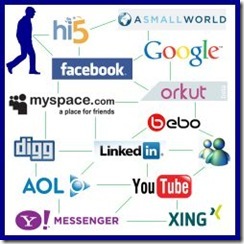 US online adults were most likely to say they have increased their viewing of friends’ photos and information on social networks out of a wide variety of online activities during the past year, according to results of a new Harris Poll.
US online adults were most likely to say they have increased their viewing of friends’ photos and information on social networks out of a wide variety of online activities during the past year, according to results of a new Harris Poll.1/3 Have Increased SocNet Viewing
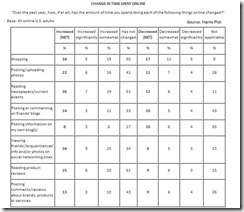
About one-third (34%) of online US adults say they have increased their viewing of friends’ photos and information on social networks either significantly or somewhat in the past year. This was the highest percentage combined response for increasing any of the eight activities presented to respondents (multiple answers were accepted).Reading newspapers/current events followed at a distant second with a combined 26% saying they have increased this online activity either significantly or somewhat in the past year. However, somewhat mitigating this low rate of increased online activity is an often lower rate of decreased online activity.
For example, only a combined 8% of online adults say they have decreased their viewing of friends’ photos and information on social networks either significantly or somewhat in the past year. A full 23% say this activity is not applicable and 34% say it has not changed.
Results are similar for most other activities, with the not changed rate of many hovering above 50%. Shopping had the highest combined rate of decrease (17%).Interestingly, a leading 55% of respondents say posting information on their own blogs is not applicable, and 43% say posting or commenting on friends’ blogs is not applicable, reflecting the shrinking popularity of blogs among US online users.
SocNet Users, Young, Educated More Likely to Increase Online Activity
Almost across the board, social media users, younger and better educated respondents are more likely to say they have increased an online activity in the past year. The difference between social media users and non-social media users is most pronounced in rates of viewing friends’ photos and information on social networks, posting and commenting information on friends’ or own blogs, and posting comments/reviews about brands, products or services.Conversely, non-social media users were more likely than social media users to have increased reading newspapers/current events, the only online activity where they surpassed social media users.
Blogging, reading newspapers and review posting were the only areas where increase rates were not highest among 18-to-34-year-olds. Posting information on your own blog, reading newspapers and posting comments/reviews had the highest rates of increase among 35-to-44-year-olds, posting/commenting on friends’ blogs had the highest rate of increase among 45-to-54-year-olds.
While there was some variety among what age brackets were the second-most-likely to have increased an online activity, 55-plus respondents had the lowest response rate in any area except shopping, where their increase rate of 22% beat 45-to-54-year-olds (20%) and tied 35-to-44-year-olds.
Meanwhile, respondents with a high school education or less were the least likely to have increased all eight online activities. Those with a college degree or more had higher increase rates than those with some college in every activity except posting comments on friends’ blogs and posting reviews.
3 in 10 Use SocNets for Product Reviews
Only a combined 28% of online adults say they have used social media to rant or rave about a company, brand or product. However, a combined 80% of respondents agree strongly or somewhat they give up part of their privacy by participating in social media, and a combined 73% agree strongly or somewhat social media only reveals a snapshot, rather than a full portrait, of who they are.6 in 10 SocNet Users Feel More Connected
Six in 10 (59%) of social network users say they feel more connected to people now than previously, according to another recent Harris Poll. That figure is highest among 18-to-34-year-olds (63%) and females (61%). Similar percentages (58% overall, 63% of 18-to-34-year-olds, 60% of females) say they keep in touch with friends more now than in the past.
Social network users say this even as majorities admit they recently have had less face-to-face contact with friends (55%) and know what’s going on with many of their friends and acquaintances, but don’t interact with them personally or individually (60%). Negative emotional impact of this loss of personal contact appears small, as only 32% of social network users feel lonelier now than previously.
-
Web founder says Facebook a danger
 The man credited with inventing the internet has lashed out at Facebook and other social networking sites saying they are moving the web away from its founding principles.
The man credited with inventing the internet has lashed out at Facebook and other social networking sites saying they are moving the web away from its founding principles.In an essay in Scientific American magazine, Tim Berners-Lee says social networking sites are tightly controlling the information put on there by users meaning the internet’s being split into fragmented islands.
Berners-Lee said there is a chance Facebook could become so big that it could limit innovation.
Source: www.ninemsn.com.au
-
Why Social Media Is Top Priority for Search Marketers
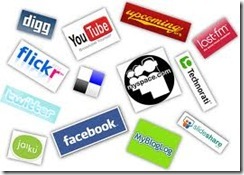 Social will be at the center of SEO and PPC campaigns
Social will be at the center of SEO and PPC campaignsIs 2011 set to be the “year of Facebook,” even among search marketers? Based on what US advertisers told search marketing agency Covario, it’s definitely the year of social.
Search marketers have discovered how social media marketing can help build their search engine optimization efforts, and respondents to the Covario survey said their No. 1 priority for SEO next year was integration with social media programs. According to the report, “leveraging social media for scalable link-building efforts is a major initiative for advertisers.”

Social media will also play an important part in paid search efforts next year. Search ad campaigns on sites like Facebook and LinkedIn were top of mind for nearly half of advertisers surveyed—far ahead of priorities like local search or dealing with recent changes to major search engines (for example, Google Instant and Yahoo!-Bing integration).

The report noted that major spending increases on Facebook search advertising are planned for 2011. Covario estimated many advertisers would be spending 10% to 20% of their pay-per-click budgets on Facebook next year, giving the social networking site a major share of that market. The report also indicated that rather than pulling dollars away from other paid search spending areas, these would be additions to the search budget coming from display or offline budgets instead.
-
Facebook to trademark the word "face"
 Facebook has moved one step closer in its efforts to trademark the word "face", after receiving the green light from the US Patent and Trademark Office.
Facebook has moved one step closer in its efforts to trademark the word "face", after receiving the green light from the US Patent and Trademark Office. The Office has issued a notice of allowance to the social networking juggernaut, allowing the company to own the word after paying a fee, the NY Post reported.
The trademark will allow Facebook to challenge any of the 89,000 websites using the word "face" in their domain name.
The trademark would cover "telecommunication services, namely providing online chat rooms and electronic bulletin boards for transmission of messages among computer users in the field of general interest and concerning social and entertainment subject matter, none primarily featuring or relating to motoring or to cars".
A Facebook spokesperson would not reveal why an exemption was given to cars.
Several companies are considered to be in the sights of Facebook’s legal department, including Apple over its video conferencing service Facetime and a pornography website called Faceporn.
Facebook has also sued websites Teachbook, Placebook and Lamebook in order to protect the social network’s identity.
Facebook has already been successful in trademarking the words "Like" and "Wall".
Source: ninemsn.com.au
-
Leveraging Best Practices for Social Media
 Achieving social media marketing goals, whatever your level of participation
Achieving social media marketing goals, whatever your level of participationBrands and marketers have different levels of participation in the social media space, but many have similar goals and strategies. The “2010 Social Media Benchmarking Study” from Ketchum and FedEx found when looking at 62 study participants from a variety of industries that 100% had some degree of social media presence.
But they demonstrated different engagement levels, including observers who are determining how to best use social media and leaders who push boundaries and innovate.

Yet objectives for social media were uniform across the industries and engagement levels. Some common goals were to generate word-of-mouth advocacy, develop brand loyalty and close relationships with customers, manage customer service issues, and educate the media and public about company-related issues. This supports data from SmartBrief and Summus, which found that 94% of brands hoped to increase awareness and interaction with consumers by using social media.

The Ketchum-FedEx study discussed how companies could still achieve their social media objectives, whatever their engagement levels, noting that it was not necessary to always be a leader in the social media space. Companies should look at their goals and figure out if being a close follower or even an observer for a bit would be better suited to help its business.
One element that helps achieve social media goals discussed by both studies is integration of social media strategy into an overall communications and marketing plan. Thanks to the transparency, interactivity and informality of social media, collaboration between communications, IT, legal and marketing is a necessity to make a holistic plan work and bear fruit.
For more information about social media’s place at the marketing table, stay tuned for the forthcoming eMarketer report, “Social Media in the Marketing Mix.”
-
Auto Thank You Messages & Twitter
 Searching the web recently keeping up with the goings on with social media, I came across an article by a self proclaimed social media guru on the subject of auto thank you messages on Twitter.
Searching the web recently keeping up with the goings on with social media, I came across an article by a self proclaimed social media guru on the subject of auto thank you messages on Twitter. These are messages that you can send out automatically to thank someone who decides to follow you. I’ve had them programmed on my Twitter accounts for ages now and what surprised me was this guru stating in his article that if he receives one of these auto thank you messages he automatically un-follows the company or person. He says it annoys him, oh really you poor dear, I think you’re forgetting that the whole concept of social media is being social.
In my mind, it is just a polite way of acknowledging the follow and as long as the message does not contain a blatant add or sales pitch, I have no problem with these messages at all.
This guru’s belief is that common courtesy rules, apparently don’t apply to social media marketing, well he’s wrong, because I think they do and I will continue to send out my messages to those that do decide to follow me, and by chance if this social media expert is offended by this, then goodbye.
Being social and communicating and connecting with your followers is the essence of social media and I won’t decide to follow or un-follow someone because they sent me an auto thank you message.
That’s just too ridiculous for words, and I wonder if this guy is consulting to companies on social media strategy, what he is advising his clients to do, I just hope he’s not working for you.
There are a lot of instant social media experts around today, and most of them don’t really have a clue.
Decide who you are going to follow by the quality of information they are providing, how interesting and unique it is and if it is informative and relevant.
Oh and if they happen to send you a thank you message for the follow, then that’s good manners.
Remember, Focus on being social not doing social.
-
Does Social Media Marketing Make Sense for the Smallest Businesses?
 Small businesses unsure about reaching audience on social sites
Small businesses unsure about reaching audience on social sites eMarketer estimates that 127 million people in the US, or 57.5% of internet users, will use social networks at least monthly this year. Facebook alone has over half a billion active users worldwide. Still, many of the smallest businesses don’t believe their customers can be marketed to on such sites, according to an August 2010 survey from customer review platform RatePoint.
Respondents, the majority of whom were business owners with just one to five employees, were split on whether social media was a quick way to connect with current or future customers, but sentiment was largely negative. When asked if they thought customers wanted to hear from them on social sites, only a quarter of businesses thought they did.

In addition, 20% of small businesses did not think their customers spent time on social networking sites; another 27% were undecided. And nearly a quarter did not believe their customers did research online before doing business with their company.

With a majority of US internet users on social networks, chances are the customers of even small local businesses are there. According to BIA/Kelsey and ConStat, 97% of US internet users used online media to look for local products and services in Q1 2010, and 90% used search engines. Research from comScore and TMP Directional Marketing shows that, looking for local businesses, searchers are much more likely to use a search engine than a social networking site as their primary resource, but both are used, especially among young people.
“Social media use is no longer limited to one demographic; everyone is adopting,” said Neal Creighton, CEO and co-founder of RatePoint, in a statement. “While many small-business owners are uncertain, big brands are investing heavily in social media. Social media can be a great equalizer for small businesses to compete alongside larger brands and SMBs are missing out if they are not involved.”
-
Facebook Removes Google Contact Import from "Find Your Friends"
 Facebook versus Google… but what round are we on now? It’s a little salvo this time, but Facebook has removed all mention of Google’s Gmail service from its "Find your Friends" feature. It’s just one more of the squabbles between Google and Facebook that all began when the former blocked access to the latter’s ability to find new Facebook friends via Gmail itself.
Facebook versus Google… but what round are we on now? It’s a little salvo this time, but Facebook has removed all mention of Google’s Gmail service from its "Find your Friends" feature. It’s just one more of the squabbles between Google and Facebook that all began when the former blocked access to the latter’s ability to find new Facebook friends via Gmail itself. Why’s that? Google was irked that Facebook allowed users to find new friends based on one’s contact listing within a Gmail account, but Facebook itself didn’t allow the procedure to go in reverse. By that, we mean that there’s no way to populate your Google Contacts listing with any information that’s found in Facebook.
In response, Google denied Facebook the ability to pull in information from Google Contacts. Facebook successfully investigated a workaround. Google responded by posting a large missive for those trying to use Facebook’s workaround to import Google information.
"You have been directed to this page from a site that doesn’t allow you to re-export your data to other services, essentially locking up your contact data about your friends," read a message on Google’s Gmail page.
"We think this is an important thing for you to know before you import your data there. Although we strongly disagree with this data protectionism, the choice is yours. Because, after all, you should have control over your data."
Well, it appears that the squabbling between the two—at least, over the issue of contact importing—is set to die down. Facebook has since removed Gmail as an eligible candidate within its "Find Your Friends" feature, which means that users will be unable to access Gmail contacts—workaround or otherwise—via Facebook.
Attempting to do via Facebook’s "Other email service" link within Find your Friends brings up an error message for any who try to use a standard Gmail address: "Everyone on this contact list is already on Facebook or has already been invited."
According to TechCrunch, Facebook has also removed any kind of Gmail importing functionality from its Friendfeed site as well.
Story by David Murphy www.pcmag.com
-
Facebook Growth Dramatically Outpaces Other SocNets
 A comparison of Facebook’s yearly growth in unique visitors shows it is gaining traction at a much faster pace than several other major social networking sites, according to CompetePRO data.
A comparison of Facebook’s yearly growth in unique visitors shows it is gaining traction at a much faster pace than several other major social networking sites, according to CompetePRO data.Facebook, Twitter Unique Visitors Grow Year-over-Year

Between October 2009 and October 2010, Facebook increased its unique visitor total almost 22%, from about 109.7 million to 133.5 million. Compared to September 2010, Facebook grew its unique visitor total 2% from 130.8 million.In comparison, Twitter only increased its unique visitor total year-over-year about 1.3%, from 25.3 million to 25.7 million. Between September and October 2010, Twitter experienced negative unique visitor growth of 9.4%, falling from 28.3 million.
MySpace, LinkedIn Suffer Negative Yearly Growth
MySpace experienced significant negative unique visitor growth between October 2009 and 2010, falling 20.5% from 73 million to 58 million. Month-over-month, MySpace underwent 2.4% negative growth, dropping from 59.5 million unique visitors.
Meanwhile, LinkedIn also experienced negative year-over-year unique visitor growth of about 4.7%, going from 14.6 million to 13.8 million. However, LinkedIn posted modest month-over-month growth of 3.2% from about 13.4 million.
Personal Networking Sites Show Minimal Yearly Unique Visitor Growth

Combined, the 248 personal networking sites tracked by Compete (including Facebook, Twitter and MySpace), showed minimal growth in unique visitors between October 2009 and October 2010.Personal networking sites only increased total unique visitors in that time by about 0.6%, from 144.6 million to 147.9 million. Month-over-month growth was negligible, rising from about 147.1 million.
Professional Networking Sites Lose Unique Visitors from Oct. ‘09

The 47 professional networking sites tracked by Compete (including LinkedIn) drew far fewer total unique visitors than the 250 personal networking sites, and showed worse year-over-year but better month-over-month growth rates.Between October 2009 and October 2010, unique visitors shrank about 3%, from 20.5 million to 18.9 million. However, professional networking sites increased unique visitors about 3% from 18.3 million in September 2010.
Facebook Dominates SocNet Use among Young
Seventy-four percent of young adults use Facebook to some degree, according to a recent study from Edison Research. By frequency of use, this figure breaks down to 55% actively using Facebook and 19% occasionally using it. Of the remaining 26%, only 4% are unfamiliar with Facebook.
In comparison, only 30% of young adults use MySpace, with 12% actively using it. Much higher percentages of young adults have a MySpace account but don’t use it and have deleted a MySpace account than fit these two categories for Facebook use. Unfamiliarity is also twice as high (8%).
Twitter only has a 4% active use rate and 8% occasional use rate among young adults. However, 61% have heard of Twitter but never used it, presenting significant potential for audience growth.
-
Facebook unveils new messaging system
Swatting down recent rumors that it’s launching an e-mail killer, Facebook today unveiled a new messaging system that will envelope e-mail, instant messages, Facebook messages and SMS.
Facebook CEO Mark Zuckerberg launched what he calls a "modern messaging system" to handle the convergence of different kinds of messages and bring them together under one social umbrella. The system, which has been in the works for about 15 months, is designed to save all messages for five years, meaning users will have a history of their communications.
Although people will now be able to have a facebook.com e-mail address, Andrew Bosworth, a software engineer at Facebook, noted that the new system will work with other e-mail systems, such as Gmail and Yahoo mail.
"People should share however they want to share," said Bosworth. "If you want to send me an e-mail and I want to get it in a text message, that should work."
At this point, the messaging system — code-named Titan — will not include voice chat. Zuckerberg said that should be coming down the road, but offered no timeline.
More than four billion messages are sent every day on Facebook, with the vast majority of the messages between two people, according to Zuckerberg. And about 350 million people use Facebook to message their friends and family members.
He said he started thinking about those numbers after talking with a group of high school students who told him that they rarely use e-mail. It’s too slow, they told him. "I was kind of boggled by this," Zuckerberg said. "I remember having a similar conversation with my parents about why e-mail was good and regular mail was slow…. At Facebook, we’re all so used to using e-mail. It’s interesting to see that all kinds of folks don’t see it that way."
So Facebook decided to create a new messaging system that would include e-mail, expand on the concept and tie in other means of communication as well. "It’s not e-mail," said Zuckerberg. "It handles email, in addition to Facebook messages, and IM and SMS. People are going to be able to have facebook.com email addresses but this won’t be the primary way people use this system."
For the last three or four days, the Internet has been abuzz with speculation that Facebook was getting ready to launch an e-mail killer. Zuckerberg kicked off today’s news event by saying that’s not the case.
"There was a lot of press leading up to this saying this is an e-mail killer," he added. "This is not an e-mail killer. It’s a messaging system that has e-mail as one part of it. I don’t expect people to wake up tomorrow and say, ‘I’m going to shut down my Yahoo account or my Gmail account.’ We expect that more people will IM and more people will message just because it’s simpler and easier and it’s more fun and valuable to use."
-
Twitter Video Streams Watched for 2 Mins
 The average online video stream discovered on the Twitter social network is viewed for two minutes and seven seconds , according to a new study from TubeMogul, Brightcove, and DynamicLogic.
The average online video stream discovered on the Twitter social network is viewed for two minutes and seven seconds , according to a new study from TubeMogul, Brightcove, and DynamicLogic.Twitter Beats Yahoo, Facebook
Comparing the average viewing time of 103,731,006 random video streams discovered on several leading social networks and search engines, “Online Video Best Practices” finds that the average video stream sourced via Twitter is viewed for two minutes and seven seconds. No other social network or search engine analyzed broke the two-minute mark.Search engine Yahoo followed with an average viewing time of one minute and 54 seconds, closely trailed by social network Facebook with an average viewing time of one minute and 50 seconds. Search engines Google (1:27) and Bing (1:09) had significantly shorter average online video viewing times.
Online Videos Have Short Shelf Life
Analyzing the average 90-day viewing lifecycle of an online video, the study finds the average online video receives half its 90-day online view total in the first six days, and 75% in the first 20 days.
The shelf life of online videos has dropped dramatically since 2008, when it took the average online video took two weeks to get half its 90-day view total and 44 days to reach 75%.
Repurposed, Made-for-Web Ads Have Different Strengths
There is no one superior production format, it turns out; repurposed TV spots typically result in higher impact on awareness metrics, while made-for-web video content more ably persuades its viewers.
More specifically, repurposed TV ads are slightly better at raising brand awareness (affect 2% of viewers compared to 1.9%) and message association (2.2% compared to 2.1%), and affect a moderately higher percentage of viewers in terms of online ad awareness (4.7% compared to 4.3%).
Meanwhile, made-for-web ads outperform repurposed TV ads in brand favorability (1.6% compared to 1.2%) and purchase intent (1.4% compared to 0.8%).
Custom Content Boosts Purchase Intent Among 18-34-Yr-Olds
Comparing the affect of repurposed TV and made-for-web content on viewers of different ages, the study finds that purchase intent among 18-to-34-year-olds who view made-for-web content (2.8%) dwarfs purchase intent for either type of content among any age group. This percentage is more than double the next-highest purchase intent rate, 1.1% of 18-to-34-year-olds exposed to repurposed TV content.
This age group also has significantly higher online ad awareness from viewing made-for-web content (5.9%) than any other online ad awareness score, although nowhere near double the amount. The highest brand favorability score is among 35-to-49-year-olds who view made-for-web content (2%), while brand awareness is highest among 35-to-49-year-olds exposed to repurposed TV content (3.3%).
8 in 10 Marketers Using Online Video Seek Higher Engagement
Close to 80% of marketers using online video on their sites do so to increase visitor engagement, or time spent, according to other study results. This is by far the most popular reason. Another 60% use online video to strengthen their brand, and almost 60% use online video to increase overall visitors (more than one answer was permissable).
No other reason garnered as much as a 40% response rate. Approximately 30% of respondents said they use online video on their sites to increase available ad inventory.
-
Visitor Engagement Leading Reason for Online Video
 Increasing visitor engagement is the most popular reason marketers use online video on their sites, according to a new study from TubeMogul, Brightcove, and DynamicLogic.
Increasing visitor engagement is the most popular reason marketers use online video on their sites, according to a new study from TubeMogul, Brightcove, and DynamicLogic.8 in 10 Marketers Using Online Video Seek Higher Engagement
Close to 80% of marketers using online video on their sites do so to increase visitor engagement, or time spent. This is by far the most popular reason. Another 60% use online video to strengthen their brand, and almost 60% use online video to increase overall visitors (more than one answer was permissable).
No other reason garnered as much as a 40% response rate. Approximately 30% of respondents said they use online video on their sites to increase available ad inventory.
Online Video Viewers Increase Viewing Time Almost 10%
Marketer efforts to boost visitor engagement may be working. During Q1 2010, online video viewers watched an average of 5:55 minutes of video in each session, growing by an average of almost 9.5% per month during the past six months.
The number of videos watched per viewer in a given session averaged 2.82, growing at a pace of about 0.3% per month in the same time period.
Video Advertising Grows in Effectiveness
Video advertising, both display and pre-roll, leads to purchase intent for 1.4% of all viewers that saw an ad, a number that’s grown for three consecutive quarters and is more effective than other mediums. Rich media and simple flash advertising both lead to purchase intent for less than 1% of all viewers, with rich media improving during 2009 and rich media decreasing in effectiveness last year.
Video Advertising Boosts Awareness
In addition to leading to purchase intent at a higher percentage than rich media or simple flash advertising, video advertising is also substantially better at raising online ad awareness (3.2% compared to 2.4% and 1.8%, respectively).
Video advertising also leads the other two formats in helping brand favorability and brand awareness. Rich media performs slightly better at message association (1%, compared to 0.8% for both video and simple flash).
More than Half of YouTube Videos Viewed Less Than 500 Times
Although YouTube videos which become viral sensations receive lots of attention, in reality, a combined 56% of YouTube videos get less than 100 unique views (31.5%) or 100-500 unique views (24.5%). Another 10% get 500 to 1,000 unique views.
At the other end of the spectrum, only about 0.4% of unique YouTube videos are viewed more than 1 million times. About 2% are viewed 500,000 to 1 million times, and a little less than 2% get 100,000 to 500,000 unique views.
4 in 10 YouTube Videos Carry Ads
Other study data indicates that tracking YouTube’s top 100 daily most-viewed videos by content type for a 30-day time period, comparing results to six months ago, shows that although only about 42% of the most popular videos have ads, that number is growing by 0.83% per month and both pirated and user-generated content are down.
Breaking out ad content by type (not counting YouTube’s homepage), about 93.5% of ads are 300×250 display ads. Another 5.5% are pre-roll, and slightly less than 1% are overlay.
-
Mobile App Development Grows Sharply
The number of mobile applications developed by advertisers/marketers in 2010 increased significantly year-over-year, according to a new report from Millennial Media.
Major Increase in Advertisers Developing 20-50 Apps
When asked the number of mobile applications they developed in 2010 compared to 2009, advertisers participating in “State of the Apps Industry 2010? stated growth in every area. In particular, advertisers developing 20-50 apps stated an astounding jump 1,975% jump from four in 2009 to 83 in 2010.
Conversely, the number of advertisers who did not develop a single application decreased 42% year-over-year (from 19 in 2009 to 11 in 2010).
Entertainment Top App-building Vertical
In 2009, CPG, Retail, Auto, Entertainment and Financial companies were the top five verticals building apps. In 2010, however, Entertainment displaced CPG to claim the number one spot, followed by Technology, Media, and Retail.
CPG remained in the top five at number five, while retail fell from number two to number four. Auto and financial were displaced by media and technology (debuting strongly at number two in 2010).
Android, iPad Lead Growth in Advertiser App Development Platforms
From 2009 to 2010, Android (180%) and iPad (0 to 35, year-over-year growth percentage cannot be calculated) saw the most significant growth as the application platforms used by advertisers.
iPhone still leads the pack with 73 developers and about 18% growth, but RIM, Windows Mobile, and Symbian also saw increases, as advertisers continued to diversify their application platforms.
Android, iPad also Lead Publisher Growth
Among publishers, Android, iPad, Windows Mobile, and Symbian also grew year-over-year from 2009 to 2010. Again, Android (71%) and iPad (60%) saw rapid acceptance by publishers, and efforts were focused on developing applications for these players.
Meanwhile, iPhone (2% negative growth but still the leading platform, used by 46 publishers) and Palm (21%) were the two platforms that saw year-over-year decreases.
Reach Top Consideration for Choosing a Platform
Millenial Media ranks the top five considerations for choosing a mobile application development platform by both advertisers and publishers as follows:
1. Reach
2. Demo
3. Better Branding
4. Ease of Use
5. Higher Sales Potential2 in 3 Mobile Users Text
In the three-month average ending September 2010, 67% of US mobile subscribers used text messaging on their mobile device, according to comScore, up 1.4 percentage points compared to the prior three-month period.
Meanwhile, browsers were used by 35.1% of US mobile subscribers (up 2.2 percentage points). Subscribers who used downloaded applications comprised 33.1% of the mobile audience, representing an increase of 2.5 percentage points. Accessing of social networking sites or blogs increased 1.8 percentage points, representing 23.2% of mobile subscribers. Playing games represented 23.1% of the mobile audience (up 0.5 percentage points), while listening to music increased 0.8 percentage points, representing 15.2% of subscribers.
-
Advertisers Demand Proof of Online Video’s Efficacy
 Finding evidence for video’s branding power
Finding evidence for video’s branding powerOnline video advertising is growing at a fast pace in the US. eMarketer forecasts a spending increase of 48.1% to over $1.5 billion this year, followed by a further boost of about 43% for the next two years. But publishers and video ad networks have concerns about their effectiveness.
A survey of web publishers by online video ad service provider BrightRoll found that they considered standardization of formats across ad networks to be the greatest barrier to online video growth, followed by the interruption to the user experience.

Publishers also had concerns about working with ad networks, mainly about fill percentages and sales-channel conflicts.

But even more publishers—88%—said they thought advertisers would spend more if research proved the efficacy of online video advertising. An earlier BrightRoll survey that queried agencies found 52% said their clients would spend more under the same conditions.
“Today’s video metrics only partially answer the essential question marketers want to know: Did the ad convince the consumer to buy?” wrote David Hallerman, eMarketer principal analyst, in the October 2010 report “Measuring Video Ads: Metrics for Brand Marketers.” “Whether the metric data comes from servers (completion rates) or from surveys (awareness), it acts as only a proxy for answering that bottom-line question.”
Research from Dynamic Logic and TubeMogul in Q4 2009 showed online video performed better than rich media or simple flash in online ad awareness, brand favorability, and a variety of other branding metrics.
-
Millennials Show Off Brand Relationships
 Most have joined a brand-sponsored online community
Most have joined a brand-sponsored online communityWhat does it mean for users to be willing to form relationships with a brand online and share them via the publicity of a “like” on Facebook, for example? As marketers ask whether such relationships will lead to increased sales, brand advocacy or other direct benefits, research suggests publicizing brand preferences is about users defining themselves.
An ExactTarget study on Facebook fans’ motivations found that nearly two in five wanted to show their support for a company. They considered the brands they liked a form of self-expression. A Facebook profile, which lists brands that a fan is connected with alongside other interests, such as music, movies and books, is a venue for this self-expression. The company found it was very important for some users to show brands almost as a part of their own personality.
Young people around the world may feel the same way, according to Edelman. Nine in 10 millennials (those born between 1980 and 1995, or “8095ers”) surveyed in the US, and a total of 86% around the world, were willing to share their brand preferences online.

As the report explains, that makes brand preference a top personal identifier for millennials online—alongside such information as religion and ethnicity.
“This research suggests a link between the immersive, symbiotic relationship 8095ers have with social networking channels and the likelihood to define their personal brand by aligning with the brands they favor,” said the report.
While they will define their personal brand by connecting with brands online, they are much less likely to consider the web a major source for decision-making. Just 13% relied on social networks, compared with 77% who went to family and 64% who turned to friends.

Millennials also rely on a large number of information sources when choosing which brand to buy; a majority worldwide and 42% in the US consulted at least four sources when considering a new product. Brands must be everywhere to ensure they are part of the conversation as millennials look high and low for product information.
-
In Mobile Content World, Men Lead in Spending
 Whether it’s media, entertainment or shopping, men are doing more and spending more
Whether it’s media, entertainment or shopping, men are doing more and spending moreThe model of the young male early adopter seems to have fallen by the wayside with the rise of digital phenomena like social media, but according to research from Adobe Systems Inc., men were ahead in mobile.
In a few content activities, women led. They were 10 percentage points more likely than men to access social media via mobile, and about equal when it came to searching for local information, reading or posting to blogs, and playing games. But men’s hunger for content put them ahead in more than just sports; video, music and news were all primarily male-conducted activities.

Men and women were in a statistical dead heat in usage of maps and directions via mobile, but men dominated in all other travel-related activities, including research, price comparison and booking. The same was true in the financial services sector: Men were more likely to do every type of financial activity on their phones, whether it was simple stuff like checking bank-account balances or more complex transactions like buying and selling stocks and mutual funds.
Men weren’t just using more content—they were more willing to pay for it too. Adobe found that men were more likely than women to purchase every category of mobile media and entertainment content studied, including games, video, news and, of course, sports content. Overall, 53% of women said they had never paid for mobile entertainment content, compared with just 38% of men.
Mobile-commerce is also a male-dominated area. Women held their own in categories like clothing, shoes and jewelry—as well as toys, babies and kids—but men were never far behind and in many areas dramatically outpaced women’s purchase habits.

Overall, females were 11 percentage points more likely to say they had not made any mobile purchases in the past six months. Men also spent more on their mobile purchases, with 60% spending at least $250 in the past year, compared with less than half of women who reported the same.
-
The Role of Customer Product Reviews
 Customer product reviews are becoming a fixture on retail and consumer brand websites, with over 80% of retailers planning to feature them by the end of 2010. The accelerated adoption of customer reviews indicates a more enlightened approach to handling negative comments—that is, the acknowledgment that occasional negative reviews do not hurt sales.
Customer product reviews are becoming a fixture on retail and consumer brand websites, with over 80% of retailers planning to feature them by the end of 2010. The accelerated adoption of customer reviews indicates a more enlightened approach to handling negative comments—that is, the acknowledgment that occasional negative reviews do not hurt sales.“For many purchases, shoppers find the best advice comes not from family and close friends but from strangers who have similar interests or who embody a lifestyle the shopper aspires to achieve,” said Jeffrey Grau, eMarketer principal analyst and author of the new report “Customer Product Reviews: The Next Generation.”
Reading product reviews is a growing part of consumers’ prepurchase search ritual. Over the past few years, consumers have increased the number of reviews they read and the overall time they spend reading them. And nearly all internet users are influenced in some way by customer product reviews, according to ChannelAdvisor.

A 2010 study by the e-tailing group, sponsored by PowerReviews, revealed the deepening relationship shoppers have with customer reviews. Whereas 64% of shoppers read reviews always or most of the time before making a purchase decision, unchanged from a similar survey in 2007, they were more immersed in reading them now than they were three years ago:
- 64% of shoppers took 10 minutes or more to read reviews, vs. 50% in 2007.
- 33% took a half hour or more to read reviews, vs. 18% in 2007.
- 39% read eight or more reviews before buying, vs. 22% in 2007.
- 12% read 16 or more reviews before buying, vs. 5% in 2007.
The e-tailing group study qualified the role of customer reviews in purchase decision-making. Some 57% of shoppers trust customer reviews but place them in a supportive role to other information sources. Another 35% of respondents expressed mixed feelings by indicating that customer reviews are interesting but sometimes questionable in their authenticity.

“While customer reviews are important to shoppers, merchants should not overrely on them for marketing,” said Grau.
Intriguing potential exists in the possibilities of connecting customer reviews to social media, already explored by some pioneering companies.
-
Social Media Increases Small-Business Exposure
 Many small firms still hold back from social media marketing efforts
Many small firms still hold back from social media marketing effortsAccording to the American Express OPEN fall 2010 “Small Business Monitor,” small-business owners have dramatically upped their usage of social media for marketing in the past year.
While just one in 10 business owners reported using social networking for marketing last year, 39% indicated they did in September 2010. The impetus is driving sales by connecting with consumers. Facebook was the clear leader among small-business owners, with 27% using the site to attract new customers, vs. 9% using LinkedIn, 8% using Twitter and 5% maintaining a blog.
American Express found that among businesses that use social media marketing, 39% said it increased the exposure of their business. But the second most common response, selected by 17%, was that social media tools had not helped them.

“For business owners, social media ultimately should be a two-way street. It’s about business owners connecting with customers and customers connecting with businesses,” said Susan Sobbott, president of American Express OPEN, in a statement. “More than 10% of consumers we surveyed reported posting a review of a small business through social media channels such as Facebook, Twitter or LinkedIn, and of these posts, two-thirds say the reviews have been positive.”
But many small businesses still feel social media marketing has nothing to offer them. More than three in five reported not using social media at all, and the biggest reason they gave was that it did not apply to their industry.

A September survey of small businesses that have advertising relationships with local newspapers by ITZ Belden and the American Press Institute (API) similarly found that 40% of respondents used social media marketing. Just 20% said it was a leading source of new business, compared with 77% who cited referrals from customers and 65% who selected referrals from friends and family.
-
Traditional Media Users Skew Older
 Consumers of traditional media sources such as print and TV tend to be older than online media consumers, according to results of a new 24/7 Wall St./Harris Poll conducted by Harris Interactive.
Consumers of traditional media sources such as print and TV tend to be older than online media consumers, according to results of a new 24/7 Wall St./Harris Poll conducted by Harris Interactive.55-plus See Most Need for Traditional Media
Overall, 81% of survey respondents said although printed news will continue to decline, there will always be a need for news in print. However, this figures is highest (87%) among respondents older than 55 and lowest (76%) among respondents 18-34 and 35-44.
More telling is the fact that while 67% of overall respondents still prefer to get their news from traditional sources, this figure jumps to 81% for 55-plus and drops to only 57% for 18-34.Conversely, 50% of 18-to-34-year-olds tend to get almost all of their news online, compared to only 33% of those 55 and older.
Older Consumers Visit Traditional News Sources More Often
For all forms of traditional news media, older consumers are more likely to visit either all the time or occasionally than younger consumers, with the widest discrepancy existing between the oldest and youngest consumers.For example, while 76% of overall respondents at least occasionally consume local TV news, this figure is 88% of 55-plus but only 63% of 18-34. Similar trends can be observed for local newspapers and network TV news. The discrepancy narrows a bit for cable TV news (60% overall, 67% of 55-plus, 51% of 18-34).
There is a milder reverse discrepancy when looking at usage of new news media sources. The widest difference exists in consumption of websites for national newspapers (36% overall, 40% of 18-34, 30% of 55-plus).
Older Consumers Increase Time with TV News
Consumers age 55 and older are more likely to have increased the time they spend watching cable TV news and network TV news in the past year than consumers 18-34 (rates of 22% and 17% compared to rates of 13% and 12%, respectively).However, in addition to the expected higher rates of increasing consumption of new media such as visiting online news and information sites among younger consumers (29% of 18-34 compared to 22% of 55-plus), younger consumers are also more likely to have increased consumption of many traditional media, such as radio (24% of 18-34 compared to 13% of 55-plus).
Internet Dominates Young Adult Media Time
American young adults spend more time online than consuming other forms of media, according to a new study from Edison Research. “Radio’s Future II: The 2010 American Youth Study” indicates that during an average day, Americans age 12-24 spend two hours and 52 minutes on the internet, making the web the media format American young adults spend the most time consuming. Television closely follows with a daily average of two hours and 47 minutes. -
Social Media Doesn’t Make Users Less Social
Social media is not making users less social, despite popular contrary opinion, according to a new white paper from ExactTarget and CoTweet.
Increased SocNet Use Leads to Increased Face-to-Face Interaction
“Social Mythbusting” research shows that individuals who are becoming more active on Facebook and Twitter are also interacting with friends in “real” (not virtual) settings more often, despite assertions to the contrary from many industry observers. ExactTarget data shows that among consumers increasing Facebook use, 27% are meeting friends in person more and only 13% are meeting friends less. The same consumers increasing Facebook use are calling friends on the phone more and less often (19% each).Consumers increasing Twitter use show results substantially more skewed to increased personal interaction. Forty-six percent are meeting friends in person more and only 7% less, while 33% are calling friends on the phone more and 13% less.
Big Names Aren’t Leading to Increased Twitter Usage
Although an increasing number of celebrities are joining Twitter, ExactTarget research shows that they have not increased Twitter use among most people. In the last six months, across the 12 types of Twitter users identified by ExactTarget, only a range of 8-18% are using Twitter more. Meanwhile, the range of those saying they are using Twitter less varies from 10%-45%.Facebook Fans’ Worth Hard to Measure
Recent findings from Syncapse indicate that the average Facebook fan is worth $136.38 to a brand and Facebook fans spend an average of an extra $71.84 on a product. However, previous ExactTarget research indicates only 17% of US consumers reported that they’re more likely to buy as a result of liking a brand.So while Syncapse’s study does establish the average annual spend of a Facebook fan, ExactTarget advises it doesn’t suggest the increase in value that can be attributed to Facebook, since many of these consumers have already reached their limit to purchase additional products, goods, or services from brands.
ExactTarget recommends that marketers must resist the temptation to view Facebook as merely an acquisition or loyalty channel, where number of fans is directly linked to ROI. Fans are a valuable part of a marketing strategy, but must be empowered to act as viral advocates for a brand with their own friends and contacts.
6 in 10 SocNet Users Feel More Connected
Six in 10 (59%) of social network users say they feel more connected to people now than previously, according to a recent Harris Poll. That figure is highest among 18-to-34-year-olds (63%) and females (61%). Similar percentages (58% overall, 63% of 18-to-34-year-olds, 60% of females) say they keep in touch with friends more now than in the past. -
Odds are interest rates will rise on Cup day
 Don’t for a second believe that the Reserve Bank automatically will keep interest rates on hold next Tuesday. Trigger-happy screen jockeys yesterday may have raced to their terminals to sell the dollar and push money markets around after the release of lower-than-expected inflation figures.
Don’t for a second believe that the Reserve Bank automatically will keep interest rates on hold next Tuesday. Trigger-happy screen jockeys yesterday may have raced to their terminals to sell the dollar and push money markets around after the release of lower-than-expected inflation figures.Unfortunately, they overlooked one crucial element. Those figures released by the Australian Bureau of Statistics yesterday were a gauge of what has taken place in the past.
That immediate past – the three months to the end of September – gave the illusion of a slightly more benign inflation environment than some expected, but that’s not necessarily a portend of what is to come.
The debate that will take place around the Reserve Bank board table on Tuesday will be about what is likely to happen in the future. And there are a couple of inescapable conclusions on that front: our economy will gather speed and inflation pressures will mount.
You know that old saying about lies and statistics. Well, if you take the effort to dig beneath the surface, those headline figures that grabbed the attention of the money market, you’ll notice a couple of fairly obvious trends that tend to buck the argument that rates will be kept steady on Melbourne Cup day.
The headline inflation figure, and for that matter the core inflation numbers, certainly are being kept in check by the stronger dollar, on the amount we are paying for imports. That’s exactly what a stronger dollar is supposed to do, act as a brake on growth and inflation.
But on the domestic front, strains are beginning to appear.
With employment running close to capacity (you never get absolutely full employment) and with an investment boom in resources, domestic prices have begun to gather speed. Plus there are continued concerns about the housing market, where prices still seem to be on the trot, even if they have slowed from the gallop earlier this year.
Then, of course, there is the political situation within the Reserve Bank boardroom. As in any field of human endeavour, not everyone agrees on everything, and thanks to greater disclosure from our central bank these days, we’ve managed to get a clearer picture on the thought processes within the inner sanctum.
This month’s decision to keep rates on hold came as a shock to the screen jockeys, who almost unanimously predicted rates would rise. They did this because the Reserve’s governor, Glenn Stevens, gave a speech in Shepparton where he indicated that in the medium to longer term the resources boom would put pressure on interest rates.
It was a knife-edge decision this month. But there were some notable absentees, particularly the academic Warwick McKibbin, who has made no bones about the fact that he reckons interest rates should rise.
Couple that with the fact that the statement released by the Reserve after that meeting included some fairly strong words, essentially indicating that rate rises were inevitable. It was a question of when rather than if.
There are four people in particular who are praying the Reserve lifts rates on Tuesday. One is the National Australia Bank chief, Cameron Clyne, who yesterday indicated that the big banks had a public relations problem.
He got that right. For again, buried within the NAB’s fabulous 63 per cent profit leap (19 per cent on a cash earnings basis), was the revelation that interest margins – the gap between borrowing costs and lending prices – had widened.
That gap – the profit margin – widened significantly in the first half but was wound back a little in the second half.
Any rational person looking at the result – the headline figure, the cash figure and the margin spread – would have difficulty reaching a conclusion other than our banks are raking it in right now.
But still, they persist with the argument that they will have to push their rates higher, above any official rise, because their costs are rising.
If you think about it, the only kind of business that can put forward that argument and maintain a straight face is a monopoly – or, in the case of our banks, an oligopoly.
There exists an attitude among monopoly operators, and it is an attitude characterised by arrogance. The thinking is: ”Consumers will pay whatever we charge, because they have to. And we will charge whatever our costs are, plus a hefty margin.”
Truly competitive firms cannot operate in that manner. It is true that they have to charge more than their costs or they will go out of business. But the price they can charge is determined by consumer demand and the supply they can deliver.
It is for that reason the competition regulator – which gave the green light to a massive reduction in competition during the worst of the financial crisis – is looking at whether the big four banks are indulging in a spot of price collusion with their constant warnings that interest rates must rise because costs have risen.
That’s not the only fight they have on their hands. There is a serious conflict brewing between our central bank, which is trying to run the economy, and the commercial banks, which are trying to maximise profits.
The Reserve Bank clearly wants to restrict the growth of credit – to slow the economy and a potential housing bubble – and to do so by maintaining control over interest rates. The big four banks, on the other hand, would love to see an explosion in credit growth – they are in the business of lending money – and fatten their margins along the way.
By tacking on a little extra to official rate rises, the commercial banks are undermining the authority of the Reserve Bank and restricting its ability to manage monetary policy.
Now they have been exposed, the Reserve Bank may just make a move on Tuesday.
Story by Ian Verrender www.smh.com.au
-
BlogPress SEO Plugin: Spam, Spam, Spam!
 This morning I received an email from a company suggesting I try out their new WordPress plugin on my blogs, the email stating that by adding this plugin to my blogs I will generate 100’s of backlinks, the plugin by the way is called Blog Press SEO, now having done this for some time, my nose started twitching and I’ve researched this plugin.
This morning I received an email from a company suggesting I try out their new WordPress plugin on my blogs, the email stating that by adding this plugin to my blogs I will generate 100’s of backlinks, the plugin by the way is called Blog Press SEO, now having done this for some time, my nose started twitching and I’ve researched this plugin. First of all, there is a word for plugins like this one, and it’s called “link scheme” and let me tell you, Google does not like link schemes and you run the risk of having your blog banned, there is also a paid version available which effectively buys links and we all know that Google definitely does not like that, so beware and do not get conned into using this plugin.
If you would like to read more on this, here is a link to a great article on the subject, http://yoast.com/blogpress-seo-plugin-spam/.
-
Mobile Users Prefer Browsers over Apps
For a variety of functions, users would rather browse
Although about a third of US mobile phone subscribers used a downloaded application in August, according to comScore, and app downloads have shown impressive growth, many mobile device users appear to think browsers offer the better user experience.
Mobile users polled by Keynote Systems for Adobe reported a preference for mobile browsers to access virtually all mobile content. Games, music and social media were the only categories in which users would rather use a downloaded app than browse the mobile web.

Their preference for mobile browsers extended to the retail category, with users showing a strong bias toward mobile browsers for accomplishing every mobile shopping task mentioned. Whether it was researching product and price info or sharing that information socially, mobile users would rather fire up a browser than a dedicated app.

These preferences may surprise mobile experts who consider apps to offer the best content and shopping experiences. And marketers may be frustrated as well; getting an app on a user’s home screen is a constant reminder of the brand, but it doesn’t make sense to offer an app users don’t want.
Consumers may simply be unimpressed by the mobile-optimized efforts they have seen so far. When the Adobe survey asked about a preference for using regular or mobile-optimized websites on their mobile device, they preferred regular sites in both the consumer products-shopping and media-entertainment categories. According to the report, this preference suggests “a low awareness of optimized experiences for the mobile web,” but users could also be frustrated with the limited functionality many mobile-optimized sites provide.
-
Netbook Shoppers Consider Other Mobile Devices
Consumers researching online data about netbook computers for possible purchase are also considering other devices, according to analysis from Compete.
Aspire One Shoppers Research Handsets, Other Netbooks
Analyzing online research habits of consumers considering purchase of the popular Acer Aspire One netbook as part of a two-year AT&T data plan, Compete found that 13% also researched the Apple iPhone 4 mobile handset.In addition, 6% researched the Palm Pixi Plus mobile device and 5% got information on the Apple iPhone 3GS handset. Consumers also viewed data on competing netbooks; for example 11% researched the HP Mini 110 and 8% looked up the Samsung GO.
HP Mini 110 Shoppers Also Consider Smartphones
Consumers considering purchasing an HP Mini 110 netbook as part of an AT&T two-year data plan demonstrated a slightly different cross-shopping pattern. Thirty-seven percent researched a competing netbook, the Samsung GO.However, a still significant 15% looked up the Samsung Captivate mobile device and 11% researched the iPhone 4. The Samsung a777, a refurbished feature phone offered free with a two-year AT&T data plan, also proved popular with prospective Mini 110 buyers (13%).
In addition, 13% of potential HP Mini 110 shoppers researched the Pantech Ease mobile computing device.Smartphones, Mobile Devices Pose Serious Netbook Threat
Compete notes that these results, collected in September 2010, reflect long-term trends rather than a one-month spike in smartphone and smaller mobile device interest among prospective netbook buyers. Considering that smartphones not only offer 3G mobile web browsing but also mobile entertainment and file storage in an interface that feels less like an inconveniently small computer and more like a conveniently powerful phone, and that tablet computers are rapidly growing in popularity, Compete advises that netbook sales may drop.More Americans Own Mobile Phones than Computers
A higher percentage of US adults owns a mobile phone than owns a computer, according to new data from the Pew Research Center’s Internet & American Life Project. Pew data indicates that 85% of Americans now own a cell phone. Cell phone ownership rates among young adults have reached 96% of 18-to-29 year olds. Meanwhile, three-quarters (76%) of Americans own either a desktop or laptop computer. Since 2006, laptop ownership has grown dramatically (from 30% to 52%) while desktop ownership has declined slightly. -
Gaining Consumer Trust Online and Offline
Marketers must leverage trust, not just popularity
Trust and credibility are the gold standards by which relationships are measured. This is true of personal relationships as well as connections between people and brands.
The rise of social media has reinforced the importance of trust. Successful and enduring social networks such as Facebook and LinkedIn are built on a foundation of trust and transparency. But social media has also distorted the notion of trust and put an emphasis on the size of a person’s network and connections.
“Most people’s decisions are shaped by word-of-mouth input, whether online or offline, from a tight circle of close friends and relatives,” said Paul Verna, eMarketer senior analyst and author of the new report “Word-of-Mouth Marketing: Leveraging Trust Online and Offline.” “Marketers seeking to maximize their reach should focus on the quality of social network connections rather than their sheer size.”
According to Invoke Solutions, quantitative measures such as the volume of content and participation, the length of time people have been fans or followers, or the raw number of followers or fans mattered far less in inspiring trust than the openness of the dialogue, the quality of the comments, and the responsiveness of the sponsor or author.

And Vision Critical found that among US consumers overall as well as daily social network users, friends and family were trusted for product recommendations far more than brand-originated content or people consumers did not know.

And marketers around the world agree that popularity does not equal influence on social media sites.
“The level of influence over one’s friends, followers or fans is the real key, and influence does not necessarily correlate to the size of the network,” said Verna.
In addition, there is a feedback loop between online and offline word-of-mouth, and marketers must understand the connections and differences between the channels.
-
Google admits to accidentally collecting e-mails, URLs, passwords
Google admitted in a blog post Friday that external regulators have discovered that e-mails, URLs and passwords were collected and stored in a technical mishap, while the vehicles for Google’s Street View service were out documenting roadway locations.
According to Google, data was mistakenly collected in more than 30 countries, including the United States, Canada, Mexico, some of Europe, and parts of Asia.
In the blog, posted by Alan Eustace, senior vice president of engineering and research, he noted "we failed badly here" and added that Google has spent months analyzing how to strengthen their internal privacy and security practices.
"We want to delete this data as soon as possible, and I would like to apologize again for the fact that we collected it in the first place," Eustace wrote.
Google announced in May that it had collected unencrypted WiFi data by mistake through its Street View service, but the severity of the situation was unknown.
According to a Google spokesperson, the company first became aware of the problem when the Data Protection Authority in Germany asked Google to review all of the data collected through its Street View cars as part of a routine check. The spokesperson added that in addition to street locations, Street View cars also collect WiFi data about hot spots in order to improve the location database for things such as Google Maps for mobile.
When Google went back and looked at the data, it turned out that in addition to WiFi hot spots, they were mistakenly collecting information that was being sent across unencrypted networks.
For the information to have been collected by Google, a person had to have been sending something over an unencrypted network at the same time that a Street View car was collecting data in that same location.
According to Google, the vast majority of the data is in fragments, but in the past week several countries have issued reports that they have found entire emails and passwords.
The data has since been segregated and secured, and WiFi data is no longer being collected from Street View cars.
Google has deleted the data collected from Ireland, Austria, Denmark and Hong Kong, but other countries have opened their own investigations, and Google has not been given permission from authorities to delete the data.
In a statement, Connecticut Attorney General Richard Blumenthal said, "This alarming admission that Google collected entire e-mails and passwords validates and heightens our significant concerns. Our multistate investigation, led by Connecticut, into Google’s alleged invasion of privacy through wireless networks is continuing."
In the blog post, Eustace outlined the steps that Google is taking to strengthen its internal privacy and security practices including appointing a director of privacy across both engineering and product management and enhancing the core training that engineers and employees responsible for data collection receive.
"We are mortified by what happened, but confident that these changes to our processes and structure will significantly improve our internal privacy and security practices for the benefit of all our users," Eustace wrote.
Story by Marina Landis, CNN – www.cnn.com
-
Good Experiences Motivate Women to Share Product Info
Females care more about relating positive vs. negative word-of-mouth
Marketers looking to spur brand advocacy among women—or those worried about the possibility of negative brand buzz facilitated by social media—have another piece of evidence that good experiences are a key motivator of brand discussions.
A survey of online women in North America by female-focused marketing and communications firm Harbinger found that 92% of them turn to friends and family for product information, making word-of-mouth their top source. They consider it important to seek and share information on a variety of product categories, with appliances, restaurants, automobiles and entertainment leading the list.
In the food and beverage category, which more than two-thirds of female internet users said they were likely to share information about, 58% said they would do so because of a good experience. A bad experience would motivate 46% of respondents to speak up.

Experiences with appliances—which 80% of women surveyed said they would spread the word about—were even stronger motivators. Four in five respondents reported they would share good experiences with others, while just under three-quarters said the same of bad experiences.

In every product category studied, sharing good experiences, and often a desire to help other consumers make smart purchases, came ahead of sharing bad experiences as a word-of-mouth generator. A truly negative brand experience may still garner negative buzz online or offline, but the women surveyed were more inspired by the positive.
And despite the popularity of social media among women—and marketers’ propensity to target them there and turn them into online brand advocates—those studied preferred to share information with friends and family face-to-face (92%). They were also more likely to share info in person with strangers or acquaintances (36%) than via a website (32%) or social networking site (27%).
-
Facebook a part of workplace life
 Facebook fans tend to lurk instead of play when they tune into the social network while at their jobs, according to a report released on Thursday by computer security firm Palo Alto Networks.
Facebook fans tend to lurk instead of play when they tune into the social network while at their jobs, according to a report released on Thursday by computer security firm Palo Alto Networks.While many workers link to Facebook on company computers, 88 per cent of the online traffic consists of people watching what friends are up to in the online community, the report found.
Use of social games such as ‘FarmVille’, popular at Facebook, accounted for only five per cent of the traffic, while a meagre 1.4 per cent was devoted to posting updates or comments at the social network.
‘The risks that voyeurism represent include a potential loss of productivity and the possibility of malware introduction by clicking on a link within someone’s ‘wall’,’ Palo Alto Networks said in the report.
‘The small amount of (Facebook posts) should not minimise the risks in terms of what users are saying about work-related subjects such as current projects, travel plans and company status.’
Managers of company computer networks face growing challenges in dealing with risks posed by internet trends such as online communities or sharing music, game, photo or video files on peer-to-peer networks.
‘IT teams are looking for ways to retain control within their organisation at a time when non-IT-supported projects are pervasive,’ said Palo Alto Networks vice-president of worldwide marketing Ren Bonvanie.
Source: www.bigpond.com
-
Newspaper trying to destroy NBN: Conroy
Communications Minister Stephen Conroy has launched an attack on The Australian newspaper, saying it is trying to destroy the government’s national broadband network (NBN) in the eyes of the public.
Senator Conroy told the ABC’s Lateline program on Wednesday the News Limited publication had been waging a war against the NBN since before the federal election.
"They have been … creating stories that are completely untrue," he said.
"The Australian newspaper continued to perpetrate, what is reaching urban myth levels because of their constant repetition of it, that there’s a $6000 cost to rewire your home to get the national broadband network.
"It’s completely false, and the Australian are repeating it over and over again.
Senator Conroy said it had been made clear to the paper many times that this was not true, and it was disappointing to "see a newspaper losing its way".
"You can only come to the conclusion they are trying to destroy the national broadband network in the eyes of Australians because it was an important factor in us winning government," he said.
"And you’ve seen the tantrum they threw after the election, and this is part of an ongoing tantrum … about the outcome of the election."
Source:www.ninemsn.com.au
-
Corporate Blogging Goes Mainstream
Becoming fully incorporated into media and marketing
Blogging has been around for well over a decade—an eternity in internet time. Whereas blogs used to be a thorn in the side of traditional journalism, today they’re an essential ingredient in the media mix. Hardly a news organization exists that does not have a blog where its journalists post updates to breaking stories, offer personal commentary and engage in a dialogue with readers and viewers.
Similarly, blogging has grown into a vital marketing tool for all types of companies, including Fortune 500 marketers and mom-and-pop retailers. eMarketer estimates that 34% of US companies will use a blog for marketing purposes this year, a proportion that will continue to grow to 43% by 2012.
“Businesses are increasingly using the blogosphere to further a variety of corporate functions, such as communications, lead generation, customer service and brand marketing,” said Paul Verna, eMarketer senior analyst and author of the new report “Corporate Blogging: Media and Marketing Firms Drive Growth.”

While blogging still tends not to rate such high usage as newer forms of social media like Facebook and Twitter, it still has many strengths, including full control over branding and advertising, integration with all corporate web properties, no limits on post length and the existence of a full, easily searchable repository of information. And studies have noted blogging’s usefulness for lead generation.
In addition to marketing, blogs have also become more fully integrated into the world of communications. In the early days of blogging, the established media showed a definite distrust of such nontraditional publishing. By October 2009, according to a Cision-led study, nearly two-thirds of US journalists reported they used blogs to publish, promote and distribute what they wrote. And according to PRWeek and PR Newswire, about a third of journalists used corporate blogs as research sources in 2010, up from a quarter last year.

“This confluence between established and emerging media is making blogging an integral part of the news cycle,” said Verna. “As consumers assimilate blogs into their media consumption, they are less likely to distinguish between a blog and a traditional news outlet.”
-
Google Gains Search Ground

Google gained ground in its dominance of the US explicit and total core search markets in September 2010, according to monthly comScore qSearch analysis.
Google Takes Larger Share of Explicit Core Search
Google Sites held 66.1% of the US explicit core search market (which measures user engagement with a search service with the intent to retrieve search results) in September 2010, up 1% from 65.4% in August 2010.Second-ranked Yahoo Sites lost 4% of its explicit core search market share, dropping from 17.4% to 16.7%. No other explicit core search provider experienced significant month-over-month fluctuation.
More Explicit Core Search Queries Performed via Google, Microsoft
More than 16 billion explicit core searches were conducted in September 2010, up 2% from 15.7 billion the previous month. Google Sites ranked first with 10.6 billion searches, up 3% from 10.2 billion searches; followed by Yahoo Sites in second with 2.7 billion, down 2% from slightly more than that total the previous month.Microsoft Sites came in third with 1.8 billion explicit core searches, up 3% from 1.7 billion.
Google Also Grows Total Core Search Share
Google Sites accounted for 63% of total US core search queries conducted in August 2010, up 4% from a 60.5% share the previous month. Yahoo Sites followed with 19%, down 9.5% from 21% the previous month, and Microsoft Sites came in third with 12.5%, down about 2% from 12.8% in August 2010.Google Sites Jumps in Total Core Search Queries
The total number of core search queries performed via Google Sites jumped 8%, from 10.2 billion to 11.1 billion. Meanwhile, second place Yahoo Sites lost 5%, dropping from 3.6 billion to 3.4 billion. Third place Microsoft Sites increased its total number of core search queries 2%, from 2.16 billion to 2.2 billion.Total US core search queries grew 4% in September 2010, rising from 16.9 billion in August 2010 to 17.7 billion.
-
Teen Texting Jumps 8%

US teens age 13-17 sent and received average of 8% more text messages in Q2 2010 than in Q2 2009, according to new data from The Nielsen Company.
Teen Females are Queens of Texting
Teens age 13-17 sent and received average of 3,339 monthly text messages in Q2 2010, 8% more than Q2 2009 and more than six per waking hour.No one texts more than teens (age 13-17), especially teen females, who send and receive an average of 4,050 texts per month. Teen males also outpace other male age groups, sending and receiving an average of 2,539 texts. Young adults (age 18-24) come in a distant second, exchanging 1,630 texts per month (a comparatively meager three texts per hour).
Texting Trumps Safety
Texting is the main reason teens get a cell phone, with 43% claiming it is their primary reason for getting one. Safety, which was the main teen reason for getting a phone in 2008, is now less important. It is secondary among girls and less so among boys. Keeping in touch with friends is still one of the top three factors, too.Overall, percentages of teens citing specific reasons for obtaining a cell phone did not greatly vary between Q2 2009 and Q2 2010.
Voice Usage Drops in Younger than 55
Tracking use of voice telephony by age group, voice usage declined in every age bracket younger than 55 between Q2 2009 and Q2 2010. It slightly increased among the 55-to-64-year-old and 65 and older demographics.Voice activity has decreased 14% among teens, who average 646 minutes talking on the phone per month. Teen females, who are more social with their phones, average about 753 minutes per month, while males use around 525 minutes.
Teens Use More Mobile Data, Apps
While teen usage of mobile data and applications does not reach levels of activity seen by young adults, it has increased substantially since Q2 2009, growing from 14 MB to 62 MB. This fourfold increase is the largest jump among all age groups. Much of this boost is led by males, who are more gadget-savvy and consume 75 MB of data, compared to 17 MB in Q2 2009. Teen females use about 53 MB of data, compared to 11 MB a year ago.Teens are not only using more data, but they are also downloading a wider range of applications. Software downloads among teen subscribers who use apps enjoyed a solid 46% increase in activity, from 26% to 38%. This includes popular apps such as Facebook, Pandora or YouTube.
Usage of the mobile web has also surpassed activity on pre-installed games, ringtone downloads and instant messaging. Other mobile activities like mail and text alerts have also seen significant growth.
Teens Text 5x More than Adults
Teens ages 12-17 send and receive a median of five times more texts per day than adult texters, according to recent data from the Pew Internet & American Life Project. Slightly more than half (51%) of adults who text send one to 10 texts per day, compared to 22% of teens.The percentages of texting adults and teens who send 11-20 and 21-50 average daily texts are fairly similar. Where teens begin to outpace adults is in the percentage who send 51-100 average texts daily (18% to 7%), and more notably in the percentage who send 101-plus average texts daily (29% to 8%).
Ultimately, adults who text typically send and receive a median of 10 texts a day; teens who text send and receive a median of 50 texts per day.
-
More Americans Own Mobile Phones than Computers

A higher percentage of US adults owns a mobile phone than owns a computer, according to new data from the Pew Research Center’s Internet & American Life Project.
Cell Phones, Computers Top Gadgets
Pew data indicates that 85% of Americans now own a cell phone. Cell phone ownership rates among young adults have reached 96% of 18-to-29 year olds. Meanwhile, three-quarters (76%) of Americans own either a desktop or laptop computer. Since 2006, laptop ownership has grown dramatically (from 30% to 52%) while desktop ownership has declined slightly.Less than Half Own MP3 Players, Video Games
Ownership rates of other popular gadgets among US adults do not reach 50%. Slightly less than half of American adults (47%) own an MP3 player such as an iPod. This represents a nearly five-fold increase from the 11% who owned this type of device in early 2005.Console gaming devices like the Xbox and PlayStation are nearly as common as mp3 players, as 42% of Americans own a home gaming device. Parents (64%) are nearly twice as likely as non-parents (33%) to own a game console.
Tablets, E-readers Grow with Early Adopters
Compared with the other devices on this list, e-book readers (such as the Kindle) and tablet computers (such as the iPad) are relatively new arrivals to the consumer technology scene and are owned by a relatively modest number of Americans.However, these devices are proving popular with traditional early adopter groups such as the affluent and highly educated. Ownership rates for tablets and e-book readers among college graduates and those earning $75,000 or more per year are roughly double the national averages of 5% and 4%, respectively.
Multiple Ownership Common
Eight in 10 American adults (78%) own two or more of these devices, and the median adult owns three of the seven gadgets we asked about in our survey. Among other factors, device ownership is highly correlated with age.For example, the typical adult younger than age 45 owns four devices, while the typical adult between the ages of 55 and 64 owns two and the typical senior (age 65 or older) owns just one. Those with high levels of income and education are also more likely to own a relatively large number of devices compared with those with lower income and education levels.
iPad Owners Valuable to Advertisers
iPad owners may currently represent a small segment of the adult US population, but they demonstrate a number of demographic trends that make them valuable to advertisers, according to research from The Nielsen Company. iPad owners skew younger and more male than owners of many other portable computing devices. Sixty-five percent of them are male and 63% of them are younger than the age of 35. -
Google eyes online consumer index
 US internet titan Google is readying its own ‘Google Price Index’ based on a vast database of online purchases, providing a daily measure of inflation, said a top company official quoted in the Financial Times.
US internet titan Google is readying its own ‘Google Price Index’ based on a vast database of online purchases, providing a daily measure of inflation, said a top company official quoted in the Financial Times.Google has not yet decided whether it will publish the index (GPI), which is still in development, the group’s chief economist Hal Varian said at the National Association of Business Economists conference in Denver, Colorado.
Varian said the GPI indicates a ‘very clear deflationary trend’ for goods purchased online in just under a year of data gathering, a potentially worrying prospect for US officials.
The GPI, calculated differently from official statistics of consumption — a key indicator of US economic growth — as it only accounts for products sold on the internet, but can be a much faster tool as results could be modelled at real-time speed.
The most recent official data from the Commerce Department was released at the beginning of October and showed consumer spending in August. Those figures showed spending rose 0.4 per cent in August as consumers spent slightly more than expected for the second straight month.
Story from www.ninemsn.com.au
-
Email Still Tops Facebook for Keeping in Touch
Only 18- to 24-year-olds use the social networking site more than email for passing items on
Content-sharing has become a staple of internet usage for most online adults. Research from Chadwick Martin Bailey found that three-quarters of web users are likely to share content with friends and family, and nearly half do so at least once a week. But while much social networking content is built around such shared items, most people still prefer to use email to pass along items of interest.
Overall, 86% of survey respondents said they used email to share content, while just 49% said they used Facebook. Broken down by age, the preference for email is more pronounced as users get older. And only the youngest group polled, those ages 18 to 24, reverses the trend, with 76% sharing via Facebook, compared with 70% via email.

Earlier research from StrongMail and ShareThis also found email was still on top for content-sharing. Other studies have shown that, when limited to sharing on social sites, Facebook is No. 1.
Asked what gets them to share content online, web users polled by Chadwick Martin Bailey revealed selfish motivations. Rather than focusing on sharing content they thought the recipients would find helpful or relevant (58%), most respondents cared more about what they thought was interesting or amusing (72%). Asked to select the single biggest reason they shared content, the greatest percentage of respondents (45%) again said it was because they enjoyed it. Men and women reported similar reasons for sharing, but motivations varied by age. The oldest respondents cared more about the value of content to recipients: 67% of those ages 55 and older said they shared items because they would be useful to recipients, compared with just 45% of 18- to 24-year-olds.

This difference in sharing motivation could have a relationship to the method of sharing. Email is a more targeted form of sending content; while content-sharers may shoot off mass emails to large distribution lists, most email shares are likely sent to a person or small group selected based on the specific content being shared.
Sharing via social networks like Facebook, by contrast, typically involves feeding items to an entire friends list. The youngest users, who care the least about whether the recipients of their content actually want to see it, are also most likely to disseminate the information to the widest group. And the seniors and older boomers who find the recipients’ needs more important dramatically favor email for sharing, suggesting they are sending relevant items to only those who will want them.
-
When Eyeballs and Dollars Don’t Match Up
No one can be faulted for thinking that the size of someone’s Facebook friends list is a proxy for that person’s level of influence. After all, people who are influential are often also popular, and in a Facebook and Twitter world popularity is measured in friends and followers.
But a new report from Vocus and FutureWorks principal Brian Solis throws a healthy dose of skepticism on the supposed correlation between popularity and influence. The report—provocatively titled “Influencer Grudge Match: Lady Gaga versus Bono”—surveyed 739 marketing and communications professionals who work with influencers to gauge their perceptions of what makes an influencer.
A surprising 90% of respondents answered “yes” when asked whether there’s a big difference between popularity and influence.

Nearly the same percentage, 84%, believed that there was a correlation between an influencer’s reach and his or her ability to drive action. This indicates that respondents made a clear distinction between popularity and reach, and regarded the latter as the key that determines a person’s influence.
The survey did not define any of these terms, so it was up to the respondents to interpret them. From the results, it’s apparent that respondents regarded popularity as the sheer number of contacts on a social network and reach as the ability to actually communicate meaningfully with some number of those contacts. As one respondent put it, “A person can have only a few contacts and greatly influence just those few.”
Asked which type of social network participant would have the most measurable effect on an outcome, 57% picked someone who has “a handful of fans/friends/followers that are tightly connected,” versus 8% who picked someone with “millions of fans/friends/followers with little or no connection.” Quality over quantity.

Despite this data, many marketers are on a seemingly relentless quest to beef up their own social network profiles and reach users with lots of friends and followers. In the Vocus-Solis study, 57% of respondents said they’d be willing to pay for an influencer to help them “drive actions or outcomes.”
Further, Twitter recently unveiled its Promoted Accounts platform, which allows marketers to essentially pay for access to users based on the sizes of those users’ networks. Quantity over quality.
And an eROI study of social metrics tracked by US marketers found that two-thirds tracked changes in the numbers of friends, followers and fans. More qualitative measures such as reach of messaging were much lower on the scale. Again, quantity over quality.

Story by Paul Verna, Senior Analyst
-
Mobile Behaviour Varies Globally
US mobile users do the most social networking, European mobile users text the most, and Japanese mobile users are the most connected, according to new comScore MobiLens data.
US Leads in Mobile Social Networking, IM
A comScore cross-market analysis of mobile activities in the US, Europe and Japan revealed significant differences among consumers by geography. Out of the three markets, in June 2010 social networking/blogs reached the greatest percentage of mobile users in the US at 21.3%, followed by Japan at 17% and Europe at 14.7%.Perhaps reflecting the slower adoption of advanced mobile technology in the US as compared to other global markets, social networking and instant messaging (17% reach compared to 12.6% reach in Europe and only 3.3% reach in Japan) were the only major mobile activities where the US had a significant lead.
Europeans Text Most
Messaging methods also varied, with Europeans displaying the strongest use of text messaging with 81.7% sending a text message in June 2010, compared to 66.8% in the US and just 40.1% in Japan.Japanese Most Connected
Mobile users in Japan were the most “connected” of the three markets, with more than 75% using connected media (browsed, accessed applications or downloaded content) in June 2010, compared to 43.7% in the US and 38.5% in Europe.Japanese mobile users also displayed the strongest usage of both applications and browsers with 59.3% of the entire mobile population accessing their browsers in June 2010 and 42.3% accessing applications. In addition, Japanese users exhibited the highest reach in the email category at 54%.
Comparatively, 34% of mobile users in the US and 25.8% in Europe used their mobile browsers, with 31.1% in the US and 24.9% in Europe accessing applications.
Japanese Mobile Use Patterns Most Age- and Gender-Balanced
A comScore demographic analysis of mobile media users across markets showed that mobile media consumption was more balanced across age segments in Japan when compared to the US and Europe. In the US, 25-34 year olds were 44% more likely to access mobile media than an average mobile user, with 18-24 year olds 39% more likely. In Europe, 18-24 year olds represented the most-connected segment, 54% more likely to be mobile media users, while persons age 25-34 were 35% more likely.The US and Europe also showed greater gender disparity among mobile media audiences. Females were 9% less likely to be mobile media users in the US, while females in Europe were 16% less likely.
Twitter Scores Globally
In all three markets, the top mobile social media brand mirrored the top PC-based social networking brand, with Facebook leading in the US and Europe and Mixi leading in Japan. Local brands Gree and Mobage Town were the number two and four most-accessed social networking brands in Japan. Twitter was the only brand to be ranked in the top four in all three markets.Mobile Twitter Use Explodes
Mobile usage of the Twitter social network has increased more than 60% in the past five months, according to data from Twitter. The total number of mobile Twitter users grew 62% between April and September 2010, according to statistics compiled by Twitter. In addition, since that time, the number of Twitter users who start out using Twitter via mobile device has risen from 5% to 16%. Furthermore, close to half (46%) of all Twitter users at least occasionally access the network via mobile device. -
Social Media Training Day Auckland New Zealand – Last Chance to Register
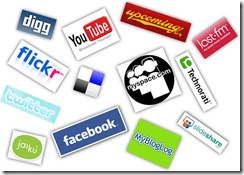 What a fantastic response we’ve had to our next social media training day in New Zealand, over 550 real estate agents are confirmed as attending the 2 sessions on the day, we still have room for a small number of additional places for agents who’d like to attend the afternoon session on Wednesday the 6th October.
What a fantastic response we’ve had to our next social media training day in New Zealand, over 550 real estate agents are confirmed as attending the 2 sessions on the day, we still have room for a small number of additional places for agents who’d like to attend the afternoon session on Wednesday the 6th October.Location is The Great Northern Room, Ellerslie Event Centre, Ellerslie Racecourse Auckland New Zealand, as I mentioned earlier the morning session is now fully booked, so the only session available is the afternoon session commencing at 1:30pm.
You can download the flyer with all the information on the sessions Social Media Training Day New Zealand Registration Form or you can book by faxing the completed registration form to 00617 5534 1046, you can also email your registration form to amazing@iangrace.com.au or info@mikeandrewconsulting.com
Room is limited, so the earlier you register, the more likely you’ll reserve yourself a place.
Your speakers for the day will include Ian Grace and Mike Andrew
-
Companies Struggle to Keep Social Media Content On-Message
Nearly three-quarters of blog posts don’t reflect corporate messaging
Marketers and other corporate communications professionals may sometimes feel they have a thankless task: carefully craft messages about their company’s thought leadership, social responsibility efforts and new product or service launches, only to find those messages distorted as they’re disseminated through the media.
PR and communications firm Burson-Marsteller analyzed more than 150 messages sent out by companies in the Financial Times Global 100 list of firms and discovered a large gap between the messages that went out and how they were covered on blogs.
Message distortion was highest for companies in Latin America and the US, with a global average of 69% of blog postings not reflecting the message companies were trying to send. According to the report, bloggers tended to include “opinions, personal experience, knowledge of competitors and products, and speculation.”

Distorted messages are not a new phenomenon; they have been a problem in mainstream media as well. Still, the message gap between companies and the traditional media is significantly smaller: Less than half of all messages in mainstream media failed to reflect company messages, and here the US performed above average.

But as blogs continue to grow in importance and become integrated in mainstream outlets, along with the growth of other forms of social media, the chances for message distortion are likely to be high.
One way companies can combat the message gap is to make the most of owned media. If companies create their own compelling content and distribute it across social networks, there is no room for such a gap. Bloggers are not likely to simply reprint such old-media items as press releases, but relevant branded content can attract links across Facebook, Twitter and the rest of the social web.
According to the “2010 Social Media Usage, Attitudes and Measurability” study from King Fish Media, HubSpot and Junta42, 73% of US companies with a social media strategy were using branded content they created in their campaigns. Such original content was considered the most important part of a successful social campaign, with nearly half of respondents calling it “extremely important.”
-
Live Chat with Mike now “Live”
 One of the things I love about the Internet and social media is the immediacy factor, and when I’m on line and I have a question or problem, I like being able to speak to a real person.
One of the things I love about the Internet and social media is the immediacy factor, and when I’m on line and I have a question or problem, I like being able to speak to a real person. So to that end, you can now chat with me live and get answers to any question you have about Internet marketing,social media,Blogging or SEO. All you need to do is look for the live chat box on my web site and it will tell you when I’m live on site.
All you need to do then is ask me a question and I’ll give you the answer or at least try to.
I’ll look forward to chatting with you.
-
Small Businesses Change Social Media Expectations
About a quarter of small businesses now marketing via social media
After climbing steeply, according to research from Network Solutions and the Center for Excellence in Service at the University of Maryland’s Robert H. Smith School of Business, small-business adoption of social media marketing has plateaued at 24%.
The study of US small business found that those that do market via social media primarily use Facebook (82%), and that the most common activities are maintaining a company page on a social network and posting status updates or links to interesting content. About half of businesses that used social media also monitored brand chatter on social networks.
As small businesses have gained experience with social media, some have realized their expectations for the channel did not line up with the reality of the social web. As the wider marketing world begins to look at social as more of a loyalty channel than one for acquisition, small businesses are also finding that their hopes for spreading brand awareness and attracting new customers have not been fully met. By contrast, somewhat fewer small businesses had expected to use social media as an engagement channel, but nearly two-thirds have had success in that area.

The most common business objectives small businesses have achieved through social media marketing tell a similar story: Customers are connecting with companies through sites like Facebook and LinkedIn, but relatively few sales leads have been received through the sites.

Small businesses have found other frustrations as well. Many say their efforts take up more time than they had expected, although that percentage dropped from 50% to 43% between December 2009 and June 2010, suggesting companies are being more realistic about what’s involved in social campaigns. At the same time, however, the percentage saying their business had been criticized online nearly doubled, reaching 29%. Still, just a tiny 1% of small businesses said their image was hurt more than it was helped by social media—a number that’s also down, from 6% in December.
-
iPad Owners Valuable to Advertisers
iPad owners demonstrate a number of demographic trends that make them valuable to advertisers, according to research from The Nielsen Company.
iPad Owners Skew Younger, Male
iPad owners skew younger and more male than owners of many other portable computing devices. Sixty-five percent of them are male and 63% of them are younger than the age of 35.In terms of likelihood to be male, the only device researched by Nielsen that even approaches the iPad is the Sony Playstation Portable (PSP), with 62% male ownership. In terms of age, iPad owners skew slightly older than iPod Touch owners (66% younger than 35) and PSP owners (68% younger than 35).
iPad Owners Open to Ads
iPad owners show rates of advertising receptiveness that are favorable compared to iPhone owners and overall connected device owners. In particular, iPad owners have positive response rates roughly double those of iPhone and overall connected device owners in the areas of clicking on ads that incorporate multimedia events, enjoying ads with interactive features, clicking on simple text ads, finding ads on their connected device new and interesting, liking to see what connected device ads can do, and enjoying viewing connected device ads.iPad Owners More Likely to Make Ad-related Purchases
Compared to overall connected device owners, after viewing a connected device ad, iPad owners are more likely to make a purchase via PC (36% compared to 27%), make a store purchase (24% compared to 10%), make a telephone purchase (12% compared to 7%) and make a direct purchase via connected device (8% compared to 5%).40% of iOS Device Users Make $75K-plus
In other good news for advertisers, about 50% of both iPad and iPhone users earn $75,000 or more annually, according to other recent Nielsen research. Within this income bracket, slightly more iPad users than iPhone users earn more than $100,000 annually.In contrast, about 30% of all mobile subscribers earn more than $75,000 annually, with a much smaller proportion earning $100,000 or more than the proportion of iOS device users. Divided into featurephone and smartphone users, the income demographics of featurephone users are similar to those of overall mobile subscribers. However, about 45% of smartphone users (which includes iOS device users) earn $75,000 or more annually, with roughly the same proportion earning more than $100,000 annually as iOS device users.
About the Data: Nielsen’s new Connected Devices Playbook surveys more than 5,000 consumers who already own a tablet computer, eReader, netbook, media player or smartphone, including 400 iPad owners.
-
Friday Morning Facebook Posts with Images Work Best
Facebook posts with images posted on a Friday morning offer marketers maximum effectiveness, according to a new white paper from social media management company Vitrue.
Image Attachments More Effective than Video, Text
Comparing posts with image attachments to those with video and text attachments, “The Anatomy of a Facebook Post” found that image posts received 22% more engagement than video posts and 54% more engagement than text posts. Video posts received 27% more engagement than text posts.While image and video being more engaging than text in Facebook posts is fairly intuitive, Vitrue analysts found image beating video in terms of effectiveness somewhat surprising. To explain this discrepancy, they cited image being easier and less time-consuming than video for the consumer to view and manipulate, as well as the difficulty of creating a high-quality video and problems many mobile Facebook users have viewing video.
TGIF
While most salaried professionals are happy to see Friday arrive, Facebook marketers should be even happier than most. Friday is the best day of the week to launch a Facebook marketing post.Friday Facebook posts produce 64% more shares, likes and comments than posts made on Sunday, the day of the week with the lowest engagement. Friday posts are also 13% more engaging than Saturday posts, 7% more engaging than Monday posts and 3% more engaging than Tuesday and Thursday posts.
High Noon Marks Drop in Post Effectiveness
Dividing the day into 12-hour time blocks, posts made in the morning (the first 12 hours of the day) get 65% more engagement than posts made in the afternoon, or second 12 hours of the day. Vitrue suggests this correlates with the theory that people check Facebook first thing in the morning before the day gets busy.Consumers Like Facebook Discounts
The prospect of receiving discounts is the number one driver for consumers to like a brand on Facebook, according to a new study from ExactTarget and CoTweet. Data from “Facebook X-Factors” shows that the highest percentage of consumers (40%) is motivated to like a brand on Facebook by discounts and promotions.Almost the same percentage (39%) is motivated by showing support for the brand. However, two other popular reasons – getting free samples or coupons (36%) and updates on upcoming sales (30%) tie into the discount/promotion motivation. Other popular drivers include staying informed about the activities of a company (34%), getting updates on future products (33%), and fun or entertainment (29%).
Education and interaction (13%) are the least-popular reasons to like a brand by a substantial margin.
-
Consumers Force Retailers to Adopt Social Strategy
Confusion about ROI, disagreement about performance indicators
For most web users, online shopping is not a fully social activity. A few leading-edge retailers have begun allowing transactions to occur on sites like Facebook, but social media users do not typically report starting a search for a product on social sites.
Still, they do use social networks and other tools like Twitter to discuss brands and products and to get advice and feedback from friends and family on potential purchase decisions—and retailers have noticed.
According to August 2010 data from Aberdeen Group, more than half of retailers felt they had been pushed into using social media because more consumers were using it as a primary shopping vehicle. The second-largest pressure causing them to adopt social media marketing was increased use by the competition.

Social networks are a clear winner of retailers’ attention. The top social media tools used by the retailers surveyed by Aberdeen included social networks (85%), microblogging (51%) and blogging (43%). In Q1 2010, the e-tailing group also found that social networks were the top community or social tool retailers used or planned to use in the next year; Facebook fan pages specifically were cited by 91% of respondents to that survey. Four in five used or planned to use Twitter, 72% blogs and 71% Facebook Connect. The e-tailing survey was conducted before Facebook introduced its “like” feature, which has also been widely adopted by retailers including Levi’s and Sephora.
But like many marketers in other industries, retailers don’t yet have a clear picture of what social media success will mean. The top key performance indicator respondents to Aberdeen’s survey looked at was the quality of consumer insights they gleaned from social efforts, followed closely by number of repeat visitors and quality of new sales leads.

The report noted that some disagreement on key performance indicators is to be expected, since their usefulness is likely to differ from retailer to retailer. “Retailers would be wise to explore which KPI provides the most value to the retailer, and use accordingly,” the report said.
-
Social Media Training Day Auckland NZ
 The next social media training day, this time for real estate agents will take place in The Great Northern Room, Ellerslie Event Centre, Ellerslie Racecourse Auckland New Zealand on Wednesday the 6th of October.
The next social media training day, this time for real estate agents will take place in The Great Northern Room, Ellerslie Event Centre, Ellerslie Racecourse Auckland New Zealand on Wednesday the 6th of October.The morning session is now fully booked, so the only session now available is the afternoon session commencing at 1:30pm.
You can download the flyer with all the information on the sessions Social Media Training Day New Zealand Registration Form or you can book by faxing the completed registration form to 00617 5534 1046, you can also email your registration form to amazing@iangrace.com.au.
The afternoon session is filling very fast as room is limited, so the earlier you register, the more likely you’ll reserve yourself a place.
Your speakers for the day will include Ian Grace and Mike Andrew
I’ll look forward to working with you on the day.
-
Ever thought of saving time and money and having a VIRTUAL ASSISTANT?
Guest post by Nikki Taylor, director of ICG Recruitment and Real Estate Jobs Search.
Ever thought of saving time and money and having a VIRTUAL ASSISTANT?
Do you know what a Virtual Assistant can do for you and your business?
So you have all of your paper work piling up, your databases have contact details that are not updated , business cards need loading into your database and you need emails sent, you have a presentation you have to prepare for tomorrow, and you need to organise that business trip for next week by end of the day, alongside the things you actually get paid for in your business!
Perhaps you should consider using a VIRTUAL ASSISTANT, your very own Personal Assistant to take over some of your non-paying to do jobs. We call them the $25 an hour jobs.
A Virtual Assistant or “your very own PA” is a self employed professional Administrative / Personal Assistant. A Virtual Assistant works from their own remote office and this normally would be from their own home to provide a range of virtual business support services, using technology such as phone, skype internet and email to communicate with you.
Just what can you ask a Virtual Assistant to do?
A Virtual Assistant can provide most of the same services as an onsite employee, but without the added expense to you or your employer. You can also work with a virtual assistant on a one off project, rather than ongoing, which is perfect in those busier times. I believe having your own Virtual Assistant means she or he gets to know how you work and starts to understand your needs very quickly.
Some common services your Virtual Assistant should do for you would include;
• Data Entry
• Word Processing
• PowerPoint Presentations
• Travel Arrangements
• Diary Management / Appointment making• Customer Service / diverting your mobile to assist your calls
• Event Planning
• Website Maintenance and Updates
• Database Management
• Online and Offline Marketing and Promotion
• Bookkeeping
• Mail outsWhat are the benefits of using a Virtual Assistant for your business?
There are a loads of benefits of using a Virtual Assistant and include such things as;
Saving valuable time and money, allowing you time to work on your business
No office space, equipment or software required.
No payroll tax
No super, sick and holiday pay
Only pay for time on task or per project, so only time actually spent working, they can record each 10 minutes
Support on an “as needed” basis. You can your Virtual Assistant on a full time, part time, casual basis or for a one off special project.
Ok, so just how much should you expect to pay for this kind of help?
The cost of using a Virtual Assistant can vary depending on the service required and the particular Virtual Assistant’s skills and experience. Virtual Assistants are generally paid by the hour and these arrangements need to be set up prior to the job description and requirements that are given to your Virtual Assistant.
But when you consider that you only pay for the time they are actually working on your job, which may only be 3 to 4 hours a week or 5 to 10 hours a week, or even a month, to do the roles that need to be done in administration that you just don’t have the time to do. These are tasks that on a daily basis you say to yourself, “ I shouldn’t be doing this I should be doing what I’m good at leave this administration work to some one else.” and you think about how much you could make per hour if you were just working on what you love and are good at, then you really need to consider this option. Free your time up more.
Who can use a Virtual Assistant?
Almost any kind of business can benefit from using a Virtual Assistant. ICG Recruitment want to see more Real Estate Agents and Principals using their own Virtual Assistant’s. ICG will match you with your own Virtual PA and the rest is up to you to delegate the work load.
How to work really effectively with a Virtual Assistant:
As you and your Virtual Assistant will be in different locations, (sometimes as remote as the other side of the country or even the world!) communication is the key part in any Virtual Assistant / Client relationship. You can Skype and email as often as required.
You will need to discuss things such as;
What is expected for the project, the timing, deadlines etc. So a really good and clear brief (explanation of what the job is that you want done) is essential. Be specific and make sure both of you understand the outcome. Indentify what sort of communication is best suited to you both e.g.; phone, email, instant messaging, skype. Computer programs and versions to be used that suit your requirements. Have a system to advise when a task is done without the micromanagement.
My Virtual Assistant – My story
I have employed two Virtual Assistants and both I have trained face to face and the rest is based on excellent communication, via phone and skype and email With a busy successful recruitment company for the Real Estate Industry we have been fortunate enough to obtain our latest Virtual Assistant that has also worked in the Real Estate Industry. In our first week she was onto it and enjoying the flexibility the role gave her and I was also enjoying the flexibility that she was always available. I do supply our Virtual Assistant with a blackberry giving them access to emails and unlimited use of phone calls. Our line of communication is through Email, Phone, Instant Messaging and Skype. Face to Face can be done if needed but do think of your time and productivity and most things can be done from the computer these days. Training on new software can also be done as one can access each other’s computer. I never go without saying a simple “ Thank You” for the work they do every day to make our life a whole lot easier.
Here are my five tips for working with a Virtual Assistant – my very own PA.
1. Be clear about what you want your Virtual Assistant to do
The first thing I did was a write down all the things I needed done that I don’t want to be doing, the things I want someone else to do, things I can delegate. If you cant delegate then you have some serious problems getting your self a VA, you need to learn to delegate the smaller jobs that makes your job easier. things I would like my VA to do for me. So now I have the list of jobs I need to be done now and the things I can get my VA to do as she/he gets to know the role. It was critical for our industry to have someone that understood the Real Estate Industry. Can make the role so much easier to delegate tasks.
This allowed me to find a Virtual Assistant that had skills and experience to match my requirements in our industry.
2. Communicate your personal quirks
As a Boutique Specialist so much about the way we run our business in comparison to the Corporate, we need to have someone understand our point of difference and why we like to respond to emails or communicate in certain ways. Our logo states “its all about attitude” and our VA needs to know all about that.
3. Be clear with instructions and deadlines
You must clearly define the task and deadline to your VA, therefore you will not have any confusion on when the job is required. Be specific about the hours you want your VA to spend on a task. .You also need to be clear and precise and clarify the understanding of each task. You are not there to oversee this and you do not need wasted time spent on one task. Remember, much of what you do is habit and you can’t assume someone else will think the same way you do.
4. Agree on a work flow process
Spend time in the early stages of your working relationship agreeing on work flow processes. How will you share information? How will you ensure things don’t slip through cracks or get double handled? How will you issue instructions – verbally or in writing? Will you send requests as they happen or save them up in batches?
Discussing these things up front will minimise the chance of things going wrong.
5. Be willing to let go – delegate*
Yes I like to do it all myself, however time doesn’t permit. As I have found my Virtual Assistants have worked so very well for me I now find it so much easier to delegate what needs to be done. . The most challenging thing for me was to let go of tasks and trust my VA to do a great job. I didn’t want to drive my VA crazy by always micro managing is it done etc .
On delegation – Say it with me now: It’s OK to delegate. It’s OK to delegate. It’s OK to delegate. Now if only doing it was as easy as saying it. When you’re a small business owner who prides yourself on doing everything on your own, delegation is hard. Your business is your baby and your blood; it seems unnatural to trust someone else to take over your responsibilities, I mean, surely, there’s no way they could do a task better or more thoroughly than you could, right? As your business begins to grow or you are putting in the long hours then it’s inevitable that you’ll have to become comfortable with delegating tasks.
Having a Virtual Assistant can be a wonderful addition to you and your business. Take the time to create the structures that will support it being a great experience for both of you.
Best of luck Nikki Taylor ICG Recruitment, The Recruitment Specialists for the Real Estate Industry
If you are wanting to know more about Virtual PA’s – Virtual Assistant’s then email Nikki at ICG Recruitment Nikki Taylor now at ICG Recruitment as we are launching this as a new service to the Real Estate Industry across Australia.
-
Brand Managers Use Online Video
Most brand managers currently use online video for marketing purposes and will increase their usage in the next 12 months, according to a new white paper from Brightcove and TubeMogul.
Most Brand Websites Feature Online Video
Findings from “Online Video & The Media Industry” indicate that nearly 85% of brand managers surveyed currently use online video on brand websites for marketing products and services. And for those not using video, 75% plan to add online video to their websites in the next 12 months.6 in 10 Brand Managers Will Up Online Video Spending
In addition, while brands currently devote a relatively small portion of their overall marketing budgets to onsite video initiatives (50% devote less than 10%, 23% devote less than 25%, and 22% devote between 25% and 50%), nearly 60% of respondents say they plan to spend more on their website video initiatives within the next 12 months. Only a fractional amount plan to spend less.Online Video Promotes Awareness
Two-thirds (66%) of brand managers surveyed said branding/awareness is the primary purpose of their online video initiatives. Another 21% use online video for direct response and lead generation, while 12% use it to drive e-commerce and sales initiatives.Online Video Aids E-commerce
Many of those using online video to drive e-commerce and sales initiatives find it highly effective at increasing customer engagement and time spent on the brand website (53%), as well as sales conversions (35%). Twelve percent say online video in e-commerce helps reduce product returns, customer service calls and shopping cart abandonment.Marketers Educate via Online Video
Video is well-used by marketers, mostly for educational purposes, according to a new study from King Fish Media, Hubspot and Junta 42. Data from “Social Media Usage, Attitudes and Measurability” indicates that 61% of marketers use video content on their own websites, while another 56% use video content on third-party video-sharing sites. This indicates that a majority of marketers are willing to sacrifice some measure of control over their video content distribution and management in order to reach as wide an audience as possible.Marketers also show limited openness to different video platforms. Thirteen percent use video content in emails, and 7% use video content on mobile devices. While the future of email is somewhat unclear, it seems fairly likely the percentage of marketers distributing video content via mobile device should substantially grow in the next several years.
-
Social Media Working Better for Retention Than Acquisition
Campaigns to acquire new customers have not taken off
Social media marketing has been around for several years, and as marketers begin to converge on best practices and use the channel in more uniform ways, it is emerging that their top goals are brand awareness and cultivating customer loyalty. Conversely, customer acquisition through social media is less important.
A July 2010 survey of US marketers by the Direct Marketing Association and COLLOQUY found that brand awareness was the most popular objective of social media efforts, followed by customer growth and loyalty.

A July eROI study similarly showed brand awareness was the top goal of US marketers using social media, and business-to-business (B2B) marketers reported the same to BtoB magazine and Business.com. In April, search marketers surveyed by MarketingSherpa cited increasing brand awareness and improving brand reputation as the two objectives for which social media marketing was most effective.
The DMA and COLLOQUY also looked at average marketer spending in various areas of social media marketing and how it changed over time. While marketers started out in 2008 spending similar amounts on branding, customer loyalty and customer acquisition, by 2009 customer acquisition budgets had failed to grow as quickly as the others. Customer acquisition budgets more than doubled twice between 2008 and 2010, but they still lagged behind the even more dramatic growth of spending in other areas.

The report noted that customer acquisition is a more important goal for smaller companies, which often use social media as an inexpensive marketing channel. Those companies are devoting budget to gaining new customers through social media, but by definition their budgets are small. They are overshadowed by large companies who have chosen social media primarily as a venue for cultivating customer loyalty and spend more heavily in that area.
-
Are Twitter Followers Better Than Facebook Fans?
Marketers looking to push out the most effective messages to opt-in recipients must understand how audiences differ across channels and what causes them to connect with brands. Marketing venues that seem similar may differ strongly if their users have different needs and motivations.
According to the final edition of ExactTarget’s “Subscribers, Fans and Followers” report, the differences between email, Facebook and Twitter also include their influence on customer loyalty.
Daily Twitter users who followed a brand were more than twice as likely as daily Facebook users who “liked” a brand to say they were more likely to purchase from the brand after becoming a social media follower. What’s more, Facebook fans were the most likely group to actively disagree with the question. Subscribers to opt-in marketing emails fell in the middle.

The pattern among Twitter followers, email subscribers and Facebook fans was similar when asked about whether they would recommend a brand. A third of Twitter followers said they were more apt to make a recommendation now that they followed a brand, compared with 24% of email subscribers and 21% of Facebook fans. Again, those who “liked” a brand on Facebook were most likely to actively disagree with the statement.

A February 2010 survey by Chadwick Martin Bailey also found that Twitter followers were more likely than Facebook fans to say they had an increased chance of buying or recommending the brands they connected with in social media.
These factors make Twitter followers attractive to marketers, but as the ExactTarget report notes, because of Twitter’s much smaller user base just 3% of US internet users follow a brand through the microblogging service. Those who do follow brands on Twitter are likely to be influencers in general, while Facebook users are more like the average consumer. And since Facebook users often become brand fans on the site because they are already fans in real life and want to use the brand as part of their self-image, it may be more difficult for them to actually increase their spending or advocate for the brand more than they did before “liking.”
-
The Influence of Mobile on Social Marketing’s Future
Mobile platforms and location-based networks could take social marketing to the next level
As the increase in smart device ownership helps put the mobile web in the pocket of more and more Americans, mobile will play a greater role in all forms of content consumption—including social media.
US marketers surveyed in June 2010 by PRWeek and MS&L Group believed mobile social would have important consequences for their brand. Asked which social media efforts would have the greatest effect on their company, 17% said more usage of social media on mobile platforms and a further 12% cited uptake of mobile location-based social networking.

Another 4% said investing more in Twitter would be their most important effort. While a majority of users access Twitter from their desktop, the microblogging service is a major example of greater use of social media from mobile platforms. According to the company’s blog, mobile usage of the site rose 62% in about four months, and mobile sign-ups increased from 5% of the total earlier in 2010 to 16%.
Currently, PRWeek and MS&L Group found that few US marketers were using specifically mobile-based social media tools, but the sophistication of smart devices has narrowed the distance between the desktop and mobile for many users.

Much of the marketing opportunity in going mobile lies with the ability to use location data to bring consumers timely messages when they are already nearby and possibly considering a purchase. Social media could prove a smart avenue for such efforts; while pure location-based services like foursquare remain relatively niche, Facebook has picked up location-based check-in services, and social networking has been the single biggest driver of mobile app usage and browsing over the past year.
-
How Social Media Is Changing Brand Marketing
Four in 10 brand marketers think social creates new challenges to maintaining brand integrity
Social media has changed much about how consumers communicate with one another, and has given them the ability to broadcast opinions about brands, products and services further than traditional word-of-mouth can reach. It has also meant something that can be scary for brands: Marketers are no longer fully in control of the message.
According to a study from branding agency MiresBall and KRC Research, 40% of brand representatives around the world felt social media posed new challenges to the integrity of their brand. More than a third said that social networking sites affected brands significantly enough to bring about changes in marketing strategy.

But with 500 million consumers reachable on Facebook, and a host of other networking sites, services like Twitter and the rest of the social web, the challenges may be worth it. More than half of brand representatives told MiresBall and KRC that social media gave them an opportunity to reach new customers.

Brand marketers were split on whether social media helped create brand loyalty, however. While 35% agreed, another 30% disagreed, with the remainder neutral on the question.
The research also found a disconnect in how marketers thought about their brands and how they tried to reach out to customers on social media. The vast majority of respondents agreed that the brand must define what a company or product is, and that message should be communicated via various PR and marketing channels, including social media, and that the most effective way to communicate about a brand was to stay true to its message. At the same time, marketers were willing to stray from that strategy—especially in the case of social media.
The report suggested that attempts to find superficial social success might be leading brands to create a presence on networks that did not fit with the brand’s personality or use other inappropriate campaigns in the hopes that one would go viral, even if it did not truly convey the brand’s message.
-
4 Out of 5 Internet Users in Australia Viewed Online Video in July
comScore, Inc. (NASDAQ: SCOR), a leader in measuring the digital world, today released its July 2010 rankings of the top video properties in Australia based on data from its comScore Video Metrix service. The report found that 81 percent of Australia’s Internet population viewed video online in July, with an average viewer watching more than 7 hours of video during the month.
“Online video has evolved to become an essential part of Australians’ daily web experience,” said Amy Weinberger, comScore vice president for Australia and New Zealand. “As advertisers look for ways to engage with consumers in an increasingly fragmented digital environment, online video offers the ability to reach large audiences in an engaging environment where ads tend to perform well.”
Google Accounts for More than Half of Online Video Market
In July, Internet users in Australia watched a total of 970 million online videos, with Google Sites ranking as the top video property with 539 million videos viewed, representing 55.5 percent market share. YouTube.com accounted for more than 99 percent of all videos viewed at the Google property. Microsoft Sites ranked second with 29.6 million videos (3.0 percent market share), followed by Facebook.com with 12.5 million videos viewed (1.3 percent market share).
Average Viewer Watched 90 Videos in July
In Australia, 10.7 million unique video viewers watched an average of 90.8 videos per viewer during the month. Google Sites also attracted the largest video audience with 8.5 million viewers during the month (64 videos per viewer), followed by Microsoft Sites with 3.3 million viewers (9.0 videos per viewer) and Facebook.com with 2.7 million viewers (4.7 videos per viewer).
Top Video Ad Networks by Potential Reach
In July, SpotXchange ranked as the top video ad network in Australia with a potential reach of 5.4 million viewers, or 50.7 percent of the total viewing audience. Adconion Video Network ranked second with a potential reach of 5.1 million viewers (48.1 percent penetration) followed by YuMe Video network with a potential reach of 4.1 million viewers (38.0 percent penetration).
-
Mobile Twitter Use Explodes
Mobile usage of the Twitter social network has increased more than 60% in the past five months, according to data from Twitter.
Mobile Twitter Usage Grows
The total number of mobile Twitter users grew 62% between April and September 2010, according to statistics compiled by Twitter. In addition, since that time, the number of Twitter users who start out using Twitter via mobile device has risen from 5% to 16%. Furthermore, close to half (46%) of all Twitter users at least occasionally access the network via mobile device.Twitter cites its April 2010 purchase of the Tweetie iPhone application, which it turned into the Twitter for iPhone app, as the catalyst for this explosive growth. In addition, Twitter has partnered with mobile OEM RIM on a BlackBerry app and also developed an Android app since that time.
Twitter.com Remains Top App
Tracking log-ins by unique Twitter visitors in the past 30 days, Twitter finds that the main Twitter.com site is still by far the most popular Twitter application, used by 78% of visitors (percentages add up to more than 100% because a single visitor may use multiple log-in methods).The mobile m.twitter.com site followed with 14% usage. Other popular mobile means of accessing Twitter included SMS and Twitter for iPhone (8% each) and Twitter for BlackBerry (7%).
Mobile Website, SMS Beat Smartphones
As this data shows, while smartphone clients are important, there are even more people who use the mobile Twitter web site and/or SMS for mobile Twitter access. In addition, third-party clients continue to play an important role for many people, with what Twitter terms a “disproportionate” amount of the traffic from Twitter running through such tools.Smartphones Drive Twitter Adoption in US and Europe
An analysis of Twitter usage via mobile for the six mobile markets currently reported by comScore (U.S., U.K., France, Germany, Spain and Italy) revealed that Twitter is gaining adoption among smartphone users.In the US, 8.3% of smartphone users (4.2 million people) accessed Twitter.com in a month via the browser on their mobile devices, outpacing each of the European markets. In Europe, 2.8% of smartphone users overall accessed Twitter.com (1.7 million users), with the UK experiencing the strongest penetration in the region at 5.8%, followed by Germany with 3.1% and France with 2.1%.
-
Social Networking Doubles Among Boomers and Seniors
More than a quarter of web users 65 and up now visiting social networks
Older web users are flocking to social networks, according to a May 2010 Pew Internet & American Life Project survey. Usage among internet users ages 50 and older nearly doubled during the past year, from 22% to 42%.
More specifically, 47% of 50-to-64-year-old internet users and 26% of seniors ages 65 and up indicate that they now use these sites, with Facebook and LinkedIn being the main beneficiaries of the more mature traffic.

These rates are fairly close to eMarketer predictions from April 2010, which estimated the largest jumps in social networking site usage would occur among the oldest users.
With even seniors catching the wave of social networking, the phenomenon’s mass appeal is undeniable for marketers. Facebook announced its 500 millionth user in June, and marketers have begun to pour real dollars into the channel. eMarketer estimates US ad spending on Facebook will rise to $1.1 billion next year, up from $835 million in 2010.

Pew offered three reasons for social networking’s appeal to older adults:
- They want to reconnect with people from their past.
- As a gathering place for multiple generations, social networks are useful to parents for learning about the lives of their children and grandchildren.
- People with chronic diseases are more likely to reach out to others online, and older people are more likely to have a chronic disease.
But those first two reasons are also a good indication of why young people may begin shying away from Facebook and having conversations elsewhere, if they haven’t already. Already hyper-vigilant about their privacy and what they share, young users may stop considering social networks cool when their parents join—let alone their grandparents.
Meanwhile, as teens and millennials grow up and enter the work force, instead of reconnecting, they may actually want to disassociate themselves from past immaturities and prying eyes in what is an increasingly public setting.
The mass appeal of Facebook is a boon in the short term for marketers looking for reach in an age of media fragmentation. But as the site tries to be everything to everyone, marketers included, that may prove to be too much for some, just as it was for MySpace.
-
Older Adults Double SocNet Use
US adults 50 and older have increased their social networking use from 22% to 42% in the past year, according to data from the Pew Internet & American Life Project.
Half of Adults 50-64 Use SocNets
Half (47%) of internet users ages 50-64 and one in four (26%) users age 65 and older now use social networking sites.Young adult internet users ages 18-29 continue to be the heaviest users of social networking sites like Facebook and LinkedIn, with 86% saying they use the sites.
Adults 65 and Up Double SocNet Adoption
During the past year, the growth of social networking adoption among internet users ages 18-29 paled in comparison with the gains made by older users. Between April 2009 and May 2010, internet users ages 50-64 who said they use a social networking site like MySpace, Facebook or LinkedIn grew 88%, and those ages 65 and older grew 100% in their adoption of the sites; compared with a growth rate of 13% for those ages 18-29.Older Adults Increasingly Share Daily Updates
The use of Twitter and other services to share status updates has also grown among older users, most notably among those ages 50-64. While just 5% of users ages 50-64 had used Twitter or another status update service in 2009, 11% now say they use these tools. On a typical day, 6% of online adults ages 50-64 make Twitter a part of their routine, up from the 1% who did so in 2009.One in five (20%) adults ages 50-64 say they use social networking sites on a typical day, up from 10% one year ago. Likewise, 13% of online adults ages 65 and older log on to social networking sites, compared with just 4% who did so in 2009.
Older Adults Maintain Interest in Email, Online News
Overall, 92% of those ages 50-64 and 89% of those ages 65 and older send or read email and more than half of each group exchanges email messages on a typical day. Online news gathering also ranks highly in the daily media habits of older adults; 76% of internet users ages 50-64 get news online, and 42% do so on a typical day. Among internet users ages 65 and older, 62% look for news online and 34% do so on a typical day.Americans Get News on Multiple Platforms
The overwhelming majority of Americans (92%) use multiple platforms to get news on a typical day, according to other recent findings from the Pew Internet and American Life Project. Americans get their news from a combination of on- and offline sources, including national TV, local TV, the internet, local newspapers, radio, and national newspapers. Six in ten Americans (59%) get news from a combination of online and offline sources on a typical day, and the internet is now the third most popular news platform, behind local television news and national television news.About the Data: The Pew Research Center’s Internet & American Life Project surveyed 2,252 US adults 18 and older between April 29-May 30, 2010.
-
How iPad Usage is Shaping Up
In the UK, 24% of iPad owners say it’s their primary entertainment device
With iPads now in the hands of millions, studies have begun to examine how the superhyped tablet is fitting into real life, and whether the opportunity for publishers and advertisers is as big as they hoped.
Qualitative research from Ball State University examined how attitudes toward iPads changed after owning one for 24 hours. According to the report, “A Play Date with the iPad,” study participants found the iPad was best for leisure activities. Content creation was too difficult on the device but ideal for content consumption.
iPad users were impressed with applications optimized for the device, especially iBooks, Apple’s ereader app. They emphasized its value as an entertainment device—which meant some were not as interested in owning one because they felt they did not have a need for a new entertainment-based screen. Some productivity-oriented participants considered the tablets inefficient.
In the UK, a survey by copywriting firm Cooper Murphy Webb found that iPad owners had taken to the device in a big way, also for entertainment purposes. More than two in five said they used the tablet at least 10 hours weekly, and almost a quarter said it had become their primary entertainment device, ahead of TV and trailing PCs by just 9 percentage points.

The iPad was considered the No. 1 delivery method for newspapers and magazines, and its popularity for books was even greater: 41% of iPad owners preferred to read on the device, vs. 36% who liked hard copies better. iPads were also the top gaming device for owners of the tablets, beating out consoles by 2 percentage points.

Most users didn’t find iPads very portable, though. More than 60% said they rarely or never took their iPad when they left home, while just 5% did so always.
The focus on content consumption rather than creation should be a boon for both marketers and publishers, who are hoping to generate revenues through app sales and ad support. With newspapers, magazines, books and gaming some of the top uses of the iPad thus far, the tablet is building the reputation content owners and advertisers hoped for as an entertainment-oriented device.
-
Mature Consumers Seek Edgy Brands
A growing audience of experienced, less-easily shocked, outspoken consumers appreciate brands that are a little bit more daring and outspoken, according to consumer insights firm trendwatching.com.
The Rise of ‘Maturialism’
trendwatching.com has dubbed this growing consumer trend “Maturialism.” According to trendwatching.com, consumers of today no longer tolerate being treated like yesteryear’s easily shocked, inexperienced, middle-of-the-road consumers. Able to handle much more honest conversations, unusual flavors and risqué experiences, these consumers increasingly appreciate brands that are pushing the boundaries a bit.Maturialism Part of ‘Brand Fabric’
trendwatching.com deems maturialism as part of a larger social trend it calls “Brand Fabric,” which is defined as brands truly needing to focus on how to move with the culture. In addition to pushing boundaries, Brand Fabric also entails serving customers in an innovative manner, recognizing the increasing sophistication and intelligence of the modern consumer, transparency and authenticity.‘Casual Collapse’ Fuels Maturialism
Casual collapse, or the ongoing demise of many beliefs, rituals, formal requirements and laws that modern societies once held, without predicted social annihilation, is a key driver of maturialism. Modern consumers are bored, if not distrustful, of the conventional consumer-producer relationship, and now look for brands and products that are more authentic, more human, and quite simply more mature.In emerging consumer societies, there’s an obvious link between the broad spread of more liberal attitudes and increasing urbanization. As new arrivals are ‘liberated’ from traditional social and familial structures, and are exposed to a wider range of alternative goods, services, lifestyles and experiences, their tolerance to (if not their interest in) these alternatives grow. trendwatching.com advises that casual collapse happens at a very slow pace.
Online Culture Supports Maturialism
More than 2 billion people worldwide are online. The resulting ‘online culture’ is intense and uninhibited. Mature consumers are uninterested in sanitized corporate websites and seek a more real online experience. Live, unscripted online events and webcasts that go beyond the limits imposed on TV broadcasts are two methods brands can use to take advantage of the mature online culture.Status Shifts toward Maturialism
Sources of status in mature consumer societies are moving beyond conspicuous consumption (see below). Increasingly sophisticated, increasingly wealthy, increasingly urban consumers are more try-out-prone, more demanding and more daring as they search for the next big thing to impress or discuss with people.Constantly exposed to, and increasingly tolerant of and enamored by modernity, today’s mature consumers positively embrace innovation, creativity and unconventionality when it comes to consuming products, services and experiences.
trendwatching.com further advises that pure shock without innovation or thought behind it is never a successful marketing device.
Status Moves Beyond Consumption
The definition of status is diversifying and moving beyond simple consumption, according to a previous trend briefing from trendwatching.com.Although the need for status is at the heart of every consumer trend, in mature consumer societies (such as the US), consumers are moving beyond owning the most and/or priciest items, according to Status is now also tied to less tangible symbols such as acquired skills, eco-credentials, connectivity and generosity.
Despite this shift, trendwatching.com says the lust for luxury will continue, especially in emerging consumer markets such as Brazil and Russia. In addition, consumers want to be “in the know,” to have deep and trivial knowledge they can share with less knowledgeable colleagues to gain status. Mobile applications that provide locations and other information serve this growing status need.
-
Can Twitter Turn a Revenue Trickle into a Stream?
 It’s been four months since Twitter announced its long-awaited Promoted Tweets advertising platform, so it seems a good time to assess the service’s initial campaigns.
It’s been four months since Twitter announced its long-awaited Promoted Tweets advertising platform, so it seems a good time to assess the service’s initial campaigns. Early participants included Virgin America, NBC Universal’s Bravo and Red Bull. Virgin America used Promoted Tweets to announce an expansion into Toronto and a 50%-off promotion for the first 500 travelers who flew from two California airports into the Canadian city. Adweek reported that the promotion sold out in 3 hours.
Bravo used Promoted Tweets to highlight an Earth Day promotion whereby consumers were invited to find out their “green IQ” on NBC Universal’s website. In 2 hours, the promotion hit 300 retweets, the maximum allowed under the program. And by the end of the first day, Bravo had received an estimated 200,000 impressions, according to a company representative. Red Bull did not provide metrics but reported “engagement rates … higher than typical cost-per-click and CPM advertising.”
It all sounds positive, but to put these numbers in perspective, 500 tickets does not seem like a huge volume for an airline the size of Virgin America, especially considering that the routes involved the most populous state in the US and the largest city in Canada.
The same could be said of Bravo’s promotion. Its site received more than 1.1 million unique visitors in May 2010, according to Compete. That 300 of them retweeted the Earth Day promotion does not point to a huge success. And the company did not give details of what it meant by “impressions.” Similarly, Red Bull’s statement of high “engagement rates” was nonspecific. And none of the companies revealed how much they spent on the promotion.
All of this translates to a service that’s flapping its wings but has yet to take flight. When you consider that Facebook is on track to produce $1.3 billion in ad revenue this year, Twitter has lots of catching up to do to monetize its audience.
But there is hope. The three top motivators for US Twitter users to follow companies are to get updates on future products, to stay informed about the activities of a company and to receive discounts and promotions, according to an ExactTarget study. If brand marketers can use Promoted Tweets creatively to achieve these goals, they will find a receptive audience at the other end of the Twitter stream.

Twitter also launched its @earlybird Exclusive Offers program. This is a Twitter account that tweets limited-time deals and discounts from participating advertisers to users who follow the account. Twitter has teamed up with some of its potential competitors in the online deal space, including Groupon and Gilt Groupe.
Disney used @earlybird to promote its film release “The Sorcerer’s Apprentice.” The movie opened July 16 to mostly negative reviews and is already considered a flop, so it’s not a good barometer of the effectiveness of @earlybird to get the word out about a film premiere, or any other product launch for that matter.
A better gauge of @earlybird’s early momentum is the number of followers. In its first month as an active account, it has already racked up 164,000. As more companies experiment with the service, some of them are bound to hit pay dirt. This should create a virtuous cycle of more consumers jumping on board, thereby enlarging the addressable audience for future promotions.
The question is whether Twitter can use these platforms to transform itself from a social phenomenon to a revenue generator before its investors run out of patience. It will take some big success stories to turn these baby steps into giant strides.
-
Most Companies Have Social Media Strategies
Three-quarters of companies currently have a social media marketing strategy, according to a new study from King Fish Media, Hubspot and Junta 42.
Companies Have or Will Have Strategies
As mentioned above, about three-quarters (72%) of companies currently have a social media marketing strategy. Of the 27% without a social media marketing strategy (1% were undecided), 80% plan to have one within the next 12 months. Furthermore, only 11% of companies without a strategy definitely do not plan to implement one in the next 12 months, with 9% undecided.Investments Will Grow
Another three-quarters of companies (75%) plan to increase their social media investment in the next 12 months. As with the previous question, a high percentage of respondents (13%) don’t know, with only 12% definitely not planning to increase social media investment.One-third of Increases Tied to Specific Project
Of companies planning a social media spending increase, about one-third (35%) are tying it to a specific project or custom media program. Another third (33%) will make social media an incremental marketing budget increase.One-fifth of respondents (21%) will fund social media spending increases from their moving budgets, while 11% don’t know how the increase will be allocated.
Marketers Take Part-time Social Media Responsibility
In a solid 70% majority of companies, social media is a marketing responsibility. Twenty-three percent place social media on the shoulders of management. The remaining 7% assign social media to sales, IT, or don’t know.In 90% of companies, managing social media is a part-time job mixed in with other responsibilities.
Marketers Promote Whole Company to New and Existing Customers
Two-thirds of companies surveyed (67%) use social media to promote the company as a whole. Another 41% promote specific individuals (more than one response permitted), while 24% promote a specific brand.In scope, most companies (70%) target social media campaigns to both new customer acquisition and customer retention. However, of companies that only target one of those groups, far more target new customers (23%) than existing (4%).
Social Media ROI Varies
Marketers use a wide array of metrics to measure return on investment (ROI) from social media campaigns, according to other survey results. Quantitatively, almost all (93%) measure the number of visitors/page views, while 85% measure the number of fans/followers generated. Another 79% measure the traffic generated to the corporate site from social media.Qualitatively, 84% measure increased dialogues with prospects and customers, while 68% measure how much existing customer relationships were strengthened.
-
Facebook users warned of ‘Dislike’ scam
Computer security firm Sophos on Monday warned that scammers are duping Facebook users with a bogus "Dislike" button that slips malicious software onto machines.
There is no "Dislike" version of the "Like" icon that members of the world’s top social networking website use to endorse online comments, stories, pictures or other content shared with friends.
Hackers are enticing Facebook users to install an application pitched as a "Dislike" button that jokingly notifies contacts at the social networking service "now I can dislike all of your dumb posts".
Once granted permission to access a Facebook user’s profile, the application pumps out spam from the account and spreads itself by inviting the person’s friends to get the button, according to Sophos.
The ruse was described as the latest in an ongoing stream of tricks that includes baiting booby-trapped links with messages including "the biggest and scariest snake" and "world’s worst McDonald’s customer".
-
Social Network Ad Spending to Approach $1.7 Billion This Year
6.7% of all US online ad spending to go toward social networks this year
Social network advertising is getting renewed attention in 2010. The US’s gradual economic recovery, combined with marketers’ incessant focus on reaching consumers in social media, has led companies to make big increases in social network ad spending in the first half of 2010.
eMarketer estimates US advertisers will spend $1.68 billion on social networking sites this year, a more than 20% increase over 2009. Spending will rise even further by 2011 to more than $2 billion.
In December 2009, eMarketer forecast $1.3 billion in social network ad spending for 2010. Strong performance from online ad spending in general, and Facebook in particular, has resulted in the increased forecast.

Facebook will receive half of all social network ad spending in the US while MySpace continues to diminish in importance. Twitter, which finally launched its ad business earlier this year, is incorporated into eMarketer’s forecast for the first time. While spending on the microblogging service will be low in 2010, the potential for 2011 and beyond could be dramatic if it proves that its “resonance” model of measuring advertising effectiveness works.
Spending on social network advertising will grow even more quickly elsewhere in the world. In 2010, eMarketer estimates just over half of social network ad spending worldwide will come from the US, but 2011 will bring a reversal in that proportion.

Another important development in the social network space is the role of online social games and applications. Advertising is not a primary revenue stream for game companies such as Zynga or Playdom, but their large audiences are drawing the interest of marketers. eMarketer expects such companies will attract $293 million in spending worldwide in 2011, up from $220 million in 2010.
-
Few Consumers Interested in Tablet PCs
Only 11% of global online consumers currently own or have interest in tablet PCs, although the Middle East shows far greater interest, according to a new study from The Nielsen Company.
MEAP Interest Almost Double Global Average
“How We Watch” indicates that regionally, the Middle East, Africa and Pakistan (MEAP) area has a substantially greater interest/ownership rate for tablet PCs than the worldwide average. MEAP scores 182 on the Index of Ownership + Definite Purchase Intent for Tablet PC by Region, meaning online consumers there have an interest level 82 percentage points higher than that of worldwide online consumers as a whole.Latin America scores 109 on the index, showing slightly higher than average interest in tablet PCs. Asia-Pacific and Europe both come in slightly below average with scores of 91 each, while North America lags considerably with an index score of only 73.
Top 3 Nations from MEAP
As would be expected, the individual nations with the three highest Index of Ownership + Definite Purchase Intent for Tablet PC by Market scores are all located in the MEAP region. Pakistan leads with a score of 209, followed by Saudi Arabia (200) and Egypt (191).Somewhat surprisingly, an Asia-Pacific nation, Taiwan, ties Egypt for third place on the index. Venezuela, a Latin American nation, follows with a much lower score of 173. Interestingly, two European countries, Italy and Germany, tie with the Asia-Pacific nation of India for the next spot with scores of 155.
The US has an index score of 82, while its northern neighbor Canada significantly drags down the overall North American regional index score with a market index score of 55. Two European nations, Finland and Hungary, tie for last place with anemic index scores of 27.
-
What Makes Social Media Trustworthy?
Venues and relationships affect how social media users perceive advice
One thing that makes social media marketing powerful is consumers’ trust in “people like them”—their friends, family and other online peers. Marketers want to tap into that trust through the power of earned media or by engaging in a conversation with consumers, but where social conversations take place has an effect on their perceived trustworthiness as well as who is taking part in them.
A study of frequent social media users by market research firm Invoke Solutions found that the most trusted information was posted by people respondents knew. But blog posts were more likely to be trusted “completely” than posts on Facebook, and trust dropped off sharply when it came to Twitter, even among friends.
Postings by brands or companies were trusted less, but levels were similar whether companies posted to Facebook or blogs. Online community sites did not hold the same trustworthiness as Facebook or blogs, whether postings were made by companies or fellow members, and respondents had an even more skeptical eye for independent bloggers. And across all categories of content creator, Twitter streams were trusted less than other media.

Asked to rate what was most important to making social sites trustworthy, users’ top concerns were that the dialogue be open to both positive and negative comments, the quality of content and the responsiveness of the content creator. These all point to best practices for companies participating in social media, which must show they are willing to deal with consumer complaints in a constructive way and be authentically involved in the conversation with social site visitors.

Some other seeming signs of authenticity mattered less to users, however, including length of participation and number of participants.
-
Twitter Use More than Doubles
Usage of Twitter has more than doubled in the past year, according to new data from comScore.
In June 2010, nearly 93 million internet users worldwide visited Twitter.com. This marked an increase of 109% from the previous year, as the social networking site achieved strong gains across all global regions.
Latin American Twitter Use Increases Sixfold
An analysis of the five major global regions revealed that Latin America experienced the strongest audience growth between June 2009 and June 2010, surging 305% to 15.4 million users. Asia Pacific ranked as the second-fastest growing region, climbing 243% to 25.1 million visitors. The Middle East and Africa jumped 142% to 5 million visitors, while Europe soared 106% to 22.5 million visitors.North America, where Twitter has reached a higher maturity level than other regions, saw a growth of 22% to nearly 25 million visitors in June 2010.
Indonesia, Brazil, Venezuela Boast Highest Twitter Penetration
Across the 41 individual countries currently reported by comScore, Indonesia had the highest proportion of its home and work Internet audience visiting Twitter.com (20.8%). Brazil ranked second with 20.5%, followed by Venezuela at 19%. With Venezuelan President Hugo Chavez joining Twitter in late April 2010, Twitter.com penetration in the country spiked 4.8 percentage points in a few months.The Netherlands (17.7%) and Japan (16.8%) rounded out the top five, while countries in Latin America and Asia Pacific represented many of the remaining top markets, including the Philippines (14.8%), Mexico (13.4%) and Singapore (13.3%).
Canada ranked seventh with 13.5% Twitter.com penetration, while the US ranked 11th with 11.9%.
Smartphones Drive Mobile Twitter Adoption in US and Europe
An analysis of Twitter usage via mobile for the six mobile markets currently reported by comScore (U.S., U.K., France, Germany, Spain and Italy) revealed that Twitter is gaining adoption among smartphone users.In the US, 8.3% of smartphone users (4.2 million people) accessed Twitter.com in a month via the browser on their mobile devices, outpacing each of the European markets. In Europe, 2.8% of smartphone users overall accessed Twitter.com (1.7 million users), with the UK experiencing the strongest penetration in the region at 5.8%, followed by Germany with 3.1% and France with 2.1%.
Twitter Has Higher Global Reach for Women
Twitter has a marginally higher reach among women than men globally, according to another recent study from comScore. “How Women Are Shaping the Internet” indicates that despite Twitter’s status as a new technology, which is typically tried earlier by men, on a global level, more women are using Twitter. Among all women age 15 and older, Twitter had a reach of about 7% in April 2010, compared to a reach of roughly 6.5% among men age 15 and older. -
Social Media Training Day Kuala Lumpur & Singapore
 I just wanted to say what a buzz we all had at the Trueventus Social Media MBA that took place last week in Kuala Lumpur and Singapore. The team on both days were really involved and participated in each session making them very enjoyable from my point of view as the presenter of the sessions.
I just wanted to say what a buzz we all had at the Trueventus Social Media MBA that took place last week in Kuala Lumpur and Singapore. The team on both days were really involved and participated in each session making them very enjoyable from my point of view as the presenter of the sessions.As you can see from the attached photo we all really enjoyed each of the 4 sessions on the day and I look forward to more of the same in the not to distant future.
The next round of sessions take place in Fiji on the 23rd and 24th August with our 3 day MBA for Marketing professionals course in Dubai kicking off on 19th to 22nd of September.
Fiji is full but there is a small number of places left for the Dubai sessions, to book or to get a brochure outlining the 3 day event, please visit the following link http://www.trueventus.com/event.php?intid=12
I hope to see you there.
-
Men More Mobile
Men hold a dominant share in usage of many mobile technologies, according to a new study from comScore.
Men Make Up 6 in 10 US Smartphone Users
“How Women Are Shaping the Internet” indicates that in both the US and Europe, smartphone usage is dominated by men. In the US, there is a fairly consistent 60/40 split, but in Europe the skew toward male users is slightly more pronounced, hovering around 63% compared to 37%.comScore analysis suggests that the greater likelihood of men to be early technology adopters may explain at least part of this gender imbalance. However, comScore also says that a propensity for men to be higher wage-earners, as well as a greater share of men who have at least part of their mobile phone bill paid by their employer, could also contribute to higher male usage of more expensive smartphones.
Mobile Net Services Skew Male
Mobile Internet services (browsing, apps, and email) skew 65-70% male. However, some activities, such as playing mobile games, making ringtones, and listening to music, skew more female.Mobile social networking has fairly even gender usage, with women accounting for about 45% of mobile social networking activity. It is also the activity with the youngest participants, averaging 29 years old, compared to an average age of 32 for mobile games (which skews about 50% female). Unsurprisingly, more expensive activities tend to have users with an older average age, and are also more likely to skew male.
Mobile Internet Demographics Reflect Cost
The age difference between PC and mobile Internet users is indicative of the need for money when browsing on the mobile device (e.g., advanced device and data plans). Women’s adoption of mobile social networking, however, is a clear indicator that mobile Internet services are moving out of early adopter mode and into the mainstream.Men Spend More Time Viewing Online Video
Although gender rates for viewing online video are similar, men spend more time watching, according to other results from “How Women Are Shaping the Internet.” The study indicates that in nine countries and Hong Kong, virtually the same percentage of online males and females watch online video. In every instance, roughly 80% of both online men and women watch online video.While rates of watching online video are similar, and in some areas women actually watch at a slightly higher rate, in all 10 areas researched by comScore men spend much more time on average watching online video than women.
In the US, men watch more than 15 hours of online video per month, roughly triple the average time spent by women. Similarly wide discrepancies exist in the other three countries where online video consumption is the heaviest: Canada, Germany, and the UK.
-
Heavy Twitter Users Bring Social Activity to New Heights
Daily users comment and upload content at least twice as much as average
eMarketer estimates there are 26 million monthly users of Twitter in 2010. That makes users of the microblogging service a relatively small minority of internet users, at 14.6%, and daily users are naturally even fewer in number. But their voice is disproportionately loud.
According to ExactTarget, daily Twitter users are highly active across the social web. They are about three times as likely as internet users on average to upload photos, four times as likely to blog, three times as likely to post ratings and reviews, and nearly six times as likely to upload articles.

They create, share and comment on content at high rates, making them valuable to marketers for much more than their potential influence on Twitter alone.
“Consumers active on Twitter are clearly the most influential online,” said Morgan Stewart, principal at ExactTarget’s research and education group, in a statement. “What happens on Twitter doesn’t stay on Twitter. While the number of active Twitter users is less than Facebook or email, the concentration of highly engaged and influential content creators is unrivaled—it’s become the gathering place for content creators whose influence spills over into every other corner of the internet.”
ExactTarget also explored Twitter users’ motivations for following companies and brands on the service. In a deeper drilldown into consumer sentiment than previous research has conducted, the April 2010 study supported the general findings that microbloggers have many reasons to follow brands they like. While discounts and sales are toward the top of the list, finding out news and information about the company and its products come out ahead.

According to 360i, 75% of marketers’ tweets are informational, suggesting brands are responding to what consumers want—though they largely neglect to participate in conversations. Such deeper engagement might help them harness the power of frequent Twitter users across their other social activities as well.
-
Social Sites Get People Talking, but Marketers Must Earn Trust
Word-of-mouth may not translate to loyalty
Social media is a hot topic in marketing circles, but many consumers are also discussing the trend, which accounts for nearly 23% of time spent online in the US, according to Nielsen.
An April 2010 survey conducted by Harris Interactive for the Online Publishers Association (OPA) found that social media sites were the most talked-about on the web, ahead of portals and top media sites that are members of the OPA in discussions on a wide variety of channels.

All those conversations, whether in person, via email, on the phone or elsewhere on the web, however, don’t make social site visitors loyal—internet users expressed the least loyalty for such properties, compared with portals or OPA member sites. They were also most likely to say social sites were not a very good fit for their information and entertainment needs.
The OPA’s findings are in line with the annual customer satisfaction report from ForeSee Results that found Facebook among the most disliked sites on the web after its many disagreements with its own user community and several privacy debacles.

According to the OPA, negative feelings about social sites may also apply to the brands that advertise there. Only 8% of internet users felt social media site advertisers were reputable, compared with a 21% average for content sites. They also felt advertising on social sites was less relevant and the companies that did so were less respected.
The answer for brands is to continue a greater focus on non-advertising marketing activities, engaging on the social media user’s terms. And marketers should remember that while loyalty to individual social properties may be low and site users dissatisfied, the activities that have come to define social media— connecting with friends and family and sharing information and content with a trusted group—will remain important in the lives of millions of internet users and continue to provide avenues for brand engagement.
-
Twitter Followers Seek Info, Value
Twitter followers are most interested in receiving information about a brand or extra value, according to a new study from digital marketing firms ExactTarget and CoTweet.
Followers Want Return for Following
“Subscribers, Fans and Followers: Twitter X-Factors” indicates the largest single percentage of Twitter users who follow a company, brand or association on Twitter are motivated to do so by a desire to get updates on future products (38%). Another 32% want to get more information about the activities of a company.Following these two informational reasons, the next-highest percentage of Twitter users follows a company to receive discounts and promotions (31%). Thirty percent want to get information on upcoming sales, and 28% want to receive “freebies” such as coupons and samples.
Most of the other reasons for following a company on Twitter have some type of informational aspect (such as learning more about a company, 25%, and learning about company topics, 14%). Viral marketers have some work to do, as only 23% want to show support of a company to others and only 20% want to interact with a company.
The most popular reason to follow a company on Twitter with no direct informational or financial benefit is for fun and entertainment (26%).
Daily Twitter Users Contribute Socially
While a relatively low percentage of Twitter users follow a company to spread its praises, daily Twitter users are highly social in terms of general online information-sharing. For example, 80% of daily Twitter users comment on photos and videos, compared to 38% of other consumers.Similar wide disparities exist across a range of online social activities, with notably high percentages of daily Twitter users engaging in activities such as uploading photos (76%), posting to forums (75%), blogging (70%), and posting ratings and reviews (61%).
Engage Daily Twitter Users
ExactTarget says the key to successfully integrating Twitter into overall marketing strategy is to not approach this channel as a way to maintain direct relationships with the majority of customers. Instead, ExactTarget advises companies commit to serving customers who do use Twitter on a daily basis. They control and influence the content that others are reading about a brand—which can directly impact the bottom line. And if marketers use Twitter appropriately with this important audience, they can add depth and character to customer relationships.Twitter Has Higher Global Reach for Women
Twitter has a marginally higher reach among women than men globally, according to a new study from comScore. “How Women Are Shaping the Internet” indicates that despite Twitter’s status as a new technology, which is typically tried earlier by men, on a global level, more women are using Twitter. Among all women age 15 and older, Twitter had a reach of about 7% in April 2010, compared to a reach of roughly 6.5% among men age 15 and older.In the US, Twitter’s reach has followed a less consistent pattern, with Twitter’s reach among men slightly less than 12% in April 2010, fractionally higher than its reach among women.
-
Twitter Has Higher Global Reach for Women
Twitter has a marginally higher reach among women than men globally, according to a new study from comScore.
Twitter Reaches More Women 15-plus
“How Women Are Shaping the Internet” indicates that despite Twitter’s status as a new technology, which is typically tried earlier by men, on a global level, more women are using Twitter. Among all women age 15 and older, Twitter had a reach of about 7% in April 2010, compared to a reach of roughly 6.5% among men age 15 and older.Twitter’s reach growth among women and men globally has followed an even pattern, reaching less than 1% of both genders in November 2008 and growing at a steady pace among both genders, with women maintaining a slight lead the entire time.
Men Outpace Women in US
Globally, women slightly outpace men in adoption of Twitter, but this varies greatly by region and country. In the US, Twitter’s reach has followed a less consistent pattern, with women initially leading men in November 2008 (reach among both genders was approximately 1%), and the genders then trading the lead several times up to April 2010, when Twitter’s reach among men was slightly less than 12%, fractionally higher than its reach among women.In contrast, Twitter has had a notably higher reach among Australian women since April 2009 (6% to 5%). In April 2010, Twitter reached more than 7% of Australian women, about one percentage point higher than its reach among Australian men.
The difference is even more pronounced in Singapore, where as of April 2010 Twitter reached 14% of women but only about 10% of men. Gender trends in Germany, Japan and the UK more closely resemble global trends.
Women Find Promotions
In the US, there are fairly significant differences in how men and women use Twitter. For example, 16% of women use Twitter to find sales, deals and special promotions, compared to 12% of men. Women are also more likely to use Twitter to follow celebrities (18%-14%) and converse with other users (18%-16%).On the other hand, men lead in using Twitter for activities such as posting their own tweets (38%-29%), finding breaking news (23%-13%), and following favorite sports teams (15%-8%).
Women Do More Social Networking
Social networking sites generally reach a higher percentage of women than men globally, according to other results from this study. “How Women Are Shaping the Internet” indicates 75.8% of all women online visited a social networking site in May 2010, compared to 69.7% of men. Globally, women demonstrate higher levels of engagement with social networking sites than men.Although women account for 47.9% of total unique visitors to the social networking category, they consume 57% of pages and account for nearly 57% of total minutes spent on these sites.
-
Geolocation Grows Despite Privacy Concerns
Two in five mobile owners use location-aware services
As some marketers wonder about the possible audience for check-in services like foursquare, which reached 2 million users and 100 million check-ins in July 2010, mobile owners are getting used to sharing their location in many ways regardless of their privacy worries.
According to a survey by security software company Webroot, 39% of social network users who own a mobile internet device use geolocation.
But there was widespread concern over the loss of privacy, the possibility of being hacked on an unsecured network and other safety issues. Women tended to be more worried than men, and younger users less concerned than their older peers.

Still, many smartphone owners are taking advantage of the features location-aware services can offer. The most popular activity was letting friends know where they were, done by 19.2% of respondents at least daily. More than 15% of respondents reported checking in at locations at least daily.

Among younger adults ages 18 to 29, those percentages were higher: 24.5% and 17%, respectively. In that age group, men were about twice as likely to participate in the activity daily than women.
The most popular geolocation apps included Google Latitude, used by about three in 10 respondents. Flickr, which geotags photos, and Google Buzz were each used by about two in 10. Twitter, which geolocates tweets, was popular with fewer than 15% of respondents, while about half as many used foursquare.
Forrester Research also found men and younger adults dominated the location-based landscape. That study, of the wider group of US internet users, found that only 4% had used check-in apps like foursquare, Gowalla and Loopt, and only 1% checked in at least weekly.
Smartphone users who are already interested in social activities are at the leading edge in geolocation, and despite concerns of their own may pave the way for a larger audience to feel comfortable sharing where they are.
-
Social Media Training Courses
 The next full day Social Media training course for CEO’s and Marketing Professionals takes place on Wednesday the 4th of August at the Park Royal Hotel Kuala Lumpur,followed by Friday the 6th of August in Singapore at the Novotel Clarke Quay.
The next full day Social Media training course for CEO’s and Marketing Professionals takes place on Wednesday the 4th of August at the Park Royal Hotel Kuala Lumpur,followed by Friday the 6th of August in Singapore at the Novotel Clarke Quay.Other dates include Dubai on the 21st September 2010, bookings now available.
Your presenter for these informative marketing and social media seminars is Mike Andrew.
For more information or bookings please visit this link http://www.trueventus.com/
-
Energy star ratings in disarray
 LABOR’S push to cut greenhouse gas emissions through the use of energy efficiency schemes was yesterday dealt another blow when building industry heavyweights discredited the star ratings being applied to hundreds of thousands of homes.
LABOR’S push to cut greenhouse gas emissions through the use of energy efficiency schemes was yesterday dealt another blow when building industry heavyweights discredited the star ratings being applied to hundreds of thousands of homes. Investigations by the building industry have found that the mandatory star ratings scheme is inaccurate and fundamentally flawed.
The Housing Industry Association and Master Builders Australia yesterday joined scientists in calling for urgent action by the Department of Climate Change and Energy Efficiency to resolve problems that are potentially having an impact on more than 100,000 houses built each year.
They said owners were not aware that mandatory software tools — used to calculate whether a planned new house could achieve the minimum five-star energy efficiency rating necessary to obtain approval for construction — gave vastly different results for the same house under identical conditions.
It is another setback for the government while it is still trying to quell criticism after the shelving of its emissions trading scheme, the disintegration of the home insulation program and green loans scheme, and the subsequent findings that both were fatally flawed, costing lives and taxpayers’ money due to poor planning and execution.
It also comes after Labor’s latest environmental announcements — the 150-person citizens assembly to forge a national consensus on action on climate change and the cash-for-clunkers green car replacement scheme — were widely criticised.
Opposition climate change spokesman Greg Hunt said last night that the government could not get its environmental programs right.
"We saw that with pink batts, green loans and cancelled solar programs," Mr Hunt said.
"They need to explain why home owners and builders face this confusing and potentially costly mess.
"They should release all material on this to the public before the election."
Flaws in the star rating system emerged after industry bodies, private companies and scientists commissioned independent studies showing significant variations were being calculated by the three different software tools when tested on identical dwellings.
The results show that the three software tools, including the original model designed by the CSIRO, were inherently unreliable.
The star ratings system was rolled out nationally several years ago and recently extended to older houses.
The findings mean that in some cases houses that should be failing the energy efficiency test are being approved and built, while identical houses are going back to the drawing board for changes and costing their owners more time and money to get right.
It also means the stated objective of the federal government to cut greenhouse gas emissions in houses is in serious question.
Faulty software tools will have a greater impact from next year when the federal government’s national energy strategy requires all homes being sold or leased to be star-rated and for the rating to be disclosed.
Older dwellings, which will not achieve the five- or six-star minimum, may be punished financially by buyers and tenants.
The findings add weight to the concerns of energy efficiency experts that star ratings are a multi-billion-dollar debacle.
Peter Jones, chief economist of Master Builders Australia,
said yesterday: "We have independent expert evidence showing us this is a real concern and it needs to be brought to light and addressed.
"There are unacceptable differences between the star ratings produced by the software tools when assessing the same house.
"We are drawing a line in the sand and saying, ‘Look, the research is overwhelming now; something must be done’, Mr Jones said.
The authorities need to come up with a solution so that consumers can be confident in the star ratings and the tools.
"As builders, we do not really care (what the tool is) but we think it is bad policy when it is not working properly."
Housing Industry Association senior executive director Kristin Tomkins said the association’s independent testing, which showed significant differences in energy ratings, including a variation of 3.2 stars for the same Brisbane house, were troubling and undermined the scheme’s credibility.
She said builders and home owners needed confidence in the mandatory energy efficiency programs that cost them time and money.
Industry sources called for an Australian Competition & Consumer Commission investigation and said some savvy energy assessors were "gaming" the star ratings and making a mockery of the scheme by switching software tools until one delivered the required result.
The Department of Climate Change and Energy Efficiency, which has recently joined the CSIRO in investigating problems with the gauges, has said it was "premature to say there is any significant impact on overall house ratings or compliance costs".
Source: The Australian newspaper
-
Fewer Women Online Spending More Time
Women account for slightly fewer than half of global internet users but spend more time online than men, according to a new study from comScore.
Women Account for 46% of Global Web Users
“How Women Are Shaping the Internet” indicates that globally, women represent 46% of internet users age 18 and up. However, this percentage varies by region. For example, women represent 50.4% of North American internet users.North America has the highest percentage of its adult internet-using population represented by women. In Asia Pacific (42.1%), Europe (47%) and Latin America (48.1%), women are still underrepresented.
Broken down by individual country, Singapore, the US, New Zealand, Russia and Canada have the highest proportion of adult female web users – all with 50% or more. Countries with the lowest proportion of female web users include two countries where internet penetration is still extremely low – India and Indonesia, with 28 and 35%, respectively.
Asia-Pacific Has Most Female Web Users
Asia is undoubtedly the largest regional online market, and is still growing rapidly. Women online in Asia outnumber women in North America by more than two to one. China alone accounts for more women online than all of North America and, together with Japan, South Korea and India, account for more women online than Europe, according to comScore figures.In Most Regions, Women Spend More Time Online
The average 15-plus female spends 8% more time online than her male counterpart. In April, the global average was 24.8 hours per month for women, compared to 22.9 hours for men.Looking at time spent by women 18 and up compared to men of the same age by region, Asia-Pacific has the widest gap. Women spend an average of 17.9 hours per month online, 7.2% more than the 16.6 average hours spent online by men.
North America is the one region where men spend slightly more time online per month than women. Men average 38.6 monthly hours, 2.6% more than the average 37.6 monthly hours spent online by women.
Women spend more time online than men in Europe and Latin America, but the gap is narrower than in Asia-Pacific. European women spend an average of 26 hours a month online, 3.8% more than 25 hours spent by men. In Latin America, women average 27.1 monthly hours online, only 1.5% more than 26.7 monthly hours average by men.
Women Do More Social Networking
Social networking sites reach a higher percentage of women than men globally, according to other comScore study results.“How Women Are Shaping the Internet” indicates 75.8% of all women online visited a social networking site in May 2010, compared to 69.7% of men. Globally, women demonstrate higher levels of engagement with social networking sites than men. Although women account for 47.9% of total unique visitors to the social networking category, they consume 57% of pages and account for nearly 57% of total minutes spent on these sites.
Women spend significantly more time on social networking sites than men, with women averaging 5.5 hours per month compared to men’s four hours, demonstrating the strong engagement that women across the globe share with social sites.
-
Marketers Put More Lead Gen Budgets Online
Online channels most effective—especially when rigorously measured
Lead generation budgets were slashed by many companies in 2009, but now that the economy is on the uptick again, dollars are flowing and acquiring new customers is a priority.
According to the “2010 Lead Generation Optimization Key Trends Analysis” from CSO Insights, more than 91% of companies worldwide reported increasing new customer acquisition was one of their top strategic marketing objectives for 2010.
Based on the quantity and quality of leads generated, companies said email was their best lead generation program, followed by live events, website registrations and webinars. The effectiveness of online channels, coupled with the fact that prospects indicate the web is the first place they look for more information, makes it natural for companies to be increasing their investments in web design, email marketing and search engine optimization.

Investments in new media are also on the rise, even if it remains less effective than more traditional channels.
At the same time, the web was the area companies were most likely to say needed improvement in its ability to execute lead campaigns. For many marketers, there has already been significant improvement: 51% said the web did not meet expectations in 2010, compared with 68% who said the same in 2009.

In addition, marketers’ ability to measure their own success affected whether they thought the web was an effective channel. Among those companies that had not adopted a lead generation management system, 65% were dissatisfied with the performance of web-based lead generation efforts. But among marketers that did have a system in place to track leads, only 37% agreed—putting the web on par in effectiveness with traditional media advertising and ahead of direct mail or telemarketing.
“As more lead generation efforts shift to the Internet, tools to help develop, execute, and track campaign effectiveness will become a ‘must have’ rather than a ‘nice to have,’” said the report.
-
Antisocial Social Media: The British Monarchy Joins Flickr
 For such a classical institution, the British Monarchy has tried surprisingly hard to be tech and social media savvy in recent years, but it has failed to embrace the “social” side of the term. The latest example of that is the royal family’s Flickr account, which just launched with hundreds of photos.
For such a classical institution, the British Monarchy has tried surprisingly hard to be tech and social media savvy in recent years, but it has failed to embrace the “social” side of the term. The latest example of that is the royal family’s Flickr account, which just launched with hundreds of photos.
The Monarchy’s profile hosts images new and old, ranging from a wedding photo featuring Queen Victoria and Prince Albert to more recent photos from the Queen’s visits to New York City and Canada. There are even photos of the Queen as a baby. Each member of the family has his or her own set of photos, and there are a few more general sets such as “Latest News” and “Royal Events.” The categories match those found at the family’s website.Buckingham Palace already maintains a Twitter profile, and it launched a YouTube account a couple of years ago. The Twitter account has a little bit more than 50,000 followers. It’s not used conversationally, of course; it’s merely a publishing platform for links to news stories and updates on the website.
The YouTube channel is a bit more interesting (though no more engaging) because it features interviews, speeches and documentary coverage of the activities and travels of the royal family. The videos are all promotional or informative in nature, and comments are disabled.
According to the AP, officials have said that bloggers are welcome to embed and share the photos from Flickr, however the images are watermarked “© Press Association” and no Creative Commons leeway is given. As is also the case with YouTube, you can’t comment at the royals’ Flickr account.
It’s interesting to see an institution so immersed in tradition embracing new and social media, but unsurprisingly, that embrace is a measured one. The propriety of distance is maintained even in the digital realm. Aren’t they missing the point?
Story by Samuel Axon Mashable
-
Google nabs patent to monitor your cursor movements
Google has been awarded a patent for displaying search results based on how you move your mouse cursor on the screen.
While it sounds initially bizarre, Google’s plans are to monitor the movements of the cursor, such as when a user hovers over a certain ad or link to read a tooltip, and then provide relevant search results, and ads, based on that behaviour.It means that it does not require users to actually click a link to know that they were interested in it, opening a world of opportunity for even more focused ads, which are Google’s main source of income.
The patent, entitled System and Method for Modulating Search Relevancy Using Pointer Activity Monitoring and numbered 7756887, was filed on February 16 2005, but it was only this month that it was published and released to the public. It is also a continuation of a previous patent filed in December 2004.
Whether or not this means Google is actively pursuing this idea remains to be seen, but it seems likely that this is its intent. Google certainly has the resources and manpower to put it into action and can justify the cost involved with the potential revenue made through a more refined ad network.
One potential problem that may arise with this technology, however, is privacy. Again. Exactly how will Google monitor mouse movements? Currently its statistics and analytics are based on actual clicks.To monitor the cursor would require potential invasion of privacy by stepping off the web itself and into the user’s browser.
It may avoid such problems by writing code into its search engine tooltips, which, when they pop up, will send Google information that a tooltip has been used, which, in turn, will let it know that a user has moused over it. If it does not take this or a similar approach it may end up in more hot water over privacy concerns.

Read more: http://www.techeye.net/internet/google-nabs-patent-to-monitor-your-cursor-movements#ixzz0uXmCRCog
-
Facebook membership hits 500 million
The number of people using Facebook has hit the 500 million mark, meaning one in every 14 people on the planet has now signed up to online social-networking service.
"As of this morning, 500 million people all around the world are actively using Facebook to stay connected with their friends and the people around them," Facebook founder Mark Zuckerberg said in a blog post.
"This is an important milestone for all of you who have helped spread Facebook around the world."
To celebrate, the California firm introduced an application that lets members of the online community "tell the incredible stories of the moving and interesting ways they’ve used Facebook."
Examples given by Zuckerberg included NATO Secretary General Anders Fogh Rasmussen jogging with Facebook fans during his term as Danish prime minister and a US woman using the service to battle breast cancer.
"Our mission at Facebook is to help make the world more open and connected," Zuckerberg said.
"Stories like these are examples of that mission and are both humbling and inspiring. I could have never imagined all of the ways people would use Facebook when we were getting started 6 years ago
-
Facebook Earns Poor Customer Satisfaction Marks
Leading social media site Facebook earned a poor American Customer Satisfaction Index (ACSI) E-Business Report score in 2010, according to analysis by ForeSee Results.
Facebook Below Generally Poor Social Media Scores
The aggregate social media ASCI score in 2010 was 70, placing it well below leading industries such as personal care and cleaning products (85). However, Facebook scored a 64, making it one of 10 companies out of 223 included in the ASCI index to score below 65 (including fellow social media site MySpace).Furthermore, Facebook and MySpace were two lowest-scoring online companies out of 30 included in the index.
Despite Complaints, Facebook Remains Popular
When asked why they didn’t like Facebook, survey respondents gave answers including privacy and security concerns, the technology that controls the news feeds, advertising, the constant and unpredictable interface changes, spam, navigation troubles, annoying applications with constant notifications, and functionality.However, Facebook remains extremely popular, with 9% of all US website visits and 55% of all US social media visits. ForSee analysis indicates reasons for this include Facebook’s large existing user base, a skew toward dissatisfaction with older internet users, provision of benefits despite poor customer service, and user investment in the site in terms of storing personal photos and videos.
Wikipedia Earns Praise, Less Frequently Used
Wikipedia leads the social media pack with the highest ASCI score (77). When asked what they liked best about Wikipedia, survey respondents most frequently mentioned ease of use, and the variety, depth, and breadth of information available. When asked what they like least, most respondents answered that either there was nothing they didn’t like about the site, or the credibility of user-generated information.Wikipedia users are less frequent visitors when compared to other social media sites and tend to visit weekly or monthly, rather than daily. About one in five (20%) Wikipedia users visit daily (compared to the 57% of Facebook users who visit Facebook daily), but Wikipedia still enjoys a fairly loyal customer base, with a total of 65% of users visiting weekly or more often. Wikipedia also receives high marks for its lack of advertising.
Social Media Not a Major Product Recommendation Source
Social media does not appear to be a significant source of product recommendations for most internet users. Of the four social media sites covered (Facebook, MySpace, Wikipedia and YouTube), YouTube had the highest percentage of respondents say they seek out recommendations of products and services, 17%. There was little differentiation among the four social media sites in this area, with MySpace coming in last only three percentage points behind (14%).Even fewer internet users have actually purchased a product or service based on a social media recommendation. YouTube also leads the four social media sites in this area, with 14% of respondents indicating they have purchased a product or service based on a YouTube recommendation.
There is a little more of a gap among the four social media sites in terms of the percentage of internet users who have actually made a recommended purchase. MySpace is also at the bottom of this ranking, with only 8% of respondents having made a purchase based on a MySpace recommendation.
SocNet Reviews Most Influence Younger Adults
A recent survey by Harris Interactive shows social network reviews of products as having a more substantial affect on purchase behavior, especially among younger adults. When asked how much reviews from friends or people they follow on social networking websites influence their decision to use or not use a particular company, brand or product, 45% of online adults said they have a great deal or fair amount of influence.Broken down by age demographic, social network reviews are most influential on 18-to-34-year-olds (50%). This percentage drops with each advancing age group, hitting its lowest rate (37%) among adults 55 and older.
About the Data: The American Customer Satisfaction Index is a national economic indicator of customer evaluations of the quality of products and services available to household consumers in the US. Data from interviews with approximately 70,000 customers annually are used as inputs into an econometric model to measure satisfaction with more than 225 companies in 45 industries and 10 economic sectors, as well as more than 130 federal government departments, agencies, and websites.
-
Boomers Spend Money, Use Tech
The Baby Boom Generation is still responsible for a substantial portion of consumer spending and is technologically sophisticated, according to new data from The Nielsen Company.
Boomers Spend 38% of CPG Dollars
An estimated 78 million Baby Boomers, defined as those born between 1946 and 1964, currently reside in the US. This population segment spends 38.5% of CPG dollars. Yet it is estimated that less than 5% of advertising dollars are currently targeted towards adults 35-64 years old (which includes the latter half of Generation X, those born between 1965 and 1976, in addition to Boomers).With most marketers generally targeting 18-49 year olds, more than half of the affluent Boomer demographic is ignored entirely. It is worth noting that Nielsen data shows Boomers dominate 1,023 out of 1,083 consumer packaged goods categories.
Boomers Watch TV, Employ Technology
Boomers watch one-third of all TV content consumed in the US. In addition, defying stereotypes of older people being out of touch with technology, Boomers:- Watch the most video: 9:34 hours per day.
- Comprise one-third of all online users, social media users and Twitter users.
- Time-shift TV more than 18-24-year-olds (two hours and 32 minutes a month compared to one hour and 32 minutes a month).
- Are significantly more likely to own a DVD player.
- More likely to have broadband internet access at home.
Boomers Have Similar Web Tastes to Younger Adults
Baby Boomers have similar tastes in internet sites to adults aged 18-34. Of the top 10 sites favoured by 18-to-34-year-olds, eight are shared by Baby Boomers. Both demographics rank Google and Yahoo as their top and second-favourite sites, respectively. Baby Boomers rank Bing third and Facebook fourth, while 18-to-34-year-old reverse this order of favouritism.The two sites Baby Boomers rank in their top 10 which 18-to-34-year-olds do not are Ask.com (ninth) and Amazon.com (10th). In comparison, 18-to-34-year-olds differ in their preference for Fox Interactive Media (eighth) and Apple (ninth).
Pat McDonough, SVP, insights, analysis and policy at the Nielsen Company, said Baby Boomers should be as desirable for marketers as Millennials (ages 15-32) and Gen-Xers (ages 33-44). “As the US continues to age, reaching this group will continue to be critical for advertisers,” said McDonough.
Boomers like Savings Tied to Spending
In previous analysis, Nielsen advised that Baby Boomers tend to be big spenders who like monthly or quarterly cash-back savings programs that reflect spending levels. The upsell can be pursued into prescription medications, insurance, gifts for grandkids and kids, entertainment, travel, even discount wines by the case.In addition, Boomers are big online shoppers, comfortable using email and messaging to stay in touch. Twitter is a huge untapped outlet for reaching Boomers, who increased utilization 469% during 2009. Reach one and you can reach their entire follower base with product info and special offers.
-
Companies Throw Their Weight Behind Online Video
Most of the attention in the online video space has focused on either media content and consumers or marketers and video advertisements. But companies continue to push further into this realm with non-advertising content.
Recent studies have shown that growing numbers of retailers are adding video capabilities to their sites. Surveys of Fortune 500 companies also indicate a broad-scale increase in the use of video for marketing purposes. In this sense, video has gone from a luxury to a near necessity for companies seeking an edge in marketing their products. From home-goods merchants to automobile manufacturers, companies across a wide spectrum are finding ways to use video in their marketing efforts, and consumers are embracing—sometimes demanding—these changes.
Retail is a sector where online video is becoming more important for driving sales. When asked by Multichannel Merchant to identify rich media features that they used, 46% of US multichannel retailers picked video, making it the highest-ranked category in the survey. Another 42.3% of respondents said they planned to add video capability in the next year.

Several studies point to increased use of video by US companies. According to Forrester Research, the percentage of the top 50 US online retailers that offer videos on their sites skyrocketed to 68% in 2009 from 18% in 2008.
Marketers are on board with more than just ecommerce applications, as well. A study led by the Society for New Communications Research noted 31% of Fortune 500 companies with public-facing blogs used video blogging in 2009, up from 21% in 2008.

Ad-ology asked US marketing executives whether they would increase, decrease or make no changes in their 2010 marketing budgets for social and traditional media. Nearly 27% said they would increase their online video budgets for viral clips and podcasts, while 5.5% would decrease their budgets. Out of the remainder, 41% would leave the budget intact and another 27% said they did not use video. These responses put video ahead of mobile marketing and search optimization as budget priorities for US marketing executives.
As eMarketer’s Tobi Elkin noted in the report “Consumer Packaged Goods Sector Taps into Online Video,” “Creating an online video presence helps marketers facilitate an ongoing dialogue with consumers, boost brand equity, lure prospective customers and solidify support among brand loyalists.”
On the receiving end of these marketing efforts, consumers are accessing increasing amounts of video on multiple platforms, from laptops and home PCs to smartphones and tablets. As these devices continue to penetrate the market, consumers will expect ubiquitous access to video content. Examples might include watching product videos at the point of sale or viewing a portion of a podcast on a PC and resuming the session on a tablet. Marketers are aware of the potential and are upping their game in a variety of sectors.
-
More Businesses Finding Customers on Social Sites
Smaller companies most successful at social acquisition
While many marketers struggle with how to measure social media marketing return on investment, some businesses are finding at least one hard metric where their efforts have paid off—customer acquisition.
According to a February–March 2010 survey from office services firm Regus, smaller companies see the most success, with nearly half of small businesses around the world having acquired a customer through social networks. Large companies were less successful, but more than a quarter had seen social success through customer acquisition. This was despite large companies being more likely to devote budgets to social marketing.

The survey of senior managers and business owners from around the world found customer acquisition varied by country, with the US coming in the lower half of the pack. Overall, 40% of businesses studied had acquired a customer through a social site, but only 35% of US businesses said the same.

“While the most popular function of these networks remains that of keeping in touch with contacts, businesses are also successfully acquiring new customers, supporting their retention efforts and interacting with customer groups,” said Sande Golgart, vice president at Regus, in a statement. “Organizations who have not yet ventured into the world of social networking may be missing out on sizeable business opportunities.”
In January 2010, Hubspot found that more than 40% of companies using social media marketing had acquired a customer through the channel. The Regus survey, which was not limited to businesses using social marketing, suggests that number may be slowly climbing.
-
Google Sites Tops List as Most-Visited Property in Asia Pacific
In May 2010, Google Sites ranked as the most-visited property in the Asia-Pacific region, reaching 270 million unique visitors during the month, followed by Microsoft Sites with 218.5 million visitors and Yahoo! Sites with 205 million visitors. Baidu.com Inc. and Tencent Inc. secured the fourth and fifth most-visited positions with 177 million visitors and 174 million visitors, respectively.
In terms of engagement among the top 20 most-visited properties, Tencent Inc. ranked as the most-engaging property with visitors averaging 6.5 hours on the site during the month, consuming 716 pages of content and visiting the property an average of 39 times. Facebook.com also witnessed strong engagement, with visitors spending 3.5 hours on the social networking site and visiting more than 21 times throughout the month.
Top Destinations Vary Across Markets
An analysis of the most visited Internet properties in each of the 13 individual Asia-Pacific markets revealed differing brand preferences across countries. Google Sites led as the most-visited property in India, Indonesia, Malaysia, Singapore and Vietnam, while Yahoo! Sites attracted the most visitors in Hong Kong, Japan and Taiwan. Microsoft Sites led the market in Australia reaching 93 percent of online users. Local entities topped the list in China and South Korea, with Tencent Inc. and NHN Corporation reaching the largest percentage of Internet users. In the Philippines, Facebook.com reigned as the most-visited destination reaching 93 percent of online users, the highest penetration of any global market for the social networking site.
-
Most Businesses Use Social Nets for Hiring
Nearly three-quarters of companies recruit on social sites
Online job boards and third-party search firms may be losing out to social media when companies search for new employees, based on June 2010 research from recruiting platform Jobvite.
Nearly three-quarters of companies surveyed were using social networks for recruiting, and 58.1% said they had successfully hired a candidate found through a social network.

LinkedIn was the top social network looked to for hiring, used by nearly 80% of companies recruiting through social media. It also provided the most success, with about 90% of companies who had hired through a social network reporting they found the candidate on LinkedIn. While Facebook and Twitter were used for recruiting by about 55% and 45% of companies, respectively, they led to far fewer hires: 27.5% for Facebook and 14.2% for Twitter.
Success in this area is leading almost half of employers to increase recruiting program spending on social media. At the same time, more than a third of companies were lowering spending on job boards and search firms.

March 2010 data from online job board Monster.com painted a somewhat different picture: 42% of companies surveyed said social networks were useful for recruiting college students, while 82% said large, all-purpose online job boards&mash;such as Monster.com—were useful.
That study also found that only about a quarter of companies were advertising entry-level positions on social sites.
“While the economy begins to recover, companies looking to make new hires are seeking the most cost-effective, efficient ways to find new talent,” said Dan Finnigan, president and CEO of Jobvite, in a statement. “Job boards launched a revolution in recruiting more than 15 years ago. And now, social networks are doing the same—but in a targeted way. Through social recruiting, companies are learning they can find the best talent efficiently, without making a major investment.”
-
Why Many Teens Are Moving on from Facebook
The main reason? They just lost interest
There’s no question of Facebook’s position at the top of the social networking space, and one thing that makes the site so powerful is that when it comes to social networking, a user’s friends must be users too. But among some teens, Facebook may be losing its stickiness.
According to a study from OTX and virtual fashion site Roiworld, nearly one in five teens with a Facebook profile had decreased or discontinued their use of the site as of April 2010.
What’s more, the decreases seemed to speed up in recent months, with two-thirds of the lapsed users having turned away from the site in the past six months.

In addition, 9% of teen internet users said they had a Facebook profile but had completely abandoned it.
This turnover does not approach the level of MySpace, where 22% of teens had completely stopped using a profile. YouTube and Twitter both sported relatively high 15% abandonment rates.
In Facebook’s case, decreased usage does not appear to be related to the privacy issues raised in spring 2010, or even to the influx of older users on the site. Instead, the plurality of lapsed users simply find the site boring.

Keeping fickle teens’ interest will be important both for Facebook and the marketers who want to connect with them there. Social games, which most consider a cheap way to relax, have fun and kill some time while playing with friends, are one solution. According to the report, 73% of teen internet users play some kind of social games, and 81% of teen Facebook users play games on Facebook. And the time spent doing so can add up: Facebook gamers reported spending 7 hours a week on the activity.
-
Government backflips on net filter
The federal government has again delayed the introduction of its proposed mandatory internet filter while a review of classified material is undertaken.
While the review is under way three of Australia’s largest internet service providers have agreed to voluntarily block online child pornography material.
Communications Minister Senator Stephen Conroy says some people are obviously concerned about whether current classified material reflected community views.
Legislation to impose mandatory internet filtering would therefore be delayed until the review was completed, Senator Conroy said.
Labor’s moves to block access to material such as child pornography and other illegal content have been criticised by some of the world’s largest providers of internet services including Google and Yahoo.
Senator Conroy announced on Friday that Telstra, Optus and Primus will block a list of child abuse URLs – internet addresses – compiled by the Australian Communications and Media Authority.
However, representatives from Telstra and Optus would not say unequivocally whether they supported the government’s proposed internet filter.
The telcos agreed to block child porn material from being accessed by Australian internet users while that review of Refused Classification (RC) content was under way.
"We support the review that was announced today, we support and are willing to voluntarily commit to the blocking of the ACMA list of child pornography sites and we’ll continue to work constructively with the government as it undertakes this review," Telstra public policy and communications director David Quilty told reporters in Melbourne.
Mr Quilty said the blocking process was expected to take several months to get up and running.
Optus government and corporate affairs director Maha Krishnapillai said the telco had agreed to filter child pornography where it could.
"We’ll have to wait and see what the review comes out with, but we’ve said all the way through this is about blocking the worst of the worst," he said.
RC content includes child abuse material, bestiality, rape and other extreme violence and terrorist acts.
Senator Conroy remained adamant that the internet filter proposal did not amount to censorship.
"I don’t think any Australian actually tries to describe blocking child pornography or bestiality or pro-rape websites as censorship," Senator Conroy told reporters in Melbourne
-
Gillard to push ahead with web censorship
 A change of Prime Minister is not enough to kill off one of the most stupid ideas of the 21st century.
A change of Prime Minister is not enough to kill off one of the most stupid ideas of the 21st century.It had been thought that when Julia Gillard took over the Australian government that she would allow a little bit of common sense to happen in Aussie politics.
However, it seems that Gillard is cut from the same mold which believes that Australians are precious snowflakes who need protection from the rest of the world.
According to the Sydney Morning Herald, she is going to press ahead with plans to filter the internet Chinese style and cut Australians from a stream of information that the government thinks is too dangerous for them.In Julia Gillard’s first comments on the filter since becoming Prime Minister, she told ABC Radio in Darwin that the proposal was an effort to control the dark side of communications technology.
Again she drummed up the image of child porn and abuse which she claims you are able to see on the Internet but for some reason cannot see in a movie theatre. No we didn’t get the link either.
Gillard indicated that the Communications Minister, Stephen Conroy, might tweak parts of the proposed filter before it is introduced. But given Conroy’s own spittle reactionary approach to web censorship is legendary, Australians who actually want to use the Internet like ordinary citizens of the world will probably have to vote the Labour government out.
Unfortunately the Australian opposition has yet to announced that it is against the filter. It seems that the government feels that there is a chance here to control citizens through net use and although the opposition does not want to be the one to make the unpopular move, it also sees the advantage of not dismantling it.
After all, what government would not like to control the information that citizens get on contentious issues such as abortion and human rights?
Gillard admitted that there were technical concerns that Conroy’s filters will slow the Aussie internet down and will take away legitimate use of the internet.
Gillard’s comments have won backing from the Christian group FamilyVoice Australia.Spokeswoman, Ros Phillips, said she was ”delighted” the government’s position was being maintained.
However given that christian groups in Australia look at the internet as created by Satan as a method to draw people to the anti-christ we can’t see how they can be taken seriously.
There had been hopes that Gillard’s rule of the Labour Party would be a move to common sense. However it appears that she is exactly like her predecessor. Hopefully the Australian people will show that they do not want this sort of censorship in their lives and vote against any party that tries to bring it in. Don’t hold your breath though.
Story by Nick Farrell www.techeye.net
-
Who Spends Most Time on Facebook?
How age, income and ethnicity affect time spent social networking
The Nielsen Company reported in June that, on average, the global consumer spends about 1 in every 4.5 minutes online on blogs or social networking sites. According to a report by market researcher Morpace, among US Facebook users time on Facebook rises to 1 in 3 minutes spent online.
Unsurprisingly, despite Facebook’s growing appeal to older users, 18- to 34-year-olds spend the most time on the site per week, at 8.5 hours out of 22.4 spent online. Weekly Facebook time drops to 4.6 hours among users ages 55 and older, representing a lower proportion of that group’s average of 21.5 hours per week on the internet.
Broken down by race and ethnicity, Morpace found Facebook usage heaviest by Asians. Not only did that group spend the most hours per week on the site, but they also devoted the greatest percentage of their weekly internet time to Facebook (39.6%, compared with 35.1% among blacks, the second-highest group). Hispanics spent the fewest hours on Facebook, and even compared with their low average time online came in last.

While the Morpace report showed a decline in both total time online and time on Facebook as incomes rose from less than $50,000 up to $100,000, affluent Facebook users making at least $100,000 annually spent the most time on the site and on the web as a whole.

In Q1 2010, comScore found that the visitors who spent the most time on Facebook also spent the most money online. Targeting users who not only spend large amounts of time on the site but also devote a large proportion of their total online activity to the social network could translate to going after the most lucrative portion of the audience.
-
Joint Venture expands real estate network in US
A large California based real estate brokerage with more than 700 agents has announced a joint venture with a major international real estate franchisor this week.
Altgera Real Estate is forming a new company, Harcourts Pacific, with New Zealand based franchisor Harcourts International which has more than 630 offices and more than 4,000 agents in nine countries including New Zealand, Australia, South Africa, China, Fiji, Indonesia, Zambia, and Singapore.
Altera marks the company’s first venture in the United States, adding 23 independently owned offices and more than 700 agents to the franchise’s network. Real Trends ranked Altera Real Estate as No. 101 of the 500 largest brokerages in the country by sales volume in 2009.
Financial details about the transaction were not disclosed, though Mike Green, managing director for Harcourts International, said in a statement, ‘As a 50% shareholder in the US joint venture, Harcourts will have a heavy focus on the American market throughout 2010, as long term plans are put in place for further expansion in the country’.
Both Harcourts International and Altera Real Estate are part of the Leading Real Estate Companies of the World (RELO) organization.
Gary Thomas, one of Altera’’ founders, had met Harcourts executives more than a decade ago, and the franchise company first approached him about a partnership to expand into the US about five months ago, said Dennis Badagliacco, Altera’s president and now president of Harcourts Pacific.
He, his wife Colleen, and Thomas founded Altera in 2008. Both Colleen Badagliacco and Thomas are former presidents of the California Association of Realtors.
All Altera offices will retain their current branding, except any new materials ordered will have ‘a Harcourts company’ added next to the Altera name, he said. Altera asked to retain that branding as part of the deal. Any new franchises the company opens will be branded as Harcourts, he added.
‘We’ll be able to expand services in a geometric way for our agents. Right now, we have one person that handles agent interactions, marketing packages, and then does some educational classes,’ Badagliacco said.
From the Academy, agents ‘can learn to be an agent, in management, or a broker owner. (The agents) are going to take classes equivalent to college classes. There’s no other company in the world that does that that we know of,’ Dennis said.
‘For the training of agents, they don’t have just these one day seminars. They actually have classes in REOs, things like that. We had all of the same things, but didn’t have the volume or the depth that they did,’ he said.
Brokers will also get one on- ne training monthly, he said. Harcourts will also give agents free iPhone and iPad applications to work with. These will include an app for property search and for transaction management as well as listing presentations that can be given on an iPad, Badagliacco said.Original story from Propertywire.com
-
Facebook U.S. Growth Stagnates in June

After growing by 7.8 million new active U.S. users in May, Facebook growth stagnated in June, adding only 320,800 new users.
Total number of active U.S. users now stands at 125,000,000.
According to Inside Facebook Gold, which offers Facebook data and analysis, it is not unusual to see a saturated country like the U.S. take a breather after a growth spurt.
Slightly less users in the 18-44 demo – which represents Facebook’s largest age demographic – were active on Facebook in June, compared to May. While the loss in that demo could be just a blip, it could also be the result of backlash from heavy media attention to Facebook’s privacy issues – some of which were real and others, Inside Facebook claims, the result of confusion and sensationalism.
The ages that logged the losses in June were those most likely to have listened to the privacy debates.
More Facebook Stats
- Facebook has more than 400 million active users
- 50% of its active users log on to Facebook in any given day
- Average users have 130 friends
- People spend over 500 billion minutes per month on Facebook
- The average user is connected to 60 pages, groups and events
- The average user creates 70 pieces of content each month
- More than 25 billion pieces of content (web links, news stories, blog posts, notes, photo albums, etc.) are shared each month.
-
Digital Migration Hurts Traditional Media Revenues More than Expected
The ongoing migration to digital media is damaging traditional media categories more than expected, according to a new white paper from PriceWaterhouseCoopers.
Digital Migration Slams Publishing, Radio
The annual decline in 2009 revenues in several traditional media categories was more severe than originally forecast, according to PriceWaterhouseCoopers research. Most striking was the decline in out-of-home revenues, which fell approximately 13% in 2009, compared to a forecast of about 7%. In addition, radio revenues declined about 9%, compared to an approximately 7% forecast.The other two media categories which had a 2009 revenue decline more severe than originally predicted by PriceWaterhouseCoopers were newspaper publishing (approximately 12% compared to a forecast of slightly more than 10%) and consumer magazine publishing (about 11% compared to a forecast of about 9%).
Most Digital Categories Grow Beyond Expectations
In contrast, most digital media categories which experienced annual revenue growth in 2009 increased more than originally forecast. Most significantly, internet advertising revenues, which were predicted to decline about 3% in 2009, rose about 4%.In addition, revenue growth significantly outpaced expectations in categories such as internet access (about 8% compared to a forecast slightly more than 5%) and filmed entertainment (3% compared to about 1%).
The only exception was the revenue stream from video games, which only grew about 3%, compared to a forecast of about 8%. PriceWaterhouseCoopers analysis suggests this was primarily due to a number of high-profile developers delaying the release of new games originally scheduled for 2009.
Print Media Ad Spending Mostly Lags
Print media, on the whole, continued to lag the overall ad market in Q1 2010, according to recent data from Kantar Media. Consumer Magazine spending fell 3.9% from a year ago, while Local Newspapers dropped 5.6%. There was improvement in some narrow segments, as Sunday Magazine expenditures jumped 13.7% and National Newspapers increased 9.1%, primarily from gains at the Wall Street Journal, according to Kantar. -
B2Bs Still Struggle to Tie Leads to Marketing Touchpoints
Marketers that focus on ROI and other financial metrics more likely to employ sophisticated techniques
While online marketers continue to rely on the click as a major measure of effectiveness, often to the neglect of other marketing channels that played a role in earlier stages of the purchase funnel, business-to-business (B2B) marketers around the world have a similar problem, according to the “2010 Lead Generation Marketing ROI Study” by the Lenskold Group.
Nearly half of B2B marketers surveyed said their highest level of lead generation measurement capability was to give all credit to the last marketing touchpoint. Fewer were able to employ more sophisticated techniques that would more accurately attribute lead generation across multiple touchpoints, and a fifth of marketers did not use this type of measurement at all.

Measurement capabilities varied, however, based on whether B2Bs were using ROI metrics to determine their marketing effectiveness, versus avoiding financial and profitability metrics in favor of using only traditional marketing metrics. Since 2008, usage of at least some financial metrics such as cost per lead and cost per sale increased significantly, but in 2010 just 27% of respondents were calculating ROI or net present value.

Marketers that did measure ROI were better able to track leads to marketing touchpoints. Only 11% said they did not do any tracking, compared with 40% of marketers using only traditional metrics. They were also about twice as likely to use modeling to identify incremental leads and interaction effects among touchpoints, and five times as likely to measure incremental leads with techniques like market testing.
In addition, companies that reported using more sophisticated measures of ROI reported that their marketing efforts were highly effective and efficient at a greater rate than those neglecting such financial metrics.
“It is evident that there is more profit potential in lead generation marketing that can be achieved with better tracking, effectiveness measurements, and ROI discipline,” says Jim Lenskold, president of Lenskold Group, in a statement. “Higher performing marketing organizations are focused on lead quality, sales conversion and long-term customer value. With the confidence of financial measurements and ROI discipline in their tool kit, highly effective and efficient marketers are better prepared to accept or request additional lead generation budget.”
-
Mobile Users Ready for Location-Based Text Marketing
Mobile marketing is not just for smartphones
Though smartphone shipments are rising and expected to surpass shipments of feature phones in 2011, according to Morgan Stanley, feature phones are still the devices in the hands of most mobile users. An April 2010 ExactTarget study found 58% of all US internet users ages 15 and older had one, compared with 31% who had a smartphone.
That means a large swathe of mobile users cannot be reached by more sophisticated mobile marketing efforts like sponsored apps, in-app ads or campaigns on the mobile web. According to location-based advertising network 1020 Placecast, opt-in text alerts are the smart way to target a fuller mobile audience.
A May 2010 survey conducted for Placecast by Harris Interactive found that while most mobile users still have not signed up for any text alerts, there was a small rise in interest since a similar poll in 2009: 28% were at least somewhat interested in the alerts, up 2 percentage points, and 8% were extremely or very interested, up 3 percentage points. For under-35s, interest was significantly higher.

Those who wanted the alerts were most interested in coupons and promotions from grocery stores and restaurants. Respondents who had signed up for text alerts said it made them more likely to visit the company’s website (34%), visit the store (33%) and purchase the product being promoted, either in online (28%) or in the store (27%).
Many agreed that making those text alerts location-based, so that recipients would get the right offer at the right time, could make the channel more useful or interesting.

While awareness of location-based text alerts is still building, there is the potential to reach a broader audience than with check-in apps such as foursquare or Gowalla, which are designed with smartphone owners in mind. And despite negative attitudes of many mobile users toward SMS marketing, Placecast reports low opt-out rates among recipients.
-
Email Drives Social Networking
Email can act as a key driver for consumer social networking use, according to a new study from digital marketing firm e-Dialog.
Email Primary SocNet Driver for Half of Consumers
When participants in “Global Perspectives” were asked what prompts them to go to social networking sites, an email to their personal email address was the clearly the primary driver to social networking activity. Overall, 53% of respondents across borders stated that email to a personal account was the primary driver to social networking activity.While a large number of consumers also sign in directly to these social networking sites (35% overall), email topped all other forms of direct communication, including SMS mobile messaging (19% overall).
Broken down by region, consumers in Asia-Pacific selected email to a personal account (42%) and direct sign-in (31%) at the highest rates. North American consumers use these drivers at relatively low rates (25% and 23%, respectively). North Americans’ use of all drivers occurs at rates well below the global average, except for “other,” which slightly exceeds the 7% overall rate at 8%.
Consumers Ready to Share Marketing Content on SocNets
Roughly half of consumers in the “Global Perspectives” survey have clearly indicated that they are willing to act as brand advocates in order to connect email content to social networks. When asked what sort of marketing information they would consider appropriate to share through social media, the following attitudes and behaviors were revealed:- Special offers and promotions: Overall, 54% of consumers worldwide would share offers and promotions on their social networks. While this rate is highest in the Asia-Pacific region (67%), nearly half (46%) of North American consumers and one-third (34%) of European consumers indicated a willingness to act as social network brand ambassadors.
- News on new products: Overall, 42% of consumers across regions stated they find new product news to be appropriate content to share. This percentage was highest in Asia-Pacific (50%) and lowest in Europe (27%). e-Dialog advises that marketers must be ready to embed social sharing mechanisms in their email marketing efforts not only on promotional offers, but also on new product announcements.
- Support information: Nearly one-third (32%) of consumers globally deem helpful information, including tutorials and product support content, as share-worthy (shared by consumers on their social networks). There was not tremendous difference by region.
It is also worth noting that globally, 26% of consumers answered “none of the above” when asked what information is worth sharing via social network. This viewpoint was especially present in Europe (46%) and North America (37%), while far less prevalent in Asia-Pacific (13%).
Social Media Links Improve Email CTR
Including social media links in promotional emails improves their click-through rate (CTR), according to a recent study from email marketing technology firm GetResponse.GetResponse research indicates that on average, promotional emails sent by small-to-mid-sized business (SMB) marketers that include links to at least one social network have a 9.4% CTR. Meanwhile, promotional emails without any social network links have a 7.2% CTR. This means promotional emails including social network links generate an average CTR 30% higher than promotional emails without the links.
-
Two-Thirds of Kids and Teens Now Mobile
Always-on from increasingly young ages
For years, companies have watched the mobile youth population develop and grow, but aside from text messaging there have not been many clear-cut marketing opportunities on the mobile phone.
However, now that mobile phones are nearly ubiquitous among teens and becoming ever more popular among younger kids, the opportunities are increasing.
“Tweens are the growth engine,” said Debra Aho Williamson, eMarketer senior analyst and author of the new report “Kids and Teens: Mobile Everywhere.” “Recent surveys from Pew, Kaiser Family Foundation and others indicate that in some age groups—particularly the tween–young teen bracket—ownership has nearly doubled since 2005.”
According to the Kaiser Family Foundation, 66% of US children and teens ages 8 to 18 had a mobile phone as of 2009.

Turning wide ownership into wide marketing opportunities may be difficult, however. Companies must take into account extra privacy and safety considerations when it comes to minors, and young people who view their mobile phones as devices for personal communications may not welcome marketing messages.
In addition, most children and teens are still using feature phones, so relatively few can be reached through more sophisticated mobile advertising such as via the mobile internet or smartphone apps. Just 14% of moms surveyed by Q Interactive in January 2010 said their kids had a smartphone.

The future lies in smartphones, but for now mobile marketing efforts directed toward kids and teens will have to focus on feature phones. Texting is best for driving immediate actions, but also has its drawbacks.
“Although text messaging is hugely popular with teens, they are like adults in that they do not necessarily want companies to contact them via text messaging,” said Ms. Williamson. “The mobile phone is perceived as a very personal device, and intrusive marketing is not well received.”
-
Spanish-Language Radio Gets World Cup Fever
 The World Cup has been a ratings boon for Spanish-language radio.
The World Cup has been a ratings boon for Spanish-language radio.In Los Angeles, the country’s largest Hispanic market, 17.2% of Hispanic men in the 18-49 demo tuned in to listen to at least five minutes of the opening match between Mexico and South Africa across the two radio stations that broadcast the game. Among 18-34s, that number was 16.1%.
Entravision Communications owns the two stations that aired the game.
In addition to the fact that the Mexican team was playing in the opening game, another reason for the strong showing was that the game took place during morning-drive time, writes MediaPost. Listeners from the neighboring Riverside-San Bernardino market- the 10th largest Hispanic metro area in the U.S. – also boosted ratings.
More stats:
- 8.3% of all Hispanic 18-49 men in Los Angeles listened to the U.S. vs. England game on June 12.
- Nearly 12% of Hispanic 18-49 men in L.A. tuned in to some part of the Paraguay vs. Italy game on June 14.
- 12% of the demo listened to the Chile-Honduras game on June 16.
Futbol de Primera is syndicating the World Cup games in Spanish to more than 100 affiliates, including 21 Entravision stations. Entravision is carrying World Cup games in 15 markets. Meanwhile, ESPN is carrying the games in English on the radio for the first time ever, and more than 300 stations have picked up some of its feeds.
About 14.5 million Americans have listened to at least part of ESPN’s radio coverage, the network claims. ESPN also says that 132 million have consumed the World Cup across all ESPN platforms, including ESPN, ESPN2 and ABC, plus internet, mobile, and radio coverage, and ESPN magazine, reports The Wrap.
TV Ratings Strong, Too
Nielsen has estimated that through round 16, 99.2 million viewers, or 34% of the potential audience, viewed at least six minutes of the World Cup across English or Spanish-language TV. In 2006, the entire World Cup was watched by 91.4 million television viewers, writes the Houston Chronicle.
-
Building Trust Through Brand Monitoring
Getting involved in the community—the right way
According to Datran Media, nearly three-quarters of Fortune 500 companies and other top media and advertising firms around the world had a Twitter account in December 2009, and that proportion has likely risen since then. Marketers hope that involvement in the microblogging site can bring them closer to their consumers and help them be part of conversations that build trust and brand engagement.
Research from Fleishman-Hillard suggests increased trust varies around the world. While internet users in China overwhelmingly felt more comfortable with companies that microblog, those in North America and the UK were largely unmoved.
One problem could be that while there is high awareness of microblogging, usage is much lower. Edison Research found that while 87% of US consumers had heard of Twitter, only 7% used it. A company’s presence on a microblog may mean little to US internet users who have not taken part in the 140-character craze.
There was a more positive response toward the idea of companies monitoring microblogs for brand-related discussion. Across all countries studied, a majority of internet users said they would be happy that a company was listening to them and responding to their problem.
However, there was also the potential for mistrust. In the US, about a fifth of respondents didn’t believe companies were sincere about brand monitoring and that it was all for show. A similar number thought brand monitoring had a creepy element and that marketers might be effectively eavesdropping on private conversations—public though they may be.
One way for brands to avoid concerns like these is to connect with brand advocates and depend on loyal customers and fans to respond to any negative buzz issues, rather than using the company Twitter account to address every concern. Consumers tend to trust the voices of their peers, and a defense from a satisfied customer may be more persuasive and authentic.
-
Retailers Embracing Mobile Strategies
Consumers’ increasing appetite for mobile applications is driving online retailers to speed up their mobile marketing initiatives. According to a Forrester Research study produced in partnership with Shop.org, nearly three-quarters (74%) of online retailers either already have or are developing a mobile strategy.
One in five boasts having a fully implemented mobile strategy in place already.
“It’s imperative for online retailers to stay on top of what their customers want, and these days it’s all mobile all the time,” says Scott Silverman, executive director of Shop.org. “Mobile commerce has tremendous potential and will no doubt grow to become a significant part of overall sales volume in years to come. Whether to increase customer satisfaction, grow their brand, or drive traffic and sales, online retailers are in this game to stay.”
While mobile investment is modest now, it will begin to pick up, especially among the biggest brands that have already invested significant amounts in their mobile operations, Forrester says.
According to Forrester, web retailers with mobile strategies:
- Are investing in features that support the cross-channel experience. Product and price information, store information, and coupons to support the in-store experience are among the most popular features that retailers are offering consumers.
- Have varied levels of investment. On average, respondents anticipated spending $170,000 on their mobile sites this year, large multichannel retailers are spending several times that amount, while smaller online pure plays on average are investing much less.
- Are experiencing modest gains. Retailers reported that their mobile browsers at this juncture are generating a little less than 3% of overall site traffic and just 2% of revenue.
It has become increasingly important for retailers to embrace mobile strategies, because consumers who enter stores with web-enabled mobile phones are increasingly doing online research at the point of a purchase decision, according to a new report from eMarketer.40% Goes to Paid Search
Tried and true marketing tactics such as paid search, email, and affiliate marketing command the biggest percentage of an online retailers’ marketing budget. According to the report, retailers are spending nearly 40% of their marketing budget on paid search.
Retailers are finding value in social media marketing, but the ROI for driving online sales remains murky. Listening to customers is the most significant objective for social tools according to respondents, with 80 percent of retailers reporting that they are pursuing social strategies to experiment and learn. And while 28 percent noted that social marketing has helped grow their business, direct sales from social tactics are not widely measured.
Earlier this year, Forrester forecast U.S. online retail sales to total $173 billion in 2010.
The survey of 109 companies is part of The State of Retailing Online research series.
-
Social Media Training Events – Locations & Dates
Hi everyone, just wanted to advise you of the next round of social media training events, if you are interested in attending any of the events and days listed below, please contact the event organiser on the email address listed.
Social Media for Senior Management will feature on day 3 presented by Mike Andrew.
3 Day MBA for Marketing Professionals
2-4 August 2010
Venue: Park Royal Hotel,Kuala Lumpur3 Day MBA for Marketing Professionals
4-6 August 2010
Venue: Swissotel Merchant Court, Singapore3 Day MBA for Marketing Professionals
19-21 September 2010
Venue: Crowne Plaza Hotel,DubaiFor bookings and/or enquiries about costs and to request a brochure, please visit 3 Day MBA for Marketing Professionals bookings and enquiries
-
Privacy Concerns Fail to Slow Social Activity
Users fear ads more than identity theft
Facebook, which stirred consumer privacy worries in spring 2010 with its rollout of new opt-out initiatives, has not experienced an exodus of users, leaving many industry watchdogs wondering whether web users really do care about online security.
According to a May 2010 study by privacy researcher the Ponemon Institute sponsored by identity theft prevention service ProtectMyID.com, more than three-quarters of US social media users have at least some concern about their privacy and security while using social media, including 28% who say their concerns are serious.
About a quarter of social media users are worried about identity theft on the sites, according to the study, compared with 54% who thought their information might be stolen while banking online and 42% while shopping online. When asked about the consequences they attribute to their own use of nonsecure social sites, the greatest number of respondents cited an increase in the frequency of online ads they see.
That topped the number of people who had had secrets revealed or downloaded viruses, and outpaced by far the number who had had their identity stolen.
While three-quarters of social media users said their security was either important or very important to them, almost half admitted they used social sites that they didn’t trust. Further, only 35% said they chose high security settings for their social media profiles.
And many were still willing to share large amounts of information that, in combination, could potentially be identifying.
Even users who had experienced identity theft in the past did not differ significantly in their practices from the typical social media user.
With just 39% of social media users confident that social networks will protect their privacy, marketers must be careful to avoid any appearance of impropriety. Research suggests users will continue to flock to sites like Facebook and offer them access to large amounts of personal data but will attribute unwanted ads to possible security issues.
-
Email is Permanent Consumer Fixture
Email is a permanent fixture in the lives of global consumers, according to [pdf] a new report from digital marketing firm e-Dialog.
Email Ownership Approaches 100%
Of the nearly 13,000 consumers e-Dialog surveyed around the world for its “Global Perspectives” report, 96% of them have a personal email account. Of the 13 countries surveyed, consumers in South Korea reported the highest percentage of having a personal email account at 99%.US adoption is at 97%. The lowest reported percentage is Italy at 87%.High email adoption is also driving consumers to use messages that are connected to their primary email account, including social email and mobile email. Although usage of these types of email is much lower (37% and 34% overall, respectively), they are still potentially valuable marketing tools.
Usage of these two email types has strong regional variation. For example, 56% of US consumers own a social networking email account, but only 24% of Asia-Pacific consumers own one.
8 in 10 Consumers Want New Product Info via Email
The vast majority of consumers across global regions clearly indicate that they prefer to get new product marketing information via email. Overall, 80% of consumers surveyed indicate this preference, with 84% of Asia-Pacific consumers indicating such a preference followed by American (78%) and European (75%) consumers.Broken down by nation, interest in product marketing offers via email is highest in Japan and Singapore (88%) and Italy and China (84%), and lowest in Sweden (54%). e-Dialog analysts advise that interest doesn’t always equal action, underscoring the need for marketers to employ relevance empowering techniques including segmentation and testing to drive profitable subscriber behavior.
Subscriber Acquisition Preference Varies by Nation
While websites are generally the preferred place for consumers to opt-in, marketers must adjust acquisition strategies by these regional differences, according to e-Dialog findings:
- Company website registration: This behavior is highest in Spain (60%), Italy (58%) the US (57%), the UK (53%) and Singapore (50%). Consumers in France and the Netherlands are less likely to opt-in via the website and prefer to do so through a catalog order.
- SMS acquisition: The ability for a consumer to quickly text their email address to an SMS code in order to opt-in online is most prevalent in the Asia-Pacific region. While other acquisition behavior in Asia-Pacific is similar to the overall global results, it differs dramatically for SMS opt-in. Twenty-one percent of Asia-Pacific consumers have reportedly opted in to email in this manner, as compared to 13% of the overall global survey respondents. This behavior is highest in China (27%).
- Social acquisition: This emerging acquisition tactic is more popular with US consumers (12%) than it is with their European peers (8%). But again it is the Asia-Pacific region where it is most prevalent. Consumers in China (27%) and Singapore (17%) are especially likely to be acquired through a social network.
More US Consumers Use Email than SocNets for Brand Interaction
More US online consumers use email than social networks for brand interaction, according to a new study from digital marketing firms ExactTarget and CoTweet. Data from the “Daily Morning” report indicates that 93% of online consumers aged 15 and older receive at least one permission-based email per day, putting them into the category of “subscribers.”Broken down by age demographic, 15-to-17-year-olds are subscribers at a significantly lower rate (68%). All other age brackets of online consumers aged 18 and older are subscribers at rates between 93% and 96%. In contrast, 38% of online consumers are fans of at least one company or brand on Facebook, placing them in the “fans” category, while only 5% follow a brand on Twitter.
-
US Mobile Navigation On the Rise
The US mobile map audience grew 44% between April 2009 and April 2010, according to new comScore MobiLens data.
33.5M Access Mobile Maps
For the three-month period ending April 2010, 33.5 million mobile users accessed maps at least once during a month, an increase of 44% from the previous year. Visitors accessing maps one to three times per month increased 47% to 17.1 million users, while those accessing once a week increased 60% to 11.6 million users. The most frequent users, those accessing maps on a near-daily basis, climbed 9% to reach 4.8 million users.Smartphone, App Usage Drives Mobile Map Growth
For the three-month period ending April 2010, 26% of smartphone users accessed maps via applications, while 19% accessed maps via browser in a month. In comparison, just 2% of feature phone users accessed maps via applications, with 4% doing so via browser.Smartphone users drove growth in both application and browser map usage, with app access nearly tripling to 12.7 million smartphone users, while browser map access surged 93% to nearly 9 million smartphone users. The number of mobile map app users first surpassed mobile map browser users in February 2010.
Drivers Use Mobile Maps
Among those who accessed maps on their mobile devices, 87.2% did so from a car or other vehicle, with 17.2% doing so while walking, running or biking, and 16.7% while using public transit. The most utilized types of maps were graphical maps with turn-by-turn directions (60.3% of mobile maps users), followed by 50.6% using a graphical map without turn-by-turn directions and 46.8% using turn-by-turn directions without a graphical map.European Mobile Mapping Grows 68%
Mobile mapping is also on the rise in Europe this year, with the rate of mobile mapping growing 68% between February 2009 and February 2010, according to previous comScore MobiLens data. In total, there were an average of 21.1 million users of mobile mapping and directional services in the EU5 nations of the UK, Germany, Spain, France and Italy in the three months leading to February 2010. This was a 68% increase from an average of 12.5 million EU5 mobile mapping and directional services users in the three months leading to February 2009.Among those who accessed maps via their mobile devices for the three-month period ending February 2010, most (68.2%) accessed those services in a car or other vehicle.
-
5 Factors Push Email Past SocNets
Five key factors make email a more popular means of brand interaction than social networks, according to [pdf] a new study from digital marketing firms ExactTarget and CoTweet.
Familiarity
Because email isn’t new, consumers are familiar with the technology, are comfortable using it, and know exactly what to expect, according to “Email X-Factors.” Consumers have also grown accustomed to using email as a way of engaging with brands, making it top-of-mind when it comes to interacting with a company. Consumers most frequently use email for two types of brand interaction: obtaining promotions and deals and customer communications.1. Obtaining Promotions and Deals. The internet has simplified price and promotion shopping, and 82% of consumers will search a variety of online channels to obtain deals and promotions. For the majority of consumers, they begin their search by checking a particular brand’s corporate website. Seventy-six percent of consumers will initially seek deals and promotions on a brand’s website, and from there, 62% will sign up to receive email, while 54% will use a search engine.
Meanwhile, 17% of consumers will also include Facebook as part of their search for ongoing deals, and 3% will search for deals on Twitter.
Women are more likely than men to sign up for emails (67% compared to 57%), and older consumers are also more likely to sign up for emails to get ongoing deals.However, the difference based on age is far less than may be expected. In fact, Millennials (aged 15-24) are twice as likely to subscribe to email in their search for ongoing deals (56%) as they are to search for deals on Facebook (28%).
2. Customer Communications. The internet has also changed how organizations approach customer service. In the age of immediate gratification, the importance of customer service has been magnified. And although social media has given customers a way to publicly air their grievances against a brand, the majority of customers still prefer to deal with customer service issues in private—over the phone, through a company’s website, or through email. When faced with a customer service issue, 41% of customers will communicate via phone, 33% via company websites, and 20% via email. 37% of customers will send an email after an unsuccessful first attempt, making it the most common second step in the process of dealing with a customer service issue.
Consumers often turn to email for customer service requests because an immediate response is not always necessary. Email is seen as an efficient way of dealing with issues without having to wait on the phone for help, or turn to social media where privacy is lost.
Manageability
More than nine in 10 (93%) of U.S. online consumers are subscribers, meaning they receive at least one permission-based commercial email message on a typical day. The average consumer receives 44 daily emails (including commercial and personal), and half of consumers receive fewer than 25 per day. While these numbers aren’t small, most consumers consider the size of their inboxes manageable. So while marketers may be overwhelmed by overflowing inboxes, most of their customers aren’t.Of those 44 daily emails, about 25% are permission-based commercial messages, with the remaining 75% comprised of personal messages, transactional messages, and spam that’s quickly deleted.
The average teen (aged 15-17) receives less than half the email of the average consumer, and receives only four commercial emails per day. And while marketers often interpret these statistics to mean a large generational shift away from email is occuring, ExactTarget analysis indicates this is a misinterpretation. The amount of email teens receive increases significantly when they graduate from high school, suggesting life stage—not age—is a more important factor when considering how much consumers rely on email.
However, ExactTarget advises email marketers to focus on only sending relevant emails to consumers, as a recent CMO Council study indicates 41% of US internet users threatened to stop buying from brands that sent irrelevant emails. (For more details see “Relevancy” below.)
Trust and Privacy
Consumers have two major concerns regarding trust and privacy of promotional emails: whether personal data will be shared and the ease of unsubscribing. ExactTarget advises that established brands have a distinct advantage when it comes to earning the trust of their consumers. Consumers tend to give the benefit of the doubt to big brands, and assume their email addresses will be safe, secure, and unshared.In contrast, consumers will do additional research on unknown brands before offering their email addresses. They will Google company names, and review complaint history and comments on Facebook and Twitter.
Relevancy
Consumers know it’s possible for companies to send targeted and personalized messages, meaning relevancy is no longer an option for marketers. And when it comes to email, consumers quickly decide which companies they like to receive messages from, opposed those they don’t, based on whether the email message is relevent or not. ExactTarget research found that half (49%) of consumers “always” open emails from their “favorite” companies, compared to only 16% who say they never open email.Exclusivity
While only one-third of consumers said they were motivated by the promise of exclusive content when choosing to become a subscriber, email’s exclusivity factor extends beyond content. ExactTarget advises that becoming a subscriber is like becoming a member of an exclusive club. As mentioned earlier, subscribers demonstrate their trust in a brand when they provide a company with their email address. And in return, they expect to be a part of an exclusive club.More Consumers Use Email than SocNets for Brand Interaction
More online consumers use email than social networks for brand interaction, according to another recent study from ExactTarget and CoTweet. Data from the “Daily Morning” report indicates that 93% of online consumers aged 15 and older receive at least one permission-based email per day, putting them into the category of“subscribers. Broken down by age demographic, 15-to-17-year-olds are subscribers at a significantly lower rate (68%). All other age brackets of online consumers aged 18 and older are subscribers at rates between 93% and 96%.Meanwhile, 38% of consumers are fans of at least one brand on Facebook, while only 5% are followers of at least one company or brand on Twitter.
-
Lady Gaga Most Popular Musician Online
Contemporary pop singer Lady Gaga is currently the most popular musician online, based on her global social media following, according to data from Famecount.
SocNet Users Gaga for Lady
Lady Gaga has a global following of 8.9 million Facebook fans, 4.6 million Twitter followers, and 307,410 YouTube subscribers. This has catapulted her to become the most followed global social media entity across any genre, including consumer brands. This month, Lady Gaga surpassed President Barack Obama as the most popular celebrity in any genre online.Twitter Helps Spears, Facebook Helps Jackson
Among music celebrities, Lady Gaga is followed in online popularity by Britney Spears, currently the world’s top Twitterer with more than 5.2 million followers. Country performer Taylor Swift is ranked third, followed by the only non-living musician to make it into the top 10, Michael Jackson. Jackson’s overall social media rating is due in large part to being the world’s most popular musician on Facebook with over 13.2 million fans.Gaga, Bieber Lead Online Popularity Growth
Lady Gaga has also seen the fastest growth in social media popularity this month, adding 1.5 million Facebook fans, 483,130 Twitter followers and 19,213 YouTube subscribers. Although Canadian YouTube sensation, Justin Beiber is only ranked fifth in terms of overall online popularity for June 2010, he is running almost even with Gaga in popularity growth.Other stars in the Top 10 growth chart this month include Eminem, whose seventh album Recovery has just been launched, and Shakira, who recently performed at the World Cup opening ceremony and whose World Cup song has already achieved more than 30 million YouTube views.
US Offline Music Preferences Differ
Although contemporary pop singer Celine Dion is the most popular musical performer among all US adults, country performers and classic performers who are deceased or no longer actively performing dominated a recent Harris Poll.The top two performers among all US adults, Celine Dion and U2, are both currently active and not in the country genre. However, deceased singer Elvis Presley (who crossed multiple genres) and 1960s rock group The Beatles tied for the third spot. Country performer Tim McGraw was ranked number five. Lady Gaga came in at number six, and was the only performer to rank in both surveys.
-
Social Media Links Improve Email CTR
Including social media links in promotional emails improves their click-through rate (CTR), according to a recent study from email marketing technology firm GetResponse.
Social Media Links Improve CTR 30%
GetResponse research indicates that on average, promotional emails sent by small-to-mid-sized business (SMB) marketers that include links to at least one social network have a 9.4% CTR. Meanwhile, promotional emails without any social network links have a 7.2% CTR. This means promotional emails including social network links generate an average CTR 30% higher than promotional emails without the links.The More, The Merrier
Results of the study show that email messages with no social network links return an average 7.2% CTR, while email messages with one social network link returned an average 8.7% CTR. This CTR jumps to 9.3% for messages with two social network links, a roughly 7% increase from messages with one link and 29% increase from messages with no links.In addition, messages with three or more social sharing links generated an 11.2% CTR, which is 20% higher than messages with two links, 28% higher than messages with one link and 55% higher than messages with no links.
Twitter Offers Best CTR
Broken down by specific social network, Twitter offers the highest CTR (10.2%), followed by Facebook (9.1%). Digg offers the lowest CTR of major social networks (5.3%), meaning messages with Twitter links are almost twice as effective at generating CTR as messages with Digg links, but only 12% more effective than messages with Facebook links.Most SMB Marketers Don’t Use Social Media in Email
Despite demonstrated improvements in CTR, only a distinct minority of small-to-mid-sized-business (SMB) marketers use social media links or icons in their promotional emails, according to other study results from GetResponse. Data indicates that 18.7% of SMB marketers linked promotional emails to messages on their Twitter accounts. Another 13.5% included clickable sharing links to social media networks. -
5 Degrees of Twitter Separation
Almost all users on Twitter are within five steps of each other, according to recent data from social media consulting firm Sysomos.
Eight in 10 Twitter Users Within 5 Steps or Less
On average, Twitter users have five degrees of separation between each other – meaning nearly everyone within Twitter is only five steps away. Of all friendship distances, five steps is the most common (41%), while a friendship distance of four steps is the second-most common (37%). Much smaller percentages are three and two steps away, leading to a total of 85% of all users being within five steps of separation.Of users beyond five steps away from each other, the most common distance is six steps (13%), with 2% being seven steps away.
Reachability Nears 100% Within 6 Steps
One way to measure the connectedness of Twitter is by looking at the percentage of Twitter users that can be touched by reaching out a certain distance. Using the Twitter network graph, Sysomos analysts determined that, on average, a Twitter user will encounter 83% of all other Twitter users by visiting everyone’s friends up to a distance of five steps.If the user visits all friends of friends up to six steps, 96% of all Twitter users will be covered. This means, the Twitter network has good social connectivity, and that, in theory, a re-tweet does not have to propagate that much to reach a potentially large number of people.
Twitter is Highly Local
On average, it only takes 3.32 steps for a user to find someone who is following them (with a standard deviation of 1.25 friendship distances). This means, if a user traces their friends, and their friends and so on, in 3.32 steps on average they will discover a follower of their own. This means there are many small, circular connections on Twitter.Celeb Twitter Followers Have Low Authority
Celebrities seem to have large amounts of followers with low Twitter authority levels (based on factors such as a user’s number of followers, following, updates and retweets), according to other recent Twitter-related data from Sysomos. Of five celebrities examined, the average follower of President Barack Obama had the highest authority rating on a scale of 0 to 10, 2.4. The most common authority score among Obama’s roughly 4.2 million followers is 1, held by 20%.Celebrities seem to have large amounts of followers with low Twitter authority levels. This could be because they attract everyone from all walks of life. Some people may only be on Twitter to see what their favorite stars have to tweet about. In addition, most celebrity followers tracked by Sysomos had few followers themselves, pushing down their authority scores.
-
Celeb Twitter Followers Have Low Authority
While celebrities have high numbers of Twitter followers, those followers usually have minimal reach and influence, according to social media consulting firm Sysomos.
Celebrity Followers Offer More Quantity than Quality
Celebrities seem to have large amounts of followers with low Twitter authority levels (see “About the Data” for more information on how authority levels are determined). Of five celebrities examined, the average follower of President Barack Obama had the highest authority rating on a scale of 0 to 10, 2.4. The most common authority score among Obama’s roughly 4.2 million followers is 1, held by 20%.Interestingly, the celebrity whose fans had the second-highest authority score of 2.1, pop singer Lady Gaga, had the second-lowest following of about 4.5 million. The most common authority score of followers of all celebrities except Obama was 0.
Actor Ashton Kutcher had the highest number of followers (about 5.1 million), and the third-highest average authority score (1.8). Pop singer Britney Spears had the lowest average follower authority score (1.3) and second-highest number of followers (about 4.8 million).
Celebrities seem to have large amounts of followers with low Twitter authority levels. This could be because they attract everyone from all walks of life. Some people may only be on Twitter to see what their favorite stars have to tweet about. In addition, most celebrity followers tracked by Sysomos had few followers themselves, pushing down their authority scores.
Social Media Heavyweight Followers Have Most Authority
Social media heavyweights, private citizens who have made a name for themselves on Twitter, had the fewest followers but the highest average authority scores for their followers. Following the pattern seen with celebrity tweeters, the social media heavyweight with the fewest followers, Jason Falls (27,195), had the highest average follower authority score (4.8).Conversely, the two social media heavyweights with the most followers, Chris Brogan (139,693) and Jeremiah Owyang (64,775), tied for the lowest average follower authority score of 4. The most common authority score for all social media heavyweight followers was either 4 or 5.
Online Media Beats Traditional Media
On the whole, the five news/media sources tracked by Sysomos show more variety among their scores than the celebrities or social media heavyweights. However, online media sources attracted fewer followers with higher average authority scores than traditional media sources.Online media source Read Write Web, with about 1 million followers, had an average follower authority score of 3, which was also its most common follower authority score (19%). This tied online media source Mashable in average authority score, most common authority score and percentage of followers with the most common authority score. Mashable has more followers with about 2 million.
Online media source Tech Crunch ties traditional media source Time.com with an average follower authority of 2.4 and most common follower authority score of 2, at virtually the same percentage. However, Time.com has significantly more total followers (2.1 million) than Tech Crunch (1.4 million).
Traditional media source New York Times has the highest total number of followers (about 2.5 million) and lowest average authority score (2.2). It also has by far the lowest most common authority score of 0 (22%). Not surprisingly, sources that specialize in social media attract users that are more active on Twitter.
Facebook Fans More Valuable Customers
While there is variation in the value of different types of Twitter followers, on the whole Facebook fans of a brand provide more value as customers than non-fans, according to a new study from digital consulting firm Syncapse Corp.The average value a Facebook fan provides a brand is $136.38, but it can swing to $270.77 in the best case or go down to $0 in the worst. This value is based on Syncapse analysis of five factors per fan: product spending, brand loyalty, propensity to recommend, brand affinity and earned media value.
On average, a Facebook fan participates with a brand 10 times a year and will make one recommendation. Value can differ significantly by individual brand. For example, in the case of Coca- Cola, the best case for fan value reaches $316.78 but is $137.84 for an average fan. In the worse case scenario, a fan is worth $0.
-
One-Third of Twitter Users Talk Brands
Many social site users make good use of the voice that the medium provides them to talk about brands, products and services. An April 2010 study by ROI Research commissioned by Performics found that, at least once a week, 33% of active Twitter users share opinions about companies or products, while 32% make recommendations and 30% ask for them.
Marketers using social media have tried to foster this type of earned media and other brand interactions, but a comparison of the study results with previous research, from October 2009, shows little change in consumers’ brand-oriented behavior.
On Twitter, significant percentages of users who had connected with a brand would recommend, discuss or purchase from the company, but those numbers inched slightly downward over six months.
On Facebook, users had similarly static opinions on the usefulness of social media to connect with brands. A healthy percentage were interested, but the practice did not become more important between October 2009 and April 2010.
“Social networking has greatly contributed to the shift from strict consumerism to more lively, two-way participation between brands and everyday customers,” said Daina Middleton, CEO of Performics, in a statement. “It’s a groundswell of technology-enabled word-of-mouth, and many of the brands involved in these active discussions are effectively satisfying their fans.”
Other consumers are content on the sidelines, using social sites primarily to connect with friends and family. Word-of-mouth opportunities still exist to reach them through those connections, even if they are not talking about brands.
-
Google amps up its search with ‘Caffeine’
(CNN) — If you searched Google on Tuesday, you may have noticed that the information you’re looking for is a bit "fresher" than it would have been on Monday.
That’s because the world’s most popular search engine has unveiled a new search method called "Caffeine," which claims to index new information 50 percent faster than Google’s old search.
"Caffeine provides 50 percent fresher results for Web searches than our last index, and it’s the largest collection of Web content we’ve offered," the company says in a news release on its official blog. "Whether it’s a news story, a blog or a forum post, you can now find links to relevant content much sooner after it is published than was possible ever before."
That doesn’t mean Google has changed its search formula entirely, or that search results will pop onto your screen faster than before. Essentially it means that Google is able to find new content more quickly. So, for instance, a new Twitter update that, in the past, would be been missing from search results because Google hadn’t found and indexed it yet, would be posted to Google search results more quickly with Caffeine.
Here’s a promotional video from Google that explains how the search works.
The update — which has been anticipated by tech and search-engine blogs — comes as Google faces increasing competition from both traditional search engines and from online social networks with search-like functions.
Google is still the top search engine, with 64 percent of search queries, according to a report from the Web traffic monitor comScore, which cites April numbers. But that’s down 1 percent compared to the previous month. Meanwhile, Microsoft’s Bing search engine has been winning new fans, and, in general, increasing traffic. Microsoft and Yahoo! combined now make up about 30 percent of the search market, according to the report.
In terms of social networks, Twitter has become a go-to site for finding up-to-the-minute information. And Facebook in April debuted its "Like" functionality all over the Web. Some tech writers see that as a threat to Google, since Facebook is essentially trying to organize information on the internet according to the likes and dislikes of someone’s friends.
Mashable, a social media blog that has a content partnership with CNN, says Google Caffeine is effective at making the Mountain View, California, company’s search results more immediate: "This search is not only faster, but in some instances in our few tests, seems more capable of producing real-time results," Ben Parr wrote on the site last year when rumors of Caffeine were surfacing.
The Google search update is a sign that the company is feeling some heat from its competitor Bing, writes Charles Arthur at The Guardian.
"It’s interesting to see that Google is focusing again on the element of its offering where it does lead the pack: search," he writes. "That’s what made its [Google’s] name, but it’s clear that even if Microsoft’s Bing hasn’t (yet?) won the market share, it has got Google thinking about how it can improve what it does."
The blog The Next Web says the move is significant for the development of the real-time internet, and that it also "could provide a tremendous boast to not only Google’s stock price, but also to its ad revenue."
To better understand how Caffeine works, it might help to think of Caffeine as a blog and the old Google as a newspaper. Where a newspaper collects content and then publishes it all at once, at the beginning of the day, a blog is constantly looking for new information and updating on the fly. This is sort of how Google Caffeine works. Rather than collecting big "batches" of Web pages to index for its search, Google is trying to publish more frequently as it goes.
"Every second Caffeine processes hundreds of thousands of pages in parallel. If this were a pile of paper it would grow three miles taller every second," Google says.
In a blog post, Google software engineer Carrie Grimes acknowledges that times are changing for search.
"Content on the Web is blossoming," she writes. "It’s growing not just in size and numbers but with the advent of video, images, news and real-time updates, the average Web page is richer and more complex.
"In addition, people’s expectations for search are higher than they used to be. Searchers want to find the latest relevant content and publishers expect to be found the instant they publish."
Story by By John D. Sutter, CNN
-
How Consumers Interact with Brands on Social Networks
Consumers do want relationships
The social networking audience in the US has reached critical mass. eMarketer estimates that 57.5% of all US Internet users, or 127 million people, will use a social network at least once a month in 2010. By 2014, nearly two-thirds of Internet users will be on board.
Marketers have been chasing this audience for several years, but the question remains: Do consumers notice, or care?
“Those who still think that social network users are too busy engaging with friends to notice marketers must change their viewpoint,” said Debra Aho Williamson, eMarketer senior analyst and author of the new report “Brand Interactions on Social Networks.” “Brand interactions are real, valuable and growing. “
According to a February 2010 survey by Chadwick Martin Bailey, a market research firm, 33% of Facebook users have become fans of brands on the network.
Another survey, by Edison Research, found that 16% of social network users had friended brands there. And half (51%) had done so on Twitter.
Coupons remain a leading driver of brand interactions in social networks. Learning about sales and new products is also a strong motivator for people to interact with companies in social media. Beyond the tangibles, such as coupons, consumers do gain positive feelings about a brand as a result of their interactions.
Still, social networks are not seen as primary research sources when consumers are looking to buy. Although people are very inclined to take advice from friends and family about products they are interested in, they are not nearly as likely to seek out their social network friends when they are researching online.
According to a study by PowerReviews and the e-tailing group, only 3% of online buyers said they sought recommendations from social network friends first, compared with 57% who started with search engines.
“More than half of all Internet users now use social networks, and the percentage of social network users who talk about companies, either in organic conversations or on branded company pages, is growing,” said Ms. Williamson. “Consumers do pay attention and they do value positive interactions with companies.
“But while people trust their friends for advice and use social networks as part of their research process, social networks are long way from replacing search, if they ever will, as a source of information leading to a purchase.”
-
Among Teens, Texting Tops E-Mail, Facebook
Four times as many teens choose SMS over Facebook
While some e-mail marketers fear losing the attention of their audience to social media, research suggests that the strengths of both media can be combined, and that the bigger threat may be text messaging.
An ExactTarget survey of adults and teens on their favorite communication methods showed that was also true among the younger set. Asked to choose between e-mail and Facebook—their preferred social network—33% of respondents ages 15 to 17 picked e-mail and 31% Facebook. About one-quarter liked both equally.
When Facebook went head-to-head with text messaging, it performed even worse: 48% of teens would rather communicate via SMS, compared with just 12% who chose Facebook.
Texting also won out over e-mail. Among adults, however, a preference for e-mail was still strong.
Texting was the communication activity teens were most likely to report having increased over the past six months, according to the ExactTarget survey. There were also significant numbers of teens using Facebook, meeting in person and communicating via e-mail more, but most respondents held those activities steady.
Adults are doing more texting too: One-quarter of respondents ages 18 and up told ExactTarget they were upping their usage. Still, nearly one-third said they never texted, a far cry from the 13% of teens who said the same.
-
Enter the Owner of Copyright Material – The Princess’s of Social Media
I’ve been working in social media for a long time now and I write for about 10 different blogs every day and some times I republish articles that I believe will be of benefit or interest to those that read my blogs, just like lots of blog writers do every day, after all, isn’t social media built on the principle of sharing? I thought so until today.
I always adhere to the principles of acknowledging the writer or publisher and I always leave the links intact so as to give the original blog owner the backlink as well as the kudos of having their material syndicated. I am always flattered when a blog owner takes one of my articles and adds it to their blog, as long as they give me credit as the author and include a link back to my site.
Well that is what I did today, published an article with credit and links intact and low and behold I get an email telling me to remove the article as it is copyright material and I don’t have permission to post the article or any other on my site. By the way the “remove” was in the largest font possible, any bigger and would not have needed my glasses to see it.
My mistake here it seems was leaving the box marked pingback ticked.
The site in question, or maybe I shouldn’t tell you who it is for fear they may be a bit precious, is a site all about social media.
The point of this post is basically to advise you that if you are taking other bloggers material to check first to see if the story is copyright, I wonder if they participate in article marketing, mm, anyway make sure you have permission before you publish content.
I mean silly as it sounds, I should just take the post, rewrite it and republish it and we’d be fine, after all, it is a post that offers information that has been around for years.
Maybe that’s what I’ll do, rewrite the post, and call it “6 ways to constantly produce quality blog content” or maybe that is copyright to, I know, I’ll go one better, I’ll change it to “7 ways to constantly produce quality blog content”.
There you go Mike, I’ve just found ways to produce better blog content, and your site will be a constant fountain of ideas.
-
Mobile Shopping Doubles in 2010
Shopping, yes. Buying? Maybe
Mobile commerce has been slow to catch on. According to Multichannel Merchant, four in five multichannel retailers have no m-commerce presence. But while consumer usage of mobile shopping is still relatively low, it is increasing, prompting firms such as Coda Research Consultancy to predict a doubling of m-commerce revenues in the US this year, to $2.4 billion.
There has also been a doubling in usage of mobile shopping, according to PriceGrabber.com’s “Smartphone Shopping Behavior” survey. In April 2010, 35% of US Web-enabled mobile phone owners said they had participated in some form of mobile shopping in the past year, such as browsing or researching but not necessarily purchasing products. That was up from 17% who said the same in 2009. Still, only 13% actually made purchases via mobile, up from 10% last year.
Among all mobile users, there was a marked willingness to adopt more mobile shopping behaviors over the next two years, though a significant portion of the population indicated they would never be interested in such activities.
Consumers’ greater willingness to shop on the mobile channel rather than buy is supported by other research. Retrevo found in February 2010 that across all age groups Internet users were at least three times as likely to research or compare prices on their phones as they were to make a purchase.
In Q9 2009, four times as many Internet users surveyed by ATG said they researched or browsed via mobile at least weekly than bought.
Among the mobile buyers surveyed by PriceGrabber.com, the top purchases were of digital content for their phones and consumer electronics, with both categories increasing over last year.
PriceGrabber found some of the barriers to further mobile buying were inherent to the medium, with respondents complaining that mobile screens were too small and saying that they simply preferred using a PC because it was easier. About one-third of respondents also said the mobile buying process takes too long, and one-quarter indicated transactions were too difficult to complete.
-
Social Networking Ranks as Fastest-Growing Mobile Content Category
comScore, Inc. (NASDAQ: SCOR), a leader in measuring the digital world, today released a report on the fastest-growing mobile application and browser content categories based on data from its MobiLens service. The report found that social networking led as the top-gaining category for both application and browser access, confirming the surging popularity of this service on mobile devices. The study also found that accessing Bank Accounts was one of the fastest-gaining categories via both app and browser, as the convenience of mobile banking continues to appeal to a growing number of consumers.
“With mobile media consumption on the rise, the discussion of how consumers are accessing content — whether it is via application, browser or both — continues to be an important factor for companies looking to invest further in their mobile brands,” said Mark Donovan, comScore senior vice president of mobile. “Although application access is clearly on the rise, with several categories more than doubling their audience via this method, content consumption via browser continues to be the most popular method for Americans to access mobile media.”
Smartphone Users Post Triple-Digit Growth in App and Browser Access
In terms of penetration, 78 percent of smartphone users accessed their browser in April 2010, while 80 percent of smartphone users accessed applications. In comparison, just 19 percent of feature phone users accessed their browser, with 17 percent accessing applications. Although smartphone users are driving growth in browser (up 111 percent in the past year) and application (up 112 percent) access, feature phone users still make up nearly half of all users accessing mobile browsers and apps.
“Although growth in application usage on smartphones continues to grab the spotlight in the mobile market, the audience using their mobile browser remains larger and is growing just as quickly,” added Donovan. “Brands need to remember to take into consideration the user experience across both channels when building their mobile strategies.”
Social Networking App Audience More Than Triples in Past Year
In April 2010, 69.6 million mobile users accessed an application on their phone, an increase of 28 percent from the previous year. Several application categories experienced triple-digit growth in the past year, emphasizing the increasing popularity of this method as a form of mobile content access. Social Networking experienced the strongest growth in app access, increasing 240 percent to 14.5 million users. Accessing News apps followed, growing 124 percent to 9.3 million users, while Sports Information apps experienced a 113-percent surge to nearly 7.7 million users. Bank Accounts apps also more than doubled their audience, growing to nearly 5 million users in April.
More Americans Still Use their Browser versus Applications
Nearly 73 million mobile users accessed their browser in April, an increase of 31 percent from the previous year. Mirroring application category growth, Social Networking ranked as the fastest-growing category accessed via browser, growing 90 percent from the previous year to reach almost 30 million users, followed by Bank Accounts (69 percent to 13.2 million users). Online Retail sites also experienced a significant increase in audience usage via browser, increasing 47 percent to 7.3 million users, as Americans continued to show adoption of the mobile retail channel.
Donovan continued, “Social networking is by far the fastest-growing mobile activity right now. With 20 percent of mobile users now accessing social networking sites via their phone, we expect to see both application and browser usage continuing to drive future consumption of social media.”
-
B2B Spending on Social Media to Explode
Despite social media marketing’s sizable popularity, business-to-business (B2B) companies are still fairly new to the discipline. According to a November 2009 survey from Business.com, 73% of B2B respondents who were using social media had less than two years of social media marketing experience.
But now that social media has caught on in the sector, spending forecasts suggest that big increases are coming.
“B2B participation in social media marketing is steadily increasing, and marketers are beginning to see opportunities to generate quality leads and position themselves as thought leaders in their industries,” said eMarketer’s Evelyn Jung, author of the new report “B2B Social Media Marketing Heats Up.”
Outsell estimates that marketing on social networks will grow 43.3% in 2010. Forrester Research predicts that B2B firms will spend $54 million on social media marketing in 2014, up from just $11 million in 2009.
Paid advertising on social networks—banners, text ads and search advertising, as well as the more targeted advertising being deployed by Facebook and MySpace—is a small portion of B2B marketers’ social spending.
When companies budget for social media marketing in 2010 and beyond, a substantial portion of their expenses will go toward other initiatives, such as creating and maintaining a branded profile page, managing promotions or public relations outreach within a social network, and measuring the effect of a social network presence on brand health and sales.
In 2009, B2B marketers spent the largest portion of their social media budgets on customer communities, followed by podcasts and blogs. These tactics allow B2B marketers to share more relevant product or service information with their customers than they could with other social tools.
“B2B companies tend to have longer and more complicated messages to convey, and these longer-form tactics enable them to position themselves as thought leaders with their customers,” Ms. Jung said.
-
Does Social Media Make Taking Time Off Harder?
Summer is almost here, and that means vacation time for many employees. Or does it?
The US has the highest percentage of mobile workers in its workforce, according to February 2010 data from IDC, with 75.5% of the workforce, or 119.7 million people, expected to be mobile by 2013. And 79% of them plan on taking their work-related devices with them on vacation, according to the second annual “Mobile Messaging Study” from Osterman Research, commissioned by software maker Neverfail.
A growing number of employees are not leaving work behind, even on weekends, breaks and holidays, because of the struggling economy. Three in 10 workers polled by TNS for InterCall said they needed to stay connected to their work 24/7. Men were more likely to feel compelled to check in, as were employees in their 30s.
Summer is almost here, and that means vacation time for many US employees. Or does it?
The US has the highest percentage of mobile workers in its workforce, according to February 2010 data from IDC, with 75.5% of the workforce, or 119.7 million people, expected to be mobile by 2013. And 79% of them plan on taking their work-related devices with them on vacation, according to the second annual “Mobile Messaging Study” from Osterman Research, commissioned by software maker Neverfail.
A growing number of employees are not leaving work behind, even on weekends, breaks and holidays, because of the struggling economy. Three in 10 workers polled by TNS for InterCall said they needed to stay connected to their work 24/7. Men were more likely to feel compelled to check in, as were employees in their 30s.
But workers are still divided over the benefits social media adds to their productivity. Slightly more than half (52.3%) the employees surveyed by the American Society for Training and Development (ASTD) agreed that social media helped them learn more in less time, to some extent. But only 37% said they got more work done.
No wonder so many employees feel the need to work on weekends.
Social media presents great opportunities for marketers trying to reach workers. However, it might be a good idea to vary marketing messages sent during the workweek and those presented to workers checking in on weekends.
-
B2B Marketers Have Little Social Media Engagement
Almost 60% of B2B marketers have little or no engagement in social media, according to a recent study by digital marketing firm White Horse.
B2B Marketers Less Engaged than B2C
The results of “B2B Marketing Goes Social” indicate that while some B2B marketers’ social media engagement statistics are similar to those of B2C marketers, overall B2B marketers are less engaged in social media than their B2C counterparts.A combined 59% of B2B marketers have only a basic social media presence (45%) or are not actively engaged in social media marketing (14%). In contrast, a combined 44% of B2C marketers have only a basic social media presence (26%) or are not actively engaged (18%).
B2B Execs Have Low Interest
Results indicate that both B2B and B2C marketers have difficulty with executive social media buy-in. However, a much higher percentage of B2B marketers (36%) report low executive interest than B2C marketers (9%). Twenty-three percent of B2B marketers report their executives are curious but need education, compared to 39% of B2C marketers.Another 27% of B2B marketers say executives support the use of social media but are not actively engaged, as do 39% of B2C marketers. Interestingly, the two groups converge at the top level of having executives who support and are actively engaged in social media (14% of B2B and 13% of B2C).
B2C More Involved in Almost Every Type of Social Media
Usage of social networks is essentially among between B2B and B2C marketers, and B2B marketers are somewhat more engaged in podcasts and slightly more engaged in third-party forums.However, B2C marketers are more engaged in every other type of social media tracked by the survey. The difference is most pronounced in utilization of user-generated content and least significant in utilization of company blogs and hosted forums
Differences in Social Media Obstacles
Survey results indicate that while a sizable percentage of both B2B and B2C marketers have little or no social media engagement, the obstacles they face are somewhat different. The three leading obstacles B2B marketers face are insufficient personnel to maintain (about 50%) and a three-way tie between lack of organizational knowledge, preference for traditional marketing and perceived irrelevance to their field (about 45% each).Interestingly, insufficient personnel to maintain is also the top obstacle for B2C marketers, but was selected by a much higher 65% of B2C respondents. This was followed by a three-way tie between lack of organizational knowledge, need to prove ROI, and concerns over negative feedback (about 50% each).
Social Media Aids Customer Acquisition
Many B2C and B2B companies are successfully using social media networks to acquire customers, according to the “State of Inbound Marketing Report” from internet marketing firm Hubspot.When social media customer acquisition figures are broken out by B2B and B2C companies, it becomes clear that B2C companies generally obtain much more value from their social media marketing efforts. Fifty-one percent of B2C companies have acquired a customer from Twitter, compared to 38% of B2B companies. The difference is most stark in customer acquisition figures for Facebook, which 68% of B2C companies have obtained a customer from but only 33% of B2B companies.
When it comes to professional social media network LinkedIn, however, the usefulness trends reverse. Forty-five percent of B2B companies have obtained a customer from LinkedIn, compared to only 26% of B2C companies. Figures for company blog customer acquisition are closest in range, with 57% of B2C companies and 43% of B2B companies obtaining a customer through this channel.
-
Smartphone Owners Lead Daily Mobile Web Access
Smartphone owners, men, and consumers younger than 40 are most likely to access the internet via mobile phone at least once a day, according to a survey by ABI Research.
Half of Smartphone Owners Access Web Daily
Overall, ABI Research data indicates that about 25% of US consumers accessed the internet via mobile phone at least once per day in February 2010. Broken down into specific demographic segments, the data finds that about 50% of smartphone owners did so. Not surprisingly, this made smartphone owners the consumer demographic most likely to perform daily internet access with a mobile phone.Close to 40% of both men and consumers younger than 40 performed daily internet access with a mobile phone. There was a sizable drop from this usage rate to the usage rate of next-most-active consumer segment, women (a little more than 20%). Consumers older than 40 followed with a usage rate slightly below 20%. Only about 15% of non-smartphone owners accessed the internet at least once a day in February 2010.
These results essentially reinforce stereotypes of technology usage. Early device adopters, males, and younger consumers are most likely to perform a technologically advanced activity, with women, older consumers and technology device laggards least likely.
Low Expense, High Personalization Drive Mobile Marketing Spend
The compound annual growth rate (CAGR) of mobile marketing and advertising will exceed 40% in the next five years, according to other data from ABI Research. In 2009, well under half a billion dollars were spent on mobile marketing and advertising. During the five years to the end of 2015, that expenditure will grow at a compound annual rate of more than 40%, according to estimates from ABI Research.ABI Research says this robust growth will be fostered by several factors. Compared to campaigns in more traditional media, mobile marketing can be relatively inexpensive. Moreover, ads can be highly targeted and naturally paired with rich mobile content that growing numbers of consumers are accessing through smart mobile devices.
One-third of Mobile Subscribers Use Browser
Applying different metrics, comScore found that 30.1% of US mobile subscribers ages 13 and up used a mobile browser in the three-month average between January and March, 2010. Texting was the most popular mobile activity, performed by 63.7% of subscribers.About the Data: ABI Research surveyed 1,003 US consumers about their mobile internet usage.
-
Google Confirms “Mayday” Update Impacts Long Tail Traffic
Google made between 350 and 550 changes in its organic search algorithms in 2009. This is one of the reasons I recommend that site owners not get too fixated on specific ranking factors. If you tie construction of your site to any one perceived algorithm signal, you’re at the mercy of Google’s constant tweaks. These frequent changes are one reason Google itself downplays algorithm updates. Focus on what Google is trying to accomplish as it refines things (the most relevant, useful results possible for searchers) and you’ll generally avoid too much turbulence in your organic search traffic.
However, sometimes a Google algorithm change is substantial enough that even those who don’t spend a lot of time focusing on the algorithms notice it. That seems to be the case with what those discussing it at Webmaster World have named “Mayday”. Last week at Google I/O, I was on a panel with Googler Matt Cutts who said, when asked during Q&A, ”this is an algorithmic change in Google, looking for higher quality sites to surface for long tail queries. It went through vigorous testing and isn’t going to be rolled back.”
I asked Google for more specifics and they told me that it was a rankings change, not a crawling or indexing change, which seems to imply that sites getting less traffic still have their pages indexed, but some of those pages are no longer ranking as highly as before. Based on Matt’s comment, this change impacts “long tail” traffic, which generally is from longer queries that few people search for individually, but in aggregate can provide a large percentage of traffic.
This change seems to have primarily impacted very large sites with “item” pages that don’t have many individual links into them, might be several clicks from the home page, and may not have substantial unique and value-added content on them. For instance, ecommerce sites often have this structure. The individual product pages are unlikely to attract external links and the majority of the content may be imported from a manufacturer database. Of course, as with any change that results in a traffic hit for some sites, other sites experience the opposite. Based on Matt’s comment at Google I/O, the pages that are now ranking well for these long tail queries are from “higher quality” sites (or perhaps are “higher quality” pages).
My complete speculation is that perhaps the relevance algorithms have been tweaked a bit. Before, pages that didn’t have high quality signals might still rank well if they had high relevance signals. And perhaps now, those high relevance signals don’t have as much weight in ranking if the page doesn’t have the right quality signals.
What’s a site owner to do? It can be difficult to create compelling content and attract links to these types of pages. My best suggestion to those who have been hit by this is to isolate a set of queries for which the site now is getting less traffic and check out the search results to see what pages are ranking instead. What qualities do they have that make them seen as valuable? For instance, I have no way of knowing how amazon.com has faired during this update, but they’ve done a fairly good job of making individual item pages with duplicated content from manufacturer’s databases unique and compelling by the addition of content like of user reviews. They have set up a fairly robust internal linking (and anchor text) structure with things like recommended items and lists. And they attract external links with features such as the my favorites widget.
From the discussion at the Google I/O session, this is likely a long-term change so if your site has been impacted by it, you’ll likely want to do some creative thinking around how you can make these types of pages more valuable (which should increase user engagement and conversion as well).
Original Story by Vanessa Fox at Search Engine Land
-
B2B Marketers Gain Ground with Social
Business-to-business (B2B) companies are participating in the social space, but they are not yet as engaged as their business-to-consumer (B2C) brethren and face greater internal obstacles, according to a report from digital marketing agency White Horse.
Comparable numbers of B2B and B2C marketers were not doing any social marketing at all, but business-oriented firms were much more likely to say they had social media accounts but little marketing activity.
One reason: More than one-third of B2B marketers surveyed said there was low executive interest in social media in their company, compared with 9% of B2C marketers who said the same. Overall, about one-quarter of corporate marketers told White Horse they needed to learn more about social media to justify investment in the space, but the issue was more pressing for B2B respondents.
Fully 46% of B2B respondents said social media was perceived as irrelevant to their company, while only 12% of consumer-oriented marketers had the same problem. B2Bs also reported a much greater preference for traditional marketing tactics.
There was also a large disparity in the proportion of B2B marketers who said they were not measuring social success at all, at 34%, versus just 10% of B2C respondents.
Other studies have shown that B2B marketers are more effective at measurement because they focus on outcomes that matter to their bottom line, such as lead generation.
-
‘Don’t open Facebook beach babe post’
A major computer security firm has urged Facebook to set up an early-warning system after hundreds of thousands of users were hit by a new wave of fake sex-video attacks.
British-based virus fighter Sophos warned users of the world’s biggest social networking site to be on guard against any posting entitled "distracting beach babes", which contains a movie thumbnail of a bikini-clad woman.
In a press statement, Sophos said the malicious posts appear as if they are coming from Facebook users’ friends, but it urged recipients not to click on the thumbnail.
By clicking on it, users are taken to a rogue Facebook application informing them that they do not have the right player software installed, Sophos said.
It tricks users into installing adware, a software package that automatically plays, displays or downloads advertisements to their computer, and the video link is spread further across the network.
Sophos said that "hundreds of thousands" of Facebook users were believed to have received the posts over the past weekend.
It followed a similar scam that spread on Facebook the week before involving a fake posting tagged as the "sexiest video ever".
"It’s time for Facebook to set up an early warning system on their network, through which they can warn their almost 500 million users about breaking threats as they happen," said Graham Cluley, senior technology consultant at Sophos.
"A simple message appearing on all users’ screens warning them of the outbreak would have helped in halting the attack," he said.
"Unless something is done, it won’t be surprising if there is another widespread attack this coming weekend, affecting thousands more users."
The social networking site is already under fire for revealing users’ information too freely on the Internet.
Facebook chief executive Mark Zuckerberg said Monday that the website "missed the mark" with its complex privacy controls and would reveal simpler features in the coming weeks.
-
Two-Thirds of Web Users to Visit Soc Nets in 2014
Social network usage explodes
Usage of social networking sites rose sharply in 2009, thanks to the ever-increasing popularity of Facebook. eMarketer estimates that 57.5% of Internet users, or 127 million people, will use a social network at least once a month in 2010.
“There is no doubt anymore that social networks, reaching more than 50% of the total US Internet audience, are an essential part of the Internet experience,” said Debra Aho Williamson, eMarketer senior analyst and author of the new report “Social Network Demographics and Usage.”
By 2014, nearly two-thirds of all Internet users, or 164.9 million people, will be regular users of social networks.
Last year, the social network audience widened sharply beyond the base of teens and young adults who popularized the activity. This year, 59.2% of adult Internet users will visit social networks monthly, up from 52.4% in 2009.
“Teens and young adults are old news,” said Ms. Williamson. “This year, 60% of Internet users ages 35 to 44 and one-half of those in the 45-to-54 age group will use social networks at least once a month. Women, especially moms, are still driving much of the growth.”
By 2014, these changes will become more pronounced. More than one-half (56.8%) of 55-to-64-year-old Internet users will visit social networks regularly that year, up from 34.3% in 2009. Even seniors 65 and up, only 14.1% of whom used social networks in 2009, will get in on the act, reaching 37.9% penetration in 2014.
“The connections and interactions that social networking makes possible didn’t even exist a few short years ago,” said Ms. Williamson. “Status updating, commenting and sharing openly are all activities that will not go away.”
-
UK Social Networking More than Doubles
As overall UK web usage has dramatically risen, so has its social networking activity, according to data from The Nielsen Company.
Social Networking Accounts for 23% of UK Web Time
In April 2010, social networking and blogs accounted for 23% of UK internet time, or 13 minutes and 36 seconds of every online hour, according to the UK Online Measurement Company (UKOM), a division of Nielsen. This is up 159% from the 8.8% of UK internet time represented by social networking and blogs in April 2007Social networking and blogs has become the largest specific use of UK internet time, with only “other” taking up more time (36.8%, or 22 minutes and six seconds of every online hour). Following social networking and blogs are personal (non-work) email (56 million hours / 7.2% share of time) and online games (53 million hours / 6.9% share).
Email Gains, IM Falls Back
The biggest casualty of the rise in social networking is instant messaging (IM) which, three years ago, was the most heavily used sector but has since dropped below email and online games. IM’s share of UK internet time has fallen from 14% to 5%, a relative drop of 66%. In contrast, personal email, which many predicted to be another casualty of the social networking phenomenon, has actually increased its share of online time from 6.5% to 7.2%, a relative rise of 11%.“Despite the large increase in the amount of time people spend online and the increasing proliferation of websites and online services, one thing has remained constant and that is the bulk of time accounted for by communicating, networking and playing games,” said Alex Burmaster, VP of global communications for Nielsen’s Online division. “These are the pillars on which the internet as a heavily used medium is built.”
UK Web Users Spend Almost 7 Hrs on SocNets
On average, global web users across 10 countries spent roughly five and a half hours on social networks in February 2010, up more than two hours from February 2009, according to previous research from The Nielsen Company. Web users in the UK spent an average of just less than six hours, 50 minutes, and 56 seconds, enough to be ranked fourth overall behind web users in Italy, Australia and the US. -
Small Biz Plans to Grow with Social
36% of small businesses look to step up with Twitter and Facebook
Small businesses are confident about their ability to weather the recession, with more than one-half saying they have either fully recovered or will do so by the end of 2010, and nearly three-quarters claiming they will drive recovery in the overall economy, according to the “Third Annual FedEx Office Signs of the Times Small Business Survey” from FedEx Office and Ketchum.
To that end, almost two in five small-business owners reported they would be growing their businesses with social media sites such as Twitter, Facebook and LinkedIn. That was up from less than one-quarter who planned to up their game with social in 2009 and made social media the only tactic to increase in importance since last year.
About 42% of small-business owners said they would increase spending on advertising and marketing this year overall.
“Small businesses are definitely getting it right when it comes to identifying and investing in the tools that will help them bounce back from a difficult period,” said Randy Scarborough, vice president of marketing for FedEx Office, in a statement.
E-mail marketing solutions firm Constant Contact likewise found small businesses optimistic about their economic prospects in 2010, with 70% expecting to grow this year. Website and e-mail marketing were a bigger priority than social media, but Facebook was considered important by more than one-half of respondents.
More than one-quarter said blogs, LinkedIn and Twitter were other key tools for marketing their business.
-
Location-Based Content Draws Mobile Users
Research from Wi-Fi provider and mobile ad server JiWire buttresses reports on the effectiveness of mobile advertising, especially in apps and location-based services.
The company found that most users of its public Wi-Fi services had downloaded at least 10 smartphone apps and about two-thirds spent more than 30 minutes a day using the applications. In addition, 63% said they “frequently” use apps that require them to give their location to serve specific content.
JiWire’s audience was somewhat less likely to say they would allow an app to access their location just to serve more relevant advertisements, but more than one-half reported they would.
While users seem to understand the trade-off of advertising for free content, with 76% saying they prefer ad-supported, free apps to paid ones, they are more ready to disclose location-based information for improved content than just for ads.
Nearly two-fifths of respondents said they were more likely to click on a mobile ad that was tailored to their specific location, while about one-half said it would not make a difference.
Overall, more than one-half of mobile device users studied said they had engaged with in-app advertising within the past month, either by clicking an ad, going to the advertiser’s Website or making a purchase.
The Mobile Marketing Association and Luth Research found that location-based mobile ads had the highest response rates but a low ad recall rate of 9%. More than one-quarter of US mobile content users, by contrast, reported seeing in-app advertising.
-
Women May Welcome Targeting
Tailored ads provide valuable, relevant info to female Web users
Perception is everything when it comes to targeted advertising. Web users must feel comfortable with targeting for the practice to pay off for marketers, and many don’t. March 2010 research from predictive behavioral targeting services company Q Interactive suggests that women have positive perceptions of targeting and want to see more of it.
The vast majority of female Internet users surveyed wanted more targeted offers from trusted brands. Nearly two-thirds of those polled said they thought it was “cool” when they saw an online ad that was tailored to their interests, compared with only 10.8% who thought it was “weird.”
“Women, who are so entrenched online, are creating new expectations of brands, agencies and marketers,” said Emily Girolamo, vice president of marketing and corporate communications at Q Interactive, in a statement. “They are past any fear or suspicion when they get a targeted ad online—and now just expect, want and seek out brands online with meaning for their busy lives.”
More than one-half of women surveyed said they formed relationships with brands and Websites, indicating that a pre-existing level of trust may be important for ad targeting. Nearly two-fifths of respondents said they considered brands “good partners” that sent them relevant information they needed and used, while another one-fifth said brands were straightforward about deals and offers.
The top way for brands to win a good relationship with women was to give them things such as deals, following by getting to know them and providing them with valuable information. Discounts are a major reason people appreciate advertising in general, targeted or otherwise.
“A number of surveys reveal significantly divergent perspectives among consumers about the intersection of privacy, data collected about them and their relationship with targeted online advertising,” said David Hallerman, eMarketer senior analyst and author of the report “Audience Ad Targeting: Data and Privacy Issues.”
“So, it’s not surprising that survey results from Q Interactive show great acceptance of targeted offers from brands, since the company sells behavioral targeting services,” said Mr. Hallerman. “And at the same time, offers such as discounts and deals appeal to most consumers, as a recent survey from Econsultancy also shows.”
-
Social Media – Is Quality over Quantity More Effective
 I had a little snigger to myself after reading an article in the Saturday papers that had suggested that Kevin Rudd, the current Prime Minister of Australia, had artificially boosted his Twitter follower numbers to make himself appear more influential in the social media world. The article goes on to suggest that a substantial number of his Twitter followers are based outside of Australia in countries such as Ecuador and Belarus.
I had a little snigger to myself after reading an article in the Saturday papers that had suggested that Kevin Rudd, the current Prime Minister of Australia, had artificially boosted his Twitter follower numbers to make himself appear more influential in the social media world. The article goes on to suggest that a substantial number of his Twitter followers are based outside of Australia in countries such as Ecuador and Belarus. If Kevin has inflated his numbers, he has done nothing that a lot of other individuals haven’t done to appear more influential in their chosen field, in fact I wrote an article about this called How to Fake Your Twitter Followers last year.
It’s easy to fake and inflate your social media following on sites such as Facebook and Twitter to make yourself look like a guru, but what is more of an issue to me, and I’ve seen it starting to appear more and more in business lately, is when KPI’s are tied to how many followers a marketing manager can generate.
This sends a totally wrong message to Marketing Managers that numbers are more important than quality when it comes to your social media community.
To me, quality amongst your social media followers should be far more important, and choosing who you should follow back is also a consideration when it comes to being recognized by search engines such as Google, they place more emphasis on quality of connections than they do on numbers of followers.
Tying a marketing managers KPI’s to how many followers they can generate is nonsense, it displays a total misunderstanding of how social media should be used by senior management in these companies, KPI’s should be based on developing a solid following of consumers who will engage with you, who will buy your product or service and who are genuinely interested in what you have to offer as a company.
Trying to judge your ROI is going to be far more difficult as well, having an artificially inflated following will not convert into sales, why? because the majority of these followers have no interest in your company or product, they’re just along for the ride.
Your KPI’s should be based on building a solid community of quality followers.
Using this strategy is far more effective in creating increased sales and conversions than concentrating on building large numbers in social media, particularly when looking at your ROI.
So remember, the catch phrase is quality over quantity, it’s far more effective in the long term if you want your social media strategy to be successful.
-
Is B2B on Board with Social?
Missed opportunities for some marketers
Despite social media marketing’s popularity, business-to-business (B2B) companies are still fairly new to it. According to a survey from Business.com, 73% of B2B respondents have less than two years of social media marketing experience.
March 2010 research from marketing automation firm Genius.com and BtoB magazine found that about one-half of business-oriented marketers are staying away from social tools such as blogging and Twitter. Facebook was more popular, with nearly three-fifths participating, and business-focused social network LinkedIn was used by three-quarters of B2B marketers.
Both business-oriented social networks and general social networks offer B2B companies a variety of opportunities. They can improve communication between customers, prospects and suppliers; aid collaboration between business partners; help with product development; and identify leads.
B2B companies also have an advantage when using social media because they tend to focus on goals and results, such as leads, that visibly affect their bottom line.
Business.com found in 2009 that those B2B marketers who do use social media tend to do so more extensively than their business-to-consumer counterparts.
Those with at least one profile were more likely to manage a presence on several sites than the general B2B respondents to the Genius.com survey, and were more likely than B2C companies to measure their social success.
“While recent studies have shown that up to 90 percent of consumers are using social media to make their purchasing decisions, B2B marketers seem to be out of step and are using these tools much less frequently,” said the Genius.com report.
-
Complaints, Trademark Violations and Retweet Requests: How to Handle Anything on Twitter
 There are a lot of examples of companies that handle the unexpected well on Twitter; there are just as many, if not more, of companies that didn’t.
There are a lot of examples of companies that handle the unexpected well on Twitter; there are just as many, if not more, of companies that didn’t.Don’t be in that latter group. Following is a brief list of expert suggestions on how to handle several common issues related to marketing via Twitter.
You Get a Complaint, Legitimate Or Otherwise
First distinguish between the two, Lisa Barone, Chief Branding Officer of Outspoken Media, writes on the company blog. Barone, in fact, was discussing what to do when your company gets a negative review on Yelp, but the theory is largely the same for Twitter.“Not all bad reviews are created equal,” writes Barone. “Sometimes going in and engaging a disgruntled customer will help them see your company in a new light and other times you’re just opening yourself up to more negative attention.”
Respond contritely if you genuinely need to make amends, advises Barone. “It often doesn’t take much to smooth over one bad experience.” Respond as well if they are misstating the facts, she says. “Speak up and politely let them know that they may have simply misunderstood something …if it’s a matter of bad facts, you should step in to correct them.”
Take all of the complaints seriously, even the ones that seem frivolous, because they all have the potential to develop legs, Barone concludes.
You Spot A Possible Trademark Violation
The law on the use of trademarks in Twitter and Facebook is not any different from their general application on the web, according to Finnegan attorney Jon Gelchinsky. As reported by MarketingVox, Gelchinsky says that in some cases, if the infringement is benign, it may the company’s best interests to leave it alone, considering how quickly cease and desist letters can go viral. But if the use is likely to cause confusion or dilution, then the brand owner should take action.Gelchinsky says that now that Twitter and other social media real-time feeds are becoming archived – and searchable – it is more important for brands to be vigilant about trademark protection on these sites.
Someone Asks You To Retweet Them
Of course, many companies automatically retweet positive comments about their products or services. Each situation is different, depending on the company and industry. But it is worth considering a purist’s view of retweeting before you indiscriminately hit the send button.Peter Shankman has at least 50,000 followers that he attracted, he says, following a simple formula reported by MarketingVox: “Honesty, transparency, brevity, relevance, and top-of-mind presence – i.e., offering you valuable information in exchange for you letting me into your life. The day I start shilling for other people is the day my Twitter stream becomes nothing more than advertising, or than a press release submitted over a wire.”
His formula for retweet requests: polite honesty, or the following excerpt of his form letter.
“As we get closer to the date of the conference, I will make mention that I’m keynoting your event, in a way that benefits my followers. I will not, however, advertise for you to my followers, who sign up to receive valuable insight from me, not blatant advertisements. I tweet about all my keynotes. But I do it in my voice, on my time, in a way that’s not blatantly advertorial, self-promoting, or self-serving. Those are my rules. I don’t violate them. Ever. I’m sure you understand.”
-
Twitter bug, users lose followers
 Twitter was hit by a bug on Monday that caused users of the micro-blogging service to lose the followers of their accounts.
Twitter was hit by a bug on Monday that caused users of the micro-blogging service to lose the followers of their accounts.‘We identified and resolved a bug that permitted a user to ‘force’ other users to follow them,’ Twitter said.
‘We’re now working to rollback all abuse of the bug that took place,’ the San Francisco-based startup said in a blog post.
Twitter’s explanation came after a number of users of the fast-growing short-message service reported that the number of people listed as following their accounts had plummeted to zero.
‘Follower/following numbers are currently at 0; we’re aware and this too should shortly be resolved,’ Twitter said.
Twitter, which allows users to pepper their followers with messages of 140 characters or less, said last month that it has topped 105 million registered users and is adding 300,000 new accounts a day.
Story from Bigpond.com
-
Top 10 Viral Videos – April 2010
Athletic equipment company Nike dominated the top 10 viral videos selected by video-content distributor goviral for April 2010, landing three videos on the list.
Two of Nike’s videos were light and entertaining in tone. However, the number two video, “Earl and Tiger,” was much more somber. Recontexting old an audio recording of pro golfer Tiger Woods’ late father Earl Woods describing himself into a questioning of Tiger, the video asks Tiger what he was thinking and feeling, and if he has learned anything (presumably relating to his recent sex scandal). The video itself is a single black-and-white shot of a stone-faced Tiger Woods facing the camera, wearing Nike golf gear.
One public service announcement made the list for April, “Give Earth a Hand” from nonprofit environmental group Greenpeace. The video was released for last month’s Earth Day celebration and suggests that Greenpeace’s work requires participation from many people.
In a repeat of a trend seen in March 2010, many of April’s videos centered on athletes or some type of athletic activity. In addition to the three Nike videos, there was also a video from Coca-Cola highlighting the upcoming 2010 FIFA World Cup in South Africa, a Samsung video featuring possibly staged precision tricks with business cards, and a humorous Old Spice video centering on a heavily muscled man flexing his talking biceps and abdominals.
The top 10 picks for April, with links to view on YouTube:
1. Heineken – Men With Talent, agency: TBWA
2. Nike – Earl and Tiger, agency: Wieden & Kennedy
3. Old Spice – Flex, agency: n/a
4. Samsung – Master of Business Card Throwing, agency: The Viral Factory
5. Coca-Cola – Quest, agency: SANTO
6. Nike – The Secret Behind Nike Air, agency: n/a
7. Sony – Around the World in 80 Seconds, agency: Rapp
8. Nike – Music Shoe, agency: Wieden & Kennedy
9. Greenpeace – Give Earth a Hand, agency: n/a
10. Nestle – I Like Big Butterfingers, agency: n/aAbout the Rankings: goviral issues a monthly top-10 list of viral video rankings on its site, including additional commentary about the videos, their approaches and why the firm thinks they are viral or likely to become viral in the future.
-
A Twitter Guide to Handling Anything Your Customers Throw at You
There are a lot of examples of companies that handle the unexpected well on Twitter; there are just as many, if not more, of companies that didn’t. Don’t be in that latter group.
Following is a quick guide to handling the worst of what your customers or followers can throw at you.
Routine Service or Product Requests
Automate that as much as possible, say Joseph Hughes, a senior executive with Accenture’s Customer Service & Support Business and Chris Boudreaux, a senior manager within Accenture’s Strategy business unit.As reported by BusinessWeek, the Accenture executives say that way, “call-center workers can put the best approaches to work repeatedly.” Technology, obviously, is key to this and other best practices on Twitter, they say. In this case, “Clarabridge makes automation software to help with” such customer requests. Other software packages that would be of help include Attivio’s real-time analytical software, which can help companies quantify and react to customer opinions. Also, Dell’s IdeaStorm can “connect marketers with product development staff to build a bridge from the conversations happening on the web to the goods and services your company produces.”
If You Say Something that can be Misconstrued, Clarify Immediately.
Earlier this year Alex Payne, an engineer at Twitter, posted the following message, as reported by MarketingVox: “If you had some of the nifty site features that we Twitter employees have, you might not want to use a desktop client. (You will soon.)”The comment, which was deleted, set off a firestorm among third-party developers, who thought Twitter would be implementing features that might compete with third-party Twitter tools such as Tweetdeck or Seesmic. As it turned out, they were right.
At the time, Payne quickly apologized – and in fact, shut down his blog in part because of this episode. But questions remained and weren’t fully answered until Twitter announced new plans for its third-party development later at its conference.
Do Whatever It Takes to Mollify Irate Customers
A recent clash between Southwest Airlines and actor-director Kevin Smith illustrates the difficulty a company can have defending or explaining a policy that may be unpopular with customers in 140-character increments. In some situations, just apologize. As reported by MarketingVox, the incident began when Smith was asked to leave a flight because of his size. Smith retold the event on Twitter; Southwest, for its part, responded within hours with its own side – and apologies as Smith’s defenders mounted their own attacks. Granted, Smith has a following because he is a public figure, but such incidents can quickly go viral no matter who the passenger is. -
Five Steps to Online Marketing Success
Using competitive intelligence strategies and tools will be key to launching successful email marketing campaigns in 2010, according to a new white paper from Compete.
In the white paper “Five Simple Steps to Online Marketing Success,” Compete recommends that marketers take the five following steps to integrate competitive marketing into their online campaigns:
1. Know the Competition: First, Compete advises email marketers to create a list of competitors in their space and identify the specific reasons each poses a competitive threat. After identifying their competitive set, marketers are advised to dig into metrics and figure out their standing in the ones that matter most.
Frequently used metrics include unique visitors, page views, time on site, average stay, and pages per visit. All of these will give marketers a sense of real norms for their competitive landscape, thus allowing them to make logical business decisions and maximize ROI. Some competitive intelligence solutions provide visibility into metrics for competitors’ sites that are much like the ones analyzed using local web analytics tools.
2. Cover Search Marketing Bases: Increase search traffic and campaign performance through analysis of competitors’ search marketing trends and keywords. In addition, using local web analytics tools, marketers can see what keywords are sending traffic to their sites, how much of that traffic is paid as compared to natural, and what percentage of traffic the individual search engines contribute to a site overall.
Through optimization and testing of paid search campaigns, SEO keyword research, and content creation, marketers can maximize conversions and increase search ROI. However, optimization and testing are not guaranteed to provide beneficial results. Competitive search analytics tools let marketers quickly gain insights into your competitors’ search strategy so you can capitalize on their success.
3. Copying is a Sign of Flattery: Identify what websites are sending competitors traffic and get in on the action. Competition for web traffic will continue to grow as more everyday activities move online. Just like there are a few keywords that drive most of the traffic to a site (the head) and thousands of other keywords that drive a little (the long tail), traffic to websites works much in the same way. There are millions of websites out there, however only a small percentage account for the bulk of traffic. The relationships marketers forge with other online businesses can determine the fate of their marketing success.
By analyzing referral (upstream) and destination (downstream) traffic for their competitive sets, marketers can easily identify new affiliate websites, business relationships, and link-building opportunities. If competitors are receiving traffic from specific sites, it may be worth reaching out to those sites.
Compete advises that marketers use competitive intelligence tools to create a list of websites that send traffic to their competitors, excluding websites that they are already working with. Marketers can then determine which sites they want to reach out by analyzing how much traffic these websites receive. Analyzing traffic referral reports is a great way to generate new relationships and increase online reach with minimal effort.
4. Fix Your Leaky Bucket: Local web analytics tools will let marketers identify which websites are sending traffic to their sites. Based on page views, bounce rates, and conversion rates, they can easily identify which websites deliver the most benefit. Thinking of a website as a bucket, using various marketing tactics, marketers can scoop up site visitors that may be interested in their products or services. Then by creating conversion funnels, they can attempt to lead users to perform a specific action.
Using destination or downstream traffic tools, marketers can easily see where their users go when they leave the site. Are they going directly to a competitor, a search engine, or back to their favorite social network? Maybe they are searching for coupons on their favorite deal sites or conducting research before they decide to purchase your products or services. By regularly performing a destination traffic report on their websites, marketers can easily find opportunities to quickly “patch the holes” in their “leaky buckets.”
5. Stay on Top: Marketers should monitor, set benchmarks, and realize how their site enhancements and marketing strategies impact their competitors. In order to stay on track and continue to grow their business, marketers need an online marketing strategy that can adjust to ever-changing economic, technological, and social environments. Incorporating competitive intelligence into that marketing strategy can give them the critical information they need to minimize risk and ensure success.
Marketers should monitor their competitive set and use competitive intelligence tools on a regular basis. They will find much of the information they collect to be critical in making decisions about their overall marketing strategies. Then, they should set benchmarks and monitor changes across their entire competitive sets.
Google Dominates Search Engine Activity
US web users prefer to conduct online searches with Google by a wide margin, according to recent data from The Nielsen Company. In March 2010, Google Search maintained its comfortable lead in search engine usage during March 2010, with 6.39 billion searches, or 65.7% of 9.72 billion total searches. -
Low Ad Recall but High Response for Location-Based Services
Mobile location-based services provide a variety of functions, including maps, navigation, friend finders and store locators. According to a study from Luth Research and the Mobile Marketing Association (MMA), more than one-quarter of US mobile phone users have used a location-based service, and 10% do so at least weekly.
Users of mobiles ages 25 to 34 were the demographic most likely to use location-based services at least once a week, at 22%. iPhone users also came in above average, with 63% using the services weekly. The most common activities were finding nearby points of interest, including stores, locating the user on a map and using navigation services.
Advertisers may not be taking advantage of the opportunities offered by such utilitarian services. A scant 9% of monthly location-based services users said they had noticed ads at least one-half of the time. In contrast, 35% of mobile Web browsers remembered seeing adds most of the time, as did 25% of mobile information searchers.
But among those location-based services users who did see ads, nearly one-half (48%) took action. Only 37% of SMS ad viewers and 28% of mobile Web ad viewers said the same.
“Consumers believe location-based services offer them significant benefits in functionality and relevance,” said Peter A. Johnson, vice president of market intelligence, MMA, in a statement. “Consumers’ significant adoption and appreciation of location-based services opens up enormous new opportunities for brands and agencies to leverage this unique virtue of the mobile channel.”
In Q1 2009, Brightkite found just 4.3% of non-iPhone users and 15.4% of iPhone users recalled seeing mobile ads on location-based services, indicating the ads may be somewhat more prevalent in 2010. A January 2010 survey from R2integrated found that nearly one-fifth of North American marketers planned to use location-based campaigns this year, but that could include non-advertising marketing components.
-
Facebook, Twitter Post Strong March Growth
Facebook and Twitter clearly surpassed all other major social networks in US year-over-year growth during March 2010, according to data from The Nielsen Company.
In March 2010, Facebook reported 117.1 million unique US users at home and work. This represented 69% year-over-year growth from 69.1 million unique US users in March 2009.
While Twitter only reported 20.1 million unique US users in March 2010, this still represented strong 45% year-over-year growth from 13.8 million unique users in March 2009. It is also worth noting that Twitter had a negligible 520,000 unique users in March 2008.
Myspace.com had the second-highest total unique US audience in March 2010 with 42.1 million users. However, this represented a roughly 25% drop from 55.9 million unique users in March 2009. As recently as March 2008, Myspace.com was the undisputed leader among major US social networks, with 61.3 million unique users.
LinkedIn and Classmates Online reported US unique audience declines of 12% and 30%, respectively, between March 2009 and March 2010. LinkedIn’s March 2010 unique audience total of 13.9 million is still almost double its March 2008 total of 7.9 million, while Classmates Online has lost about 15% of its unique audience in that time (13.6 million to 11.5 million, with a bump to 16.4 million in March 2009).
Global SocNet Traffic Dramatically Rises
Globally, more unique users spent far more time on social networks in March 2010 than in March 2009. Unique audience grew about 20% globally, from 261.7 million to 313.7 million. Total global minutes spent on social networks more than doubled, from 55.7 billion to 113.1 billion. Average time spent per user grew about 45%, from three hours, 32 minutes and 49 seconds to six hours and 25 seconds.SocNet Usage Rises in Feb.
On average, global web users across 10 countries spent roughly five and a half hours on social networks in February 2010, up more than two hours from February 2009, according to previous data from Nielsen. Overall, the active unique audience to social networks grew nearly 30%, from 244.2 million in February 2009 to 314.5 million in February 2010.Facebook was clearly the most popular social network globally in February 2010. Facebook’s reach extended to 52% of active social network users, and the site averaged 19.16 sessions per person and time spent of five hours and 52 minutes per person.
-
Housing industry blasts RBA rate rise
The housing industry has lashed out at the Reserve Bank’s rate rise today, claiming it will discourage the construction needed to relieve the nation’s housing affordability crisis.
One developer went further, claiming future rate hikes threatened to trigger a collapse of Melbourne’s housing market.
The RBA lifted interest rates to 4.5 per cent from 4.25 per cent today, pushing up the monthly cost on an average $300,000 mortgage over 25 years by $46. It’s the sixth increase since October, which together have added an estimated $300 in monthly repayments to borrowers.
Housing Industry Association senior economist Ben Phillips predicted housing affordability will sink to new lows in the coming year as interest rates rise and the nationwide shortage swells to 200,000 homes.
”Negative signs are already appearing in the new homes market with both building approvals and home lending figures down over 2010,” he said.
Rising costs for loans shrinks the number of would-be purchasers of homes. That in turn saps the demand for the new construction of homes, although substantial numbers of would-be buyers are estimated to be avoiding the supercharged market in which prices jumped 20 per cent in the year to March.
Mr Phillips said higher interest rates wouldn’t help the increase the supply of housing stock called for in the Henry Tax Review released this week. The government either shelved or rejected recommendations including the introduction of a land tax and reductions to negative gearing deductions.RBA ‘out of its depth’
Leanne Pilkington, general manager of Sydney real estate agency network Laing+Simmons, said the rising interest rates confirmed that ”the RBA is out of its depth when it comes to devising measures to control an overheated housing market.”
Blaming the imbalance between housing supply and demand, Ms Pilkington said, ”Interest rate increases are clearly having no impact on dampening inflated residential property prices, particularly in New South Wales.”
Victorian property developer Villawood Properties labelled the RBA’s rate move ”impetuous” saying the demand in the Melbourne market is already slowing and further rate rises could trigger a housing collapse.
”With much of the demand in the current market fuelled by foreign investment, the Federal Government’s recent proposed restrictions will assist to ease demand on its own – without the need for today’s rate increase,” said Villawood Properties executive director, Rory Costelloe.
”Should the RBA continue to push rates skyward Melbourne’s strong property market is likely to experience a housing collapse.”
Melbourne led home price rises in the past year among capital cities, rising almost 28 per cent in the year to March, the Australian Bureau of Statistics reported yesterday.
The government has tightened requirements on foreign buyers last month in response to anecdotal reports of a flood of overseas money coming into the local real estate market.Impact felt
Australasia’s largest real estate and property group, Ray White, said the central bank’s interest rate strategy was finally having an effect on residential sales.
The Ray White Group’s Australian business grew by 8 per cent in April, compared with a year earlier.
”This was the slowest increase on (the) previous year’s results since the economic downturn of late 2008,” said Ray White Joint Chairman Brian White.
”Judging by our April results, it looks as if the interest rate increases are having an impact on activity in the Australian residential market,” the company said in a statement.czappone@fairfax.com.au
-
Dealing with Negative Online Word-of-Mouth
Consumers both praise and criticize retailers on social media sites such as Facebook, Twitter and blogs. It is the negative comments, though, that test retailers’ ability to manage customer relationships in a dynamic, always-on and fragmented environment.
“Social media amplifies the voice of disgruntled customers and makes it easy for others to jump on the bandwagon if they can relate to the pain,” said Jeffrey Grau, eMarketer senior analyst and author of the new report “How Retailers Handle Negative Buzz on Social Media Sites.” “The potential for negative to buzz to escalate into mass criticism puts pressure on retailers to react quickly.
“To avoid a knee-jerk response, retailers need to take a strategic view of customer relationship management on the social Web,” he said.
A cornerstone of retailers’ approach is cultivating customer advocates. That means finding support in the retailer’s fan base, and according to Dynamic Logic and Millward Brown, retailers are the industry most likely to be followed by US social network users.
Many instances of negative buzz circulated by a person or a group stem from age-old retail problems such as poor communications, marketing blunders, operational snafus and bad customer service. Multichannel retailers can prove especially vulnerable, as large chains have more touch points between customers and store employees, providing ample opportunities for things to go wrong.
By contrast, online pure plays have more experience developing, embracing and connecting with their Internet customers.
“Once a retailer is criticized on its Facebook page or a similar social venue, it has three basic options: respond to the criticism, stay silent (perhaps to allow loyal customers to come to its defense) or remove the negative comments when possible,” Mr. Grau said.
“Retailers should have a plan in place and respond according to whether the problem is an isolated event or situation, a systemic problem or a personal issue, such as with a disgruntled customer who has a need for attention or a desire to bait the retailer,” he said.
-
Using Facebook & Twitter Alone is Not a Social Media Strategy
I recently came across a speaker and coach who during a recent seminar stated that all business needed to participate in social media was a Facebook page, now this coach is well known in the real estate industry as a motivational speaker and sales trainer, he is also a working real estate agent operating a very successful office, so the business owners who attended this session will believe what he says, unfortunately for them his advice is not only wrong, it is totally misleading.
So lets state for the record, a Facebook page and Twitter account do not constitute a social media strategy, in fact it is far from it.
This again highlights how you can be misled by so called social media experts who run around the country spruiking advice like this.
Facebook and Twitter are only part of a broader overall strategy and these are tools, which you use to communicate and socialise with your customers.
This raises the other big issue that companies have, and that is they don’t know how to be social, in most cases business gets involved in social media becuase your competitors are doing it, not because it opens up communication channels with your customers and allows your business to be social.
Today everyone of your customers is a reporter and every reporter is a customer, so being able to directly tell your story to your customers is a very valuable component of an online corporate communication strategy.
Before you start using a tools based strategy, which is what you have if you are just using Facebook and Twitter, think about what sort of relationship you want with your customers, connecting with them is a very valuable asset to your business in building lead generation, sales and loyalty.
Social media is fuelled by passion, so work out first, who you are, what you are and what you are trying to communicate, before you start. Most companies take elements of the business that are not really passionate and try and make them social, elements such as features and benefits etc.
Creating your own unique content is really important with social media, content and passion become the king. Translating that into other mediums is also very important. Creating blog posts for example and then turning those posts into Podcasts and Video and distributing via YouTube and ITunes.
Video is a massively under utilised tool in business, and I predict in the next 12 months will have far greater influence than it does today. You now have the potential to have a streaming TV channel at your disposal, every piece of content you generate can be transferred to video.
There is more to creating your social media strategy than just Facebook and Twitter, stretch the boundaries with social media, remember it’s about passion, it’s about you, it’s about your brand and most of all it’s about your customers.
Reach out to them across all the channels available to you, I guarantee you won’t be disappointed.
-
Online Retailers Socialise Shopping
A March 2010 study from the e-tailing group and PowerReviews found that one-half of Internet users research online before making any type of purchase—on the Web, in a store or through any other method. They typically said doing their own research online saved them time and made them more confident about their purchases.
Retailers’ sites played an important role in the research process, and respondents said the most critical capability for a retailer to have was customer reviews. A lack of user-generated reviews would cause nearly one-half (49%) of respondents to leave a retailer’s site.
Though the “2010 Social Shopping Study” found that customer reviews had a strong influence on the purchases of 71% of respondents—while only 25% said the same about Facebook fan pages—an earlier e-tailing group study of Web merchants found Facebook had caught on so strongly that more planned a presence on the social networking site in the next year than would have customer reviews.
Nearly as many retailers planned to publish on Twitter, but only 17% of respondents to the “2010 Social Shopping Study” said Twitter had a significant effect on their buying decisions. Overall, that survey found social media sites were the place shoppers were least likely to do research (6%).
Similarly, sharing tools were the capability rated important by the fewest shoppers (20%), but they were merchants’ top choice in social strategies.
“Customer reviews have become a critical piece of the marketing puzzle, based not only on consumer demand but also on the sales they deliver,” said Pehr Luedtke, CEO of PowerReviews, in a statement.
-
Is it Really Worthwhile to Market on Twitter?
A new study by Edison Research provides a complex and multi-layered picture of Twitter – along with some interesting data points that suggest it may not be worthwhile for some companies to focus their online marketing efforts on the micro-blogging site.
This, of course, contradicts other studies – at least about social media, not necessarily Twitter – as well as what has become conventional wisdom on how to advance a brand, according to MarketingVOX.The other studies include a small but now infamous study by Vitrue that found one fan on Facebook is worth $3.60 and a Facebook Page with one million fans is worth a minimum of $3.6 million in earned media annually.Then there is a study by Hubspot.com, which found that many B2C and B2B companies are successfully using social media networks to acquire customers, with more than four in 10 companies overall having acquired a customer from four major social media channels.
Brand Aware
The Edison study doesn’t discount the popularity of Twitter – in fact it reports that 87% of respondents have heard of Twitter, compared to 88% who had heard of Facebook. The findings also suggest that Twitter users are hyper-aware of brands on Twitter. The study found that 42% learn about products and services via Twitter and 41% provide opinions about products/services. An additional 19% seek customer support. A grand total of 49% follow brands or companies.“Twitter users talking about marketing and brands far exceeds the usage on the other social networks,” said Tom Webster, the VP of Strategy & Marketing at Edison (via Social Media Today).”Combined with their above average income and above average education, Twitter users’ propensity to interact with brands make them a huge potential source for Mass Influencers,” Social Media Today concludes.
Does Not Convert into Interaction
Here is the rub: the data also suggests that Twitter users do not necessarily convert brand awareness to usage, Social Media Today says. Although 87% of Americans have heard of Twitter – only 7% actually use it. Compare that to Facebook, where 88% have heard of it, and 41% have a profile, which is a conversion rate approaching 50%, Social Media Today notes.Clearly some companies belong on Twitter – namely brands that are seeking to shape consumers’ opinions and possibly engage them in a conversation.Who Shouldn’t
And just as clearly some companies don’t belong on Twitter – or at least shouldn’t be spending a significant portion of their marketing budget on it. These include:Companies that don’t have a mobile strategy or presence.
There is a strong tie between Twitter and mobile, Social Media Today notes, with 63% of Twitter users accessing social networks via mobile phone, and 73% sending SMS text messages multiple times per day.Mass-market brands with straightforward products.
Gillette is a good example, says Fast Company. Brands such as Gillette that are positioned based on functionality superiority are not likely to benefit from a social campaign, according to a study by Vivaldi-Lightspeed.In that study, 96% of respondents in the study tout Gillette’s good quality and reliability. At that point, Gillette should take that goodwill and run, the study goes on to say.”Conversation might lead to a discussion of downsides such as price and alternative products,” says Markus Zinnbauer, a director Vivaldi. (via Fast Company).
Small businesses that don’t have a significant online or social media presence.
That group is far larger than one might realize, according to a recent Citigroup study. Most small businesses today aren’t leveraging the basic online tools readily available to them to help grow their businesses, the study found.Namely, in the last year 37% of small businesses have not used a website for marketing or expanding their business and 84% have not used e-commerce to sell their products or services. Additionally, 62% aren’t using basic email for marketing their business.Before such a company jumps on the Twitter bandwagon it would be far better off to master these fundamental online marketing tools – particularly email marketing. Local reputation tools such as Yelp would be the exception.
-
Reserve Bank Lifts Interest Rates Again
Australian mortgage holders are a third time unlucky this year, after the Reserve Bank board today lifted interest rates by 0.25 per cent. It is the third rate rise in as many months.
Mortgage holders will be disappointed with the increase. After being told by the Reserve Bank Governor, Glenn Stevens, that rates were getting close to normal levels, borrowers would have been hoping the pace of rate rises had slowed. Today’s 25 basis point rise takes the official rate to 4.50 per cent.
It is the sixth increase since September and means mortgage holders are now paying about $300 a month extra for their mortgages than they were in the middle of last year, says Domain.com.au blogger and property author Carolyn Boyd. "There were a lot of mixed signals this month that may have had mortgage holders thinking they were in for a break. While inflation last week came in higher than expected, consumers have been spending less at the shops."
Until today’s decision, mortgage holders on variable interest rates were paying about 7 per cent to their lenders. The rates that borrowers pay to their financial institutions are expected to normalize at about 7.5 per cent to 7.75 per cent by year’s end.
That could signal there are still one or two more rate rises to come before Christmas.
-
Commonwealth Bank Releases New Augmented Reality Application for the Australian Market
I first wrote about Augmented Reality applications back in October after I had returned from the Inman Technology conference in San Francisco, if you’d like to read that article, here’s the link to refresh your memory Augmented Reality What is it?
I’ve been patiently waiting for the technology to start to be implemented here in Australia and now its finally arriving with news the Commonwealth Bank have announced the release of their new Augmented Reality iPhone application.
Here’s the media release from the bank:
“Building on Commonwealth Bank’s vision of banking in 2013, the Group is announcing its next digital innovation with the release of its iPhone augmented reality application for anyone buying or selling a home, or simply looking to keep on top of the property market.
The new iPhone application will take property search to a new level, revolutionising the way home buyers search for a home allowing them to make smarter property decisions with virtual reality insight in to any Australian home anywhere, anytime.
The technology is supported by two industry leaders realestate.com.au, the nation’s number one property portal and rpdata.com, Australia’s leading property information and analytics company.
The core functionality of the application utilises ‘augmented reality’ where rich data including past sales history (on more than 95 per cent of properties in Australia), current property listings and recent sales, is mapped on to a real world view through the iPhone’s camera.
Users can also switch to a list or bird’s eye view to pull in insights on properties matching their search criteria. Home hunters can then track their ‘dream house’ in their favourites, send to a friend and make informed decisions with access to detailed suburb profiles revealing demographics, median price, property hotspots and capital growth trends.
According to Mark Murray, General Manager Consumer Marketing, “We are leveraging new technology and continually innovating to deliver convenient, relevant and real-time services to make buying a home easier.
“As Australia’s biggest home lender we have teamed up with rpdata.com and realestate.com.au, to help Australians make an informed decision when it comes to making their biggest financial commitment.
“The new iPhone application will be an industry first in Australia. Home buyers and sellers can easily access a host of customised information, tools and insights on every home in Australia – for free.
“The application is a significant milestone in our 2013 vision of banking, bringing virtual reality property search to customers right here, right now,” added Mr Murray.
A video demo of the iPhone augmented reality application will be available next week with the application available for download from the Apple App Store, coming soon.”
If you can’t wait to see how the application will work, you can take a look at the video here.
As I mentioned in the opening paragraph I can’t wait to be able to download this application and start playing with it, this hopefully will be the start of more Augmented Reality applications like this, and I’d also like to see the use of GEO Fencing technology and location based applications being employed by business here as well, the use of this technology has many benefits to the end consumer.
Whilst this application is aimed at the real estate buyer, this opens up the potential of this technology to all types of businesses, imagine the impact this type of technology has for restaurants and tourism.
Being able to access prices, menus, consumer reviews and book a table or a room directly from your phone opens up a new world of opportunities for business in this country.
Well done Commonwealth Bank and I hope this is the start of more of these applications being widely adopted by both business and consumers.
-
Swan hands down first part of tax reform
 Low-income workers, people coming up to retirement and small business are the main winners in the federal government’s first wave of tax reform.
Low-income workers, people coming up to retirement and small business are the main winners in the federal government’s first wave of tax reform.The Henry tax review finally saw the light of day on Sunday after four months of consideration by Treasurer Wayne Swan.
There weren’t the sweeping changes that had widely been speculated, but superannuation, corporate tax and small business all received a positive shake-up.
These proposals, however, hinge on resource companies and the states agreeing to a new way of taxing miners – a 40 per cent Resource Super Profits Tax.
The impact of these entire measures will add 0.7 per cent to economic growth over the long run and lift wages by 1.1 per cent, or the equivalent of $450 per year for the average paid worker.
Mr Swan, addressing reporters in the media lock-up in Canberra, said the government’s response to the review was an ‘ambitious challenge for long term reform’.
‘For better super, less tax for business, especially small business … and 21st century infrastructure,’ Mr Swan said.
‘It will insure all Australians get a fairer share of the (resources) boom.’
From 2013/14, the superannuation guarantee will increase to 9.25 per cent from a long-standing 9.0 per cent and then rise incrementally to 12 per cent by 2019/20.
The super guarantee will also be extended to 75 year olds, up from 70 at present.
The government will provide a super contribution of up to $500 annually to those earning under $37,000, while retaining the current co-contribution scheme.
Also workers aged 50 and over with a super balance below $500,000 will be able to make additional payments into their super of up to $50,000 at a concessional rate, benefiting 275,000 people.
These measures will cost $2.4 billion over the next four years, but will add some $85 billion to Australia’s superannuation pool over the next 10 years.
‘This plan means that working families in the future will have to worry less about their retirement,’ Prime Minister Kevin Rudd told reporters in the lock-up.
The corporate tax rate for the nation’s small businesses will also be cut to 28 per cent from 2012/13 – and incrementally to that level for big business by 2014/15.
The rate has been 30 per cent since 2001.
Small business red tape will also be cut with an ‘instant asset write-off’ on assets under $5,000, compared with $1,000 now.
Additional the government is setting up a state infrastructure fund that will permanently support support spending on road, ports and railways with government contributing $700 million in 2012/13 and more than $5.6 billion over the next decade.
However, all these initial measures will be dependent on the government’s 40 per cent Resource Super Profits tax starting in July 2012.
The states will be able to keep their existing royalties, but the commonwealth will refund these payments to the companies.
‘Our resources belong to all Australians, and so they do deserve a fair share,’ Mr Swan said.
‘These are very significant steps in a decade long process of reform.’
He said he would make further announcements in the coming months, but ruled out a number of recommendations that were made by Treasury Secretary Ken Henry’s review team, including changes to concessions on capital gains tax and negative gearing.
He also again ruled out changing the rate of GST or broadening its base.
Original Story from www.bigpond.com & Skynews
-
US banker warns of housing collapse
 The man who predicted the global credit collapse of 2007 has warned that Australia’s housing bubble is ripe to burst at any time.
The man who predicted the global credit collapse of 2007 has warned that Australia’s housing bubble is ripe to burst at any time. US investment banker Edward Chancellor has told the Australian newspaper our economy is yet to emerge from the global financial crisis.
Mr Chancellor, who works for GMO, estimates Australian house prices are more than 50 per cent above their fair value.
He says house prices would have to fall ‘quite considerably’ to revert to their average price in relation to average income.
He also warned first home buyers were among the most vulnerable, saying the ratio of their mortgage repayments to their income would rise to ‘very high levels’ as interest rates continues to rise.
A potential trigger for economic trouble and the collapse of the housing market would come if China’s demand for iron ore and liquefied natural gas slowed, he said.
Original Story taken from www.bigpond.com
-
March 2010 Search Rankings Change Little from February
Americans’ usage preference for online search engines changed little between February and March 2010, according to The Nielsen Company.
Google Search Maintains Dominance
Google Search maintained its comfortable lead in search engine usage during March 2010, with 6.39 billion searches, or 65.7% of 9.72 billion total searches. Yahoo Search came in a distant second with 1.3 billion searches, or 13.4% of the total. MSN/Windows Live/Bing Search followed with 1.2 billion searches, or 12.2% of the total.No other search engine had a search total in the billions or double-digit market share. AOL Search, the fourth-most-popular search engine for the month, accounted for 245.8 million searches, 2.5% of the total. Total searches increased 5.8% from 9.18 billion in February 2010, which is likely at least partly due to the additional three days in March.
February 2010 Numbers Were Similar
Google Search led all search providers in February 2010 with a 65.2% search share, or about 5.98 billion searches, according to previous Nielsen rankings. Yahoo Search came in second with a 14.1% search share, or about 1.29 billion searches. MSN/WindowsLive/Bing followed with 12.5% search share, or 1.14 billion searches. AOL Search, the fourth-most-popular provider last month, had a 2.3% share, or about 207 million searches.MSN/WindowsLive/Bing experienced approximately 15% growth in its share of US searches in February 2010, increasing from a 10.9% share and 1.12 billion searches. March 2010 figures indicate this growth has at least temporarily stalled.
comScore Results also Similar
comScore’s core search rankings use different metrics than Nielsen’s search rankings, but produced similar results in March 2010. There was little change in comScore’s market share statistics of the five leading US online search providers between February and March 2010. Google Sites led the core search market with 65.1% market share, down from 65.5%. Yahoo Sites slightly rose from 16.8% to 16.9% market share. Microsoft Sites also grew slightly from 11.5% to 11.7% market share. Ask Network and AOL LLC Network’s market share rankings remained virtually unchanged in the low single digits. -
Women Flock to Social Games
Nearly one-half of US social network users now play social games, according to Lightspeed Research and Trendstream’s Global Web Index. That makes it the fifth most popular social networking activity, ahead of watching videos or searching for new contacts.
Women are taking to the casual gaming environment in greater numbers than men. Among all female Internet users, 28% play games such as FarmVille and Mafia Wars; men were 6 percentage points less likely to do so. Several other types of gaming, including offline and online console gaming and play in virtual worlds, were more popular with men than with women.
“Women are particularly attracted to short, casual games involving an active community like FarmVille, Cafe Wars or Pet Society,” said Tom Smith, managing director of Trendstream, in a statement. “Women also spend more time on social networks in general.”
Earlier research from PopCap Games also found women ahead in social gaming.
Q Interactive reported that 36% of female Web users played social games in January 2010. Slightly fewer than one-half of that group were used to seeing brands affiliated with the casual online games.
“Women are particularly attracted to short, casual games involving an active community like FarmVille, Cafe Wars or Pet Society,” said Tom Smith, managing director of Trendstream, in a statement. “Women also spend more time on social networks in general.”
Earlier research from PopCap Games also found women ahead in social gaming.
Q Interactive reported that 36% of female Web users played social games in January 2010. Slightly fewer than one-half of that group were used to seeing brands affiliated with the casual online games.
-
Social Media Aids Customer Acquisition
Many B2C and B2B companies are successfully using social media networks to acquire customers, according to [pdf] the “State of Inbound Marketing Report” from internet marketing firm Hubspot.
Major Social Media Channels Provide Leads to 4 in 10 Companies
More than four in 10 companies overall have acquired a customer from four major social media channels. Forty-one percent of companies have acquired a customer from both Twitter and LinkedIn. That figure rises to 44% for Facebook and 46% for a company blog.
Social Media Especially Helps B2C
When social media customer acquisition figures are broken out by B2B and B2C companies, it becomes clear that B2C companies generally obtain much more value from their social media marketing efforts. Fifty-one percent of B2C companies have acquired a customer from Twitter, compared to 38% of B2B companies. The difference is most stark in customer acquisition figures for Facebook, which 68% of B2C companies have obtained a customer from but only 33% of B2B companies.When it comes to professional social media network LinkedIn, however, the usefulness trends reverse. Forty-five percent of B2B companies have obtained a customer from LinkedIn, compared to only 26% of B2C companies. Figures for company blog customer acquisition are closest in range, with 57% of B2C companies and 43% of B2B companies obtaining a customer through this channel.
Blog Post Frequency Makes a Difference
Examining company blogs closer, the unsurprising finding is that the more posts a company makes, the more success it will have driving new business. One hundred percent of companies posting multiple times a day on their blogs acquired a customer, and 90% posting daily acquired a customer. This figures declines to 69% for companies posting two to three times a week, and all the way down to 13% for companies posting less than monthly.Most Business Blogs Post Weekly
The majority of business blogs in 2010 post weekly (38%). Another 29% post two to three times a week, and 17% post monthly. Only 3% post multiple times a day. Only 58% of companies making weekly blog posts acquire a customer, meaning most companies are leaving a significant tool for customer acquisition on the table.Bigger Business Blogs Better Lead Bringers
Business blogs begin generating significantly more leads when they have a median of 24 or more articles posted, according to other research by Hubspot.Businesses with blog article numbers above this critical threshold are likely to have enough content to make a significant impact on search engines through additional indexed pages and new keywords with which to associate. In addition, other sites are more likely to link to a blog that offers a steady stream of content. Businesses with blogs of 24-plus articles are more likely to be committed to updating their blog frequently and, thus, are likely to generate more traffic from referring sites.
Business blogs that have 0-11 articles posted will generate a median of three leads. Once blogs reach the 12-23 posted article threshold, this median dramatically rises to 10. However, blogs with 24-51 posted articles generate a median of 13 leads, and will generate a median of 23 leads when the posted article threshold reaches 52. This represents 77% lead growth, more than twice the 30% lead growth that occurs when the number of posted blog articles reaches 24.
-
Twitter, Facebook Leading Social Media Marketing Tools
The Twitter and Facebook online social networks are neck-in-neck competition to be the most used social media marketing tools by marketers, according to a new survey from SocialMediaExaminer.com.
Almost 9 in 10 Marketers Use Twitter, Facebook
Responses to the “2010 Social Media Marketing Industry Report” indicate that 88% of marketers use Twitter and 87% use Facebook. The LinkedIn online professional networking platform follows with 78% usage. Seventy percent of marketers use blogs. All other types of social media marketing tools pale in comparison, with YouTube and other video sites having the next-highest usage rate (46%).An earlier version of this survey released in 2009 indicated that Facebook was in fourth place at 77%, and blogs were in second place at 79%. It would appear that blogs, while still popular, are used less and Facebook is clearly growing in popularity as a marketing tool.
Owners of small businesses were more likely to use LinkedIn than employees working
for a corporation. Another interesting finding was that men were significantly more
likely to use YouTube or other video marketing than women (51.2% of all men compared
to only 42.6% of women).Newbies Prefer Facebook
For those just getting underway with social media marketing, Facebook is ranked as their
number one choice (80%), followed by Twitter (71%) and LinkedIn (67%). Blogs follow in distant fourth place with 43% usage, and no other form of social media marketing reaches even a one-third usage rate.Recent Vets Use Twitter, Facebook
Marketers who have been using social media marketing for a few months prefer Twitter (92%) and Facebook (88%) even more than the general population of marketers. Other preferences are generally similar to the general marketing population.Experienced Hands Tweet
Among marketers who have been using social media marketing for a few years or more, Twitter usage is nearly universal (96%). Facebook follows with 91%. Social media veterans also use LinkedIn (89%) and blogs (86%) at significantly higher levels than the general marketing population.Interestingly, more than half of long-term social media marketing veterans also use video sites (61%). This segment’s usage of every form of social media except MySpace (11%) is significantly higher than the general population.
Most Marketers Use Social Media, But are Used to It
A majority of marketers are using social media in their marketing efforts, but most have only been using it for a few months or less, according to other survey findings from SocialMediaExaminer.com. Nine in 10 marketers (91%) are currently using social media as part of their marketing efforts.However, a significant combined 65% of marketers have either just started using social media (22%) or only been using it for a few months (43%). Another 31% have been using social media for a few years, up from 23% in 2009. Tellingly, only 3% of marketers have no experience with social media but plan to use it, while 0% of marketers have no experience with social media and no plans to use it.
-
Majority of Top Media Destinations Are Social
According to the BlogHer and iVillage “2010 Social Media Matters Study,” co-sponsored by The Nielsen Company and Ketchum, social sites are now a frequent destination for nearly three-quarters of Internet users. The study found similar rates of usage among men and women, and pegged the percentage of weekly social media users at 73% of the online population.
Respondents’ top daily media activities were social as well. Watching television is still on top, but Facebook was the next most common media destination visited every day. Among survey respondents, social media games were as popular as reading print newspapers.
Among BlogHer Network users only, usage was significantly higher. For example, 77% read blogs every day and 35% used Twitter.
Social destinations become more important when these especially social-savvy users are looking for information about a potential purchase. Search engines are the No. 1 starting point for information about products and services, but blogs, user-generated content and social networks were more likely to be used frequently for purchase advice than traditional sources such as magazines, television and newspapers.
Among all US Internet users, about one-fifth said blogs and social networks were a good place to find out about new products. One-quarter liked to visit social networks for advice and recommendations and more than one-third considered social networks a good media destination for general information.
“The days of relying on one source for information are over,” said Jodi Kahn, executive vice president of iVillage, in a statement. “Online peer-to-peer advice on message boards has increasingly become one of the most valuable sources for product recommendations. Marketers cannot afford to overlook this captive audience.”
-
Will Social Strategizing Bring ROI?
Only One-half of companies have a social strategy
A majority of US marketing professionals claim social media is now “invaluable” to their business, according to April 2010 research from online marketing firm R2integrated.
While relatively few marketers reported social was pointless and overhyped or too complicated to deal with, most are still not increasing revenues or otherwise profiting from their social efforts.
Although one-half of respondents said they had a social strategy in place—considered critical for success in the social space—only 35% thought they were making money.
Strategy does help, though. Respondents who said they profited were twice as likely to have a formal strategy. They were also more likely to have staff dedicated to managing social media.
Marketers’ main goal in implementing a strategy was better lead generation, followed by brand monitoring.
The biggest obstacle for social strategies was not having enough data to come up with a measure of return on investment. Management buy-in was also a problem, and more than one-fifth of respondents said their audience was not active on social media.
“Marketers clearly recognize the need for, and see the potential of, social media, but are still trying to develop models that increase real engagement which then leads to profitability—if that’s a goal for implementing a social strategy,” said Matt Goddard, CEO of R2integrated, in a statement.
“Despite the presence and popularity of social media, many companies remain relatively unfamiliar with its practices, pundits, and principles,” he said.
Marketing management firm Unica reported in March 2010 that strategic integration of social with other marketing efforts varied by channel. MarketingSherpa found that in late 2009 only one-quarter of social media marketers had reached the strategic phase.
-
5 Ways to Keep Location-Based Strategies Fresh
Geo-locational apps and social networks such as Foursquare are about to reach an inflection point – that is, a point where they become as mainstream as Facebook or Twitter, according to MarketingVox.
For marketers, this means they can no longer rely on creating buzz merely by rolling out a campaign strategy based strictly on geo-location functionality.
That point, in fact, may already be here, according to technology blog Social Thumbs. “It’s one thing to offer different technologies along the value chain of location, but sharing your location and aggregating messages by things like hashtag are two very crowded niches right now.”
Wharton marketing professor Peter Fader warns of location-based fatigue. As more and more businesses try to tap into location-based social networking consumers will tire of the trend, he says. “There’s a really good analogy here to e-mail marketing. Fifteen years ago, you got your first e-mail from a company saying, ‘Here are this week’s specials chosen just for you,’ and you said, ‘This is cool’ and ‘How do they know what I wanted?’ You read it, you maybe even bought something,” he notes. “Maybe the second or third time it was still kind of cool, but then you got totally burned out with it and annoyed.”
To keep location-based strategies fresh – or at least to distinguish them from the ever-growing number of similar apps – consider the following tips.
Build the Service Concept First
Develop the best service – and then add bells and whistles such as geo-location, according to Kevin Nakao, VP of Mobile & Business Search for WhitePages, at Mashable. “From finding the nearest ski slope on REI’s Ski and Snow Report to a nearby movie on Flixter, there are plenty of Top iPhone applications that have incorporated a ‘lead with the offer, not the capability’ philosophy into their mobile product offering to provide a better service.”Make it Worthwhile for Advertisers, Too
Maybe marketers jumped into Twitter as it became so popular without an advertising option available to them, but don’t count on that happening with every new social media trend, according to Nakao. “With all the hoopla surrounding location, it is easy to lose sight of the fact that location’s real appeal to advertisers is the fact that with this functionality, you can reach the on-the-go user, who is ready to buy and consume,” he says. WhitePages monetizes its mobile services through a mix of premium, national display, and sponsored links for local businesses, according to Nakao.Effective CPM for sponsored local links is $30-$50 – double the effective CPM (eCPM) rate for premium display ad campaigns from national brands, he says.
But Don’t Overload the Sites With Offers
Wharton marketing professor Eric Bradlow cautions that charging businesses to bring ads to users may overload location-based social networking sites to the point that many customers will stop paying attention. He suggests a model in which a company would earn a portion of revenue for purchases made in connection with promotional partnerships with other companies. “Firms need a valid return on investment for their marketing spending. They should test the impact of location-based marketing, see the click-through rates, and partner with a company to see if people actually purchased anything.”Design Features with Battery Life in Mind
Battery life is the single biggest threat to location, White Pages’ Nakao says. “With GPS on, the phone is asking the network where it is, and this chatter can drain battery life.’ Check-ins’ help to address the issue as they offer efficient geo-triggers without having to keep battery-draining GPS features on at all times.”Integrate It
Professor Fader says that businesses will find their marketing campaigns on geo-location sites like Foursquare will deliver higher returns if they are well integrated into other campaigns. Companies that Foursquare – or Twitter or Face book – as part of an integrated marketing strategy and in a way that makes sense for the brand, will gain the most bang for their buck. -
Most Marketers Use Social Media, But are New to It
A majority of marketers are using social media in their marketing efforts, but most have only been using it for a few months or less, according to a new survey from SocialMediaExaminer.com.
Nine in 10 Marketers Use Social Media
Findings of the “2010 Social Media Marketing Industry Report” indicate that nine in 10 marketers (91%) are currently using social media as part of their marketing efforts. Small businesses were slightly more likely to be using social media.A majority of marketers are using social media in their marketing efforts, but most have only been using it for a few months or less, according to a new survey from SocialMediaExaminer.com.
Nine in 10 Marketers Use Social Media
Findings of the “2010 Social Media Marketing Industry Report” indicate that nine in 10 marketers (91%) are currently using social media as part of their marketing efforts. Small businesses were slightly more likely to be using social media.More B2B companies have been using social media longer (79.5% reported months or
more) than their B2C counterparts (68.7% indicated months or longer).Most Marketers Use Social Media at Least Six Hours Weekly
A combined 56% of marketers use social media for six hours or more a week, and 30% use it for 11 hours or more on a weekly basis. It’s interesting to note that a combined 12.5% of marketers spend more than 20 hours each week on social media.The largest group used social media one to 5 hours per week (about 38%). Forty-three percent of people in this group are spending four to five hours per week on social media activities. Three quarters (76%) of marketers are spending at least four hours each week on their social media marketing efforts.
More Experience Equals More Usage
There is a direct relationship between how long marketers have been using social media and their weekly time commitment. For people just beginning with social media, the median weekly time commitment was one hour per week. However, for marketers who have been doing this for a few months or longer, the median jumps to 10 hours per week.Almost Half of Global Marketers Use SocNets
Close to half of global marketers currently use social media in their marketing efforts, according to a recent study from marketing technology provider Unica. Reflecting the rapid explosion in the popularity of social media sites such as Facebook and Twitter among consumers, a combined 80% of marketers currently use social media or plan to in the future. Forty-seven percent of marketers currently use social media. Another 23% plan to use it in the next 12 months, and 10% plan to use it in more than 12 months. Only 11% have no plans to use social media, and 9% are not sure.In addition, comparing US and Canadian marketers with their European counterparts, the study reveals that a much higher percentage of marketers in North America (58%) currently use social media than marketers in Europe (34%).
About the Survey: SocialMediaExaminer.com surveyed 1,898 respondents, of which 98% were business owners or employees, 1% were students and 1% unemployed, via Twitter, Facebook, LinkedIn and email during a five-day period in January 2010.
-
Special Invite Just For You
As you know I’m constantly on the look out for great people and resources to help our real estate community achieve brilliant results – and there’s someone I want you to experience and I’m picking up the tab!
Michael Sheargold (the legendary real estate performance coach) is running a seminar tour next month on How to be a Super Agent. Now if you’ve worked with Michael before you know his ability to deliver great and super-relevant strategies for you to grow your results.
He’s been helping agents and principals for over 18 years and now you have the chance to work with him, because of my relationship with him and his business.
In fact, it’s rare for Michael to do this kind of public event. Normally his strategies are only shared with his specific coaching clients. So this is a unique and limited opportunity I really want you to take advantage of.
So as a special “thank you” for being part of our community, I’ve organised for you to attend this OUTSTANDING 3 hour seminar next month COMPLEMENTARY (saving you $97)!
All you need to do is click on the link below and validate your ticket as my VIP to save you some money and gain massively from the strategies that can make 2010 your best year in real estate yet!
By the way, Michael is running the seminar in Brisbane, Sydney and Melbourne plus in South East Queensland. Follow this link for more details – I know you’ll be glad you did!
http://www.superagent101.com/how-to-be-a-super-agent-vip
I know you’ll gain massively from Michael’s seminar – once again, thank you for being part of Mike Andrew Consulting.
P.S. In John McGrath’s book You inc, he says Michael is the most effective business coach on the planet – you owe it to yourself and your family to be there and remember, it’s my shout!
-
Evian’s Viral Roller Babies Jump from YouTube to TV
The lovable Evian Roller Babies, which broke the world record for the most viewed online advertisement in history last year, have made the leap from YouTube to your television.
Evian’s wildly successful viral campaign has surpassed 100 million views across all of its many versions. It was one of the first YouTube-exclusive campaigns by a major brand: there were no TV commercials for the viral videos.
Now according to Social Times, the campaign has already made its debut on Los Angeles TV stations, and will run in New York sometime this summer. They are also airing in other countries, including France and the UK.
The Evian Roller Babies showed advertisers that viral videos have tremendous reach. Hopefully we’ll see more advertisers take their ads to the YouTube masses first before pushing them out on the far more expensive TV airwaves.
-
Bigger Business Blogs Better Lead Bringers
Business blogs begin generating significantly more leads when they have a median of 24 or more articles posted, according to research by internet marketing firm Hubspot.
Businesses with blog article numbers above this critical threshold are likely to have enough content to make a significant impact on search engines through additional indexed pages and new keywords with which to associate. In addition, other sites are more likely to link to a blog that offers a steady stream of content. Businesses with blogs of 24-plus articles are more likely to be committed to updating their blog frequently and, thus, are likely to generate more traffic from referring sites.
Business blogs that have 0-11 articles posted will generate a median of three leads. Once blogs reach the 12-23 posted article threshold, this median dramatically rises to 10. However, blogs with 24-51 posted articles generate a median of 13 leads, and will generate a median of 23 leads when the posted article threshold reaches 52. This represents 77% lead growth, more than twice the 30% lead growth that occurs when the number of posted blog articles reaches 24.
Businesses with Blogs Generate 67% More Online Leads
Businesses with blogs generate 67% more online leads than businesses without blogs. A business with a blog will generate a median of 15 online leads, compared to a median of nine online leads for a business without a blog. Blog size does matter to a degree, as businesses with a median of 10 blog entries or less report similar online generation numbers to businesses without blogs.Advice for Bloggers
Based on its research, Hubspot offers the following advice to business bloggers:- Increase the number of keywords marketers rank for in Google. Through blogs, marketers have the opportunity to create unique content that can be different from their web site content. They have the potential to significantly increase the number of keywords they rank highly for in Google.
- Generate inbound links. These are a central factor in Google’s organic search ranking algorithm. Other related sites are likely to link to a blog that provides interesting and fresh content.
- Increase repeat visitors.
Blogs give visitors a reason to come back and interact with sites.
Google Page Indexing Creates Leads
In addition to blogging to generate online leads, the more pages a company has indexed by Google, the more leads it will generate, according to related research by Hubspot. There is a strong positive correlation between the number of Google indexed pages and median leads. An incremental increase of 50-100 pages indexed by Google can cause lead growth in double-digit percentages. For example, going from 60-120 indexed pages to 121-175 indexed pages can increase a company’s median leads from seven to 12, creating 58.3% growth.The most significant improvement in median lead growth comes when a company increases its indexed pages from the 176-310 range to the 311-plus range. Median leads skyrocket from 22 to 74, representing triple-digit 236% growth. After exceeding the 311 indexed pages mark, median lead growth subsides.
-
Google Page Indexing Creates Leads
Getting your site ranked highly on search engines is one of the fundamentals of SEO, just how you go about that is a topic which creates a lot of discussion, which method works best, and is off page optimisation more effective than on page optimisation, and how valuable are links or votes that are directed to your site from other web sites on the net.
I’ve always worked on the premise that I get as many of these factors working for me when optimising a site and a very effective tool to get high rankings is relevancy to the subject you’re trying to rank for. Getting as many of your URL’s or pages indexed by the search engines can lead to an increase in both traffic and conversions. So I thought this research from HubSpot would be of interest to you.
The more pages a company has indexed by Google, the more leads it will generate, according to research by internet marketing firm Hubspot.
Incremental Indexed Pages Can Cause Double-digit Lead Growth
There is a strong positive correlation between the number of Google indexed pages and median leads. An incremental increase of 50-100 pages indexed by Google can cause lead growth in double-digit percentages. For example, going from 60-120 indexed pages to 121-175 indexed pages can increase a company’s median leads from seven to 12, creating 58.3% growth.The most significant improvement in median lead growth comes when a company increases its indexed pages from the 176-310 range to the 311-plus range. Median leads skyrocket from 22 to 74, representing triple-digit 236% growth. After exceeding the 311 indexed pages mark, median lead growth subsides.
Size Not Critical Factor
Overall, Hubspot research indicates that size is not a critical factor for achieving significant volumes of Google indexed pages. Size and number of pages are mildly positively correlated, mostly in the extreme categories of indexed pages.While HubSpot’s large customers formed the biggest group with 311 or more indexed pages in Google, small and medium-sized customers together outnumbered large ones in this category, 57% – 43%. In addition, small customers formed the largest group with 176 to 310 Google indexed pages (39%).
As might be expected, small customers do form the largest group within the less than 60 (53%) and 61-120 (54%) indexed pages categories.
Marketing Takeaways
Hubspot advises marketers considering a Google page indexing program to use the following techniques:- Build page volume: Consider starting a blog to quickly increase the number of indexed pages.
- Improve each page’s optimization as per Google’s methodology to maximize chances of having all corporate web pages included in the index.
- On-page search engine optimization: Place keywords in the right places on web pages such that Google and other search engines know what each page of a company’s web site is about, and what keywords to rank it for.
- Off-page search engine optimization: Build inbound links from reputable sites, thus demonstrating a company’s popularity to search engines.
- Inbound links do not generate more leads, but do generate more unique visitors.
Google Dominates Core Search
Google Sites clearly dominate US internet users’ core search activities, according to comScore. In March 2010, Google Sites led the core search market with 65.1% market share and 10.05 billion core searches, up 6% from February 2010. Both of these statistics represent the continuation of long-term core search trends. -
Consumers Follow Social Brand Referrals
Not only are social fans more likely to buy and recommend brands, but their friends are also listening.
More than two-thirds of US Facebook users said a Facebook friend referral would increase their chances of purchasing a product or visiting a retailer, according to research and consulting firm Morpace.
Fan pages, used by 41% of respondents to show their friends what products they support, are one way to spur such positive referrals. In line with other researchers, Morpace found that coupons and discounts were also key reasons to join a fan page, cited by 37% of Facebook users. On average, users were fans of nine pages.
The racial and ethnic background of users influenced their fan page activity. White Facebook users were generally least likely to become a fan of brands and retailers.
Hispanics in the US had the greatest propensity to become fans in all the categories studied by Morpace. One-half of Hispanic respondents said Facebook was a good tool for researching new products, compared with 46% of Asians, 44% of African-Americans and only 31% of whites.
-
Twitter opens its doors to advertisers
Social networking site Twitter is allowing adverts in its content for the first time.
Companies can now purchase ‘Promoted Tweets’ that will show in Twitter Search results.
It gives advertisers the opportunity to insert themselves into a stream.
Twitter has pledged the ads must be Tweets that ‘reasonate with users’ and only one Tweet will show on each search results page.
Initial customers of the platform include Starbucks, Sony Pictures and US retailer Best Buy.
Twitter is yet to make a profit and this is the first part of a new advertising initiative to rectify that.
The plan is to roll ‘Promoted Tweets’ out further with them appearing in users’ stream of posts.
But the decision to allow adverts has upset some Twitter users.
‘I would pay a flat yearly subscription NOT to have adverts on,’ commented user mommadona.
While creospace said: ‘This isn’t good. Twitter announces adverts as its revenue stream.’
-
Top 10 Viral Videos – March 2010
Continuing a trend established in January and February 2010, the videos selected by video-content distributor goviral for March 2010 were universally light in tone.
For the first time this year, goviral did not select any public service announcement videos. Four of the 10 videos selected for March centered on some form of athletic performance or achievement. These include the number one video, which demonstrates a possibly staged trick performed on a BMW motorcycle, as well as a Pepsi video featuring famous soccer players, a Nike ad highlighting the connection between athletes (both famous and unknown), and an Adidas ad with numerous athletic and non-athletic celebrities.
Two videos featured humor mocking other brands. Sony Playstation directly ridicules the controllers used by rival Microsoft’s Xbox gaming system, and SpecSavers directly parodies the sexist ads from men’s body spray Axe that suggest men who use Axe will have beautiful women in bikinis purse them.
In a return to a trend seen in January 2010, most of last month’s videos were global in theme and featured little or no language. Globally famous celebrities and/or simple yet powerful imagery made these videos easily consumed by viewers anywhere in the world. Most of February 2010’s videos required knowledge of the English language and US or UK popular culture and humor to fully appreciate, which partially reflects the inclusion of several commercials aired during the February 2010 Super Bowl telecast.
The top 10 picks for February, with links to view on YouTube:
1. BMW S1000RR – Dinner Table, agency: n/a
2. Pedigree – Dogs, agency: TBWA
3. Pepsi Max – ‘Oh Africa,’ agency: n/a
4. Nike – The Human Chain, agency: Wieden & Kennedy
5. Adidas Originals – Street Corner, agency: Sid Lee
6. Tropicana – Arctic Sun, agency: BBDO
7. Sprite – Spark, agency: Bartle Bogle Hegarty
8. Sony Playstation – Move, agency: Deutsch
9. Specsavers – ‘The Specs Effect,’ agency: Specsavers Creative
10. Natural Gas Belgium – Soft Heat, agency: TBWAAbout the Rankings: goviral issues a monthly top-10 list of viral video rankings on its site, including additional commentary about the videos, their approaches and why the firm thinks they are viral or likely to become viral in the future.
-
Businesses Split on Paying for Twitter
The powers that be at Twitter have been vague about how they plan to monetize the service. As marketers have flocked to the microblogging site, Twitter has considered charging for business functionality as one possibility.
According to a survey commissioned by Internet marketing solutions company WebBizIdeas.com, a plurality of business users of Twitter are unsure whether they would pay to use extra business features on the site. About one-quarter said they would.
Defining what those extra features might be as well as how much they would cost could push less decisive business users into one camp or another. Among respondents who said they would pay, most were willing to spend less than $50 per month.
In addition, 8% of all respondents said they would pay for analytics alone, if Twitter offered that service.
Advertising, another possibility for Twitter monetization, may have more appeal. Businesses were largely uninterested in advertising tactics that would increase their follower count, but nearly seven in 10 respondents said pay-for-performance ads would bring the greatest value for them.
Defining what those extra features might be as well as how much they would cost could push less decisive business users into one camp or another. Among respondents who said they would pay, most were willing to spend less than $50 per month.
In addition, 8% of all respondents said they would pay for analytics alone, if Twitter offered that service.
Advertising, another possibility for Twitter monetization, may have more appeal. Businesses were largely uninterested in advertising tactics that would increase their follower count, but nearly seven in 10 respondents said pay-for-performance ads would bring the greatest value for them.
-
Internet Filter Not Censorship Says Conroy
 I don’t know about you, but that old saying about if it looks like a duck and walks like a duck, then it must be a duck, certainly rings true to me and everyone else it seems with the exception of Communications Minister Stephen Conroy on the proposed Internet filter for all Australians being planned by the Rudd government.
I don’t know about you, but that old saying about if it looks like a duck and walks like a duck, then it must be a duck, certainly rings true to me and everyone else it seems with the exception of Communications Minister Stephen Conroy on the proposed Internet filter for all Australians being planned by the Rudd government.Conroy, speaking at The Sydney Institute on Monday has described the planned mandatory internet filter as a modest regulatory measure,whilst critics believe it is mandatory censorship, being imposed on all Australians by the federal government.
The Obama administration in the US has already raised concerns about the proposed filter, saying it flies in the face of their policy of a free and open internet, here’s the link to that story if you’d like to read what the US government thinks of Rudd’s plans.
Here’s more of the story on Conroy’s speech:
“The internet is an incredible piece of technology and in our lifetime it’s unlikely we’ll see anything like it again,” he said.
“But for all its technical brilliance, the internet is a distribution and communications platform.
“Having no regulation to combat illegal activity actually weakens all that is good about the internet.”
The federal government’s $128.8 million Cyber Safety policy includes legislation to block access to certain websites and blacklist offensive material.
The policy has been widely criticised by internet and software companies and free speech supporters.
But Senator Conroy said it can’t remain largely unregulated.
“With great opportunity, comes even greater responsibility, and having sensible, appropriate protections in place is also the role of government,” he said.
“There are some who want to argue that on the internet, people should be able to publish anything they like – regardless of whether it contravenes laws in the off-line world.”
Senator Conroy said ISP level filtering alone was not enough to help fight child pornography or keep children safe online, which was why the government supported the block of content such as child sexual abuse imagery and material advocating terrorism.
“This is a modest measure, which reflects long held community standards about the type of content that is unacceptable in a civilised society,” he said.
“Those who claim the government’s approach is akin to the sort of political censorship practiced by authoritarian regimes are simply misleading the Australian public.”
Original Story appeared on Ninemsn
-
Southern Gold Coast Small Business Training Seminar – An Event Not to Be Missed
The date for this event designed to assist small business in marketing on the web is Thursday 29th April 2010 from 8:00am to 10:30am. The location is Currumbin RSL Function room, 165 Duringan Street Currumbin.
What you will learn…
Advertising and Customer Service:
•Determining your business’s image & targeting for results.
•Effective media mix
•How to expand your Advertising Budget
•How to plan advertising & generate free media publicity
•How to determine who your customers are
•Setting up Customer DatabasesSocial Media Marketing:
•What is Social Media?
•Learn how to promote your business using social media.
•The Impact of SEO on Google search engine results
•Managing On Line reputation
•Google Real Time Search explained“With so many speakers today on the Chamber circuit, we often find it difficult to sort and decipher what our members may be interested in, and what real
benefit they may receive from guest speakers. We were recently excited to have two quality speakers in Ian Grace and Mike Andrew. Their topics were
both relevant and professionally presented. I would recommend any business owner to attend a session to see them.”
Darren Mackintosh, President, Creek to Creek
Chamber of CommerceYour Speakers:
Mike Andrew has been advising businesses on Internet marketing and technology for over a decade, including establishing realestate.com.au in the Queensland market. Mike then became a senior executive with Fairfax Digital until May 2009 when he formed his own technology consulting company. Mike is a recognised expert on social networking and the use of new technology in today’s changing online business market.
Mike regularly presents seminars on social media marketing in Malaysia, Singapore and Dubai and is a recognised expert in blogging for business.
Ian Grace is an international Advertising and Customer Service expert who worked and researched throughout the UK, South Africa and the USA for 16 years. Since 1994 Ian has conducted Advertising and Customer Service training worldwide, and is known as “Mr Real Estate Advertising” in the real estate industry. Ian has also been involved with the Federal Government funded New Enterprise Incentive Scheme (NEIS),and currently aids around 50 local small businesses,assisting them with business and financial plans then mentoring them through their first year of trading.
Seats are limited so bookings are essential.
Tickets for the event, normally $125 are Free to the first 50 attendees. If you like to attend please email your name and number to ryangrace@mcgrath.com.au
The event is proudly sponsored by McGrath Real Estate, Southern Gold Coast Tourism,Creek to Creek Chamber of Commerce and RedHeeler Business Essentials.

-
Banned Social Media from Your Business? – You Need to Think Again, But Set the Rules First
During the past week I’ve met with a number of small business operators and we’ve talked about social media and how they can integrate it into their on line marketing strategy. Using social media networking channels to not only promote your business but to help market products and services is a very cost effective way of driving new business.
Surprisingly, I’ve met some resistance to the concept, coming from an electronic advertising media background, I’m always on the lookout for ways to drive my business, and developing on online presence that I use as a online CV has been very successful for me in generating leads and driving new clients for my consulting business, and I’ve done all of this with very little financial output, as the social media networks I’ve set up have created a distribution network which allows me to get my message out very fast and very efficiently.
Some of these businesses I’ve talked with are now pulling back on their social marketing efforts and several of them are stopping their marketing all together, right at the very time that the number of consumers using social media in this country is growing at such a rapid rate that it is almost impossible to keep up with it.
Now why would you do that?
Lets look at the research first before I answer that question, The Nielsen report,released in mid March shows just how aggressive the growth is amongst Australian Internet users, close to four in five Australians or 78% of the population shared information,photos and links. Twitters audience grew by more than 400% in 2009 and more than one quarter of online users read “tweets” in the last 12 months. 14% of Twitter users followed companies or organisations via Twitter.
Nearly 2 in 5 Australians are now interacting with companies via social networking sites, which reinforces the point that we are very open to engaging with brands and companies online. Nielsen themselves make the statement, “The opportunities for brands and companies to tap in to the social media phenomenon are really just beginning to emerge and to date we’ve only seen the tip of the iceberg”.
The facts are this, nearly 9 out of 10 Australian internet users (86%) are looking to fellow internet users for opinions and information about products,services and brands, and Australians engagement with online word of mouth communication is going to increase in coming years as social media plays an increasingly important role in consumer decision making.
In some cases, businesses have banned Facebook altogether in the office environment, and I know of one big media company, that actively monitors their staffs internet browsing and terminates their internet access if they use the site during working hours.
Given that the average Facebook user spends 8:19 hours per month on the site, and that’s the average, I know some people who spend considerably more per month than that on Facebook, small business needs to find a better way to harness this giant, banning it from their business is not the way to control it.
Now to get to my question above, why would you as a business pull back on your social media strategy at the very time that it’s gaining so much popularity?
The answers are simple:
1. Lack of Resources
2. Fear of negative comments and inappropriate content appearing on company sites
3. No clear rules,policies or procedures being set up within the strategy framework
4. Lack of knowledge of social media within the business
5. No strategy in place, just add hock usage of sites because everyone else is using it
6. Lack of a risk management assessment
7. No reputation management strategy in place
8. Fear of the Unknown
9. Older Business owners with a traditional view of marketing
10. Marketing managers with little or no experience in social media marketing
11. Fear of competitors gaining business secrets
These are a few objections that I’ve personally encountered and in every case, none of these businesses has a marketing strategy in place that covers online.
Don’t stop your social marketing efforts, but do put in place a strategy that covers the essential areas that you need to have locked in place before you begin your social media activities, these are:
1. Risk Assessment – Make sure those in your business understand the risks involved and put in place polices and procedures before you start
2. Define very clearly your reasons for using the sites, what strategy will you employ and how will you manage the engagement from online users. Each site you use needs a very clearly defined set of rules and game plan. Set these for each site you use and monitor the performance of your plan, build engagement and community around your business.
3. Clearly identify the rules, what can be published and what type of information do you want out in the public arena, what is acceptable and what isn’t. Get your staff to sign a disclaimer and make it clear to them what the rules of engagement are. Very important to do this before you start.
3. Resources – Select a social champion within your business and use them to build your profiles and encourage them to help build your community online. Don’t ban it, play it smart.
4. Online reputation management – Now essential for every business working on the web. Set up your management, monitoring and repair rules no matter how big or small your business is. Make sure you know what online consumers are saying about your business and you know how to manage and control those comments if found.
Having a strong online presence will be, no is essential, for your business if you want to compete. No point banning it, you’ll just end up doing your business damage and giving your competitors an advantage, and I really can’t see the sense in that, can you?.
-
Searching for Real Estate Made Easy: Geo-Fencing and Mobile Phones.
I recently received an email from the author of this post Chris Thorman about the potential that Geofencing technology has for the marketing of real estate in the future, and after reading his article I totally agree with him. This technology has huge potential in this country as we are mostly car bound and mobile, so you can imagine the impact of technology that reaches out to prospective buyers and virtually taps them on the shoulder. I hope you enjoy the article and if you’d like to read more on this you can visit Chris’s blog here
It’s Saturday morning. Joel and Rebecca are walking their dog through a neighborhood in Austin, TX. As they walk, they chat about the movie they saw last night, what they’re going to make for dinner, and the big trip they have planned for next weekend. You wouldn’t know it by listening to their conversation, but the couple is also house hunting.
They cross Brodie Lane when Joel’s cell phone buzzes in his pocket. It’s a text message that reads:
Joel says to Rebecca, “We’ve got a match from our real estate company. It’s only four blocks away. Let’s go see what the house looks like.”
Within minutes, the couple is outside the 714 Longview Rd. home. It happens to be exactly the type of home they wanted, in the exact neighborhood they wanted to live in. They call their real estate agent to set up a viewing.
How did this happen? How was the couple instantly notified of the opportunity, perfectly merging buyer requirements, location and timing? The answer involves a combination of “geo-fencing,” mobile phones and GPS technology.
If you’re a tech savvy real estate agent or property manager, this powerful combination of technology represents a great opportunity to gain new clientele. Many real estate buyers do not have the time to review new listings online, travel to viewings or patrol their desired neighborhoods for opportunities. But the vast majority of real estate buyers do have mobile phones they carry with them nearly all the time.
This technology would help real estate and property management companies capitalize on business that may otherwise slip through the cracks. Software Advice would like to see this type of mobile marketing become a permanent feature in today’s property management software systems to help advertise real estate and rental properties.
Let’s see how that could be done.
Geo-Fencing + Mobile Phones = Powerful Real Estate Marketing
What if a buyer looking for a place to live didn’t have to do anything beyond choosing what features they wanted in a home? What if a buyer was automatically alerted to nearby properties that matched their needs?This is what we’re talking about with the next generation of mobile real estate marketing.
The use of “geo-fences” surrounding properties really drives the location-based marketing engine. A geo-fence is a virtual boundary surrounding a geographic region. When a person with a mobile phone crosses a geo-fence boundary, a notification is automatically issued to that mobile phone. Traditionally, geo-fencing has been used to send alerts when users exit a certain area, instead of entering one.
Geo-fencing has been used in conjunction with GPS technology for a while now and for a variety of uses:
- Tracking senior citizens with Alzheimer’s;
- Ensuring mobile employees don’t travel outside of certain areas; and,
- Monitoring hazardous cargo, to name a few examples.
We’re confident that someday, we’ll be able to add “Market real estate” to that list. Here’s how we see this new form of mobile marketing working in the real estate industry:
Create geo-fences. Before real estate and property management companies set up their online portals, they’ll need to create geo-fences around all of their properties. This will ensure that if a qualified user crosses the geo-fence with their mobile phone, that user will be notified about that property.
We’d like to see geo-fencing modules built into today’s property management software, allowing companies to quickly create geo-fences around their properties by drawing them on a digital map.
Collect buyer needs online. Real estate and property management companies can create online portals on their web sites, where prospective tenants and buyers set up notifications tailored to what they want in a property.
For example, a user could create an alert based on square footage, number of bedrooms, pet friendliness, special amenities, and zip code, to name just a few of the myriad of options available. Once they’ve entered their cell phone number and submitted those housing preferences, all they have to do is carry their phone with them to receive notifications.
We’d also like to see today’s property management software vendors integrate these online portals into their systems. Many property management software vendors offer web site design and hosting packages to their customers. A geo-fencing module could be another module that’s presented as an option to a management company when they purchase the software.
Let the notifications begin. The notifications are where this entire concept of location-based mobile marketing comes together. The geo-fences have been set up. Users have entered their housing preferences online to receive notifications. All that is left is for the users to go about their normal lives, with their GPS-enabled mobile phones, of course.
When they get close to a property that matches their wants, they’ll be automatically notified on their mobile phone. Property management software can then integrate all of these contact points with customers into their CRM system, to track the effectiveness of the messages and review properties with clients.
House hunting couldn’t get much easier than that, could it?
The Benefits
Hopefully by now, the benefits of this unique marketing method are clear.First, since the user opts in to receive these marketing notifications, there is no feeling of intrusiveness or annoyance as with unsolicited messages. This type of marketing is perceived as a service, not an intrusion.
Second, from a marketing standpoint, notifying the right person, at the right place, at the right time about your product is powerful.
It’s the holy grail of marketing:
- You have a desirable product;
- You have identified the person that wants your product; and,
- You can automatically tell that person that your product is nearby.
Finally, this marketing method is scalable. A real estate or property management company could theoretically have dozens (or more) of users taking advantage of this service at any given time. Beyond taking calls to schedule viewings, it wouldn’t require any extra labor on the part of the management company.
Conclusion
We don’t expect this spin on mobile marketing to be installed in every real estate and property management office tomorrow. But whether through geo-fence triggers or other GPS-centric methods, the real estate industry will undoubtedly continue to make a huge effort over the next few years to connect with buyers and renters through their mobile phones.The technology is too compelling to ignore.
-
Internet Surpasses TV as Most Essential Media
For the first time, the internet has surpassed TV as the “most essential” medium, according to the latest Infinite Dial study by Arbitron and Edison Research.
When asked which they would choose if they must, never again watching television or never again accessing the internet, slightly more people chose TV as the medium they would eliminate. Forty-nine percent of respondents chose to eliminate TV, compared to just more than 48% who said they would get rid of the internet.
When first asked the question in 2001, 72% of respondents said they would do without the internet, while only 26% said they would eliminate television. In the demographic of persons younger than the age of 45, the gap between the two forms of media is more profound, with more people choosing to live without TV.
The Car Is a ‘Battleground’
In other insights, Infinite Dial 2010 research found that the car is becoming a more popular place to listen to MP3 players. Nearly one-quarter (24%) of people older than the age of 12 have listened to an iPod or other MP3 player while connected to a car stereo. Among those who own an MP3 player, 54% have connected their players for listening in the car.“The car is clearly a crucial battleground for people’s attention,” said Edison Research President Larry Rosin.
Simultaneous TV/Web Usage Jumps
In a sign that TV and the internet are starting to converge in viewers’ consciousness, more people spent more time simultaneously viewing the internet and TV in December 2009 than in June 2009 or December 2008, according to the Three Screens Report from The Nielsen Company.In December 2009, 59% of Americans used TV and the internet simultaneously, compared to 56.9% in June 2009 and 57.5% in December 2008. On a year-over-year basis, participation in this activity increased 2.7%.
Counting individual users, 134,056 Americans used TV and the internet simultaneously in December 2009. This compares to 128,047 in June 2009 and 128,167 in December 2008. On a year-over-year basis, the number of people using TV and the internet simultaneously increased 4.6%.

-
Consumers More Likely to Act Upon Online Brand Messaging
Consumers are more likely to read and act upon online advertising than they were a year ago, according to an Opinion Research Corporation consumer preference survey sponsored by Adfusion, a division of ARAnet.
Online Ads Score Better in 2010
Every type of online advertising scored better with consumers in 2010 than a year ago, according to the survey. Consumers say articles that include brand information is the type of online advertising they’re most likely to read and act upon, compared to banner ads, pop-up ads, email offers or sponsored links.Article-based advertising was preferred by 53% of respondents who said they are “very likely” or “somewhat likely” to read and act upon the material, compared to 51% a year ago. Coveted demographic groups are even more likely to express a preference for articles. According to the survey, 66% of people 25-34, and 60% of those making at least $75,000 per year, say they are “very likely” or “somewhat likely” to read and act upon article-based advertising. Pop-up ads were least likely to be read or acted upon.
Respondents also said they were “very likely” or “somewhat likely” to read and respond to:
- Articles that include brand information: 53% (compared to 51% in 2009) a year ago.
- Email offers: 51% (compared to 47% in 2009).
- Sponsored search engine links: 40% (compared to 39% in 2009).
- Banner ads: 28% (compared to 25% in 2009).
- Pop-up ads: 19% (compared to 13% in 2009).
Search Frequency Increases in 2010
Frequency, or how frequently consumers conduct internet searches for products or services they read about in online articles – increased from about 50% a year ago (saying they initiate a search “very frequently” or “somewhat frequently”) to 57% this year. Younger and high-income people showed a considerable propensity to conduct a search after reading online articles. Seventy-two percent of 25-34-year-olds said they were likely to conduct a search for products or services based on an article, up from 66% a year ago. And 70% of those making more than $75,000 per year expressed their likelihood to perform a search – 13 percentage points higher than last year’s 57%.Online Ad Spending Growth Weak in ‘09
Increased consumer receptiveness may help boost online ad growth in 2010, which in 2009 was anemic, according to Nielsen research. Internet ad spending only grew 0.1% last year. As a possible mitigating factor, the only other ad spending categories that reported growth last year were Spanish-language cable TV (32.2%), cable TV (14.5%), and free standing insert (FSI) coupons found in printed newspapers and magazines (11.5%).
-
US Not Happy With Australian Internet Censorship Plans
The US government has raised concerns about Kevin Rudd’s internet censorship plan, saying it flies in the face of the Obama administration’s policy of a free and open internet.
The concerns come as the US State Department launches a “diplomatic assault” on the open internet in a bid to strengthen global economic ties and security, The Australian newspaper reports.
“The US and Australia are close partners on issues related to cyber matters generally, including national security and economic issues,” US State Department Noel Clay told The Punch website.
“We do not discuss the details of specific diplomatic exchanges, but can say that in the context of that ongoing relationship, we have raised our concerns on this matter with Australian officials.”
Under the plan, Australian ISPs would be forced to block access to websites which have been refused classification. The list of websites will be top-secret.
Recent reports by Microsoft, Yahoo and Google criticised the plan, saying it might slow internet speeds or that the list of blacklisted websites could be leaked to the public.
Online activists Anonymous last month launched attacks on several government websites, including the prime minister’s, because of the censorship plan.
The operation — dubbed Titstorm — flooded the websites with so many requests that they crashed.

-
LNP Politicians Told to Cutback on Social Media
The federal LNP party is planning to crack down on their party candidates in Queensland using social media sites because they can’t control the content that their members are posting on sites such as Facebook and Twitter. The plan by the federal arm of the party is to provide their candidates with party monitored fan pages so that any inappropriate content can be filtered or removed.
Social media sites are just that social, they allow the owners of the pages to post comment or content on any subject they want without censorship or control, and it is these last two that get most small businesses in trouble. The LNP’s decision is to me, closing the stable door after the horse has well and truly bolted.
The policies and procedures on how the party and it’s public office members interact with social media sites such as Facebook and Twitter, should have been put in place a long time ago and the party should have employed a well thought out strategy to do just this.
Trying to censor their members after they’ve been allowed to have a free reign is going to be very difficult for them, as it seems it is now, with several of their high profile politicians defying the ruling and some asking for exemptions. Wouldn’t it have been so easy to put these rules in place before they started on social media? I think so.
I know from talking to so many business owners their greatest fears in using social media are the lack of privacy, and control over the content that is published about their business. Setting up your policies and procedures manual and creating the rules around who will manage, monitor and administer your social media strategy should be one of the first strategies implemented.
No point in following the LNP and doing it after the event.
Once the rules have been put in place it is a lot easier to monitor the content, what is posted on sites and how to engage your community to build loyalty for your business. Remember though, social media is about openness and engaging your community in your business, censoring the information you post on sites to the point of being down right boring, will not help you in tapping into the social media community.
Social media has a very large voice, and you need to make sure the message you are shouting about is the one you really want your customers to know about, so before you start getting too deep into your Facebook page or your Twitter account, make sure you know what the rules of engagement are.
Make sure that all staff who are part of your online strategy, are trained on what is acceptable content and what is not, before they get access to your sites.
Setting the rules early will help you control the very powerful tool social media is and will also allow you to breathe a little easier.
Remember, set up the rules before you start, trying to do it after the damage has been done can be a very costly mistake for you and your business.

-
HR Pros Positive About Social Media
Whether it’s to stay current, network with other professionals or share content with their peers, human resources professionals are turning to social networking sites to build the skills and expertise that will advance their careers, according to research from PJA Advertising + Marketing and community site Toolbox.com.
Active use of social media has become a vital part of many HR professionals’ careers, with respondents consuming an average of 3.77 hours of social media content per week for work purposes. That topped consumption of online editorial content (2.77 hours) and vendor content (2.13 hours).
Overall, the survey found that social media made up 43% of total media consumption among HR respondents.
About one-half of respondents said a social media presence helped build their personal brand and made them more valuable as a job candidate.
The most helpful tools for career advancement were professional networks such as LinkedIn as well as best-practice communities, each named by about two-thirds of HR executives.
“HR professionals have been fast adopters of social media, not just for networking but for improving their value as professionals,” said Mike O’Toole, president at PJA Advertising + Marketing, in a statement. “They clearly identify social media channels as a way to increase their expertise and build their professional reputation.”

-
Mobile Increasingly Important for Small Business
One-fifth of small businesses “could not survive” without mobile
Mobile and wireless technologies such as smartphones, Wi-Fi hotspots and laptop data cards are becoming more important for small-business owners, according to the “Small Business Technology Poll” from AT&T.
More than one-fifth of respondents said they could not be in business at all without wireless technologies, and a further 43% claimed it would be a major challenge. That makes mobile and wireless critical for about two-thirds of small businesses.
This reflects the increase in use of mobile and wireless tech among small businesses over the past two years. AT&T found that while one-quarter of respondents reported the same usage as in 2007, 74% of small businesses relied on wireless at least somewhat more.
That dependence is set to increase, according to small-business owners’ plans for the next two years. Nearly three-quarters of respondents plan to up their use of mobile and wireless technologies, including 37% who say they will use the services “much more.”
Small businesses’ top uses of laptop data cards and Wi-Fi hotspots were for checking e-mail (done by more than eight in 10 respondents) and surfing the Web (57%) on the go. Smartphones were used slightly less for those purposes but were of course vital as mobile phones (91%).
“Wireless technology is a critical business tool that allows mobile workers to stay in touch with colleagues and customers, and to access company data on the move,” said Timothy Doherty, associate research analyst for SMB Mobility, IDC, in a statement. “Reliance on wireless technology will only increase, as growing adoption of mobile business applications among small businesses drives the need for fast, reliable connectivity.”

-
Social Network Usage Rises Again in February
On average, global web users across 10 countries spent roughly five and a half hours on social networks in February 2010, up more than two hours from February 2009, according to The Nielsen Company.
Italians, Australians Spend Most Time on SocNets
Web users in Italy spent the most average time on social networks last month, six hours, 27 minutes and 53 seconds. Australian web users came in a close second with six hours, 25 minutes and 21 seconds. US web users ranked third in the average time they spent visiting social networks, with six hours, two minutes and 34 seconds.No other country’s web users spent an average of more than six hours on social networks last month. Web users in the UK spent an average of just less than six hours, five hours, 50 minutes, and 56 seconds, enough to be ranked fourth overall. Average social networking time then dropped off to four hours, 50 minutes, and 49 seconds for Spanish web users. Web users in 10th-ranked Japan averaged two hours, 37 minutes and seven seconds on social networks in February 2010.
US Accounts for Almost Half of SocNet Traffic
Overall, the active unique audience to social networks grew nearly 30%, from 244.2 million in February 2009 to 314.5 million in February 2010. In the US, the average active social network unique audience grew 22.8%, from 115 million in February 2009 to 149 million in February 2010. US social network users accounted for 47.3% of all global social network traffic last month.Facebook Dominates Social Networks
Facebook was clearly the most popular social network globally in February 2010. Facebook’s reach extended to 52% of active social network users, and the site averaged 19.16 sessions per person and time spent of five hours and 52 minutes per person.In contrast, MySpace came in a distant second with a reach extending to 15% of active social network users, 6.66 average sessions per person, and average time spent per person of fifty-nine minutes and 33 seconds.
Marketers Recognize SocNet Potential
Reflecting the rapid explosion in the popularity of social media sites among consumers, a combined 80% of marketers currently use social media or plan to in the future, according to a new study from marketing technology provider Unica. Forty-seven percent of marketers currently use social media. Another 23% plan to use it in the next 12 months, and 10% plan to use it in more than 12 months. Only 11% have no plans to use social media, and 9% are not sure. Comparing US and Canadian marketers with their European counterparts, the study reveals that a much higher percentage of marketers in North America (58%) currently use social media than marketers in Europe (34%).
-
Facebook Dismisses Charge Rumours
Those of you who are using Facebook will no doubt have heard the rumors circulating about a new charge that is to be supposedly introduced from July 1st and costing around $15 per month, well I got an invitation overnight to join the group “I’m quitting Facebook if we have to pay $14.99 a month” one of the many irrelevant groups you get invitations to every day, well I’m not joining because the whole thing is a hoax.
Back in January the owners of Facebook denied there was an intention to start charging to use the site, below is an official quote from Facebook:
” A spokesman for the company said: “We have no plans to charge users for Facebook’s basic services. Facebook is a free service for its 350 million users.”
So there you have it, it’s a hoax. Just ignore the whole thing.

-
Bing Makes Search Inroad
MSN/WindowsLive/Bing experienced approximately 15% growth in its share of US searches in February 2010, according to The Nielsen Company.
MSN/WindowsLive/Bing accounted for 12.5% of approximately 9.17 billion searches last month, or 1.14 billion searches. This put MSN/WindowsLive/Bing in third place overall. Google Search led all search providers with a 65.2% search share, or about 5.98 billion searches. Yahoo Search came in second with a 14.1% search share, or about 1.29 billion searches.
No other US web search provider in the top 10 for February 2010 had a double-digit search share. AOL Search, the fourth-most-popular provider last month, had a 2.3% share, or 206,969 searches.Top Four Providers Remain Same, Bing Gains Traction
The same companies made up the top four US search providers in February 2010 as did in January 2010, according to previous figures from Nielsen. However, MSN/WindowsLive/Bing improved moderately from a 10.9% share and 1.12 billion searches.This increase appears to have been at the expense of Google and Yahoo. Google Search accounted for 66.3% of 10.27 billion total US web searches in January 2010, or 6.8 billion. Yahoo Search came in second with a 14.5% search share, or 1.49 billion searches.
comScore Registers Minimal Bing Growth
However, Microsoft Search (primarily represented by Bing, as is MSN/WindowsLive/Bing), only registered 0.2-percentage-point search market share growth in January, according to comScore qSearch data.comScore, which tracks the US core search market using different methods than Nielsen, indicates that Google Sites continued to hold roughly two-thirds of the core search market (65.5%) in February 2010, rising 0.1 percentage points from the previous month. Yahoo Sites came in second, falling from 17% market share to 16.8%. Microsoft Sites retained their third place ranking with 11.5% market share, up from 11.3%. Ask Network and AOL LLC rounded out the monthly top five with essentially unchanged results from January 2010.

-
Control Freak Webmasters
I’ve written about this topic before and it is one of my pet hates, small business owners who pay webmasters to build web sites for them and then are never given access to the files or the “engine room” of the site to be able to make on page SEO changes and more importantly get the site better rankings on search engines such as Google.
SEO is not set and forget, because you need to constantly make changes and massage pages on your site.
It’s my opinion that you the business, owns the web site, so take, no, demand control over your web sites destiny.
Well here is another example of control wielded by a webmaster and the hosting company they own. I’ve been engaged to do some SEO work on a very poorly designed site that caters to the holiday accommodation and booking industry, the site has never ranked for it’s keyword or category and the business owners have no access to any of the files that need to be changed to be able to optimise the site correctly.
Now it seems that in most cases when someone outside of these companies is asked do some SEO work, the webmasters controlling the site get very precious and uncooperative, is that because we might find out how poorly the site was designed and how badly ripped off you the site owner has been? I think so.
After identifying the keyword phrases we wanted to optimise the home page for, we needed to contact the web master to get access to the index and header files on the site, to change the title tag and the meta description tag.
Access to these files was not provided to the owner by the webmaster so on their behalf I sent an email off to the company requesting access to the files, I received a response and now I’m going to share with you what I received from this company;
“Hi,
everything I can find on the net advises against using it. I may remove it again after doing a bit more research – unless you can come up with a compelling reason to leave it there.
“The Meta Title (<META NAME=”title”…> Some say that having this tag on your pages will give you a boost in the Search Engines Result Pages (SERPs); however, according to my testing while both Yahoo! and MSN index this tag the results are inconsistent. And as such, it is impossible to conclusively determine the Meta Title Tag’s effect on the algorithm.
Recommendation: Either use with caution or don’t use. While the Meta Title Tag seems to be favored among the SEOs in India, the SEO boost as a Google Meta Tag it is supposed to give is nonexistent according to my testing.
Personally, I don’t use the tag as I see no benefits and have seen some instances of lower ranking in using it. “
Huh, I’m sorry but you will make these decisions!!
This response just goes to show how much of an understanding this company has of what elements of SEO are important, the title tag has a very high value and one of the more important aspects of on page optimisation, yet this person is making a statement that he sees no personal benefit of its value and he will make the decision as to whether to allow access to the tag, so I ask the question, Who owns the site?
If this web design company had done the SEO of this site properly in the first place, it would not have been necessary to hire an outside SEO company, but to make decisions about what access we can have without consulting the owner of the site has me shaking my head.
My recommendation to you is check out what you have access to and what you don’t, and then demand that you get complete control over your web site, after all you pay for it.
If you are looking at getting a web site redesign, I would suggest you get someone who knows SEO to look over the site first to make sure that it is search engine friendly, changes to the design before it’s built can save you time and money getting it to index properly with all search engines.
Not all webmasters are like this example, these guys pray on you because you don’t have enough knowledge to know better and that is where they win.
There is a post script to this story, the web company has refused to allow the Tittle tag to be changed, they will not give us access to the files on the site, even though the owner has given us written permission. The result is we’ll redesign the site, fire the hosting and design company and start again, all so unnecessary.

-
February Online Video Usage Rises 10%
The number of US unique viewers of online video increased 10.5% year-over-year, in February 2010, according to VideoCensus data from The Nielsen Company.
Last month, 141 million unique online viewers watched online video, compared to 127.6 million unique viewers in February 2009. On a month-over-month basis, the total number of online video viewers fell 1.1%, from 142.7 million in January 2010.
YouTube Has Most Unique Viewers
YouTube had the most unique viewers of any video site last month, 108.7 million. million. This represented a 3.4% month-over-month decline in viewership. There is a substantial gap between YouTube and the second-most-viewed video site, Yahoo, which had 25.5 million unique viewers last month. Yahoo’s monthly viewership declined 2.2%. Facebook, which ranked third with 22.5 million unique viewers, grew at a 4.7% monthly rate and appears in position to overtake Yahoo in the number two spot in the near future. CNN Digital Network, which came in sixth with about 13.6 unique million viewers, had the highest monthly growth rate (30.6%).Total Streams Number 10.3B
Viewers watched 10.3 billion video streams in February 2010, which was a 15.8% increase year-over-year growth but a 6.9% decrease in month-over-month growth. The average viewer watched 73 streams, a 4.7% year-over-year increase but 5.8% month-over-month decrease.YouTube dominated monthly streams even more than monthly unique views, with 5.9 billion streams, or more than half the total. This was a 10.7% drop in monthly streams.
Online Video Viewing Accelerates in ‘09
Online video viewing accelerated in 2009, with 19% more people in the US viewing more videos for longer periods of time, according to comScore Video Metrix data.Americans also viewed a significantly higher number of videos in 2009 compared to the prior year, due to both increased content consumption and a growing number of video ads being delivered. The average online viewer consumed 187 videos in December 2009, up 95% from 96 videos in December 2008. The number of videos viewed grew almost 150%, from 14.3 billion to 33.2 billion, while the duration of the average video viewed grew 28%, from 3.2 to 4.1 minutes.

-
Social Fans More Likely to Buy
Social media marketers looking for an indication that their efforts are helping the bottom line will be encouraged by findings from Chadwick Martin Bailey and iModerate that social friends and followers feel more inclined to purchase from the brands they are fans of.
More than one-half of Facebook fans said they are more likely to make a purchase for at least a few brands, and 67% of Twitter followers reported the same.
 Followers of social networks more likely to buy
Followers of social networks more likely to buy
The power of earned media gives a further boost to brands: 60% of respondents claimed their Facebook fandom increased the chance they would recommend a brand to a friend. Among Twitter followers, that proportion rose to nearly eight in 10.
The researchers also explored why social media users become brand fans. The top reason to friend a brand on Facebook was to receive discounts, followed by simply being a customer of the company and a desire to show others that they support the brand. On Twitter, discounts, up-to-the-minute information and exclusive content were the main draws; only 2% of respondents followed brands on Twitter to show their support.
 Main reasons social networks users are fans of a brand
Main reasons social networks users are fans of a brand
The findings are largely in line with previous research about what social followers want, but the results changed when Chadwick Martin Bailey asked respondents about why they had first decided to follow brands, and allowed them to choose as many reasons as they liked.
Among Facebook fans, the top reasons were being a customer (49%) and to show support (42%), with discounts and promotions coming in third (40%). Another 34% simply said it was fun and entertaining to become a fan. On Twitter, being a customer won out (51%), with discounts (44%) and fun (42%) rounding out the top three.

-
Adults Have Worldwide Online Security Concerns
A majority of adults under 65 in the US, several major European countries, and China are concerned about online security, according to a new Financial Times/Harris Poll.
Search Engines, ISPs Raise Concerns
Three in five Americans (61%), majorities of French adults (56%), Spaniards (55%), Chinese (54%) and Britons (52%) as well as 46% of Germans and 40% of Italians are concerned about the amount and security of personal online data that can be accessed by search engines people use, such as Google or Bing. There is slightly more concern over the amount and security of personal online data that can be accessed by people’s Internet Service Provider (between 45% in Italy and 64% in the US).Hackers Pose Threat
The greatest amount of concern among global respondents regards being hacked. Four in five Americans (81%), Chinese (81%) and Spaniards (79%), three-quarters of French adults (75%) and Britons (73%), and two-thirds of Italians (67%) and Germans (65%) all say they are concerned about the amount and security of personal online data that can be accessed by cybercriminals and hackers. More than half of Spaniards (56%), Americans (55%) and Chinese (53%) say they are very concerned. When it comes to hackers and cybercriminals using online personal data/details, majorities in all seven countries (between 56% and 80%) are worried.Hackers Pose Threat
The greatest amount of concern among global respondents regards being hacked. Four in five Americans (81%), Chinese (81%) and Spaniards (79%), three-quarters of French adults (75%) and Britons (73%), and two-thirds of Italians (67%) and Germans (65%) all say they are concerned about the amount and security of personal online data that can be accessed by cybercriminals and hackers. More than half of Spaniards (56%), Americans (55%) and Chinese (53%) say they are very concerned. When it comes to hackers and cybercriminals using online personal data/details, majorities in all seven countries (between 56% and 80%) are worried.US, China More Sensitive about Privacy
When it comes to sharing personal details with a website even if the site makes clear it’s secure, there is a difference by country and a clear divide among some of these countries. Three in five Italians (59%) and half of Spaniards (51%) and Britons (50%) are happy to have some of these personal details shared, while 57% of both Americans and Chinese are not happy to have these details shared.Germans are split, with 46% saying they would be happy to have these details shared and the same number saying they would be unhappy. French are also divided, but lean slightly toward higher privacy consciousness as 49% would be unhappy and 47% would be happy to have these details shared.
Mixed Cyberattack Expectations
There is a sense of uncertainty regarding cyberattacks. Almost half of Italians (47%), 45% of French adults and 40% of Spaniards are all not sure if they will be the victim of a cyber attack in the next five years. Britons are divided 35% not expecting to be a victim of a cyber attack and 36% unsure. Two in five Germans (38%) and Americans (38%) say they do not expect to be a victim of a cyber attack and Chinese adults are split, with 34% each saying they expect to be a victim and expect to not be a victim.Cybercrooks Target SocNets
Respondent fears about possible security weaknesses of online social networks may be justified, as cybercriminals are turning their attention to users of social networks such as Facebook and Twitter, according to a new report from IT security and data protection firm Sophos.Sophos’ “Security Threat Report: 2010” indicates criminals have increasingly focused attacks on social networking users in the past 12 months, with a dramatic rise in the use of spam and malware. Fifty-seven percent of social networking users reported being spammed in December 2009, a 70.6% jump from 33.4% reporting spam attacks in April 2009. Similarly, 36% reported social network-based malware attacks in December 2009, a 69.8% rise from 21.2% in April 2009.

-
Mobile Facebook, Twitter Growth Explodes
Access to Facebook via mobile browser grew 112% in the past year, while mobile Twitter access experienced a 347% jump, according to a new study from comScore.
Mobile Users Favor Facebook and Twitter over MySpace
In January 2010, 25.1 million mobile users accessed Facebook via their mobile browser, up 112% from 11.8 million mobile users in January 2009. While only 4.7 million mobile users accessed Twitter from their mobile browser in January 2010, this represented 347% growth from 1.05 million mobile users in January 2009.
Meanwhile, mobile usage of MySpace dropped in the past year. In January 2010, 11.4 million mobile users accessed MySpace, a 7% decline from 12.3 million mobile users in January 2009.
Facebook’s mobile browser audience surpassed MySpace in February 2009, three months earlier than the Facebook audience exceeded that of MySpace on the PC-based internet in May 2009. These figures do not include access of the social networking services by the nearly 6 million mobile phone owners who do so exclusively through mobile applications.
Mobile Social Networking Grows
In general, the popularity of mobile social networking is increasing. In January 2010, 11.1% of all mobile phone users accessed a social networking site via mobile browser, an increase of 4.6 percentage points from the previous year. Much of this growth has been driven by smartphone owners, 30.8% of whom accessed social networking sites on their mobile browsers, up more than eight percentage points on the year. By comparison, just 6.8% of feature phone users accessed social networking sites on their mobile phones.Women, Middle-aged Do Most Social Networking
Women and people between 35 and 54 are most apt to perform social networking activities via mobile device, according to data from The Nielsen Company. A clear gender gap exists in social networking activity on mobile devices. In December 2009, Nielsen research indicates that women were responsible for 55% of mobile social networking activity, compared to 45% performed by men.Kids Don’t Lead Mobile Social Networking Usage
Despite the stereotype of teens spending every waking moment on a mobile device, Nielsen data suggests their parents actually spend more time performing mobile web surfing. Only 7% of mobile social networking activity was represented by 13-to-17-year-olds and only 16% by 18-to-24-year-olds in December 2009.The leaders in mobile social networking activity are 35-to-54-year-olds, who accounted for 36% of mobile social network usage in December 2009. Close behind them were 25-to-34-year-olds, who performed 34% of the month’s mobile social networking activity. Users ages 55 and up combined for the remaining 7%.

-
Marketing Budgets Spiral Toward Social
Nearly one-fifth of marketing dollars will go to social in five years
Social marketing budgets are constantly going up, according to “The CMO Survey” from Duke University’s Fuqua School of Business and the American Marketing Association (AMA).
Marketers were already planning on upping spend in August 2009. They have continued to increase outlays since then, with respondents in February 2010 claiming they will devote nearly one-fifth of their marketing budgets to social media in the next five years.
Looking across sectors, business-to-business (B2B) spending is nearly in line with business-to-consumer (B2C), except in the lagging B2B products category. While B2C services were behind the game in August 2009, spending in that area has caught up and will remain in line with other outlays for the next several years. B2B product marketers will remain behind the curve over the next five years.
Notably, spending plans for every sector were higher in February 2010 than they had been just six months earlier.
Growing B2B spending on social media lines up with the general goals of B2B marketers: customer relationship management and brand-building, which respondents claim will be the highest growth areas in the next year. Social marketing, with its strength in boosting brand engagement and loyalty, is an effective medium for both purposes.

-
Small Business Doubles Social Media Adoption
A difficult economy has helped spur small businesses to adopt social media marketing in greater numbers, according to “The State of Small Business Report” from Network Solutions and the Center for Excellence in Service at the University of Maryland Robert H. Smith School of Business. Social media usage increased to 24%, from 12% the year before.
The most common usage of social media among small business was a company page on a social networking site, followed by posting status updates.
 Social Media Tactics used by US Small Business
Social Media Tactics used by US Small Business
Small businesses’ expectations of social media seem roughly to be in line with their experiences, although they are not quite as successful as they had hoped. Respondents’ top accomplishments were customer acquisition and placing their own businesses within the market, but did not meet expectations fully. Social media’s capabilities for staying engaged with consumers and collaborating with other businesses, however, were more in line with businesses’ expectations.
 Performance of social media tactics by small business
Performance of social media tactics by small business
Most small businesses say they are just breaking even with their current usage of social media, but a solid one-fifth find it profitable already. Businesses are positive about the potential as well: Nearly one-half believe it will make them money in the next 12 months, and another 39% think they will break even on it. Just 9% think social marketing will continue to be a losing proposition.
 Impact of social media marketing on small business
Impact of social media marketing on small business
Overall, 58% of respondents felt social media lived up to their expectations. One-half felt it took up more time than they realized, but only 6% claimed negative comments on social media had hurt their business.
“Social media levels the playing field for small businesses by helping them deliver customer service,” said Janet Wagner, director of the Center for Excellence in Service, in a statement. “Time spent on Twitter, Facebook and blogs is an investment in making it easier for small businesses to compete.”
Previous research on small businesses and social media use revealed a somewhat rocky relationship. A Citibank study indicated social media was not working well for small businesses’ lead gen efforts, but other data showed small companies would be upping spending in the channel.

-
Typosquatting Costs Google Advertisers $497M/Yr
Google may be profiting from typosquatters at the expense of online advertisers, according to a study from Harvard University professors Tyler Moore and Ben Edelman.
Google Benefits from User Mistakes
The scheme is a simple one for the perpetrators, according to “Measuring the Perpetrators and Funders of Typosquatting.” Owners of such typosquatting sites place ads on them in the hopes that people who accidentally navigate there will click on them. Moore and Edelman, who has done several in-depth and critical studies of Google’s policies, estimate that Google earns about $500 million a year in such misplaced revenues. According to the study, 57% of typo domains include Google pay-per-click ads.As Google does not report its revenues from domain parking sites, the study estimates Google’s charges based on a revenue per search metric of 3.5 cents. Extrapolating research across the top 100,000 sites, the study estimates that Google’s revenue from typosquatting on the top 100,000 sites is $497 million per year.
In fact, parking sites including typosquatting sites probably have a higher click-through rate because they typically show only ads, and no other links, according to the study. If so, advertisers’ costs for typosquatting placements could exceed study estimates by a factor of two or more.
An Online Advertiser’s Advocate
Edelman has become an online advertiser’s advocate of sorts with his research. As reported by MarketingVox, he recently identified a new breed of click fraud that not only simulates clicks on a Google ad, but also seemingly generates a ‘real’ customer purchase on the advertiser’s website.Spyware on a user’s PC monitors the user’s browsing to determine his or her likely purchase intent, he explained in a blog post. Then the spyware fakes a click on a Google PPC ad promoting the exact merchant the user was already visiting.
If the user proceeds to make a purchase, which is reasonably likely for a user already navigating to the merchant’s site, the merchant will naturally credit Google for the sale.
Much of the culpability for this fraud, Edelman says, can be attributed to a search engine that Google uses to broker ads. In the scheme that Edelman tracked, these ads were passed on to more than seven other shady affiliates that perpetuated the fraud through the search engine.
-
The Pushy Real Estate Agent
Having just gone through the process of selling our family home, I could relate to this great video. Not that we had this type of agent when we bought and sold, however I have heard of this type of agent in operation. This is a bit of fun so please enjoy and have a laugh.
[youtube]http://www.youtube.com/watch?v=Ol5jstKMULU[/youtube]

-
Do Consumers Really Mistrust Their Peers?
It’s amazing how research jumps all over the place, one minute social networks are the savior of marketers trying to get word of mouth referrals via social networks and the next thing, new research comes out that throws that process into doubt, so who do you believe? Earlier this month, Ad Age published some remarkable statistics from Edelman: just one-quarter of consumers “view their friends and peers as credible sources of information about a company,” a number that has dropped by nearly one-half since 2008. While trust in newspapers and radio was also down, it remained higher than faith in peers.
As Ad Age noted, the Edelman figures could have major implications for social media marketing:
If consumers stop believing what their friends and the “average Joes” appearing in testimonials say about a product or company, the implications could be significant not just for marketers but for the social networks and word-of-mouth platforms selling themselves as solutions to communicating in a jaded world. The influence of peers has been considered the leading rationale for brands’ shifting marketing dollars to social media.
The importance of peer influence is backed up by several studies that don’t seem to jibe with the Edelman data. Nielsen found last spring that almost everyone trusted people they knew. Moms overwhelmingly trust others like them more than experts, according to EXPO. And Lightspeed Research reported that family members and close friends were the most trusted source of information when making purchase decisions. The list could go on.
Based on an analysis of the Edelman survey, two methodological factors appear to be in play. First, where many pollsters ask questions such as “Who do you trust for advice about a product or service?” in this case respondents were asked about “credible” sources of information “about a company”—not about a product or a brand. Some of the suggested answers, for example, “stock or industry analyst reports” and “articles in business magazines,” could also put respondents in a more business-oriented mindset.
The second factor is the survey base. Edelman conducted its survey among college-educated consumers ages 25 to 64 who are in the top 25% of household income relative to age group in their home country and who “report significant media consumption and engagement in business news and public policy.” The opinions of such an affluent, highly educated, highly informed group cannot be extended to the general population.
“High-income, highly educated people have access to more sources of information, so they may be more likely to review and consider many viewpoints before deciding what they believe would be credible,” said eMarketer senior analyst Debra Aho Williamson. “I don’t think word-of-mouth is any less relevant to these individuals. Instead, it is one of many ingredients in the mix.”
Richard Edelman, president and CEO of Edelman, hinted as much when he told Ad Age, “People have to see messages in different places and from different people. That means experts as well as peers or company employees.” And certainly, at least this select group of consumers appears to have become somewhat jaded over the past few years, with trust levels dropping in many categories, not just word-of-mouth.

-
Parents Train Young Consumers
Marketers who target the youth market may be dealing with savvier consumers than they anticipated, according to the latest American Express Spending & Saving Tracker. Seventy-one percent of parents with children ages six to 16 say their children understand the US is in a recession, and 91% say they plan on teaching their children financial responsibility in 2010.
Top Three Savings Lessons Parents Teach Kids
The 91% of parents who plan to teach their kids financial responsibility this year rated the following three as the most important, in order of how many respondents mentioned a particular lesson:- Understanding debt and its impact on saving and spending (30%).
- Teaching the value of a dollar through an award system like an allowance (25%).
- Basic teaching of how money is earned and used in everyday life (21%).
Kids Become Cost-conscious
Despite the reputation of kids as being selfish and not listening to what they are told, Spending & Saving Tracker results indicate that at least some American kids are hearing what their parents tell them about financial responsibility. One in five children (20%) has indicated to a parent that “maybe we shouldn’t buy that due to the recession.” Interestingly, kids of the affluent were most apt (31%) to suggest that a parent hold back on a particular purchase.
Allowances Represent Spending Opportunity
Marketers of toys, candy and other kid-friendly goods have an opportunity to capture allowance spending, according to the following figures regarding allowance habits of U.S. consumers:- Sixty-two percent of parents in the general population give their kids a weekly allowance.
- Among the general population giving an allowance, the average amount is $12 a week, or $48 a month.
- Almost half (47%) of the general population giving an allowance expects it to be spent, rather than saved.
- Twenty-three percent of the general population giving an allowance places no restriction on how it is spent.
- Thirteen percent of the general population giving an allowance permits it to be used for non-essentials such as toys, movie tickets and games.
- Ten percent of the general population giving an allowance permits it to be used for essentials such as gas and lunch money.
Parents Follow Own Financial Advice
Parents are sometimes known for telling children to do as they say, not as they do. However, when it comes to financial advice, parents appear to be setting a good example through action as well as words. As reported in Retailer Daily, US consumers increased their earnings and savings at a rate beyond their spending in December 2009, according to the monthly Bureau of Economic Analysis Personal Income and Outlays report.US consumers’ personal consumption expenditures (PCE), which essentially reflect consumer spending, increased $22.6 billion, or 0.2%, for the month. Meanwhile, personal income rose 0.4%, or $44.5 billion, and disposable personal income (DPI), which represents personal income less current personal taxes, also rose 0.4%, or $45.9 billion. Personal saving increased a strong 5.5%, or $27.9 billion, rising from $506.3 billion to $534.2 billion.
In addition, US consumers are setting a goal to save money during 2010, according to the January 2010 American Express Spending & Saving Tracker. Eighty-nine percent of the general population has set a clear financial goal for the year, and 83% has a specific savings strategy in place, with a goal of saving on average $14,000 by December 2010.

-
Small Businesses Use Social Media to Pursue Customers
Small businesses are steadily increasing their adoption of social media to attract and retain customers at a relatively low cost, according to the Small Business Success Index.
Small Biz Social Media Adoption Doubles
Social media adoption by small businesses doubled from 12% in 2008 to 24% in 2009. The biggest expectation small business owners have from social media is expanding external marketing and engagement, including identifying and attracting new customers, building brand awareness and staying engaged with customers.Small Biz Has Multiple Uses for Social Media
Leading ways small businesses are using social media include:- 75% have a company page on a social networking site.
- 61% use social media for identifying and attracting new customers.
- 57% have built a network through a site like LinkedIn.
- 45% expect social media to be profitable in the next 12 months.
Social Media Concerns Exist
Small businesses have a number of concerns about social media, including:- 50% say it takes more time than expected.
- 17% say social media lets people criticize their company on the internet.
- Only 6% say social media use has hurt the company more than helped it.
Other Findings
- Company web sites are a top technology investment in the next two years, with small businesses either adding new features/functionality to their existing Web sites or building one from scratch.
- The ability to showcase their products and services online to attract new customers is second in the hierarchy of technology investments small business owners plan to make in the next two years.
- Social media investments rank third in small business investments to be made in the next two years.
Facebook, Twitter Grow More than 100%
Social media usage among consumers exploded during 2009, according to the comScore Digital Year in Review. Growth was particularly strong among users of the Facebook and Twitter social networks. Facebook surged to the number one position among social networks for the first time in May 2009 and continued its strong growth trajectory throughout the year, finishing with 112 million visitors in December 2009, up 105% from about 55 million visitors during 2008. Twitter finished the year with nearly 20 million visitors to its website, up 900% from just 2 million visitors in 2008.Formal SocNet Policies Offer Benefits
Small businesses concerned about negative implications of social networking should enact formal policies, according to research from employment services provider Manpower Inc. A recent study found that 75% of employers worldwide say their organizations do not have a formal policy regarding the use of social networking sites at work.Despite widespread lack of formal policies, most employers both globally and in the Americas have not been negatively affected as a result of employees’ use of social networking sites. Globally, 89% of employers say they have not been negatively affected, and 4% say they have been negatively affected. In the Americas, 89% of employers say they have not been negatively affected, and 8% say they have been negatively affected.
Manpower recommends that businesses enact formal policies regarding social networking in order to harness social networks’ effectiveness in areas such as providing customer service and building direct channels to customers.

-
Google Tops US Web Search Again
Google Search was the leading US web search provider in January 2010, according to The Nielsen Company.
Google Search accounted for 66.3% of 10.27 billion total US web searches last month, or 6.8 billion. Yahoo Search came in second with a 14.5% search share, or 1.49 billion searches. MSN/Windows Live/Bing came in third with a 10.9% search share, or 1.12 billion searches.
No other US web search provider in the top 10 for January 2010 had a double-digit search share. AOL Search, the fourth-most-popular provider last month, had a 2.5% share and 251,762 searches.
Little Changes in January ‘10
The January top 10 US web search provider list is identical to the December 2009 list produced by Nielsen. In December 2009, Google Search had a 67.3% share and 6.7 billion searches out of a total 9.95 billion searches. Yahoo Search had a 14.4% share and 1.43 billion searches, and MSN/Windows Live/Bing had a 9.9% share and 986,247 searches.
comScore Data Shows Strong Bing Growth
The popularity of Bing is fueling rapid Microsoft growth as a search provider according to comScore, which tracks core searches using different metrics than Nielsen.
In January 2010, comScore qSearch data shows that Google Ssites led the core search market with a 65.7% share and 9.9 billion search queries. Yahoo Sites came in second with a 17% share and 2.54 billion search queries. Microsoft Sites came in third with 11.3% share and 1.8 billion search queries. Microsoft Sites’ total number of search queries grew 9% from 1.58 billion in December 2009. Broken out separately, Bing accounted for more than 1.5 billion of Microsoft Sites’ total January 2010 search queries, an 11% increase in query volume.

-
Online Video Viewing Accelerates in 2009
I’ve long been an advocate of using video as an engagement tool, video can increase the amount of time that a consumer stays on your site and that can convert into better rankings on the search engines, the longer a person stays on your site or page, the more importance search engines will give that page. So given my thoughts on this, new research from comScore has shown that Online video viewing accelerated in 2009, with 19% more people in the US viewing more videos for longer periods of time.
In December 2009, 86% of the total US online population, or 178 million people, viewed video content, compared to 150 million people in December 2008. Americans also viewed a significantly higher number of videos in 2009 compared to the prior year, due to both increased content consumption and a growing number of video ads being delivered. The average online viewer consumed 187 videos in December 2009, up 95% from 96 videos in December 2008.
The number of videos viewed grew almost 150%, from 14.3 billion to 33.2 billion, while the duration of the average video viewed grew 28%, from 3.2 to 4.1 minutes.
Hulu Viewership Jumps in 2009
The past year saw Hulu continue its rapid ascent as one of the top video content providers, reflecting a broader shift toward consumption of more long-form, premium video content online and the increasing fragmentation of traditional TV viewing.In December 2009, Hulu viewers watched more than 1 billion streams for a combined 5.8 billion minutes (97 million hours), up 140% from approximately 2.3 billion combined minutes (38 million hours) in December 2008. The average Hulu viewer watched more than two hours of online video during the month.
Online Video Market Fragments
Top-ranked video site YouTube accounted for 26% of total time spent viewing video in December 2009. This was more time than viewers spent viewing video on the combined sites ranked numbers two to 25. However, the majority of online video, 52%, was consumed at sites outside the top 25, suggesting increased fragmentation of the online video market.
Online Video Watchers Prefer Google Sites
Google Sites accounted for 13.2 billion videos, or almost 40% of total online videos viewed in December 2009, according to earlier comScore Video Metrix data. YouTube.com accounted for nearly 99% of all videos viewed at Google Sites. Hulu ranked second with more than 1 billion videos viewed, an all-time high for the property, representing 3% market share. Microsoft Sites ranked third with 561 million (1.7%), followed by Fox Interactive Media with 551 million (1.7%) and Yahoo! Sites with 539 million (1.6%).
-
Social Media Business Plan for Small Business
Every day I can guarantee that you will be impacted in some way by social media, there will be experts telling you, you need a profile on social networks like Facebook, and that Twitter is the best thing since sliced bread was invented, so you create a profile and you start to tell everyone and anyone who will listen about your latest product or service, but is that really the way to approach social media, doing the same thing you do every day on more traditional mediums?
Taking this approach to your social media strategy will do nothing more than waste your precious time, time that could be spent prospecting for new business opportunities and working with your clients face to face.
I know some younger business owners who think that social media and the Internet will replace face to face contact, the reality is it won’t, however the very same principles you use face to face, apply to social media, the only difference being the method of delivery.
I know of some major companies who have launched their social strategy with profiles on this site and that network, yet their sites are full of their staff members or franchises congratulating themselves on such forward progress, but where is the consumer?, where is the engagement factor?, where is the interaction with the people that count the most, your customers.
This should be the reason you create your social media strategy in the first place, to create the local expert, the trusted advisor role, create and engage your community and to provide information and advice for the long term.
One question to ask yourself is, why do people interact within social network sites in the first place? Is it to get your latest product or service? No, No, No, they are there to connect, to engage and interact with other like minded people, to share experiences, to share activities and create a sense of community and to stay in touch with family and friends.
You as a business person need to understand this motivation and work with it to really maximise the return on your investment of time in creating a social media strategy for you and your business. So what is the best way to approach a social media strategy, firstly you need to work out why you want to have a presence on social networks, is it because everyone else is doing it? Is it because your competitor down the road is doing it so you should as well right? Well wrong actually, do it because it gives you another advertising medium to capture the attention of prospective customers, do it because it is a huge billboard of opportunity to take your message to the masses, do it for you and the exposure it can bring you and your brand, do it because you are an expert in your field and do it because people are looking for an expert to advise, coach and motivate them.
Start by doing a business and digital media strategy and look at ways in which you’ll start to build an audience, do you start a blog first, do you jump on Facebook and MySpace or do you start using Twitter and on what network sites do you create a profile.
How do you declare your brand identity? Remember, you should be focused on how you and your team help other people, being the business to call when requiring a service or product and raising the profile of you and your business on the web.
The first step, is create accounts on Facebook, Twitter, Linkedin and YouTube. Check in and see where you fit in to the community, upload or add all of your contacts into Facebook and start a routine of regularly adding “friends” to your page, the goal is to get your personal contacts engaged and to start to follow and engaging with other local businesses, build a schedule so that you can allocate time each week to this, otherwise you will find yourself becoming overwhelmed with trying to keep up with all the conversations that happen.
As you become more familiar with the sites you learn that Linkedin or Twitter may not be for you, that’s fine, at least you are now more informed than you where when you started.
You are learning, next you can start to build your blog, your blog web site is your central hub with all roads leading to it, and everything you do should be designed to get people to your blog and interacting with you on your territory.
It’s great to have a Facebook page but even better when you have both working for you; you are in a win win situation.
Remember, with your blog comes responsibility, you’ll need to add content to it regularly and this takes time, so you should allocate at least 2+ hours a week.
Use the same strategy for all the social network sites you use, allocate time each week in your plan to update your sites and remember it’s about engaging your community not only about promoting your latest product.
We can help you save time and money in building your social media business plan and setting up your pages and blog, we provide weekly coaching clinics that provide information and advice on content and tactics for social media. If you’d like to find out more about our social media integration plans and coaching clinics contact me at Mike Andrew Consulting and we’ll design and set up a coaching plan for you.

-
Setting an Appointment with us is Easy.
We’ve made it easier for you to reach us! We’ve placed an Appointment Widget on our website.Now you can choose your service and schedule the exact time and day that’s convenient for you. No more having to ask when the next available appointment is.Just click and book on our web site, you can request an appointment with us for any of our services, check availability, pick your service, submit your contact info, approve your appointment.All without talking to a single person at our office. You are in complete control and we are here to serve your needs any time you need us with just a click away. Check it out!View the red widget on the left hand side on any page of our site and book your time, it is so easy.
-
Social Networking Rises, Especially Among Younger Set
Social networking has risen among all age groups in the past few years, particularly among teens and younger adults, according to research from the Pew Internet & American Life Project.
Pew research indicates that in 2009, 73% of online teens used social networking sites in 2009, compared to 47% of online adults. Breaking down online adults into older and younger demographics, 72% of adults 18-29 use social networking sites, compared to 40% of their counterparts 30 and older.
Facebook is Tops with All Adults
Social networking adults in all age brackets favor Facebook by a wide margin, with older adults preferring it slightly more. Seventy-three percent of all adults 18 and older who use social networking sites have a Facebook account. Broken down by age demographic, this includes 71% of adults 18-29 and 75% of adults 30 and older.
In contrast, 48% of all adult social network site users have a MySpace account. The younger generation is much more apt to use MySpace, with 66% of social networking adults 18-29 having a MySpace account, but only 36% of the 30 and older bracket. Usage rates for the professional networking site LinkedIn are the reverse of MySpace. Fourteen percent of all adult social networking site users have a LinkedIn account, which breaks down to 7% of adults 18-29 and 19% of adults 30 and older.
Younger Adults More Apt to Tweet
Tiwtter and other status-updating sites are more popular with younger adults than older adults. Thirty-seven percent of online adults 18-29 use Twitter or another status-updating site, compared to 9% of 50- to 64-year-olds and only 4% of online adults 65 and older. The overall Twitter/status-updating site usage rate among all adults is 19%.
Older Adults Blog More
Blogging is becoming more popular with older adults and less popular with younger adults.
While blogging among adults as a whole has remained steady, the prevalence of blogging within specific age groups has changed dramatically in recent years. Specifically, a sharp decline in blogging by young adults has been tempered by a corresponding increase in blogging among older adults.- In December 2007, 24% of online 18-29-year-olds reported blogging, compared with 7% of those ages 30 and older.
- By 2009, just 15% of internet users ages 18-29 maintained a blog, a nine-percentage-point drop in two years. However, 11% of internet users ages 30 and older maintained a personal blog.
Almost Everyone Under 30 is Online
Seventy-four percent of all adults 18 and older go online. This percentage climbs to 93% for both 12-to-17-year olds and 18-to-29-year-olds. Even among adults 65 and older, the least likely age demographic to use the internet, 38% of the population is online.
Other Findings
- Eighty-one percent of adults between the ages of 18 and 29 are wireless internet users. By comparison, 63% of 30-49-year-olds and 34% of those ages 50 and older access the internet wirelessly.
- Roughly half of 18-29 year-olds have accessed the internet wirelessly on a laptop (55%) or on a cell phone (55%), and about one quarter of 18-29 year-olds (28%) have accessed the internet wirelessly on another device such as an e-book reader or gaming device.
- Three-quarters (75%) of teens, 93% of adults ages 18-29, and 58% of 12-year-olds now have a cell phone.
- Eight percent of internet users ages 12-17 use Twitter. This makes Twitter far less common than sending or receiving text messages — as 66% of teens do — or going online for news and political information, done by 62% of online teens.
Global Time Spent Social Networking Rises
In December 2008, global consumers spent an average of three hours, three minutes and 54 seconds on social networking sites, according to The Nielsen Company. That amount of time increased to five hours, 35 minutes and five seconds one year later. In addition, unique audience increased 27%, from 242 million in December 2008 to 307.4 million in December 2009.The same Nielsen study revealed that Facebook dramatically increased its dominance of the US online social networking market between December 2008 and December 2009. In December 2009, Facebook recorded about 110 million unique visitors, a 100% increase from 55 million unique visitors in December 2008. MySpace, which remained the second-most popular US online social network, saw its number of unique visitors drop about 17%, from roughly 60 million in December 2008 to roughly 50 million in December 2009. While Twitter only recorded 18.1 million unique visitors in December 2009, this represented 579% growth from 2.7 million unique visitors a year earlier.

-
Cybercrooks Target Social Networks
Cybercriminals are turning their attention to users of social networks such as Facebook and Twitter, according to a new report [pdf] from IT security and data protection firm Sophos.
Spam, Malware Attacks on the Rise
Sophos’ Security Threat Report: 2010 indicates criminals have increasingly focused attacks on social networking users in the past 12 months, with a dramatic rise in the use of spam and malware. Fifty-seven percent of social networking users reported being spammed in December 2009, a 70.6% jump from 33.4% reporting spam attacks in April 2009. Similarly, 36% reported social network-based malware attacks in December 2009, a 69.8% rise from 21.2% in April 2009.

Facebook is Most Feared
When asked what social network poses the biggest security risk, 60% of respondents said Facebook. Another 18% said MySpace, 17% said Twitter, and 4% said LinkedIn. Facebook is the largest social networking site, with an estimated 350 million users.

Despite Facebook’s perceived high risk, 49% of US firms allow employees unfettered access to Facebook at work. In addition, despite the low percentage of respondents saying LinkedIn poses the biggest security risk, Sophos advised that by publicly posting information on corporate structure, companies using LinkedIn can make it easier for criminals to launch targeted attacks on a corporate directory.
Enterprises Unprepared for SocNet Threat
Unchecked social network use poses a threat to enterprise organizations, according to research by Cisco. A recent Cisco global study indicates only one in seven of the companies that participated in the research notes a formal process associated with adopting consumer-based social networking tools for business purposes. In addition, one in five participants identified any policies in place concerning the use of consumer-based social networking technologies in the enterprise, and only one in ten respondents noted direct IT involvement in externally facing social networking initiatives.

-
Global Time Spent Social Networking Rises 82%
Global consumers increased the amount of time they spent on social networking sites like Facebook and Twitter by 82% in December 2009 compared to December 2008, according to The Nielsen Company.
Time, Unique Audience Increases for Social Networking Sites
In December 2008, global consumers spent an average of three hours, three minutes and 54 seconds on social networking sites. That amount of time increased to five hours, 35 minutes and five seconds one year later. In addition, unique audience increased 27%, from 242 million in December 2008 to 307.4 million in December 2009.
Facebook Increases US Dominance
Facebook dramatically increased its dominance of the US online social networking market between December 2008 and December 2009. In December 2009, Facebook recorded about 110 million unique visitors, a 100% increase from 55 million unique visitors in December 2008. Myspace, which remained the second-most popular US online social network, saw its number of unique visitors drop about 17%, from roughly 60 million in December 2008 to roughly 50 million in December 2009. While Twitter only recorded 18.1 million unique visitors in December 2009, this represented 579% growth from 2.7 million unique visitors a year earlier.
Aussies Love Spending Time on Social Networks
Australians’ reputation for sociability transcends into the virtual world. Although Australia only ranked number nine on the list of countries with total social network unique audience for December 2009 (9.9 million), on average Australians spent the most time on social networks for the month (six hours, 52 minutes, 28 seconds). The US by far led in unique audience during December 2009 (142 million) but came in second in terms of time spent on social networks (six hours, nine minutes, 13 seconds). Japan had the second-highest unique audience monthly total (46.5 million) but came in 10th for time spent per person (two hours, 50 minutes, 21 seconds).
Facebook Beats Text, Email
In one sign that it is truly becoming a dominant means of communication, a recent survey by Prompt Communications indicates that among a pool of 300 consumers in Boston, 96% of them use Facebook to communicate with friends and family on a regular basis. While Facebook trailed the phone at 99%, it beat text messaging at 93% and email at 91%.

-
Consumers Demand Engagement
Marketers will continue to shift dollars from traditional to digital media in 2010, but simply including online ad campaigns and social media efforts is not enough for an effective marketing mix. According to the Alterian “Annual Survey 2009” report, the maturity of digital and social media requires integration of marketing strategies. Marketers must move from a focus on siloed campaigns to an emphasis on listening to and communicating with consumers across channels.
More than one-half of marketers worldwide reported directing at least “a fair amount” of effort toward integrating their communication strategies to emphasize multichannel consumer engagement.

“The age of sending out silo campaigns is long gone,” according to the report. “The only communications tolerated by consumers are those that are appropriate, timely and relevant—regardless of channel.”
The majority of marketers surveyed recognized social media as increasingly important to the marketing mix, while 14% went as far as to call it critical for success. It is yet another channel to be incorporated into an integrated communication strategy, rather than addressed on its own. And it can provide unique insights into the consumers who can now use earned media to build brands alongside marketers.

Most marketers say they are at least “prepared enough” to take advantage of new techniques in digital and social media, but more than one-third felt minimally prepared. Staff education and training was a substantial concern.
The largest group of respondents said some of their marketing staff had the skills to implement new customer engagement strategies, but that knowledge was generally restricted to personnel in digital roles. Only 17% said most or all of their staff was prepared, although 37% planned further investments in the area.
“Engaging with customers is becoming paramount and the yardstick by which we measure those brands that survive and those that don’t,” said David Eldridge, CEO of Alterian, in a statement. “Marketers now need to appeal to the individual and engage with customers on a one-to-one basis.”

-
Small Business Web Site Owners Get Ripped Off
Over the past 3 months I’ve conducted approximately 50 SEO audits on small business web sites and I’ve duly sent off to the respective web site owners 25 page audit reports on what they can do to improve their web site, and improve their rankings on the major search engines including Google and Bing. I’ve included for these business owners their current rank for the most commonly searched terms and keywords relevant to their industries.
While conducting these audits, several issues have become more than clear to me, (1) most of these web sites have been very badly optimised to start with by the web developer, and (2) some owners do not have access to their web sites admin section which includes the header files and they have to pay their design company every time they want to change a piece of code.
How about that for being held to ransom, who actually owns the site, well let me tell you, it is not you!
One web company just outright refuses to provide the owners access and insists on charging them every time they want to change information, which makes it very hard to actually optimise the site.
SEO is not set and forget, and sometimes each web page needs to be massaged to get it to rank, well just imagine the cost if you were charged every time changes to content and coding were recommended. Of course this is the point of this exercise, to get as much revenue out of you as possible and given that most of the small business owners I’ve done the audits for have no idea about web site design or SEO, you are easy pickings.
So how do you avoid being fleeced forever by these companies? Firstly make sure you have total access to all the files on your web site, so that if you need to make changes to your site it can be done via your back-end administration page, that is total control over your HTML title tag and your meta description tag, also make sure that your CMS does not generate dynamic URL’s, these are much harder to rank on search engines, static URL’s are really what you need.
Make sure that you can change the wording on all your pages and that you have control over your images including adding alt tags and correct descriptions, these are an important part of on page optimisation.
Make sure when your site is launched you get a search engine submission report and also get what keywords they have optimised your content for, 90% of the sites I’ve audited have been optimised for the clients name, have you ever wondered how many times your brand was searched on Google for instance?
Your web site needs to be optimised for the key searches that relate to the industry and your location. Remember, Google indexes web pages not web sites so the more pages your site has the more chance you have of having your pages rank for different keywords.
Try and have at least 300 words or more on your home page, search engines love text, so image heavy home pages are harder to optimise.
Where ever possible add a blog to your site, better still add a standalone blog on a different domain and link it to your site, WordPress.org is one of the best blog platforms to use and search engines love it, adding engagement objects such as video is an absolute must, videos produced by you and uploaded on a regular basis will be indexed and ranked very fast, and getting a search engine to visit your site more often because of frequently updated content means higher rankings. Google looks at the freshness factor among other things.
One area that you should have your web designer integrate social media icons, so that your customers can bookmark your site easily and engage with you on their social network, also make sure you get your web designer to check the page speed of your site, Google has indicated this could be a ranking factor.
You don’t need to be a web design expert, you just need to make sure you are in control of your own site and your SEO and don’t have to keep putting your hands in your pocket whenever you want to change something, so take control back from these pirates.
Small business needs to really start to take action on this and fast.
If you’d like to read an article on Who Really Owns Your Web Site.

-
Worldwide Online Search Market Grows 46%
The total worldwide online search market grew 46% in December 2009 compared to December 2008, according to the latest qSearch data from digital research firm comScore, Inc.
US, China Lead in Total Number of Searches
During December 2009, Internet users conducted 131.3 billion online searches, compared to 89.7 billion online searches in December 2008. The US led all countries in total online searches, conducting 22.8 billion. This represents 22% growth from 18.7 billion in December 2008.
China ranked second with 13.3 billion searches, a 13% increase from 11.8 billion a year earlier. Japan came in at number three, growing 48% from 6.2 billion to 9.2 billion searches, followed by the UK, which grew 35% from 4.6 billion to 6.2 billion searches.
Russia, France Lead in Search Growth
Russia experienced the highest percentage of online search growth during December 2009, shooting up 92% from 1.7 billion to 3.3 billion searches. Russia had the tenth-largest number of total searches for the month. Following Russia was France, which grew 61% from 3.4 to 5.4 billion searches. France had the seventh-highest monthly online search total.
Brazil ranked third in online search growth, increasing 53% from 2.4 billion to 3.8 billion searches, which placed it eighth in total number of online searches. Japan had the fourth-highest search growth percentage for December 2009.
Google Dominates Total Number of Searches
Google Sites was by far the most popular search property during December 2009, collecting 87.8 billion searches worldwide, a 58% increase from 55.6 billion in December 2008. Its closest competitor, Yahoo Sites, collected 9.4 billion searches worldwide, a 13% increase from December 2008. Rounding out the top five were Chinese search engine Baidu.com, growing 7% from 8 billion to 8.5 billion searches, Microsoft Sites, growing 70% from 2.4 billion to 4.1 billion searches, and eBay, growing 58% from 1.3 billion to 2.1 billion searches.
Yandex Leads Growth
Matching the explosive growth of online searches in its home country, Russian search engine Yandex had the highest growth of any search property during 2009, growing 91% from 992 million to 1.9 billion searches. Microsoft Sites came in with the second-highest growth percentage, followed by Google Sites. Social networking site Facebook.com had the fourth highest percentage of growth for the month, rising 54% from 1 billion to 1.6 billion searches. Ask Network followed with 43% growth, increasing from 1 billion to 1.5 billion searches. One search property, Alibaba.com Corporation, experienced negative growth, dropping 1% from 1.1 billion searches in December 2008 to 1 billion searches in December 2009.
US Search Behavior Matches Global Behavior
US internet users showed similar online search preferences during December 2009 as the global population did. According to previously released comScore qSearch data, Google Sites led the US search market pack in December with 65.7% of the searches conducted, or almost 9.7 billion of a total 14.7 billion US searches conducted on the most popular US search engines. Bing, the primary search property of Microsoft Sites, displayed impressive US growth during the month, increasing its query volume 6% from November 2009 to nearly 1.4 billion searches, almost 10% of the total.

-
Holiday Shopping Fuels Traffic Growth at Largest Online Retailers
More than 8 million Australians visited a Retail site in December 2009, representing a 3-percent increase versus year ago. The category was led by Apple.com Worldwide Sites with more than 3 million visitors, a 63-percent increase, fueled by continued growth at the Apple Store site which was visited by more than 1 million Australians. Amazon Sites followed as the second most visited retail destination with 2.5 million visitors, up 28 percent from the previous year. Coles Group Ltd., which includes Kmart.com.au, Target.com.au and Coles.com.au among other sites, ranked third with 1.3 million visitors (up 30 percent), followed by Woolworths Limited with 1.2 million visitors (up 48 percent).
Top 10 Retail Sites in Australia Based on Unique Visitors
December 2009 vs. December 2008
Total Australia Internet Audience – Age 15+, Home & Work Locations*
Source: comScore World MetrixTotal Unique Visitors (000) Dec-2008 Dec-2009 % Change Total Internet : Total Audience 11,696 13,040 11 Retail 7,920 8,123 3 Apple.com Worldwide Sites 1,873 3,050 63 Amazon Sites 1,994 2,544 28 Coles Group Ltd 1,005 1,304 30 Woolworths Limited 817 1,210 48 Shopping.com Sites 971 1,036 7 GETPRICE.COM.AU 381 652 71 MYSHOPPING.COM.AU 281 475 69 DEALSDIRECT.COM.AU 457 452 -1 Dell 284 448 58 AmericanGreetings Property 445 443 0 *Excludes visitation from public computers such as Internet cafes or access from mobile phones or PDAs.
Top 10 Retail Subcategories
Computer Hardware ranked as the most-visited Retail subcategory in December with nearly 4 million visitors led by traffic to Apple sites. Comparison Shopping sites followed with 2.7 million visitors, up 16 percent from the previous year, as Web users sought product information and holiday deals. Shopping.com Sites led the Comparison Shopping category in visitation, with significant growth experienced at both GetPrice.com.au and MyShopping.com.au. Other subcategories to see substantial increases in visitation included Computer Software (up 46 percent), Apparel (up 41 percent), Department Stores (up 30 percent) and Consumer Electronics (up 28 percent).
Top 10 Retail Subcategories in Australia Based on Unique Visitors
December 2009 vs. December 2008
Total Australia Internet Audience – Age 15+, Home & Work Locations*
Source: comScore World MetrixTotal Unique Visitors (000) Dec-2008 Dec-2009 % Change Retail 7,920 8,123 3 Computer Hardware 4,384 3,926 -10 Comparison Shopping 2,305 2,665 16 Computer Software 1,100 1,604 46 Apparel 1,064 1,500 41 Department Stores 1,090 1,411 30 Consumer Electronics 1,088 1,394 28 Tickets 974 862 -11 Flowers/Gifts/Greetings 759 766 1 Sports/Outdoor 609 736 21 Retail – Food 438 582 33 *Excludes visitation from public computers such as Internet cafes or access from mobile phones or PDAs.
comScore, Inc. (NASDAQ: SCOR), a leader in measuring the digital world, today released a study on traffic to top Retail sites in Australia during the 2009 holiday season. The study found that three out of five Australians online visited a Retail site in December, as traffic to the category reached its highest volume of the year with more than 8 million visitors during the month.
“December continues to be the heaviest month for visitation to retail sites as the holiday shopping season reaches its pinnacle,” said Will Hodgman, comScore executive vice president for the Asia-Pacific region. “The online channel is an increasingly important component of retailers’ holiday strategies with a growing number of consumers turning to the Web for comparison shopping and purchasing convenience.”

-
December US Web Stats Show Google Still on Top
The average US web user visited 83 domains, had 51 internet sessions, surfed 2,614 pages and spent an average of 56 seconds per page in December 2009, according to data from The Nielsen Company.
The habits of American internet users have remained essentially the same since September 2009, the last month for which Nielsen reported web use statistics. In September, the average online American visited 87 web domains, had 53 internet sessions, surfed 2,645 pages and spent 57 seconds per page.

Top 10 Parent Companies/Divisions
As it did in September and June 2009, Google came out #1 on Nielsen’s ranking of the top 10 web parent companies/divisions in December 2009. Google had 155.6 million home and work visitors to at least one of its sites or who launched a Google-owned application. Each visitor spent an average of two hours and 21 minutes on the site. In September 2009, Google had 153.9 million visitors who averaged a little more time on the site, two hours and 36 minutes. The remainder of the top five, Microsoft, Yahoo, Facebook, and AOL, held the same rankings they did in September.

Top 10 Web Brands
Google also retained its #1 position in Nielsen’s ranking of the top 10 web brands, which it held in September and June 2009, the last two months Nielsen released a top-10 list. Google had 146.7 million unique visitors during December, who spent an average of one hour and 40 minutes on the site. Visitor numbers were up slightly from the 144 million unique visitors in September 2009, although average time spent on the site dropped from one hour and 53 minutes.

Yahoo, Facebook, MSN/Windows Live/Bing, and YouTube were the #2 through #5 web brands in December. Facebook, which was ranked #4 in June and #3 in September, switched places with September’s #3 MSN/Windows Live/Bing in December. Facebook had 109.9 million unique visitors in December, each of whom spent an average of six hours and 24 minutes on the site. Both of these numbers were up significantly from September, when Facebook had 105.4 million unique visitors who spent an average of five hours and 24 minutes on the site.

-
Online Social Networks Change HR Recruiting Game
As hiring demands at US companies increase, many budget-constrained HR professionals and recruiting teams are turning to online social networks and social media platforms to reach potential job candidates in more cost-effective and efficient ways than they have in the past, according to a recent survey and report from corporate staffing consulting firm JCSI.
Recruiters and hiring managers are now routinely using social media tools such as LinkedIn, Facebook and Twitter to bypass traditional recruiting media – job boards, advertisements and agencies – to connect with people qualified for their open positions, the study found.
According to the study, the top ways in which recruiters plan to use social media in recruiting in 2010 including building the employment brand, posting open positions, and finding passive job candidates:
Finding Candidates Most Difficult
Respondents to the survey indicated that even with the high volume of candidates in the marketplace, their biggest concern is the ability to find qualified candidates, JCSI said. While budgets remain tight, recruiters are focused on making quality hires as quickly as possible. Time-to-fill an open requisition was ranked as the most important success metric, above cost per hire:
“There is a shift in recruitment best practices occurring right now,” said Jim Sullivan, JCSI’s founder and president. “Companies are finding that it is far more productive to reach high quality candidates with online research and social media networking. This requires recruiting teams to develop new skills to communicate with potential candidates in their own online communities.”
Sullivan noted that finding qualified candidates is only half the battle for HR professionals. The other big challenge is getting them interested in the open positions.
A recent report from Borrell Associates predicted a decline in online recruitment advertising for 2009, but forecasted a 20% increase for 2010 despite what the research firm is describing as a “jobless recovery.”
For more interesting information on this click the link for more interesting articles Social Media as the New CV

-
What Do Social Followers Want
Brand marketers want consumers to follow them to build buzz and engagement, but social media users often desire something in return. What they’ve come to expect is a good deal, but many consumers—including the most active users of social sites—are also interested in deeper engagement.
A December 2009 MarketingSherpa survey indicated that learning about specials and sales was the top motivation of those who friended or followed a brand online, supporting the results of earlier surveys. But looking for savings was followed closely by learning about new products, features or services.
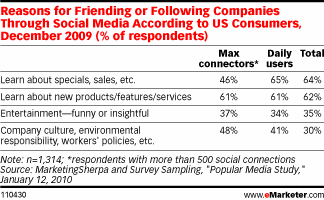
Users described as “max connectors”—those with at least 500 social connections—were less interested than average in getting deals. Instead, they cared about new products and company culture, demonstrating the deeper engagement expected by social media power users.
An earlier study, by Razorfish, also found that exclusive deals and offers were the primary motivation of US Internet users following brands on Twitter.
Respondents who friended a brand on Facebook or MySpace responded similarly, though they were more likely to become a fan because they were a current customer (32.9%) than were users of Twitter.
Sharing interesting content that users care about, along with the deals and discounts they have come to expect, will both keep them engaged and spur them to pass along marketing messages.

-
Social Media Plays Growing Role in Home Repair & Maintenance

Those fingers are now searching social media networks to find tradies
Social media is playing an increasingly important role in the home repair and maintenance industry in the US, and it won’t be long before it starts to have an impact in Australia and that is why I am a very strong advocate of small business having a profile on social media sites. Research from the US has found that nearly 30% of higher-income consumers say social media influenced their choice of home maintenance or repair services, a markedly higher percentage than other income groups. This group also had notably high reports of recent maintenance services performed.
Across all demographics, positive and negative comments were the most influential types of social media, Ad-ology found.
For other online media types, ratings websites were the most influential, followed by contractors’ websites. The top-three influential traditional media types were newspapers, Yellow Pages, and direct mail.
“Some companies may be quick to dismiss social media as something that’s only used by young people, and not worth their effort,” said C. Lee Smith, president and CEO of Ad-ology Research. “In reality, social media usage is growing across all demographics and can clearly be a way to reach some very lucrative audiences.”
Other survey findings:
- Licensing/bonding was the most important factor in the choice of a service provider in the Northeast.
- Nearly 7% of respondents had home maintenance done because of the need for emergency repair.
- Of traditional media types, Yellow Pages had the most influence on consumers ages 65-74.
So maybe the saying of “I’m Not Happy Jan” could now be applied to social media.

-
Business Intelligence Pros Iffy on SocNet Data
The majority of global business intelligence (BI) practitioners in a recent study expect the use of BI at their organizations grow at a steady pace in 2010, but most are skeptical or unsure about the value of analyzing data obtained from social media sites such as Twitter or Facebook, according to Kognitio and Baseline Consulting, which collaborated on the research.
Nearly two-thirds (63%) of the people who responded to the survey said they are “undecided” about the value of data collected from social media sites to help them understand more about their organization or customers. Another 23% called social media “overrated,” saying “there are not as many customer conversations going on as the media would have us believe.” Only 14% said they want to incorporate data from Twitter and other sites as part of their ongoing data analysis efforts.
Looking for Quick Wins
As are those in many disciplines, BI professionals are increasingly facing a need to demonstrate the value of their work. Some 29% of survey respondents say they are under pressure to justify the money they have spent on BI projects and are looking for “quick wins or new opportunities.” In a separate question, 36% say the speed to delivery of BI projects will be an imperative in 2010, saying they will need to test, evaluate, and deploy new systems within a matter of weeks. This finding is a marked change from previous years, Kognitio said, noting that BI projects have historically been expected to take months to implement correctly, and obtaining usable information could take a year or more.
The survey also found that two of every three respondents believe that business intelligence delivered on an as-needed basis (Data as a Service, or DaaS) will continue to grow in 2010. Those respondents were almost evenly split on the rate of growth, with slightly more saying DaaS-like services will continue growing at a slower pace, with the other half believing they will grow more rapidly, as “more companies realize and seek to benefit from its business and economic value,” according to Kognitio.
Less than 10% say outsourced BI is doomed to fail, the survey found.
“The survey gives us a clear road map as to where business intelligence is headed in the new year,” said John K. Thompson,CEO of Kognitio’s North American operations. “In this economy, companies want to be able to quantify their efforts and see tangible results from everything they do. That clearly extends to the use of BI, which has been a ‘money pit’ for too many firms for far too long.”
Additional survey findings:
- Nearly half of respondents (49%) said BI is becoming more appreciated as a strategic tool at their organizations, with the business side increasingly embracing its value; 43%, however, believe that BI will not grow as an enterprise-wide initiative, with “pockets” still existing across their organizations.
- BI practitioners expect to see the deeper use of technology at their firms in 2010, and plan to add capabilities to additional lines of business, with almost one-third (31%) saying they plan to add new BI tools.
- 55% believe that business intelligence is used by their firms for both strategic and operational purposes.
- The adoption of in-memory databases, which enable faster analysis of immense amounts of data, is predicted to grow slowly by 61% of respondents, who said their price/value point will continue to fall.
“The survey responses confirm the BI paradox of steady-state resources and increased expectations,” said Jill Dyché, Baseline Consulting’s co-founder and partner.

-
Americans Love Affair with Print Declining

Newspapers and Readership Decline
New research from the US might put a dampener on Rupert Murdochs plans to charge consumers for news online with new research out that indicates that the majority of Americans would not pay to read a newspaper online. Moreover readership firmly sits with older Americans with younger readers not overly interested in print.
Less than half (43%) of Americans say they read a daily newspaper, either online or in print almost everyday, according to a new report from Adweek Media and Harris Interactive.
Nearly three-quarters (72%) of Americans say they read one at least once a week while 81 percent read a daily newspaper at least once a month. Ten percent say they never read a daily newspaper.

One reason for the decline of the daily newspaper is the aging of its audience. Among those aged 55 and older, 64 percent say they still read a daily newspaper almost everyday. Of those aged 45-54, 44 percent read a paper almost every day as do 36 percent of those aged 35-44. Just 23 percent of those aged 18-34 say they read a newspaper almost every day while 17 percent in this age group say they never read a daily newspaper.
One potential business model newspapers have considered is charging a monthly fee to read a daily newspaper’s content online. More than three-quarters (77%) of Americans say they would not be willing to pay anything to read a newspaper’s content online. While some are willing to pay, 19 percent would only pay between $1 and $10 a month for online content and only 5 percent would pay more than $10 a month.

-
Google – A New Approach to China
Google and China
The following post appeared on the Google blog yesterday and I thought it would be of interest to the readers of this blog. I’ve provided a copy of the post below for you.
“Like many other well-known organizations, we face cyber attacks of varying degrees on a regular basis. In mid-December, we detected a highly sophisticated and targeted attack on our corporate infrastructure originating from China that resulted in the theft of intellectual property from Google. However, it soon became clear that what at first appeared to be solely a security incident–albeit a significant one–was something quite different.
First, this attack was not just on Google. As part of our investigation we have discovered that at least twenty other large companies from a wide range of businesses–including the Internet, finance, technology, media and chemical sectors–have been similarly targeted. We are currently in the process of notifying those companies, and we are also working with the relevant U.S. authorities.
Second, we have evidence to suggest that a primary goal of the attackers was accessing the Gmail accounts of Chinese human rights activists. Based on our investigation to date we believe their attack did not achieve that objective. Only two Gmail accounts appear to have been accessed, and that activity was limited to account information (such as the date the account was created) and subject line, rather than the content of emails themselves.
Third, as part of this investigation but independent of the attack on Google, we have discovered that the accounts of dozens of U.S.-, China- and Europe-based Gmail users who are advocates of human rights in China appear to have been routinely accessed by third parties. These accounts have not been accessed through any security breach at Google, but most likely via phishing scams or malware placed on the users’ computers.
We have already used information gained from this attack to make infrastructure and architectural improvements that enhance security for Google and for our users. In terms of individual users, we would advise people to deploy reputable anti-virus and anti-spyware programs on their computers, to install patches for their operating systems and to update their web browsers. Always be cautious when clicking on links appearing in instant messages and emails, or when asked to share personal information like passwords online. You can read more here about our cyber-security recommendations. People wanting to learn more about these kinds of attacks can read this Report to Congress (PDF) by the U.S.-China Economic and Security Review Commission (see p. 163-), as well as a related analysis (PDF) prepared for the Commission, Nart Villeneuve’s blog and this presentation on the GhostNet spying incident.
We have taken the unusual step of sharing information about these attacks with a broad audience not just because of the security and human rights implications of what we have unearthed, but also because this information goes to the heart of a much bigger global debate about freedom of speech. In the last two decades, China’s economic reform programs and its citizens’ entrepreneurial flair have lifted hundreds of millions of Chinese people out of poverty. Indeed, this great nation is at the heart of much economic progress and development in the world today.
We launched Google.cn in January 2006 in the belief that the benefits of increased access to information for people in China and a more open Internet outweighed our discomfort in agreeing to censor some results. At the time we made clear that “we will carefully monitor conditions in China, including new laws and other restrictions on our services. If we determine that we are unable to achieve the objectives outlined we will not hesitate to reconsider our approach to China.”
These attacks and the surveillance they have uncovered–combined with the attempts over the past year to further limit free speech on the web–have led us to conclude that we should review the feasibility of our business operations in China. We have decided we are no longer willing to continue censoring our results on Google.cn, and so over the next few weeks we will be discussing with the Chinese government the basis on which we could operate an unfiltered search engine within the law, if at all. We recognize that this may well mean having to shut down Google.cn, and potentially our offices in China.
The decision to review our business operations in China has been incredibly hard, and we know that it will have potentially far-reaching consequences. We want to make clear that this move was driven by our executives in the United States, without the knowledge or involvement of our employees in China who have worked incredibly hard to make Google.cn the success it is today. We are committed to working responsibly to resolve the very difficult issues raised.”
Update: Added a link to another referenced report in paragraph 5.
Posted by David Drummond, SVP, Corporate Development and Chief Legal Officer

-
Magazines Lose One-Fourth of Ad Pages in 2009
Traditional media such as newspapers and magazines have taken a beating over the past 12 months with declining circulation and advertising revenues and final numbers confirm it was challenging for the industry, Magazine ad pages plunged 25.6%, or by 58,340 pages, in 2009 compared with 2008, according to the Publishers Information Bureau.
Revenue was down 18.1% for the year and down 12.4% for Q409. It was the most significant drop in at at least the past ten years, reports MediaBuyerPlanner.
Not surprisingly, some magazines fared better than others. Meredith’s Better Homes and Gardens, Family Circle, and Ladies’ Home Journal all posted ad page increases. Time Inc.’s People StyleWatch saw pages increase 24.4%, and People stayed about flat.
At the other end of the spectrum, serious declines were seen at Time Inc.’s Money and Fortune, which were down 29.1% and 36% respectively. Hearst’s Town and Country fell 45.6%, while Veranda was down 48.1%.
Every one of Conde Nast’s publications saw ad page declines, though the publisher still led others in terms of the highest number of ad pages, at 23,122 for the year. Time Inc. followed with 23,102, PIB reported.
Strong Q4 and year-End Categories
Not all categories suffered. The food and food products ad segment was down just 3.9% for the year, and grew by a strong 21.9% in Q4 in terms of revenue. Other categories that had a stronger fourth-quarter included household cleaners, pet foods and supplies, drugs, toiletries, and fitness products. Even domestic auto was showing some improvement by the end of the year. While the sector was down 32.3% in revenue for the year, it was down just 5.6% in the fourth quarter.
Part of the strength of the fourth quarter was due to advertisers releasing money from budgets that had been held closely throughout the year, PIB said.
Signs of Improvement
There are indications that ad pages are on the upswing. While all of Conde Nast’s titles fell in 2009, several are showing increases in the New Year. Glamour’s ad pages are expected to be up 6% to 7% for the March. Vogue was up 3% in February, and that magazine’s March, April and May issues are also tracking up, though it’s too soon to tell for certain at this point.
“While marketers’ skittishness continued through the fourth quarter, magazine spending showed improvement compared to earlier in 2009,” said Ellen Oppenheim, EVP/CEO of the Magazine Publishers of America. “Magazines experienced an uptick in food spending and relative improvement in other areas, especially in automotive.”
MediaFinder.com reported last month that the number of folded magazines far outnumbered new titles for 2009. The difficult economic year saw 275 new magazines launch and 428 cease publication.
ZenithOptimedia predicts that global spending on magazines will be down 4.5% this year.

-
Leading German Car Maker Releases Viral Video Campaign

Mercedes Benz
The economic downturn world wide has meant that a lot of business has had to find more economical ways of advertising their product and a number of these companies have started to ditch more traditional forms of advertising and have gone viral, using social media sites and YouTube as a means of attracting new customers. Following on from the success that BMW Films have had with their video series, now Mercedes Benz have released their own amazing video. Here it is for you to watch, please enjoy:
[viddler id=dec1d2ce&w=437&h=370]

-
Top US Companies in Need of “Twittervention”

Fortune 500 companies and Twitter
Top US companies are missing out on a large portion of the potential Twitter holds for their businesses, according to two separate studies from PR firm Weber Shandwick and the University of Massachusetts Dartmouth. Both studies indicate that while Corporate America is familiar with Twitter, it is not taking advantage of the full range of Twitter’s business capabilities.
A “Twittervention” May Be in Order
The Twitter online social network has an estimated 20 million US users and 50 million users worldwide. Yet according to a Weber Shandwick research paper entitled Do Fortune 100 Companies Need a Twittervention (pdf), while 73% of Fortune 100 companies registered a total of 540 Twitter accounts, 76% of those accounts do not post tweets often, and 52% are not considered actively engaged as measured by engagement metrics such as numbers of links, hashtags, references and retweets.
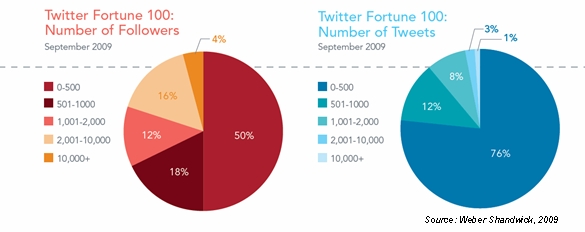
Fortune 500 Companies and Twitter
Moreover, 50% of Fortune 100 accounts had fewer than 500 followers, 15% were inactive or used as placeholders to protect against the “brand-jacking” (or unauthorized use) of a company name, and 4% were abandoned after a specific event. Some 41 accounts not included in the study group of 540 accounts appeared to be brand-jacked accounts using a brand name without authorization.
Steps to a Twittervention
For companies not maximizing the potential of their Twitter accounts, Weber Shandwick recommends a four-step plan of action:
- Create a companywide engagement strategy and a set of guidelines with best practices.
- Demonstrate a consistent and comprehensive brand presence.
- Build a dialogue that paves the way to new relationships with customers and advocates.
- Generate loyalty among new and existing communities.
To maximize the benefits of Twitter, Weber Shandwick says companies should offer opinions and encourage discussions, reach out to their communities of customers and advocates, build relationships with new customers and look for untapped supporters.
Inc. 500 Shows Lower Twitter Usage, Higher Engagement
A study by the Center for Marketing Research at the University of Massachusetts Dartmouth, Social Media in the 2009 Inc. 500: New Tools & New Trends, obtained slightly different results from the top 500 companies as ranked by Inc. Magazine. The study shows lower usage of Twitter by top US companies but a higher level of engagement among users.
According to the study, 52% of Inc. 500 companies have a Twitter account, and 62% of Inc. 100 companies consider themselves “very familiar” with Twitter.
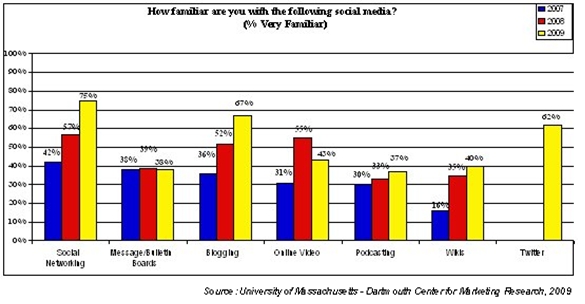
How familiar with Social Media Tools research
While this is a lower Twitter usage level than that tracked by Weber Shandwick, it is interesting to note that 82% of Inc. 500 Twitter users reported success, mostly measured by hits, comments, leads or sales as primary indicators. This suggests Inc. 500 companies have a higher level of engagement than Fortune 100 companies, with more than half of Fortune 100 Twitter users not actively using their Twitter accounts.
In addition, 27% of Inc. 500 companies not currently using Twitter as a business tool plan to do so. In terms of their view on the general business value of social networking, 79% of Inc. 500 companies consider social networking to be somewhat or very important.
For those of you who are just starting out with Twitter, here’s a refresher on how to create your Tweet plan.

-
Mobile Local Search Ad Revenues to Reach $1.3B by 2013
Interesting news on the growth of local search spending over more traditional forms of advertising with US mobile search and display advertising revenues expected to grow to $3.1 billion by 2013, from $160 million in 2008, representing a compound annual growth rate (CAGR) of 81.2%, according to a forecast report from The BIA Kelsey Group.
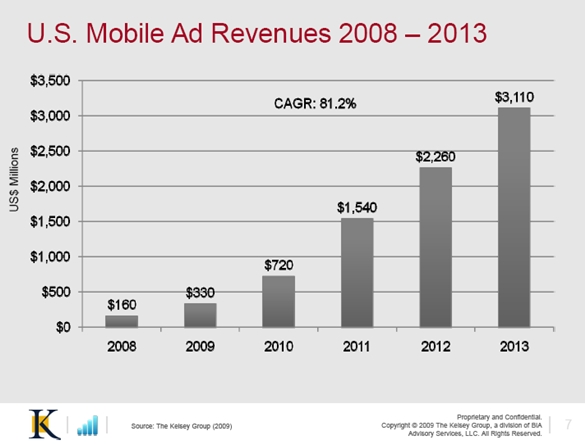
US Mobile Ad revenue
During the same period, the firm forecasts mobile local search advertising revenues will increase from $20 million to $1.3 billion, a CAGR of 130.5%.
The US Mobile Local Media Forecast (2008-2013) also predicts that percentage of mobile searches that have local intent will increase from 28% in 2008 to 35% in 2013, though the local total ad market (across all media) will contract in 2009 and 2010. This will be led by small businesses, which will accelerate the shift to interactive products.
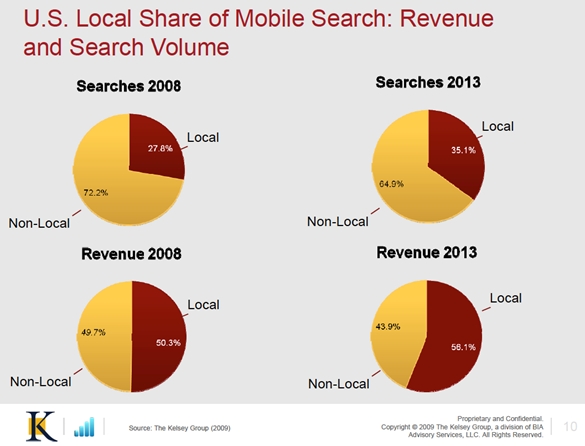
US local share mobile search revenue volume february 2009
The shift to interactive products, combined with a lack of traffic to fulfill budget quotas on geo-targeted search products, will cause publishers to accelerate the building of mobile sites as they look for incremental traffic, The Kelsey Group said.
“As mobile data consumption rises, we expect local marketing to be a big winner,” said Michael Boland, program director, Mobile Local Media (MLM), The Kelsey Group. “There is a strong correlation between local search and the mobile use case, which will cause a good portion of the ongoing mobile application boom to focus on local.”
Additional report findings:- The number of mobile web users will reach 95 million by 2013.
- There currently are 54.5 million mobile internet users in the US, representing 25% of online users.
- Approximately 15% of iPhone applications are local.

-
Women and Social Media Podcast
Listen to our new podcast episode Women and Social Media or you can download a copy of the podcast here.
-
Consumers Reward Marketing that Employs “Green” Messages
Customers are rewarding companies that use so-called “green marketing” tactics and are willing to pay more for the same product when it is presented with an environmentally friendly message, according to a recent research report from Environmental Leader and Watershed Publishing.
The report, “Green Marketing: What Works & What Doesn’t – A Marketing Study of Practitioners,” also revealed that increased spending on green advertising and marketing is, in many cases, the result of firms finding distinct additional marketing and advertising advantages with green messages.
Plans to Increase Spending
Among survey respondents, 82% of plan to increase their spending on green marketing in the future, the report said.

When split into groups that do or don’t measure advertising results, media-measuring companies tend to spend more on their green efforts.
‘Greenwashing’ Overblown
Though “most firms perceived that they were – in reality – greener than their customers initially thought they were,” according to Jennifer Nastu, a study co-author, the research found that companies that perceive themselves to be greener spend the most on green marketing, suggesting that “greenwashing” may not be as prevalent as some suppose. Respondents see their organizations as less “green” tend to avoid green marketing messages. Similarly, it appears that management deliberately moves to make greener operational choices first, and only later markets with green messages.
“While green marketing is showing itself particularly competent in selling, most marketers appear to try to use it as a branding device,” said study editor Tig Tillinghast of Watershed Publishing. “We are now starting to understand that it’s under-utilized in its most effective application.”
Additional study findings:
- The internet proves the most popular medium (75%) for green marketing, followed by print (50%) and direct mail (40%).

- 28% of marketers think green marketing is more effective than other marketing messages, compared with 6% of marketers who think it is less effective.
- Marketers who track marketing spending and its relation to sales tend to believe people will pay more for green products. Marketers using less trackable media remain more skeptical.
- Companies with smaller marketing budgets tend to spend more on green marketing.
- Nearly half of respondents say the decision-makers at their companies hold green marketing in high regard vs. just 15% who say decision-makers
hold it in low regard.

-
The Social Media Guru
As you may have already worked out, I’m no fan of the growing breed of experts called the social media guru, these are the new breed of expert that has used social media sites for 5 minutes and suddenly becomes the expert.
Well I found a great cartoon the other day that I thought I’d share with you.
My apologies to the original source of this cartoon.

-
Ford Cars Ready to Read your Twitter feed
Ford Motor Co
Great story from Las Vegas and featured on CNN is the news that the Ford Motor Co. announced technology to let computers read their Twitter feeds to them while behind the wheel.
Here’s the full story as written by CNN reporter John D Sutter:
The debate over distracted drivers ramped up a notch on Thursday as Ford Motor Co. announced technology to let computers read their Twitter feeds to them while behind the wheel.
The company has not formally announced technology to let drivers post tweets verbally from behind the wheel, but such an announcement likely will come in the next 12 to 18 months, Doug VanDagens, Ford’s global director of connected services, told CNN in an interview after the company’s keynote address at the Consumer Electronics Show here.
VanDagens said people read Twitter feeds and send text messages while they’re driving anyway, and that the automaker is trying to make those activities safer for drivers.
“We take what people do — they talk on the phone, they fumble with mp3 players, they look at maps. We take these activities and make them safer,” he said.
Safety groups have criticized car companies and technology makers for putting touch-screen devices that surf the Internet in cars.
The U.S. is in a distracted driving crisis, and, in general, the more technology electronics makers put into cars, the less drivers are able to pay attention to the road, said Christie Hype, a spokeswoman for AAA, the motor safety group.
“The more things that are going on in a vehicle, the more things can distract a driver,” she said.
“You only have so much attention to give, and we really want everyone to keep their attention on the roadway for safety reasons.”
More study of the tweeting by voice while driving would need to take place to make an absolute determination as to what effect Ford’s announcement will have on distracted driving, she said.
Ford’s system, which will be installed in some cars later this year, does not let drivers surf the Internet visually while driving. A Wi-Fi hot spot in the new cars generate will let drivers browse the Web when their cars are parked, VanDagens said.
The technologies will first show up in Edge and Focus model cars. Not all models will be upgraded in 2010, but new lines of these cars will be equipped with the media-center technology, which features an 8-inch screen in the center of the dash and a media hookup under the armrest. A company representative would not comment on whether the technology will increase the price of Ford cars.
Ford’s announcement also highlights the growing popularity and importance of mobile phone applications. Instead of downloading Twitter feeds through the car, Ford works with drivers’ mobile phones, pulling data from a number of apps, which are produced by other companies.
The Twitter-reading function works with a Twitter mobile app called Open Beak. The car company also announced partnership with Pandora’s mobile app, which streams music, and Stitcher, an application for online news.

-
Women Take To Social Media
In the US, new research from SheSpeaks highlights that social media networks have become a must for women this year and social network penetration climbed from 58% of internet users in 2008 to 86% in 200
I’ve mentioned a number of times on this blog the number of women who are now using social media sites including blogs, to not only research business and products, but who are directly influenced by what they read or research on these networks.
When asked about brand related activity on social sites, 80% of female users said they had become a fan of a product or brand directly from a social network. In addition, 72% had learned about a new product or brand, or joined a group around one. To me, one very interesting trend stood out, women were less likely to participate on Twitter with product or brand related activities.
Another interesting point is with actual purchasing of products or services, with one-half of female Internet users buying a product because of a social network. Purchases based on social networking sites and blogs both increased dramatically over 2008.
Users seemed more receptive to social network advertising than they were in 2008, with 9% saying that they always look at ads and often click through, compared with just 2% last year. Thirty percent look sometimes, versus 13% in 2008, and fewer users felt annoyed by ads or actively ignored them.
The ROI for business with a social media strategy that is well set up and planned is well worth the effort and the work put in, and with that in mind, I’ve been really inspired by this research, so much so that I’m prepared to help you get your blogging efforts set up and running for the month of January, I’m going to set up 10 free wordpress installs. No sales efforts, no push, all you have to do is drop me a comment on this post and tell me why you need/want a blog and how having a blog might benefit your business.
To Qualify:
In order to qualify all you need to do is buy one of my hosting packages for a period of 12 months, they are really inexpensive and won’t cost you an arm and a leg. Let me know if you’d like additional information on this.
This is what I’ll include –
- I’ll install and configure WordPress for you. The self hosted version.
- I’ll upload and activate a theme of your choice for you so that your blog looks a million dollars.
- I’ll set up and install add-on software (otherwise known as “plug-ins”) to give your blog a bit of a boost. Things like Disqus commenting, Akismet Spam protection, Tweetmeme, etc.
This is what is not included:
- I won’t move content over from another blog. I’m setting up a brand spanking new blog for you in this case.
- You won’t get personal one-on-one blog coaching. I’m not saying that I wouldn’t sit down with you for some one-on-one coaching if you needed it. It’s not included in this Basic Install. If you’re interested in coaching, then click on this link Mike Andrew Consulting
- You won’t get tech support. I’m happy to answer any questions that you might have if time permits.
- You’ll need to buy or already have your own domain name as the blog will need this. I’ll help you work out the best domain name for you but you will need to have it ready.
So there you have it, as I mentioned I’ll be happy to do about 10 of these installs so to qualify all you need to do is get writing and leave me a comment, if you already have a blog then please send the link or recommend this to someone who doesn’t have a blog yet.

-
What Tactics Really Work for Social Media Marketers?
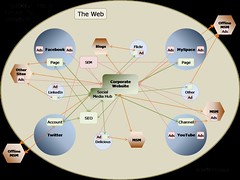
The 2010 Corporate Social Media Marketing Ecosystem
I’ve mentioned in previous blog posts that traditional marketing tactics don’t always work on social media sites, given that these sites are all about building community, a more strategic approach is needed, and businesses need to enter the community and build rapport with members of that community. New research from a September 2009 MarketingProfs survey of business-to-business (B2B) and business-to-consumer (B2C) marketers has found that the marketing tactics most often used on social sites are not necessarily the best ones.
The most common marketing tactic used on Facebook was attempting to drive traffic to corporate materials through status updates, followed by friending customers.
But the most effective tactic for consumer-oriented companies was creating a Facebook application, which was done by less than one-quarter of total respondents. Both B2B and B2C companies also reported surveys of their fans as effective; fan surveys were the third-most-common tactic attempted.
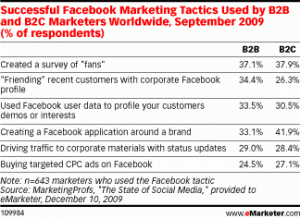
Succesful Facebook B2B Marketing Tactics
Unsurprisingly, buying ads—even targeted ones—was the least effective type of social media marketing overall.
Like those on Facebook, marketers using Twitter were also most interested in increasing traffic. Driving traffic by linking to marketing Webpages was the most common activity on the microblogging site, followed by driving sales by linking to promotional pages. But again, the most effective tactics were different.
B2C marketers had the most success with monitoring Twitter for PR problems (done by one-half of all respondents) and contacting users who posted negative comments about their brand (done by only 22.4% of total respondents). B2B companies also succeeded with brand monitoring, as well as with using Twitter invites for in-person events (the least common tactic of all).
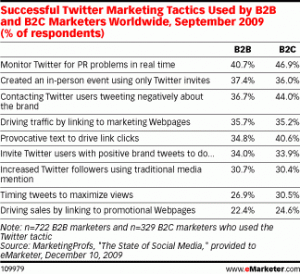
Succesful Twitter B2B Marketing Tactics
Though some firms, such as Dell, have reported success in the area, the study found that driving sales was the least effective marketing tactic attempted by companies using Twitter.

-
Hello and Welcome to 2010
2009 was a start up year for me and my consulting business and I’m looking forward to working and consolidating what we achieved last year with my existing clients and adding some new ones as we move into the first month of the new year.
We now have a new office location and improved technology to enable me to continue to work on web site SEO and social media integration into our clients online marketing efforts, I’ll also continue to add new information on SEO,Internet marketing and social media to this blog to provide you with helpful information on all things Internet and marketing.
So here’s to a brand new year, and just like the recent photos of Jennifer Hawkins, no photoshop or airbrushing was applied to my photo on the left.

-
November US Search Share: Google Up Slightly to 71.6%
Google Increases search share in US
Google accounted for 71.6% of all US searches conducted in the four weeks ending Nov. 28, 2009, a 1% month-over-month gain vs. the 70.6% share it had in October, according to monthly search-share data from Experian Hitwise.
The other three largest search engines, Yahoo Search, Bing and Ask.com received 15.4%, 9.3%and 2.7%, respectively. Yahoo and Bing showed declines in search share, while Ask.com’s share increased slightly.
The remaining 52 search engines in the Hitwise Search Engine Analysis Tool accounted for 1.07% of US searches.
Longer Search Queries Flat
In what appears to be the end of a months-long trend of lengthening search queries, longer queries – averaging searches of five to more than eight words in length – were flat between October and September 2009. Searches of eight or more words increased 1%, according to Experian Hitwise.
The same time period showed that shorter search queries – those averaging one to four words long – were flat from month to month. Searches of one word comprised the majority of searches, amounting to 24.13% of all queries.
Bing, Google See Growth to Verticals
Search engines continue to be the primary way internet users navigate to key industry categories, Experian Hitwise said. Comparing November 2009 with November 2008, automotive, business and finance, entertainment, news and media, and sports categories showed double-digit increases in their share of traffic coming directly from search engines.
Google was sending the most visits to the automotive, health, shopping and travel categories among the top three search engines and its percentage of upstream traffic grew for the automotive, shopping and travel categories.

-
SocNet Use Rises 48% Among US Women
A majority of US women use social networking sites, and half of them say social networking sites influence their shopping habits, according to a recent study on online social networking among women from social media platform SheSpeaks.
According to the SheSpeaks Second Annual Media Study (pdf), 86% of US women now have a profile on at least one social networking site, a 48% increase from 58% who had a profile in 2008. Since 2008, the percentage of women reporting they log into their social networking sites at least once a day grew 36%, from 53% to 72%.
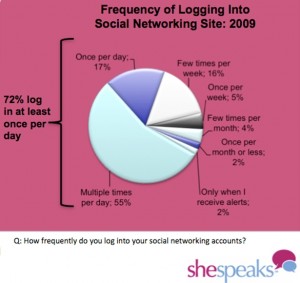
Frequency of women logging into social networks
Of particular interest to retailers, 50% of female social media users say they have purchased products because of information on social networking sites, and 40% report they have used coupon codes found on social network.
Facebook Most Popular
Facebook is the most popular social networking site among women. Some 95% of respondents who have a social networking profile say they use Facebook, a 46% increase from 65% last year. MySpace dropped 33% in popularity, with 42% of female social networking participants reporting they have a MySpace account, compared with 63% in 2008.
Twitter, which was included in the study for the first time this year, has a 38% participation rate, SheSpeaks said.
“Although Facebook is currently more popular than Twitter among women, they each share a purpose in women’s lives,” said Aliza Freud, founder and CEO of SheSpeaks. “Facebook serves women’s need to interact with friends and share photos, while Twitter has become a tool that is primarily used for professional networking and learning about up-to-the-minute news, promotions and deals.”
Hearing what friends are doing, having fun and expressing themselves top the list of reasons why women say they use Facebook and Twitter, though more women visit Facebook to express themselves and have fun. However, a higher percentage useTwitter to learn new things, promote themselves/their work and follow celebrities.
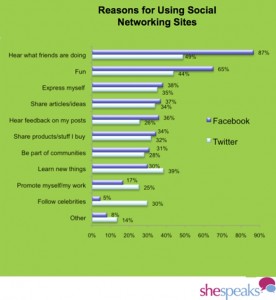
Reasons women use social networks
Online Video Grows in Popularity
The study also found online video has grown in popularity over the last year. Almost 40% of the women in the study report that they frequently watch video and TV content online, and 85% say they watch it frequently or sometimes.
A separate poll of SheSpeaks members found that clips from news and TV programming were the most commonly watched type of online video in the prior week (68%), followed by videos that are forwarded (49%), full news and TV programs (40%), and videos posted by friends (40%). Entertaining advertisements were the least popular type of video, but were still watched by one-third of women within the last week.
The study paints a more optimistic picture of social networking’s growth in popularity among US adults than other studies released earlier this year, reports Retailer Daily. According to the most recent Consumer Internet Barometer report from The Conference Board, released in June 2009, growth is occurring but not as rapidly as indicated by SheSpeaks study. The Consumer Internet Barometer indicates 43% of internet users participate in social networking sites such as Facebook, Twitter and MySpace. This is a 16-percentage-point jump from the 27% of users participating in social networking sites a year ago.
Online social networking participation has especially grown among users ages 55 and up, the study found. Last year, only 6% of internet users in this age group participated in online social networking, compared with 19% this year.
About the study: The Second Annual Media Study is based on responses 1,500 adult women who are members of the SheSpeaks social networking community gave to an annual survey.

-
Creating a Digital Media Strategy
Last week during a webinar that I participated in with Michael Sheargold and the Real Estate Results Network, I suggested that every small business should create a digital media strategy that covers at least the next 12 months. Technology is changing so rapidly for small business and without a plan or strategy in place you’ll find it very hard to keep up. I’ve had some business owners talk to me about what should be in this digital strategy, so to help you lets go through the basics of what you should include in your document.
1. Web site SEO – First and foremost in my mind is having your web site search engine friendly. Local search queries continue to increase as does 3+ word keyword searches.
Yellow Pages book usage is decreasing and Internet searches increasing, so that makes it vital that your site appears on the first page of Google. You need to also consider how your site performs, Google are planning to use site speed as a ranking factor and therefore how quickly your site loads will be a consideration. Image heavy sites without alt tags and optimising your pages for relevant keywords needs to be considered.
During the webinar, one industry specialist wrote a comment ” Do you really think that business owners actually write their own copy?” Not all the time, I don’t, but they need to make sure that what is written on their behalf is search engine optimised and written for the web, not copied from a newspaper. Make sure that you get access to the coding on your site as well, you pay for it, you own it, not like I have encountered recently with one web company attached to the number one real estate portal, they have a very arrogant attitude to you the customer, so if in doubt walk away, there are plenty of web design companies that will help you.
Search Engine Marketing should not replace your web site SEO, use SEM wisely and don’t double up, if you’re on the first page or rank highly for a search term, don’t waste money on Adwords,use them in areas that you don’t rank, remember, Google ranks pages not web sites so you can effectively optimise each page on your web site for keywords.
2.Social Media – Include this into your 12 month plan, small business is lagging behind their big brothers in using and integrating social media into their business. Your customers have embraced social networking and it is becoming the trusted adviser, so you can’t afford to neglect it any longer.
One of the reasons slowing the integration is a lack of knowledge about social media by small business owners, in my mind you are better to try and work with social media than to ignore it, so jump in and have a go. Plan it slowly and use the major sites such as Facebook and Twitter to start with, you can use this as your guide, POST. This stands for:
- People – What is your target market?
- Objective – What do you want to achieve from using social media?
- Strategy – How will you go about communicating with your customers? Status Updates, Coupons, Discounts etc
- Technology – What are the main sites you’ll use to communicate your message? Facebook/Twitter
That at least will help you plan your strategy, also remember, Podcasting, Vlogging and YouTube are powerful tools in getting your message across, plus Google loves video, so use this to your advantage
3. Blogs – Create a blog and add it to your web presence, it allows you to add the personal touch to your on line marketing. ComScore’s research indicates that blogs reach over 48% of the online population in the Asia Pacific region, social media 56.1%.
Blogs are a great way to communicate with your customers and are a great customer service tool, remember though you need to make sure that your content is fresh and relevant to the target market you are aiming at. Google loves blogs because of the constantly updated information they provide and will index them very quickly as well as give them a high ranking, sometimes even over a higher authority site. WordPress provides a great platform for you to use and I’d recommend the self hosted option as you can use your own domain name and you have much more flexibility.
4. Internet Marketing – Make sure that you have your office details listed with Google business, use different keywords or categories so that you rank on different search pages in your area. Be very selfish with where your links go, you might think its great that your business comes up number one under a directory listing in your area, but think where the customer goes when they click on the link, to you? no they go to the portal so make sure your web site ranks on that first page.
Audit your listing on the portals and start to implement good keywords in your copy, remember you’re writing for the web not a newspaper, so think about how people search and what keywords they use. Get those from your own office, you have a wealth of information at your disposal, so ask your staff what words or phrases consumers use when they contact your office, find the most frequently used and start to weave those into your articles or listing copy.
5. Technology – Make sure you stay informed on technology that impacts on how your customers find you, Augmented Reality and QR codes are examples, be aware of the impact they are having and factor these into your strategy.
I hope that helps you in planning for the next 12 months, having this in place is a good start in improving the way you market and communicate with the online consumer, it also improves your businesses “Future Fitness” for digital marketing.

-
Females, Teens Most Regretful SocNet Users
Three times as many females as males say that using social media is their “favorite leisure activity” but nearly twice as many females over age 21 “believe they spend far too much time on online social media”, according to a survey of social media users conducted by Crowd Science using its research platform for online audience measurement. The study (pdf) found that 34% of females vs. only 10% of males of females who use social media say it was their favorite leisure activity. However, more than half (54%) of female respondents ages 21+ believe they spend far too much time on online social media. This compares with only 38% of males in the same age group.
Moreover, 45% of females older than age 30 believe that most people are interested in what they have to say on social media, vs. just 29% of males the same age, according to Crowd Science.
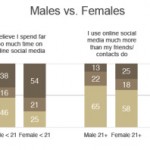
Social Networking Attitudes
Recent data analyzed by Pingdom similarly found that social network usage skews female and that the average male-to-female ratio of users on 19 of the top US social networks is 47% male and 53% female. Bebo – with 66% of women users – is the most female-dominated of these sites, Pingdom said.
Young Users Also Regretful
In addition to feelings of overdoing social media by women, younger participants in the study also feel they use social media too much – 46% of teens (17 and under) and 38% of 18-29 year-olds. This figure drops dramatically to 23% for the 30-39 demographic, and 12% for those 40+.
With almost half of teenage participants admitting to over-use of social media, a similar proportion (44%) reported posting or saying things that they later regretted (vs. 30% for 18-29, 20% for 30-39 and 12% for 40+).
More than one-third of teens (35%) say they have used social media to reveal personal info that they wouldn’t have revealed otherwise (vs. 20% for 18-29, 8% for 30-39 and 5% for 40+). Despite these revelations on social media, about one-fifth of all participants under 30 (21% for teens, 19% for 18-29) say it would be “extremely damaging to my social status if I stopped or reduced my use of online social media.” Only 5% of 30-39 year-olds said this, and 3% of those ages 40+.
Additional study findings:
- One-quarter of respondents feel forced to use online social media because friends and contacts do (25%).
- One-in-ten respondents agree to “frequently stretching the truth when portraying themselves online.”
- One third of respondents (32%) would rather communicate with friends/contacts through social media than by telephone.
- While about eight in 10 respondents disagree that social media are preferable to face-to-face contact with friends, almost one in 10 actually prefers to use online social media over face-to-face.
“The results of our study align with most people’s intuition about the usage of social media by teens and young adults,” said John Martin, CEO of Crowd Science. “As the economy recovers and this generation starts interviewing for jobs, there will be some interesting years ahead as they have to deal with a new level of transparency around their past adventures (and misadventures). I’m definitely glad I made it out of school before Facebook landed.”Twitter Users Most Entrenched
The study also examined the social networks used and the relationships among them in terms of their users. It found that Twitter users are more entrenched across the top three social media (Facebook, MySpace, Twitter) than are Facebook and MySpace users, with one-half of Twitter users involved with all three social media (49%) compared with one-fifth of Facebook users, or one-third of MySpace users, who use all three.
Morover, the vast majority (87%) of MySpace users also use Facebook, vs. only one-half of Facebook members who also use MySpace.
When examining overlap of the three social media, Facebook users yield the largest proportion of exclusive users (35%) vs. MySpace (10%) or Twitter (7%), Crowd Science found.About the study: The Crowd Science study on social media users was conducted across more than 600,000 visitors to multiple websites within the Crowd Science open research network. The survey, targeting social media users ages 13+, was conducted August 5-13, 2009.

-
Top 10 Internet Marketing Strategies of 2009
SEO, social media marketing and keyword research are tops on the list of the 10 best internet marketing strategies of 2009, according to a list released by SEO.com.
In issuing the list, the firm said that the best strategies this year have been the ones that are directly related to establishing credibility, eliciting trust and directly targeting a desired demographic.
Credibility Most Important
Credibility is one of the most important things to establish in an online presence, especially in an economically challenging year, according to Ash Buckles, SEO.com’s director of search engine optimization. “When people are watching their money closely, they will only buy from companies and websites they trust,” he said.
Credibility, Buckles said, depends on how well a site is architected, how many other sites and networks link back to your site, how much social media and buzz surrounds a domain, how often a site goes down, how unique a site’s content is and how fast a site loads.
The top 10 list and commentary from SEO.com:
1. Organic Search Engine Optimization (SEO): Websites at the top of the search results are viewed as the leaders of their industry, and more than 80% of web users click on the first listings. Good SEO services will consistently deliver a huge return on investment.
2. Facebook/Twitter/LinkedIn: Social media marketing engages customers on a personal level, and can rapidly create buzz around a product, brand or business. It can also be more cost effective than traditional forms of advertising and outreach, SEO.com said.
3. Keyword Research: Online, everything revolves around discovering what words and phrases an organization’s customers are searching for online.
4. Video Marketing: This is becoming more important both on-site and off-site. Videos help convert website visitors into sales. In the universal search results, people tend to click on links with videos more than those without – even if the video link is ranked lower.
5. Online Public Relations: This builds credibility online, in the mainstream media and for potential customers. Online public relations can help create a lot of buzz about your site through bloggers and industry sites, and can boost organic SEO.
6. Link Building: A key element in search engine optimization. Search engines like “popular sites.” From the search engine’s point of view, a credible and popular site will have a lot of links pointing to it.
7. Blogging: Blogs provide additional site content (which search engines like), graphics and other viral content to disseminate information and tie in with social media. Blogs can build credibility by establishing a site as the hub for industry information.
8. Conversion Web Design: A good web design will keep visitors on the site and sell them products or services.
9. Paid Search Marketing: Pay-per-click (PPC) advertising is an extremely targeted strategy with measurable, immediate results. This enables a more efficient spending of marketing dollars.
10. Email Marketing: This is important to nurture relationships and retain existing customers. It’s much easier to keep old customers than to get new ones. Send good offers and valuable information that’s customized to their needs.
“Companies want to make sure every penny goes to something that produces results,” said Dave Bascom, chief executive of SEO.com. “For that reason, more and more money is being allocated to internet marketing because it’s measurable and has proven to increase ROI.”
Bascom added that the same 10 strategies will also be important in 2010.
![Reblog this post [with Zemanta]](https://img.zemanta.com/reblog_e.png?x-id=d1e0f6ab-4fcb-4e26-b225-3629a50e46d2)
-
Google Real Time Search & Social Media
Google Real Time Search
Ok, if you been putting off starting a blog or using social media sites such as Facebook and Twitter, it’s time now to think again and very seriously. With the launch yesterday of Google real time search, it opens up a world of opportunity for bloggers and social media users to get their efforts at the top of the search rankings, Google now pulls information as it happens from sources such as friendfeed, Twitter and Facebook as well as blog posts and news feeds.
This is essentially Googles answer to Twitters and Facebooks search engines which provide up to the minute updates on trending topics, and it was a natural extension for it to be applied to search engines, after all they are trying to give you the best response to your search query.
Real time search will enable information to be delivered as it happens, by clicking on “Latest results” or selecting “Latest” from the search options menu to view a full page of live tweets, blogs, news and other web content scrolling right on Google.
You can also filter your results to see only “Updates” from micro-blogs like Twitter, FriendFeed, Jaiku and others.
Latest results and the new search options are also designed for iPhone and Android devices when you need them on the go, be it a quick glance at changing information like ski conditions or opening night chatter about a new movie — right when you’re in line to buy tickets.
So there you have it, create your blog and start writing, and by creating good quality content on your blog or social media network, you might just end up in the number one spot on Google.
It’s the freshness factor that is also important when it comes to getting your information ranked high on Google and now with real time search, you can get fresh up to date information on trending or newsworthy stories as they happen.
If you’d like to start a blog and don’t know where to start, visit Blogging for Business Packages and get started today.

-
Social Bookmarking Made Simple

Mike Andrew Consulting Podcast Series
Another in our social media podcast series, this time we look at social bookmarking in simple to understand terms. What it is and how it can help you build links to your web site.
![Reblog this post [with Zemanta]](https://img.zemanta.com/reblog_e.png?x-id=e0105988-7c17-46e4-8324-ef522c939e92)
-
Grab Your Social Media User Name – Podcast

Mike Andrew Consulting Podcast Series
Part of a retrospective look at Internet marketing and social media, In this podcast we look at why you should grab your social media user name fast.
Here’s the podcast for you to listen to:

-
Consumers Free to Speak Their Mind Online
Brand marketers know the Internet can be a dangerous place, where they lose control of the message and consumer-created content reigns. That is partly because Internet users now have the ability to create and disseminate blog posts, tweets, reviews and homemade videos around the world. But it is also an effect of the “cyberdisinhibition” the Web provides.
The anonymity of the Internet leads people to behave differently than they do face-to-face. Research from Euro RSCG Worldwide shows that nearly 43% of US Internet users feel less inhibited online, with the effect most prominent among females and users ages 25 to 54.
That can lead to positive and negative behaviors alike. Users are more likely to feel able to meet new people or be empowered to do something they wanted to. But they were also more likely to “lash out” on the Web when they had something to say about a company or brand. One-fifth of Internet users, including almost one-quarter of men, had done so.
“The more interactions happen online, with no direct offline contact, the more likely they are to tilt toward extreme behavior. It’s important to blend both online and offline elements,” according to the “Social Life and Social Media” white paper.
Blending elements is important, but marketers should remember that there remains a distinction between offline and online interactions. Just 25.6% of respondents felt all interaction was the same, and about one-half emphasized the convenience of electronic interaction over face-to-face.
The stigma of online socializing is fast disappearing as well. Although only a minority of US Internet users thought online social groups could be “truly social,” nearly three-fifths disagreed with the idea that socializing on the Web was only for “sad, antisocial types.”

-
Creating a Blogging Discipline Podcast

Mike Andrew Consulting Podcast Series
I’ve just recorded this for those of you just starting our with your blog strategy or for those of you that have been blogging for awhile and have got a little stale and need some inspiration, just like me sometimes with my blogs.
I hope this podcast will inpsire you and give you new motivation.

-
News Ltd and Google

Rupert Murdock and News Ltd
The ongoing saga between Rupert Murdock and Google continues to escalate , and in a previous post i looked at Rupert’s threat to stop Google getting access to news and information from News Ltd sites.
Well hot on the heals of that story comes another twist with Microsoft and News in discussions to remove content from Google, given that Google is the main driver of traffic to these News Ltd sites, what would be the impact of any decision from Rupert to stop Google indexing content, and with other newspaper and media companies considering joining Rupert and News Ltd in this action it’s going to be a very interesting story to watch unfold.
Here’s the story from Mashable:
Newspapers and traditional media have seen their world and their business models crumble before their very eyes. Newspaper revenues have plummeted by nearly 30% in the last year alone, while newspaper circulation numbers are in the toilet. The web is destroying outdated business models and replacing them with more efficient ones.
These newspaper and media companies aren’t just letting themselves get destroyed, though. Some have gone web-only, some are embracing social media, and then some are blaming Google.
When we first heard that Rupert Murdoch intended to remove News Corp websites from Google, we weren’t impressed. We didn’t understand his plan, but we did believe that it wouldn’t work.
Then This Google Thing Got Out of Hand
That was, until we learned that Microsoft and News Corp are in discussions to remove content from Google and that most recently, other newspapers and media companies are considering joining Murdoch’s insanity.
Let’s think about this: in a few months, the Wall Street Journal, the New York Post, and most of the 56 daily newspapers of MediaNews Group could be de-indexed from Google and Google News(and in News Corp’s case, displayed prominently on Bing).
Experian Hitwise explored yesterday what would happen if this plan comes to fruition. As the following graph demonstrates, Google alone accounts for 20+ percent of newspaper traffic:

Some of that traffic would remain intact (we really doubt Murdoch would remove the homepage of the Wall Street Journal from Google, thus searches for the WSJ in general would remain unaffected), but overall it’d be a devastating traffic blow. Google is still the main method of information discovery online, and that trend will only grow as more kids turn to Google instead of the $0.75 daily.
In short: Rupert’s plan will gut his company and doesn’t set News Corp up for the future.
Rupert, We Understand Your Dilemma
Let’s give News Corp some leeway and a little credit though: they know that the old business models are dying and that they have to do something. Even back in August, we stated that good journalism isn’t cheap and that we have to find a better way to compensate media organizations for their work. Here is what we said about his plan to put his websites behind a paywall, with key points bolded:
“Murdoch has essentially declared that the free-for-all in online news has ended. Specifically, he states that good journalism isn’t cheap (that’s true) and that, while the web has made distribution cheap, it has not made it free. He also hopes to gain more revenue from major celebrity scoops from his tabloid papers (i.e. the Sun). His bet is that people will indeed pay for news content.:
The next paragraph explains our arguments, though:
“We’re not so sure. While we don’t disagree with the need to find additional revenue streams for newspapers and quality journalism, we think there are plenty of alternative news resources to turn to. Murdoch must see something encouraging at the WSJ, because he wouldn’t be going with this plan if he didn’t think they could replicate that model without losing significant readership.”
Sorry Rupert, but newspapers aren’t going to increase anytime soon and up-and-coming blogs and media companies aren’t going away. Maybe we were wrong about you seeing something in the WSJ model. Maybe you just don’t understand how media has been fundamentally altered by the web.
This Isn’t the Future of Media, Murdoch

We’ve had enough. Murdoch’s plan to de-index from Google is getting out of control, and it threatens to speed up the destruction of all traditional media. If other newspapers decide to join this insanity, here’s what will happen: more efficient organizations will step in to fill the gaps. There is no shortage of lean and socially savvy media organizations built in the last five years.
The future of media isn’t in The Wall Street Journal, no matter how much value it provides society. No, the future is in the web, fast-paced blogs, and social media. The future is in companies that realize that news a day old is, well, a day old. The future is in information discovery, not in hiding content.
We know your empire is not doing so well, Murdoch, but that doesn’t excuse you from taking your company down a path that will take you into oblivion. No Microsoft deal will fix the inherent problems with the newspaper business model.
What News Corp should be doing instead: Finding more efficient means of distribution, leveraging its revenue-generating assets, exploring new methods of payments, and encouraging innovation. We’re not psychics or high-profile consultants, but we know which models are winning and which ones are not.
In short, Murdoch, take your ball and go home. Your plan can only hurt News Corp.
Writer Ben Parr

-
Rupert Murdoch takes on Google and Search Engines
There’s been a bit of discussion recently in the blog world about Rupert Murdock’s thoughts on search engines, and in particular Google, and the fact that they provide a lot of information to consumers for free that has been sourced from News Ltd publications, Rupert has always been of the opinion that consumers should pay for news or content they receive on the Internet, just as they would when buying a newspaper or subscribing to a web site to get the content. He has even threatened to block Google from accessing News Ltd sites. So I thought I would publish a story from Newspaper Death Blog which featured a story on Rupert and search engines, so here it is for you:
“The debate over whether search engines are friend or foe to the newspaper industry continues to grow and become more complex.
Rupert Murdoch says he will really go ahead with his stated plans to remove his portfolio of publications from Google search index. Jonathan Miller
 , News Corp’s chief digital officer, told the Monaco Media Forum on Friday said the company would begin blocking Google’s search spiders within a few months. Miller said that Google brings in an army of one-click visitors who are “the least valuable of traffic to us…You can survive without it.” He also said Murdoch intends to lead the industry in the just-say-no campaign. A Google spokesman responded that the search engine sends about 100,000 clicks to news organizations every minute. TechCrunch estimates that Google drives about one quarter of the traffic to The Wall Street Journal.
, News Corp’s chief digital officer, told the Monaco Media Forum on Friday said the company would begin blocking Google’s search spiders within a few months. Miller said that Google brings in an army of one-click visitors who are “the least valuable of traffic to us…You can survive without it.” He also said Murdoch intends to lead the industry in the just-say-no campaign. A Google spokesman responded that the search engine sends about 100,000 clicks to news organizations every minute. TechCrunch estimates that Google drives about one quarter of the traffic to The Wall Street Journal.While there’s no doubt that Murdoch is serious about drawing a line in the sand on this issue, the decision to talk about it this far in advance indicates that this is a negotiating tactic. Much as Hearst and the New York Times Co. wrung concessions from unions by threatening to close the papers they own, Murdoch may be looking to extract some kind of licensing deal from Google in return for backing down.
The Journal and the Financial Times are the only two daily newspapers that are having any success with a paid subscription model because both provide information that subscribers see as essential to their business. Few other newspapers can make that claim, which is why paywalls have been so difficult to implement.
Miller’s comment about drive-by visitors is worth noting. Publishers and auditors tend to look at traffic as the ultimate metric of success, but there are different kinds of traffic. Sex and celebrities drive page views just as they sell newsstand copies, but that kind of traffic is undesirable to most advertisers and extremely hard to monetize. If Murdoch has decided that his core base of paying and print subscribers are sufficient to run the company, he may be choosing to press his advantage while he still has leverage. The Wall Street Journal was the only large US newspaper to show any growth in the recent Audit Bureau Of Control report and Murdoch may have decided that he doesn’t need the casual visitor in order to be successful.
The Bing Factor
Media entrepreneur Jason Calacanis thinks Murdoch wants to do a deal. He suggests that the publishing tycoon could strike an exclusive deal with Microsoft Bing. This would have the win-win effect of driving revenue from Microsoft’s deep pockets while also upping the ante in the search wars. It’s an intriguing idea, and few other companies have the throw weight to pull it off.
Bing presents an interesting twist. TechCrunch reported last week that Microsoft held a secret meeting with representatives of some of Europe’s largest newspapers to discuss throwing its weight behind ACAP, a protocol that provides a variety of access controls over content. TechCrunch says Microsoft told the European publishers that it’s ready to commit £100,000 to fund development of ACAP, which permits search engines, for example, to index the full content of an article while displaying only part of it to a casual visitor. The report speculates that Microsoft may be hoping to use publishers as allies in a flank attack on Google by striking deals that give Bing exclusive or semi-exclusive access to their content.
Writer: Paul Gillin
-
Radio with Pictures: Time to Stretch the Boundaries

A Digitial Radio Reciever
Back in October I wrote a post about Digital Radio, and to my mind I could not see digital radio receivers going out in droves given the fact that the price for technology was high and really what are radio stations going to give us that we can’t already get from other digital sources. I wrote that story based on my own opinions of digital radio and it’s relevance to the market today as a former radio station employee of over 27 years, not something that I would nomally cover in this a technology blog.
Well as a follow up to that story I thought you may be interested in this update featured in the Australian newspaper on Monday.
Mark Day, an old radio personality himself as written an article entitled Radio with pictures: time to stretch the boundaries, about the impact of digital radio on Australian radio listeners.
Here’s the article as written by Mark Day from the Australian:
Radio with pictures: time to stretch the boundaries
AUSTRALIAN audiences have been able to tune into digital radio broadcasts since August, but is anyone doing it? The move to digital has given us many new formats with names like Koffee and Gorilla, but is anyone listening?
We will have to wait until the new year for credible information about how well — or not — audiences have taken to digital radio broadcasting. The radio industry’s peak body, Commercial Radio Australia, announced last week it would survey digital listening, scan Christmas sales of digital receivers, and seek the opinion of listeners about the kind of programs they want.
The results of this survey will be the industry’s first guide to the success or otherwise of its multi-million-dollar investment in new technology. It won’t surprise me if the results show digital uptake is slow — very slow. Anecdotal evidence is that electrical stores are reporting steady sales of DAB-plus receivers, but nothing to get excited about.
In Melbourne, where transmission difficulties continue to pose problems, there are reports that 40 per cent of purchasers have returned their sets because they can’t get an adequate signal.
Eventually, signal problems will be ironed out, but doubts will linger about the consumer appeal of a new technology that improves FM sound only marginally and costs between $150 and $1000 for new equipment.
What the radio industry needs is an exciting, enticing unique selling point for digital radio. I believe there will never be a better time than now to argue for that — in the form of radio with pictures. It’s possible now. DAB-plus technology can do it. But the rules and regulations that cocoon the industry prevent it. I was invited last week to launch a new book on the radio industry, Changing Stations, by Bridget Griffen-Foley, director of the centre for media history at Macquarie University. It’s an extremely well-researched history of radio from its switch-on in 1923 until the advent of digital broadcasting in August.
Reading the book, I was struck by the number of times the radio industry and its regulators have wrestled with the rules of the game, the introduction of new technologies and the reluctance of incumbents to change their comfortable status quo.
Changing Stations tells how the industry lobbied throughout the 1950s and 60s against the introduction of FM. Industry leaders asked: Who needs it? What’s wrong with what we’ve got? And they had a quiet word in the PM’s ear, and nothing happened except that the incumbent owners protected their profits.
Because the established industry refused to innovate with FM, new players were ultimately invited to establish FM stations which switched on in the early 80s — four decades after its introduction in the US.
What could have been a huge money-spinner for a willing, enthusiastic industry became its financial nightmare. None of the old networks made up of AM stations survived the introduction of FM; the new players became the dominant new networks, and continue to be so today.
You would think the industry would have learned from that, but it was not to be. History was about to repeat itself with the advent of digital broadcasting, which began in France and Canada in 1990.
Kim Beazley, as communications minister, predicted in 1992 that digital would be introduced in Australia by 1996. “We won’t be letting this become another FM,” he told an industry conference. But the industry dithered and poured cold water on the new technology, protecting its profits. Richard Alston as communications minister had to threaten in 2002 — you either embrace digital or we’ll invite new players to do so. This “use it or lose it” threat caused the industry, reluctantly and at a snail’s pace, to set up digital transmitters, develop new program formats, and switch on in all capital cities in August. But regional areas still do not have digital frequency allocations, so the expansion of digital signals into the sticks is still years away.
The radio industry has failed to ride the digital wave. Anyone prepared to look over the horizon in the early 90s would have seen the opportunity for the industry to put itself into the box seat to develop a thriving new business — selling music by download.
Radio exposes music to a willing and receptive audience. It takes no great leap of logic to ask why the industry didn’t position itself to become the iTunes stores of today. Sure, there were piracy and copyright issues to be confronted, but if iTunes could work them out, why not radio companies?
That was an opportunity lost. Now, radio has another opportunity. I believe there will never be a better time for the industry to get on the front foot and argue for a better place in the converging world of media.
DAB-plus can broadcast pictures with its sound signals, but the radio industry is prevented by regulation from turning these still pictures of station logos or whatever, into moving pictures.
I fail to see why this should be so. Why can’t the little screens on new digital devices be used for video news grabs? Why shouldn’t music videos accompany music?
In a converging world, boundaries are blurred. Old barriers are worthless. There is no longer, in a world of abundance, a need to put up false barriers to protect players in a field of scarcity. Newspapers are increasingly using video online. Radio stations can do it on their websites, but not on air.
Mobile TV exists over the phone; why not over the broadcasting spectrum? Why not allow radio to add pictures?
Why can’t I use my iPhone as a single mobile source of radio, television, telephony, email, navigation and information?
There’ll never be a better time for radio to lobby for an extension of its boundaries. The world of media is in flux — an ideal time to carve out new opportunities. Old barriers will fall; old rules will be abandoned because they no longer make sense.
In a digital world, media companies have to be across many platforms. Limiting yourself to one will be to take the road to media extinction.

-
Older Generations Rival Baby Boomers for Internet Usage
More than three-fourths (77%) of online Americans ages 65+ say they shop online, the highest percentage among any generational group, according to a study by the Cable & Telecommunications Association for Marketing (CTAM).
The research found that older Americans – including both Seniors (also referred to as “Matures”) and the younger Baby Boomer cohort – have overwhelmingly made the internet an integral part of their everyday lives and often rival younger generations in online activities.
Seniors Online in Droves
Online seniors regularly use email (94%), go to the internet to look up health and medical information (71%), read news (70%), and manage their finances and banking (59%). They also turn online for gaming: Approximately half (47%) of online Matures regularly play free online games.
Boomers Logged On
Boomers (ages 45-64) are heavy online users as well, with 93% using email and 71% shopping online, the study found. Other regular activities for online Boomers include reading news (73%), gathering information (67%) and paying bills (66%).
Additionally, three in 10 (30%) regularly watch videos online, and 39% regularly go to networking websites, forums, message boards and chat rooms, according to CTAM.
Tech Ownership by Generation
The study did find taht Matures often lag younger generations in terms of owning the newest technology. However, Boomers are tech-savvy and nearly as likely as younger generations to own a digital camera, DVD player and cell phone. And while younger generations are more likely to send and receive text messages – 92% of Millennials ages 18 -29 and 76% of Gen Xers ages 30-44 text – half of all Boomers (48%) and 18% of Matures also engage in this activity.
While all generational groups are high subscribers to cable TV service, the youngest generation – Millennials (61%), leads in this category, followed by Matures, CTAM found.
“The technology adoption behaviors of the younger generations is studied frequently and their impact on advertising and marketing is widely known.” said CTAM President and CEO Char Beales. “But this study is unique in that it reveals opportunity among the Boomers and Matures, who have significant purchasing power, are active online and more comfortable with technology than often reported.”
About the study: These findings come from the CTAM Pulse report that includes data from “Life Stages & Life Styles: Turning General Differences Into Media Opportunities,” and analyzes four generational groups. The research was conducted in partnership with BoomerEyes, a division of C&R Research. It is based on a total of 1,500 online interviews that took place June 3-14, 2009.

-
Asia Pacific Search Volume Reaches Record Level in September
New research out today highlights the growth in local search rates in the Asia Pacific region with Google continuing to dominate as the preferred search engine particularly in Australia with 83% share and New Zealand with 80.5% share.
This really does demonstrate that you need to get your web site up to scratch when it comes to getting a high ranking in the search results, make sure your site ranks highly for those keywords or phrases that your customers use, and if you don”t know what they are then please ask me and I’ll do a free SEO audit on your web site for you.
The study found that 38.6 billion searches were conducted in the region in September 2009, with searchers averaging nearly 88 queries per person during the month. Google Sites ranked as the top search destination in Asia Pacific, commanding more than 44 percent share of searches performed in the region.
Google Sites Captures Largest Share of Search in Asia Pacific
In September 2009, Internet users in Asia Pacific conducted 38.6 billion search queries, an increase of 33 percent from the previous year. Google Sites was the top search destination with nearly 17 billion searches performed on its sites during the month, accounting for 44.1 percent share of all searches in the region. Baidu.com Inc. followed with 8.2 billion searches (21.3 percent share), while Yahoo! Sites grabbed the #3 position with 5.3 billion searches (13.8 percent share).
Searchers in the region averaged nearly 88 searches per person during September. South Korea’s NHN Corporation, which owns search engine Naver.com, saw the most prolific search intensity among the top 10 destinations with an average of 81 searches per searcher. Searchers on Google Sites averaged 59 searches per person, while searchers on Lycos Sites averaged 51 queries.
Top 10 Search Properties in Asia Pacific by No. of Searches
September 2009
Total Asia Pacific Internet Audience*, Age 15+ – Home & Work Locations
Source: comScore qSearchSearches (MM) Share of Searches Searches Per Searcher Total Internet 38,585 100.0% 87.5 Google Sites 16,997 44.1% 58.5 Baidu.com Inc. 8,228 21.3% 44.5 Yahoo! Sites 5,340 13.8% 41.3 NHN Corporation 1,959 5.1% 80.5 Microsoft Sites 1,093 2.8% 9.5 Lycos Sites 997 2.6% 51.0 Alibaba.com Corporation 949 2.5% 15.6 Tencent Inc. 790 2.0% 8.6 Facebook.com 259 0.7% 8.0 Sohu.com Inc. 230 0.6% 8.9 *Excludes visitation from public computers such as Internet cafes or access from mobile phones or PDAs.
Local Players and Global Brands Compete for Searcher Loyalty Across Markets
An analysis of top search destinations across the 10 individual markets in the Asia-Pacific region currently reported by comScore revealed various search brand preferences across markets. Google Sites was the search market share leader in six of the markets including Australia, India, Japan, Malaysia, New Zealand and Singapore. Yahoo! Sites captured the majority share of searches in Hong Kong (58.9 percent) and Taiwan (65.4 percent).
Although multinational search brands led many of the markets in the region, the popularity of local brands was evident in both China and South Korea. Baidu.com Inc. led as China’s top search destination with 63 percent share of searches performed, while NHN Corporation captured 49.3 percent of queries in Korea, leading the market as the top destination.
Top Search Property in Individual Asia Pacific Markets by Share of Searches
September 2009
Total Internet Audience*, Age 15+ – Home & Work Locations
Source: comScore qSearchTop Search Property in Market Share of Searches Australia Google Sites 83.4% China Baidu.com Inc. 63.0% Hong Kong Yahoo! Sites 58.9% India Google Sites 89.1% Japan Google Sites 47.5% Malaysia Google Sites 71.1% New Zealand Google Sites 80.5% Singapore Google Sites 72.3% South Korea NHN Corporation 49.3% Taiwan Yahoo! Sites 65.4% *Excludes visitation from public computers such as Internet cafes or access from mobile phones or PDAs.
The report is compiled by ComScore,a leader in measuring the digital world
![Reblog this post [with Zemanta]](https://img.zemanta.com/reblog_e.png?x-id=f4c94a5d-16ae-41be-8c77-ecf95b04121d)
-
Social Media Revolution
I came across a great video yesterday that I thought I would share with you, the video was compiled by Socialnomics09, and is called Social Media revolution: Is Social Media a Fad?
For those business owners that have yet to consider social media as a business strategy then hopefully this video will provide some insights into the On Line world of the future. This video details some facts and figures that are hard to ignore.
Please enjoy
[youtube]http://www.youtube.com/watch?v=auUisaJds3A[/youtube]
![Reblog this post [with Zemanta]](https://img.zemanta.com/reblog_e.png?x-id=d5cb15ca-5267-48ff-862a-69931ff70b23)
-
Blogging For SEO
Here’s an interesting post from our sister site SEO BOSS on Blogging for SEO –
It’s no big secret that adding a blog to your web site can really improve your rankings on the major search engines, that’s because of the frequently updated content that good blogs provide. Unfortunately, most business owners don’t realise the potential of blogging in their communication strategy, and whilst the main point of blogging is to add the personal touch to your marketing, it can also be used as a promotional medium or to provide advice, talk about any subject you like, or provide customer service to your customers.
The main reason that you should add a blog is the impact it has on the search engines, in particular Google. When Google finds an active blog it tends to crawl it more frequently and often gives it a high ranking in the search query responses. The secret to getting Google to crawl your blog more often is to provide frequent updates, and I’m talking at least 5 times a week.
It’s this freshness and frequency of updates that Google likes to see in a blog, add to that, great original content that adds a new dimension to existing stories on the net and you have a winning formula.
There is no doubt that once your blog has been crawled and indexed and you are updating often, you’ll achieve a high ranking in the search engines, higher in fact that some web sites and you can use this to great effect with other pages on your site. You can select keywords or phrases that you want to rank highly for, write your post and in most cases your story or blog will achieve a top 10 rank.
You still need to do the basics of SEO on your blog, optimise your titles and write your copy with those keywords that you want to rank highly for included, and post often. Original content is the king, not copied or borrowed from someone else but your own thoughts and ideas.
Don’t be nervous about blogging, it’s a lot of fun and it really does add a very effective marketing tool to your business.
If you’d like to know more about blogs and blogging for business then email me here at SEOBOSS and I’ll be very happy to provide you with all the information that you’ll need to get set up and blogging to your hearts content.
If you’d like to learn to blog, you can find additional information on the Business Blogging Program at Social media College.
![Reblog this post [with Zemanta]](https://img.zemanta.com/reblog_e.png?x-id=a7e0263c-7f62-4a80-af59-07f4eb277269)
-
Augmented Reality – What is it?
When I was at the Inman technology conference in San Fransisco in August, the subject of Augmented Reality was being bandied around during the technology sessions and I thought it time to have a look at how it will impact not only the small business owner but also the consumer.
Firstly, what is Augmented Reality? The concept has been around since the early 90’s, but it’s really only been in the last 12 months that the technical world has gone ga ga over it and if not for the onslaught of Twitter, you’d probably have heard a lot more about it by now. So here is the technical explanation for what it is:
Augmented reality (AR) is a term for a live direct or indirect view of a physical real-world environment whose elements are merged with (or augmented by) virtual computer-generated imagery – creating a mixed reality. The augmentation is conventionally in real-time and in semantic context with environmental elements, like for example sports scores on TV during a match. With the help of advanced AR technology (e.g. adding computer vision and object recognition) the information about the surrounding real world of the user becomes interactive and digitally usable. Artificial information about the environment and the objects in it can be stored and retrieved as an information layer on top of the real world view.
Ok, there it is, simple really, but what does it do and how can you use it in your business. The easiest way to explain how the technology will work is this, lets imagine you’re walking down a street looking for a good place to eat, you hold up your mobile phone so the screen shows what’s in front of you. What you see are things you couldn’t see before, brightly colored makers that show restaurants and bars, turn the corner and you’ll see the new view on your screen, click on any of the markers and you’ll see customer reviews, menu and price information.
To watch the technology in action here’s a video from Layer, an Android-based application that uses your handset’s GPS location, digital compass and accelerometer to call up geotagged information and superimpose it on the world around you.
[youtube]http://www.youtube.com/watch?v=o-1TeZ8idIU[/youtube]
The iPhone application for this technology is now available for download from the Itunes store, so you can imagine the potential this has for the future, and it’s not just small business that will benefit.
This is just a small part of what this technology can do, so I hope I’ve opened the door just a little for you.
There’s one lesson in this for small business, don’t get left behind, make sure you keep up with developments and new technology such as this as it emerges. Your very future may well depend on it.
I’d suggest also reading the post on using QR codes for Small Business
![Reblog this post [with Zemanta]](https://img.zemanta.com/reblog_e.png?x-id=4877afd1-3708-4ea5-8478-8462007633af)
-
Blogging for Business
So why should business blog? now there is a great question, and if you are a business owner and you haven’t yet considered adding a blog to your internet marketing strategy then you should and fast. Why? what is it about blogging that is so important that I would make a statement like that. First of all, one of the reasons you should add a blog is it provides a personal form of communication with your audience, or in your case as a business owner, your customer. It allows you to create the “expert” factor in your marketing and you can run it on your web site or alongside on a separate domain name, plus you’ll benefit from the increase in traffic or searches that you’ll receive. If that wasn’t enough to get you running out and starting up a blog, Google and search engines in general love blogs, this is because they provide frequently updated and valuable content, and for that reason they get indexed faster than a standard web site and will, as long as you publish good quality content, end up ranking on the first page of Google.
I wrote my first article on blogging for business and the importance of adding a blog as a corporate communication tool over 12 months ago, and I’m surprised that the penny hasn’t dropped yet with small business owners.
Blogging is an extension of your business web site and allows you to add a personal touch to your web marketing, blogging also allows you a platform to discuss customer service issues or any issue that you believe relevant to your market. If you start to think where your customers get their information from today, you’d realise the value of a number one ranking on search engines. Think about the Gen X&Y’s, how many of them go to the Yellow Pages to check out business or services? research says none of them do, they “Google” it, so you need to make sure your business web site ranks highly. Blogs allow you to keep the formal and conversational side of your business separate,this is done by running your blog alongside your formal web site. Your blog can be updated daily with information,products or promotions whilst linking to your main web site.
So what are the benefits to a business blog strategy?
- Simple low cost PR – Blogs allow to put information on line quickly.
- Establish your Expertise – Blogs help Position yourself and your company as the experts in your field and can raise your visibility within your target market.
- Customer service & relationships – Blogs are your human face and your voice to the public. Blogs allow you to join customer discussions, respond to concerns, provide tips and insights or receive feedback about your services or products.
- Build your online community – Blogs allow you to build a community around your business or product as well as providing an outlet for discussions about you and your business
- Promotional tool – Because blogs can be updated frequently and are indexed very quickly by search engines, you can use them to create promotions around your brand or service and create a buzz for your products.
- Higher search rankings – Search engines love blogs and your company can benefit from higher search rankings
Blogging is not hard, and it has real benefits for your business once you get your blog established. The most important things to remember with a blog once you start, are be consistent with your posting and provide good quality original content.
Are there any businesses that can’t benefit from a blog? No not to my point of view, so what are you waiting for, get started.
If you’d like to find out how easy it is to learn to blog, then why not inquire about our Learn to Blog courses, we’ll take you through the process from start to finish and even set you up with a blog once you’ve finished the course. To find out more information on our learn to blog courses, either contact me on mobile 0413 529 329 or you can email us here for more information on the courses available
-
Who Really Owns Your Web Site?
I encountered a scenario yesterday that has just made my blood boil, and It’s been simmering in the background ever since, so I just had to get it off my chest, why? because it comes down to who really owns your web site, you or your webmaster. let me give you the background to this little rant of mine. I’ve been hired to look at the SEO on a small business web site for a client and yesterday I asked for access to their hosting Cpanel, that’s so we could start working on the sites optimisation. I received an email back from the client yesterday, that they had received from their web master, and I quote the email here for you.
“Unfortunately we do not provide any login details for any sites that are hosted by (&*&*&) as a policy. Giving you the login details would mean that you would be allowed access to all sites hosted by us.
Essentially your SEO specialist will need to supply us with all the code he would like to add to the site. Our Web Design will then need to review the code and if everything is order we will implement this onto the site ourselves. Please note that there is likely to be a charge involved with this”
Isn’t this the biggest load of Cr^% you’ve ever heard, lets have a look at several issues in this email.
Firstly who owns the site? If I’ve paid for it then It’s mine, or am I wrong in this assumption, it’s not hard to set up Cpanel access, most companies provide this when your site is hosted with them, well I know I do when I set up a hosting account for my clients.
Secondly, they are making themselves out to be the policemen, what right have they to approve any code or in fact any content on the site before they will agree to add it to the site, it is not up to them to approve anything, it is the owner of the site who should make that decision.
Thirdly, they did such a bad job of optimising and setting up the site in the first place, they haven’t got a clue what their doing.
Finally, they have the cheek to suggest they would charge a fee for adding the code, so really, this is what this is all about, milking you for more money to do a simple job.
So, to get back to my original question who really own this web site? you should. You’ve paid the webmaster for it and you should have the say over the future of your own site. My suggestion to all of you small business owners that have web sites is to go out now and make sure you own your web site and all components of it and take control.
You need to be the master of your own destiny not held to ransom by these arrogant companies who think you and I are fools.
By the way, if you’d like to know which company it is, just email me or leave a comment and I’ll send you their details.
![Reblog this post [with Zemanta]](https://img.zemanta.com/reblog_e.png?x-id=9b9844ec-e173-4a65-96f7-ca01a174ff1c)
-
Social Media Networks and the Impact on Small Business
There’s been an interesting debate of recent times about social media networks and their impact on the search process. With the increasing number of people using social media sites to communicate with other users, research brands and receive advice via their social network, forum or blog sites, have they abandoned the traditional search process in favour of social networks. That’s looking from the consumer side, and I’ve not doubt that in the future, we might well see some movement in current searching trends, given the amount of advertising now appearing on Facebook and the other social networks, but what has been the impact of social network sites on small business and owners?
I’ve been monitoring this for some time now and whilst the social networks do have an influence on consumers, they don’t appear to have any real impact on small business. In a new survey released by the Citibank/Gfk Roper group, over 76% of small business owners have not found social networks to be helpful in generating business leads or for expanding their business, during the past year. 86% of the business owners surveyed also responded that they had not used social networking sites to get business advice or information.
The survey of 500 small business owners across the US, found that despite widespread consumer use and the increase in marketing efforts by larger corporations into sites such as Facebook,MySpave and Linkedin, small business appears to have largely ignored the social networks.
The survey found that general search engine sites such as Google and Yahoo trump social networks, small-business-focused sites and general business destinations where business owners go to seek business advice or information. Some 61% of respondents say they still rely on search-engine sites to get business information.
Additional survey findings:
- 42% of small business owners and managers reported that in the past year they have made greater use of their company’s website to generate business leads and sales.
- Among companies with 20-99 employees, this percentage rises to 57% reporting they have made greater use of their website.
- Survey respondents are using email marketing (28%) and online advertising (25%) to generate business leads and sales.
One interesting result from this survey, is small business has finally realised the need to inject funds into their web sites, making them both SEO and consumer friendly.
The survey suggests that small business owners are still finding their way with social media, particularly when it comes to using these tools to grow their business, you might find my previous post on Social Networking for Small Business interesting reading about the lack of commitment to social media amongst small business operators. This might be all about to change though, with marketing advisers to small business now cutting the more traditional forms of marketing and advertising and using lower cost, on line marketing to save money.
In my observations working with small business, social media’s growth in the past 12 months has completely overwhelmed them, and combined with a lack of knowledge on how to use this medium in their business, they have ignored it, hoping it might go away. The problem for small business with this, is if you don’t start to adopt social networks, you do face the prospect of becoming irrelevant to your customers.
They are moving faster than you are, so at some stage they will be so far ahead, they won’t need you anymore as they will impacted by advertising and consumer advice and reviews on brands and purchases, via their social network.
Using social media in your marketing is not hard, that’s where companies like mine come in, we specialise in designing small business social media strategies and then providing support and training for your staff, minimising the impact on your time and your staff.
Call or email us to find out how easy it really is.
![Reblog this post [with Zemanta]](https://img.zemanta.com/reblog_e.png?x-id=0437f662-c456-4b92-9305-fa60034e6ba7)
-
Using QR Codes For Small Business Marketing
I’ve had a number of business owners approach me this week about QR Codes and how they could use them in their business, so I thought I’d write this post to explain what they are and how you can use them.
Lets start by looking at what they are and what they do, QR stands for “Quick Response”, and they are the next generation of bar codes. They have been in Japan for awhile with the Japanese going absolutely crazy over them and they are just starting now to appear in this country.
So what do they do?
- They contain lots of information such as your web site address
- They can be read upside down and faster than a standard bar code
- You can get a QR reader for your phone or iPhone – as long as it can browse the web.
- They can be scanned from a computer screen,a newspaper or flyer, magazine, billboard or advertising signboard.
So how does it apply to small business, by generating a code, which is a simple process, you can apply the bar code to any advertising or promotional material that you are currently using, use it on your sign boards,your advertising including print, magazine or flyers.
People can then simply scan the code and their phone will take them directly to the web site that the code has embedded.The code is scanned by simply taking a photo of the code from your mobile phone and the phone then opens up a browser which takes you directly to the URL in the code.
This is a great tool if you want to specify a web site or promotional offer in your advertising etc, as the code will take your readers directly to the URL you have specified. You can create your QR code to send people to a web site URL, a telephone number,an SMS message or text message.
Here’s a QR code sample I created, which when read will send you directly to my web site at www.mikeandrewconsulting.com, although I could have scanned any URL and sent you there if I wanted to promote a product or service.
You can add these to your business cards or letterhead as well, which is a great promotional tool for your business and best of all, they are free.
You can download a QR reader from iTunes if you have an iPhone and some of the new Nokia phones have the reader as standard.
To generate the bar code, it is a really simple process as all you do is search on the web and you’ll find a code generator site, in fact to make it easy for you here’s the link to one I used.
Good luck and have fun with this, it’s a great promotional tool and you can add it anywhere.
If you’d like to have more information on this or are not technical enough to add it to your marketing, send me a comment or email at info@mikeandrewconsulting.com and I’ll help you out as always.
-
Social Networks Continue Strong Growth

Facebook continues strong growth amongst US social networks
Social Network growth continues in the US with Facebook surging ahead, the social media site just keeps on going from strength to strength with its major competitor MySpace losing ground. Hitwise has just released new research on the trends within the social sites in the USA.
Hitwise puts the social network’s market share of U.S. Internet visits up on a month-over-month basis, way up on a year-over-year basis, and it made significant gains in the “time spent” category, too.
Hitwise created a custom category of social networking sites, and within it, Facebook’s market share was 58.59 percent in September of this year. That puts it up by a fair amount over its standing of 55.15 percent in August.
Then, moving further back in time, the 19.94 percent share it controlled in September of 2008 is just tiny by comparison. Indeed, Facebook pulled off a 194 percent year-over-year increase.
As for the number of minutes Facebook users are spending on the site, Hitwise found that it increased by an impressive 23 percent since the same time last year.
Flavour of the year micro blogging site Twitter, and MySpace weren’t nearly so lucky. Twitters market share has skyrocketed by 1,170 percent year-over-year, but the time spent figure has decreased by a whopping 56 percent. And MySpace lost ground in both categories, by 55 percent and 12 percent, respectively.
This all comes on top of another interesting piece of research, over 1400 CIO’s within US companies or 54% don’t allow employees to visit social network sites for any reason whist they are at work.
More on that story in the next post.
![Reblog this post [with Zemanta]](https://img.zemanta.com/reblog_e.png?x-id=3214470a-2b6f-4349-8d92-e2f65bf22822)
-
Digital Radio a Waste Of Time
Interesting debate at the 2009 National radio conference about the future of digital radio, with comments from Domenic Carosa, the chief executive of digital investment and consulting firm Dominet about digital radio and its relevence in the Australian market.
According to Domenic, “Digital radio is a “a waste of time” and radio executives are “flogging a dead horse” when it comes to the new technology, in my view it’s a complete waste of time,” Mr Carosa said during Friday’s session entitled “Is Radio Dying?”
With digital radio sets costing between $150 to $999 would you go out and buy a new radio just to get a few additional features? or are you like me and just use it for 15 minutes in the morning to wake up, then shut it off and watch morning television.
The chest pounders at DMG, who have a vested interest in making this foray into digital radio work, have dismissed his comments and have used a UK study which show digital radio with a 36% penetration in the market, in just a couple of years,but is that a fair comparison?, when UK radio has been very ordinary for years and British television no better.
Is this another “AM stereo” stunt, to try and resurrect a dying industry and one that is quickly becoming irrelevant to music listeners of the future. My 15 year old daughter would listen to radio for all of 15 minutes a week, and that’s the time it takes to drive her to school.
I love this comment from Jeremy MacVean, Austereos head of digital strategy “It involves being in a community and they get some sort of social connection,” he said..
I guess the concept of networking and removing radio stations live programs in rural markets and broadcasting from hubs is being involved in the local community.
I for one would not go out and pay for a digital radio because I still have my AM stereo radio set gathering dust in my garage, and when I can download and listen to the music that I like, listen to internet radio stations that broadcast my favourite music for free without all the endless chatter and mindless stupidity that comes from most of the radio personalities on air today. . No I have a feeling that digital radio will end up just like AM Stereo!!!
Mike Andrew is an ex radio announcer, music programmer and media executive with over 27 years of broadcast media experience.
![Reblog this post [with Zemanta]](https://img.zemanta.com/reblog_e.png?x-id=31cfae3a-b739-40b1-9333-20e127dd1569)
-
On Line Reputation Management for Small Business

On Line Reputation Management for Small Business
On Line Reputation Management, four words that as a business owner you should be very very aware of, why? because these four words can ruin your reputation,create negative search engine results and can directly influence whether a consumer does business with you or your company.
Just how could this effect your business? Well let me share with you a story about some friends of mine who recently decided to upgrade their current home and build their own, so they set off and started to research building companies. They visited a number of display homes of several well known national building companies, and became very excited about the prospect of building their own home.When they got back home that night, deciding to check out the companies on Google, they typed in “complaints about (I’ve removed the names for privacy reasons) company” and what was displayed, were pages and pages of comments and complaints about services or lack of, once the contract had been signed from current clients of these builders.Needless to say, my friends were influenced not to use either of these companies because of the range of complaints against them.One interesting point about this that stood out to me, was that neither of these companies had attempted to try and rectify or even respond to these complaints, yet this simple search had just lost them approx $400,000 in business, that was the cost of building the home.Word of mouth has changed due to the influence of social media and where once a consumer who’d had a negative experience with a company, could only influence their circle of friends at a Sunday get together, today these same people are able to publish their comments to hundreds of thousands of consumers via forum sites and blogs. So word of mouth brand building has changed forever, and if you’re not aware of the impact of this then now’s the time to learn and learn quickly!There are numerous blog and forum sites active on the Internet, that carry complaints from consumers about all sorts of businesses, and in most cases they end up on Google. Any company that has a transactional business, deals face to face with the public or advertises on the web is vulnerable.When planning my last holiday, tripadvisor.com became my best friend, and I was influenced to change my hotel choice after reading what other consumers had to say about about their experience with the hotels I’d chosen.It’s estimated that over 40% of consumers who see a negative search engine result, will not use that company, and I cannot imagine how much business has been lost to companies that feature on these forum sites, and more importantly, they are probably not even aware they’re losing business on the web.So it’s time for you to set up an On Line Reputation Management strategy for your business today, and you need to Monitor, Manage and Repair when necessary.Setting up Google alerts is a great start, include keywords that you want to monitor, and once a day Google will send you an email giving you all the information if your name or business is mentioned on the web.Sites such as trackur.com,serph.com etc will all help you monitor your on line reputation.My advice to you is start monitoring your brand on line today, you just never know who might be searching you or your business right now.If you would like more information on how to protect your brand on line, please let me know via this blog and I’ll be happy to assist you in setting up an effective strategy to monitor your on line reputation.Mike Andrew owns and operates an Internet Marketing Consultancy on the Gold Coast in Queensland![Reblog this post [with Zemanta]](https://img.zemanta.com/reblog_e.png?x-id=165978cc-fe7c-4b91-8fc9-da4900cf4493)
-
Social Networking for Business

Networking and Social Media
The questions I get asked the most when talking to business owners about a social media strategy, are “Do I need a Social Media Strategy?” or “Is it valuable for my business?”, and these are questions that you as a business owner should ask, because there are ramifications on you and your staff when you embark on social media.
Your office culture is a big factor in the success of a social media strategy, because social media in itself is about sharing, and if any of your staff are not willing to share information, then it makes it a lot harder to get buy in from them, it also impacts on their time, and if you run a busy office, this can be a real issue in getting your strategy off the ground. There are also other priorities that come up, but that is a different story for another time, so let’s get back to the original reason for this post.
There’s a great quote from Seth Godin that I’d like to share with you about social networking.
“Networking is always important when it’s real and it’s always a useless distraction when it’s fake. What the Internet has allowed is an enormous amount of fake networking to take place.”
One of the biggest mistakes that most businesses make when they start a social media strategy, is to self promote.It’s very tempting to push your service and product or tell everyone how good you are straight away. You suddenly have this new marketing tool available to you and you’re going to shout out your strengths from the rooftops.
That’s what we’ve done in the past, but not today, your focus with social media really should be on building relationships and less on self promotion. When you think about how this applies in real life, most of us would spend time building relationships with our clients and gaining their trust, and this is exactly the same for social media.
Focus more on building your network one fan at a time and work on relationships not on self promotion. Business is built on relationships, and so is your social media strategy.
Mike Andrew owns and operates an Internet Marketing Consultancy on the Gold Coast in Queensland
![Reblog this post [with Zemanta]](https://img.zemanta.com/reblog_e.png?x-id=9cdc6af3-91c1-4782-909d-78e02d5f06b4)
-
News – Cli.gs to Shut Down
News today that Cli.gs, one of the services used to shorten URLs on sites such as Twitter is to shut down at the end of this month. The service which has tens of thousands of users including myself, just can’t seem to make a profit, so the company has announced it will shut down on Sunday the 25th October, with the forwarding service operating until the end of November, the company states that after that it is anybodies guess as to how long the service will continue to forward the short URL’s to their destination.
According to the company spokesperson increased costs and time spent on customer service were the major factors for the shut down. On the other hand,Cli.gs major competitor Bit.ly, the default shortner for Twitter seems to be a bit of a roll lately.
![Reblog this post [with Zemanta]](https://img.zemanta.com/reblog_e.png?x-id=3235a851-588c-45b1-996d-2450f98b9c65)
-
Just Starting out on Twitter – How to Create Your Tweet Plan
Most of know by now that Twitter is the flavour of the year, and a lot of you will be starting to use Twitter for the very first time, and using it correctly to build your following, to get your followers to go where you want them to and to get buy in from them is not easy,even though there’s lot of people using the micro blogging service, you still need to have a plan to get the most out of the site. For those of you who have been using Twitter for awhile, this article will also help you get more response for all your efforts.
To be successful using Twitter you need to offer value to those following you, and you need to create what I call the “Trusted Adviser” role for yourself, once you have created this role and others see your expertise on a subject, they will follow you to get information and advice, but first you need to work very hard to create this persona.
Creating your Tweet plan and then following the strategy you have set up for yourself, will help you keep you focused. Just posting tweets about your product or listing is not engaging your followers nor is it creating value, it is just plain boring.
Setting out to become a trusted adviser means you need to listen,respond, broadcast and build your community, that’s what your followers are, your community, and you need to offer value in what you do to get engagement from them.
Creating a topic list is a good place to start, define your area of expertise and start to build that trust.
Some of the topics you could include if you are just starting out would be:
1. Your Expertise
2. What are your passions
3. Stats in your market – Good for those in real estate
4. Share your interests
5. Tweet what you are doing
6. Updates on your listings – real estate again
7. Share links and helpful information
So now you’ve worked on your list of topics, it’s time to create your tweet plan:
1. Make a list of topics
2. Identify your resources – sites to turn to, to get information
3. Schedule drips – spread your tweets out throughout the day
4. Be spontaneous
5. Follow other twitters of like minded interests and retweet information
Once you have your tweet plan worked out, you then need to set up your Twitter profile:
1. Create your Twitter background and personalise your profile
2. Complete your profile – serious followers always check out your profile before a follow.
3. Use monitoring and measuring tools to check your tweets – Use URL shorteners such as Bit.ly/Cli.gs/Hootsuite
4. Add video to your tweets by using Bubbletweet.com
5. Use Tweetlater.com to add an auto welcome message for new followers
I hope that you find the above information helpful, particularly if you are just starting out with Twitter, and by using the tools I’ve suggested, it will give you the basics to start building your following and help you create the trusted adviser role.
Some helpful Twitter tools you can use to start building your Tweet plan:
1. Tweetdeck.com
2. Topify.com – Uses email notification for new followers
3. Hootsuite.com
4. Tweetlater.com
5. Tweetmeme.com – Search and retweet the hottest stories on Twitter.
Good luck if you are just starting out with Twitter and most of all, just have fun.
![Reblog this post [with Zemanta]](https://img.zemanta.com/reblog_e.png?x-id=071d6733-8109-4e8f-b3ca-7487f38dfdfc)
-
Social Media Marketing – Mine’s Better Than Yours
Social media adoption by marketers and major web retailers in the US is definitely on the increase according to research conducted by the e-tailing group. During the months of August and September, more than 75% of those retailers surveyed said they were accelerating their use of and commitment too social media. Over 50% of the marketers surveyed use 5 out of the 10 major social media sites in their daily marketing activities, with Facebook pages being the most popular, followed by Twitter and customer review sites, including forums and blogs.
Overwhelmingly the main concern for retailers was their own lack of competence at using social media. and losing control of their brand.
The research also revealed an interesting trend, concern from the marketers and retailers about the quality and content of their social media efforts and fears that consumers would leave their sites for competitors with more socially engaging sites.
Using social media might be a little scary for these marketers but avoiding it is really no option.
The primary reason for using social media by small business was to increase customer engagement, boosting brand loyalty and creating word of mouth buzz amongst current customers.
Those retailers that responded to the survey felt that customer reviews were the best community tools for driving engagement and increasing sales.
For a small business owner and their staff, the biggest stumbling block to engaging and working social media networks, is understanding how to use it correctly.
I believe the feeling is it’s better to avoid using it than to make a mistake and affect the brand.
Here’s more information on social media strategy for small business
Mike Andrew owns and operates an Internet Marketing Consultancy on the Gold Coast in Queensland
![Reblog this post [with Zemanta]](https://img.zemanta.com/reblog_e.png?x-id=5b5f1a46-0aa9-4f2a-8f59-bae39161f60c)
-
Social Media – Fast Becoming A Trusted Advisor
Have you ever wondered just how intrusive social networking has become in our daily lives, or does it just seem that people around you are obsessed with their social media network activities, then you might just be right.
New research just released today from the US, indicates social media users say their social networks make up their most important activities on a daily basis, both on line and off line, and I bet you thought it was just people like me who were obsessed with it didn’t you.
The only on line activity that was considered more important was email, with chatting and web browsing as daily activities ranking lower. When they were asked to compare online social networking with off line activities, social media site users responded that going out with friends was more important, and that puts social networking miles ahead of real life activities such as playing games,watching TV and playing sport.
So what is the main activity that users get up to on these internet social networks? 81% of site users said posting photos as their top activity with responding to others posts and posting about their own thoughts or daily activities, next in line.
Now the good news, and this is really very important news for companies who are using social media, is that over 40% of users said they linked in with a company, product or service on a social network, and 38% had actually clicked on paid advertisements.
Another very important consideration for business in this survey, is the trust factor, users of social networks place high trust in their social network, with more than 50% saying they considered information shared on their network when considering or researching products or services, and this trust factor was higher amongst the younger users, with over 65% of 18 to 24 year olds using referrals or advertising gained from their social network.
This finding is very very important for those in the business community, because the survey shows that Gen X&Y have integrated social media networks into their daily lives in such a way, that it has now become a trusted resource in their decision making process.
The inclusion of social media into your marketing plan is now vital, particularly when it comes to building brand loyalty for the future. Creating trust and having the right strategy in place for social networking is the key factor in building success with social networks, understanding how to network within in this space and becoming the trusted adviser are the key elements to a successful social media strategy.
Mike Andrew owns and operates an Internet Marketing Consultancy on the Gold Coast in Queensland
![Reblog this post [with Zemanta]](https://img.zemanta.com/reblog_e.png?x-id=a21e78ee-a79e-4a71-a6d8-8b91b072cd61)
-
Trading Post Bites The Dust
The news that the print media version of the Trading Post is to cease publication in November and become a total on line publication comes as no surprise to me. Now I have to tell you that I’m no friend of the print media, and have advocated for a long time that advertisers and particularly small business should spend as much time working on their web advertising as they do their print. The Trading Posts own media release has stated that 9 out 10 Australians access the web weekly, so the demise of the print version of the Trading Post comes as no surprise.
The last time we used it to advertise products for sale, it was a costly failure with no calls on our products for sale, even their web site delivered nothing, the same product on E-Bay lasted all of 1 day and then sold, and our cost of sale was a lot lower as well.
Print media in this country is suffering with classified advertising revenue down and the traditional sources of income, real estate, employment and jobs have gone on line.
The amount of money that print media charges small business advertisers, given the falling subscription rates is obscene, and I for one advocate you looking at other forms of marketing that are cheaper and give you lots more bang for your buck.
Trading Post claims they are making great improvements to their web site and that being associated with Telstra and Bigpond will give them access to a substantial on line data base., Gee I thought they had that already, in my thinking, the real reason they are in trouble is probably because of their association with Telstra.
Now to another matter, if you are marketing on the web and your website is not optimised correctly, you will not get the traffic or the rankings on Google and Bing, so make sure your web site is search engine friendly.
To find out if your web site is SEO friendly, get your Free SEO Health Check here, it’s the best ROI there is, why? because the check up is Free.
If you’re investing in on line marketing or SEM campaigns then make sure your web site is not letting you down.
Google constantly changes its search algorithms so you need to have your web site finely tuned.
Mike Andrew owns and operates an Internet Marketing Consultancy on the Gold Coast in Queensland
![Reblog this post [with Zemanta]](https://img.zemanta.com/reblog_e.png?x-id=f8ffee04-3b19-4f25-9896-fdc13793be40)
-
Spam and Social Media
One thing that has really annoyed me over the past few months is the amount of spam I’ve been receiving via social media sites I’m a member of. I’m sure you know the sort of spam I mean, “Click here to earn a million dollars”, “A friend of mine just found the secret to Internet marketing and you can too thanks to me”, all that kind of rubbish.
Then there’s the Twitter spammers, spamming Twitter with all sorts of offers, promising to increase your followers by a 1000%, and then when you’re hooked, along comes the crunch, it’ll only cost you $99:95 for this amazing strategy.
Then if you sign up for these fantastic once in a life time offers, you get suckered, they will never ever leave you alone again, everyday getting email after email offering amazing deals only available to you.
The reality of this, is that if a deal sounds to good to be true, it probably is and a lot of the testimonials used are fake, just there to get your money, so my advice to you is give them the big heave ho.
So what is the point of this article? I want to assure you that you don’t need all of these quick paths to fame and fortune on social media, you’ll achieve great results by providing good quality content and information by becoming a trusted adviser. There is no quick fix on this and the followers you will gain by using these spam sites is rubbish, so don’t waste your money.
What you want to do with your social media network is generate referrals, and turn those referrals into business. Clients come from referrals and often those referrals originate from friendships we’ve made via social media sites, so there are ways to do it right and generate long term relationships via social media, not by spamming people. For example I’ve allowed my Twitter following to build organically and I get new followers every day, why, because I only Tweet when I’ve something to say, I always try and provide good quality information that is of use to them in business and I’ve never ever participated in spam.
So what are some of networking things you can do to avoid being considered a spammer and become a trusted adviser.
Don’t sell me before you get to know me – Build rapport and trust before trying to sell me your product.
Don’t spam your friends or followers – We don’t like it, it’s annoying and it just makes you not want to support your product or service.
Don’t play the numbers game – Allow your follower numbers to build organically by providing good content and networking, who cares about huge numbers of followers if they never connect with you. A small loyal band of supporters will do me thanks.
Don’t be a faker – We can all see through you, don’t have a hidden agenda be honest and up front. If you are a fake, you’ll go on my spam blacklist forever, no second chance here.
Don’t ignore people – It only takes a moment to communicate with your followers
Take time to get to know me – Spend some time with me and get to know me, then I’ll be open to your product or service, but I don’t wnat it rammed down my throat every second of every day
Treat me with respect – I’m here to follow you and get advice, give me some good staff and I’ll think you’re a guru.
Ok, there endeth the lecture, so now I’ve got that off my chest I feel better, and hopefully given you some advice, particularly those of you who haven’t yet got into social media but are thinking of starting your strategy.
Remember it takes time and effort to build loyalty and create friendships, there are no quick fixes not even by spam, but in the end,all your efforts will be worth it.
Mike Andrew owns and operates an Internet Marketing Consultancy on the Gold Coast in Queensland
![Reblog this post [with Zemanta]](https://img.zemanta.com/reblog_e.png?x-id=c6cca70a-650b-4495-ba70-54d3b06d71ac)
-
Free Web Site SEO Report – Valued At $49:95
Some interesting research that has come my way just recently, points out a pretty obvious statistic, and that is that 75% of people last year did not use Yellow Pages, so where did they go to research business? to the web of course, over 80% of consumers use the web to research purchase decisions, and that is why your web site needs to rank well on Google and other search engines including Yahoo and Bing.
When it comes to ranking in the top results on the search engines for any search term, you really need to have your act together with regard to how your web site is set up and optimised. Have you picked the right keywords?do you know the trends and search habits of your consumers? more importantly, how do you get a Top 10 rank for your web site in your chosen keyword.
It is important to realise that 68% of peolpe do not go past page one of the results for any given search term, so if you are not there, you lose.
It concerns me that most small business web sites are not set up or optimised for search engine rankings and you do miss out on ranking on the first page for your chosen sector or keyword. Is it easy to get a top 10 rank? no it’s not, but it is possible with some research, tweaking and keyword research.
If you’d like an SEO check up on your current web site to make sure your site is performing to it’s maximum potential and you’d like to make sure that you have your site optimised for search engines, then I’m happy to provide you with a Free web site SEO health check.
All you need to do is click on this link, Free SEO Health Check Report, and I’ll send you a report on how well your site performs and what you can do to get that TOP 10 Rank.
All part of the service.
![Reblog this post [with Zemanta]](https://img.zemanta.com/reblog_e.png?x-id=93365ee2-0a46-4925-a1e1-32dbaccdc90a)
-
Social Media – Your Brand Reputation Depends on Doing It Right
As part of any social media strategy, it’s very important that the impact of social media on brand building and the impact blogs have on the purchasing decisions of consumers is considered and factored into your strategy.
A social media strategy is not just about Facebook and Twitter, which is what some so called “experts” will have you believe, it is and should always be treated as a Corporate Communications Strategy for your business.
Blogs, play a major role in influencing the purchasing decision amongst women in particular, and in a recent survey in the US, 85% of regular female blog readers said they were influenced to make a purchase as a result of a review or comment posted on a blog. So with that in mind, if you’re the company that gets it right, you have a good chance of getting the sale, but what happens if you are on the receiving end of a negative review or comment. How do you protect your brand and how should you respond?
Your customers can now read, listen, discuss and research their purchasing decisions and you need to work harder at customer service than ever before, if you are finding negative or damaging reviews about you,your brand or service then use this as a wake up call. The world of social media networks, business review sites and blogs has provided the disgruntled consumer with a voice.
Every employee in your company is now responsible for your brands reputation, and when you as a company, start to live up to your reputation, it becomes a lot easier to manage your brand effectively on line.
If you do find a negative review on any of the sites, resist the temptation to respond defensively and do not allow any of your staff to respond, you could put the Streisand effect in motion.
What can be used to deliver a negative can also be used to promote a positive, so use it wisely.
Remember it’s very hard to remove a negative comment or search engine result once it hits the web.
Mike Andrew owns and operates an Internet Marketing Consultancy on the Gold Coast in Queensland
![Reblog this post [with Zemanta]](https://img.zemanta.com/reblog_e.png?x-id=5a40d58d-d75e-48ed-a1d8-6286627c92f3)
-
The Social Media Expert Plague
I don’t know about you, but the word expert pops up so often when talking about the internet and marketing, that it’s a wonder there are any of us mere mortals left in the world. There’s the SEO expert, ” I’ll show you in 3 easy steps how to dominate Google” yeah right, the Facebook expert, the Twitter expert and the list goes on,well now there’s a new breed called social media experts.
These are the ones that are popping up everywhere, they’re on Twitter, a site they probably didn’t even know existed until 2 months ago, pumping out daily updates of useless tweets about social media, what links to click on, who you need to follow etc.
In some cases these so called experts were recently working in the real estate industry, are now unemployed and think that internet marketing and social media is the gravy train they need to get on board with.
Well lets set the record straight, there are no experts in social media, it is evolving at such a rapid rate that no one can be deemed an expert , I know from experience, just trying to keep up with the research is a full time job, then translating that into a solid business strategy takes a lot of hands on experience and knowledge. Just being a user of blogs or Twitter or Facebook does not make you an expert in social media marketing
So beware, the next time you speak to a consultant or are contacted by those who claim to be experts on social media or Internet marketing, check out their background, ask them to list the clients they developed a strategy for from the ground up, and get testimonials from those clients, because the proof is always in the tangible results delivered .
Mike Andrew owns and operates an Internet Marketing Consultancy on the Gold Coast in Queensland
![Reblog this post [with Zemanta]](https://img.zemanta.com/reblog_e.png?x-id=7937bf37-334c-4d7b-8198-8d14b101dc91)
-
SEO Strategies For Small Business – How Important Are They?
Over the past few weeks I’ve spent a lot of time visiting small business offices and conducting audits on their SEO optimisation and their internet marketing efforts. The point of the exercise is seeing how vulnerable they are to competitors or where the weakness’s are in their on line strategy, and believe me, there are a lot of them.
One area that comes up more often than any other, is SEO, or search engine optimisation, and how a business can generate a better page ranking within their local region when searching on Google, Yahoo or Bing. I’m asked this question more often than any other, and I thought I would share some interesting research and information with you on this subject.
Lets look at the US market first, and then come back to how business approach’s this in Australia, PCMS Consulting an SEO company in the US, has released a comprehensive study on the role of SEO as a marketing tool in small business.
It may come as no surpise to find that most business owners surveyed felt that an effective SEO strategy was important to their on line presence, yet could not convince the decision makers within the companies to allocate traditional marketing funds to promote their web sites with new generation SEO optimisation services.
According to the report, companies are overwhelmingly neglecting SEO optimisation and thus missing out on a considerable opportunity to boost their profits and drive traffic in today’s economic conditions.
Most searchers use keywords to conduct a search and not a brand name, therefore, even the most established companies need to optimize their websites to maintain their market position. Establishing the most searched for keywords that relate to your industry is vital to your web site performing well on the web.
Now lets look at the Australian result, in August last year, NSW based SEO company First Rate, released a report on the performance of small business web sites in the country, and the results were almost identical to the US result.
FirstRate found that, individual business web sites are failing to compete in the search engines rankings, they lacked decent natural search rankings,did not partake in paid search engine marketing for the most popular keyword search terms, and did not have good link popularity or page rank scores, as a result their web site traffic is suffering.
When you analyse the search trends or keywords relevant to your business on Google you’ll see the the popularity of each keyword.
There are lot of factors that you need to consider in optimising your web site, and these should include link building, which is often overlooked by businesses, but is now a vital element in gaining higher search engine rankings.
High quality links need to be formed to benefit the most from linking, and just as important is the creation of “Deep Linking”, links that point to sub pages within your web site, search engines are likely to rank these pages higher when they have high quality external links pointing to them. Creating good organic search results should be part of your strategy along with using paid SEO.
So how much of this can you control yourself? Write great content, a lot of SEO falls within writing great content and building authoritative back links to that content within your web site.
Sites that are image heavy and text light,don’t have headings and subheadings or site maps that search engines can’t crawl won’t fair well.
If you write frequent relevant content that incorporates keywords and phrases that searchers are looking for, your site will be found. This is where blogging and social media can help in the creation of good keyword rich copy and the building of back links to that content.
SEO of your web site and it’s positioning in search engine results, is vital for you to compete in business today, because more traditional forms of marketing are no longer effective in driving leads, for example, in a recent Commonwealth bank survey, they found that 75% of people did not use Yellow pages in 2008, 58% didn’t use it the year before and 80% of consumers use the Internet to research purchases.
The other consideration is that Generation X&Y do not read newspapers,don’t use Yellow pages and most of their social interactions and shopping research is done on the Internet.
There’s lot to understand about keyword rich copy, back link and reciprocal link building and web site optimisation, so if I can help demystify this for you please ask, just send me a comment on the blog or email me for information on SEO Optimisation for Small Business
One point to remember, is that 99% of your competition don’t know what their doing.
Mike Andrew owns and operates an Internet Marketing Consultancy on the Gold Coast in Queensland
![Reblog this post [with Zemanta]](https://img.zemanta.com/reblog_e.png?x-id=5732141e-8482-47cd-9771-d72da6ab87dc)
-
Social Media Generates Strong Growth in Australia
It’s amazing how quickly you can get out of the discipline of writing blog posts, and having just returned from the US and not having written any articles for awhile, it’s really taken me a little time to get back in the mode again.
But here we go, I’ve written a lot about the impact social media usage is having around the world and having spent the first part of August attending the Inman technology conference in San Francisco, where social media was a dominant theme, I thought I’d take a look at what is happening in the Australian market.
In June, over 70% of Internet users visited a social network site, that transposes into an increase of 29%. So which sites were the most popular? Facebook had the most increase out of all the sites, with Twitter benefiting from it’s mainstream popularity.
Nearly nine million Australians visited a social network in June, making it among the more popular content categories on-line. Facebook led the sector with over 6 million visitors, growing 95% from last year.
Other interesting facts are as follows: Windows Live Profile chalked up close to two million visitors, but Twitter grew the most, rising to 800,000 visitors in June — up from 13,000 in June of last year. What’s more, social networking use is quite high across the web, composing almost 90% of users that populated Australia’s top Internet properties for the month.
Social media is now an essential part of peoples’ daily on-line routine, providing a level of engagement and reach that far exceeds most other content categories, so understanding how to leverage this audience successfully is both a challenge and significant opportunity for most small business owners.
If you are still mystified by social media, let me know and I’ll help shed some light on how you can successfully tap into this medium for your business. Another idea is to attend one of my forth coming workshops on social media.
As always, let me know if I can assist you or answer any questions you may have with regard to Internet marketing and web site SEO. You can also email me to find out more about how a social media strategy will help your business drive both leads and traffic to your web site.
![Reblog this post [with Zemanta]](https://img.zemanta.com/reblog_e.png?x-id=54c04760-2db0-4296-a4c4-c8f836ff1e02)
-
Social Media for Business
The number of marketing professionals world wide now using social media for business purposes has grown in the last 12 months. In a new survey released in August over 86% of marketing professionals from all industries had adopted social media as a marketing and branding tool. Most of the usage of social media is for marketing at 57% with internal communication the next highest at 39%. Using social media as a customer service and support medium has also grown, with 30% of businesses now using it to communicate with their customers.The other interesting trend that is starting to appear is the placement of staff to handle social media full time within these businesses, with over 57% now committing full time staff to monitor update and service their social media sites.
The top marketing professionals are now either integrating social media within their existing web site or using stand alone sites to maximise the SEO result of a social media strategy. The one area that still lags behind all other forms of advertising is interestingly enough, ROI or return on investment, only 16% of companies had a monitoring and measurement system in place and 4 out of 10 executives did not even know if the tools they were using had an ROI capability.
If your company is looking to integrate a social media strategy into your marketing plans, please let us know, social media is more than a Facebook page and/or a Twitter profile, let us design and manage your social media strategy so that you get the best ROI on your investment.
Mike Andrew is the CEO of Social Media Strategy Company Mike Andrew Consulting.
![Reblog this post [with Zemanta]](https://img.zemanta.com/reblog_a.png?x-id=bf8e01d5-6031-4d0b-bdb6-b371cea560fb)
-
Blogging Very Popular With Female Consumers
One of the services that I offer for small business owners is setting up and managing a corporate blog for them. Blogging has been around for sometime now, but the real impact of adding a blog to your existing web site is the impact it has on your search engine rankings and it is a great way to communicate and provide up to date information to your customers, so I thought I’d take a look at the impact that blogs have on the on line consumer. Sometimes as a writer, I often think about who will be reading this blog and whether the information I provide is of interest or help to the readers, and I think about who is reading and researching blogs like mine on the web.
New research available indicates that blogs are a very valuable source of information, and blogs are particularly popular with women according to research from the US. Blogs sit along side social media in popularity with 53% of the female online population who regularly participate in social media.
In terms of demographics, social media attracts a large number of Gen X&Y’s at 15.4%, with baby boomers not far behind at 13.3%. Blogs are also a powerful tool for companies to utilise to communicate with female on line users, women are more likely than men to make a purchase decision as the result of a recommendation or other customers experience reported about on a blog. In fact the figure is very high, with 85% of females surveyed said they had made a purchase decision from a blog post or the blog had had an impact on their purchase.
The other trend that stands out is the way social media usage is affecting traditional media, when asked the question about other media usage, 57% of the females responded they were reading less newspapers, 47% said they were reading less magazines and 36% said they were listening less to radio. This is higher than the general population decline in usage of traditional media in the US.
So the message for companies out there that have not yet embraced blogs as a corporate communication tool or blogging as a tool to engage and interact with the on line consumer, in particular the female market, is very clear.
Start a blog, communicate and engage the on line consumer and just as important, if you have a business, start to monitor what blogs and blog writers are saying about you and your business or brand, it could be costing you a lot in lost business, lost business that today you probably don’t know you’ve lost.
If you’d like to add a corporate blog to your Internet marketing strategy, contact me and I will take you through how simple it is to create, set up and manage a blogging strategy for your business. It’s really very simple, so what are you waiting for!!

-
Red Widgets
Following up on my last post about writing for search engines, I thought I’d show you how to write an article and get into the top rank on Google. Here’s a story on Red Widgets, just a term really that I’ve used, but if you copy the style and content, you should end up with the same result.
Here’s a follow up piece to my post on Internal Links – Create A Better SEO Result For Your Blog
In that post I mentioned the phrase “ranking for red widgets“, and I said I would qualify my statement in a later post. So, lets look at how to rank for any term you write about when blogging.
Firstly, you need to understand how the search engines work, they will return search results in the order of their perceived relevance to the search phrase requested. The more relevant your site appears to be to the search requested, the higher your site or page will rank.
Lets say you wanted your page to rank for the term “red widgets”, and this applies to any term that you select that you want to rank for, then you need to think about how you will construct the page. If your page title is about red widgets, your keyword and description tags are about red widgets, your content is unique quality content about red widgets, your page displays images of red widgets and alt text and file names demonstrate that fact, you pick up links from other web sites pointing to yours about red widgets and you include some links to other web sites related to red widgets, does this then make you think that maybe the page or site will be highly relevant to the search phrase red widgets?
Give it a try next time you write a blog post on any subject. Think about how the consumer will search for the phrase or keyword that you use, but be very careful about over using keywords on your page, use them wisely and do not over saturate the page, otherwise Google will know what you’re trying to do, and she won’t like you at all if you try that little game.
![Reblog this post [with Zemanta]](https://img.zemanta.com/reblog_e.png?x-id=0eadb858-07c8-4b29-b8ba-18ac058b681c)
-
Social Media As The New CV
For some time now I’ve been using my social media network as my on line CV, suggesting to prospective clients and others I work with “to check me out on line and Google me” if they’d like to know more about what I do and a number of times this has been very effective for me and has led to new clients and speaking engagements on using social media to drive new business .
By using this method I’ve found it really gives them a good understanding of what I do, and of course, when it comes to working with them on a web campaign or social media strategy they have a clear understanding of what can be achieved. I’ve effectively replaced the old style paper resume with a new generation concept, and once they do a search on me they see all the web sites I own, articles I’ve written and those that have been syndicated and can see my area of expertise far better than I could explain or show on paper.
There is however a down side to all of this, and that’s why your on line presence or social network needs to managed very carefully and you need to be really aware of what information you put on line on your Facebook or Myspace page, as those photos, words or comments can really come back and bite you big time!!
Job seekers today are being urged to manage their on line footprint very carefully, because a recent report by Viacom in the UK, found that 1 in 5 employers had researched social networking sites and found personal information about prospective employees, and 59% said it had influenced their recruitment decision.
Amongst the reasons given for not employing people they had researched on the net, were and I quote, “His MySpace website showed a negative side to him including excessive alcohol abuse and disrespect for his job’ and ‘We found that the candidate was on the local police wanted list.’ The report also found that we as users of social media sites are leaving significant footprints of personal information on the web, as we use blogging sites, social networking sites etc.
The spread of people posting personal information on the web is not limited to younger generations though, with 31% of all internet users leaving personal information, which is searchable by anyone, on the web. However, the biggest group of information providers are in the age group 18-24, with just under half of those questioned for this survey, posting personal information on Facebook, MySpace and Youtube. The biggest concern to come out of this survey though, is that over 54% of the 18 to 24 year olds questioned during this research,responded that someone other than themselves, had posted photos, information and comments about them without their approval.
So, with the rise of search engines such as Google and Yahoo, be aware that employers are never more than a click away from getting information about you the job seeker, and of course, the same is true for companies, as job seekers are able to research information about prospective employers, so this is really a two way street.
The upshot of all of this is that you really need to think very carefully about the information you put on social network sites and you need to protect your name or brand. Your on line reputation is so vitally important today that you can’t afford to neglect it.
I’d love to hear your thoughts on this post, or even if you’ve experienced this problem yourself, so please leave me a comment.
![Reblog this post [with Zemanta]](https://img.zemanta.com/reblog_e.png?x-id=8fe91d36-0dae-4226-bf12-ae9fde6ac34b)
-
Writing Your Copy For Google and Search Engines
Earlier this week I was a presenter at a training session in Sydney run by one of the major real estate franchise groups, and my topic for the session was “How to Market More Effectively Using On Line Technology” , or in other wards, how to write better copy to be found on the search engines such as Google and Bing.
The first part of the day focused on writing for print, and the presentation really was quite good, it focused on writing clean copy with no clutter and writing catchy headlines and avoiding cliche’s.
A lot of time and effort went in to focusing on the print side, how to submit your editorial, when was the best time to do so, what style of writing does the editor like etc, and then, when looking at the end result, which had been written up on a white board, I thought about how those headlines or keywords would research on the web. A lot of agents simply copy and paste their print copy onto the web, with no consideration of keywords, search phrases etc.
You really have no idea whether your copy or headline will have any impact on the property searcher unless you have a clear understanding of how they search on the web, what phrases do they use, what are the trigger words or keywords they search for, these are all the questions you need to answer before you submit your copy to the web.
It’s even more important today, with Google’s real estate section now publishing listings, because anything that is published on the web, will be indexed by search engines, so make sure you start to optimise your copy with keywords or phrases that target your market, if you don’t, you’ll end up not showing on the search results, or being missed by your buyers, and whilst those headlines look OK in print, they may not work on the web.
With 9 out of 10 property searchers starting their property search on the web, how much time are you going to spend on your research to get it right. So lets give you a few ideas on where to start: A really good place to start your research is in your own office and for a refresher please read my earlier post “Choosing the right Keywords for your Content”
The post I’ve highlighted will give you some really good ideas on keyword research, so next time you sit down and start brainstorming ideas for your headlines and listing copy, give some thought on how your buyer searches on the web and what phrases or words they use, if you do that you’ll have a head start on getting your property found on the web.
![Reblog this post [with Zemanta]](https://img.zemanta.com/reblog_e.png?x-id=9c1e0b67-0327-49cd-ba39-5243d57342dc)
-
Email Sharing and Social Networks
With more than a third of Internet users now visiting social media networks each month, a lot of time is spent in gathering information, and now it appears that 40% of email users visit social media sites to gather information about products and recommendations from friends. A recent study called “Emails Gone Viral” by Silverpop found that shared emails delivered an average increase of reach of 24.3%, and that figure is due to increase as sharing becomes more mainstream in the future.
Social media sites do have an impact on the increase of opens for emails as well with at least an additional 1% of opens for emails when shared on network sites.
So when does your email have it’s biggest impact on social media users? the majority of opens and clicks on shared emails is within the first few days and the last click about 7 days after posting, although activity on an email was extended as long 44 days.
Emails that were most frequently shared were those that featured a brand name or product in the subject line rather than a product offer.
Links to Facebook, Myspace and Twitter were included most often in email messages, Bebo, Delicious and LinkedIn had a higher percentage of shared link clicks among the networks.
“Combining email and social networking can be very powerful,” said Loren McDonald, vice president of industry relations for Silverpop. “Research tells us that ninety-two percent of adult Internet users send or read email. And social network users are, on average, connected to between 150 and 200 friends, so developing an email that is socially shareworthy can turn messages viral very quickly and reach a new group of customers very similar to the ones you already have.
“This first benchmark study establishes a baseline for future studies that will examine whether sharing activity changes as the practice spreads from early-adoption to a mainstream marketing practice. ”
As if social networks weren’t noisy enough, it’s about to get a lot worse.

-
Social Media How to Work the Room
You put a lot of work in setting up your profiles on social media sites, making sure that you include all the relevant information, contact numbers, email address, great looking photo, update it regularly and then – Nothing!
It’s called Social Media, but sometimes the people who use social media are not social at all.
The more you network or meet people on the web, the more followers you will generate.
You have just entered the biggest conference or social event in the world and if you stand in the corner and do nothing, that is what you will get out of all of your efforts.
I only update or post when I have something to say that is relevant to you, my readers.
You are not stalking other users, they are there to network just like you and get information from like minded people on all kinds of interests and passions.
Start conversations with them, invite them to connect with you and network.
One of the things that I notice when I talk to people, is they can talk passionately about the subject that is closest to them when they are face to face, but as soon as they get in front of a computer, they become totally different people.
Twitter, Facebook, Blogs are all big social events and you need to get out and create traffic by inviting and following other users.
That’s because you need to introduce yourself & work the room.
This way you will start to build a following and this in turn creates more followers, as like minded social media users will find you and your sites.
Update often, but make your updates relevant, don’t waste their time when they start to follow you, for instance, I made a decision when I started writing for my blog, not to include gossip or criticise other portals when I post, my blogs have always been there to provide you with helpful and useful information on social media and internet marketing, and I’ve stuck to that theme.
This social media networking applies to all your on line activities, they way you write, structure your content etc, all impacts on the way your content will be viewed on social media sites.
So get out there, meet and network these social media users, introduce yourself and create conversations.
![Reblog this post [with Zemanta]](https://img.zemanta.com/reblog_e.png?x-id=d3896273-66ed-42a6-8509-050e81fefb7f)
-
Executives and Social Media
US corporations have come to value social media network sites very highly over the past 12 months, particularly in building their company’s brand and enhancing the relationship with their clients.
According to research conducted for the “Social Media: Embracing the Opportunities, Averting the Risks” white paper in July,more than 8 out of 10 management,marketing and HR executives who responded to the survey claimed that brand building and relationships were the key advantages of a social media strategy in business. The other area that is considered a positive with social media, is recruitment, with 69% of company’s using networks and social media sites to recruit new staff.
An interesting sideline to the report is the fear that some US executives have over privacy issues with social media sites such as MySpace and Facebook, 40% of these executives expressed concern over security and 37% had concerns over employee productivity.
Security and confidentiality of information is by the far the biggest concern of top level managers, the very nature of social media is in itself about the sharing of information, and this is what most executives fear their staff will be doing, sharing personal and company information to the masses.
60% of companies studied in February 2009 by software company Sophos,had blocked access to social media sites due to fears of confidentiality, with 68% of the senior managers surveyed, believing employees were sharing to much information via social networks.
One of the areas we cover at Social Media College when creating a company social media strategy, is confidentiality, and when running workshop sessions with staff this is given a high priority.
If you or your company are considering a social media strategy, enrolling in our executive coaching courses is a must. The courses are designed for senior executives and provide a thorough background on all areas of social strategy.
-
Facebook Brand Pages Advertising- Which Day Gives you the Best ROI?
I guess some of you may think I sit around all day researching social media trends, well if you do, you’re right. To really stay on top of all the changes that happen in social media, it really is important that we stay up to date on the ever moving landscape. So here is another little juicy gem for those marketing folks out there looking at using the social media networks as advertising mediums.
It’s important to understand the searching and viewing habits of the audience you’re trying to impact, and social media sites are changing the way we search on line, and as marketers, relying on this information and understanding where and how your audience views or searches for information on social media sites is vital.
So with that in mind, which are the best days to run your adds or banners, and which days generate the best click thru rates for advertisers? Some new research out today sheds some light on this and here are the results for you. Content posted on Facebook based brand pages has a higher than average click thru rate on a Tuesday, the average click thru rate on Tuesday is 9.89%, the highest of any day. Wednesday follows closely behind with click rates of 9.87%.
Friday and Saturday had the lowest click rates with a very measly 2.67% on Friday and 2.7% on Saturdays. If you take all the days into account, click thrus for Facebook brand pages average 6.76%. This average is lower than Sunday, Monday, Tuesday and Wednesday, but still much higher than average CTRs for display advertising across social networks in general, including Facebook itself.
So really what this research means, is that certain days of the week are better for launching a product promotion, and by really understanding how consumers use social media sites, you and your company can start to target where you’ll get the best return on your investment.
In a nut shell, what this all means, is that you really need to have a well thought out communication strategy for updating your Facebook brand page and understand when to create promotions to get optimum response.
Response to your marketing on social media sites is better early in the week then dwindles and picks up again on Sundays.
![Reblog this post [with Zemanta]](https://img.zemanta.com/reblog_e.png?x-id=e0ab74bf-88ed-4ffa-b679-1b8a0aed69cc)
-
Creating A Blogging Discipline
Today whilst visiting a real estate office we got talking about social media strategies and why as a real estate office they should be working towards implementing a social media strategy, not just to farm new pastures, but also to help them in the optimisation of their web site. During the conversation we got on the subject of blogging, and why creating a blog would help their Internet marketing efforts. Well I have to admit that over the last few weeks I’ve neglected this blog a bit as I explore new areas and work on my web site, so with a little bit of a guilty feeling, I’ve motivated myself to write this article, and you can probably guess what it is about, making sure you create and maintain a disciplined approach to blogging. In my research I come across a lot of blog writers who after a period of time, and it’s often around the 12 month scenario, tend to get a little bit of writers block and lose interest in maintaining their blog, which is what happened to myself, and in a number of cases the blog gets abandoned altogether. The Internet is full of abandoned blogs, left in the wilderness by writers who lose interest. It’s not easy maintaining a blog on a regular basis, you also have to work hard at maintaining your audience and coming up with new content that appeals to your readers. So today I’ve written a list of things that I will do to assist me in writing articles for my blogs and I’ve listed them below for you, if you are just starting as a blogger I hope they help set you on a disciplined approach and most of all don’t give up. 1. Set aside 1 hour each day to research for new articles – doesn’t matter what time of day it is, just DO IT! – Talking to other people also stimulates ideas for posts. Mornings I find are much better, I can sit in my pajamas and coffee and read. 2.Write when you get urge – A lot of times I’ll come up with an article idea and leave it till later, in most cases later never comes. 3. Create a list of topics and categories – Then write first about what you like or are passionate about. That way you’ll enjoy writing about your favourite topic. 4. Revisit your old articles – Some of these older stories can be updated and rewritten. As some of these topics are changing almost daily, providing updates on these old stories can generate new ideas. 5. Read other Blogs & Bloggers – This will help to create ideas as well, it gets the creative juices flowing and helps with topics and trends. 6. Subscribe to RSS Feeds – Make sure you get updates delivered right to your computer, and use some of these articles on your own blog. They help break up the style of writing and provide different opinions on topics. But remember, always credit the author of the article. 6. Commitment – Now here is the magic word, once you start you really need to be committed to your blog, so create that list. That is what I intend to action from today, I put it up on my office wall so that every morning the first thing i see will be the list. I hope that if you are just starting out, this little list will help keep your blog on track and if you have any additions to the list please share them with me.![Reblog this post [with Zemanta]](https://img.zemanta.com/reblog_a.png?x-id=a73d3305-95a5-4e2f-8d96-e3afe8c47b36)











































